EX-99.3
Published on September 19, 2023

ENDAVA PLC ANNUAL REPORT AND FINANCIAL STATEMENTS FOR THE YEAR ENDED 30 JUNE 2023 COMPANY REGISTRATION NUMBER 5722669 DocuSign Envelope ID: 10651093-803F-4868-812D-96F4738D9B9A

COMPANY REGISTRATION NUMBER 5722669 REGISTERED OFFICE 125 Old Broad Street LONDON EC2N 1AR DIRECTORS T A Smith (Non-Executive Chairman) J E Cotterell (Chief Executive Officer) M S Thurston (Chief Financial Officer) A Allan (Non-Executive Director) S Connal (Non-Executive Director) B Druskin (Non-Executive Director) D Pattillo (Non-Executive Director) K Hollister (Non-Executive Director) P Butcher (Non-Executive Director) SECRETARY R Bhoothalingam AUDITOR PricewaterhouseCoopers LLP 3 Forbury Place 23 Forbury Road Reading Berkshire RG1 3JH 2 Endava plc Annual Report and Financial Statements for the year ended 30 June 2023 DocuSign Envelope ID: 10651093-803F-4868-812D-96F4738D9B9A
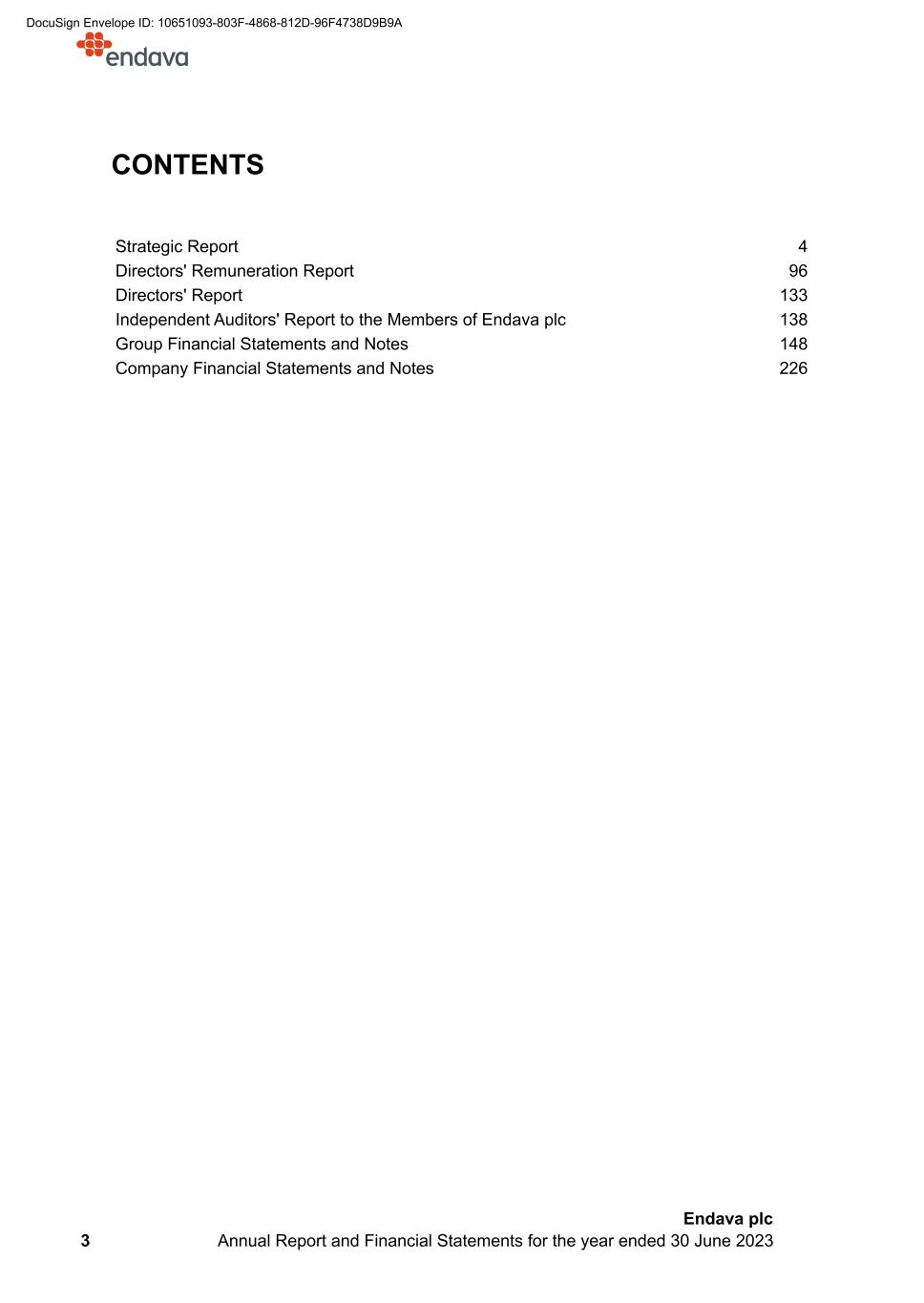
CONTENTS Strategic Report 4 Directors' Remuneration Report 96 Directors' Report 133 Independent Auditors' Report to the Members of Endava plc 138 Group Financial Statements and Notes 148 Company Financial Statements and Notes 226 3 Endava plc Annual Report and Financial Statements for the year ended 30 June 2023 DocuSign Envelope ID: 10651093-803F-4868-812D-96F4738D9B9A

The directors present their Strategic, Directors' Remuneration and Directors’ Reports on, and the audited financial statements of, Endava Plc (the "Company" and, together with its subsidiary undertakings, the “Group”) for the year ended 30 June 2023. STRATEGIC REPORT Our Business We are a leading next-generation technology services provider and help accelerate disruption by delivering rapid evolution to enterprises. We aid our clients in finding new ways to interact with their customers and users, enabling them to become more engaging, responsive and efficient. Using Distributed Enterprise Agile at scale, we collaborate with our clients, seamlessly integrating with their teams, catalysing ideation and delivering robust solutions. Our approach to ideation comprises an empathy for user needs, curiosity, creativity and a deep understanding of technologies. From proof of concept, to prototype, to production, we use our engineering expertise to deliver enterprise platforms for our clients that are capable of handling millions of transactions per day. Our people, whom we call Endavans, synthesise creativity, technology and delivery at scale in multi-disciplinary teams, enabling us to support our clients from ideation to production. Technological transformation poses numerous challenges for incumbent enterprises. Incumbent enterprises are often laden with legacy infrastructure and applications that are deeply embedded in core transactional systems, making it difficult to reconcile maintenance of existing infrastructure and applications with a nimble approach to using next-generation technologies. Incumbent enterprises are also often stymied by institutional constraints that impede their ability to solve complex problems and rapidly respond to shifting competitive dynamics, as well as ingrained traditional approaches to development. The Agile methodology stands in stark contrast to the IT-department-driven, legacy approach often used by incumbent enterprises, which is premised on a sequential and siloed structure, involves long development cycles, fails to integrate user feedback and is often more costly. Likewise, internal IT teams at incumbent enterprises often struggle to absorb the rapid pace of technology development and its growing complexity. To effectively harness the power of technology, incumbent enterprises need talent in ideation, strategy, user experience, Agile development and next-generation technologies. While incumbent enterprises have historically looked to traditional information technology, or IT, service providers to undertake technology development projects, these traditional players were built to serve, and remain focused on serving, legacy systems using offshore delivery. We reimagine the relationship between people and technology and help our clients become digital, experience-driven businesses by assisting them in their journey from idea generation to development and deployment of products, platforms and solutions. Our expertise spans the entire ideation-to-production spectrum. We create value for our clients through creation of Product and Technology Strategies and Intelligent Digital Experiences, delivered via world- class engineering and through our broad technical capabilities. We accelerate our clients’ ability to take advantage of new business models and market opportunities by ideating and delivering dynamic platforms and intelligent digital experiences that are designed to fuel rapid, ongoing transformation of our customers' businesses. By leveraging next-generation technologies, our agile, multi-disciplinary teams provide a combination of Product & Technology Strategies and Intelligent Digital Experiences, delivered via world-class engineering to help our clients become more engaging, responsive, and efficient. STRATEGIC REPORT 4 Endava plc Annual Report and Financial Statements for the year ended 30 June 2023 DocuSign Envelope ID: 10651093-803F-4868-812D-96F4738D9B9A
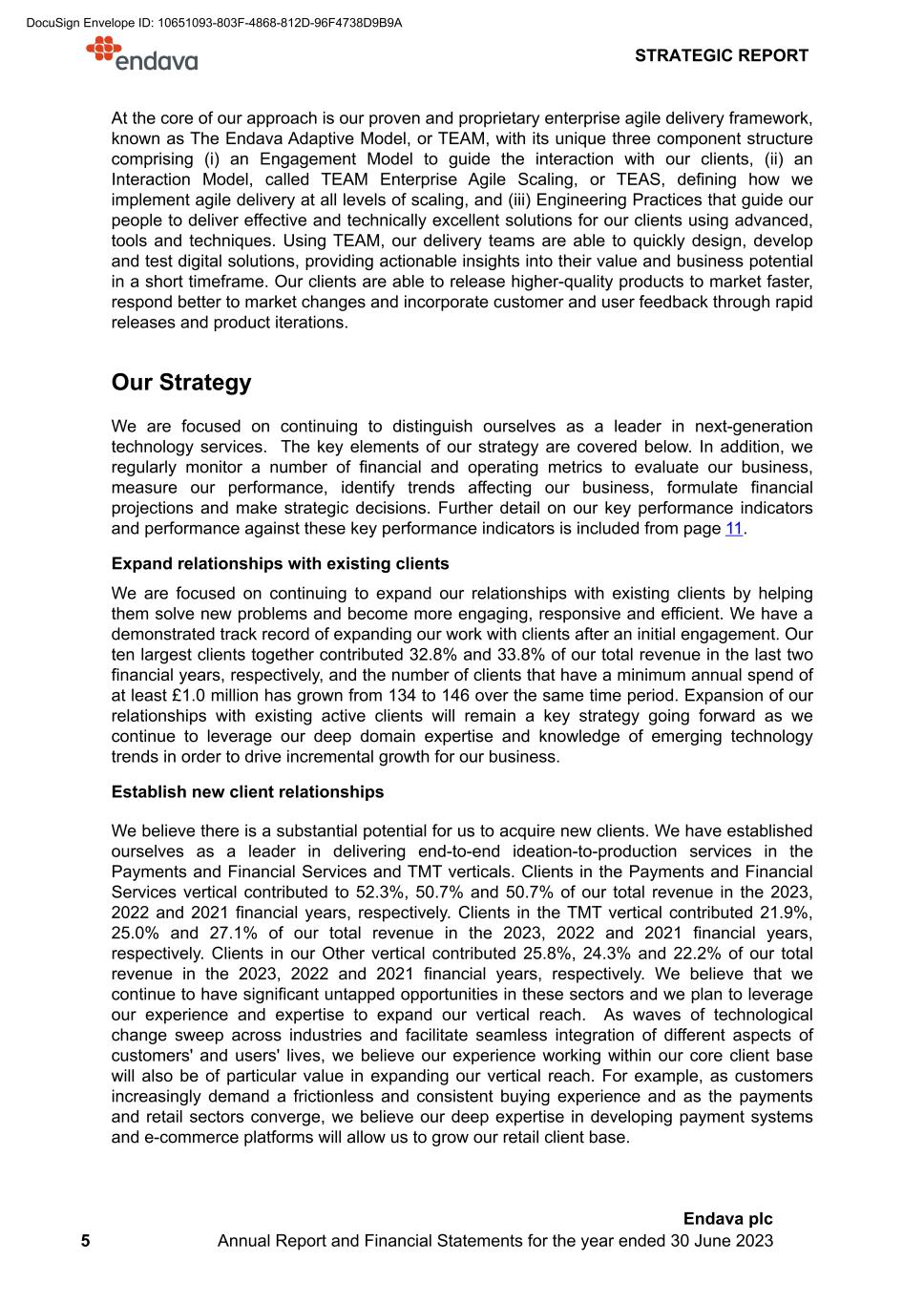
At the core of our approach is our proven and proprietary enterprise agile delivery framework, known as The Endava Adaptive Model, or TEAM, with its unique three component structure comprising (i) an Engagement Model to guide the interaction with our clients, (ii) an Interaction Model, called TEAM Enterprise Agile Scaling, or TEAS, defining how we implement agile delivery at all levels of scaling, and (iii) Engineering Practices that guide our people to deliver effective and technically excellent solutions for our clients using advanced, tools and techniques. Using TEAM, our delivery teams are able to quickly design, develop and test digital solutions, providing actionable insights into their value and business potential in a short timeframe. Our clients are able to release higher-quality products to market faster, respond better to market changes and incorporate customer and user feedback through rapid releases and product iterations. Our Strategy We are focused on continuing to distinguish ourselves as a leader in next-generation technology services. The key elements of our strategy are covered below. In addition, we regularly monitor a number of financial and operating metrics to evaluate our business, measure our performance, identify trends affecting our business, formulate financial projections and make strategic decisions. Further detail on our key performance indicators and performance against these key performance indicators is included from page 11. Expand relationships with existing clients We are focused on continuing to expand our relationships with existing clients by helping them solve new problems and become more engaging, responsive and efficient. We have a demonstrated track record of expanding our work with clients after an initial engagement. Our ten largest clients together contributed 32.8% and 33.8% of our total revenue in the last two financial years, respectively, and the number of clients that have a minimum annual spend of at least £1.0 million has grown from 134 to 146 over the same time period. Expansion of our relationships with existing active clients will remain a key strategy going forward as we continue to leverage our deep domain expertise and knowledge of emerging technology trends in order to drive incremental growth for our business. Establish new client relationships We believe there is a substantial potential for us to acquire new clients. We have established ourselves as a leader in delivering end-to-end ideation-to-production services in the Payments and Financial Services and TMT verticals. Clients in the Payments and Financial Services vertical contributed to 52.3%, 50.7% and 50.7% of our total revenue in the 2023, 2022 and 2021 financial years, respectively. Clients in the TMT vertical contributed 21.9%, 25.0% and 27.1% of our total revenue in the 2023, 2022 and 2021 financial years, respectively. Clients in our Other vertical contributed 25.8%, 24.3% and 22.2% of our total revenue in the 2023, 2022 and 2021 financial years, respectively. We believe that we continue to have significant untapped opportunities in these sectors and we plan to leverage our experience and expertise to expand our vertical reach. As waves of technological change sweep across industries and facilitate seamless integration of different aspects of customers' and users' lives, we believe our experience working within our core client base will also be of particular value in expanding our vertical reach. For example, as customers increasingly demand a frictionless and consistent buying experience and as the payments and retail sectors converge, we believe our deep expertise in developing payment systems and e-commerce platforms will allow us to grow our retail client base. STRATEGIC REPORT 5 Endava plc Annual Report and Financial Statements for the year ended 30 June 2023 DocuSign Envelope ID: 10651093-803F-4868-812D-96F4738D9B9A

Similarly, we believe that our expertise in data analytics and augmented and virtual reality will become increasingly relevant in the healthcare industry as technology continues to reshape the practice and provision of medicine. We are also focused on the Healthtech and Mobility verticals as key areas for potential growth. We are likewise focused on geographic expansion. We continue with our expansion in North America. In the 2023 financial year, approximately 32.5% of our revenue came from clients in North America. We are also expanding our operations in Asia-Pacific. In addition, we continuously evaluate other growth markets to expand our client footprint. Lead adoption of next-generation technologies We seek to apply our creative skills and deep digital technical engineering capabilities to enhance our clients’ value to their end customers and users. As a result, we are highly focused on remaining at the forefront of emerging technology trends, including in areas such as artificial intelligence and machine learning (including Generative AI), IoT, augmented and virtual reality. For example, we have developed and deployed AI-based systems, such as natural language processing and vision processing, to support the automation of highly complex tasks, as well as advanced payment gateways and chatbot-enabled social payments. We are embedded and integrated with our clients, which gives us unique insight into how emerging industry trends can help address their needs. We plan to leverage these insights to continue driving innovation for our clients. Expand scale in nearshore delivery We believe that our proprietary Distributed Enterprise Agile at scale framework requires that we have teams based in locations with similar time zones to those of our clients since our delivery teams are in constant dialogue and interaction with our clients. We focus on being an employer of choice for IT professionals in the regions in which we operate, which include countries with deep and largely untapped creative and engineering talent pools, and on being an employer of choice in local markets. As we continue to expand our relationships with existing clients and attract new clients, we plan to expand our teams at existing delivery locations and establish new delivery locations in areas with an abundance of technical talent. Selectively pursue "tuck-in" acquisitions We plan to selectively pursue “tuck-in” acquisitions. Our focus is on augmenting our core capabilities to enhance our expertise in new technologies and verticals and increase our geographic reach, while preserving our corporate culture and sustainably managing our growth. Consistent with these goals, we have completed seven acquisitions in the past three years, all of which have enabled us to accelerate core strategic goals. For example, our acquisition of Levvel in March 2021 broadened our client base in payments, banking, media and mobility in the United States and increased our U.S. onshore delivery capabilities. Our acquisition of Five in March 2021 enhanced our capabilities in digital product strategy and performance optimisation services and increased our nearshore delivery locations in the Adriatic region. As part of our acquisition of Lexicon in October 2022, we acquired additional headcount and offices in Australia and a new delivery location in Vietnam. Our acquisitions of DEK and Mudbath in 2023 enhanced our presence in the Asia-Pacific region, increasing our headcount in Australia and the capability and size of our Vietnamese delivery location. In August 2023, through our acquisition of TLM we have gained expertise in outsourced development services across design, engineering and art/animation for PC and console video games and other digital entertainment. STRATEGIC REPORT 6 Endava plc Annual Report and Financial Statements for the year ended 30 June 2023 DocuSign Envelope ID: 10651093-803F-4868-812D-96F4738D9B9A
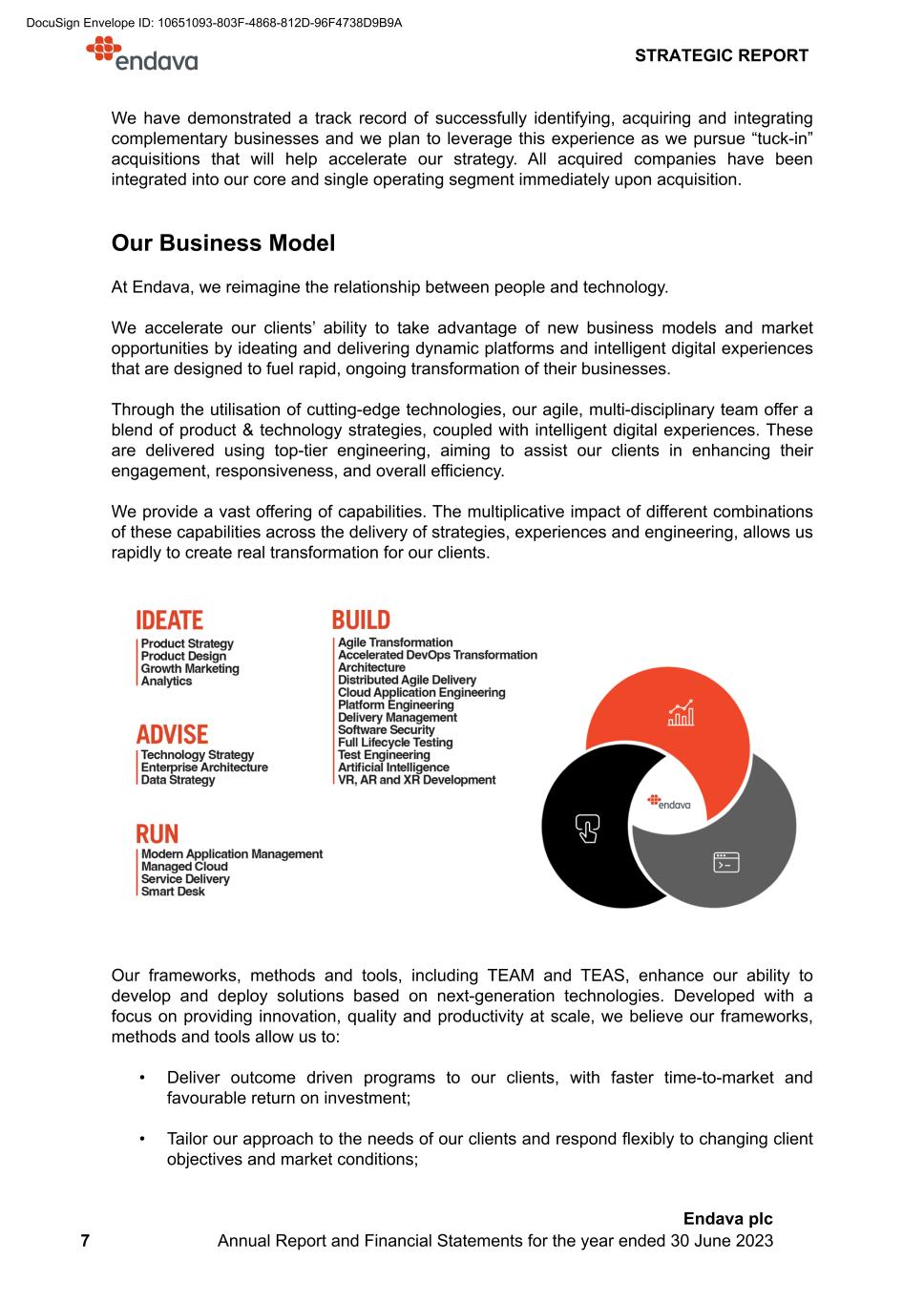
We have demonstrated a track record of successfully identifying, acquiring and integrating complementary businesses and we plan to leverage this experience as we pursue “tuck-in” acquisitions that will help accelerate our strategy. All acquired companies have been integrated into our core and single operating segment immediately upon acquisition. Our Business Model At Endava, we reimagine the relationship between people and technology. We accelerate our clients’ ability to take advantage of new business models and market opportunities by ideating and delivering dynamic platforms and intelligent digital experiences that are designed to fuel rapid, ongoing transformation of their businesses. Through the utilisation of cutting-edge technologies, our agile, multi-disciplinary team offer a blend of product & technology strategies, coupled with intelligent digital experiences. These are delivered using top-tier engineering, aiming to assist our clients in enhancing their engagement, responsiveness, and overall efficiency. We provide a vast offering of capabilities. The multiplicative impact of different combinations of these capabilities across the delivery of strategies, experiences and engineering, allows us rapidly to create real transformation for our clients. Our frameworks, methods and tools, including TEAM and TEAS, enhance our ability to develop and deploy solutions based on next-generation technologies. Developed with a focus on providing innovation, quality and productivity at scale, we believe our frameworks, methods and tools allow us to: • Deliver outcome driven programs to our clients, with faster time-to-market and favourable return on investment; • Tailor our approach to the needs of our clients and respond flexibly to changing client objectives and market conditions; STRATEGIC REPORT 7 Endava plc Annual Report and Financial Statements for the year ended 30 June 2023 DocuSign Envelope ID: 10651093-803F-4868-812D-96F4738D9B9A
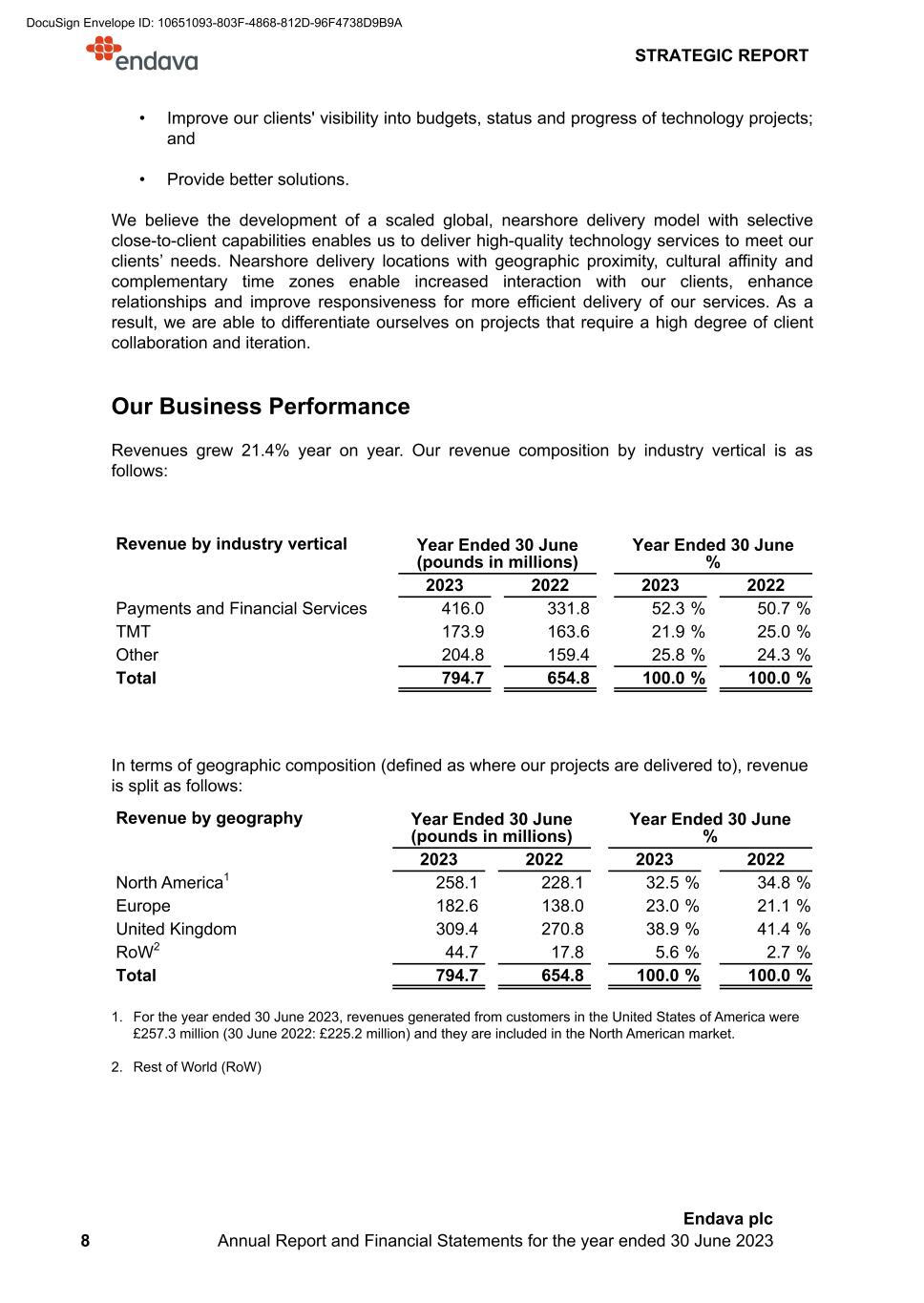
• Improve our clients' visibility into budgets, status and progress of technology projects; and • Provide better solutions. We believe the development of a scaled global, nearshore delivery model with selective close-to-client capabilities enables us to deliver high-quality technology services to meet our clients’ needs. Nearshore delivery locations with geographic proximity, cultural affinity and complementary time zones enable increased interaction with our clients, enhance relationships and improve responsiveness for more efficient delivery of our services. As a result, we are able to differentiate ourselves on projects that require a high degree of client collaboration and iteration. Our Business Performance Revenues grew 21.4% year on year. Our revenue composition by industry vertical is as follows: Revenue by industry vertical Year Ended 30 June (pounds in millions) Year Ended 30 June % 2023 2022 2023 2022 Payments and Financial Services 416.0 331.8 52.3 % 50.7 % TMT 173.9 163.6 21.9 % 25.0 % Other 204.8 159.4 25.8 % 24.3 % Total 794.7 654.8 100.0 % 100.0 % In terms of geographic composition (defined as where our projects are delivered to), revenue is split as follows: Revenue by geography Year Ended 30 June (pounds in millions) Year Ended 30 June % 2023 2022 2023 2022 North America1 258.1 228.1 32.5 % 34.8 % Europe 182.6 138.0 23.0 % 21.1 % United Kingdom 309.4 270.8 38.9 % 41.4 % RoW2 44.7 17.8 5.6 % 2.7 % Total 794.7 654.8 100.0 % 100.0 % 1. For the year ended 30 June 2023, revenues generated from customers in the United States of America were £257.3 million (30 June 2022: £225.2 million) and they are included in the North American market. 2. Rest of World (RoW) STRATEGIC REPORT 8 Endava plc Annual Report and Financial Statements for the year ended 30 June 2023 DocuSign Envelope ID: 10651093-803F-4868-812D-96F4738D9B9A

Revenue Revenue for the year ended 30 June 2023 ("FY2023" or the "2023 financial year") was £794.7 million, an increase of £140.0 million, or 21.4%, over the year ended 30 June 2022 ("FY2022" or the "2022 financial year"). In constant currency terms, revenue grew by 16.6% over FY2022. Further detail on our basis for calculation of constant currency is included in the 'Key Performance Indicators' section of our report (page 11). We achieved significant growth in revenue across all verticals. Revenue from clients in the Payments and Financial Services vertical increased by £84.2 million, or 25.4%, to £416.0 million in FY2023 from £331.8 million in FY2022. Growth in the Payments and Financial Services vertical was helped by our acquisition of Lexicon in Australia, which partially offset headwinds in the second half of the year from the macroeconomic slow down. Revenue from clients in the TMT vertical increased by £10.4 million, or 6.4%, to £173.9 million in FY2023 from £163.6 million in FY2022. TMT faced particular headwinds this year, especially in North America, as clients became more cautious about spend driven by a higher interest rate environment. Revenue from clients in our other verticals increased by £45.4 million, or 28.5%, to £204.8 million in FY2023 from £159.4 million in FY2022. Growth in the Healthcare vertical was a significant contributor to the overall growth in our other verticals. Revenue also grew across all geographies. Revenue from clients based in Europe (other than the United Kingdom) increased by £44.5 million, or 32.3%, to £182.6 million in FY2023 from £138.0 million in FY2022 largely driven by Payments and Financial Services and Other. Revenue from clients based in the United Kingdom increased by £38.5 million, or 14.2%, to £309.4 million in FY2023 from £270.8 million in FY2022. Revenue from clients based in North America increased by £30 million, or 13.2%, to £258.1 million in FY2023 from £228.1 million in FY2022. Revenue from clients based in Rest of World increased by £26.9 million, or 151.2%, to £44.7 million in FY2023 from £17.8 million in FY2022, largely due to our acquisition of Lexicon in Australia. Revenue from our top 10 clients in FY2023 increased by £38.8 million, or 17.5%, to £260.3 million compared to £221.5 million in revenue from our top 10 clients in FY2022. There is little change in the clients named in our top 10 revenue contributors year on year. Clients in this group are growing well, particularly those in the Payments and Financial Services sector. Cost of sales Total cost of sales increased by £93.8 million, or 21.5%, in FY2023 compared to FY2022. The increase consisted of a £91.3 million increase in direct cost of sales, as a result of increased personnel costs, which reflected an increase in the average number of employees involved in delivery of our services from 9,492 in FY2022 to 10,872 in FY2023. Cost of sales in 2023 also includes £5.5 million of restructuring costs related to business optimisation actions of management. Grant income increased by £2.3 million in FY2023 compared to FY2022 and research and development credits (in respect of innovative work we carried out for contract customers) increased by £2.8 million in FY2023 compared to FY2022. The increase in research and development credits was due to general growth in the size and number of projects and our ability to forecast a higher proportion of our work being qualifying activities based on the latest submitted claim. Included in the allocated cost of sales is the portion of depreciation and amortisation expense attributable to the portion of our property and equipment and intangible assets utilised in the delivery of services to our clients. This increased by £2.6 million in FY2023 compared to FY2022, or 11.4% due to the increase in the size of our delivery organisation. Gross margin was stable at 33.2% in FY2023 and 33.3% in FY2022. STRATEGIC REPORT 9 Endava plc Annual Report and Financial Statements for the year ended 30 June 2023 DocuSign Envelope ID: 10651093-803F-4868-812D-96F4738D9B9A

Selling, general and administrative expenses Selling, general and administrative expenses increased by £28.5 million, or 23.4% in FY2023 compared to FY2022. The increase in total selling, general and administrative expenses is primarily related to an increase of £12.4 million in general and administrative expenses as a result of increased support functions costs which is in line with growth. Selling, general and administrative expenses in 2023 also includes £1.1 million of restructuring costs related to business optimisation actions taken by management. Sales and marketing expenses increased by £10.2 million. Depreciation and amortisation increased by £2.2 million, or 17.0%, in FY2023 compared to FY2022, primarily as a result of a £1.4 million increase in amortisation of acquired intangible assets. As a percentage of revenue, selling, general and administrative expenses increased from 18.6% in 2022 to 18.9% in 2023. Net impairment losses on financial assets Net impairment losses on financial assets increased by £0.2 million in FY2023 compared to FY2022. In FY2023 the aggregate charge was higher compared to FY2022 due to changes in debtor balances and client financial positions. Net finance income Net finance income decreased by £5.7 million in FY2023 compared to FY2022. In FY2023, we recognised net finance income of £1.3 million, which includes £11.8 million income related to fair value movement of financial liabilities (re-measurements of acquisition deferred and contingent consideration and discount unwind to present value) and £3.5 million interest income on bank deposits. The income was offset by £1.7 million interest charge on leases, £1.7 million running costs related to our revolving credit facility and £10.7 million foreign exchange net losses for the period. The foreign exchange loss includes £5.1 million loss arising from an Argentina blue chip swap transaction, which was used to allow repatriation of cash from Argentina following payment of outstanding intercompany receivables. In FY2022, we recognised net finance income of £7.0 million, which included a charge to lease interest of £1.1 million and a £9.9 million gain related to changes in foreign exchange rates. Profit before tax Our profit before taxes was £114.2 million and £102.4 million for the financial years ended 30 June 2023 and 30 June 2022 respectively. Our profit before taxes as a percentage of revenue was 14.4% and 15.6% respectively, for the same periods. Tax on profit on ordinary activities Tax on profit on ordinary activities increased by £0.7 million, or 3.7%, in FY2023 compared to FY2022. Our annual effective tax rate for FY2023 was 17.5%, compared to an annual effective tax rate of 18.8% for FY2022. The FY2023 effective tax rate has benefited from the non-taxable fair value movement on financial liabilities and the benefit of carrying forward certain U.K. losses to be used in future periods when the enacted statutory rate is higher than the current year rate. STRATEGIC REPORT 10 Endava plc Annual Report and Financial Statements for the year ended 30 June 2023 DocuSign Envelope ID: 10651093-803F-4868-812D-96F4738D9B9A

Liquidity and capital resources Net current assets increased to £226.1 million as at 30 June 2023 compared to £199.8 million as at 30 June 2022. This was driven by a higher closing cash and cash equivalents balance arising from cash generated from operations. Further information on liquidity and going concern is included in the Directors' Report. Key Performance Indicators We regularly monitor a number of financial and operating metrics to evaluate our business, measure our performance, identify trends affecting our business, formulate financial projections and make strategic decisions. Our management metrics may be calculated in a different manner than similarly titled metrics used by other companies. Year Ended 30 June 2023 2022 (pounds in thousands) Revenue growth rate at constant currency 16.6% 47.6% Average number of employees involved in delivery of our services 10,872 9,492 Revenue concentration 32.8% 33.8% Number of large clients 146 134 Adjusted profit before taxes margin 20.7% 21.1% Adjusted free cash flow £111,525 £107,163 Revenue growth rate at constant currency We monitor our revenue growth rate at constant currency. As the impact of foreign currency exchange rates is highly variable and difficult to predict, we believe revenue growth rate at constant currency allows us to better understand the underlying business trends and performance of our ongoing operations on a period-over-period basis. We calculate revenue growth rate at constant currency by translating revenue from entities reporting in foreign currencies into British Pounds using the comparable foreign currency exchange rates from the prior period. For example, the average rates in effect for the financial year ended 30 June 2022 were used to convert revenue for the financial year ended 30 June 2023 and the revenue for the comparable prior period ended 30 June 2022, rather than the actual exchange rates in effect during the respective period. Revenue growth rate at constant currency is not a measure calculated in accordance with IFRS. Average number of employees involved in delivery of our services We monitor our average number of operational employees because we believe it gives us visibility into the size of both our revenue-producing base and our most significant cost base, which in turn allows us to better understand changes in our utilisation rates and gross margins on a period-over-period basis. We calculate average number of operational employees as the average of our number of employees involved in delivery of our services on the last day of each month in the relevant period. STRATEGIC REPORT 11 Endava plc Annual Report and Financial Statements for the year ended 30 June 2023 DocuSign Envelope ID: 10651093-803F-4868-812D-96F4738D9B9A
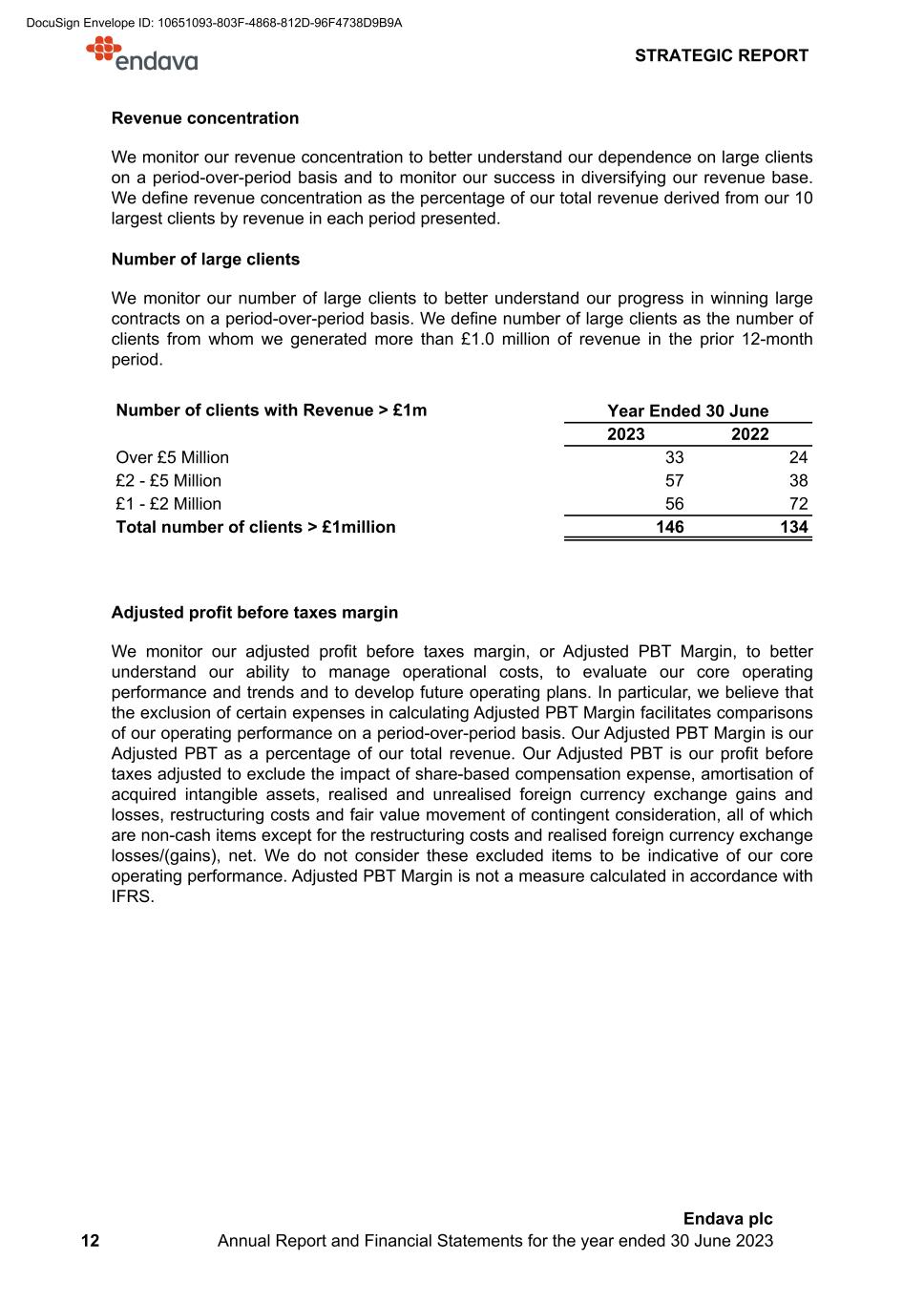
Revenue concentration We monitor our revenue concentration to better understand our dependence on large clients on a period-over-period basis and to monitor our success in diversifying our revenue base. We define revenue concentration as the percentage of our total revenue derived from our 10 largest clients by revenue in each period presented. Number of large clients We monitor our number of large clients to better understand our progress in winning large contracts on a period-over-period basis. We define number of large clients as the number of clients from whom we generated more than £1.0 million of revenue in the prior 12-month period. Number of clients with Revenue > £1m Year Ended 30 June 2023 2022 Over £5 Million 33 24 £2 - £5 Million 57 38 £1 - £2 Million 56 72 Total number of clients > £1million 146 134 Adjusted profit before taxes margin We monitor our adjusted profit before taxes margin, or Adjusted PBT Margin, to better understand our ability to manage operational costs, to evaluate our core operating performance and trends and to develop future operating plans. In particular, we believe that the exclusion of certain expenses in calculating Adjusted PBT Margin facilitates comparisons of our operating performance on a period-over-period basis. Our Adjusted PBT Margin is our Adjusted PBT as a percentage of our total revenue. Our Adjusted PBT is our profit before taxes adjusted to exclude the impact of share-based compensation expense, amortisation of acquired intangible assets, realised and unrealised foreign currency exchange gains and losses, restructuring costs and fair value movement of contingent consideration, all of which are non-cash items except for the restructuring costs and realised foreign currency exchange losses/(gains), net. We do not consider these excluded items to be indicative of our core operating performance. Adjusted PBT Margin is not a measure calculated in accordance with IFRS. STRATEGIC REPORT 12 Endava plc Annual Report and Financial Statements for the year ended 30 June 2023 DocuSign Envelope ID: 10651093-803F-4868-812D-96F4738D9B9A

The following table presents a reconciliation of Adjusted PBT to profit before taxes, the most directly comparable financial measure calculated and presented in accordance with IFRS, for the financial years ended 30 June 2023 and 2022, respectively. Year Ended 30 June 2023 2022 £'000 £'000 Profit before taxes 114,163 102,379 Share-based compensation expense 31,058 35,005 Amortisation of acquired intangible assets 12,270 10,823 Foreign currency exchange losses/(gains) net 10,729 (9,944) Restructuring costs 6,588 — Fair value movement of contingent consideration (10,613) — 164,195 138,263 Adjusted free cash flow We monitor our adjusted free cash flow to better understand and evaluate our liquidity position and to develop future operating plans. Our adjusted free cash flow is our net cash provided by operating activities, plus grant received, less purchases of non-current tangible and intangible assets. Adjusted free cash flow is not a measure calculated in accordance with IFRS. Year Ended 30 June 2023 2022 (pounds in thousands) Net cash provided by operating activities 124,518 120,719 Grant received 494 139 Purchases of non-current assets (tangible and intangible) (13,487) (13,695) Adjusted free cash flow 111,525 107,163 STRATEGIC REPORT 13 Endava plc Annual Report and Financial Statements for the year ended 30 June 2023 DocuSign Envelope ID: 10651093-803F-4868-812D-96F4738D9B9A
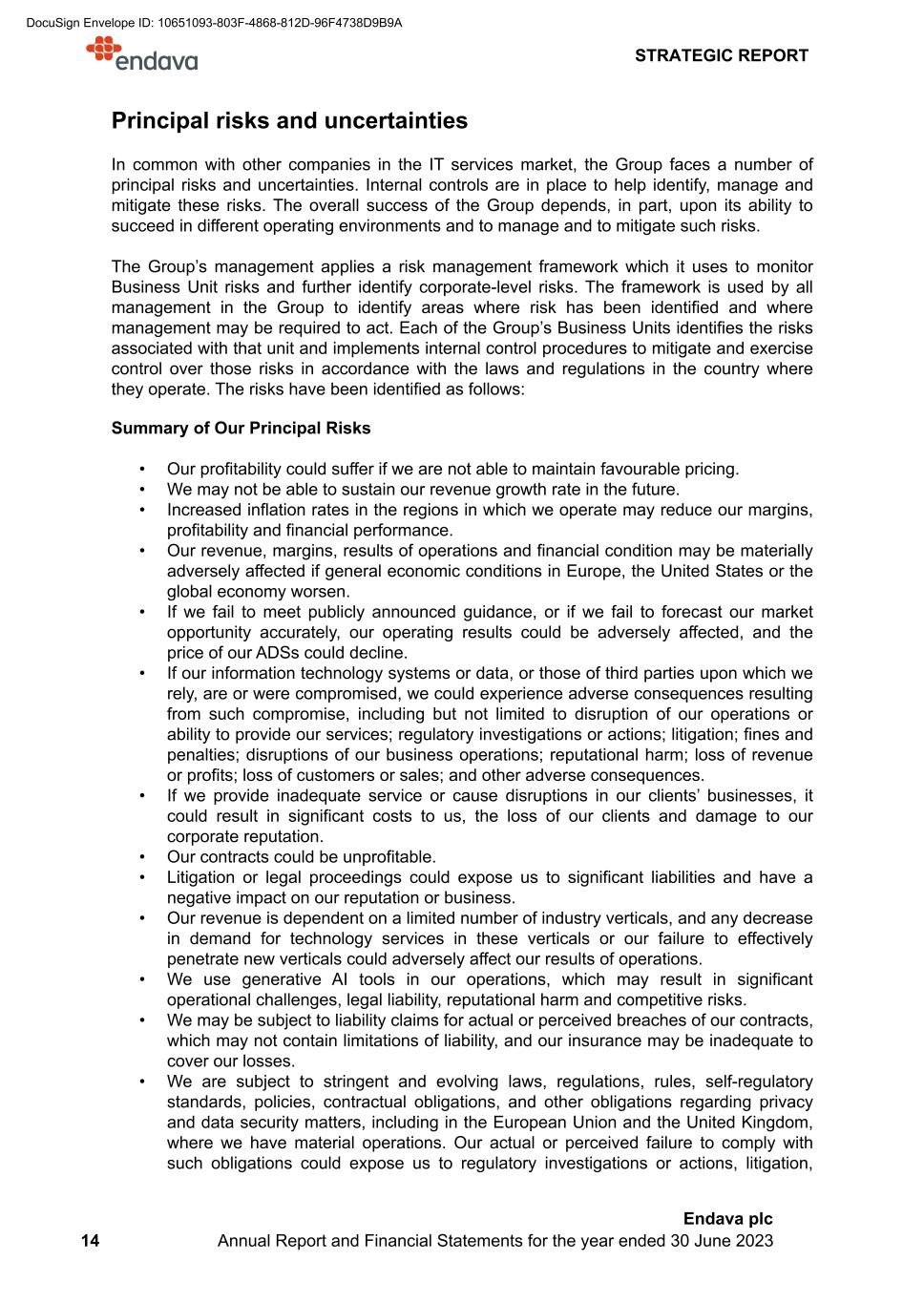
Principal risks and uncertainties In common with other companies in the IT services market, the Group faces a number of principal risks and uncertainties. Internal controls are in place to help identify, manage and mitigate these risks. The overall success of the Group depends, in part, upon its ability to succeed in different operating environments and to manage and to mitigate such risks. The Group’s management applies a risk management framework which it uses to monitor Business Unit risks and further identify corporate-level risks. The framework is used by all management in the Group to identify areas where risk has been identified and where management may be required to act. Each of the Group’s Business Units identifies the risks associated with that unit and implements internal control procedures to mitigate and exercise control over those risks in accordance with the laws and regulations in the country where they operate. The risks have been identified as follows: Summary of Our Principal Risks • Our profitability could suffer if we are not able to maintain favourable pricing. • We may not be able to sustain our revenue growth rate in the future. • Increased inflation rates in the regions in which we operate may reduce our margins, profitability and financial performance. • Our revenue, margins, results of operations and financial condition may be materially adversely affected if general economic conditions in Europe, the United States or the global economy worsen. • If we fail to meet publicly announced guidance, or if we fail to forecast our market opportunity accurately, our operating results could be adversely affected, and the price of our ADSs could decline. • If our information technology systems or data, or those of third parties upon which we rely, are or were compromised, we could experience adverse consequences resulting from such compromise, including but not limited to disruption of our operations or ability to provide our services; regulatory investigations or actions; litigation; fines and penalties; disruptions of our business operations; reputational harm; loss of revenue or profits; loss of customers or sales; and other adverse consequences. • If we provide inadequate service or cause disruptions in our clients’ businesses, it could result in significant costs to us, the loss of our clients and damage to our corporate reputation. • Our contracts could be unprofitable. • Litigation or legal proceedings could expose us to significant liabilities and have a negative impact on our reputation or business. • Our revenue is dependent on a limited number of industry verticals, and any decrease in demand for technology services in these verticals or our failure to effectively penetrate new verticals could adversely affect our results of operations. • We use generative AI tools in our operations, which may result in significant operational challenges, legal liability, reputational harm and competitive risks. • We may be subject to liability claims for actual or perceived breaches of our contracts, which may not contain limitations of liability, and our insurance may be inadequate to cover our losses. • We are subject to stringent and evolving laws, regulations, rules, self-regulatory standards, policies, contractual obligations, and other obligations regarding privacy and data security matters, including in the European Union and the United Kingdom, where we have material operations. Our actual or perceived failure to comply with such obligations could expose us to regulatory investigations or actions, litigation, STRATEGIC REPORT 14 Endava plc Annual Report and Financial Statements for the year ended 30 June 2023 DocuSign Envelope ID: 10651093-803F-4868-812D-96F4738D9B9A

fines and penalties or other financial liabilities, disruption of our business operations, reputational harm, loss of revenue or profit, loss of customers or sales and/or adversely affect our ability to conduct our business. • We are dependent on our existing client base and our ability to retain such clients. • Our results of operations may be negatively impacted by the military conflict between Russia and Ukraine and related economic sanctions. • We must attract and retain highly-skilled IT professionals. • We are focused on growing our client base in North America and Europe and may not be successful. • We may be unable to effectively manage our rapid growth or achieve anticipated growth, which could place significant strain on our management personnel, systems and resources. • If we do not continue to innovate and remain at the forefront of emerging technologies and related market trends, we may lose clients and not remain competitive. • We are dependent on members of our senior management team and other key employees. • We must maintain adequate employee utilisation rates and productivity levels. • Our sales of services, operating results or profitability may experience significant variability and our past results may not be indicative of our future performance. • Recent acquisitions and potential future acquisitions could prove difficult to integrate, disrupt our business, dilute shareholder value and strain our resources. • We operate in a rapidly evolving industry, which makes it difficult to evaluate our future prospects and may increase the risk that we will not continue to be successful. • We have in the past experienced, and may in the future experience, a long selling and implementation cycle with respect to certain projects that require us to make significant resource commitments prior to realising revenue for our services. • We may not receive sufficient intellectual property rights from our employees and contractors to comply with our obligations to our clients and we may not be able to prevent unauthorised use of our intellectual property. • We use third-party software, hardware and software-as-a-service, or SaaS, technologies from third parties that may be difficult to replace or that may cause errors or defects in, or failures of, the services or solutions we provide, which could result in material adverse consequences. • We incorporate third-party open source software into our client deliverables and our failure to comply with the terms of the underlying open source software licenses could adversely impact our clients and create potential liability. • Our performance and reputation could be adversely affected by increased focus on and demands from customers, investors and regulators with respect to ESG issues and we may be criticised or penalised for the timing, nature or scope of our ESG disclosures as regulatory standards evolve. • Changes in laws, regulations, rules or other obligations related to the internet or changes in the internet infrastructure itself may provide various risks, including privacy risks, and thus diminish the demand for our services, and could have a negative impact on our business. • Our ability to expand our business and procure new contracts or enter into beneficial business arrangements could be affected to the extent we enter into agreements with clients containing non-competition clauses. • We generally do not have long-term commitments from our clients, and our clients may terminate engagements before completion or choose not to enter into new engagements with us. • Unstable market and economic conditions may have serious adverse consequences on our business, financial condition and the price of our American Depositary Shares, or ADSs. STRATEGIC REPORT 15 Endava plc Annual Report and Financial Statements for the year ended 30 June 2023 DocuSign Envelope ID: 10651093-803F-4868-812D-96F4738D9B9A
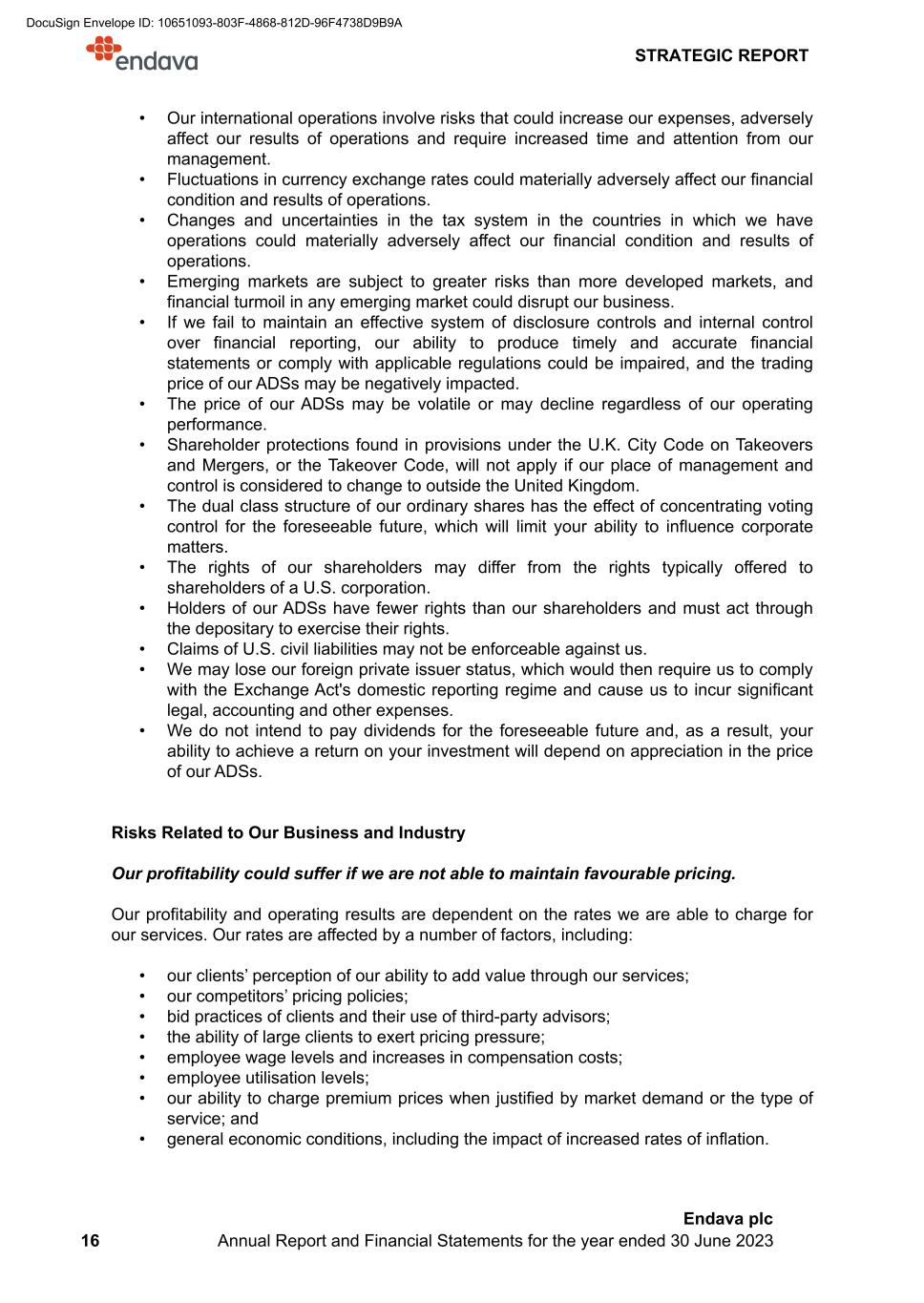
• Our international operations involve risks that could increase our expenses, adversely affect our results of operations and require increased time and attention from our management. • Fluctuations in currency exchange rates could materially adversely affect our financial condition and results of operations. • Changes and uncertainties in the tax system in the countries in which we have operations could materially adversely affect our financial condition and results of operations. • Emerging markets are subject to greater risks than more developed markets, and financial turmoil in any emerging market could disrupt our business. • If we fail to maintain an effective system of disclosure controls and internal control over financial reporting, our ability to produce timely and accurate financial statements or comply with applicable regulations could be impaired, and the trading price of our ADSs may be negatively impacted. • The price of our ADSs may be volatile or may decline regardless of our operating performance. • Shareholder protections found in provisions under the U.K. City Code on Takeovers and Mergers, or the Takeover Code, will not apply if our place of management and control is considered to change to outside the United Kingdom. • The dual class structure of our ordinary shares has the effect of concentrating voting control for the foreseeable future, which will limit your ability to influence corporate matters. • The rights of our shareholders may differ from the rights typically offered to shareholders of a U.S. corporation. • Holders of our ADSs have fewer rights than our shareholders and must act through the depositary to exercise their rights. • Claims of U.S. civil liabilities may not be enforceable against us. • We may lose our foreign private issuer status, which would then require us to comply with the Exchange Act's domestic reporting regime and cause us to incur significant legal, accounting and other expenses. • We do not intend to pay dividends for the foreseeable future and, as a result, your ability to achieve a return on your investment will depend on appreciation in the price of our ADSs. Risks Related to Our Business and Industry Our profitability could suffer if we are not able to maintain favourable pricing. Our profitability and operating results are dependent on the rates we are able to charge for our services. Our rates are affected by a number of factors, including: • our clients’ perception of our ability to add value through our services; • our competitors’ pricing policies; • bid practices of clients and their use of third-party advisors; • the ability of large clients to exert pricing pressure; • employee wage levels and increases in compensation costs; • employee utilisation levels; • our ability to charge premium prices when justified by market demand or the type of service; and • general economic conditions, including the impact of increased rates of inflation. STRATEGIC REPORT 16 Endava plc Annual Report and Financial Statements for the year ended 30 June 2023 DocuSign Envelope ID: 10651093-803F-4868-812D-96F4738D9B9A
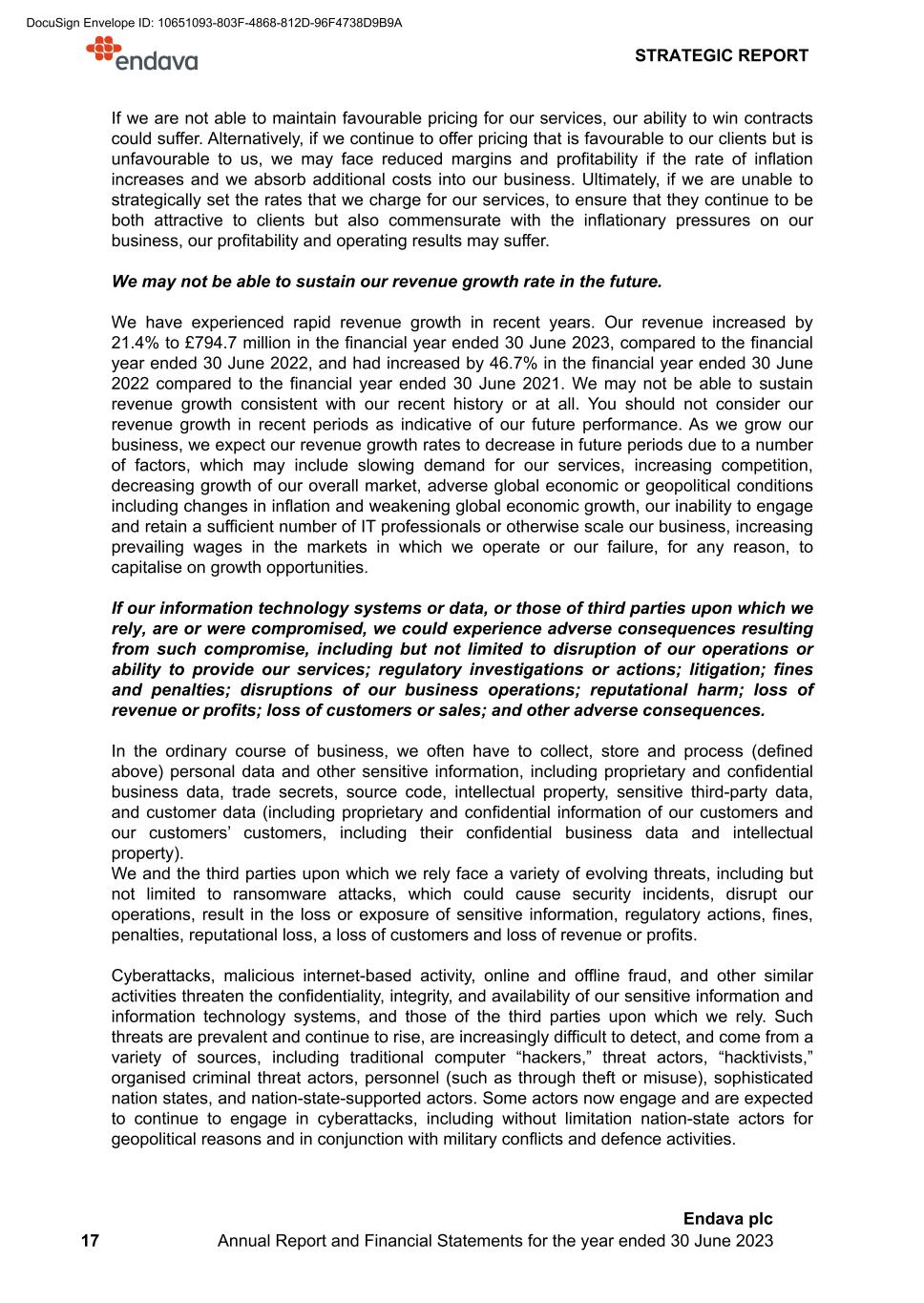
If we are not able to maintain favourable pricing for our services, our ability to win contracts could suffer. Alternatively, if we continue to offer pricing that is favourable to our clients but is unfavourable to us, we may face reduced margins and profitability if the rate of inflation increases and we absorb additional costs into our business. Ultimately, if we are unable to strategically set the rates that we charge for our services, to ensure that they continue to be both attractive to clients but also commensurate with the inflationary pressures on our business, our profitability and operating results may suffer. We may not be able to sustain our revenue growth rate in the future. We have experienced rapid revenue growth in recent years. Our revenue increased by 21.4% to £794.7 million in the financial year ended 30 June 2023, compared to the financial year ended 30 June 2022, and had increased by 46.7% in the financial year ended 30 June 2022 compared to the financial year ended 30 June 2021. We may not be able to sustain revenue growth consistent with our recent history or at all. You should not consider our revenue growth in recent periods as indicative of our future performance. As we grow our business, we expect our revenue growth rates to decrease in future periods due to a number of factors, which may include slowing demand for our services, increasing competition, decreasing growth of our overall market, adverse global economic or geopolitical conditions including changes in inflation and weakening global economic growth, our inability to engage and retain a sufficient number of IT professionals or otherwise scale our business, increasing prevailing wages in the markets in which we operate or our failure, for any reason, to capitalise on growth opportunities. If our information technology systems or data, or those of third parties upon which we rely, are or were compromised, we could experience adverse consequences resulting from such compromise, including but not limited to disruption of our operations or ability to provide our services; regulatory investigations or actions; litigation; fines and penalties; disruptions of our business operations; reputational harm; loss of revenue or profits; loss of customers or sales; and other adverse consequences. In the ordinary course of business, we often have to collect, store and process (defined above) personal data and other sensitive information, including proprietary and confidential business data, trade secrets, source code, intellectual property, sensitive third-party data, and customer data (including proprietary and confidential information of our customers and our customers’ customers, including their confidential business data and intellectual property). We and the third parties upon which we rely face a variety of evolving threats, including but not limited to ransomware attacks, which could cause security incidents, disrupt our operations, result in the loss or exposure of sensitive information, regulatory actions, fines, penalties, reputational loss, a loss of customers and loss of revenue or profits. Cyberattacks, malicious internet-based activity, online and offline fraud, and other similar activities threaten the confidentiality, integrity, and availability of our sensitive information and information technology systems, and those of the third parties upon which we rely. Such threats are prevalent and continue to rise, are increasingly difficult to detect, and come from a variety of sources, including traditional computer “hackers,” threat actors, “hacktivists,” organised criminal threat actors, personnel (such as through theft or misuse), sophisticated nation states, and nation-state-supported actors. Some actors now engage and are expected to continue to engage in cyberattacks, including without limitation nation-state actors for geopolitical reasons and in conjunction with military conflicts and defence activities. STRATEGIC REPORT 17 Endava plc Annual Report and Financial Statements for the year ended 30 June 2023 DocuSign Envelope ID: 10651093-803F-4868-812D-96F4738D9B9A
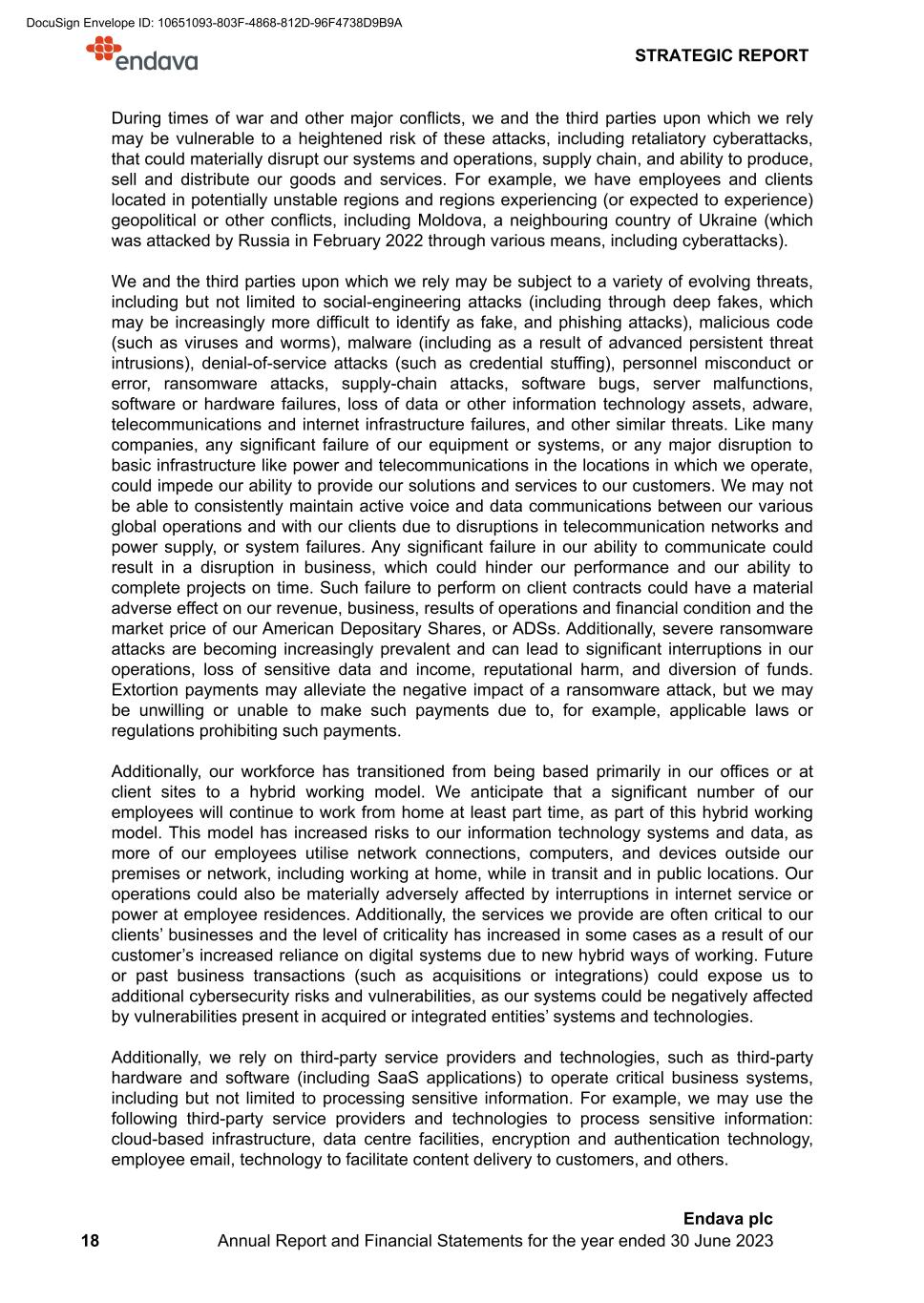
During times of war and other major conflicts, we and the third parties upon which we rely may be vulnerable to a heightened risk of these attacks, including retaliatory cyberattacks, that could materially disrupt our systems and operations, supply chain, and ability to produce, sell and distribute our goods and services. For example, we have employees and clients located in potentially unstable regions and regions experiencing (or expected to experience) geopolitical or other conflicts, including Moldova, a neighbouring country of Ukraine (which was attacked by Russia in February 2022 through various means, including cyberattacks). We and the third parties upon which we rely may be subject to a variety of evolving threats, including but not limited to social-engineering attacks (including through deep fakes, which may be increasingly more difficult to identify as fake, and phishing attacks), malicious code (such as viruses and worms), malware (including as a result of advanced persistent threat intrusions), denial-of-service attacks (such as credential stuffing), personnel misconduct or error, ransomware attacks, supply-chain attacks, software bugs, server malfunctions, software or hardware failures, loss of data or other information technology assets, adware, telecommunications and internet infrastructure failures, and other similar threats. Like many companies, any significant failure of our equipment or systems, or any major disruption to basic infrastructure like power and telecommunications in the locations in which we operate, could impede our ability to provide our solutions and services to our customers. We may not be able to consistently maintain active voice and data communications between our various global operations and with our clients due to disruptions in telecommunication networks and power supply, or system failures. Any significant failure in our ability to communicate could result in a disruption in business, which could hinder our performance and our ability to complete projects on time. Such failure to perform on client contracts could have a material adverse effect on our revenue, business, results of operations and financial condition and the market price of our American Depositary Shares, or ADSs. Additionally, severe ransomware attacks are becoming increasingly prevalent and can lead to significant interruptions in our operations, loss of sensitive data and income, reputational harm, and diversion of funds. Extortion payments may alleviate the negative impact of a ransomware attack, but we may be unwilling or unable to make such payments due to, for example, applicable laws or regulations prohibiting such payments. Additionally, our workforce has transitioned from being based primarily in our offices or at client sites to a hybrid working model. We anticipate that a significant number of our employees will continue to work from home at least part time, as part of this hybrid working model. This model has increased risks to our information technology systems and data, as more of our employees utilise network connections, computers, and devices outside our premises or network, including working at home, while in transit and in public locations. Our operations could also be materially adversely affected by interruptions in internet service or power at employee residences. Additionally, the services we provide are often critical to our clients’ businesses and the level of criticality has increased in some cases as a result of our customer’s increased reliance on digital systems due to new hybrid ways of working. Future or past business transactions (such as acquisitions or integrations) could expose us to additional cybersecurity risks and vulnerabilities, as our systems could be negatively affected by vulnerabilities present in acquired or integrated entities’ systems and technologies. Additionally, we rely on third-party service providers and technologies, such as third-party hardware and software (including SaaS applications) to operate critical business systems, including but not limited to processing sensitive information. For example, we may use the following third-party service providers and technologies to process sensitive information: cloud-based infrastructure, data centre facilities, encryption and authentication technology, employee email, technology to facilitate content delivery to customers, and others. STRATEGIC REPORT 18 Endava plc Annual Report and Financial Statements for the year ended 30 June 2023 DocuSign Envelope ID: 10651093-803F-4868-812D-96F4738D9B9A
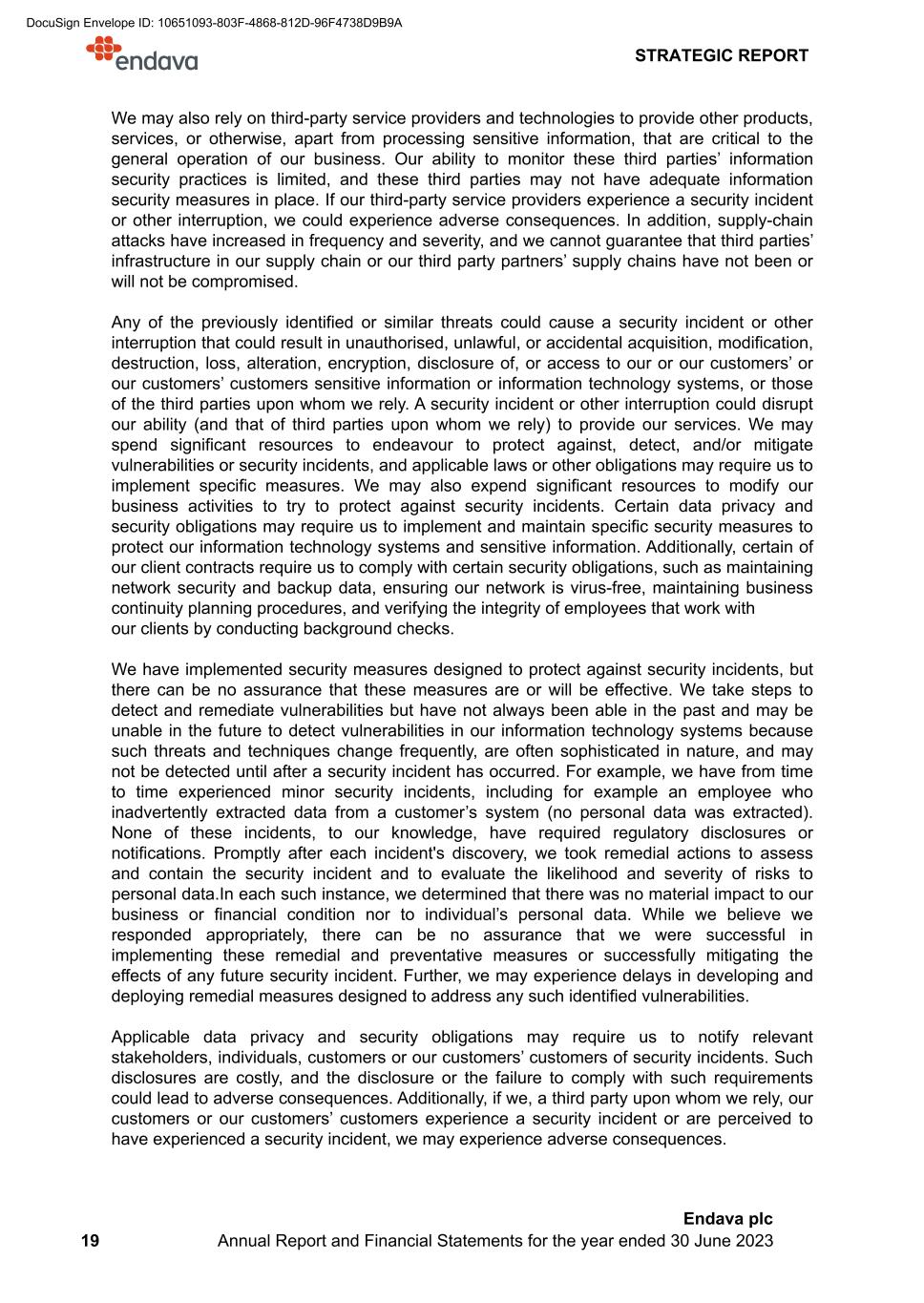
We may also rely on third-party service providers and technologies to provide other products, services, or otherwise, apart from processing sensitive information, that are critical to the general operation of our business. Our ability to monitor these third parties’ information security practices is limited, and these third parties may not have adequate information security measures in place. If our third-party service providers experience a security incident or other interruption, we could experience adverse consequences. In addition, supply-chain attacks have increased in frequency and severity, and we cannot guarantee that third parties’ infrastructure in our supply chain or our third party partners’ supply chains have not been or will not be compromised. Any of the previously identified or similar threats could cause a security incident or other interruption that could result in unauthorised, unlawful, or accidental acquisition, modification, destruction, loss, alteration, encryption, disclosure of, or access to our or our customers’ or our customers’ customers sensitive information or information technology systems, or those of the third parties upon whom we rely. A security incident or other interruption could disrupt our ability (and that of third parties upon whom we rely) to provide our services. We may spend significant resources to endeavour to protect against, detect, and/or mitigate vulnerabilities or security incidents, and applicable laws or other obligations may require us to implement specific measures. We may also expend significant resources to modify our business activities to try to protect against security incidents. Certain data privacy and security obligations may require us to implement and maintain specific security measures to protect our information technology systems and sensitive information. Additionally, certain of our client contracts require us to comply with certain security obligations, such as maintaining network security and backup data, ensuring our network is virus-free, maintaining business continuity planning procedures, and verifying the integrity of employees that work with our clients by conducting background checks. We have implemented security measures designed to protect against security incidents, but there can be no assurance that these measures are or will be effective. We take steps to detect and remediate vulnerabilities but have not always been able in the past and may be unable in the future to detect vulnerabilities in our information technology systems because such threats and techniques change frequently, are often sophisticated in nature, and may not be detected until after a security incident has occurred. For example, we have from time to time experienced minor security incidents, including for example an employee who inadvertently extracted data from a customer’s system (no personal data was extracted). None of these incidents, to our knowledge, have required regulatory disclosures or notifications. Promptly after each incident's discovery, we took remedial actions to assess and contain the security incident and to evaluate the likelihood and severity of risks to personal data.In each such instance, we determined that there was no material impact to our business or financial condition nor to individual’s personal data. While we believe we responded appropriately, there can be no assurance that we were successful in implementing these remedial and preventative measures or successfully mitigating the effects of any future security incident. Further, we may experience delays in developing and deploying remedial measures designed to address any such identified vulnerabilities. Applicable data privacy and security obligations may require us to notify relevant stakeholders, individuals, customers or our customers’ customers of security incidents. Such disclosures are costly, and the disclosure or the failure to comply with such requirements could lead to adverse consequences. Additionally, if we, a third party upon whom we rely, our customers or our customers’ customers experience a security incident or are perceived to have experienced a security incident, we may experience adverse consequences. STRATEGIC REPORT 19 Endava plc Annual Report and Financial Statements for the year ended 30 June 2023 DocuSign Envelope ID: 10651093-803F-4868-812D-96F4738D9B9A
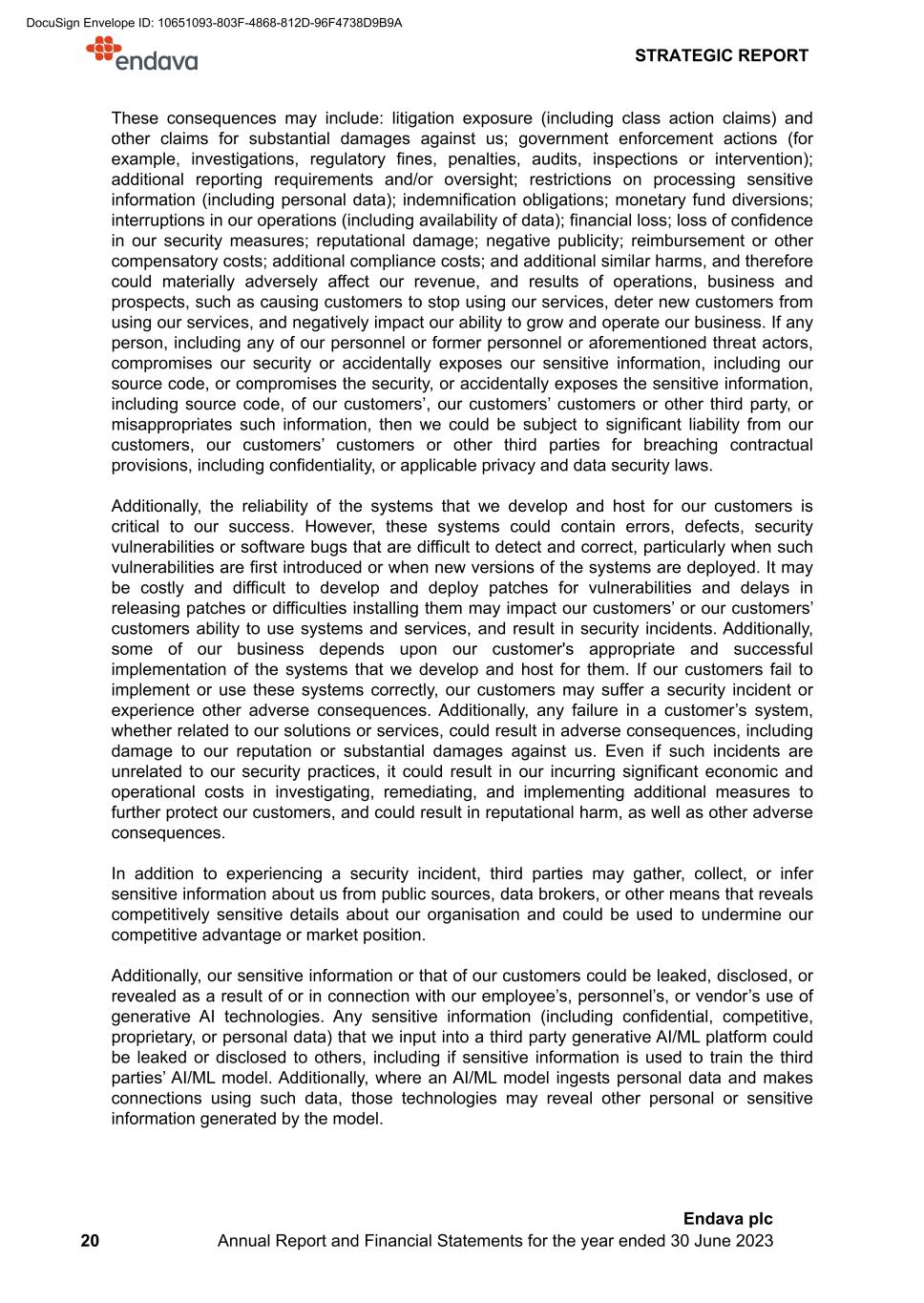
These consequences may include: litigation exposure (including class action claims) and other claims for substantial damages against us; government enforcement actions (for example, investigations, regulatory fines, penalties, audits, inspections or intervention); additional reporting requirements and/or oversight; restrictions on processing sensitive information (including personal data); indemnification obligations; monetary fund diversions; interruptions in our operations (including availability of data); financial loss; loss of confidence in our security measures; reputational damage; negative publicity; reimbursement or other compensatory costs; additional compliance costs; and additional similar harms, and therefore could materially adversely affect our revenue, and results of operations, business and prospects, such as causing customers to stop using our services, deter new customers from using our services, and negatively impact our ability to grow and operate our business. If any person, including any of our personnel or former personnel or aforementioned threat actors, compromises our security or accidentally exposes our sensitive information, including our source code, or compromises the security, or accidentally exposes the sensitive information, including source code, of our customers’, our customers’ customers or other third party, or misappropriates such information, then we could be subject to significant liability from our customers, our customers’ customers or other third parties for breaching contractual provisions, including confidentiality, or applicable privacy and data security laws. Additionally, the reliability of the systems that we develop and host for our customers is critical to our success. However, these systems could contain errors, defects, security vulnerabilities or software bugs that are difficult to detect and correct, particularly when such vulnerabilities are first introduced or when new versions of the systems are deployed. It may be costly and difficult to develop and deploy patches for vulnerabilities and delays in releasing patches or difficulties installing them may impact our customers’ or our customers’ customers ability to use systems and services, and result in security incidents. Additionally, some of our business depends upon our customer's appropriate and successful implementation of the systems that we develop and host for them. If our customers fail to implement or use these systems correctly, our customers may suffer a security incident or experience other adverse consequences. Additionally, any failure in a customer’s system, whether related to our solutions or services, could result in adverse consequences, including damage to our reputation or substantial damages against us. Even if such incidents are unrelated to our security practices, it could result in our incurring significant economic and operational costs in investigating, remediating, and implementing additional measures to further protect our customers, and could result in reputational harm, as well as other adverse consequences. In addition to experiencing a security incident, third parties may gather, collect, or infer sensitive information about us from public sources, data brokers, or other means that reveals competitively sensitive details about our organisation and could be used to undermine our competitive advantage or market position. Additionally, our sensitive information or that of our customers could be leaked, disclosed, or revealed as a result of or in connection with our employee’s, personnel’s, or vendor’s use of generative AI technologies. Any sensitive information (including confidential, competitive, proprietary, or personal data) that we input into a third party generative AI/ML platform could be leaked or disclosed to others, including if sensitive information is used to train the third parties’ AI/ML model. Additionally, where an AI/ML model ingests personal data and makes connections using such data, those technologies may reveal other personal or sensitive information generated by the model. STRATEGIC REPORT 20 Endava plc Annual Report and Financial Statements for the year ended 30 June 2023 DocuSign Envelope ID: 10651093-803F-4868-812D-96F4738D9B9A

Moreover, AI/ML models may create flawed, incomplete, or inaccurate outputs, some of which may appear correct. This may happen if the inputs that the model relied on were inaccurate, incomplete or flawed (including if a bad actor “poisons” the AI/ML with bad inputs or logic), or if the logic of the AI/ML is flawed (a so-called “hallucination”). We may use AI/ML outputs to make certain decisions. Due to these potential inaccuracies or flaws, the model could be biased and could lead us to make decisions that could bias certain individuals (or classes of individuals), and adversely impact their rights, employment, and ability to obtain certain pricing, products, services, or benefits. If such AI/ML-based outputs are deemed to be biased, we could face adverse consequences, including exposure to reputational and competitive harm, customer loss, and legal liability. If we provide inadequate service or cause disruptions in our clients’ businesses, it could result in significant costs to us, the loss of our clients and damage to our corporate reputation. Any defects or errors or failure to meet clients’ expectations in the performance of our contracts could result in claims for substantial damages against us. Our contracts generally limit our liability for damages that arise from negligent acts, error, mistakes or omissions in rendering services to our clients. However, we cannot be sure that these contractual provisions will protect us from liability for damages in the event we are sued. In addition, certain liabilities, such as claims of third parties for intellectual property infringement and breaches of data protection and security requirements, for which we may be required to indemnify our clients, could be substantial. The successful assertion of one or more large claims against us in amounts greater than those covered by our current insurance policies could materially adversely affect our business, financial condition and results of operations. Even if such assertions against us are unsuccessful, we may incur reputational harm and substantial legal fees. In addition, a failure or inability to meet a contractual requirement could seriously damage our corporate reputation and limit our ability to attract new business. In certain instances, we guarantee clients that we will complete a project by a scheduled date or that we will maintain certain service levels. We are generally not subject to monetary penalties for failing to complete projects by the scheduled date, but may suffer reputational harm and loss of future business if we do not meet our contractual commitments. In addition, if the project experiences a performance problem, we may not be able to recover the additional costs we will incur, which could exceed revenue realised from a project. Our contracts could be unprofitable. We perform our services primarily under time-and-materials contracts (where materials costs consist of travel and out-of-pocket expenses). We charge out the services performed by our employees under these contracts at daily or hourly rates that are agreed at the time at which the contract is entered. The rates and other pricing terms negotiated with our clients are highly dependent on our internal forecasts of our operating costs and predictions of increases in those costs influenced by wage inflation and other marketplace factors, as well as the volume of work required by the client. Our predictions are based on limited data and could turn out to be inaccurate, resulting in contracts that may not be profitable. Typically, we do not have the ability to increase the rates established at the outset of a client project, other than on an annual basis and often subject to caps. Independent of our right to increase our rates on an annual basis, client expectations regarding the anticipated cost of a project may limit our ability to increase our rates for ongoing work. STRATEGIC REPORT 21 Endava plc Annual Report and Financial Statements for the year ended 30 June 2023 DocuSign Envelope ID: 10651093-803F-4868-812D-96F4738D9B9A
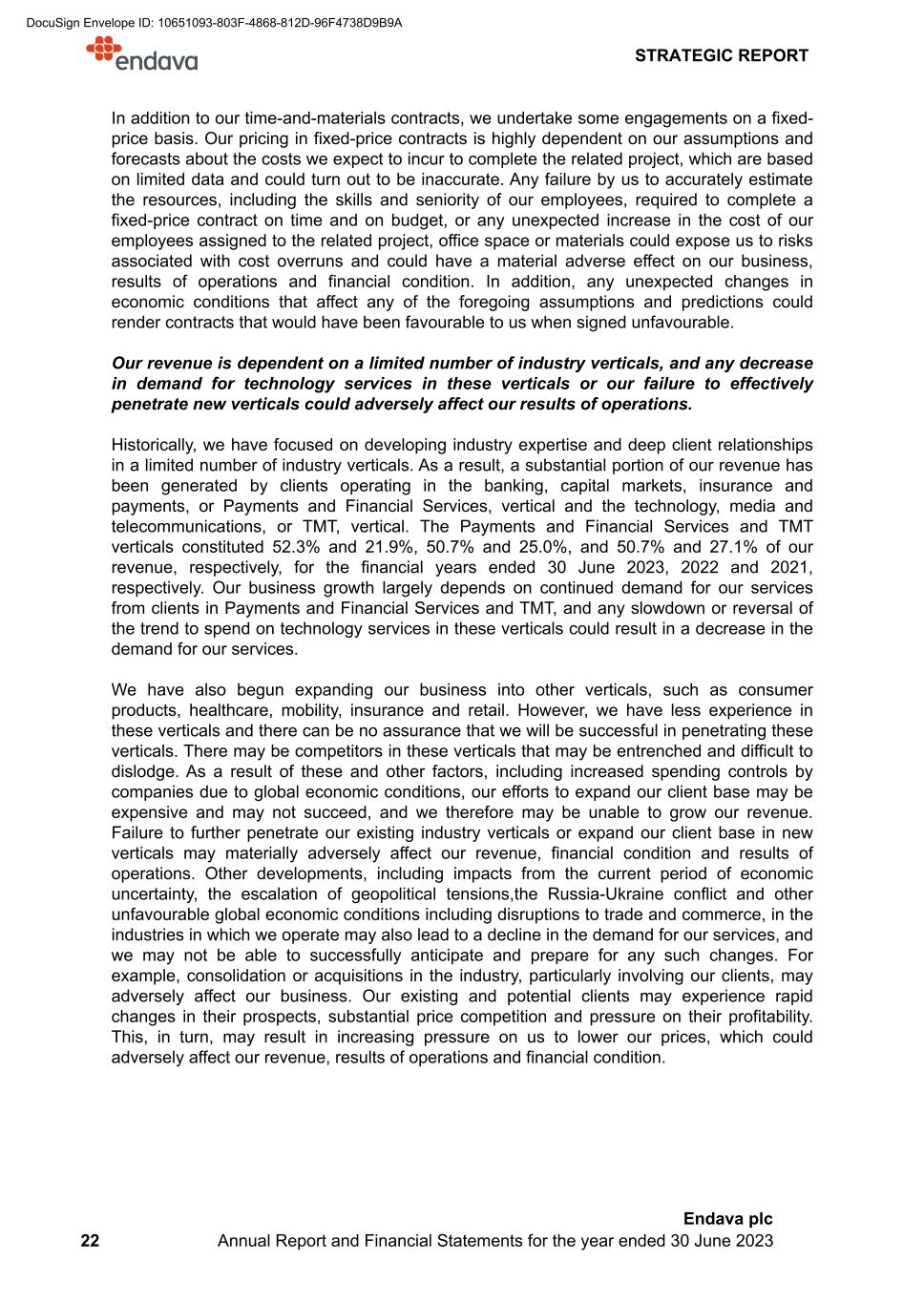
In addition to our time-and-materials contracts, we undertake some engagements on a fixed- price basis. Our pricing in fixed-price contracts is highly dependent on our assumptions and forecasts about the costs we expect to incur to complete the related project, which are based on limited data and could turn out to be inaccurate. Any failure by us to accurately estimate the resources, including the skills and seniority of our employees, required to complete a fixed-price contract on time and on budget, or any unexpected increase in the cost of our employees assigned to the related project, office space or materials could expose us to risks associated with cost overruns and could have a material adverse effect on our business, results of operations and financial condition. In addition, any unexpected changes in economic conditions that affect any of the foregoing assumptions and predictions could render contracts that would have been favourable to us when signed unfavourable. Our revenue is dependent on a limited number of industry verticals, and any decrease in demand for technology services in these verticals or our failure to effectively penetrate new verticals could adversely affect our results of operations. Historically, we have focused on developing industry expertise and deep client relationships in a limited number of industry verticals. As a result, a substantial portion of our revenue has been generated by clients operating in the banking, capital markets, insurance and payments, or Payments and Financial Services, vertical and the technology, media and telecommunications, or TMT, vertical. The Payments and Financial Services and TMT verticals constituted 52.3% and 21.9%, 50.7% and 25.0%, and 50.7% and 27.1% of our revenue, respectively, for the financial years ended 30 June 2023, 2022 and 2021, respectively. Our business growth largely depends on continued demand for our services from clients in Payments and Financial Services and TMT, and any slowdown or reversal of the trend to spend on technology services in these verticals could result in a decrease in the demand for our services. We have also begun expanding our business into other verticals, such as consumer products, healthcare, mobility, insurance and retail. However, we have less experience in these verticals and there can be no assurance that we will be successful in penetrating these verticals. There may be competitors in these verticals that may be entrenched and difficult to dislodge. As a result of these and other factors, including increased spending controls by companies due to global economic conditions, our efforts to expand our client base may be expensive and may not succeed, and we therefore may be unable to grow our revenue. Failure to further penetrate our existing industry verticals or expand our client base in new verticals may materially adversely affect our revenue, financial condition and results of operations. Other developments, including impacts from the current period of economic uncertainty, the escalation of geopolitical tensions,the Russia-Ukraine conflict and other unfavourable global economic conditions including disruptions to trade and commerce, in the industries in which we operate may also lead to a decline in the demand for our services, and we may not be able to successfully anticipate and prepare for any such changes. For example, consolidation or acquisitions in the industry, particularly involving our clients, may adversely affect our business. Our existing and potential clients may experience rapid changes in their prospects, substantial price competition and pressure on their profitability. This, in turn, may result in increasing pressure on us to lower our prices, which could adversely affect our revenue, results of operations and financial condition. STRATEGIC REPORT 22 Endava plc Annual Report and Financial Statements for the year ended 30 June 2023 DocuSign Envelope ID: 10651093-803F-4868-812D-96F4738D9B9A

We use generative AI tools in our operations, which may result in significant operational challenges, liability and reputational harm. We use generative AI tools in our operations, including to generate software code that is incorporated into our client deliverables and to gain data-driven insights, build predictive models and develop intelligent systems, and expect to use generative AI tools in the future. Generative AI refers to AI technology that creates new content (such as text, audio, data, images, video, software code) or Output, by leveraging content that the technology was trained on (e.g., through machine learning) in response to prompts submitted by a user, Prompts. Generative AI provides significant opportunities for new and efficient forms of content development, across a wide range of applications. However, generative AI is relatively new and the business, legal and ethical landscape regarding its use, commercialisation and regulation is unsettled and constantly evolving. Uncertainty in the legal regulatory regime relating to AI may require significant resources to modify and maintain business practices to comply with relevant U.S. and non-U.S. laws. For further information on the AI regulatory framework see also the risk factor titled “We are subject to stringent and evolving laws, regulations, rules, self-regulatory standards, policies, contractual obligations, and other obligations regarding privacy and data security matters, including in the European Union and the United Kingdom, where we have material operations. Our actual or perceived failure to comply with such obligations could expose us to regulatory investigations or actions, litigation, fines and penalties or other financial liabilities, disruption of our business operations, reputational harm, loss of revenue or profit, loss of customers or sales and/or adversely affect our ability to conduct our business.” While we have implemented policies to govern the use of generative AI tools by our personnel and any other person in the performance of services for our Company, the use of generative AI in aspects of our business may present material risks and challenges that could increase as generative AI tools become more prevalent. Recent decisions of the U.S. Copyright Office suggest that we would not be able to claim copyright ownership in any Output, and the availability of such protection in other countries is unclear. In the United Kingdom, copyright law may protect works generated by a computer where there is no human creator, however to date there has been no judicial treatment of these computer-generated work considerations in the context of generative AI. Therefore, even in jurisdictions where copyright protection may be extended to AI-generated works, the ownership of any Outputs generated using generative AI tools may be subject to legal challenge. As a result, we may not be the legal owner of the Output, which in turn is likely to prevent or limit our ability and the ability of our clients to enforce our respective rights in the Output or mean that both our clients and us are unable to prevent others from copying it or reusing it, or unable to stop the provider of the generative AI tool from providing identical Outputs to third parties. The generative AI tool’s terms of service may also declare that the provider of the generative AI tool owns the Outputs, or that it retains a broad right to re-use the Outputs beyond the right to use the Outputs (and the Prompts) to train the generative AI tool. In addition, we have little or no insight into the third-party content and materials used to train the generative AI tools, or the extent of the original works which remain in the Output. As a result, we and our clients may face claims from third parties alleging infringement of their intellectual property rights, or infringement of open-source licenses or other license terms. STRATEGIC REPORT 23 Endava plc Annual Report and Financial Statements for the year ended 30 June 2023 DocuSign Envelope ID: 10651093-803F-4868-812D-96F4738D9B9A
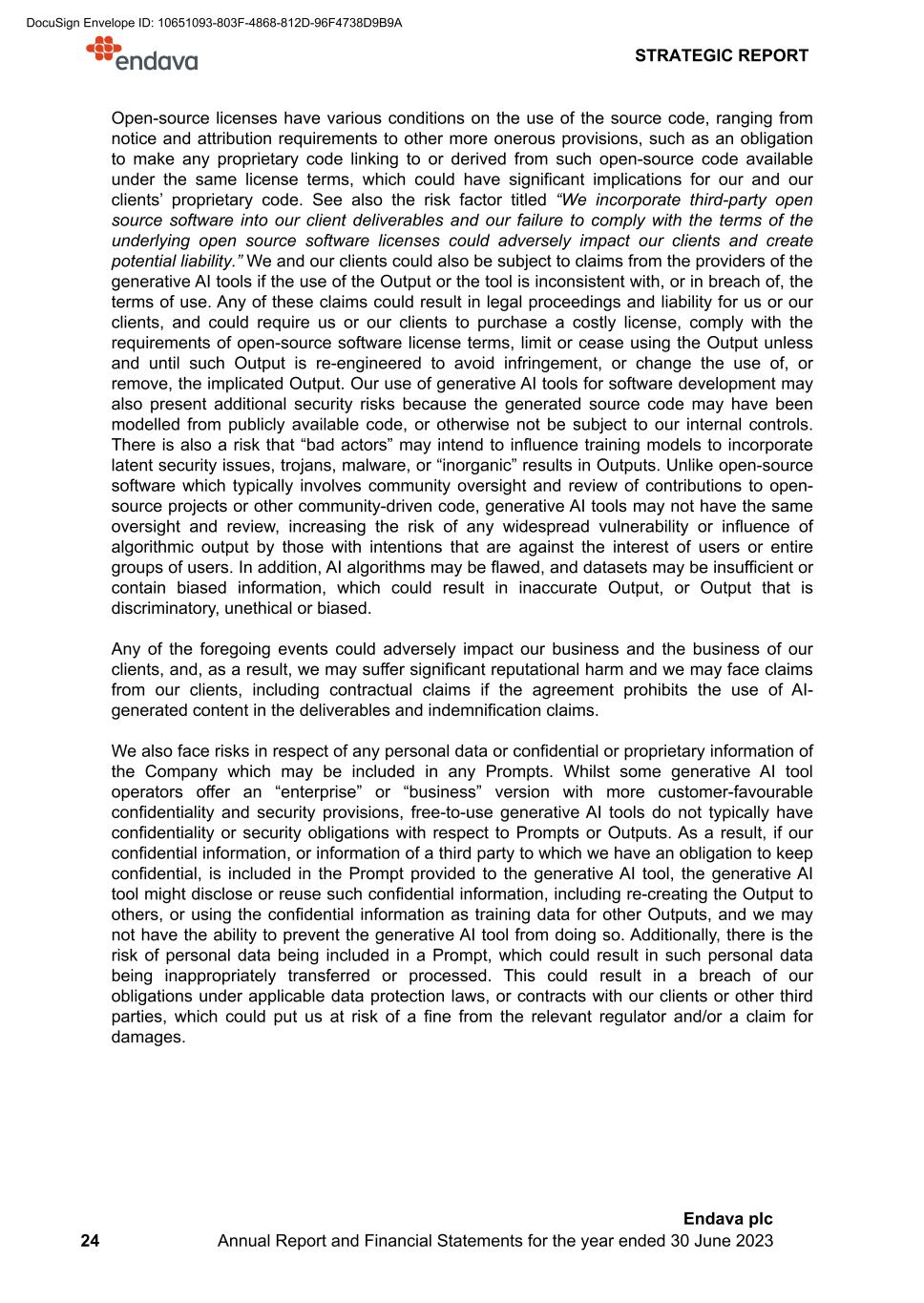
Open-source licenses have various conditions on the use of the source code, ranging from notice and attribution requirements to other more onerous provisions, such as an obligation to make any proprietary code linking to or derived from such open-source code available under the same license terms, which could have significant implications for our and our clients’ proprietary code. See also the risk factor titled “We incorporate third-party open source software into our client deliverables and our failure to comply with the terms of the underlying open source software licenses could adversely impact our clients and create potential liability.” We and our clients could also be subject to claims from the providers of the generative AI tools if the use of the Output or the tool is inconsistent with, or in breach of, the terms of use. Any of these claims could result in legal proceedings and liability for us or our clients, and could require us or our clients to purchase a costly license, comply with the requirements of open-source software license terms, limit or cease using the Output unless and until such Output is re-engineered to avoid infringement, or change the use of, or remove, the implicated Output. Our use of generative AI tools for software development may also present additional security risks because the generated source code may have been modelled from publicly available code, or otherwise not be subject to our internal controls. There is also a risk that “bad actors” may intend to influence training models to incorporate latent security issues, trojans, malware, or “inorganic” results in Outputs. Unlike open-source software which typically involves community oversight and review of contributions to open- source projects or other community-driven code, generative AI tools may not have the same oversight and review, increasing the risk of any widespread vulnerability or influence of algorithmic output by those with intentions that are against the interest of users or entire groups of users. In addition, AI algorithms may be flawed, and datasets may be insufficient or contain biased information, which could result in inaccurate Output, or Output that is discriminatory, unethical or biased. Any of the foregoing events could adversely impact our business and the business of our clients, and, as a result, we may suffer significant reputational harm and we may face claims from our clients, including contractual claims if the agreement prohibits the use of AI- generated content in the deliverables and indemnification claims. We also face risks in respect of any personal data or confidential or proprietary information of the Company which may be included in any Prompts. Whilst some generative AI tool operators offer an “enterprise” or “business” version with more customer-favourable confidentiality and security provisions, free-to-use generative AI tools do not typically have confidentiality or security obligations with respect to Prompts or Outputs. As a result, if our confidential information, or information of a third party to which we have an obligation to keep confidential, is included in the Prompt provided to the generative AI tool, the generative AI tool might disclose or reuse such confidential information, including re-creating the Output to others, or using the confidential information as training data for other Outputs, and we may not have the ability to prevent the generative AI tool from doing so. Additionally, there is the risk of personal data being included in a Prompt, which could result in such personal data being inappropriately transferred or processed. This could result in a breach of our obligations under applicable data protection laws, or contracts with our clients or other third parties, which could put us at risk of a fine from the relevant regulator and/or a claim for damages. STRATEGIC REPORT 24 Endava plc Annual Report and Financial Statements for the year ended 30 June 2023 DocuSign Envelope ID: 10651093-803F-4868-812D-96F4738D9B9A
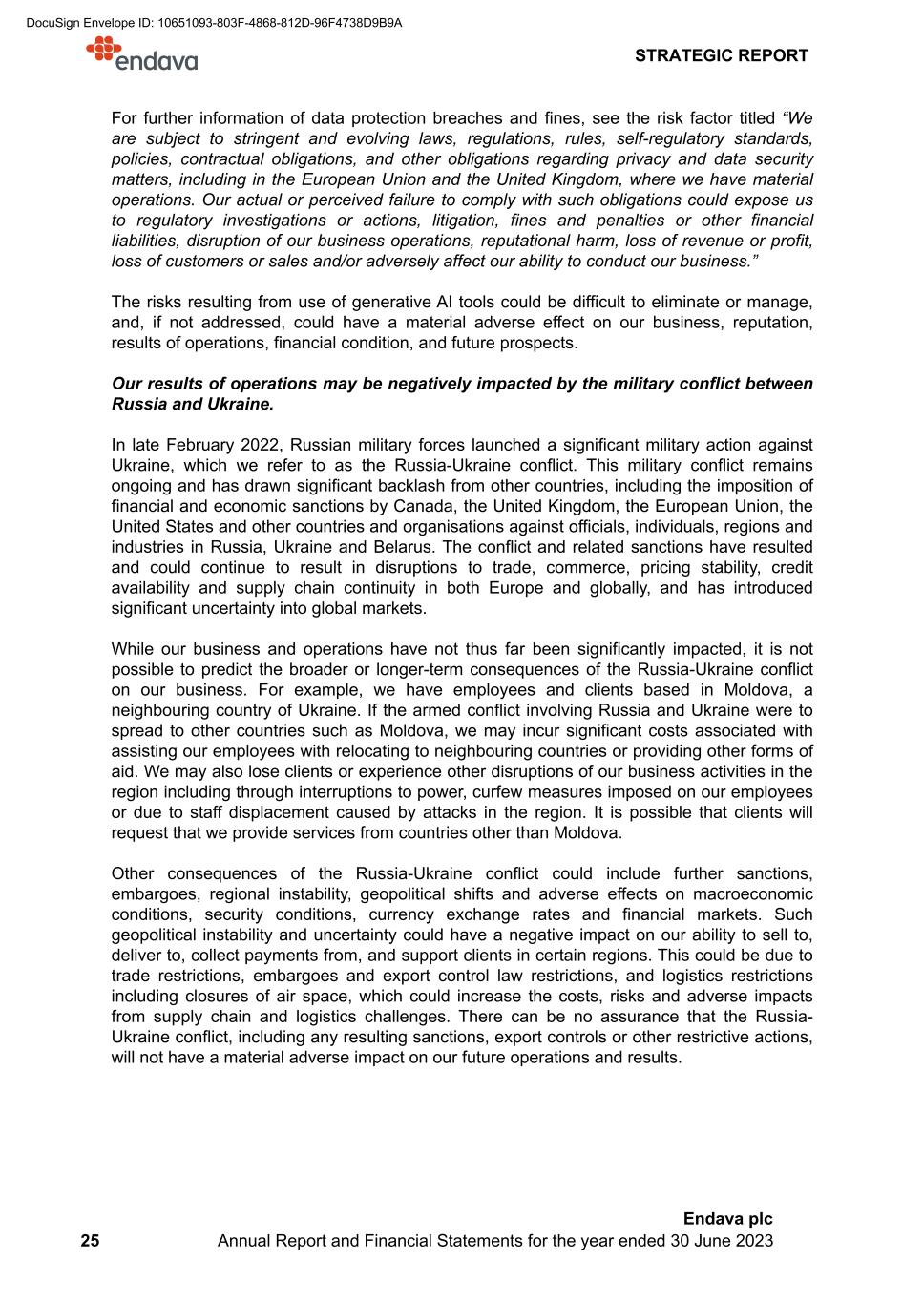
For further information of data protection breaches and fines, see the risk factor titled “We are subject to stringent and evolving laws, regulations, rules, self-regulatory standards, policies, contractual obligations, and other obligations regarding privacy and data security matters, including in the European Union and the United Kingdom, where we have material operations. Our actual or perceived failure to comply with such obligations could expose us to regulatory investigations or actions, litigation, fines and penalties or other financial liabilities, disruption of our business operations, reputational harm, loss of revenue or profit, loss of customers or sales and/or adversely affect our ability to conduct our business.” The risks resulting from use of generative AI tools could be difficult to eliminate or manage, and, if not addressed, could have a material adverse effect on our business, reputation, results of operations, financial condition, and future prospects. Our results of operations may be negatively impacted by the military conflict between Russia and Ukraine. In late February 2022, Russian military forces launched a significant military action against Ukraine, which we refer to as the Russia-Ukraine conflict. This military conflict remains ongoing and has drawn significant backlash from other countries, including the imposition of financial and economic sanctions by Canada, the United Kingdom, the European Union, the United States and other countries and organisations against officials, individuals, regions and industries in Russia, Ukraine and Belarus. The conflict and related sanctions have resulted and could continue to result in disruptions to trade, commerce, pricing stability, credit availability and supply chain continuity in both Europe and globally, and has introduced significant uncertainty into global markets. While our business and operations have not thus far been significantly impacted, it is not possible to predict the broader or longer-term consequences of the Russia-Ukraine conflict on our business. For example, we have employees and clients based in Moldova, a neighbouring country of Ukraine. If the armed conflict involving Russia and Ukraine were to spread to other countries such as Moldova, we may incur significant costs associated with assisting our employees with relocating to neighbouring countries or providing other forms of aid. We may also lose clients or experience other disruptions of our business activities in the region including through interruptions to power, curfew measures imposed on our employees or due to staff displacement caused by attacks in the region. It is possible that clients will request that we provide services from countries other than Moldova. Other consequences of the Russia-Ukraine conflict could include further sanctions, embargoes, regional instability, geopolitical shifts and adverse effects on macroeconomic conditions, security conditions, currency exchange rates and financial markets. Such geopolitical instability and uncertainty could have a negative impact on our ability to sell to, deliver to, collect payments from, and support clients in certain regions. This could be due to trade restrictions, embargoes and export control law restrictions, and logistics restrictions including closures of air space, which could increase the costs, risks and adverse impacts from supply chain and logistics challenges. There can be no assurance that the Russia- Ukraine conflict, including any resulting sanctions, export controls or other restrictive actions, will not have a material adverse impact on our future operations and results. STRATEGIC REPORT 25 Endava plc Annual Report and Financial Statements for the year ended 30 June 2023 DocuSign Envelope ID: 10651093-803F-4868-812D-96F4738D9B9A
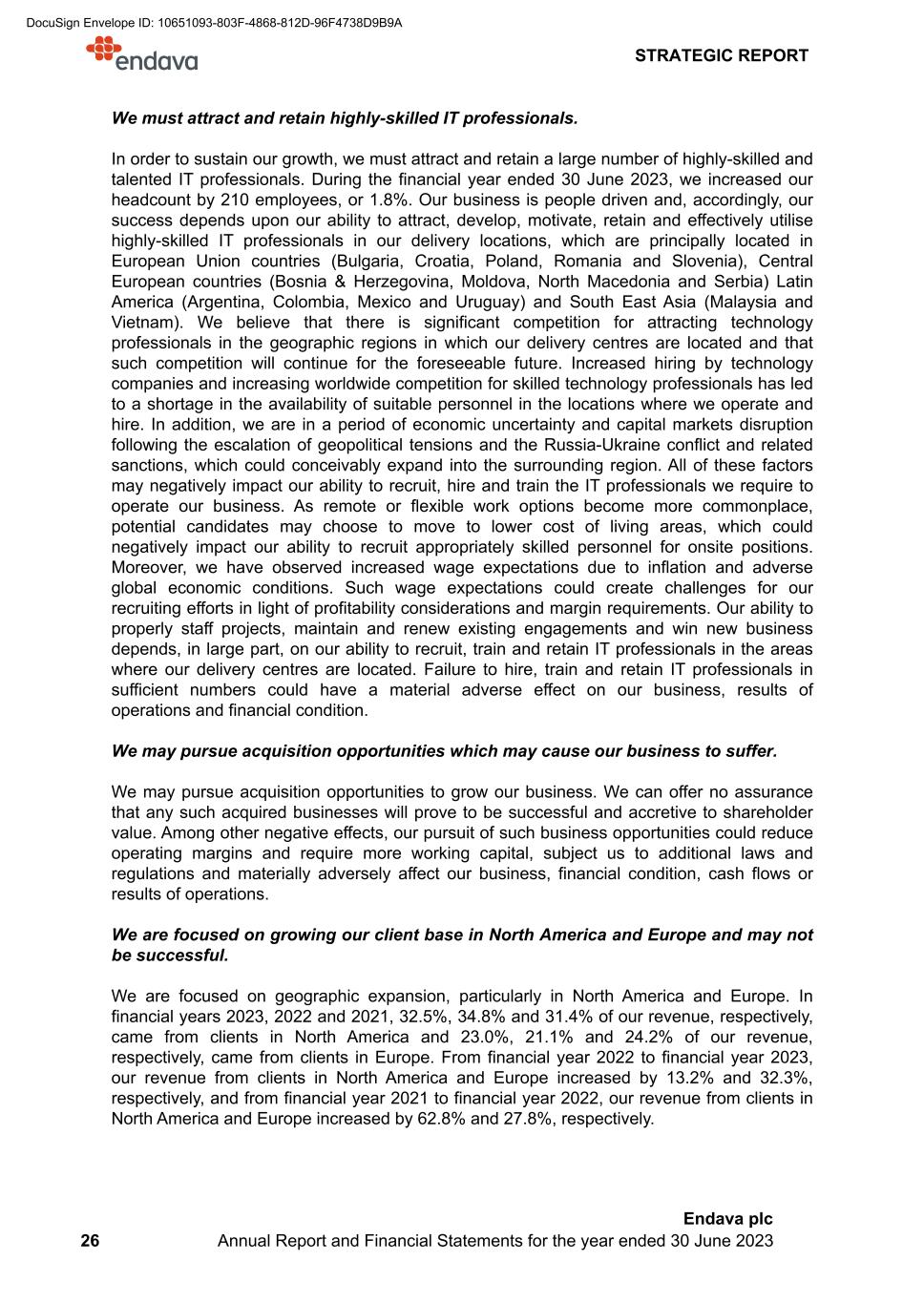
We must attract and retain highly-skilled IT professionals. In order to sustain our growth, we must attract and retain a large number of highly-skilled and talented IT professionals. During the financial year ended 30 June 2023, we increased our headcount by 210 employees, or 1.8%. Our business is people driven and, accordingly, our success depends upon our ability to attract, develop, motivate, retain and effectively utilise highly-skilled IT professionals in our delivery locations, which are principally located in European Union countries (Bulgaria, Croatia, Poland, Romania and Slovenia), Central European countries (Bosnia & Herzegovina, Moldova, North Macedonia and Serbia) Latin America (Argentina, Colombia, Mexico and Uruguay) and South East Asia (Malaysia and Vietnam). We believe that there is significant competition for attracting technology professionals in the geographic regions in which our delivery centres are located and that such competition will continue for the foreseeable future. Increased hiring by technology companies and increasing worldwide competition for skilled technology professionals has led to a shortage in the availability of suitable personnel in the locations where we operate and hire. In addition, we are in a period of economic uncertainty and capital markets disruption following the escalation of geopolitical tensions and the Russia-Ukraine conflict and related sanctions, which could conceivably expand into the surrounding region. All of these factors may negatively impact our ability to recruit, hire and train the IT professionals we require to operate our business. As remote or flexible work options become more commonplace, potential candidates may choose to move to lower cost of living areas, which could negatively impact our ability to recruit appropriately skilled personnel for onsite positions. Moreover, we have observed increased wage expectations due to inflation and adverse global economic conditions. Such wage expectations could create challenges for our recruiting efforts in light of profitability considerations and margin requirements. Our ability to properly staff projects, maintain and renew existing engagements and win new business depends, in large part, on our ability to recruit, train and retain IT professionals in the areas where our delivery centres are located. Failure to hire, train and retain IT professionals in sufficient numbers could have a material adverse effect on our business, results of operations and financial condition. We may pursue acquisition opportunities which may cause our business to suffer. We may pursue acquisition opportunities to grow our business. We can offer no assurance that any such acquired businesses will prove to be successful and accretive to shareholder value. Among other negative effects, our pursuit of such business opportunities could reduce operating margins and require more working capital, subject us to additional laws and regulations and materially adversely affect our business, financial condition, cash flows or results of operations. We are focused on growing our client base in North America and Europe and may not be successful. We are focused on geographic expansion, particularly in North America and Europe. In financial years 2023, 2022 and 2021, 32.5%, 34.8% and 31.4% of our revenue, respectively, came from clients in North America and 23.0%, 21.1% and 24.2% of our revenue, respectively, came from clients in Europe. From financial year 2022 to financial year 2023, our revenue from clients in North America and Europe increased by 13.2% and 32.3%, respectively, and from financial year 2021 to financial year 2022, our revenue from clients in North America and Europe increased by 62.8% and 27.8%, respectively. STRATEGIC REPORT 26 Endava plc Annual Report and Financial Statements for the year ended 30 June 2023 DocuSign Envelope ID: 10651093-803F-4868-812D-96F4738D9B9A
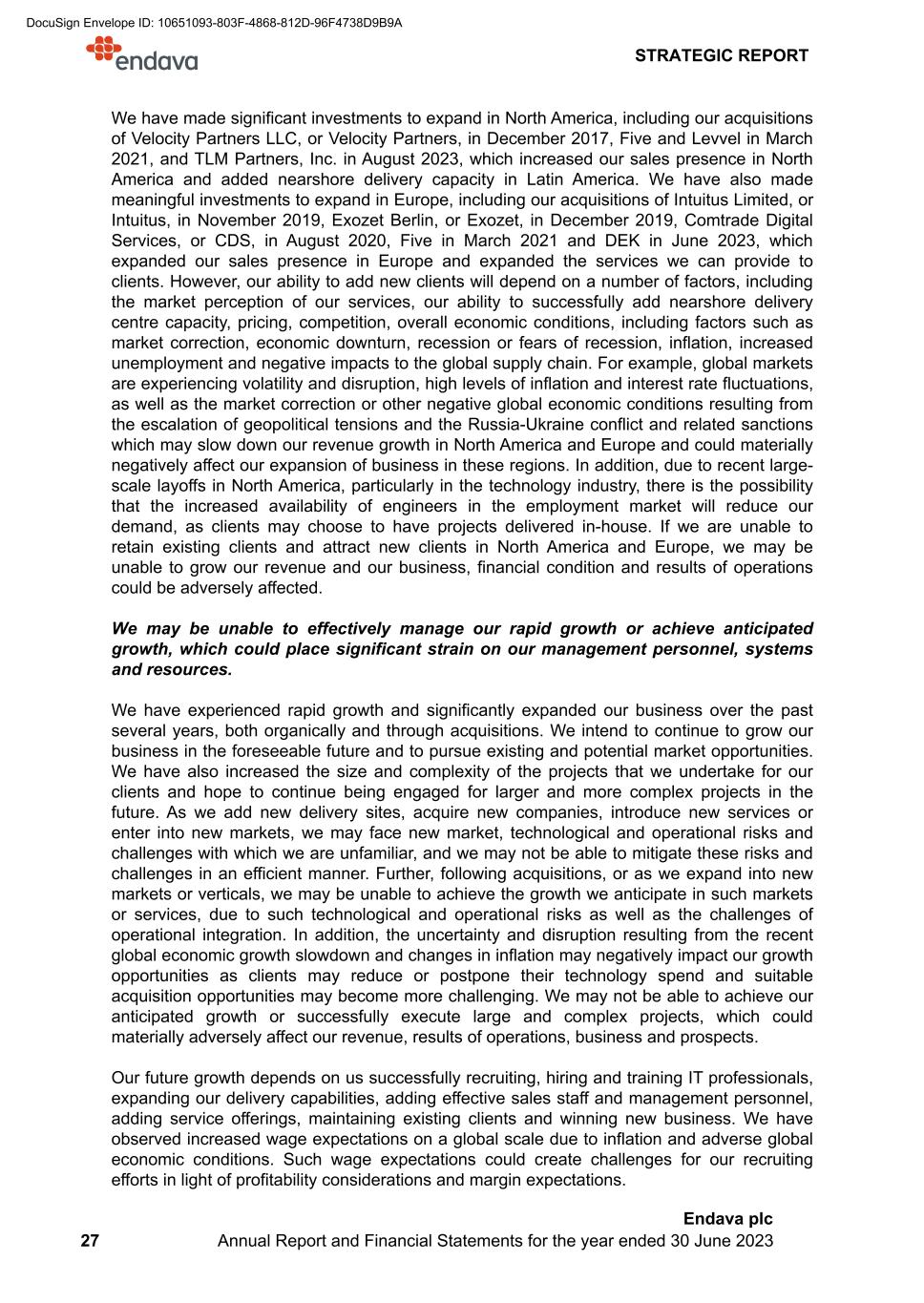
We have made significant investments to expand in North America, including our acquisitions of Velocity Partners LLC, or Velocity Partners, in December 2017, Five and Levvel in March 2021, and TLM Partners, Inc. in August 2023, which increased our sales presence in North America and added nearshore delivery capacity in Latin America. We have also made meaningful investments to expand in Europe, including our acquisitions of Intuitus Limited, or Intuitus, in November 2019, Exozet Berlin, or Exozet, in December 2019, Comtrade Digital Services, or CDS, in August 2020, Five in March 2021 and DEK in June 2023, which expanded our sales presence in Europe and expanded the services we can provide to clients. However, our ability to add new clients will depend on a number of factors, including the market perception of our services, our ability to successfully add nearshore delivery centre capacity, pricing, competition, overall economic conditions, including factors such as market correction, economic downturn, recession or fears of recession, inflation, increased unemployment and negative impacts to the global supply chain. For example, global markets are experiencing volatility and disruption, high levels of inflation and interest rate fluctuations, as well as the market correction or other negative global economic conditions resulting from the escalation of geopolitical tensions and the Russia-Ukraine conflict and related sanctions which may slow down our revenue growth in North America and Europe and could materially negatively affect our expansion of business in these regions. In addition, due to recent large- scale layoffs in North America, particularly in the technology industry, there is the possibility that the increased availability of engineers in the employment market will reduce our demand, as clients may choose to have projects delivered in-house. If we are unable to retain existing clients and attract new clients in North America and Europe, we may be unable to grow our revenue and our business, financial condition and results of operations could be adversely affected. We may be unable to effectively manage our rapid growth or achieve anticipated growth, which could place significant strain on our management personnel, systems and resources. We have experienced rapid growth and significantly expanded our business over the past several years, both organically and through acquisitions. We intend to continue to grow our business in the foreseeable future and to pursue existing and potential market opportunities. We have also increased the size and complexity of the projects that we undertake for our clients and hope to continue being engaged for larger and more complex projects in the future. As we add new delivery sites, acquire new companies, introduce new services or enter into new markets, we may face new market, technological and operational risks and challenges with which we are unfamiliar, and we may not be able to mitigate these risks and challenges in an efficient manner. Further, following acquisitions, or as we expand into new markets or verticals, we may be unable to achieve the growth we anticipate in such markets or services, due to such technological and operational risks as well as the challenges of operational integration. In addition, the uncertainty and disruption resulting from the recent global economic growth slowdown and changes in inflation may negatively impact our growth opportunities as clients may reduce or postpone their technology spend and suitable acquisition opportunities may become more challenging. We may not be able to achieve our anticipated growth or successfully execute large and complex projects, which could materially adversely affect our revenue, results of operations, business and prospects. Our future growth depends on us successfully recruiting, hiring and training IT professionals, expanding our delivery capabilities, adding effective sales staff and management personnel, adding service offerings, maintaining existing clients and winning new business. We have observed increased wage expectations on a global scale due to inflation and adverse global economic conditions. Such wage expectations could create challenges for our recruiting efforts in light of profitability considerations and margin expectations. STRATEGIC REPORT 27 Endava plc Annual Report and Financial Statements for the year ended 30 June 2023 DocuSign Envelope ID: 10651093-803F-4868-812D-96F4738D9B9A
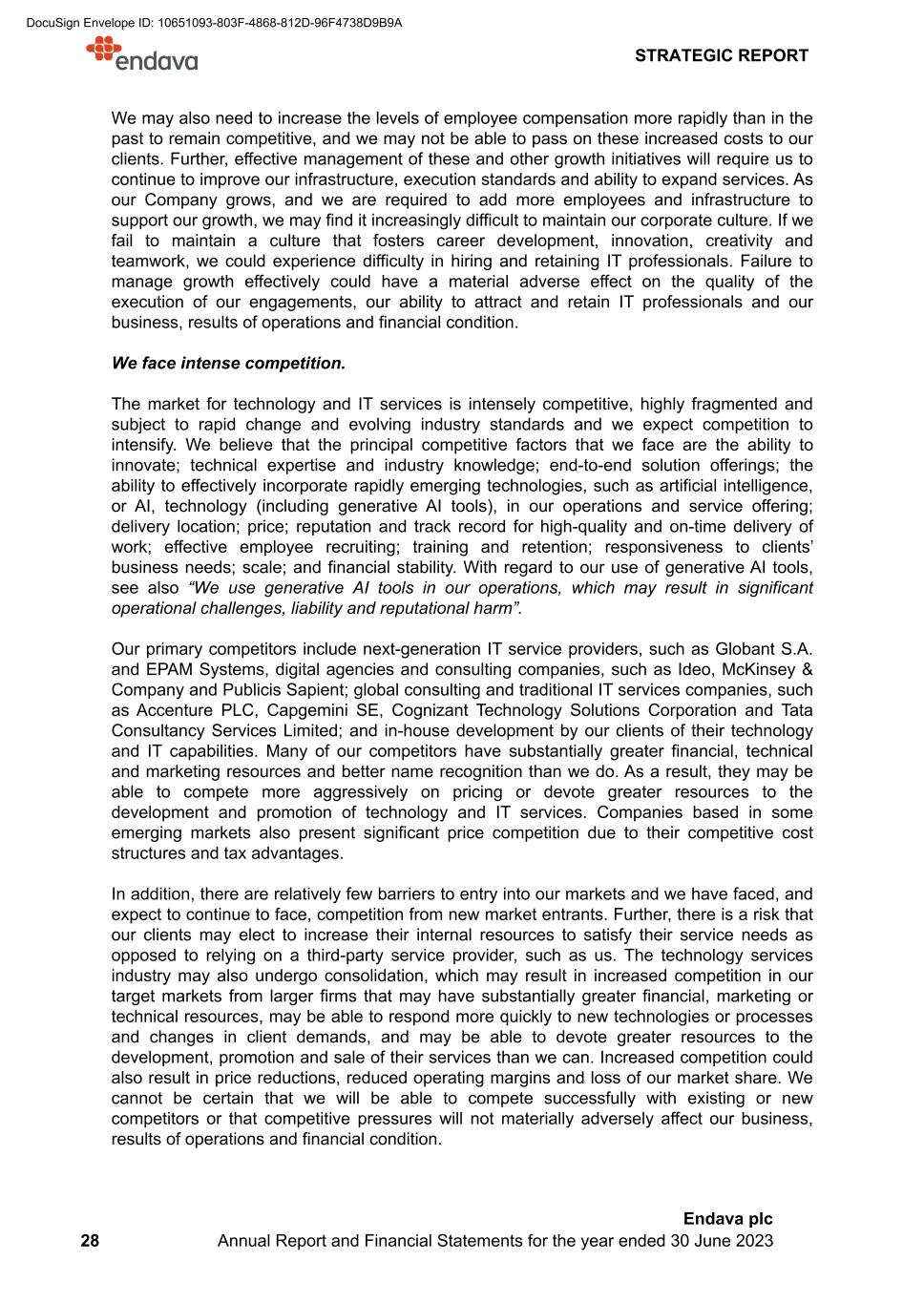
We may also need to increase the levels of employee compensation more rapidly than in the past to remain competitive, and we may not be able to pass on these increased costs to our clients. Further, effective management of these and other growth initiatives will require us to continue to improve our infrastructure, execution standards and ability to expand services. As our Company grows, and we are required to add more employees and infrastructure to support our growth, we may find it increasingly difficult to maintain our corporate culture. If we fail to maintain a culture that fosters career development, innovation, creativity and teamwork, we could experience difficulty in hiring and retaining IT professionals. Failure to manage growth effectively could have a material adverse effect on the quality of the execution of our engagements, our ability to attract and retain IT professionals and our business, results of operations and financial condition. We face intense competition. The market for technology and IT services is intensely competitive, highly fragmented and subject to rapid change and evolving industry standards and we expect competition to intensify. We believe that the principal competitive factors that we face are the ability to innovate; technical expertise and industry knowledge; end-to-end solution offerings; the ability to effectively incorporate rapidly emerging technologies, such as artificial intelligence, or AI, technology (including generative AI tools), in our operations and service offering; delivery location; price; reputation and track record for high-quality and on-time delivery of work; effective employee recruiting; training and retention; responsiveness to clients’ business needs; scale; and financial stability. With regard to our use of generative AI tools, see also “We use generative AI tools in our operations, which may result in significant operational challenges, liability and reputational harm”. Our primary competitors include next-generation IT service providers, such as Globant S.A. and EPAM Systems, digital agencies and consulting companies, such as Ideo, McKinsey & Company and Publicis Sapient; global consulting and traditional IT services companies, such as Accenture PLC, Capgemini SE, Cognizant Technology Solutions Corporation and Tata Consultancy Services Limited; and in-house development by our clients of their technology and IT capabilities. Many of our competitors have substantially greater financial, technical and marketing resources and better name recognition than we do. As a result, they may be able to compete more aggressively on pricing or devote greater resources to the development and promotion of technology and IT services. Companies based in some emerging markets also present significant price competition due to their competitive cost structures and tax advantages. In addition, there are relatively few barriers to entry into our markets and we have faced, and expect to continue to face, competition from new market entrants. Further, there is a risk that our clients may elect to increase their internal resources to satisfy their service needs as opposed to relying on a third-party service provider, such as us. The technology services industry may also undergo consolidation, which may result in increased competition in our target markets from larger firms that may have substantially greater financial, marketing or technical resources, may be able to respond more quickly to new technologies or processes and changes in client demands, and may be able to devote greater resources to the development, promotion and sale of their services than we can. Increased competition could also result in price reductions, reduced operating margins and loss of our market share. We cannot be certain that we will be able to compete successfully with existing or new competitors or that competitive pressures will not materially adversely affect our business, results of operations and financial condition. STRATEGIC REPORT 28 Endava plc Annual Report and Financial Statements for the year ended 30 June 2023 DocuSign Envelope ID: 10651093-803F-4868-812D-96F4738D9B9A

If we do not continue to innovate and remain at the forefront of emerging technologies and related market trends, we may lose clients and not remain competitive. Our success depends on delivering innovative solutions that leverage emerging technologies and emerging market trends to drive increased revenue. Technological advances and innovation are constant in the technology services industry. As a result, we must continue to invest significant resources to stay abreast of technology developments so that we may continue to deliver solutions that our clients will wish to purchase. If we are unable to anticipate technology developments, enhance our existing services or develop and introduce new services to keep pace with such changes and meet changing client needs, we may lose clients and our revenue and results of operations could suffer. Our results of operations would also suffer if our employees are not responsive to the needs of our clients, not able to help clients in driving innovation and not able to help our clients in effectively bringing innovative ideas to market. The increasing reliance on automation, AI, machine learning, or ML, and other new technologies by our clients may reduce the demand for our services if we are unable to incorporate these technologies into our offering, which may adversely impact our results of operations. Our competitors may be able to offer engineering, design and innovation services that are, or that are perceived to be, substantially similar or better than those we offer. This may force us to reduce our daily rates and to expend significant resources in order to remain competitive, which we may be unable to do profitably or at all. Because many of our clients and potential clients regularly contract with other IT service providers, these competitive pressures may be more acute than in other industries. We are dependent on members of our senior management team and other key employees. Our future success heavily depends upon the continued services of our senior management team, particularly our Chief Executive Officer John Cotterell, as well as other key senior-level employees. We currently do not maintain key man life insurance for any of the members of our senior management team or other key employees. We also do not have long-term employment contracts with all of our key employees. We are only entitled to six to 12 months’ prior notice if our executive officers intend to terminate their respective employment with us and three months’ prior notice if any of our other senior executives intend to terminate their respective employment with us. If one or more of our senior executives or key employees are unable or unwilling to continue in their present positions, it could disrupt our business operations, and we may not be able to replace them easily, on a timely basis or at all. In addition, competition for senior executives and key employees in our industry is intense, and we may be unable to retain our senior executives and key employees or attract and retain new senior executives and key employees in the future, in which case our business may be severely disrupted. If any of our senior management team or key employees joins a competitor or forms a competing company, we may lose clients, suppliers, know-how and IT professionals and staff members to them. Also, if any of our sales executives or other sales personnel, who generally maintain close relationships with our clients, joins a competitor or forms a competing company, we may lose clients to that company, and our revenue may be materially adversely affected. Additionally, there could be unauthorised disclosure or use of our technical knowledge, business practices or procedures by such personnel. Any non- competition, non-solicitation or non-disclosure agreements we have with our senior executives or key employees might not provide effective protection to us in light of legal uncertainties associated with the enforceability of such agreements. STRATEGIC REPORT 29 Endava plc Annual Report and Financial Statements for the year ended 30 June 2023 DocuSign Envelope ID: 10651093-803F-4868-812D-96F4738D9B9A

Additionally, we have a number of current employees whose equity ownership in our company gives them a substantial amount of personal wealth. As a result, it may be difficult for us to continue to retain and motivate these employees. Further, many of our employees hold Class B ordinary shares that were subject to certain selling restrictions until July 2023. Following the expiration of these restrictions, holders of Class B ordinary shares are able to convert their Class B ordinary shares to Class A ordinary shares and sell the Class A ordinary shares in the market. Sales of our ADSs by our employees in the open market or the perception that such sales may occur may negatively impact the market price of our ADSs. The risk that our employees may sell ADSs in the open market may be made more acute given we do not anticipate paying dividends in the foreseeable future, meaning open market sales or sales in registered offerings may be our employees’ only means of generating liquidity from their ownership of our securities. We must maintain adequate employee utilisation rates and productivity levels. Our profitability and the cost of providing our services are affected by our utilisation rates of our employees in our delivery locations. If we are not able to maintain appropriate utilisation rates for our employees involved in delivery of our services, our profit margin and our profitability may suffer. Our utilisation rates are affected by a number of factors, including: • our ability to promptly transition our employees from completed projects to new assignments and to hire and integrate new employees; • our ability to forecast demand for our services (and which may be impacted due to the effects of unfavourable global economic conditions) and thereby maintain an appropriate number of employees in each of our delivery locations; • our ability to deploy employees with appropriate skills and seniority to projects; • our ability to manage the attrition of our employees; and • our need to devote time and resources to training, professional development and other activities that cannot be billed to our clients. Our revenue could also suffer if we misjudge demand patterns, including as a result of uncertainties related to disruptions to trade, commerce, pricing stability, credit availability and supply chain continuity, global public health pandemics, the Russia-Ukraine conflict and any other global economic and geopolitical conditions and do not recruit or sustain sufficient employees to satisfy demand. Employee shortages could prevent us from completing our contractual commitments in a timely manner and cause us to lose contracts or clients. Further, to the extent that we lack or fail to sustain sufficient employees with lower levels of seniority and daily or hourly rates, we may be required to deploy more senior employees with higher rates on projects without the ability to pass such higher rates along to our clients, which could adversely affect our profit margin and profitability. Our business will suffer if we are not successful in delivering contracted services. Our operating results are dependent on our ability to successfully deliver contracted services in a timely manner. We must consistently build, deliver and support complex projects. Failure to perform or observe any contractual obligations, including our inability to comply with local laws and regulations, could damage our relationships with our clients and could result in cancellation or non-renewal of a contract. Some of the challenges we face in delivering contracted services to our clients include: • maintaining high-quality control and process execution standards; • maintaining planned resource utilisation rates on a consistent basis; STRATEGIC REPORT 30 Endava plc Annual Report and Financial Statements for the year ended 30 June 2023 DocuSign Envelope ID: 10651093-803F-4868-812D-96F4738D9B9A
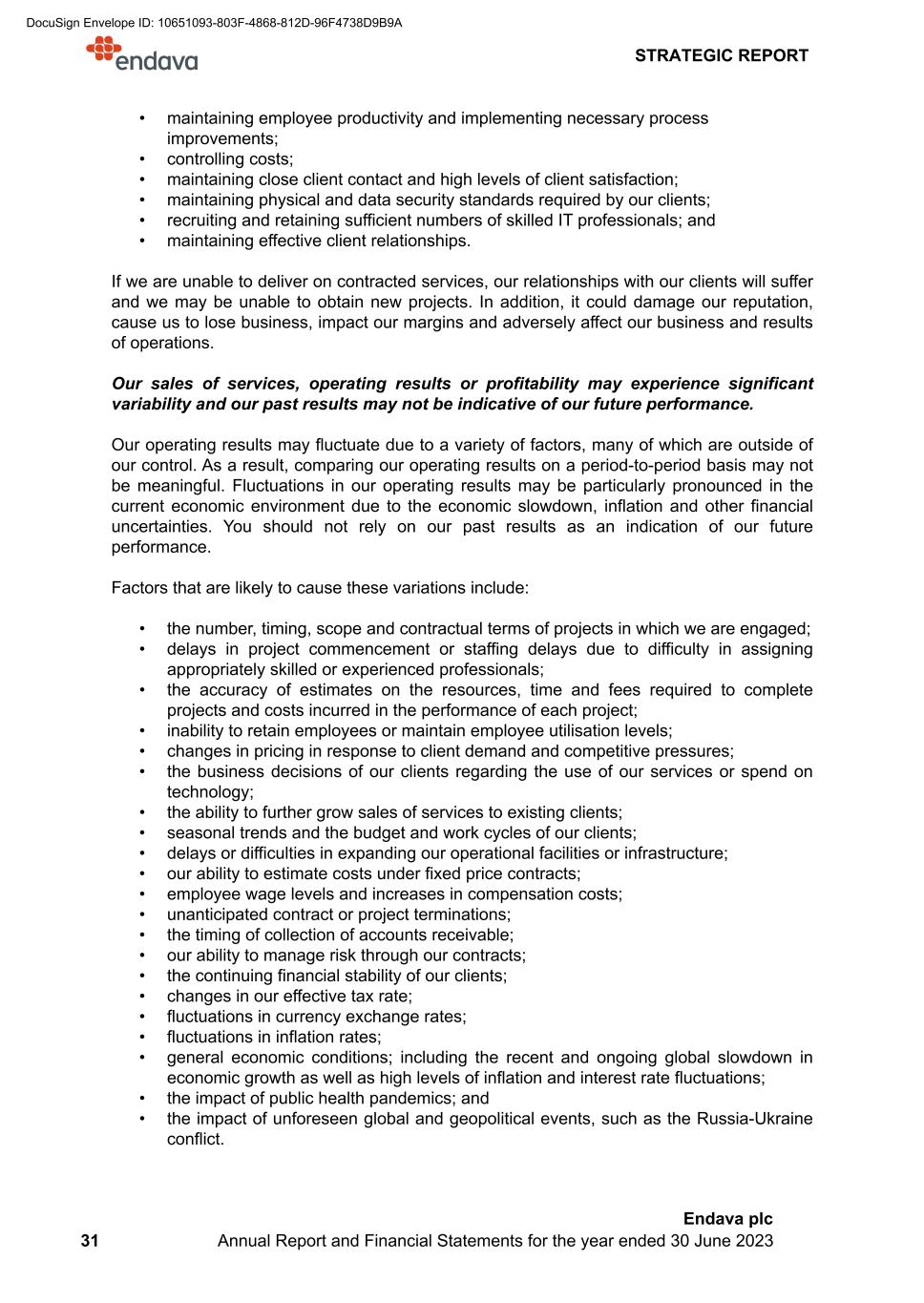
• maintaining employee productivity and implementing necessary process improvements; • controlling costs; • maintaining close client contact and high levels of client satisfaction; • maintaining physical and data security standards required by our clients; • recruiting and retaining sufficient numbers of skilled IT professionals; and • maintaining effective client relationships. If we are unable to deliver on contracted services, our relationships with our clients will suffer and we may be unable to obtain new projects. In addition, it could damage our reputation, cause us to lose business, impact our margins and adversely affect our business and results of operations. Our sales of services, operating results or profitability may experience significant variability and our past results may not be indicative of our future performance. Our operating results may fluctuate due to a variety of factors, many of which are outside of our control. As a result, comparing our operating results on a period-to-period basis may not be meaningful. Fluctuations in our operating results may be particularly pronounced in the current economic environment due to the economic slowdown, inflation and other financial uncertainties. You should not rely on our past results as an indication of our future performance. Factors that are likely to cause these variations include: • the number, timing, scope and contractual terms of projects in which we are engaged; • delays in project commencement or staffing delays due to difficulty in assigning appropriately skilled or experienced professionals; • the accuracy of estimates on the resources, time and fees required to complete projects and costs incurred in the performance of each project; • inability to retain employees or maintain employee utilisation levels; • changes in pricing in response to client demand and competitive pressures; • the business decisions of our clients regarding the use of our services or spend on technology; • the ability to further grow sales of services to existing clients; • seasonal trends and the budget and work cycles of our clients; • delays or difficulties in expanding our operational facilities or infrastructure; • our ability to estimate costs under fixed price contracts; • employee wage levels and increases in compensation costs; • unanticipated contract or project terminations; • the timing of collection of accounts receivable; • our ability to manage risk through our contracts; • the continuing financial stability of our clients; • changes in our effective tax rate; • fluctuations in currency exchange rates; • fluctuations in inflation rates; • general economic conditions; including the recent and ongoing global slowdown in economic growth as well as high levels of inflation and interest rate fluctuations; • the impact of public health pandemics; and • the impact of unforeseen global and geopolitical events, such as the Russia-Ukraine conflict. STRATEGIC REPORT 31 Endava plc Annual Report and Financial Statements for the year ended 30 June 2023 DocuSign Envelope ID: 10651093-803F-4868-812D-96F4738D9B9A
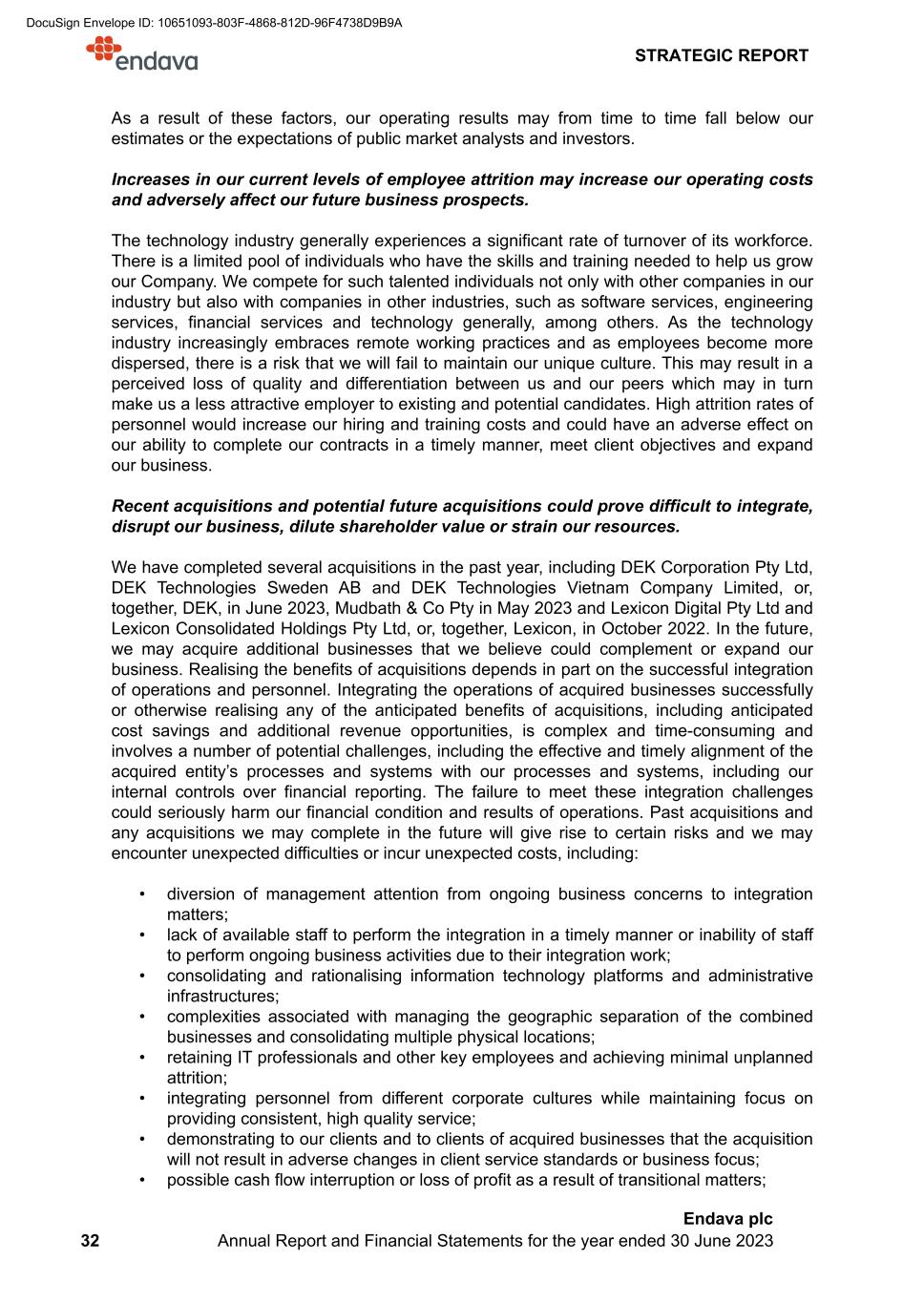
As a result of these factors, our operating results may from time to time fall below our estimates or the expectations of public market analysts and investors. Increases in our current levels of employee attrition may increase our operating costs and adversely affect our future business prospects. The technology industry generally experiences a significant rate of turnover of its workforce. There is a limited pool of individuals who have the skills and training needed to help us grow our Company. We compete for such talented individuals not only with other companies in our industry but also with companies in other industries, such as software services, engineering services, financial services and technology generally, among others. As the technology industry increasingly embraces remote working practices and as employees become more dispersed, there is a risk that we will fail to maintain our unique culture. This may result in a perceived loss of quality and differentiation between us and our peers which may in turn make us a less attractive employer to existing and potential candidates. High attrition rates of personnel would increase our hiring and training costs and could have an adverse effect on our ability to complete our contracts in a timely manner, meet client objectives and expand our business. Recent acquisitions and potential future acquisitions could prove difficult to integrate, disrupt our business, dilute shareholder value or strain our resources. We have completed several acquisitions in the past year, including DEK Corporation Pty Ltd, DEK Technologies Sweden AB and DEK Technologies Vietnam Company Limited, or, together, DEK, in June 2023, Mudbath & Co Pty in May 2023 and Lexicon Digital Pty Ltd and Lexicon Consolidated Holdings Pty Ltd, or, together, Lexicon, in October 2022. In the future, we may acquire additional businesses that we believe could complement or expand our business. Realising the benefits of acquisitions depends in part on the successful integration of operations and personnel. Integrating the operations of acquired businesses successfully or otherwise realising any of the anticipated benefits of acquisitions, including anticipated cost savings and additional revenue opportunities, is complex and time-consuming and involves a number of potential challenges, including the effective and timely alignment of the acquired entity’s processes and systems with our processes and systems, including our internal controls over financial reporting. The failure to meet these integration challenges could seriously harm our financial condition and results of operations. Past acquisitions and any acquisitions we may complete in the future will give rise to certain risks and we may encounter unexpected difficulties or incur unexpected costs, including: • diversion of management attention from ongoing business concerns to integration matters; • lack of available staff to perform the integration in a timely manner or inability of staff to perform ongoing business activities due to their integration work; • consolidating and rationalising information technology platforms and administrative infrastructures; • complexities associated with managing the geographic separation of the combined businesses and consolidating multiple physical locations; • retaining IT professionals and other key employees and achieving minimal unplanned attrition; • integrating personnel from different corporate cultures while maintaining focus on providing consistent, high quality service; • demonstrating to our clients and to clients of acquired businesses that the acquisition will not result in adverse changes in client service standards or business focus; • possible cash flow interruption or loss of profit as a result of transitional matters; STRATEGIC REPORT 32 Endava plc Annual Report and Financial Statements for the year ended 30 June 2023 DocuSign Envelope ID: 10651093-803F-4868-812D-96F4738D9B9A

• inability to generate sufficient profit to offset acquisition and integration costs in a reasonable timeframe or at all; and • inability to achieve the operating synergies anticipated in the acquisitions. Additionally, acquired businesses may have liabilities or adverse operating issues that we fail to discover through due diligence prior to the acquisition. In particular, to the extent that prior owners of any acquired businesses or properties failed to comply with or otherwise violated applicable laws or regulations, or failed to fulfil their contractual obligations to clients, we, as the successor owner, may be financially responsible for these violations and failures and may suffer financial or reputational harm or otherwise be adversely affected. Acquisitions also frequently result in the recording of goodwill and other intangible assets which are subject to potential impairment in the future that could harm our financial results. We may also become subject to new regulations as a result of an acquisition, including if we acquire a business serving clients in a regulated industry or acquire a business with clients or operations in a country in which we do not already operate. In addition, if we finance acquisitions by issuing convertible debt or equity securities, our existing shareholders may be diluted, which could affect the market price of our ADSs. As a result, if we fail to properly evaluate acquisitions or investments, we may not achieve the anticipated benefits of any such acquisitions, and we may incur costs in excess of what we anticipate. Acquisitions frequently involve benefits related to the integration of operations of the acquired business. The failure to successfully integrate the operations or otherwise to realize any of the anticipated benefits of the acquisition could seriously harm our results of operations. We operate in a rapidly evolving industry, which makes it difficult to evaluate our future prospects. The technology services industry is competitive and continuously evolving and is subject to rapidly changing demands and constant technological developments. As a result, success and performance metrics are difficult to predict and measure in our industry. Because services and technologies are rapidly evolving and each company within the industry can vary greatly in terms of the services it provides, its business model, and its results of operations, it can be difficult to predict how any company’s services, including ours, will be received in the market. This has been highlighted by the recent rapid increase in interest in AI and ML technologies. Neither our past financial performance nor the past financial performance of any other company in the technology services industry is indicative of how our Company will fare financially in the future. Our future profits may vary substantially from those of other companies and those we have achieved in the past, making an investment in our company risky and speculative. If our clients’ demand for our services declines as a result of economic conditions, market factors or shifts in the technology industry, our business would suffer and our results of operations and financial condition would be adversely affected. We may be subject to liability claims for actual or perceived breaches of our contracts, which may not contain limitations of liability, and our insurance may be inadequate to cover our losses. We are subject to numerous obligations, including indemnity obligations, in our contracts with our clients and suppliers. Despite the procedures, systems and internal controls we have implemented to comply with our contracts, we may breach these commitments, whether through a failure to comply with applicable laws or regulations, a weakness in our procedures, systems and internal controls, inability to prevent acts by third parties, such as cyber threat actors or negligence or the willful act of an employee or contractor. STRATEGIC REPORT 33 Endava plc Annual Report and Financial Statements for the year ended 30 June 2023 DocuSign Envelope ID: 10651093-803F-4868-812D-96F4738D9B9A
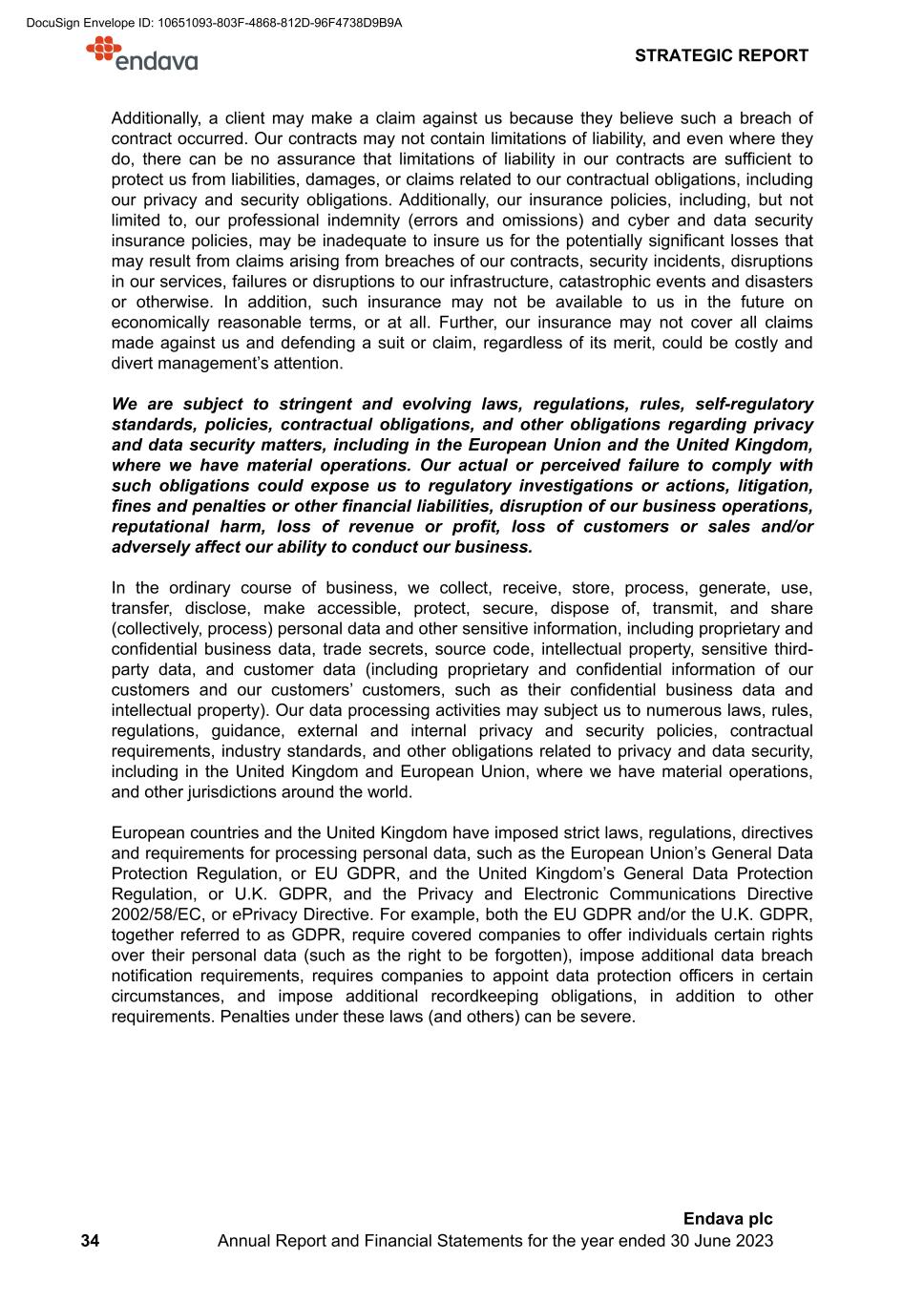
Additionally, a client may make a claim against us because they believe such a breach of contract occurred. Our contracts may not contain limitations of liability, and even where they do, there can be no assurance that limitations of liability in our contracts are sufficient to protect us from liabilities, damages, or claims related to our contractual obligations, including our privacy and security obligations. Additionally, our insurance policies, including, but not limited to, our professional indemnity (errors and omissions) and cyber and data security insurance policies, may be inadequate to insure us for the potentially significant losses that may result from claims arising from breaches of our contracts, security incidents, disruptions in our services, failures or disruptions to our infrastructure, catastrophic events and disasters or otherwise. In addition, such insurance may not be available to us in the future on economically reasonable terms, or at all. Further, our insurance may not cover all claims made against us and defending a suit or claim, regardless of its merit, could be costly and divert management’s attention. We are subject to stringent and evolving laws, regulations, rules, self-regulatory standards, policies, contractual obligations, and other obligations regarding privacy and data security matters, including in the European Union and the United Kingdom, where we have material operations. Our actual or perceived failure to comply with such obligations could expose us to regulatory investigations or actions, litigation, fines and penalties or other financial liabilities, disruption of our business operations, reputational harm, loss of revenue or profit, loss of customers or sales and/or adversely affect our ability to conduct our business. In the ordinary course of business, we collect, receive, store, process, generate, use, transfer, disclose, make accessible, protect, secure, dispose of, transmit, and share (collectively, process) personal data and other sensitive information, including proprietary and confidential business data, trade secrets, source code, intellectual property, sensitive third- party data, and customer data (including proprietary and confidential information of our customers and our customers’ customers, such as their confidential business data and intellectual property). Our data processing activities may subject us to numerous laws, rules, regulations, guidance, external and internal privacy and security policies, contractual requirements, industry standards, and other obligations related to privacy and data security, including in the United Kingdom and European Union, where we have material operations, and other jurisdictions around the world. European countries and the United Kingdom have imposed strict laws, regulations, directives and requirements for processing personal data, such as the European Union’s General Data Protection Regulation, or EU GDPR, and the United Kingdom’s General Data Protection Regulation, or U.K. GDPR, and the Privacy and Electronic Communications Directive 2002/58/EC, or ePrivacy Directive. For example, both the EU GDPR and/or the U.K. GDPR, together referred to as GDPR, require covered companies to offer individuals certain rights over their personal data (such as the right to be forgotten), impose additional data breach notification requirements, requires companies to appoint data protection officers in certain circumstances, and impose additional recordkeeping obligations, in addition to other requirements. Penalties under these laws (and others) can be severe. STRATEGIC REPORT 34 Endava plc Annual Report and Financial Statements for the year ended 30 June 2023 DocuSign Envelope ID: 10651093-803F-4868-812D-96F4738D9B9A
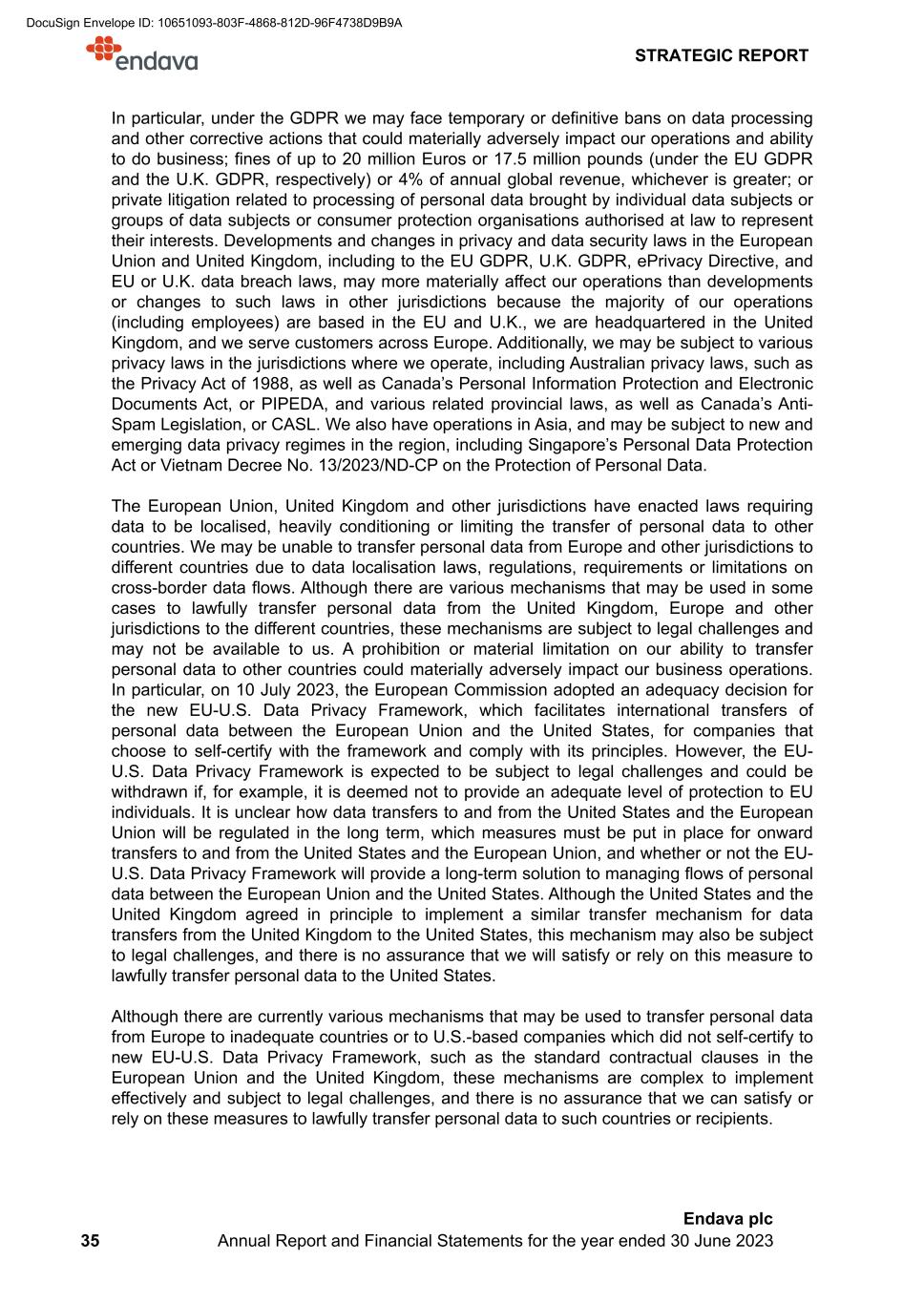
In particular, under the GDPR we may face temporary or definitive bans on data processing and other corrective actions that could materially adversely impact our operations and ability to do business; fines of up to 20 million Euros or 17.5 million pounds (under the EU GDPR and the U.K. GDPR, respectively) or 4% of annual global revenue, whichever is greater; or private litigation related to processing of personal data brought by individual data subjects or groups of data subjects or consumer protection organisations authorised at law to represent their interests. Developments and changes in privacy and data security laws in the European Union and United Kingdom, including to the EU GDPR, U.K. GDPR, ePrivacy Directive, and EU or U.K. data breach laws, may more materially affect our operations than developments or changes to such laws in other jurisdictions because the majority of our operations (including employees) are based in the EU and U.K., we are headquartered in the United Kingdom, and we serve customers across Europe. Additionally, we may be subject to various privacy laws in the jurisdictions where we operate, including Australian privacy laws, such as the Privacy Act of 1988, as well as Canada’s Personal Information Protection and Electronic Documents Act, or PIPEDA, and various related provincial laws, as well as Canada’s Anti- Spam Legislation, or CASL. We also have operations in Asia, and may be subject to new and emerging data privacy regimes in the region, including Singapore’s Personal Data Protection Act or Vietnam Decree No. 13/2023/ND-CP on the Protection of Personal Data. The European Union, United Kingdom and other jurisdictions have enacted laws requiring data to be localised, heavily conditioning or limiting the transfer of personal data to other countries. We may be unable to transfer personal data from Europe and other jurisdictions to different countries due to data localisation laws, regulations, requirements or limitations on cross-border data flows. Although there are various mechanisms that may be used in some cases to lawfully transfer personal data from the United Kingdom, Europe and other jurisdictions to the different countries, these mechanisms are subject to legal challenges and may not be available to us. A prohibition or material limitation on our ability to transfer personal data to other countries could materially adversely impact our business operations. In particular, on 10 July 2023, the European Commission adopted an adequacy decision for the new EU-U.S. Data Privacy Framework, which facilitates international transfers of personal data between the European Union and the United States, for companies that choose to self-certify with the framework and comply with its principles. However, the EU- U.S. Data Privacy Framework is expected to be subject to legal challenges and could be withdrawn if, for example, it is deemed not to provide an adequate level of protection to EU individuals. It is unclear how data transfers to and from the United States and the European Union will be regulated in the long term, which measures must be put in place for onward transfers to and from the United States and the European Union, and whether or not the EU- U.S. Data Privacy Framework will provide a long-term solution to managing flows of personal data between the European Union and the United States. Although the United States and the United Kingdom agreed in principle to implement a similar transfer mechanism for data transfers from the United Kingdom to the United States, this mechanism may also be subject to legal challenges, and there is no assurance that we will satisfy or rely on this measure to lawfully transfer personal data to the United States. Although there are currently various mechanisms that may be used to transfer personal data from Europe to inadequate countries or to U.S.-based companies which did not self-certify to new EU-U.S. Data Privacy Framework, such as the standard contractual clauses in the European Union and the United Kingdom, these mechanisms are complex to implement effectively and subject to legal challenges, and there is no assurance that we can satisfy or rely on these measures to lawfully transfer personal data to such countries or recipients. STRATEGIC REPORT 35 Endava plc Annual Report and Financial Statements for the year ended 30 June 2023 DocuSign Envelope ID: 10651093-803F-4868-812D-96F4738D9B9A

The European Commission adopted an adequacy decision for the new EU-U.S. Data Privacy Framework, which facilitates international transfers of personal data between the European Union and the United States, for companies that choose to self-certify with the framework and comply with its principle, but the Framework may be subject to legal challenges and certifications may be withdrawn. Although the United States and the United Kingdom agreed in principle to implement a similar transfer mechanism for data transfers from the United Kingdom to the United States, this mechanism may also be subject to legal challenges, and there is no assurance that we will satisfy or rely on this measure to lawfully transfer personal data to the U.S. Other jurisdictions may adopt similarly stringent data localisation and cross- border data transfer laws, or such laws may be stringently interpreted by regulators. If there is no lawful manner for us to transfer personal data from the United Kingdom, Europe or other jurisdictions to different countries, or if the requirements for a legally-compliant transfer are too onerous, we could face materially adverse consequences, including the interruption or degradation of our operations, the need to relocate part of or all of our business or data processing activities to other jurisdictions at significant expense, increased exposure to regulatory actions, substantial fines and penalties, the inability to transfer data and work with partners, vendors and other third parties, and injunctions against our processing or transferring of personal data necessary to operate our business. Notably, some European regulators have prevented companies from transferring personal data out of Europe for allegedly violating GDPR and the EU’s cross-border data transfer limitations. Additionally, some of our customer contracts may require us to host personal data locally, and this further complicates our ability to transfer and process personal data in order to provide our services, operate and earn revenue. In the United States, federal, state, and local governments have enacted numerous privacy and data security laws, including consumer protection laws (e.g., Section 5 of the Federal Trade Commission Act), data breach notification laws, and personal data privacy laws. For example, the federal Health Insurance Portability and Accountability Act of 1996, or HIPAA imposes specific requirements relating to the privacy, security, and transmission of individually identifiable health information, including on entities such as ours which are business associates under HIPAA. Various states have also implemented laws regulating the use and disclosure of individually identifiable health information. Additionally, some of our U.S. healthcare industry customers may rely on our solutions to protect information as required by HIPAA and related regulations. As another example, the California Consumer Privacy Act, as amended by the California Privacy Rights Act of 2020, or CPRA, collectively, the CCPA, applies to personal information of consumers, business representatives, and employees who are California residents, and requires businesses to provide specific disclosures in privacy notices and honour requests of such individuals to exercise certain privacy rights. The CCPA provides for administrative fines of up to $7,500 per violation and allows private litigants affected by certain data breaches to recover significant statutory damages. The CPRA expands the CCPA’s requirements including by adding a new right for individuals to correct their personal information and establishing a new regulatory agency to implement and enforce the law. Other states, such as Virginia, Utah and Colorado, have also passed comprehensive privacy laws, and similar laws are being considered in several other states. These developments may further complicate compliance efforts, and may increase legal risk and compliance costs for us, the third parties upon whom we rely, and our customers. Additionally, privacy and data security laws have been proposed at the federal, state, and local levels in recent years, which could further complicate compliance efforts. STRATEGIC REPORT 36 Endava plc Annual Report and Financial Statements for the year ended 30 June 2023 DocuSign Envelope ID: 10651093-803F-4868-812D-96F4738D9B9A
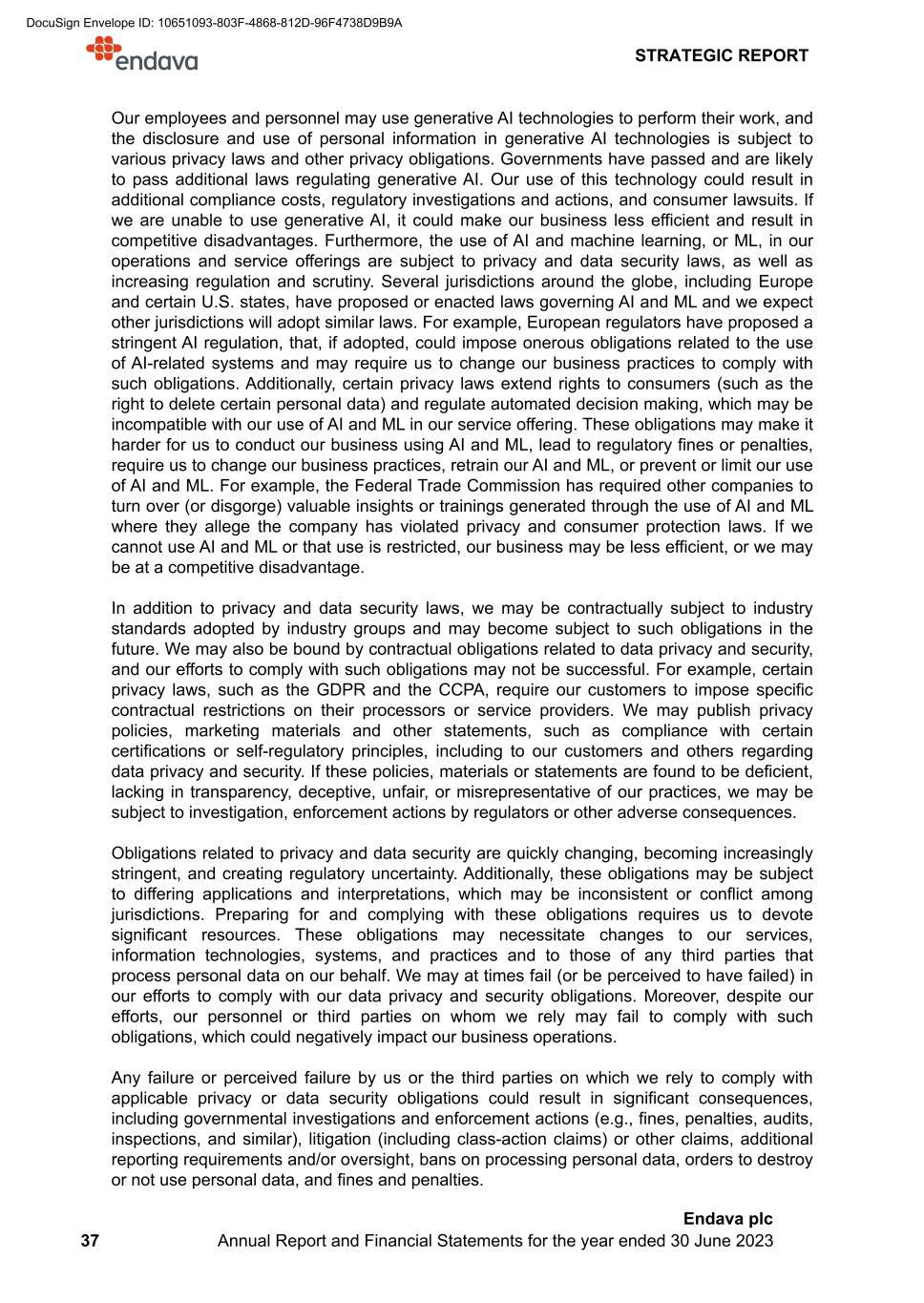
Our employees and personnel may use generative AI technologies to perform their work, and the disclosure and use of personal information in generative AI technologies is subject to various privacy laws and other privacy obligations. Governments have passed and are likely to pass additional laws regulating generative AI. Our use of this technology could result in additional compliance costs, regulatory investigations and actions, and consumer lawsuits. If we are unable to use generative AI, it could make our business less efficient and result in competitive disadvantages. Furthermore, the use of AI and machine learning, or ML, in our operations and service offerings are subject to privacy and data security laws, as well as increasing regulation and scrutiny. Several jurisdictions around the globe, including Europe and certain U.S. states, have proposed or enacted laws governing AI and ML and we expect other jurisdictions will adopt similar laws. For example, European regulators have proposed a stringent AI regulation, that, if adopted, could impose onerous obligations related to the use of AI-related systems and may require us to change our business practices to comply with such obligations. Additionally, certain privacy laws extend rights to consumers (such as the right to delete certain personal data) and regulate automated decision making, which may be incompatible with our use of AI and ML in our service offering. These obligations may make it harder for us to conduct our business using AI and ML, lead to regulatory fines or penalties, require us to change our business practices, retrain our AI and ML, or prevent or limit our use of AI and ML. For example, the Federal Trade Commission has required other companies to turn over (or disgorge) valuable insights or trainings generated through the use of AI and ML where they allege the company has violated privacy and consumer protection laws. If we cannot use AI and ML or that use is restricted, our business may be less efficient, or we may be at a competitive disadvantage. In addition to privacy and data security laws, we may be contractually subject to industry standards adopted by industry groups and may become subject to such obligations in the future. We may also be bound by contractual obligations related to data privacy and security, and our efforts to comply with such obligations may not be successful. For example, certain privacy laws, such as the GDPR and the CCPA, require our customers to impose specific contractual restrictions on their processors or service providers. We may publish privacy policies, marketing materials and other statements, such as compliance with certain certifications or self-regulatory principles, including to our customers and others regarding data privacy and security. If these policies, materials or statements are found to be deficient, lacking in transparency, deceptive, unfair, or misrepresentative of our practices, we may be subject to investigation, enforcement actions by regulators or other adverse consequences. Obligations related to privacy and data security are quickly changing, becoming increasingly stringent, and creating regulatory uncertainty. Additionally, these obligations may be subject to differing applications and interpretations, which may be inconsistent or conflict among jurisdictions. Preparing for and complying with these obligations requires us to devote significant resources. These obligations may necessitate changes to our services, information technologies, systems, and practices and to those of any third parties that process personal data on our behalf. We may at times fail (or be perceived to have failed) in our efforts to comply with our data privacy and security obligations. Moreover, despite our efforts, our personnel or third parties on whom we rely may fail to comply with such obligations, which could negatively impact our business operations. Any failure or perceived failure by us or the third parties on which we rely to comply with applicable privacy or data security obligations could result in significant consequences, including governmental investigations and enforcement actions (e.g., fines, penalties, audits, inspections, and similar), litigation (including class-action claims) or other claims, additional reporting requirements and/or oversight, bans on processing personal data, orders to destroy or not use personal data, and fines and penalties. STRATEGIC REPORT 37 Endava plc Annual Report and Financial Statements for the year ended 30 June 2023 DocuSign Envelope ID: 10651093-803F-4868-812D-96F4738D9B9A

In particular, plaintiffs have become increasingly more active in bringing privacy-related claims against companies, including class claims and mass arbitration demands. Some of these claims allow for the recovery of statutory damages on a per violation basis, and, if viable, carry the potential for monumental statutory damages, depending on the volume of data and the number of violations. Any of these events could have a material adverse effect on our reputation, business or financial condition, including but not limited to: adverse publicity, loss of trust in us by our clients and partners, reputational harm, inability to process personal data or to operate in certain jurisdictions, expenditure of time and resources to defend any claim or inquiry, and interruptions or stoppages in our business operations. Further, any failure of us to correct business processed that is departing from privacy compliant legal obligations, or any failure of us to adopt or implement business processes that are ensuring compliance with applicable privacy laws, constitute a risk that should be mitigated by adequate efforts brought synergic by various internal teams (legal, compliance, audit, business processes and training). We are dependent on our existing client base and our ability to retain such clients. A significant percentage of our revenue comes from our existing client base. For example, during the financial year ended 30 June 2023, 93.0% of our revenue came from clients from whom we generated revenue during the prior financial years. Additionally, during the financial years ended 30 June 2023, 2022 and 2021, our 10 largest clients accounted for 32.8%, 33.8% and 34.9% of our revenue, respectively. However, the volume of work performed for a specific client is likely to vary from year to year, especially since we generally do not have long-term commitments from our clients and are often not our clients’ exclusive technology services provider. A major client in one year may not provide the same level of revenue for us in any subsequent years. Further, one or more of our significant clients could be acquired and there can be no assurance that the acquirer would choose to use our services to the same degree as previously, if at all. In particular, some of our clients are owned by private equity firms and are, therefore, inherently more likely to be sold at some point in the future. In addition, the services we provide to our clients, and the revenue and income from those services, may decline or vary as the type and quantity of services we provide changes over time. Our reliance on any individual client for a significant portion of our revenue may give that client a certain degree of pricing leverage against us when negotiating contracts and terms of service. In order to successfully perform and market our services, we must establish and maintain long-term relationships with our clients and develop a thorough understanding of their businesses. We anticipate that a limited number of clients will continue to account for a significant portion of our revenue in any given financial year for the foreseeable future and, in some cases, a portion of our revenue attributable to an individual client may increase in the future. There can be no assurance that we will be successful in maintaining our relationship with and successfully obtaining new engagements from our existing clients or achieve our revenue growth and other financial goals as a result. Additionally, if our existing client base, notably our largest clients, are adversely impacted by current or future adverse global economic or geopolitical conditions and disruptions to trade, commerce, pricing stability, credit availability and supply chain continuity in both Europe and globally, then we may experience a decrease in demand, delays in payment or postponement of projects, which could have a material adverse effect on our business, results of operations and financial condition. STRATEGIC REPORT 38 Endava plc Annual Report and Financial Statements for the year ended 30 June 2023 DocuSign Envelope ID: 10651093-803F-4868-812D-96F4738D9B9A
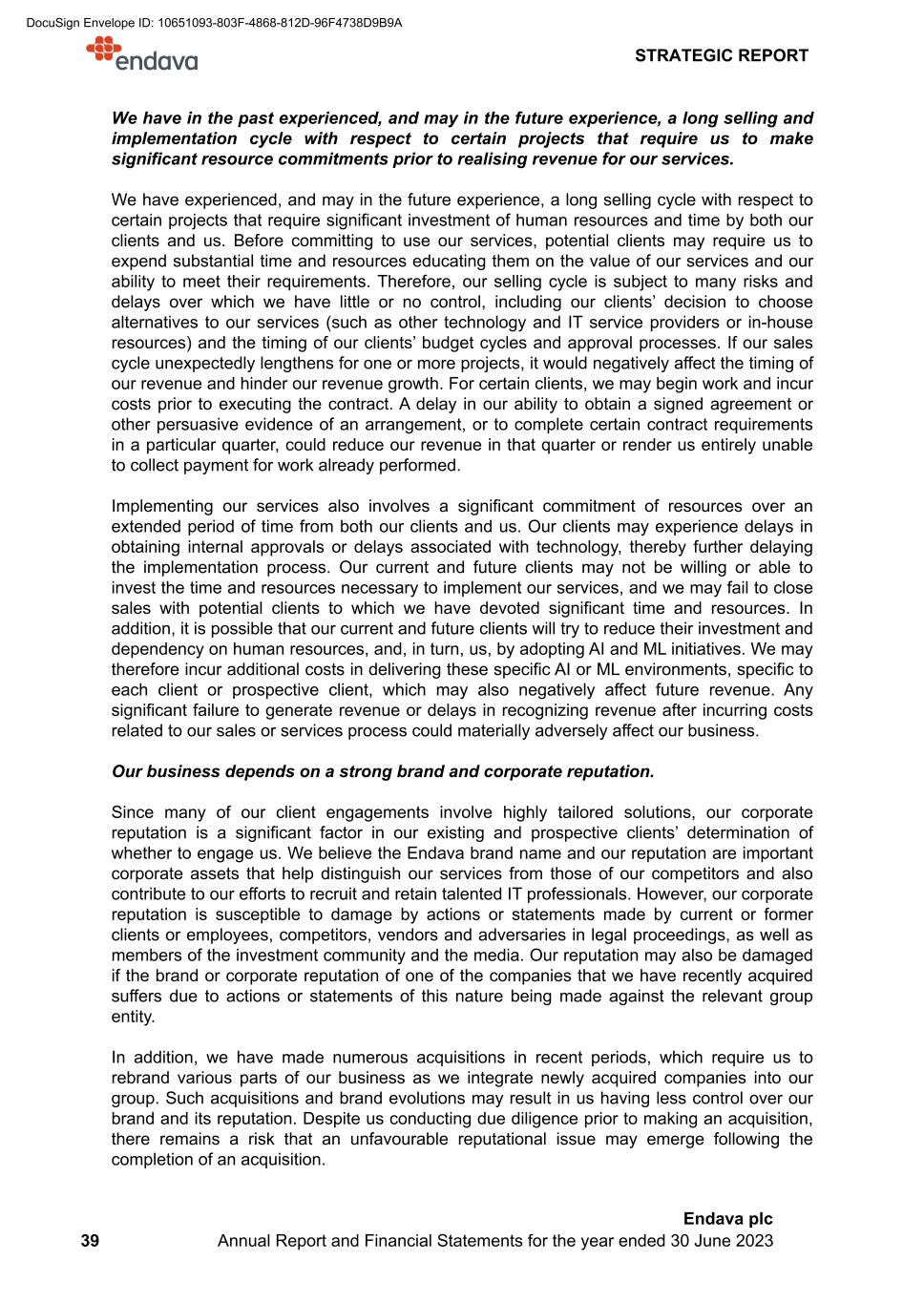
We have in the past experienced, and may in the future experience, a long selling and implementation cycle with respect to certain projects that require us to make significant resource commitments prior to realising revenue for our services. We have experienced, and may in the future experience, a long selling cycle with respect to certain projects that require significant investment of human resources and time by both our clients and us. Before committing to use our services, potential clients may require us to expend substantial time and resources educating them on the value of our services and our ability to meet their requirements. Therefore, our selling cycle is subject to many risks and delays over which we have little or no control, including our clients’ decision to choose alternatives to our services (such as other technology and IT service providers or in-house resources) and the timing of our clients’ budget cycles and approval processes. If our sales cycle unexpectedly lengthens for one or more projects, it would negatively affect the timing of our revenue and hinder our revenue growth. For certain clients, we may begin work and incur costs prior to executing the contract. A delay in our ability to obtain a signed agreement or other persuasive evidence of an arrangement, or to complete certain contract requirements in a particular quarter, could reduce our revenue in that quarter or render us entirely unable to collect payment for work already performed. Implementing our services also involves a significant commitment of resources over an extended period of time from both our clients and us. Our clients may experience delays in obtaining internal approvals or delays associated with technology, thereby further delaying the implementation process. Our current and future clients may not be willing or able to invest the time and resources necessary to implement our services, and we may fail to close sales with potential clients to which we have devoted significant time and resources. In addition, it is possible that our current and future clients will try to reduce their investment and dependency on human resources, and, in turn, us, by adopting AI and ML initiatives. We may therefore incur additional costs in delivering these specific AI or ML environments, specific to each client or prospective client, which may also negatively affect future revenue. Any significant failure to generate revenue or delays in recognizing revenue after incurring costs related to our sales or services process could materially adversely affect our business. Our business depends on a strong brand and corporate reputation. Since many of our client engagements involve highly tailored solutions, our corporate reputation is a significant factor in our existing and prospective clients’ determination of whether to engage us. We believe the Endava brand name and our reputation are important corporate assets that help distinguish our services from those of our competitors and also contribute to our efforts to recruit and retain talented IT professionals. However, our corporate reputation is susceptible to damage by actions or statements made by current or former clients or employees, competitors, vendors and adversaries in legal proceedings, as well as members of the investment community and the media. Our reputation may also be damaged if the brand or corporate reputation of one of the companies that we have recently acquired suffers due to actions or statements of this nature being made against the relevant group entity. In addition, we have made numerous acquisitions in recent periods, which require us to rebrand various parts of our business as we integrate newly acquired companies into our group. Such acquisitions and brand evolutions may result in us having less control over our brand and its reputation. Despite us conducting due diligence prior to making an acquisition, there remains a risk that an unfavourable reputational issue may emerge following the completion of an acquisition. STRATEGIC REPORT 39 Endava plc Annual Report and Financial Statements for the year ended 30 June 2023 DocuSign Envelope ID: 10651093-803F-4868-812D-96F4738D9B9A

There is a risk that negative information about our company, even if based on false rumour or misunderstanding, could adversely affect our business. In particular, damage to our reputation could be difficult and time-consuming to repair, could make potential or existing clients reluctant to select us for new engagements, resulting in a loss of business, and could adversely affect our employee recruitment and retention efforts. Damage to our reputation could also reduce the value and effectiveness of our Endava brand name and could reduce investor confidence in us and adversely affect our operating results. Our cash flows and results of operations may be adversely affected if we are unable to collect on billed and unbilled receivables from clients. Our business depends on our ability to effectively bill and successfully obtain payment from our clients of the amounts they owe us for work performed. We evaluate the financial condition of our clients and usually bill and collect on relatively short cycles. We maintain provisions against receivables. Actual losses on client balances could differ from those that we currently anticipate and, as a result, we may need to adjust our provisions. We may not accurately assess the creditworthiness of our clients. Macroeconomic conditions, such as the global economic slowdown, changing inflation rates, a potential credit crisis in the global financial system and the economic effects of the Russia-Ukraine conflict, have resulted and could continue to result in financial difficulties for our clients, including limited access to the credit markets, insolvency or bankruptcy. Such conditions have caused some clients and could cause other clients to delay payment, request modifications of their payment terms, or default on their payment obligations to us, all of which could increase our receivables balance. Timely collection of fees for client services depends on our ability to complete our contractual commitments and subsequently effectively bill for and collect our contractual service fees. If we are unable to meet our contractual obligations or effectively prepare and provide invoices, we might experience delays in the collection of or be unable to collect our client balances, which could materially adversely affect our results of operations and cash flows. In addition, if we experience an increase in the time required to bill and collect for our services or if our clients are delayed in making payments or stop payments altogether, our cash flows could be adversely affected, which in turn could adversely affect our ability to make necessary investments and, therefore, could affect our results of operations. We generally do not have long-term commitments from our clients, and our clients may terminate engagements before completion or choose not to enter into new engagements with us. Our clients generally do not have any long-term commitments to us. Many of our clients can terminate our master services agreements and work orders with or without cause, in some cases with only to 15 days’ prior notice or less. Although a substantial majority of our revenue is typically generated from existing clients, our engagements with our clients are typically for projects that are singular in nature. In addition, large and complex projects may involve multiple engagements or stages, and a client may choose not to retain us for all or additional stages or may cancel or delay planned engagements. Therefore, we must seek to obtain new engagements when our current engagements are successfully completed or are terminated as well as maintain relationships with existing clients and secure new clients to maintain and expand our business. Even if we successfully deliver on contracted services and maintain long-term relationships with our clients, a number of factors outside of our control could cause the loss of or reduction in business or revenue from our existing clients. These factors include, among other things: STRATEGIC REPORT 40 Endava plc Annual Report and Financial Statements for the year ended 30 June 2023 DocuSign Envelope ID: 10651093-803F-4868-812D-96F4738D9B9A
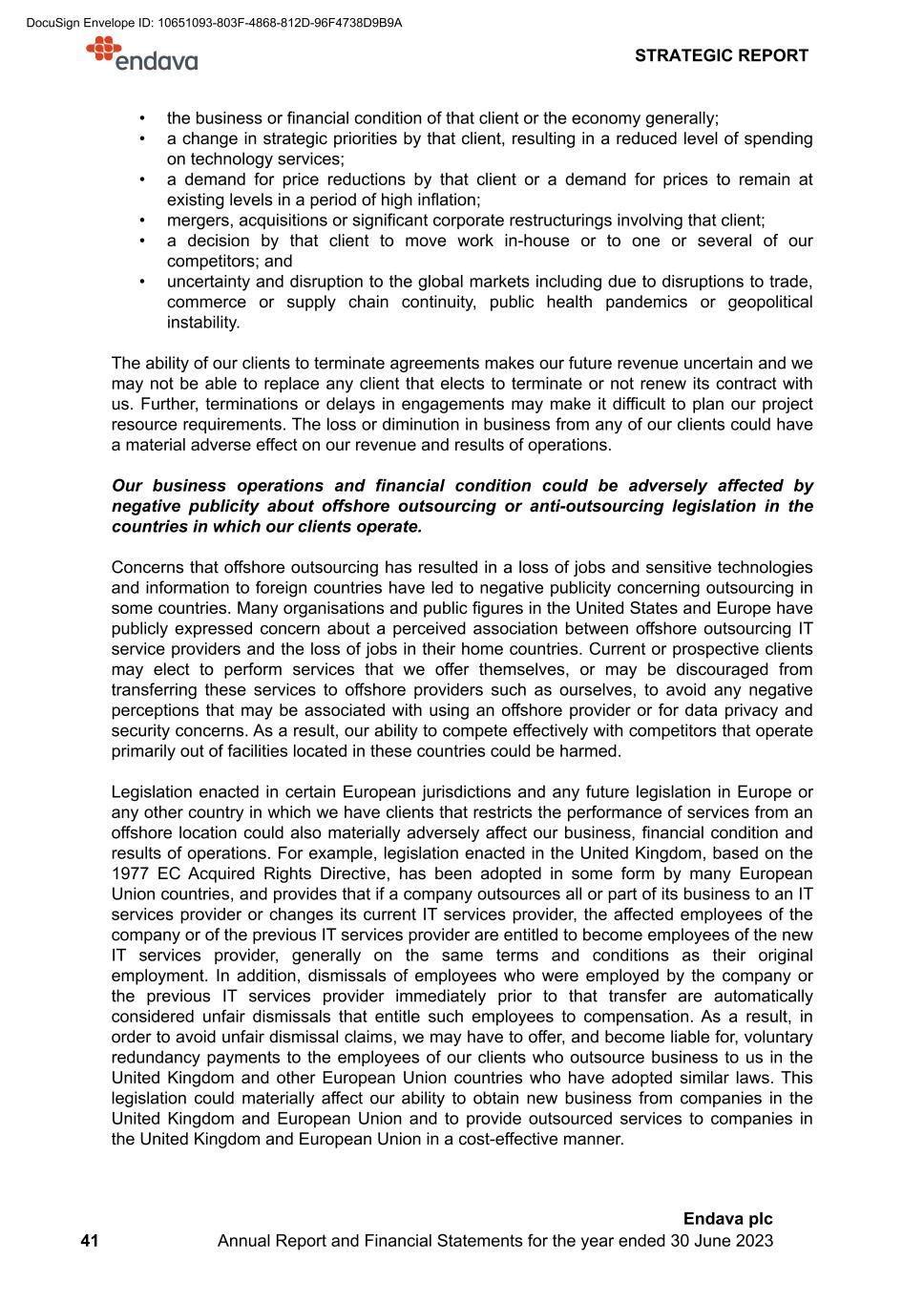
• the business or financial condition of that client or the economy generally; • a change in strategic priorities by that client, resulting in a reduced level of spending on technology services; • a demand for price reductions by that client or a demand for prices to remain at existing levels in a period of high inflation; • mergers, acquisitions or significant corporate restructurings involving that client; • a decision by that client to move work in-house or to one or several of our competitors; and • uncertainty and disruption to the global markets including due to disruptions to trade, commerce or supply chain continuity, public health pandemics or geopolitical instability. The ability of our clients to terminate agreements makes our future revenue uncertain and we may not be able to replace any client that elects to terminate or not renew its contract with us. Further, terminations or delays in engagements may make it difficult to plan our project resource requirements. The loss or diminution in business from any of our clients could have a material adverse effect on our revenue and results of operations. Our business operations and financial condition could be adversely affected by negative publicity about offshore outsourcing or anti-outsourcing legislation in the countries in which our clients operate. Concerns that offshore outsourcing has resulted in a loss of jobs and sensitive technologies and information to foreign countries have led to negative publicity concerning outsourcing in some countries. Many organisations and public figures in the United States and Europe have publicly expressed concern about a perceived association between offshore outsourcing IT service providers and the loss of jobs in their home countries. Current or prospective clients may elect to perform services that we offer themselves, or may be discouraged from transferring these services to offshore providers such as ourselves, to avoid any negative perceptions that may be associated with using an offshore provider or for data privacy and security concerns. As a result, our ability to compete effectively with competitors that operate primarily out of facilities located in these countries could be harmed. Legislation enacted in certain European jurisdictions and any future legislation in Europe or any other country in which we have clients that restricts the performance of services from an offshore location could also materially adversely affect our business, financial condition and results of operations. For example, legislation enacted in the United Kingdom, based on the 1977 EC Acquired Rights Directive, has been adopted in some form by many European Union countries, and provides that if a company outsources all or part of its business to an IT services provider or changes its current IT services provider, the affected employees of the company or of the previous IT services provider are entitled to become employees of the new IT services provider, generally on the same terms and conditions as their original employment. In addition, dismissals of employees who were employed by the company or the previous IT services provider immediately prior to that transfer are automatically considered unfair dismissals that entitle such employees to compensation. As a result, in order to avoid unfair dismissal claims, we may have to offer, and become liable for, voluntary redundancy payments to the employees of our clients who outsource business to us in the United Kingdom and other European Union countries who have adopted similar laws. This legislation could materially affect our ability to obtain new business from companies in the United Kingdom and European Union and to provide outsourced services to companies in the United Kingdom and European Union in a cost-effective manner. STRATEGIC REPORT 41 Endava plc Annual Report and Financial Statements for the year ended 30 June 2023 DocuSign Envelope ID: 10651093-803F-4868-812D-96F4738D9B9A
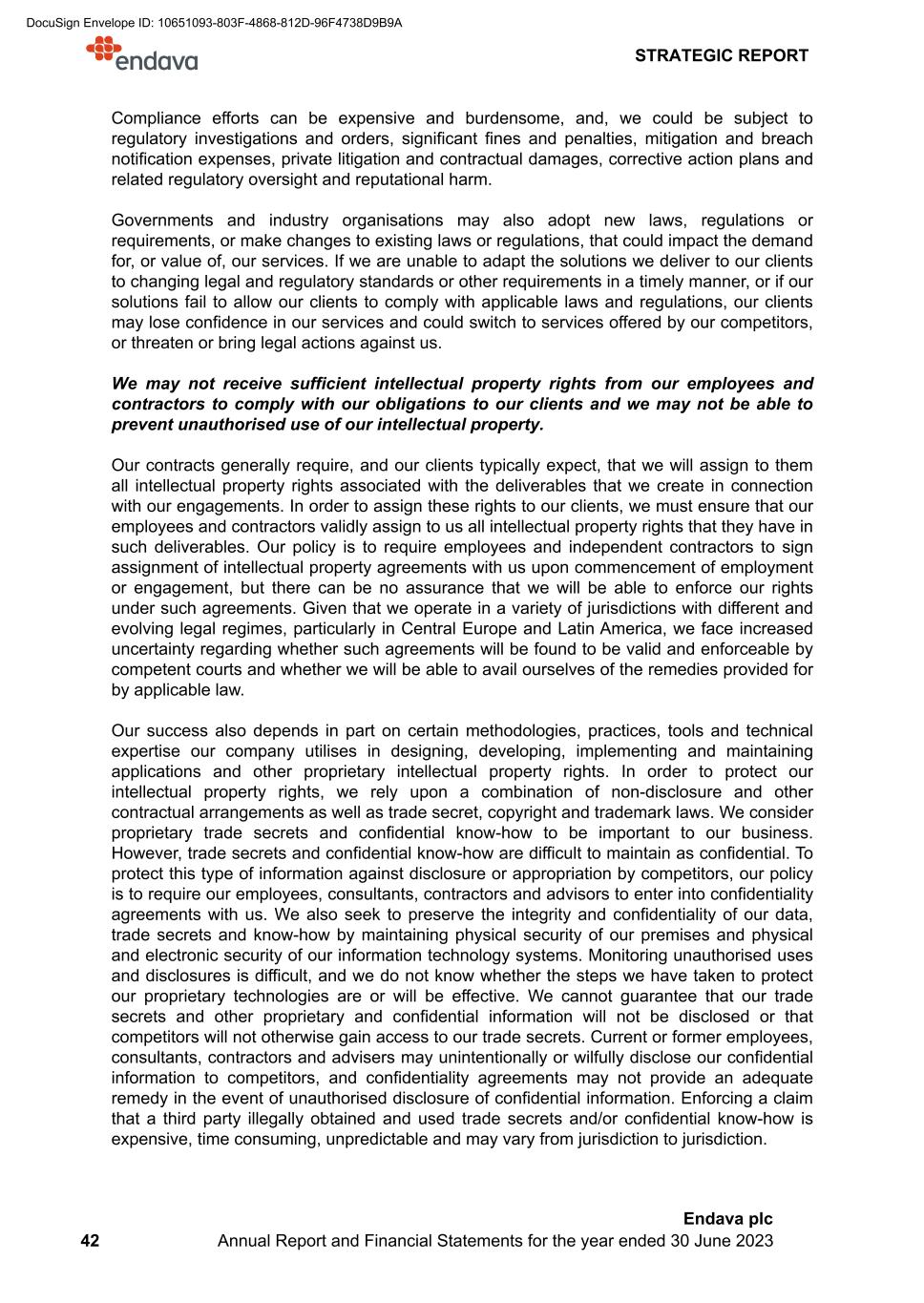
Compliance efforts can be expensive and burdensome, and, we could be subject to regulatory investigations and orders, significant fines and penalties, mitigation and breach notification expenses, private litigation and contractual damages, corrective action plans and related regulatory oversight and reputational harm. Governments and industry organisations may also adopt new laws, regulations or requirements, or make changes to existing laws or regulations, that could impact the demand for, or value of, our services. If we are unable to adapt the solutions we deliver to our clients to changing legal and regulatory standards or other requirements in a timely manner, or if our solutions fail to allow our clients to comply with applicable laws and regulations, our clients may lose confidence in our services and could switch to services offered by our competitors, or threaten or bring legal actions against us. We may not receive sufficient intellectual property rights from our employees and contractors to comply with our obligations to our clients and we may not be able to prevent unauthorised use of our intellectual property. Our contracts generally require, and our clients typically expect, that we will assign to them all intellectual property rights associated with the deliverables that we create in connection with our engagements. In order to assign these rights to our clients, we must ensure that our employees and contractors validly assign to us all intellectual property rights that they have in such deliverables. Our policy is to require employees and independent contractors to sign assignment of intellectual property agreements with us upon commencement of employment or engagement, but there can be no assurance that we will be able to enforce our rights under such agreements. Given that we operate in a variety of jurisdictions with different and evolving legal regimes, particularly in Central Europe and Latin America, we face increased uncertainty regarding whether such agreements will be found to be valid and enforceable by competent courts and whether we will be able to avail ourselves of the remedies provided for by applicable law. Our success also depends in part on certain methodologies, practices, tools and technical expertise our company utilises in designing, developing, implementing and maintaining applications and other proprietary intellectual property rights. In order to protect our intellectual property rights, we rely upon a combination of non-disclosure and other contractual arrangements as well as trade secret, copyright and trademark laws. We consider proprietary trade secrets and confidential know-how to be important to our business. However, trade secrets and confidential know-how are difficult to maintain as confidential. To protect this type of information against disclosure or appropriation by competitors, our policy is to require our employees, consultants, contractors and advisors to enter into confidentiality agreements with us. We also seek to preserve the integrity and confidentiality of our data, trade secrets and know-how by maintaining physical security of our premises and physical and electronic security of our information technology systems. Monitoring unauthorised uses and disclosures is difficult, and we do not know whether the steps we have taken to protect our proprietary technologies are or will be effective. We cannot guarantee that our trade secrets and other proprietary and confidential information will not be disclosed or that competitors will not otherwise gain access to our trade secrets. Current or former employees, consultants, contractors and advisers may unintentionally or wilfully disclose our confidential information to competitors, and confidentiality agreements may not provide an adequate remedy in the event of unauthorised disclosure of confidential information. Enforcing a claim that a third party illegally obtained and used trade secrets and/or confidential know-how is expensive, time consuming, unpredictable and may vary from jurisdiction to jurisdiction. STRATEGIC REPORT 42 Endava plc Annual Report and Financial Statements for the year ended 30 June 2023 DocuSign Envelope ID: 10651093-803F-4868-812D-96F4738D9B9A
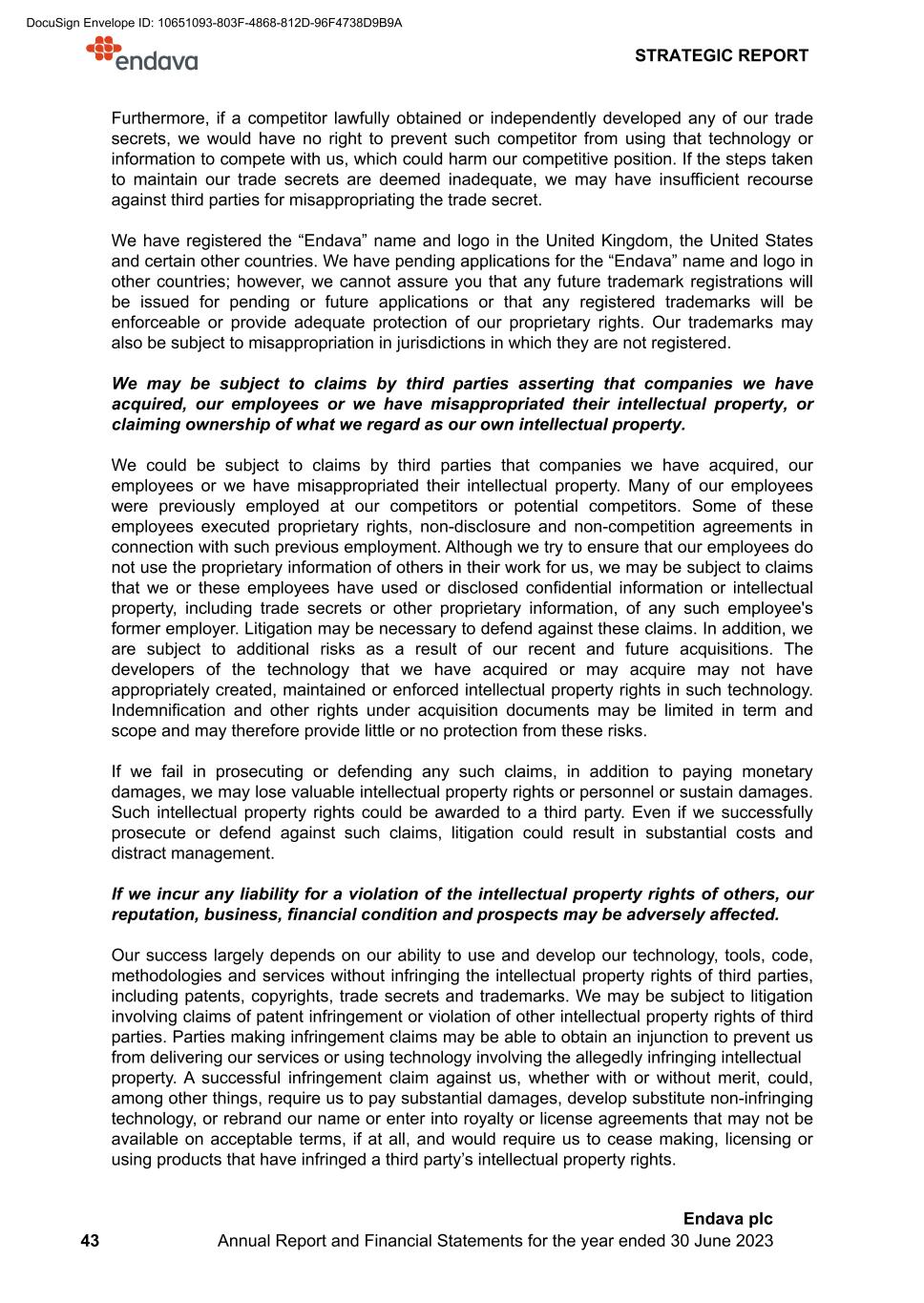
Furthermore, if a competitor lawfully obtained or independently developed any of our trade secrets, we would have no right to prevent such competitor from using that technology or information to compete with us, which could harm our competitive position. If the steps taken to maintain our trade secrets are deemed inadequate, we may have insufficient recourse against third parties for misappropriating the trade secret. We have registered the “Endava” name and logo in the United Kingdom, the United States and certain other countries. We have pending applications for the “Endava” name and logo in other countries; however, we cannot assure you that any future trademark registrations will be issued for pending or future applications or that any registered trademarks will be enforceable or provide adequate protection of our proprietary rights. Our trademarks may also be subject to misappropriation in jurisdictions in which they are not registered. We may be subject to claims by third parties asserting that companies we have acquired, our employees or we have misappropriated their intellectual property, or claiming ownership of what we regard as our own intellectual property. We could be subject to claims by third parties that companies we have acquired, our employees or we have misappropriated their intellectual property. Many of our employees were previously employed at our competitors or potential competitors. Some of these employees executed proprietary rights, non-disclosure and non-competition agreements in connection with such previous employment. Although we try to ensure that our employees do not use the proprietary information of others in their work for us, we may be subject to claims that we or these employees have used or disclosed confidential information or intellectual property, including trade secrets or other proprietary information, of any such employee's former employer. Litigation may be necessary to defend against these claims. In addition, we are subject to additional risks as a result of our recent and future acquisitions. The developers of the technology that we have acquired or may acquire may not have appropriately created, maintained or enforced intellectual property rights in such technology. Indemnification and other rights under acquisition documents may be limited in term and scope and may therefore provide little or no protection from these risks. If we fail in prosecuting or defending any such claims, in addition to paying monetary damages, we may lose valuable intellectual property rights or personnel or sustain damages. Such intellectual property rights could be awarded to a third party. Even if we successfully prosecute or defend against such claims, litigation could result in substantial costs and distract management. If we incur any liability for a violation of the intellectual property rights of others, our reputation, business, financial condition and prospects may be adversely affected. Our success largely depends on our ability to use and develop our technology, tools, code, methodologies and services without infringing the intellectual property rights of third parties, including patents, copyrights, trade secrets and trademarks. We may be subject to litigation involving claims of patent infringement or violation of other intellectual property rights of third parties. Parties making infringement claims may be able to obtain an injunction to prevent us from delivering our services or using technology involving the allegedly infringing intellectual property. A successful infringement claim against us, whether with or without merit, could, among other things, require us to pay substantial damages, develop substitute non-infringing technology, or rebrand our name or enter into royalty or license agreements that may not be available on acceptable terms, if at all, and would require us to cease making, licensing or using products that have infringed a third party’s intellectual property rights. STRATEGIC REPORT 43 Endava plc Annual Report and Financial Statements for the year ended 30 June 2023 DocuSign Envelope ID: 10651093-803F-4868-812D-96F4738D9B9A
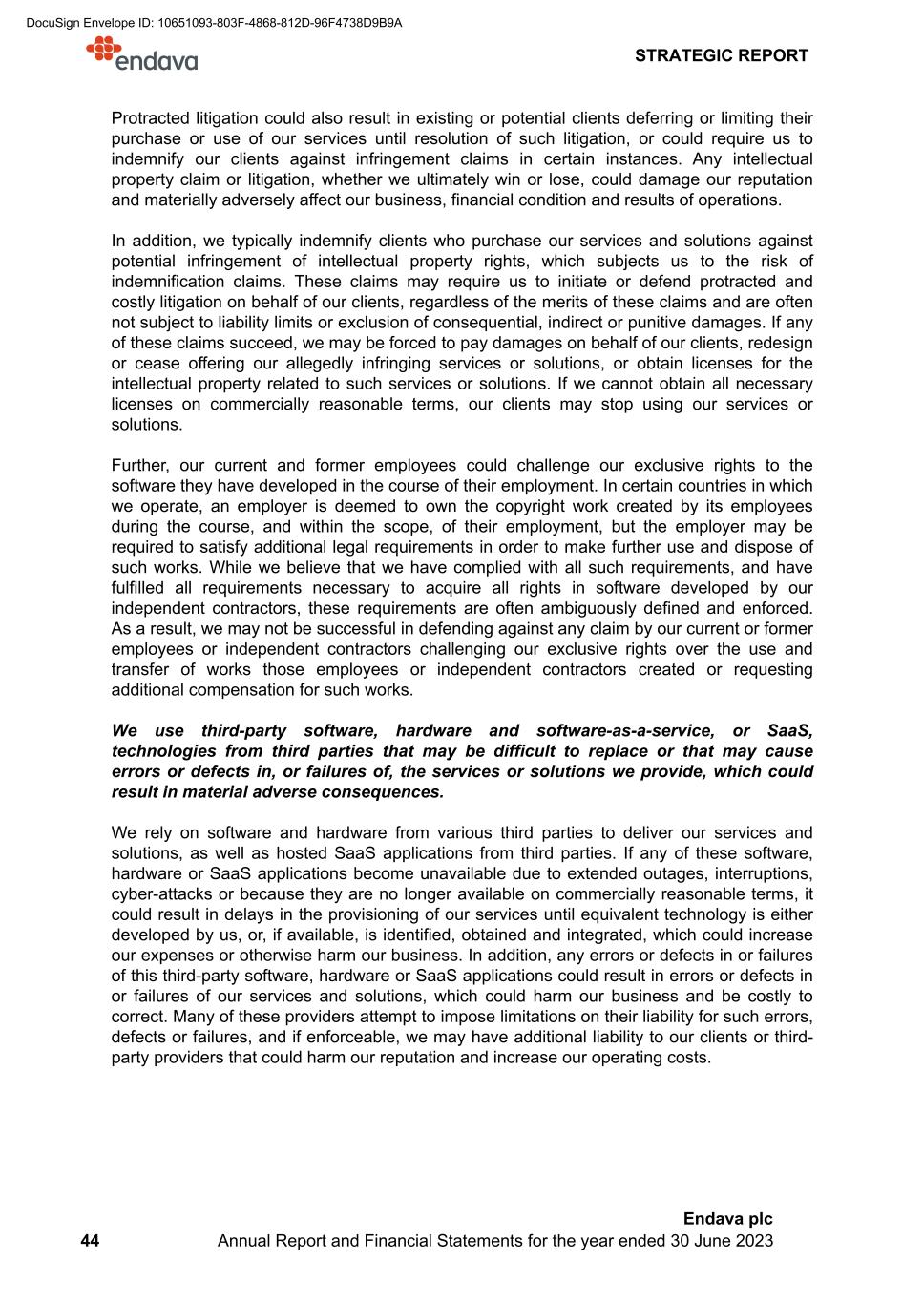
Protracted litigation could also result in existing or potential clients deferring or limiting their purchase or use of our services until resolution of such litigation, or could require us to indemnify our clients against infringement claims in certain instances. Any intellectual property claim or litigation, whether we ultimately win or lose, could damage our reputation and materially adversely affect our business, financial condition and results of operations. In addition, we typically indemnify clients who purchase our services and solutions against potential infringement of intellectual property rights, which subjects us to the risk of indemnification claims. These claims may require us to initiate or defend protracted and costly litigation on behalf of our clients, regardless of the merits of these claims and are often not subject to liability limits or exclusion of consequential, indirect or punitive damages. If any of these claims succeed, we may be forced to pay damages on behalf of our clients, redesign or cease offering our allegedly infringing services or solutions, or obtain licenses for the intellectual property related to such services or solutions. If we cannot obtain all necessary licenses on commercially reasonable terms, our clients may stop using our services or solutions. Further, our current and former employees could challenge our exclusive rights to the software they have developed in the course of their employment. In certain countries in which we operate, an employer is deemed to own the copyright work created by its employees during the course, and within the scope, of their employment, but the employer may be required to satisfy additional legal requirements in order to make further use and dispose of such works. While we believe that we have complied with all such requirements, and have fulfilled all requirements necessary to acquire all rights in software developed by our independent contractors, these requirements are often ambiguously defined and enforced. As a result, we may not be successful in defending against any claim by our current or former employees or independent contractors challenging our exclusive rights over the use and transfer of works those employees or independent contractors created or requesting additional compensation for such works. We use third-party software, hardware and software-as-a-service, or SaaS, technologies from third parties that may be difficult to replace or that may cause errors or defects in, or failures of, the services or solutions we provide, which could result in material adverse consequences. We rely on software and hardware from various third parties to deliver our services and solutions, as well as hosted SaaS applications from third parties. If any of these software, hardware or SaaS applications become unavailable due to extended outages, interruptions, cyber-attacks or because they are no longer available on commercially reasonable terms, it could result in delays in the provisioning of our services until equivalent technology is either developed by us, or, if available, is identified, obtained and integrated, which could increase our expenses or otherwise harm our business. In addition, any errors or defects in or failures of this third-party software, hardware or SaaS applications could result in errors or defects in or failures of our services and solutions, which could harm our business and be costly to correct. Many of these providers attempt to impose limitations on their liability for such errors, defects or failures, and if enforceable, we may have additional liability to our clients or third- party providers that could harm our reputation and increase our operating costs. STRATEGIC REPORT 44 Endava plc Annual Report and Financial Statements for the year ended 30 June 2023 DocuSign Envelope ID: 10651093-803F-4868-812D-96F4738D9B9A
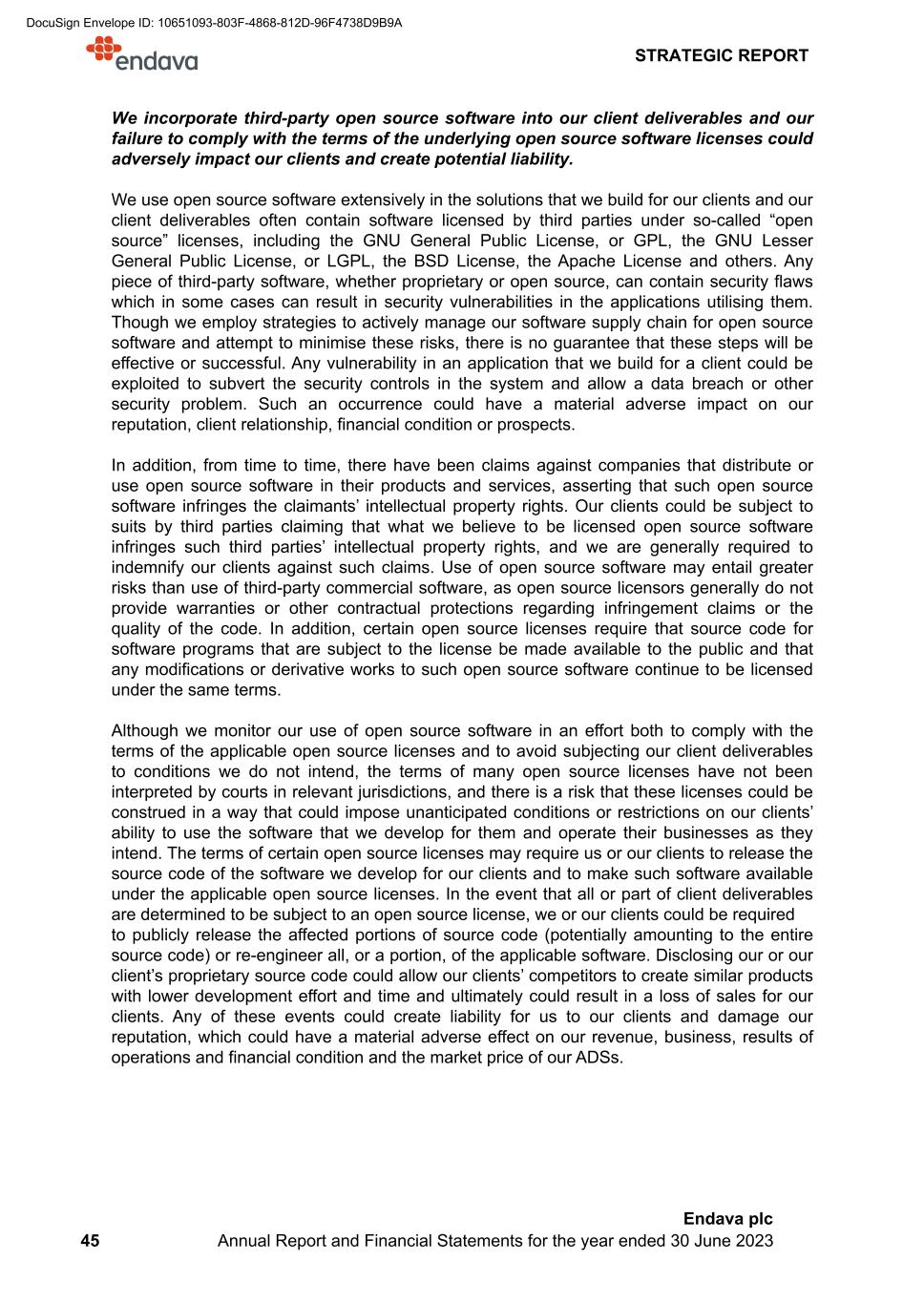
We incorporate third-party open source software into our client deliverables and our failure to comply with the terms of the underlying open source software licenses could adversely impact our clients and create potential liability. We use open source software extensively in the solutions that we build for our clients and our client deliverables often contain software licensed by third parties under so-called “open source” licenses, including the GNU General Public License, or GPL, the GNU Lesser General Public License, or LGPL, the BSD License, the Apache License and others. Any piece of third-party software, whether proprietary or open source, can contain security flaws which in some cases can result in security vulnerabilities in the applications utilising them. Though we employ strategies to actively manage our software supply chain for open source software and attempt to minimise these risks, there is no guarantee that these steps will be effective or successful. Any vulnerability in an application that we build for a client could be exploited to subvert the security controls in the system and allow a data breach or other security problem. Such an occurrence could have a material adverse impact on our reputation, client relationship, financial condition or prospects. In addition, from time to time, there have been claims against companies that distribute or use open source software in their products and services, asserting that such open source software infringes the claimants’ intellectual property rights. Our clients could be subject to suits by third parties claiming that what we believe to be licensed open source software infringes such third parties’ intellectual property rights, and we are generally required to indemnify our clients against such claims. Use of open source software may entail greater risks than use of third-party commercial software, as open source licensors generally do not provide warranties or other contractual protections regarding infringement claims or the quality of the code. In addition, certain open source licenses require that source code for software programs that are subject to the license be made available to the public and that any modifications or derivative works to such open source software continue to be licensed under the same terms. Although we monitor our use of open source software in an effort both to comply with the terms of the applicable open source licenses and to avoid subjecting our client deliverables to conditions we do not intend, the terms of many open source licenses have not been interpreted by courts in relevant jurisdictions, and there is a risk that these licenses could be construed in a way that could impose unanticipated conditions or restrictions on our clients’ ability to use the software that we develop for them and operate their businesses as they intend. The terms of certain open source licenses may require us or our clients to release the source code of the software we develop for our clients and to make such software available under the applicable open source licenses. In the event that all or part of client deliverables are determined to be subject to an open source license, we or our clients could be required to publicly release the affected portions of source code (potentially amounting to the entire source code) or re-engineer all, or a portion, of the applicable software. Disclosing our or our client’s proprietary source code could allow our clients’ competitors to create similar products with lower development effort and time and ultimately could result in a loss of sales for our clients. Any of these events could create liability for us to our clients and damage our reputation, which could have a material adverse effect on our revenue, business, results of operations and financial condition and the market price of our ADSs. STRATEGIC REPORT 45 Endava plc Annual Report and Financial Statements for the year ended 30 June 2023 DocuSign Envelope ID: 10651093-803F-4868-812D-96F4738D9B9A
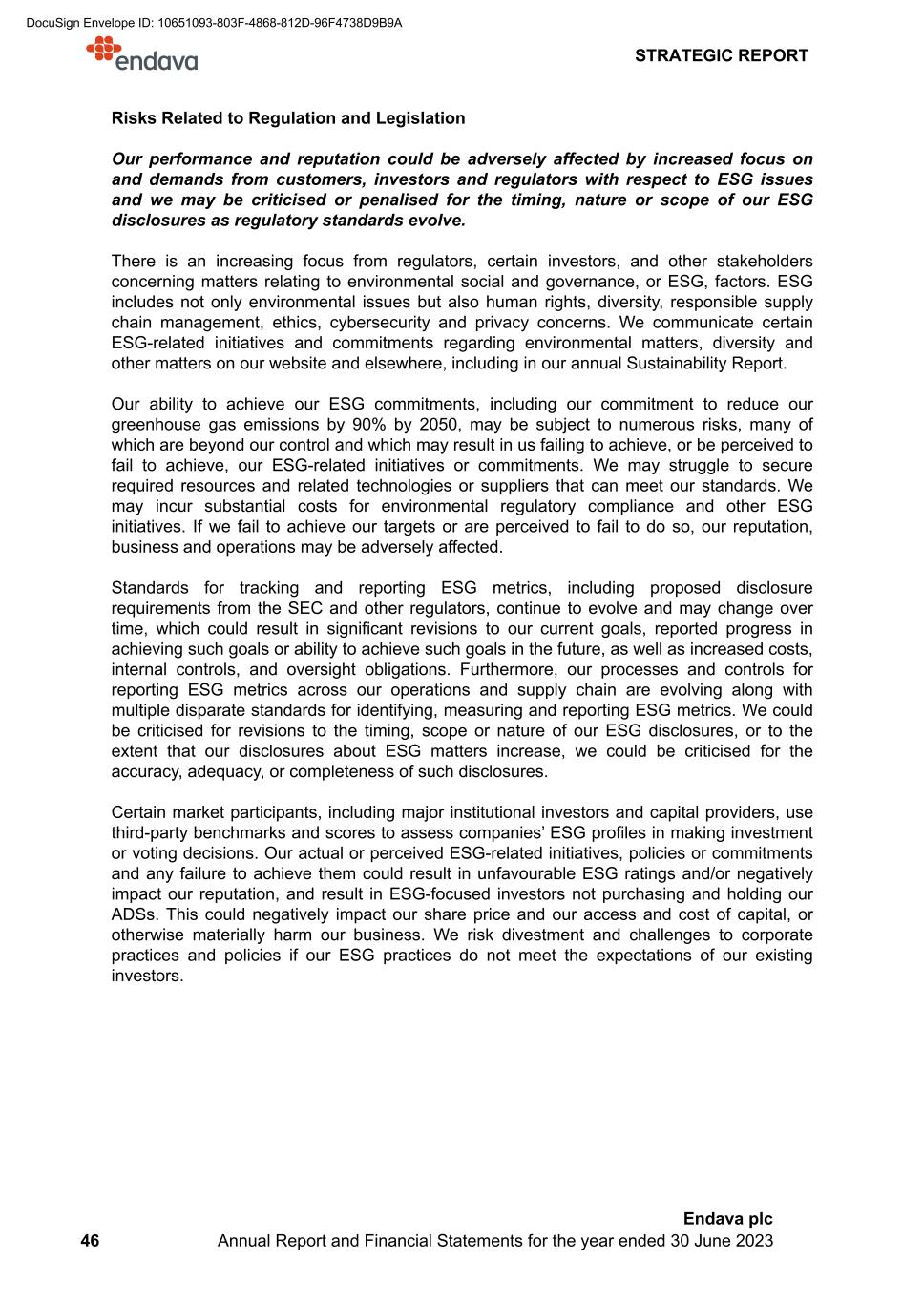
Risks Related to Regulation and Legislation Our performance and reputation could be adversely affected by increased focus on and demands from customers, investors and regulators with respect to ESG issues and we may be criticised or penalised for the timing, nature or scope of our ESG disclosures as regulatory standards evolve. There is an increasing focus from regulators, certain investors, and other stakeholders concerning matters relating to environmental social and governance, or ESG, factors. ESG includes not only environmental issues but also human rights, diversity, responsible supply chain management, ethics, cybersecurity and privacy concerns. We communicate certain ESG-related initiatives and commitments regarding environmental matters, diversity and other matters on our website and elsewhere, including in our annual Sustainability Report. Our ability to achieve our ESG commitments, including our commitment to reduce our greenhouse gas emissions by 90% by 2050, may be subject to numerous risks, many of which are beyond our control and which may result in us failing to achieve, or be perceived to fail to achieve, our ESG-related initiatives or commitments. We may struggle to secure required resources and related technologies or suppliers that can meet our standards. We may incur substantial costs for environmental regulatory compliance and other ESG initiatives. If we fail to achieve our targets or are perceived to fail to do so, our reputation, business and operations may be adversely affected. Standards for tracking and reporting ESG metrics, including proposed disclosure requirements from the SEC and other regulators, continue to evolve and may change over time, which could result in significant revisions to our current goals, reported progress in achieving such goals or ability to achieve such goals in the future, as well as increased costs, internal controls, and oversight obligations. Furthermore, our processes and controls for reporting ESG metrics across our operations and supply chain are evolving along with multiple disparate standards for identifying, measuring and reporting ESG metrics. We could be criticised for revisions to the timing, scope or nature of our ESG disclosures, or to the extent that our disclosures about ESG matters increase, we could be criticised for the accuracy, adequacy, or completeness of such disclosures. Certain market participants, including major institutional investors and capital providers, use third-party benchmarks and scores to assess companies’ ESG profiles in making investment or voting decisions. Our actual or perceived ESG-related initiatives, policies or commitments and any failure to achieve them could result in unfavourable ESG ratings and/or negatively impact our reputation, and result in ESG-focused investors not purchasing and holding our ADSs. This could negatively impact our share price and our access and cost of capital, or otherwise materially harm our business. We risk divestment and challenges to corporate practices and policies if our ESG practices do not meet the expectations of our existing investors. STRATEGIC REPORT 46 Endava plc Annual Report and Financial Statements for the year ended 30 June 2023 DocuSign Envelope ID: 10651093-803F-4868-812D-96F4738D9B9A

Changes in laws, regulations, rules or other obligations related to the internet or changes in the internet infrastructure itself may provide various risks, including privacy risks, and thus diminish the demand for our services, and could have a negative impact on our business. The future success of our business depends upon the continued use of the internet as a primary medium for commerce, communication and business applications. Federal, state or foreign government bodies or agencies have in the past adopted, and may in the future adopt, laws or regulations affecting the use of the internet as a commercial medium. Changes in these laws or regulations could adversely affect the demand for our services or require us to modify our solutions in order to comply with these changes. In addition, government agencies or private organisations may begin to impose taxes, fees or other charges for accessing the internet or commerce conducted via the internet. These laws or charges could limit the growth of internet-related commerce or communications generally, resulting in reductions in the demand for technology services such as ours. In addition, the use of the internet as a business tool could be adversely affected due to delays in the development or adoption of new standards and protocols to handle increased demands of internet activity, security, reliability, cost, ease of use, accessibility, and quality of service. The performance of the internet and its acceptance as a business tool have been adversely affected by “ransomware,” “viruses,” “worms,” “malware,” “phishing attacks,” “data breaches” and other threats, and the internet has experienced a variety of outages and other delays as a result of damage to portions of its infrastructure. If the use of the internet is adversely affected by these or any other issues, demand for our services and solutions could suffer. From time to time, some of our employees spend significant amounts of time at our clients’ facilities, often in foreign jurisdictions, which expose us to certain risks. Some of our projects require a portion or all of the work to be undertaken at our clients’ facilities, which are often located outside our employees’ country of residence. The ability of our employees to work in locations around the world may depend on their ability to obtain the required visas and work permits, and this process can be lengthy and difficult. Immigration laws are subject to legislative change, as well as to variations in standards of application and enforcement due to political forces and economic conditions. In addition, we may become subject to taxation in jurisdictions where we would not otherwise be so subject as a result of the amount of time that our employees spend in any such jurisdiction in any given year. While we seek to monitor the number of days that our employees spend in each country to minimise such tax liabilities, there can be no assurance that we will be successful in these efforts. To the extent our employees and contractors are able to work at our clients’ facilities, we may incur risks relating to our employees and contractors’ presence at our clients’ facilities, including, but not limited to: claims of misconduct, negligence or intentional malfeasance on the part of our employees. Some or all of these claims may lead to litigation, liabilities and negative publicity. It is not possible to predict the outcome of these lawsuits or any other proceeding, and our insurance may not cover any or all claims that may be asserted against us. STRATEGIC REPORT 47 Endava plc Annual Report and Financial Statements for the year ended 30 June 2023 DocuSign Envelope ID: 10651093-803F-4868-812D-96F4738D9B9A
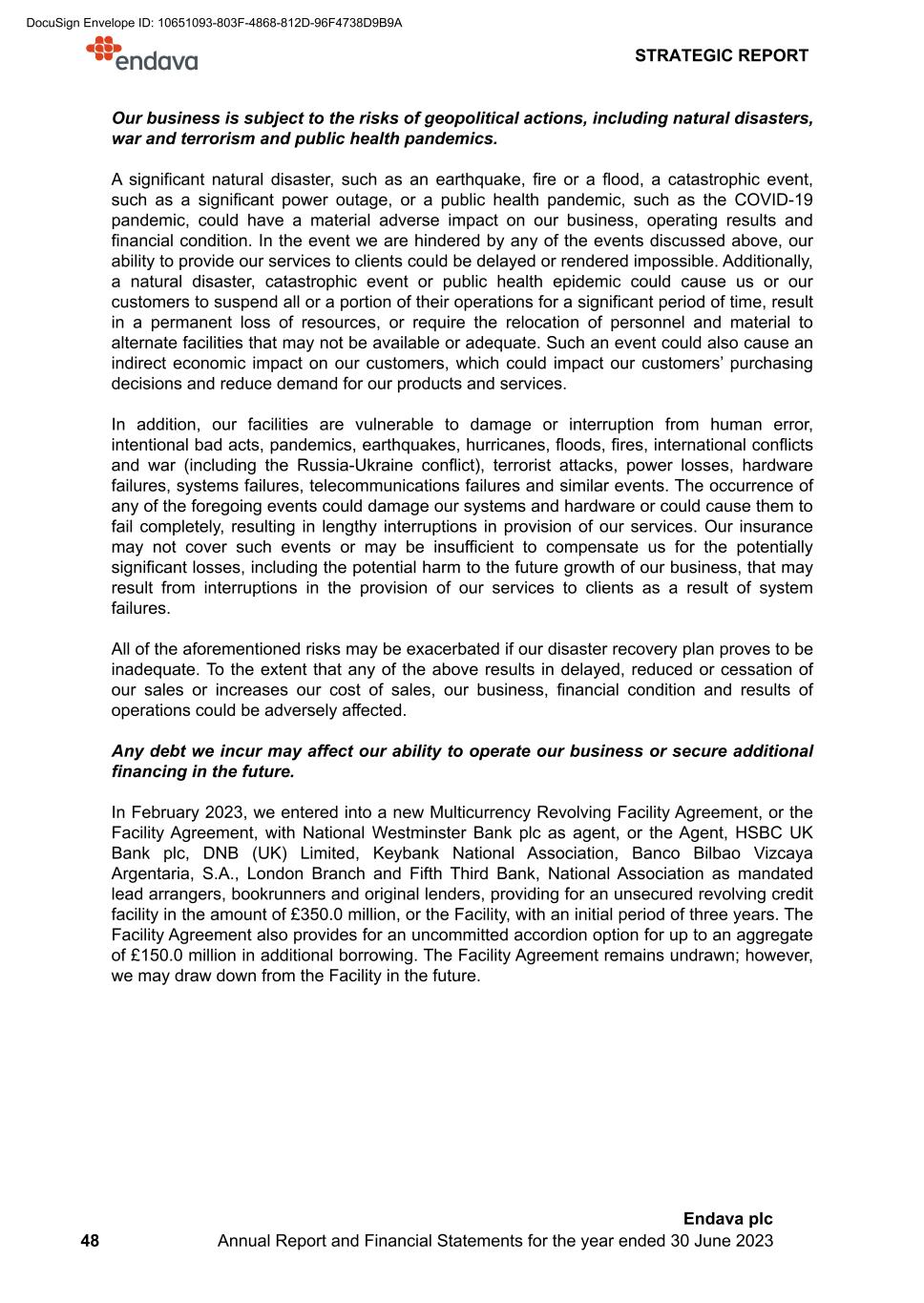
Our business is subject to the risks of geopolitical actions, including natural disasters, war and terrorism and public health pandemics. A significant natural disaster, such as an earthquake, fire or a flood, a catastrophic event, such as a significant power outage, or a public health pandemic, such as the COVID-19 pandemic, could have a material adverse impact on our business, operating results and financial condition. In the event we are hindered by any of the events discussed above, our ability to provide our services to clients could be delayed or rendered impossible. Additionally, a natural disaster, catastrophic event or public health epidemic could cause us or our customers to suspend all or a portion of their operations for a significant period of time, result in a permanent loss of resources, or require the relocation of personnel and material to alternate facilities that may not be available or adequate. Such an event could also cause an indirect economic impact on our customers, which could impact our customers’ purchasing decisions and reduce demand for our products and services. In addition, our facilities are vulnerable to damage or interruption from human error, intentional bad acts, pandemics, earthquakes, hurricanes, floods, fires, international conflicts and war (including the Russia-Ukraine conflict), terrorist attacks, power losses, hardware failures, systems failures, telecommunications failures and similar events. The occurrence of any of the foregoing events could damage our systems and hardware or could cause them to fail completely, resulting in lengthy interruptions in provision of our services. Our insurance may not cover such events or may be insufficient to compensate us for the potentially significant losses, including the potential harm to the future growth of our business, that may result from interruptions in the provision of our services to clients as a result of system failures. All of the aforementioned risks may be exacerbated if our disaster recovery plan proves to be inadequate. To the extent that any of the above results in delayed, reduced or cessation of our sales or increases our cost of sales, our business, financial condition and results of operations could be adversely affected. Any debt we incur may affect our ability to operate our business or secure additional financing in the future. In February 2023, we entered into a new Multicurrency Revolving Facility Agreement, or the Facility Agreement, with National Westminster Bank plc as agent, or the Agent, HSBC UK Bank plc, DNB (UK) Limited, Keybank National Association, Banco Bilbao Vizcaya Argentaria, S.A., London Branch and Fifth Third Bank, National Association as mandated lead arrangers, bookrunners and original lenders, providing for an unsecured revolving credit facility in the amount of £350.0 million, or the Facility, with an initial period of three years. The Facility Agreement also provides for an uncommitted accordion option for up to an aggregate of £150.0 million in additional borrowing. The Facility Agreement remains undrawn; however, we may draw down from the Facility in the future. STRATEGIC REPORT 48 Endava plc Annual Report and Financial Statements for the year ended 30 June 2023 DocuSign Envelope ID: 10651093-803F-4868-812D-96F4738D9B9A

The Facility Agreement requires us, and any debt instruments we may enter into in the future may require us, to comply with various covenants that limit our ability to, among other things: • dispose of assets; • complete mergers or acquisitions • incur or guarantee indebtedness; • sell or encumber certain assets; • pay dividends or make other distributions to holders of our shares; • make specified investments; • engage in different lines of business; and • engage in certain transactions with affiliates. Under the terms of the Facility Agreement, we are required to comply with net leverage ratio and interest coverage covenants. Our ability to meet these ratios and covenants can be affected by events beyond our control and we may not meet these ratios and covenants. To the extent we draw down on the Facility, a failure by us to comply with the ratios or covenants contained in the Facility Agreement could result in an event of default, which could adversely affect our ability to respond to changes in our business and manage our operations. Upon the occurrence of an event of default, including the occurrence of a material adverse change, the lenders could elect to declare any amounts outstanding to be due and payable and exercise other remedies as set forth in the Facility Agreement. If any indebtedness under our Facility were to be accelerated, our future financial condition could be materially adversely affected. We may also incur additional indebtedness under different agreements in the future. The instruments governing such indebtedness could contain provisions that are as, or more, restrictive than our existing debt instruments. If we are unable to repay, refinance or restructure our indebtedness when payment is due, the lenders could proceed against any collateral granted to them to secure such indebtedness or force us into bankruptcy or liquidation. We have significant fixed costs related to lease facilities and may incur additional expense as we adapt our facilities in response to our transition to a hybrid working model. We have made and continue to make significant contractual commitments related to our leased facilities. The total lease related expense (net of any related gains and income) included in our financial statements for the 2023 financial year was £15.3 million, and we are contractually committed to £16.1 million in such lease expenses for the 2024 financial year. These expenses will have a significant impact on our fixed costs, and if we are unable to grow our business and revenue proportionately, our operating results may be negatively affected. Additionally, as we continue to move to a hybrid working model allowing for remote work, we may require less office space than we currently have under our leases. This could require us to renegotiate some of our leases to match a reduced need for office space, which may in turn lead to disputes with existing landlords. This process could be costly and time consuming, and we cannot guarantee that any new leases would be on the same or better terms as our current lease arrangements. Additionally, we plan to make significant changes to our offices to adapt them to new ways of working as we embrace a hybrid working model. STRATEGIC REPORT 49 Endava plc Annual Report and Financial Statements for the year ended 30 June 2023 DocuSign Envelope ID: 10651093-803F-4868-812D-96F4738D9B9A
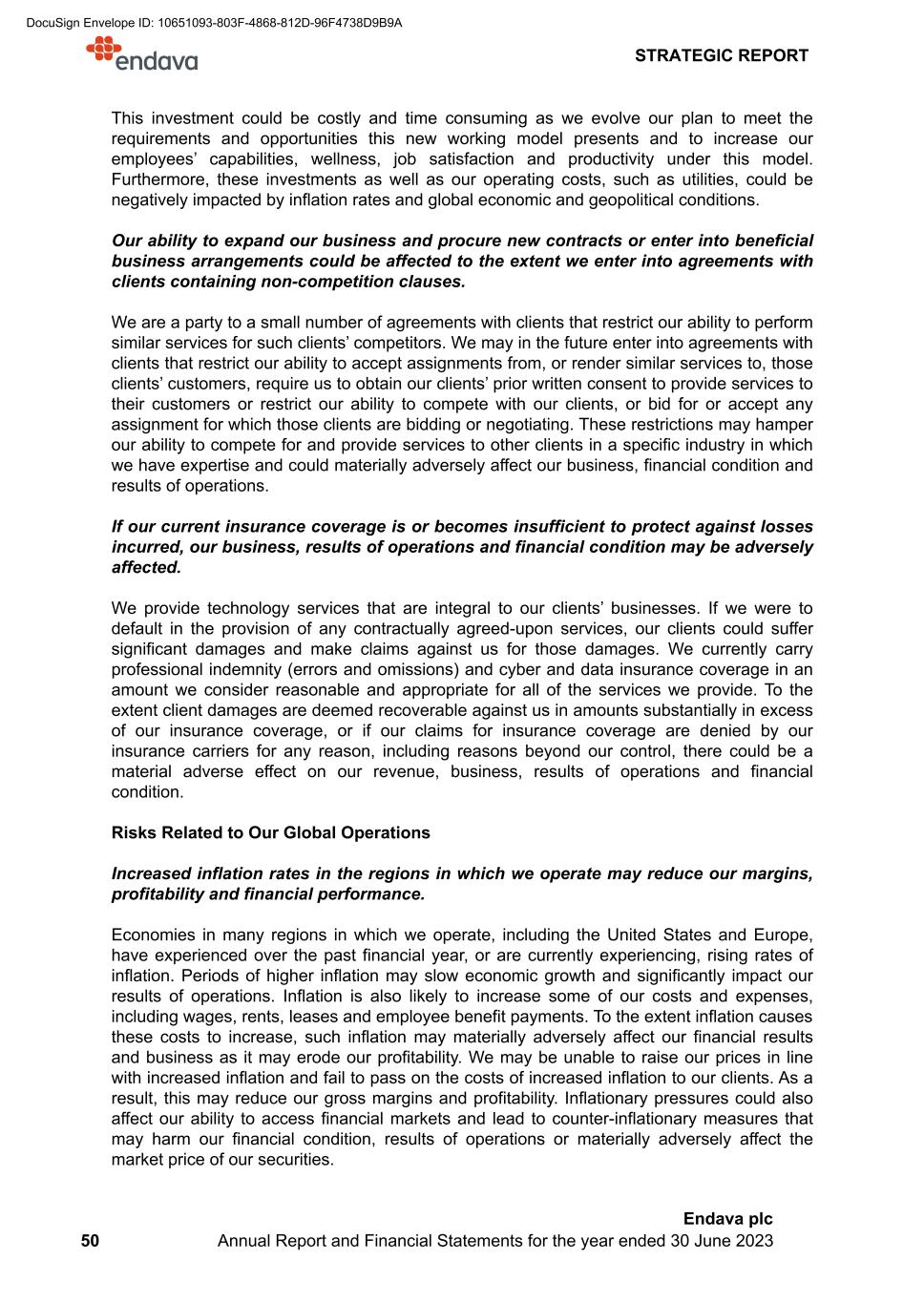
This investment could be costly and time consuming as we evolve our plan to meet the requirements and opportunities this new working model presents and to increase our employees’ capabilities, wellness, job satisfaction and productivity under this model. Furthermore, these investments as well as our operating costs, such as utilities, could be negatively impacted by inflation rates and global economic and geopolitical conditions. Our ability to expand our business and procure new contracts or enter into beneficial business arrangements could be affected to the extent we enter into agreements with clients containing non-competition clauses. We are a party to a small number of agreements with clients that restrict our ability to perform similar services for such clients’ competitors. We may in the future enter into agreements with clients that restrict our ability to accept assignments from, or render similar services to, those clients’ customers, require us to obtain our clients’ prior written consent to provide services to their customers or restrict our ability to compete with our clients, or bid for or accept any assignment for which those clients are bidding or negotiating. These restrictions may hamper our ability to compete for and provide services to other clients in a specific industry in which we have expertise and could materially adversely affect our business, financial condition and results of operations. If our current insurance coverage is or becomes insufficient to protect against losses incurred, our business, results of operations and financial condition may be adversely affected. We provide technology services that are integral to our clients’ businesses. If we were to default in the provision of any contractually agreed-upon services, our clients could suffer significant damages and make claims against us for those damages. We currently carry professional indemnity (errors and omissions) and cyber and data insurance coverage in an amount we consider reasonable and appropriate for all of the services we provide. To the extent client damages are deemed recoverable against us in amounts substantially in excess of our insurance coverage, or if our claims for insurance coverage are denied by our insurance carriers for any reason, including reasons beyond our control, there could be a material adverse effect on our revenue, business, results of operations and financial condition. Risks Related to Our Global Operations Increased inflation rates in the regions in which we operate may reduce our margins, profitability and financial performance. Economies in many regions in which we operate, including the United States and Europe, have experienced over the past financial year, or are currently experiencing, rising rates of inflation. Periods of higher inflation may slow economic growth and significantly impact our results of operations. Inflation is also likely to increase some of our costs and expenses, including wages, rents, leases and employee benefit payments. To the extent inflation causes these costs to increase, such inflation may materially adversely affect our financial results and business as it may erode our profitability. We may be unable to raise our prices in line with increased inflation and fail to pass on the costs of increased inflation to our clients. As a result, this may reduce our gross margins and profitability. Inflationary pressures could also affect our ability to access financial markets and lead to counter-inflationary measures that may harm our financial condition, results of operations or materially adversely affect the market price of our securities. STRATEGIC REPORT 50 Endava plc Annual Report and Financial Statements for the year ended 30 June 2023 DocuSign Envelope ID: 10651093-803F-4868-812D-96F4738D9B9A

Our revenue, margins, results of operations and financial condition may be materially adversely affected if general economic conditions in Europe, the United States or the global economy worsen. We derive a significant portion of our revenue from clients located in Europe and the United States. The technology services industry is particularly sensitive to the economic environment, and tends to decline during general economic downturns. If the U.S. or European economies continue to weaken or slow, including as a result of the Russia-Ukraine conflict and related economic sanctions, or if the global economic slowdown persists or exacerbates, pricing for our services may be depressed and our clients may reduce or postpone their technology spending significantly, which may, in turn, lower the demand for our services and negatively affect our revenue and profitability. We have, in the financial year ended 30 June 2023, experienced a slowing in demand for our services from clients in North America and United Kingdom, particularly from the private equity-backed companies in these geographies, due to a weakened economic outlook and global markets instability, and if this continues in the near to medium term, we may suffer declines in revenue and profitability. This may negatively impact investor perception of our company and could significantly impact our share price. A weak or declining economy could also cause our customers to delay making payments for our services. Additionally, any weakening or failure of banking institutions or banking systems, which could be caused by a weakening or slowdown of the U.S., European or global economies, could adversely impact our business, operating results and financial condition and negatively impact our ability to receive and make payments. If we are unable to successfully anticipate changing economic and political conditions affecting the markets in which we operate, we may be unable to effectively plan for or respond to those changes, and our results of operations could be adversely affected. Fluctuations in currency exchange rates could materially adversely affect our financial condition and results of operations. We have operations in a number of countries, including Argentina, Australia, Austria, Bosnia & Herzegovina, Bulgaria, Canada, Colombia, Croatia, Denmark, Germany, Ireland, Malaysia, Mexico, Moldova, the Netherlands, North Macedonia, Poland, Romania, Serbia, Singapore, Slovenia, Switzerland, United Arab Emirates, the United Kingdom, the United States, Uruguay, Venezuela and Vietnam, and we serve clients across Europe, North America and the rest of the world, or RoW. As a result of the international scope of our operations, fluctuations in exchange rates, particularly between the British Pound, our reporting currency, and the Euro and U.S. dollar, may adversely affect us. Currency fluctuations related to the current geopolitical climate, notably in Europe but also, to a lesser degree, globally, had a significant impact on our financial results for the financial year ended 30 June 2023. In the financial year ended 30 June 2022, 37.8% of our sales were denominated in the British Pound, 34.0% of our sales were denominated in U.S. dollars, 22.8% were denominated in Euros and the balance were in other currencies. Conversely, during the same time period, 68.0% of our expenses were denominated in Euros (or in currencies that largely follow the Euro, including the RON) or U.S. dollars. As a result, strengthening of the Euro or U.S. dollar relative to the British Pound presents the most significant risk to us. Any significant fluctuations in currency exchange rates may have a material impact on our business. STRATEGIC REPORT 51 Endava plc Annual Report and Financial Statements for the year ended 30 June 2023 DocuSign Envelope ID: 10651093-803F-4868-812D-96F4738D9B9A
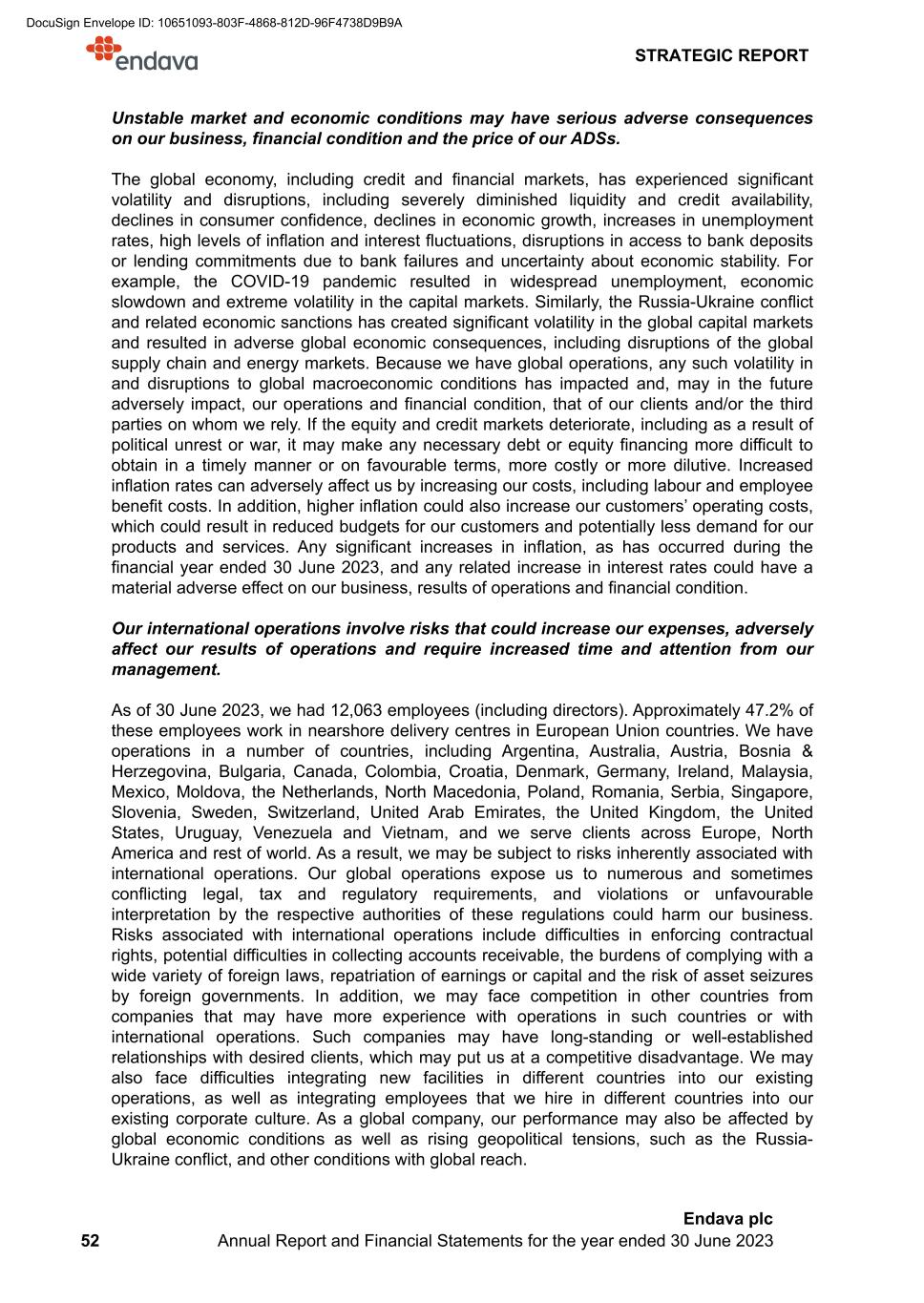
Unstable market and economic conditions may have serious adverse consequences on our business, financial condition and the price of our ADSs. The global economy, including credit and financial markets, has experienced significant volatility and disruptions, including severely diminished liquidity and credit availability, declines in consumer confidence, declines in economic growth, increases in unemployment rates, high levels of inflation and interest fluctuations, disruptions in access to bank deposits or lending commitments due to bank failures and uncertainty about economic stability. For example, the COVID-19 pandemic resulted in widespread unemployment, economic slowdown and extreme volatility in the capital markets. Similarly, the Russia-Ukraine conflict and related economic sanctions has created significant volatility in the global capital markets and resulted in adverse global economic consequences, including disruptions of the global supply chain and energy markets. Because we have global operations, any such volatility in and disruptions to global macroeconomic conditions has impacted and, may in the future adversely impact, our operations and financial condition, that of our clients and/or the third parties on whom we rely. If the equity and credit markets deteriorate, including as a result of political unrest or war, it may make any necessary debt or equity financing more difficult to obtain in a timely manner or on favourable terms, more costly or more dilutive. Increased inflation rates can adversely affect us by increasing our costs, including labour and employee benefit costs. In addition, higher inflation could also increase our customers’ operating costs, which could result in reduced budgets for our customers and potentially less demand for our products and services. Any significant increases in inflation, as has occurred during the financial year ended 30 June 2023, and any related increase in interest rates could have a material adverse effect on our business, results of operations and financial condition. Our international operations involve risks that could increase our expenses, adversely affect our results of operations and require increased time and attention from our management. As of 30 June 2023, we had 12,063 employees (including directors). Approximately 47.2% of these employees work in nearshore delivery centres in European Union countries. We have operations in a number of countries, including Argentina, Australia, Austria, Bosnia & Herzegovina, Bulgaria, Canada, Colombia, Croatia, Denmark, Germany, Ireland, Malaysia, Mexico, Moldova, the Netherlands, North Macedonia, Poland, Romania, Serbia, Singapore, Slovenia, Sweden, Switzerland, United Arab Emirates, the United Kingdom, the United States, Uruguay, Venezuela and Vietnam, and we serve clients across Europe, North America and rest of world. As a result, we may be subject to risks inherently associated with international operations. Our global operations expose us to numerous and sometimes conflicting legal, tax and regulatory requirements, and violations or unfavourable interpretation by the respective authorities of these regulations could harm our business. Risks associated with international operations include difficulties in enforcing contractual rights, potential difficulties in collecting accounts receivable, the burdens of complying with a wide variety of foreign laws, repatriation of earnings or capital and the risk of asset seizures by foreign governments. In addition, we may face competition in other countries from companies that may have more experience with operations in such countries or with international operations. Such companies may have long-standing or well-established relationships with desired clients, which may put us at a competitive disadvantage. We may also face difficulties integrating new facilities in different countries into our existing operations, as well as integrating employees that we hire in different countries into our existing corporate culture. As a global company, our performance may also be affected by global economic conditions as well as rising geopolitical tensions, such as the Russia- Ukraine conflict, and other conditions with global reach. STRATEGIC REPORT 52 Endava plc Annual Report and Financial Statements for the year ended 30 June 2023 DocuSign Envelope ID: 10651093-803F-4868-812D-96F4738D9B9A
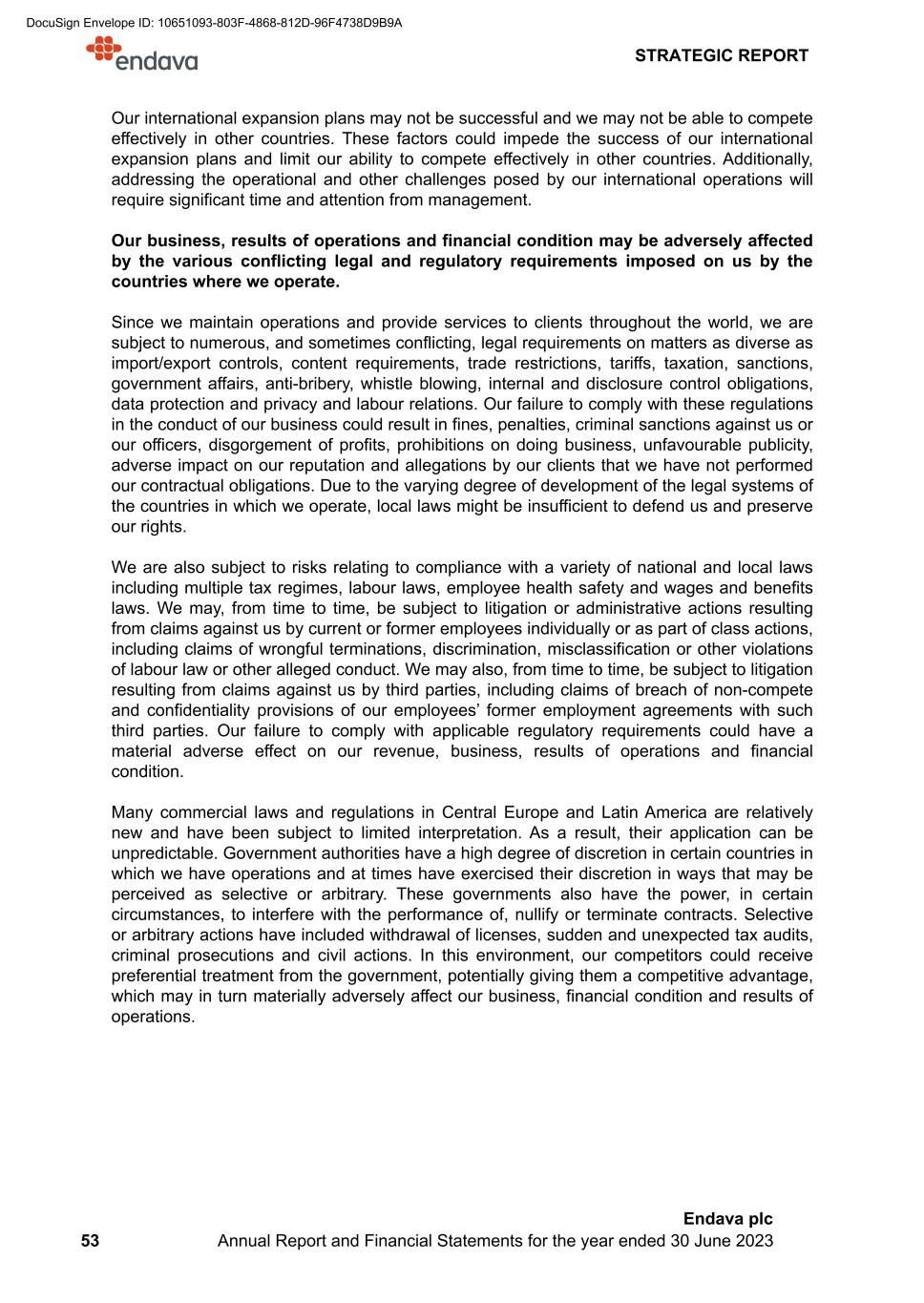
Our international expansion plans may not be successful and we may not be able to compete effectively in other countries. These factors could impede the success of our international expansion plans and limit our ability to compete effectively in other countries. Additionally, addressing the operational and other challenges posed by our international operations will require significant time and attention from management. Our business, results of operations and financial condition may be adversely affected by the various conflicting legal and regulatory requirements imposed on us by the countries where we operate. Since we maintain operations and provide services to clients throughout the world, we are subject to numerous, and sometimes conflicting, legal requirements on matters as diverse as import/export controls, content requirements, trade restrictions, tariffs, taxation, sanctions, government affairs, anti-bribery, whistle blowing, internal and disclosure control obligations, data protection and privacy and labour relations. Our failure to comply with these regulations in the conduct of our business could result in fines, penalties, criminal sanctions against us or our officers, disgorgement of profits, prohibitions on doing business, unfavourable publicity, adverse impact on our reputation and allegations by our clients that we have not performed our contractual obligations. Due to the varying degree of development of the legal systems of the countries in which we operate, local laws might be insufficient to defend us and preserve our rights. We are also subject to risks relating to compliance with a variety of national and local laws including multiple tax regimes, labour laws, employee health safety and wages and benefits laws. We may, from time to time, be subject to litigation or administrative actions resulting from claims against us by current or former employees individually or as part of class actions, including claims of wrongful terminations, discrimination, misclassification or other violations of labour law or other alleged conduct. We may also, from time to time, be subject to litigation resulting from claims against us by third parties, including claims of breach of non-compete and confidentiality provisions of our employees’ former employment agreements with such third parties. Our failure to comply with applicable regulatory requirements could have a material adverse effect on our revenue, business, results of operations and financial condition. Many commercial laws and regulations in Central Europe and Latin America are relatively new and have been subject to limited interpretation. As a result, their application can be unpredictable. Government authorities have a high degree of discretion in certain countries in which we have operations and at times have exercised their discretion in ways that may be perceived as selective or arbitrary. These governments also have the power, in certain circumstances, to interfere with the performance of, nullify or terminate contracts. Selective or arbitrary actions have included withdrawal of licenses, sudden and unexpected tax audits, criminal prosecutions and civil actions. In this environment, our competitors could receive preferential treatment from the government, potentially giving them a competitive advantage, which may in turn materially adversely affect our business, financial condition and results of operations. STRATEGIC REPORT 53 Endava plc Annual Report and Financial Statements for the year ended 30 June 2023 DocuSign Envelope ID: 10651093-803F-4868-812D-96F4738D9B9A

Changes and uncertainties in the tax system in the countries in which we have operations could materially adversely affect our financial condition and results of operations. We conduct business globally and file income tax returns in multiple jurisdictions. Our consolidated effective income tax rate could be materially adversely affected by several factors, including: changing tax laws (such as the Inflation Reduction Act recently enacted by the U.S. government or the increase in the headline rate of corporation tax in the United Kingdom), regulations and treaties, or the interpretation thereof; tax policy initiatives and reforms under consideration (such as those related to the Organisation for Economic Co- Operation and Development’s, or OECD, Base Erosion and Profit Shifting, or BEPS, Project, the European Commission’s state aid investigations and other initiatives); the practices of tax authorities in jurisdictions in which we operate and jurisdictions in which our customers operate; the cancellation of or alteration to relevant tax incentive regimes; the resolution of issues arising from tax audits or examinations and any related interest or penalties. Such changes may include (but are not limited to) the taxation of operating income, investment income, dividends received or (in the specific context of withholding tax) dividends paid. In particular, there have been significant changes to the taxation systems in Central European countries and also in Argentina and the United States in recent years as the authorities have gradually replaced or introduced new legislation regulating the application of major taxes such as corporate income tax, VAT, corporate property tax, personal income taxes and payroll taxes. The post-Brexit deal that the United Kingdom agreed with the European Union did not include an exemption from withholding tax on dividends between U.K. and E.U. resident group members, and Romanian dividend withholding tax rates have recently been increased, and so profits recognised by us in Romania are now subject to an 8% withholding tax on distributions to us. The headline rate of corporation tax in the United Kingdom increased from 19% to 25% from April 2023. In addition, the OECD is working on proposals, commonly referred to as “BEPS 2.0,” which, if implemented in line with current expectations, will make important changes to the international tax system, by allocating taxing rights in respect of certain profits of multinational enterprises above a fixed profit margin to the jurisdictions within which they carry on business (subject to threshold rules) and imposing a minimum effective tax rate on certain multinational enterprises. In particular, the OECD is coordinating the implementation of rules to be adopted for taxing the digital economy, specifically with respect to nexus and profit allocation (Pillar One), and for a global minimum tax (Pillar Two), the latter rules expected to be implemented in a number of jurisdictions with effect from 1 January 2024. While these and other BEPS initiatives are in the final stages of approval and/or implementation, we cannot comprehensively predict their outcome or what impact they will have on our tax obligations and operations or our financial statements, up to their final enactment in national and international legislation. In addition, recently-enacted U.K. legislation (the Retained EU Law (Revocation and Reform) Act 2023) provides for the revocation of E.U. laws and rights which, notwithstanding Brexit, currently remain effective in the United Kingdom. Certain aspects of the stamp duty and stamp duty reserve tax treatment of our ordinary shares and ADSs are based on such E.U. laws and rights. Accordingly, unless steps are taken by the U.K.. Government and/or parliament to preserve the current position (for example, by passing regulations under powers conferred by the legislation), then this could, in particular, result in a charge to stamp duty reserve tax, at the rate of 1.5% of the issue price, on the issuance of ADSs after 31 December 2023, which would represent an additional cost if we seek to raise further capital in this way. STRATEGIC REPORT 54 Endava plc Annual Report and Financial Statements for the year ended 30 June 2023 DocuSign Envelope ID: 10651093-803F-4868-812D-96F4738D9B9A
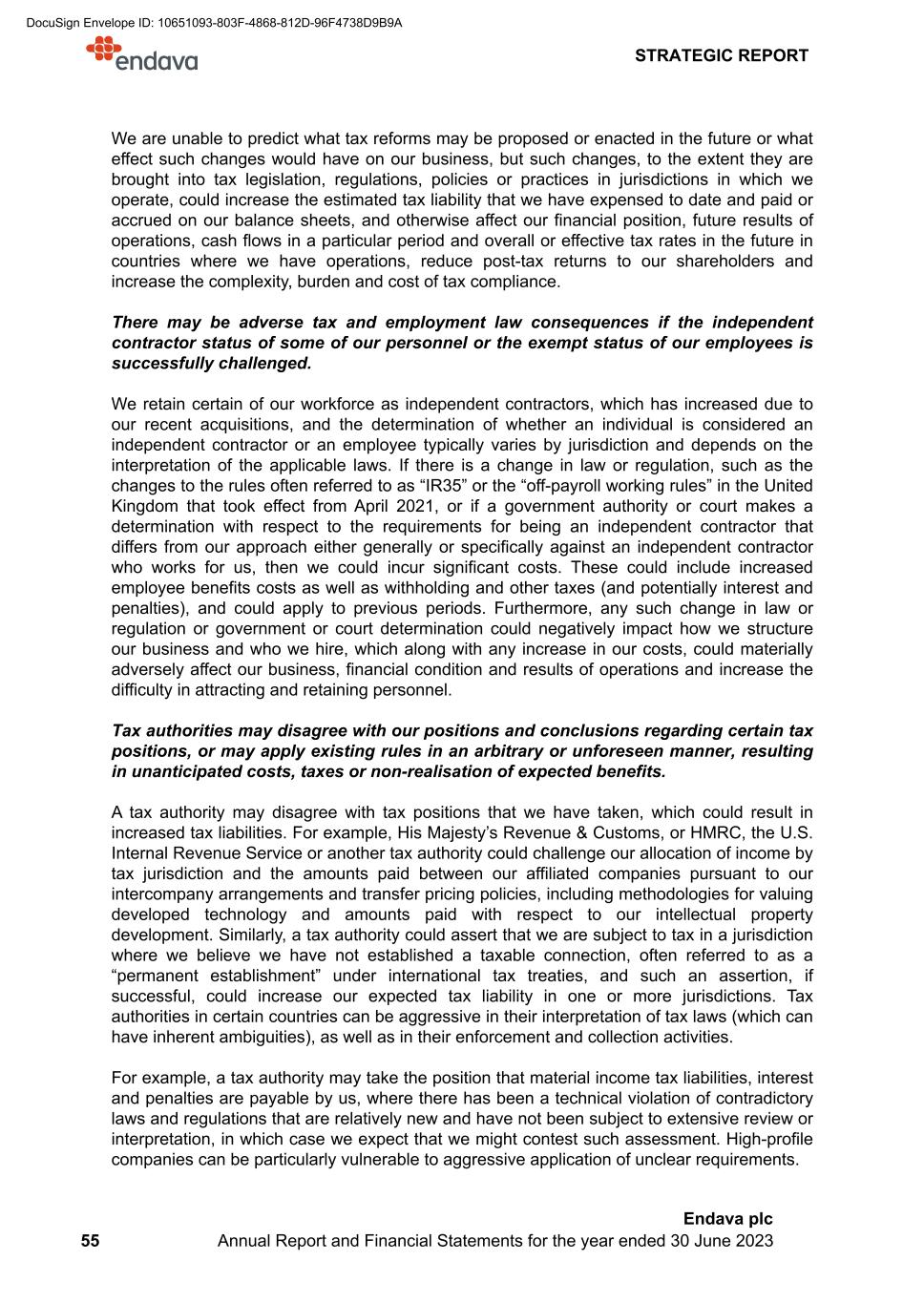
We are unable to predict what tax reforms may be proposed or enacted in the future or what effect such changes would have on our business, but such changes, to the extent they are brought into tax legislation, regulations, policies or practices in jurisdictions in which we operate, could increase the estimated tax liability that we have expensed to date and paid or accrued on our balance sheets, and otherwise affect our financial position, future results of operations, cash flows in a particular period and overall or effective tax rates in the future in countries where we have operations, reduce post-tax returns to our shareholders and increase the complexity, burden and cost of tax compliance. There may be adverse tax and employment law consequences if the independent contractor status of some of our personnel or the exempt status of our employees is successfully challenged. We retain certain of our workforce as independent contractors, which has increased due to our recent acquisitions, and the determination of whether an individual is considered an independent contractor or an employee typically varies by jurisdiction and depends on the interpretation of the applicable laws. If there is a change in law or regulation, such as the changes to the rules often referred to as “IR35” or the “off-payroll working rules” in the United Kingdom that took effect from April 2021, or if a government authority or court makes a determination with respect to the requirements for being an independent contractor that differs from our approach either generally or specifically against an independent contractor who works for us, then we could incur significant costs. These could include increased employee benefits costs as well as withholding and other taxes (and potentially interest and penalties), and could apply to previous periods. Furthermore, any such change in law or regulation or government or court determination could negatively impact how we structure our business and who we hire, which along with any increase in our costs, could materially adversely affect our business, financial condition and results of operations and increase the difficulty in attracting and retaining personnel. Tax authorities may disagree with our positions and conclusions regarding certain tax positions, or may apply existing rules in an arbitrary or unforeseen manner, resulting in unanticipated costs, taxes or non-realisation of expected benefits. A tax authority may disagree with tax positions that we have taken, which could result in increased tax liabilities. For example, His Majesty’s Revenue & Customs, or HMRC, the U.S. Internal Revenue Service or another tax authority could challenge our allocation of income by tax jurisdiction and the amounts paid between our affiliated companies pursuant to our intercompany arrangements and transfer pricing policies, including methodologies for valuing developed technology and amounts paid with respect to our intellectual property development. Similarly, a tax authority could assert that we are subject to tax in a jurisdiction where we believe we have not established a taxable connection, often referred to as a “permanent establishment” under international tax treaties, and such an assertion, if successful, could increase our expected tax liability in one or more jurisdictions. Tax authorities in certain countries can be aggressive in their interpretation of tax laws (which can have inherent ambiguities), as well as in their enforcement and collection activities. For example, a tax authority may take the position that material income tax liabilities, interest and penalties are payable by us, where there has been a technical violation of contradictory laws and regulations that are relatively new and have not been subject to extensive review or interpretation, in which case we expect that we might contest such assessment. High-profile companies can be particularly vulnerable to aggressive application of unclear requirements. STRATEGIC REPORT 55 Endava plc Annual Report and Financial Statements for the year ended 30 June 2023 DocuSign Envelope ID: 10651093-803F-4868-812D-96F4738D9B9A
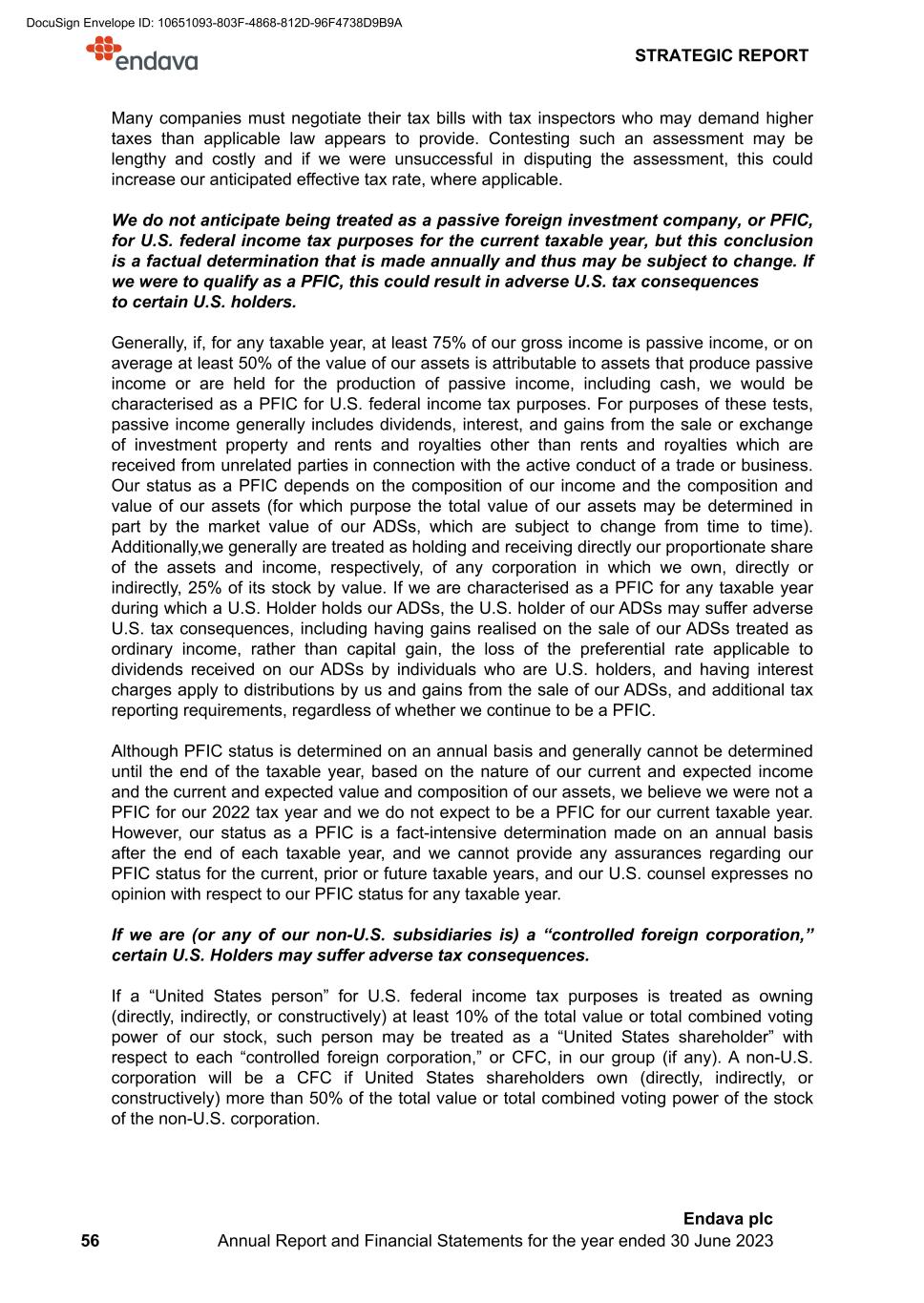
Many companies must negotiate their tax bills with tax inspectors who may demand higher taxes than applicable law appears to provide. Contesting such an assessment may be lengthy and costly and if we were unsuccessful in disputing the assessment, this could increase our anticipated effective tax rate, where applicable. We do not anticipate being treated as a passive foreign investment company, or PFIC, for U.S. federal income tax purposes for the current taxable year, but this conclusion is a factual determination that is made annually and thus may be subject to change. If we were to qualify as a PFIC, this could result in adverse U.S. tax consequences to certain U.S. holders. Generally, if, for any taxable year, at least 75% of our gross income is passive income, or on average at least 50% of the value of our assets is attributable to assets that produce passive income or are held for the production of passive income, including cash, we would be characterised as a PFIC for U.S. federal income tax purposes. For purposes of these tests, passive income generally includes dividends, interest, and gains from the sale or exchange of investment property and rents and royalties other than rents and royalties which are received from unrelated parties in connection with the active conduct of a trade or business. Our status as a PFIC depends on the composition of our income and the composition and value of our assets (for which purpose the total value of our assets may be determined in part by the market value of our ADSs, which are subject to change from time to time). Additionally,we generally are treated as holding and receiving directly our proportionate share of the assets and income, respectively, of any corporation in which we own, directly or indirectly, 25% of its stock by value. If we are characterised as a PFIC for any taxable year during which a U.S. Holder holds our ADSs, the U.S. holder of our ADSs may suffer adverse U.S. tax consequences, including having gains realised on the sale of our ADSs treated as ordinary income, rather than capital gain, the loss of the preferential rate applicable to dividends received on our ADSs by individuals who are U.S. holders, and having interest charges apply to distributions by us and gains from the sale of our ADSs, and additional tax reporting requirements, regardless of whether we continue to be a PFIC. Although PFIC status is determined on an annual basis and generally cannot be determined until the end of the taxable year, based on the nature of our current and expected income and the current and expected value and composition of our assets, we believe we were not a PFIC for our 2022 tax year and we do not expect to be a PFIC for our current taxable year. However, our status as a PFIC is a fact-intensive determination made on an annual basis after the end of each taxable year, and we cannot provide any assurances regarding our PFIC status for the current, prior or future taxable years, and our U.S. counsel expresses no opinion with respect to our PFIC status for any taxable year. If we are (or any of our non-U.S. subsidiaries is) a “controlled foreign corporation,” certain U.S. Holders may suffer adverse tax consequences. If a “United States person” for U.S. federal income tax purposes is treated as owning (directly, indirectly, or constructively) at least 10% of the total value or total combined voting power of our stock, such person may be treated as a “United States shareholder” with respect to each “controlled foreign corporation,” or CFC, in our group (if any). A non-U.S. corporation will be a CFC if United States shareholders own (directly, indirectly, or constructively) more than 50% of the total value or total combined voting power of the stock of the non-U.S. corporation. STRATEGIC REPORT 56 Endava plc Annual Report and Financial Statements for the year ended 30 June 2023 DocuSign Envelope ID: 10651093-803F-4868-812D-96F4738D9B9A

Because our group includes one or more U.S. corporate subsidiaries, certain of our current or future non-U.S. corporate subsidiaries could be treated as CFCs (regardless of whether we are treated as a CFC). A United States shareholder of a CFC may be required to report annually and include in its U.S. taxable income its pro rata share of the CFC’s “Subpart F income,” “global intangible low-taxed income,” and investments of earnings in U.S. property (regardless of whether the CFC makes any distributions to its shareholders). Additionally, an individual United States shareholder with respect to a CFC generally would not be allowed certain tax deductions or foreign tax credits that would be allowed to a corporate United States shareholder. A failure to comply with CFC reporting obligations may subject a United States shareholder to significant monetary penalties and prevent the statute of limitations from running with respect to the United States shareholder’s U.S. federal income tax return for the taxable year in which reporting was due.There can be no assurance that we will assist our U.S. shareholders in determining whether we are (or any of our current or future non-U.S. subsidiaries is) treated as a CFC or whether such U.S. shareholders are treated as United States shareholders with respect to any such CFCs, or that we will furnish to any United States shareholders information that may be necessary to comply with CFC reporting and tax paying obligations. U.S. Holders should consult their tax advisors regarding the application of the CFC rules in their particular circumstances. Emerging markets are subject to greater risks than more developed markets, and financial turmoil in any emerging market could disrupt our business. Certain countries in South Asia, Central European and Latin American countries are generally considered to be emerging markets, which are subject to rapid change and greater legal, economic and political risks than more established markets. Financial problems or an increase in the perceived risks associated with investing in emerging economies could dampen foreign investment in South East Asia, Central Europe and Latin America and adversely affect the economy of the region. Political instability could result in a worsening overall economic situation, including capital flight and slowdown of investment and business activity. Current and future changes in governments of the countries in which we have or develop operations, as well as major policy shifts or lack of consensus between various branches of the government and powerful economic groups, could lead to political instability and disrupt or reverse political, economic and regulatory reforms, which could materially adversely affect our business and operations in those countries. In addition, political and economic relations between certain of the countries in which we operate are complex, and recent conflicts have arisen between certain of their governments. Political, ethnic, religious, historical and other differences have, on occasion, given rise to tensions and, in certain cases, military conflicts among Central European, Latin American or South East Asian countries which can halt normal economic activity and disrupt the economies of neighbouring regions. The emergence of new or escalated tensions in South East Asia, Central European or Latin American countries could further exacerbate tensions between such countries and the United Kingdom, the United States and the European Union, which may have a negative effect on their economy, our ability to develop or maintain our operations in those countries and our ability to attract and retain employees, any of which could materially adversely affect our business and operations. In addition, banking and other financial systems in certain countries in which we have operations are less developed and regulated than in some more developed markets, and legislation relating to banks and bank accounts is subject to varying interpretations and inconsistent application. Banks in these regions often do not meet the banking standards of more developed markets, and the transparency of the banking sector lags behind international standards. STRATEGIC REPORT 57 Endava plc Annual Report and Financial Statements for the year ended 30 June 2023 DocuSign Envelope ID: 10651093-803F-4868-812D-96F4738D9B9A

Furthermore, in certain countries in which we operate, bank deposits made by corporate entities generally either are not insured or are insured only to specified limits. As a result, the banking sector remains subject to periodic instability. Another banking crisis, or the bankruptcy or insolvency of banks through which we receive or with which we hold funds may result in the loss of our deposits or adversely affect our ability to complete banking transactions in certain countries in which we have operations, which could materially adversely affect our business and financial condition. Wage inflation and other compensation expense for our IT professionals could adversely affect our financial results. Wage costs for IT professionals in South East Asia, Central European and Latin American countries are typically lower than comparable wage costs in more developed countries. However, wage costs in the technology services industry in these countries may increase at a faster rate than in the past and wage inflation for the IT industry may be higher than overall wage inflation within these countries. We may need to increase the levels of employee compensation more rapidly than in the past to remain competitive, and we may not be able to pass on these increased costs to our clients. In addition, we have observed increased wage expectations on a global scale due to inflation and adverse global economic conditions. Such wage expectations could create challenges for our recruiting efforts in light of profitability considerations and margin expectations. Unless we are able to continue to increase the efficiency and productivity of our employees as well as the prices we can charge for our services, wage inflation may materially adversely affect our financial condition and results of operations. We are subject to the U.K. Bribery Act, the U.S. Foreign Corrupt Practices Act and other anti-corruption laws, as well as export control laws, import and customs laws, trade and economic sanctions laws and other laws governing our operations. Our operations are subject to anti-corruption laws, including the U.K. Bribery Act 2010, or the Bribery Act, the U.S. Foreign Corrupt Practices Act of 1977, as amended, or the FCPA, the U.S. domestic bribery statute contained in 18 U.S.C. §201, the U.S. Travel Act, and other anti-corruption laws that apply in countries where we do business. The Bribery Act, the FCPA and these other laws generally prohibit us, our employees and intermediaries from authorising, promising, offering, or providing, directly or indirectly, improper or prohibited payments, or anything else of value, to government officials or other persons to obtain or retain business or gain some other business advantage. Under the Bribery Act, we may also become liable for failing to prevent a person associated with us from committing a bribery offense. We operate in a number of jurisdictions that pose a high risk of potential Bribery Act or FCPA violations. In addition, we cannot predict the nature, scope or effect of future regulatory requirements to which our international operations might be subject or the manner in which existing laws might be administered or interpreted. We are also subject to other laws and regulations governing our international operations, including regulations administered by the governments of the United Kingdom and the United States, and authorities in the European Union, applicable export control regulations, economic sanctions and embargoes on certain countries and persons, including those administered by H.M. Treasury’s Office of Financial Sanctions Implementation (OFSI) and the U.S. Treasury Department’s Office of Foreign Assets Control or OFAC, anti-money laundering laws, anti-fraud laws, import and customs requirements and currency exchange regulations, collectively referred to as the Trade Control laws. STRATEGIC REPORT 58 Endava plc Annual Report and Financial Statements for the year ended 30 June 2023 DocuSign Envelope ID: 10651093-803F-4868-812D-96F4738D9B9A
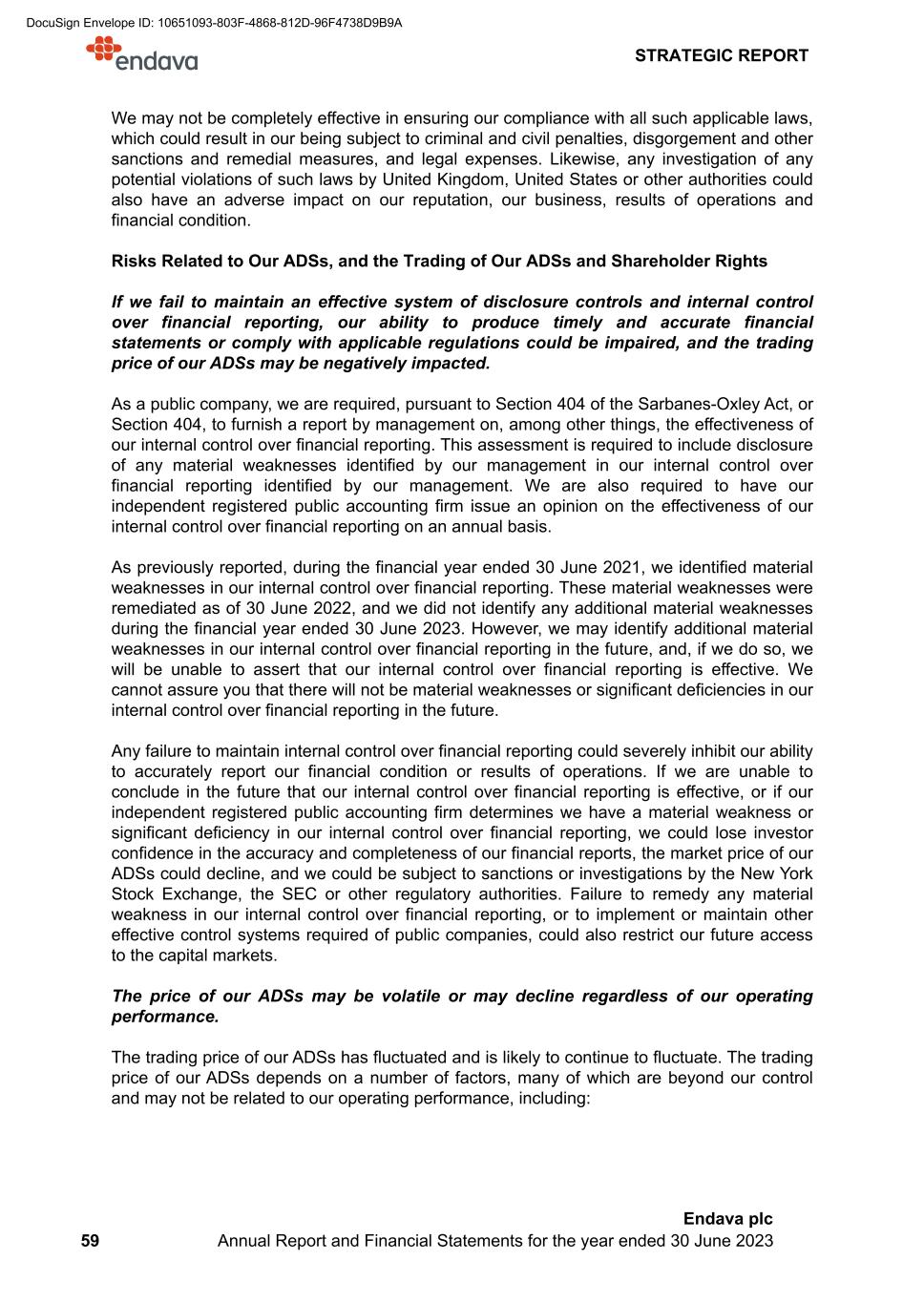
We may not be completely effective in ensuring our compliance with all such applicable laws, which could result in our being subject to criminal and civil penalties, disgorgement and other sanctions and remedial measures, and legal expenses. Likewise, any investigation of any potential violations of such laws by United Kingdom, United States or other authorities could also have an adverse impact on our reputation, our business, results of operations and financial condition. Risks Related to Our ADSs, and the Trading of Our ADSs and Shareholder Rights If we fail to maintain an effective system of disclosure controls and internal control over financial reporting, our ability to produce timely and accurate financial statements or comply with applicable regulations could be impaired, and the trading price of our ADSs may be negatively impacted. As a public company, we are required, pursuant to Section 404 of the Sarbanes-Oxley Act, or Section 404, to furnish a report by management on, among other things, the effectiveness of our internal control over financial reporting. This assessment is required to include disclosure of any material weaknesses identified by our management in our internal control over financial reporting identified by our management. We are also required to have our independent registered public accounting firm issue an opinion on the effectiveness of our internal control over financial reporting on an annual basis. As previously reported, during the financial year ended 30 June 2021, we identified material weaknesses in our internal control over financial reporting. These material weaknesses were remediated as of 30 June 2022, and we did not identify any additional material weaknesses during the financial year ended 30 June 2023. However, we may identify additional material weaknesses in our internal control over financial reporting in the future, and, if we do so, we will be unable to assert that our internal control over financial reporting is effective. We cannot assure you that there will not be material weaknesses or significant deficiencies in our internal control over financial reporting in the future. Any failure to maintain internal control over financial reporting could severely inhibit our ability to accurately report our financial condition or results of operations. If we are unable to conclude in the future that our internal control over financial reporting is effective, or if our independent registered public accounting firm determines we have a material weakness or significant deficiency in our internal control over financial reporting, we could lose investor confidence in the accuracy and completeness of our financial reports, the market price of our ADSs could decline, and we could be subject to sanctions or investigations by the New York Stock Exchange, the SEC or other regulatory authorities. Failure to remedy any material weakness in our internal control over financial reporting, or to implement or maintain other effective control systems required of public companies, could also restrict our future access to the capital markets. The price of our ADSs may be volatile or may decline regardless of our operating performance. The trading price of our ADSs has fluctuated and is likely to continue to fluctuate. The trading price of our ADSs depends on a number of factors, many of which are beyond our control and may not be related to our operating performance, including: STRATEGIC REPORT 59 Endava plc Annual Report and Financial Statements for the year ended 30 June 2023 DocuSign Envelope ID: 10651093-803F-4868-812D-96F4738D9B9A
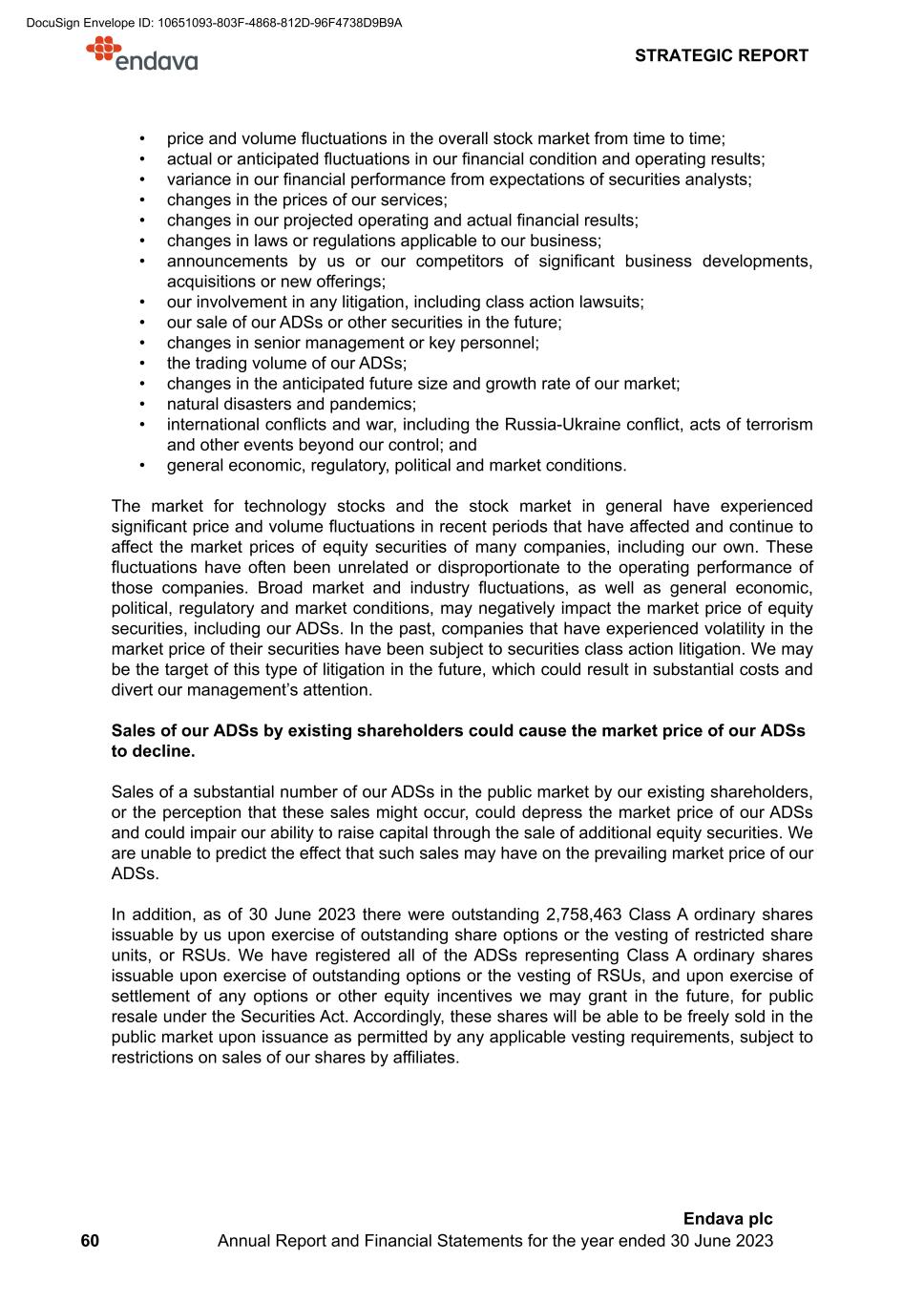
• price and volume fluctuations in the overall stock market from time to time; • actual or anticipated fluctuations in our financial condition and operating results; • variance in our financial performance from expectations of securities analysts; • changes in the prices of our services; • changes in our projected operating and actual financial results; • changes in laws or regulations applicable to our business; • announcements by us or our competitors of significant business developments, acquisitions or new offerings; • our involvement in any litigation, including class action lawsuits; • our sale of our ADSs or other securities in the future; • changes in senior management or key personnel; • the trading volume of our ADSs; • changes in the anticipated future size and growth rate of our market; • natural disasters and pandemics; • international conflicts and war, including the Russia-Ukraine conflict, acts of terrorism and other events beyond our control; and • general economic, regulatory, political and market conditions. The market for technology stocks and the stock market in general have experienced significant price and volume fluctuations in recent periods that have affected and continue to affect the market prices of equity securities of many companies, including our own. These fluctuations have often been unrelated or disproportionate to the operating performance of those companies. Broad market and industry fluctuations, as well as general economic, political, regulatory and market conditions, may negatively impact the market price of equity securities, including our ADSs. In the past, companies that have experienced volatility in the market price of their securities have been subject to securities class action litigation. We may be the target of this type of litigation in the future, which could result in substantial costs and divert our management’s attention. Sales of our ADSs by existing shareholders could cause the market price of our ADSs to decline. Sales of a substantial number of our ADSs in the public market by our existing shareholders, or the perception that these sales might occur, could depress the market price of our ADSs and could impair our ability to raise capital through the sale of additional equity securities. We are unable to predict the effect that such sales may have on the prevailing market price of our ADSs. In addition, as of 30 June 2023 there were outstanding 2,758,463 Class A ordinary shares issuable by us upon exercise of outstanding share options or the vesting of restricted share units, or RSUs. We have registered all of the ADSs representing Class A ordinary shares issuable upon exercise of outstanding options or the vesting of RSUs, and upon exercise of settlement of any options or other equity incentives we may grant in the future, for public resale under the Securities Act. Accordingly, these shares will be able to be freely sold in the public market upon issuance as permitted by any applicable vesting requirements, subject to restrictions on sales of our shares by affiliates. STRATEGIC REPORT 60 Endava plc Annual Report and Financial Statements for the year ended 30 June 2023 DocuSign Envelope ID: 10651093-803F-4868-812D-96F4738D9B9A
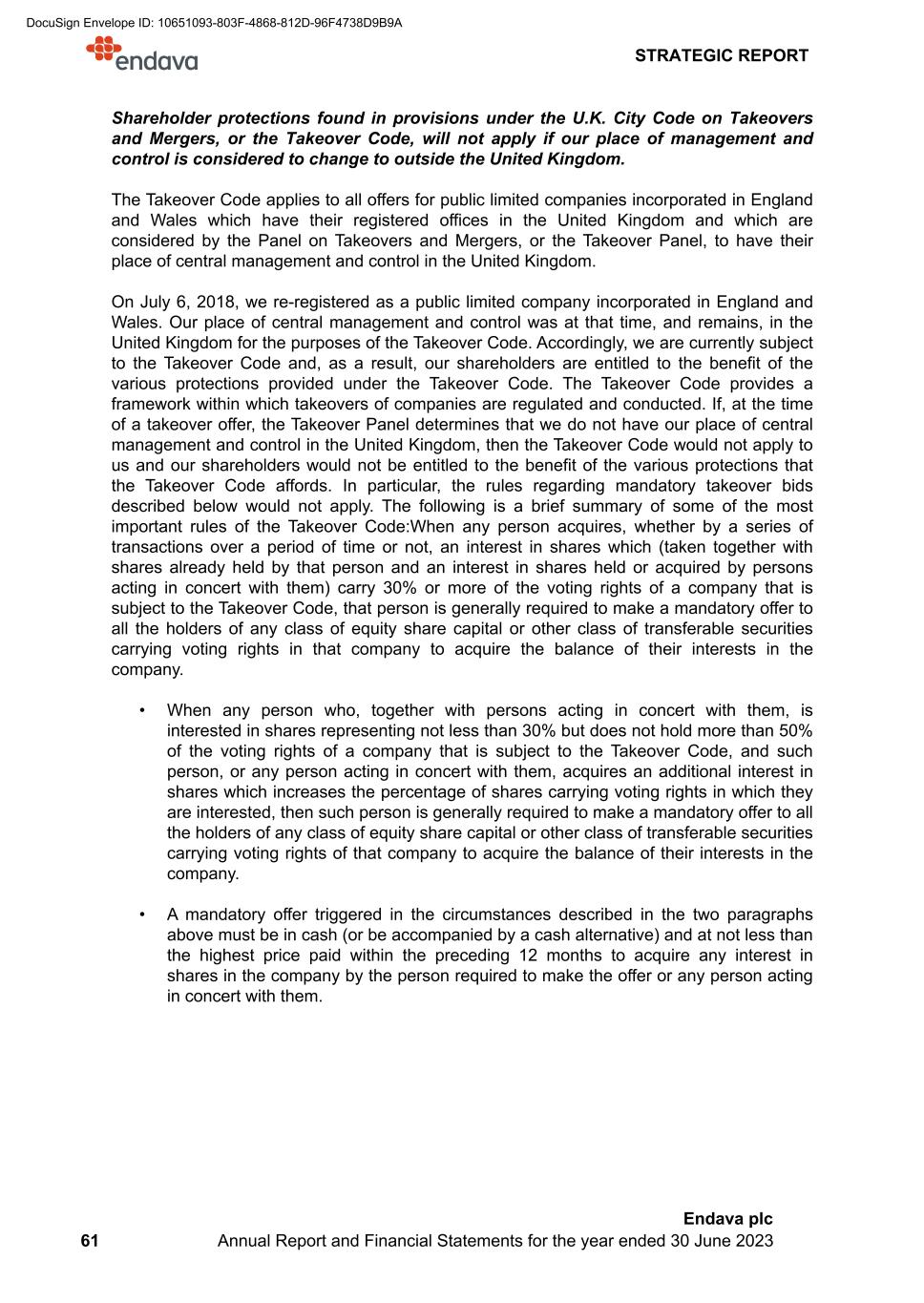
Shareholder protections found in provisions under the U.K. City Code on Takeovers and Mergers, or the Takeover Code, will not apply if our place of management and control is considered to change to outside the United Kingdom. The Takeover Code applies to all offers for public limited companies incorporated in England and Wales which have their registered offices in the United Kingdom and which are considered by the Panel on Takeovers and Mergers, or the Takeover Panel, to have their place of central management and control in the United Kingdom. On July 6, 2018, we re-registered as a public limited company incorporated in England and Wales. Our place of central management and control was at that time, and remains, in the United Kingdom for the purposes of the Takeover Code. Accordingly, we are currently subject to the Takeover Code and, as a result, our shareholders are entitled to the benefit of the various protections provided under the Takeover Code. The Takeover Code provides a framework within which takeovers of companies are regulated and conducted. If, at the time of a takeover offer, the Takeover Panel determines that we do not have our place of central management and control in the United Kingdom, then the Takeover Code would not apply to us and our shareholders would not be entitled to the benefit of the various protections that the Takeover Code affords. In particular, the rules regarding mandatory takeover bids described below would not apply. The following is a brief summary of some of the most important rules of the Takeover Code:When any person acquires, whether by a series of transactions over a period of time or not, an interest in shares which (taken together with shares already held by that person and an interest in shares held or acquired by persons acting in concert with them) carry 30% or more of the voting rights of a company that is subject to the Takeover Code, that person is generally required to make a mandatory offer to all the holders of any class of equity share capital or other class of transferable securities carrying voting rights in that company to acquire the balance of their interests in the company. • When any person who, together with persons acting in concert with them, is interested in shares representing not less than 30% but does not hold more than 50% of the voting rights of a company that is subject to the Takeover Code, and such person, or any person acting in concert with them, acquires an additional interest in shares which increases the percentage of shares carrying voting rights in which they are interested, then such person is generally required to make a mandatory offer to all the holders of any class of equity share capital or other class of transferable securities carrying voting rights of that company to acquire the balance of their interests in the company. • A mandatory offer triggered in the circumstances described in the two paragraphs above must be in cash (or be accompanied by a cash alternative) and at not less than the highest price paid within the preceding 12 months to acquire any interest in shares in the company by the person required to make the offer or any person acting in concert with them. STRATEGIC REPORT 61 Endava plc Annual Report and Financial Statements for the year ended 30 June 2023 DocuSign Envelope ID: 10651093-803F-4868-812D-96F4738D9B9A
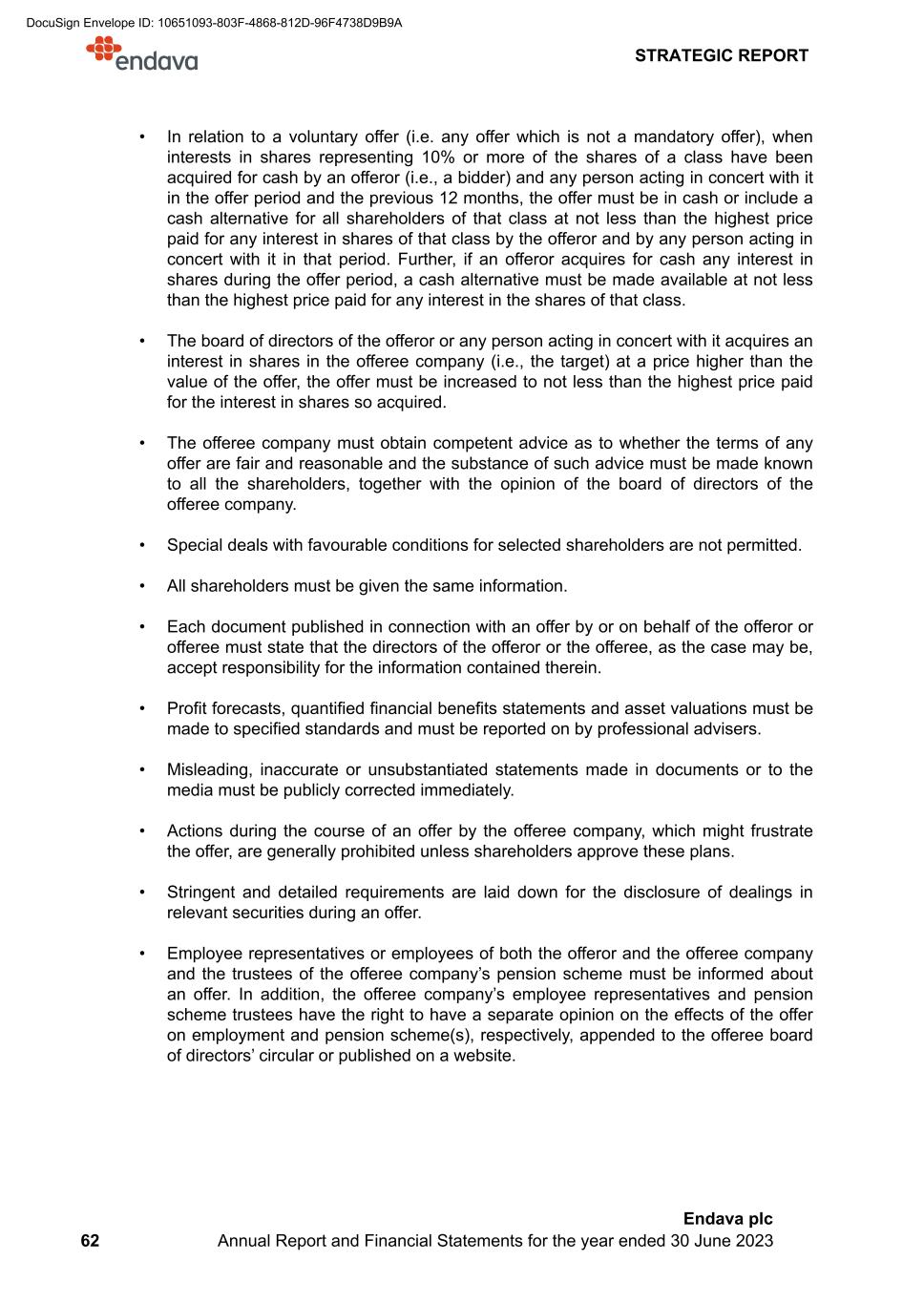
• In relation to a voluntary offer (i.e. any offer which is not a mandatory offer), when interests in shares representing 10% or more of the shares of a class have been acquired for cash by an offeror (i.e., a bidder) and any person acting in concert with it in the offer period and the previous 12 months, the offer must be in cash or include a cash alternative for all shareholders of that class at not less than the highest price paid for any interest in shares of that class by the offeror and by any person acting in concert with it in that period. Further, if an offeror acquires for cash any interest in shares during the offer period, a cash alternative must be made available at not less than the highest price paid for any interest in the shares of that class. • The board of directors of the offeror or any person acting in concert with it acquires an interest in shares in the offeree company (i.e., the target) at a price higher than the value of the offer, the offer must be increased to not less than the highest price paid for the interest in shares so acquired. • The offeree company must obtain competent advice as to whether the terms of any offer are fair and reasonable and the substance of such advice must be made known to all the shareholders, together with the opinion of the board of directors of the offeree company. • Special deals with favourable conditions for selected shareholders are not permitted. • All shareholders must be given the same information. • Each document published in connection with an offer by or on behalf of the offeror or offeree must state that the directors of the offeror or the offeree, as the case may be, accept responsibility for the information contained therein. • Profit forecasts, quantified financial benefits statements and asset valuations must be made to specified standards and must be reported on by professional advisers. • Misleading, inaccurate or unsubstantiated statements made in documents or to the media must be publicly corrected immediately. • Actions during the course of an offer by the offeree company, which might frustrate the offer, are generally prohibited unless shareholders approve these plans. • Stringent and detailed requirements are laid down for the disclosure of dealings in relevant securities during an offer. • Employee representatives or employees of both the offeror and the offeree company and the trustees of the offeree company’s pension scheme must be informed about an offer. In addition, the offeree company’s employee representatives and pension scheme trustees have the right to have a separate opinion on the effects of the offer on employment and pension scheme(s), respectively, appended to the offeree board of directors’ circular or published on a website. STRATEGIC REPORT 62 Endava plc Annual Report and Financial Statements for the year ended 30 June 2023 DocuSign Envelope ID: 10651093-803F-4868-812D-96F4738D9B9A
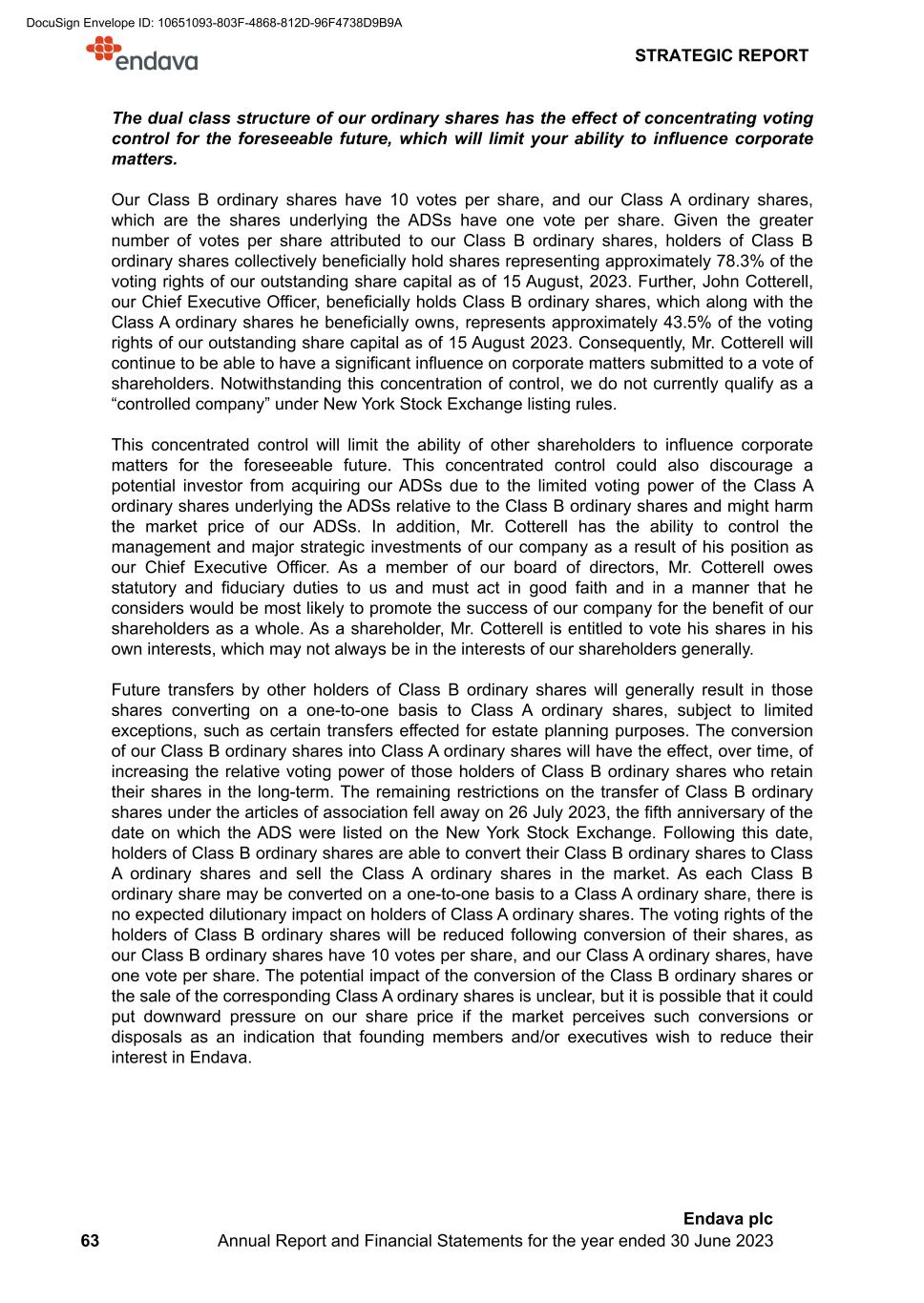
The dual class structure of our ordinary shares has the effect of concentrating voting control for the foreseeable future, which will limit your ability to influence corporate matters. Our Class B ordinary shares have 10 votes per share, and our Class A ordinary shares, which are the shares underlying the ADSs have one vote per share. Given the greater number of votes per share attributed to our Class B ordinary shares, holders of Class B ordinary shares collectively beneficially hold shares representing approximately 78.3% of the voting rights of our outstanding share capital as of 15 August, 2023. Further, John Cotterell, our Chief Executive Officer, beneficially holds Class B ordinary shares, which along with the Class A ordinary shares he beneficially owns, represents approximately 43.5% of the voting rights of our outstanding share capital as of 15 August 2023. Consequently, Mr. Cotterell will continue to be able to have a significant influence on corporate matters submitted to a vote of shareholders. Notwithstanding this concentration of control, we do not currently qualify as a “controlled company” under New York Stock Exchange listing rules. This concentrated control will limit the ability of other shareholders to influence corporate matters for the foreseeable future. This concentrated control could also discourage a potential investor from acquiring our ADSs due to the limited voting power of the Class A ordinary shares underlying the ADSs relative to the Class B ordinary shares and might harm the market price of our ADSs. In addition, Mr. Cotterell has the ability to control the management and major strategic investments of our company as a result of his position as our Chief Executive Officer. As a member of our board of directors, Mr. Cotterell owes statutory and fiduciary duties to us and must act in good faith and in a manner that he considers would be most likely to promote the success of our company for the benefit of our shareholders as a whole. As a shareholder, Mr. Cotterell is entitled to vote his shares in his own interests, which may not always be in the interests of our shareholders generally. Future transfers by other holders of Class B ordinary shares will generally result in those shares converting on a one-to-one basis to Class A ordinary shares, subject to limited exceptions, such as certain transfers effected for estate planning purposes. The conversion of our Class B ordinary shares into Class A ordinary shares will have the effect, over time, of increasing the relative voting power of those holders of Class B ordinary shares who retain their shares in the long-term. The remaining restrictions on the transfer of Class B ordinary shares under the articles of association fell away on 26 July 2023, the fifth anniversary of the date on which the ADS were listed on the New York Stock Exchange. Following this date, holders of Class B ordinary shares are able to convert their Class B ordinary shares to Class A ordinary shares and sell the Class A ordinary shares in the market. As each Class B ordinary share may be converted on a one-to-one basis to a Class A ordinary share, there is no expected dilutionary impact on holders of Class A ordinary shares. The voting rights of the holders of Class B ordinary shares will be reduced following conversion of their shares, as our Class B ordinary shares have 10 votes per share, and our Class A ordinary shares, have one vote per share. The potential impact of the conversion of the Class B ordinary shares or the sale of the corresponding Class A ordinary shares is unclear, but it is possible that it could put downward pressure on our share price if the market perceives such conversions or disposals as an indication that founding members and/or executives wish to reduce their interest in Endava. STRATEGIC REPORT 63 Endava plc Annual Report and Financial Statements for the year ended 30 June 2023 DocuSign Envelope ID: 10651093-803F-4868-812D-96F4738D9B9A
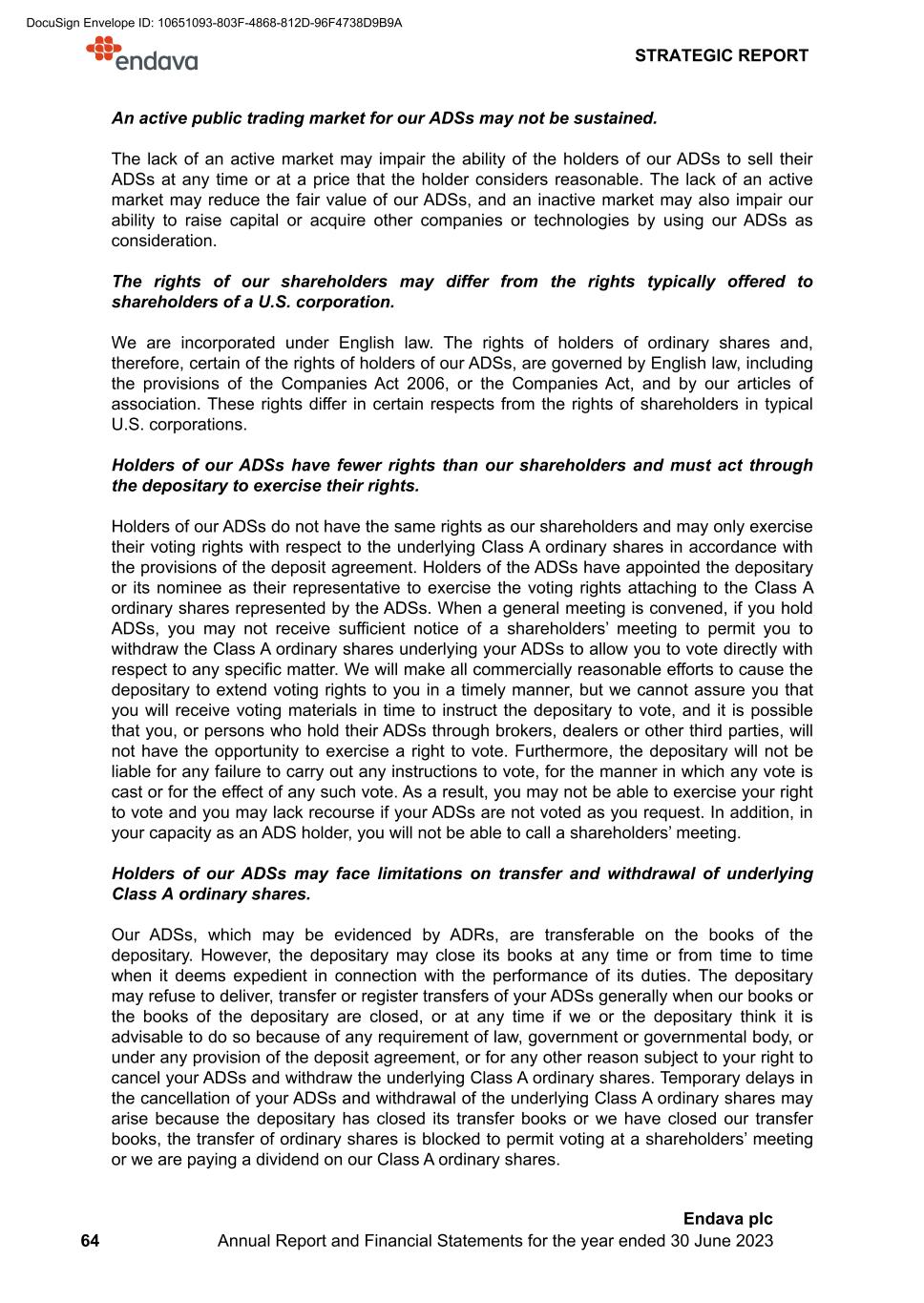
An active public trading market for our ADSs may not be sustained. The lack of an active market may impair the ability of the holders of our ADSs to sell their ADSs at any time or at a price that the holder considers reasonable. The lack of an active market may reduce the fair value of our ADSs, and an inactive market may also impair our ability to raise capital or acquire other companies or technologies by using our ADSs as consideration. The rights of our shareholders may differ from the rights typically offered to shareholders of a U.S. corporation. We are incorporated under English law. The rights of holders of ordinary shares and, therefore, certain of the rights of holders of our ADSs, are governed by English law, including the provisions of the Companies Act 2006, or the Companies Act, and by our articles of association. These rights differ in certain respects from the rights of shareholders in typical U.S. corporations. Holders of our ADSs have fewer rights than our shareholders and must act through the depositary to exercise their rights. Holders of our ADSs do not have the same rights as our shareholders and may only exercise their voting rights with respect to the underlying Class A ordinary shares in accordance with the provisions of the deposit agreement. Holders of the ADSs have appointed the depositary or its nominee as their representative to exercise the voting rights attaching to the Class A ordinary shares represented by the ADSs. When a general meeting is convened, if you hold ADSs, you may not receive sufficient notice of a shareholders’ meeting to permit you to withdraw the Class A ordinary shares underlying your ADSs to allow you to vote directly with respect to any specific matter. We will make all commercially reasonable efforts to cause the depositary to extend voting rights to you in a timely manner, but we cannot assure you that you will receive voting materials in time to instruct the depositary to vote, and it is possible that you, or persons who hold their ADSs through brokers, dealers or other third parties, will not have the opportunity to exercise a right to vote. Furthermore, the depositary will not be liable for any failure to carry out any instructions to vote, for the manner in which any vote is cast or for the effect of any such vote. As a result, you may not be able to exercise your right to vote and you may lack recourse if your ADSs are not voted as you request. In addition, in your capacity as an ADS holder, you will not be able to call a shareholders’ meeting. Holders of our ADSs may face limitations on transfer and withdrawal of underlying Class A ordinary shares. Our ADSs, which may be evidenced by ADRs, are transferable on the books of the depositary. However, the depositary may close its books at any time or from time to time when it deems expedient in connection with the performance of its duties. The depositary may refuse to deliver, transfer or register transfers of your ADSs generally when our books or the books of the depositary are closed, or at any time if we or the depositary think it is advisable to do so because of any requirement of law, government or governmental body, or under any provision of the deposit agreement, or for any other reason subject to your right to cancel your ADSs and withdraw the underlying Class A ordinary shares. Temporary delays in the cancellation of your ADSs and withdrawal of the underlying Class A ordinary shares may arise because the depositary has closed its transfer books or we have closed our transfer books, the transfer of ordinary shares is blocked to permit voting at a shareholders’ meeting or we are paying a dividend on our Class A ordinary shares. STRATEGIC REPORT 64 Endava plc Annual Report and Financial Statements for the year ended 30 June 2023 DocuSign Envelope ID: 10651093-803F-4868-812D-96F4738D9B9A

In addition, you may not be able to cancel your ADSs and withdraw the underlying Class A ordinary shares when you owe money for fees, taxes and similar charges and when it is necessary to prohibit withdrawals in order to comply with any laws or governmental regulations that apply to ADSs or to the withdrawal of Class A ordinary shares or other deposited securities. ADS holders may not be entitled to a jury trial with respect to claims arising under the deposit agreement, which could result in less favourable outcomes to the plaintiff(s) in any such action. The deposit agreement governing the ADSs representing our Class A ordinary shares provides that holders and beneficial owners of ADSs irrevocably waive the right to a trial by jury in any legal proceeding arising out of or relating to the deposit agreement or the ADSs, including in respect of claims under federal securities laws, against us or the depositary to the fullest extent permitted by applicable law. If this jury trial waiver provision is prohibited by applicable law, an action could nevertheless proceed under the terms of the deposit agreement with a jury trial. To our knowledge, the enforceability of a jury trial waiver under the federal securities laws has not been finally adjudicated by a federal court. However, we believe that a jury trial waiver provision is generally enforceable under the laws of the State of New York, which govern the deposit agreement, by a court of the State of New York or a federal court, which have non-exclusive jurisdiction over matters arising under the deposit agreement, applying such law. In determining whether to enforce a jury trial waiver provision, New York courts and federal courts will consider whether the visibility of the jury trial waiver provision within the agreement is sufficiently prominent such that a party has knowingly waived any right to trial by jury. We believe that this is the case with respect to the deposit agreement and the ADSs. In addition, New York courts will not enforce a jury trial waiver provision in order to bar a viable setoff or counterclaim sounding in fraud or one which is based upon a creditor's negligence in failing to liquidate collateral upon a guarantor's demand, or in the case of an intentional tort claim (as opposed to a contract dispute), none of which we believe are applicable in the case of the deposit agreement or the ADSs. No condition, stipulation or provision of the deposit agreement or ADSs serves as a waiver by any holder or beneficial owner of ADSs or by us or the depositary of compliance with any provision of the federal securities laws. If you or any other holder or beneficial owner of ADSs brings a claim against us or the depositary in connection with such matters, you or such other holder or beneficial owner may not be entitled to a jury trial with respect to such claims, which may have the effect of limiting and discouraging lawsuits against us and/or the depositary. If a lawsuit is brought against us and/or the depositary under the deposit agreement, it may be heard only by a judge or justice of the applicable trial court, which would be conducted according to different civil procedures and may result in different outcomes than a trial by jury would have had, including results that could be less favourable to the plaintiff(s) in any such action, depending on, among other things, the nature of the claims, the judge or justice hearing such claims, and the venue of the hearing. STRATEGIC REPORT 65 Endava plc Annual Report and Financial Statements for the year ended 30 June 2023 DocuSign Envelope ID: 10651093-803F-4868-812D-96F4738D9B9A
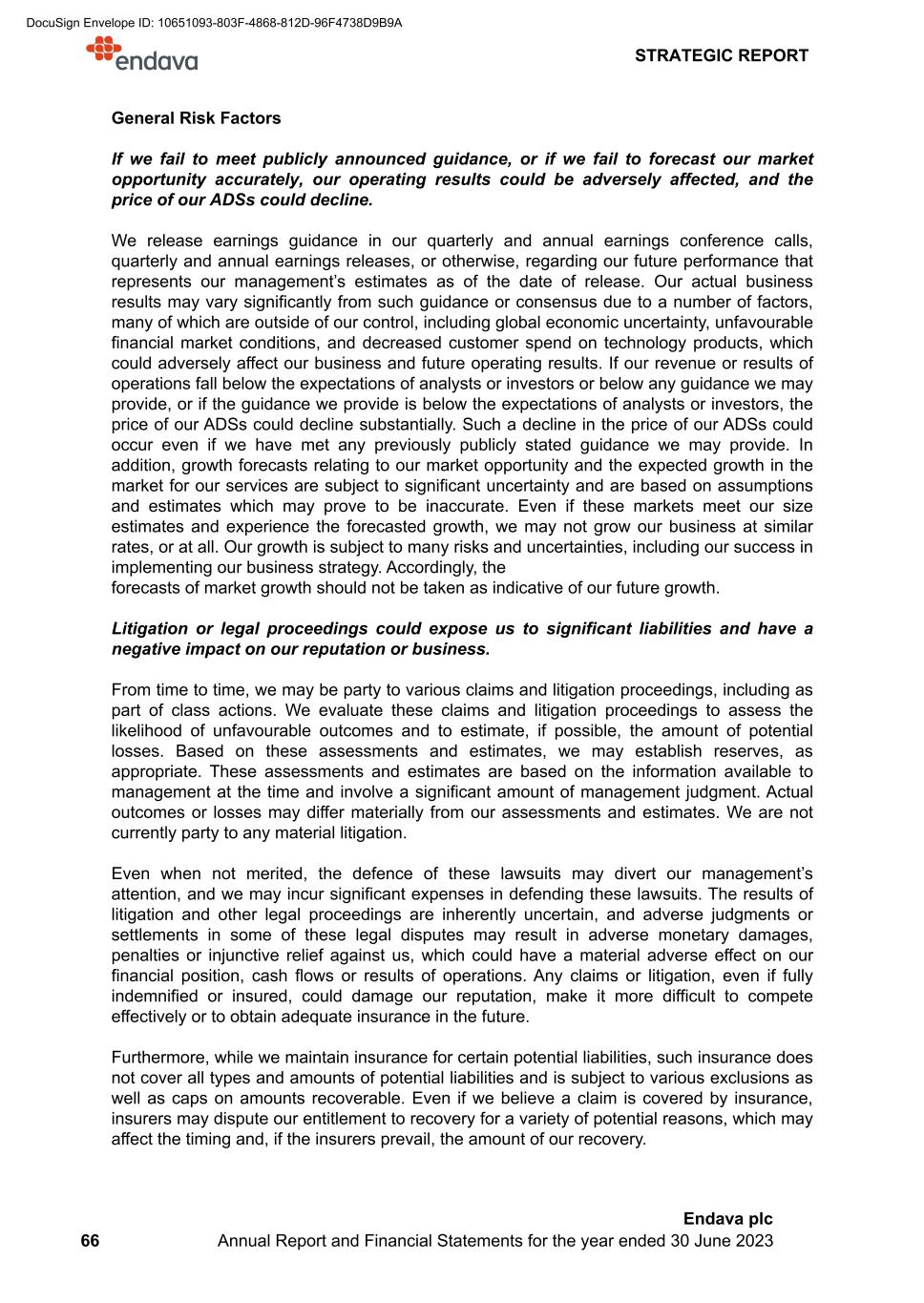
General Risk Factors If we fail to meet publicly announced guidance, or if we fail to forecast our market opportunity accurately, our operating results could be adversely affected, and the price of our ADSs could decline. We release earnings guidance in our quarterly and annual earnings conference calls, quarterly and annual earnings releases, or otherwise, regarding our future performance that represents our management’s estimates as of the date of release. Our actual business results may vary significantly from such guidance or consensus due to a number of factors, many of which are outside of our control, including global economic uncertainty, unfavourable financial market conditions, and decreased customer spend on technology products, which could adversely affect our business and future operating results. If our revenue or results of operations fall below the expectations of analysts or investors or below any guidance we may provide, or if the guidance we provide is below the expectations of analysts or investors, the price of our ADSs could decline substantially. Such a decline in the price of our ADSs could occur even if we have met any previously publicly stated guidance we may provide. In addition, growth forecasts relating to our market opportunity and the expected growth in the market for our services are subject to significant uncertainty and are based on assumptions and estimates which may prove to be inaccurate. Even if these markets meet our size estimates and experience the forecasted growth, we may not grow our business at similar rates, or at all. Our growth is subject to many risks and uncertainties, including our success in implementing our business strategy. Accordingly, the forecasts of market growth should not be taken as indicative of our future growth. Litigation or legal proceedings could expose us to significant liabilities and have a negative impact on our reputation or business. From time to time, we may be party to various claims and litigation proceedings, including as part of class actions. We evaluate these claims and litigation proceedings to assess the likelihood of unfavourable outcomes and to estimate, if possible, the amount of potential losses. Based on these assessments and estimates, we may establish reserves, as appropriate. These assessments and estimates are based on the information available to management at the time and involve a significant amount of management judgment. Actual outcomes or losses may differ materially from our assessments and estimates. We are not currently party to any material litigation. Even when not merited, the defence of these lawsuits may divert our management’s attention, and we may incur significant expenses in defending these lawsuits. The results of litigation and other legal proceedings are inherently uncertain, and adverse judgments or settlements in some of these legal disputes may result in adverse monetary damages, penalties or injunctive relief against us, which could have a material adverse effect on our financial position, cash flows or results of operations. Any claims or litigation, even if fully indemnified or insured, could damage our reputation, make it more difficult to compete effectively or to obtain adequate insurance in the future. Furthermore, while we maintain insurance for certain potential liabilities, such insurance does not cover all types and amounts of potential liabilities and is subject to various exclusions as well as caps on amounts recoverable. Even if we believe a claim is covered by insurance, insurers may dispute our entitlement to recovery for a variety of potential reasons, which may affect the timing and, if the insurers prevail, the amount of our recovery. STRATEGIC REPORT 66 Endava plc Annual Report and Financial Statements for the year ended 30 June 2023 DocuSign Envelope ID: 10651093-803F-4868-812D-96F4738D9B9A

We may need additional capital, and a failure by us to raise additional capital on terms favourable to us, or at all, could limit our ability to grow our business and develop or enhance our service offerings to respond to market demand or competitive challenges. We believe that our current cash balances, cash flow from operations and credit facilities should be sufficient to meet our anticipated cash needs for at least the next 12 months. We may, however, require additional cash resources due to changed business conditions or other future developments, including any investments or acquisitions we may decide to pursue. If these resources are insufficient to satisfy our cash requirements, we may seek to sell additional equity or debt securities, draw down on our revolving credit facility or obtain another credit facility. The sale of additional equity securities could result in dilution to our shareholders. The incurrence of indebtedness would result in increased debt service obligations and could require us to agree to operating and financing covenants that would restrict our operations. Our ability to obtain additional capital on acceptable terms is subject to a variety of uncertainties, including investors' perception of, and demand for, securities of IT services companies, conditions in the capital markets in which we may seek to raise funds, our future results of operations and financial condition, and general economic and political conditions including the recent global economic growth slowdown, high levels of inflation and interest rate fluctuations, all of which may be heightened due to the ongoing Russia-Ukraine conflict and related economic sanctions. Financing may not be available in amounts or on terms acceptable to us, or at all, and could limit our ability to grow our business and develop or enhance our service offerings to respond to market demand or competitive challenges. Claims of U.S. civil liabilities may not be enforceable against us. We are incorporated under English law. Substantially all of our assets are located outside the United States. The majority of our senior management and board of directors reside outside the United States. As a result, it may not be possible for investors to effect service of process within the United States upon such persons or to enforce judgments obtained in U.S. courts against them or us, including judgments predicated upon the civil liability provisions of the U.S. federal securities laws. The United States and the United Kingdom do not currently have a treaty providing for recognition and enforcement of judgments (other than arbitration awards) in civil and commercial matters. Consequently, a final judgment for payment given by a court in the United States, whether or not predicated solely upon U.S. securities laws, would not automatically be recognized or enforceable in the United Kingdom. In addition, uncertainty exists as to whether U.K. courts would entertain original actions brought in the United Kingdom against us or our directors or senior management predicated upon the securities laws of the United States or any state in the United States. Any final and conclusive monetary judgment for a definite sum obtained against us in U.S. courts would be treated by the courts of the United Kingdom as a cause of action in itself and sued upon as a debt at common law so that no retrial of the issues would be necessary, provided that certain requirements are met. Whether these requirements are met in respect of a judgment based upon the civil liability provisions of the U.S. securities laws, including whether the award of monetary damages under such laws would constitute a penalty, is an issue for the court making such decision. If an English court gives judgment for the sum payable under a U.S. judgment, the English judgment will be enforceable by methods generally available for this purpose. These methods generally permit the English court discretion to prescribe the manner of enforcement. STRATEGIC REPORT 67 Endava plc Annual Report and Financial Statements for the year ended 30 June 2023 DocuSign Envelope ID: 10651093-803F-4868-812D-96F4738D9B9A

As a result, U.S. investors may not be able to enforce against us or our senior management, board of directors or certain experts named herein who are residents of the United Kingdom or countries other than the United States any judgments obtained in U.S. courts in civil and commercial matters, including judgments under the U.S. federal securities laws. As a foreign private issuer, we are exempt from a number of rules under the U.S. securities laws and are permitted to file less information with the SEC than U.S. public companies. We are a “foreign private issuer,” as defined in the SEC rules and regulations and, consequently, we are not subject to all of the disclosure requirements applicable to companies organised within the United States. For example, we are exempt from certain rules under the U.S. Securities Exchange Act of 1934, as amended, or the Exchange Act, that regulate disclosure obligations and procedural requirements related to the solicitation of proxies, consents or authorisations applicable to a security registered under the Exchange Act. In addition, our officers and directors are exempt from the reporting and “short-swing” profit recovery provisions of Section 16 of the Exchange Act and related rules with respect to their purchases and sales of our securities. Further, we are not required to comply with Regulation FD, which restricts the selective disclosure of material information. Moreover, we are not required to file periodic reports and financial statements with the SEC as frequently or as promptly as U.S. public companies. Accordingly, there may be less publicly available information concerning our company than there is for U.S. public companies. As a foreign private issuer, we file annual reports on Form 20-F within four months of the close of each financial year ended 30 June and reports on Form 6-K relating to certain material events promptly after we publicly announce these events. However, because of the above exemptions for foreign private issuers, our shareholders are not afforded the same protections or information generally available to investors holding shares in public companies organised in the United States. While we are a foreign private issuer, we are not subject to certain New York Stock Exchange corporate governance listing standards applicable to U.S. listed companies. We are entitled to rely on a provision in the New York Stock Exchange’s corporate governance listing standards that allows us to follow English corporate law and the Companies Act with regard to certain aspects of corporate governance. This allows us to follow certain corporate governance practices that differ in significant respects from the corporate governance requirements applicable to U.S. companies listed on the New York Stock Exchange. For example, we are exempt from New York Stock Exchange regulations that require a listed U.S. company to have a majority of the board of directors consist of independent directors, require regularly scheduled executive sessions with only independent directors each year and have a remuneration committee or a nominations or corporate governance committee consisting entirely of independent directors. In accordance with our New York Stock Exchange listing, our audit committee is required to comply with the provisions of Section 301 of the Sarbanes-Oxley Act and Rule 10A-3 of the Exchange Act, both of which are also applicable to New York Stock Exchange-listed U.S. companies. STRATEGIC REPORT 68 Endava plc Annual Report and Financial Statements for the year ended 30 June 2023 DocuSign Envelope ID: 10651093-803F-4868-812D-96F4738D9B9A

Because we are a foreign private issuer, however, our audit committee is not subject to additional New York Stock Exchange requirements applicable to listed U.S. companies, including an affirmative determination that all members of the audit committee are “independent,” using more stringent criteria than those applicable to us as a foreign private issuer. Furthermore, the New York Stock Exchange’s corporate governance listing standards require listed U.S. companies to, among other things, seek shareholder approval for the implementation of certain equity compensation plans and issuances of ordinary shares, which we are not required to follow as a foreign private issuer. We may lose our foreign private issuer status, which would then require us to comply with the Exchange Act's domestic reporting regime and cause us to incur significant legal, accounting and other expenses. As a foreign private issuer, we are not required to comply with all of the periodic disclosure and current reporting requirements of the Exchange Act applicable to U.S. domestic issuers. We may no longer be a foreign private issuer in the future, which would require us to comply with all of the periodic disclosure and current reporting requirements of the Exchange Act applicable to U.S. domestic issuers as of 1 July 2024. In order to maintain our current status as a foreign private issuer, either (a) a majority of our ordinary shares must be either directly or indirectly owned of record by non-residents of the United States or (b)(1) a majority of our executive officers or directors cannot be U.S. citizens or residents, (b)(2) more than 50 percent of our assets must be located outside the United States and (b)(3) our business must be administered principally outside the United States. If we lose our status as a foreign private issuer, we would be required to comply with the Exchange Act reporting and other requirements applicable to U.S. domestic issuers, which are more detailed and extensive than the requirements for foreign private issuers and will require that we prepare our financial statements in accordance with U.S. Generally Accepted Accounting Principles. We may also be required to make changes in our corporate governance practices in accordance with various SEC and rules. The regulatory and compliance costs to us under U.S. securities laws if we are required to comply with the reporting requirements applicable to a U.S. domestic issuer will be significantly higher than the cost we would incur as a foreign private issuer. As a result, we expect that a loss of foreign private issuer status would increase our legal and financial compliance costs and would make some activities highly time consuming and costly. If securities or industry analysts do not publish research or reports about our business, or publish negative reports about our business, the price of our ADSs and trading volume could decline. The trading market for our ADSs depends, in part, on the research and reports that securities or industry analysts publish about us or our business. We do not have any control over these analysts or the content that they publish about us. If our financial performance fails to meet analyst estimates or one or more of the analysts who cover us downgrade our ADSs or change their opinion of our ADSs, our ADS price would likely decline. If one or more of these analysts cease coverage of our company or fail to regularly publish reports on us, we could lose visibility in the financial markets, which could cause our ADS price or trading volume to decline. STRATEGIC REPORT 69 Endava plc Annual Report and Financial Statements for the year ended 30 June 2023 DocuSign Envelope ID: 10651093-803F-4868-812D-96F4738D9B9A

We do not intend to pay dividends for the foreseeable future and, as a result, your ability to achieve a return on your investment will depend on appreciation in the price of our ADSs. We currently intend to retain any future earnings to finance the growth and development of the business and, therefore, we do not anticipate that we will pay any cash dividends on our ordinary shares, including on the Class A ordinary shares underlying our ADSs, in the foreseeable future. Any determination to pay dividends in the future will be at the discretion of our board of directors and will be dependent upon our future financial condition, results of operations and capital requirements, general business conditions and other relevant factors as determined by our board of directors. Accordingly, investors must rely on sales of their ADSs after price appreciation, which may never occur, as the only way to realize any future gains on their investments. Section 172 Statement The directors are aware of their duty under s172 of the Companies Act 2006 to act in the way which they consider, in good faith, would be most likely to promote the success of the Company for the benefit of its members as a whole and, in doing so, to have regard (amongst other matters) to: • the likely consequences of any decision in the long-term; • the interests of the Company’s employees; • the need to foster the Company’s business relationships with suppliers, customers and others; • the impact of the Company’s operations on the community and the environment; • the desirability of the Company maintaining a reputation for high standards of business conduct; and • the need to act fairly as between members of the Company. Stakeholder Engagement Our key stakeholders include our people, customers, suppliers, investors and our wider communities. Doing the right thing, and caring about the success of all our stakeholders, has always been a focus, and it is firmly rooted in our core purpose and values. We actively engage with, and listen to, our stakeholders to understand their views, and to seek opportunities to learn and improve. We are committed to effective engagement with all of our stakeholders. Our success depends on this engagement. Direct engagement by the board with its stakeholders, where possible, enables the board to deepen their understanding of how the Company’s purpose, values and strategy are embedded across the organisation globally. Where direct engagement is not possible, engagement takes place at the operational level, and the directors are kept fully informed by senior management of all matters on a regular basis for use in the board’s decision-making. The table below, and the following pages of our Strategic Report, describes how the board engages with its key stakeholders, and how it considers their interests when making its decisions. It also demonstrates how the board takes into consideration the long-term impact of its decisions, and its desire to maintain a reputation for high standards of business conduct and ethics. STRATEGIC REPORT 70 Endava plc Annual Report and Financial Statements for the year ended 30 June 2023 DocuSign Envelope ID: 10651093-803F-4868-812D-96F4738D9B9A

Our People Why we engage Our people are at the heart of who we are and are the foundation of our long-term viability and success. Successful performance can be delivered only through a high level of engagement where our people share the Endava vision, values and core purpose, and feel supported by our culture and Code of Conduct. Maintaining a happy and engaged workforce is key to the board's strategy to attract and retain top talent. Engagement and influence on decision-making The board and senior management are committed to enhancing engagement with employees at all levels to ensure we communicate information on decisions taken, emerging developments, innovations and future growth of the business. We care that everyone has a voice and feels heard. The board recognises the importance of using a variety of communication platforms and activities to maximise employee engagement. The board and senior management regularly engage with our people, answering questions in #EndavaGatherings (live broadcasts hosted in all our regions). Emails and QuickFire newsletters share relevant information on decisions taken by management, emerging developments, innovations and Endava's future growth ambitions. While the board cannot directly consult with employees on all decisions it makes, it apprises itself of their opinions in a variety of ways. An example of this includes obtaining feedback through regular employee opinion surveys, which provides the board with honest feedback that the board uses to inform and drive business improvements. The board understands that any decisions it makes may impact employees’ performance, engagement and work satisfaction. Our remuneration programmes are designed to provide all Endavans with an opportunity to participate in our long-term growth. The directors' remuneration report highlights key components of our remuneration programmes this year. The board is mindful that any decisions it makes, as well as the manner in which they are made, will inform the culture of the business. The board seeks to lead by example in order to ensure that high standards of business conduct are maintained by our employees. Our Customers Why we engage We are focused on building deep, long-term relationships with our customers. We believe that it is important to work closely with our customers and to develop relationships that enable us to provide innovative solutions to meet their needs and to increase the positive impact we have on our customers’ businesses. Engagement and influence on decision-making The board receives regular feedback from management on market trends and customer feedback. The board encourages the business to focus on building deep, long-term relationships with our customers. The board has particular regard to the long-term impact its decisions have on our customers. The board is responsible for approving material business transactions and key strategic changes. Prior to making such decisions, the board considers the potential impact on our customers. STRATEGIC REPORT 71 Endava plc Annual Report and Financial Statements for the year ended 30 June 2023 DocuSign Envelope ID: 10651093-803F-4868-812D-96F4738D9B9A

Our Suppliers Why we engage We recognise the importance of establishing and building strong working relationships with all our suppliers. Working sustainably, respecting human rights, and operating with the highest standards of ethical conduct and professional integrity improve long-term business performance. We are dedicated to these values and require our suppliers to share our commitment. Engagement and influence on decision-making The board approves and implements policies based on ethical and legal minimum standards, which it requires the business to adhere to when engaging suppliers. Our suppliers are required to commit to these standards, including in relation to anti-bribery and corruption, anti-money laundering, human rights and modern slavery and various other matters. Our Investors Why we engage We are a public company with ADSs listed on the NYSE. Without our investors, we cannot grow or invest for future success. We engage with existing and potential investors to ensure that we provide sufficient, meaningful and relevant information which they can use to make informed investment decisions. We strictly adhere to market regulations and regularly consult our advisors to ensure we are in compliance with such regulations at all times. Engagement and influence on decision-making Our board and senior management have regular interaction with investors to understand their interests and any concerns they may have. This feeds into the board’s strategic discussions and opportunities, ensuring alignment over strategy, operational performance, remuneration policy, capital structure and future expectations of our investors. Examples of investor engagement by the board and senior management includes board attendance at the Annual General Meeting, NYSE announcements and press releases, board attendance at conferences, regular reports from the Investor Relations team, direct engagement with investors in relation to remuneration policy, communications such as quarterly trading results, annual reports and notices of general meetings, and making available detailed information about Endava and matters of interest to investors on our website. STRATEGIC REPORT 72 Endava plc Annual Report and Financial Statements for the year ended 30 June 2023 DocuSign Envelope ID: 10651093-803F-4868-812D-96F4738D9B9A

Our Wider Communities Why we engage Our global operations are an important part of the communities in which they are located. We have environmental responsibilities to the world in which we live, and societal responsibilities to the communities where we live, work and operate. Engagement and influence on decision-making It is important to the board that the Group gives back to the communities in which it operates. The board considers these communities in determining the corporate culture it wishes to promote. The board takes into consideration the impact that its decisions will have on the wider communities in which we operate, and actively supports our people to volunteer in our communities. The board also takes into consideration the impact that its decisions have on the environment. Below are examples of how the board took into consideration its stakeholders' interests when making principal decisions during the year. Acquisitions during the 2023 financial year In October 2022, May 2023 and June 2023, we acquired Lexicon, Mudbath, and DEK, respectively. In considering each of these transactions, the board had regard to the interests of its stakeholders, and in particular, its investors, customers and employees. The aquisitions augment our core capabilities to enhance our expertise in new technologies and industry verticals, and increase our geographic reach, while preserving our corporate culture and sustainably managing our growth. The board believes that these acquisitions were in the best interests of our stakeholders. Commitment to achieving net zero emissions We care about the world we live in and our focus is on achieving net zero emissions from our organisation and value chain. With this in mind, in February 2022 we signed a commitment letter to the Science Based Targets initiative (SBTi) - a cornerstone of corporate climate action. By doing this, we have committed to set and validate net-zero targets in line with the SBTi's Net-Zero Standard. Signing the commitment letter was the first step of this process, and we are now working on the next step of developing our targets, for submission to and approval by the SBTi. We continue to focus on the processes that will allow us to achieve our environmental aim and ambitions and we expect to have our targets set in 2024. Once these targets have been set and approved, they will be made public, and we will provide further detailed disclosures on the targets and also on progress made against the targets in our future Annual Reports, Sustainability Reports and on our Group website. The board believes that this commitment is in the best interests of all our stakeholders. As a technology company, we are able to drive sustainability through digital acceleration. We are proud to help our clients build green solutions, and to encourage our people to engage in environmental activities and projects. STRATEGIC REPORT 73 Endava plc Annual Report and Financial Statements for the year ended 30 June 2023 DocuSign Envelope ID: 10651093-803F-4868-812D-96F4738D9B9A
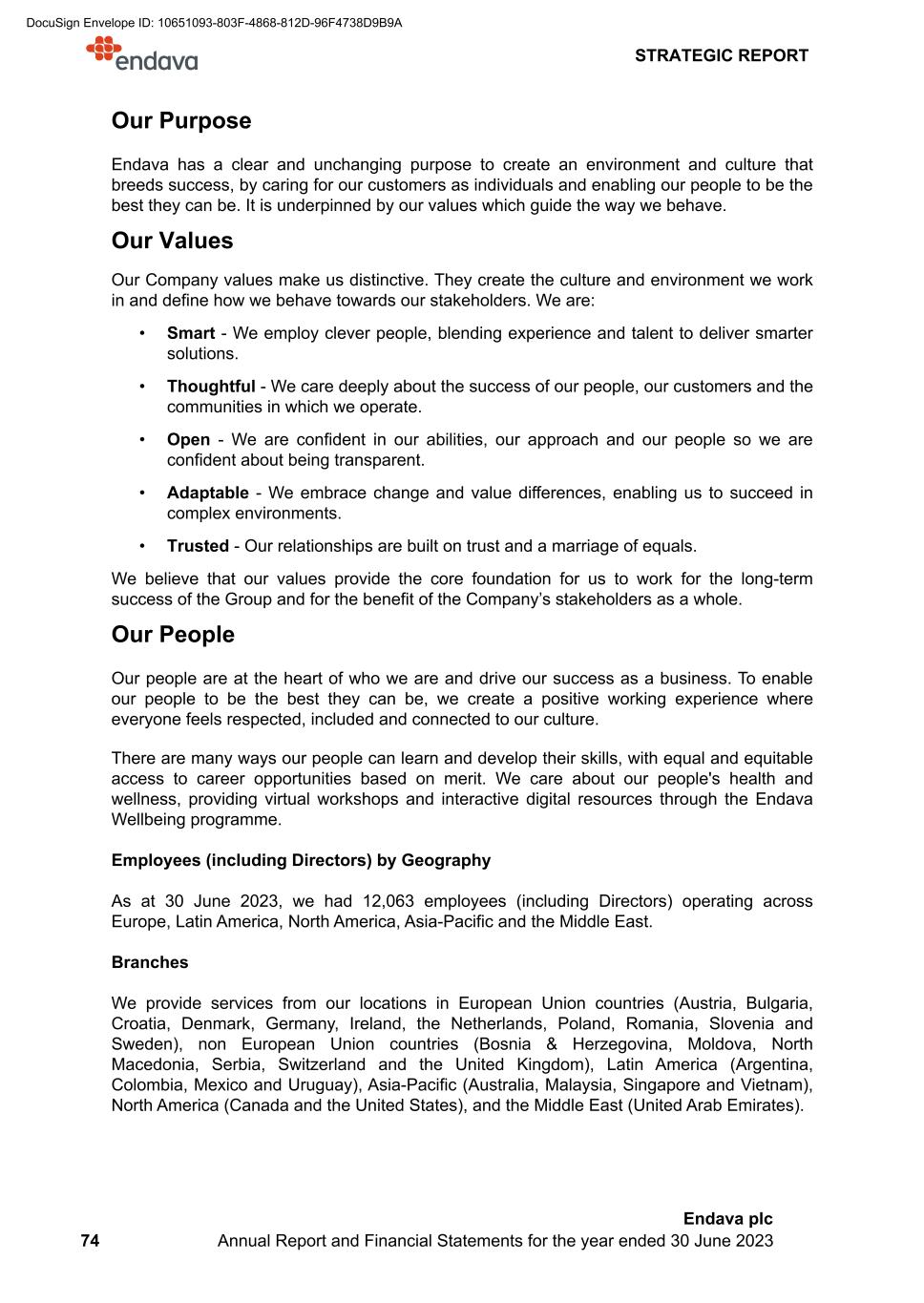
Our Purpose Endava has a clear and unchanging purpose to create an environment and culture that breeds success, by caring for our customers as individuals and enabling our people to be the best they can be. It is underpinned by our values which guide the way we behave. Our Values Our Company values make us distinctive. They create the culture and environment we work in and define how we behave towards our stakeholders. We are: • Smart - We employ clever people, blending experience and talent to deliver smarter solutions. • Thoughtful - We care deeply about the success of our people, our customers and the communities in which we operate. • Open - We are confident in our abilities, our approach and our people so we are confident about being transparent. • Adaptable - We embrace change and value differences, enabling us to succeed in complex environments. • Trusted - Our relationships are built on trust and a marriage of equals. We believe that our values provide the core foundation for us to work for the long-term success of the Group and for the benefit of the Company’s stakeholders as a whole. Our People Our people are at the heart of who we are and drive our success as a business. To enable our people to be the best they can be, we create a positive working experience where everyone feels respected, included and connected to our culture. There are many ways our people can learn and develop their skills, with equal and equitable access to career opportunities based on merit. We care about our people's health and wellness, providing virtual workshops and interactive digital resources through the Endava Wellbeing programme. Employees (including Directors) by Geography As at 30 June 2023, we had 12,063 employees (including Directors) operating across Europe, Latin America, North America, Asia-Pacific and the Middle East. Branches We provide services from our locations in European Union countries (Austria, Bulgaria, Croatia, Denmark, Germany, Ireland, the Netherlands, Poland, Romania, Slovenia and Sweden), non European Union countries (Bosnia & Herzegovina, Moldova, North Macedonia, Serbia, Switzerland and the United Kingdom), Latin America (Argentina, Colombia, Mexico and Uruguay), Asia-Pacific (Australia, Malaysia, Singapore and Vietnam), North America (Canada and the United States), and the Middle East (United Arab Emirates). STRATEGIC REPORT 74 Endava plc Annual Report and Financial Statements for the year ended 30 June 2023 DocuSign Envelope ID: 10651093-803F-4868-812D-96F4738D9B9A

At each date shown, we had the following employees (including directors), broken out by geography and gender: Employees (including directors) by geography As of 30 June 2023 2022 Western Europe1 659 602 Central Europe - EU Countries 5,693 6,093 Sub-total: Western Europe & Central Europe - EU Countries1 6,352 6,695 Central Europe - Non-EU Countries 2,689 2,842 Latin America 1,661 1,927 North America 324 348 Asia-Pacific2 1,032 38 Middle East 5 3 Total 12,063 11,853 1. The increased headcount in Western Europe from FY 2022 to FY 2023 includes 69 acquired employees in connection with our acquisition of DEK in June 2023. 2. The increase in Asia-Pacific from FY 2022 to FY 2023 includes acquired employees in connection with our acquisition of Lexicon in October 2022 (135 employees), Mudbath in May 2023 (112 employees) and DEK in June 2023 (656 employees). Employees (including directors) by gender As at 30 June 2023 Men % Women % Other % Prefer Not To Say % Total Directors 7 77.78 % 2 22.22 % — — % — — % 9 Senior Management 28 87.50 % 4 12.50 % — — % — — % 32 Other Employees of the Group 7,611 63.32 % 4,403 36.62 % 3 0.02 % 5 0.04 % 12,022 Total 7,646 63.39 % 4,409 36.55 % 3 0.02 % 5 0.04 % 12,063 Employees (including directors) by gender As at 30 June 2022 Men % Women % Other % Prefer Not To Say % Total Directors 6 85.71 % 1 14.29 % — — % — — % 7 Senior Management 28 87.50 % 4 12.50 % — — % — — % 32 Other Employees of the Group 7,520 63.65 % 4,290 36.31 % 3 0.03 % 1 0.01 % 11,814 Total 7,554 63.72 % 4,295 36.24 % 3 0.03 % 1 0.01 % 11,853 Diversity, Equity and Inclusion Endava recognises the importance of embracing diversity, equity and inclusion as being essential to our continued success. The Endava Diversity, Inclusion & Belonging Forum is underpinned by our values of being Thoughtful, Open and Adaptable. It delivers on our purpose of enabling us all to be the best that we can be and supporting our promise to be an inclusive community that accepts and celebrates the wonderfully diverse backgrounds of each of us, making sure everyone feels respected, included, supported and connected to our culture. STRATEGIC REPORT 75 Endava plc Annual Report and Financial Statements for the year ended 30 June 2023 DocuSign Envelope ID: 10651093-803F-4868-812D-96F4738D9B9A

The forum has six work-streams covering gender balance; disability; race and religion; sexual orientation and gender reassignment (LGBTQ+); families, parenthood and pregnancy; and age and social mobility. Forum meetings are held quarterly to track and report on progress as well as sharing updates with the business. The six work-streams meet on a monthly basis to agree actions, responsibilities, and review progress against stated aims. Regular check-ins happen as and when required at a local level as agreed by forum members. Forum leads and seniors are responsible for leading a work-stream, bringing suggestions and potential solutions to be reviewed at the global forum level, ensuring they are realistic and fit for purpose to deliver against forum aims. We are committed to identifying and eliminating unfair biases, stereotypes or barriers that may limit people's full participation at work and their access to the opportunity to succeed. We are also committed to ensuring that there is both equality of access and equity of opportunity. We are an equal opportunity employer committed to attracting, developing and retaining a diverse workforce at all levels, building an inclusive working experience and environment that enables our people to excel and progress throughout their careers with the Company. We believe in equal opportunities for both our people and job applicants and will not discriminate against individuals based on gender, sexual orientation, religion or belief, marital or civil partnership status, age or perceived age, race, colour, nationality or ethnic origin, disability, physical or mental well-being, pregnancy or maternity, medical condition, economic situation, union affiliation, veteran and military status, or any other characteristic protected by local laws. The Group also gives full and fair consideration to applications for employment from disabled persons having regard to their particular aptitudes and abilities, making reasonable adjustments in the hiring process to ensure fairness and equity in the selection process. Depending on the nature, severity and duration of the disability, we continue to employ existing employees who have become disabled, making all reasonable accommodations or adjustments to support their continued employment in their same job or, if this is not practicable, making every effort to find suitable alternative employment and to provide relevant training and career development opportunity. Our Customers ('clients') We value deep, long-term relationships with our customers and measure the strength of these relationships through regular surveys. Our account teams focus on our customers' needs and expectations to constantly adapt and deliver innovative solutions. We develop customer-centric behaviours and attitudes through training and workshops. Our Customer Satisfaction Analysis Tool, or CSAT, is our client experience management tool, which allows us to collect regular client feedback. CSAT relies on surveys, common use testimonials and other inputs to gather a robust view of how clients feel about Endava. Through CSAT, we collect, analyse and generate powerful management information that drives our continuous experience improvements. CSAT helps us differentiate ourselves in managing customers in a sustainable way. STRATEGIC REPORT 76 Endava plc Annual Report and Financial Statements for the year ended 30 June 2023 DocuSign Envelope ID: 10651093-803F-4868-812D-96F4738D9B9A

Our Suppliers Endava celebrates the fact that working sustainably, respecting human rights, and operating with the highest standards of ethical conduct and professional integrity improve long-term business performance. We are dedicated to these values and require our suppliers to share our commitment. We have a zero-tolerance policy towards slavery and human trafficking. We are committed to making sure there is no human trafficking or modern slavery in any part of our business or supply chain. We publish an annual Modern Slavery Statement in accordance with the UK Modern Slavery Act 2015. Our Procurement Policy (which includes our Supplier Code of Conduct) details our principles, commitments and requirements regarding the procurement of goods and services by the Company. We are committed to procuring all required goods and services using sound business practices and the highest standards of integrity, transparency, business ethics, effective competition and accountability. We are committed to complying with all applicable laws, rules, and regulations governing procurement. We also endeavour to integrate sustainability and practice social responsibility to be better corporate citizens. We require our suppliers to adhere to the Standards of our Supplier Code of Conduct, which covers compliance with local law and regulation, bribery and corruption, gifts and hospitality, money-laundering, unfair business practices, conflicts of interest, human rights and modern slavery, child labour, employment conditions, non-discrimination, open and honest engagement, health and safety, accident and emergency readiness, facilitation of tax evasion, environment and pollution prevention and conflict materials. All new suppliers with an expected annual spend greater than £100,000 are asked to sign our Supplier Code of Conduct and must complete a Modern Slavery Questionnaire. They are also subject to annual legal and ethics checks, credit checks and sanctions checks. Our Communities and the Environment Our definition of Corporate Responsibility is about living the values and principles that govern the way we operate as an organisation and behave as individuals. It is about ensuring we sustain safe operations, have a positive impact on our people, the communities we work in and the wider environment, and build the trust and respect of all our stakeholders. Endava's Corporate Responsibility policy is part of our commitment to being accountable and transparent in our performance in this area. We aim to follow and promote good Corporate Responsibility practice, and to reduce the environmental impacts of our activities and to help our customers do the same. We care about the communities in which we operate. We support and contribute to the societies we are part of, and our industry more broadly, through partnerships and community and fundraising activities. Our efforts are focused on education, health, and the environment, which are the areas we believe we can have the most impact. We also care about our impact on the world, and we aim to follow sound environmental practices to help us lower our environmental footprint. STRATEGIC REPORT 77 Endava plc Annual Report and Financial Statements for the year ended 30 June 2023 DocuSign Envelope ID: 10651093-803F-4868-812D-96F4738D9B9A

Greenhouse Gas ("GHG") Emissions The following section includes our reporting of GHG emissions. In compliance with the Streamlined Energy and Carbon Reporting ('SECR') requirements for businesses operating in the UK, in addition to our global emissions and carbon intensity ratios, we also report our UK-based GHG emissions and UK-based GHG intensity ratios. Reporting methodology We approach our environmental responsibilities seriously and prepare our disclosures with the utmost integrity. Our methodology for reporting GHG emissions is aligned with the 2013 UK Government environmental reporting guidance (Chapter 2) and the GHG Protocol Corporate Accounting and Reporting Standard (revised edition). We have adopted an 'operational control' approach to define the organisational boundary. This includes all sources of emissions over which Endava has the full authority to introduce and implement operating policies at the operation. This includes all subsidiaries 100% owned by Endava. We calculate our GHG emissions through the collection of primary data or the calculation of estimated data (where primary data is not available), and converting the data into the associated GHG emissions using relevant conversion factors and emission factors. We have used a series of emission factors corresponding to different emission sources and types of data collected. For specific details on how we report our GHG emissions please refer to our Greenhouse Gas ('GHG') Reporting Principles and Methodologies Reporting Period 1st July 2022 to 30th June 2023 document ('Methodology Document'), available on our website. We aim to collect as much primary data as possible for our GHG emissions calculations. Our 2023 primary data coverage for combined Scope 1 and 2 emissions was 65% (calculated as the percentage of Global Scope 1 and 2 market-based GHG emissions (excluding fugitive emissions) derived from primary consumption data). Increased levels of primary data collection continues to be a key area that we endeavour to improve on for our 2024 reporting period. For the 2024 reporting period, we are implementing a quarterly data collection and review process and will also provide further training to our teams involved in the data collection process to help improve in this area. To ensure year-on-year comparisons of our performance, we have partially restated our Global Scope 1, 2 and 3 2022 balances, in line with the restatement policy described in our Methodology Document. The restatement was required to reflect updates and improvements to our calculation methodology during the year, including updated emission factors in order to make the data as comparable between years as possible. STRATEGIC REPORT 78 Endava plc Annual Report and Financial Statements for the year ended 30 June 2023 DocuSign Envelope ID: 10651093-803F-4868-812D-96F4738D9B9A
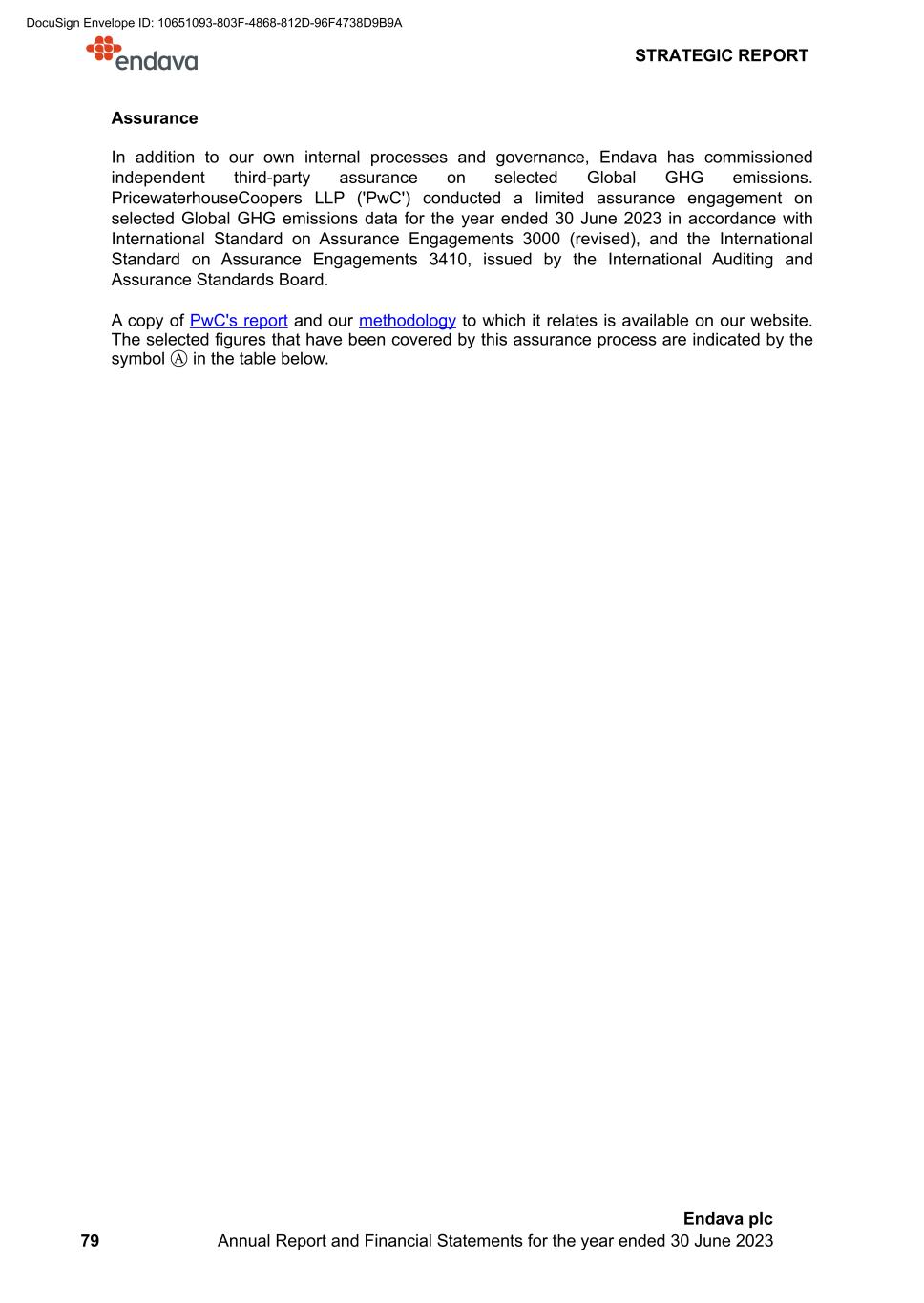
Assurance In addition to our own internal processes and governance, Endava has commissioned independent third-party assurance on selected Global GHG emissions. PricewaterhouseCoopers LLP ('PwC') conducted a limited assurance engagement on selected Global GHG emissions data for the year ended 30 June 2023 in accordance with International Standard on Assurance Engagements 3000 (revised), and the International Standard on Assurance Engagements 3410, issued by the International Auditing and Assurance Standards Board. A copy of PwC's report and our methodology to which it relates is available on our website. The selected figures that have been covered by this assurance process are indicated by the symbol Ⓐ in the table below. STRATEGIC REPORT 79 Endava plc Annual Report and Financial Statements for the year ended 30 June 2023 DocuSign Envelope ID: 10651093-803F-4868-812D-96F4738D9B9A

Table 1: Global GHG emissions (tonnes of CO2 equivalent) Global Operations (tCO2e) FY 2023 FY 2022 Restated1 FY 2022 Total CO2e Emissions (market-based) 32,828 28,316 R 39,315 Total CO2e Emissions (location-based) 32,572 28,101 R 39,102 Emissions from Own Operations (Scope 1 and 2, market-based) 3,226 3,712 R 3,551 Emissions from Own Operations (Scope 1 and 2, location- based) 2,970 3,497 R 3,338 Total Global Scope 1 GHG Emissions tCO2e2,3 779 Ⓐ 942 R 1,019 Heating 689 798 R 947 Fleet 90 144 R 72 Total Global Market based Scope 2 GHG Emissions tCO2e3 2,447 Ⓐ 2,770 R 2,532 Total Global Location based Scope 2 GHG Emissions tCO2e3 2,191 Ⓐ 2,555 R 2,319 Electricity (market-based) 2,113 2,525 2,525 Electricity (location-based) 1,859 2,312 2,312 District Heating 330 241 R — Fleet (market-based) 4 4 R 7 Fleet (location-based) 2 2 R 7 Total Global Scope 3 GHG Emissions tCO2e4 29,602 24,604 R 35,764 Cat. 1. Purchased Goods and Services 11,288 11,844 R 11,577 Cat. 2. Capital Goods 3,911 3,092 R 13,062 Cat. 3. Fuel and Energy Activities not in Scope 1 or 2 1,098 1,303 R 324 Cat. 5. Waste Generated in Operations 269 29 29 Cat. 6. Business Travel 5,519 3,229 R 2,110 Cat. 7. Employee Commuting and Home Office 7,295 5,006 5,006 Cat. 8. Upstream Leased Assets 222 101 R 3,549 Cat. 13. Downstream Leased Assets — — R 107 1. FY 2022 balances have been partially restated due to a change in methodology. The figures that have been restated are indicated in the table above by the letter R. Due to limited reliable data availability, FY 2022 balances for Scope 3 Cat.5. and Scope 3. Cat. 7 have not been restated, therefore any comparisons of FY 2023 and FY 2022 figures for these categories, for Total Global Scope 3 balances, and for Total CO2e Emissions cannot be accurately made. 2. Total Global Scope 1 GHG Emissions reported in the table above excludes fugitive emissions, due to a lack of sufficient primary data. In FY 2023, 20% primary data was collected, which was used to produce an estimated fugitive emissions calculation of 445 tCO2e for the total business if extrapolated across remaining sites. Estimated amounts were calculated based on the average emissions per square meter of sites where primary data was available. The estimated figure indicates that fugitive emissions could be a material component of Global Scope 1 Emissions. However, the estimation technique used for FY 2023 is unlikely to be an accurate proxy for this type of emission, hence the exclusion of this figure from the amounts reported above. Remediation of this exclusion will be a priority matter for FY 2024 reporting. STRATEGIC REPORT 80 Endava plc Annual Report and Financial Statements for the year ended 30 June 2023 DocuSign Envelope ID: 10651093-803F-4868-812D-96F4738D9B9A
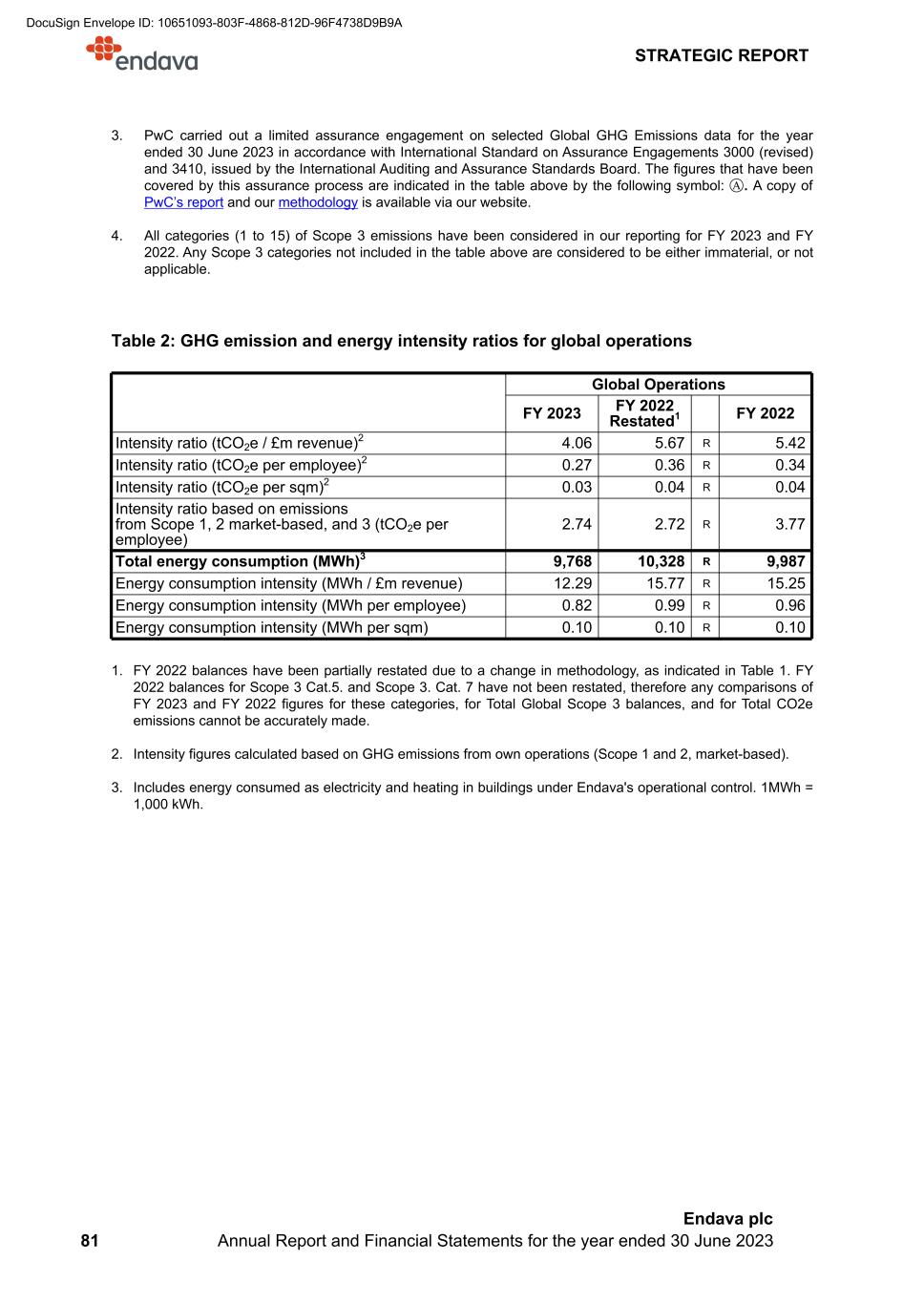
3. PwC carried out a limited assurance engagement on selected Global GHG Emissions data for the year ended 30 June 2023 in accordance with International Standard on Assurance Engagements 3000 (revised) and 3410, issued by the International Auditing and Assurance Standards Board. The figures that have been covered by this assurance process are indicated in the table above by the following symbol: Ⓐ. A copy of PwC’s report and our methodology is available via our website. 4. All categories (1 to 15) of Scope 3 emissions have been considered in our reporting for FY 2023 and FY 2022. Any Scope 3 categories not included in the table above are considered to be either immaterial, or not applicable. Table 2: GHG emission and energy intensity ratios for global operations Global Operations FY 2023 FY 2022 Restated1 FY 2022 Intensity ratio (tCO2e / £m revenue)2 4.06 5.67 R 5.42 Intensity ratio (tCO2e per employee)2 0.27 0.36 R 0.34 Intensity ratio (tCO2e per sqm)2 0.03 0.04 R 0.04 Intensity ratio based on emissions from Scope 1, 2 market-based, and 3 (tCO2e per employee) 2.74 2.72 R 3.77 Total energy consumption (MWh)3 9,768 10,328 R 9,987 Energy consumption intensity (MWh / £m revenue) 12.29 15.77 R 15.25 Energy consumption intensity (MWh per employee) 0.82 0.99 R 0.96 Energy consumption intensity (MWh per sqm) 0.10 0.10 R 0.10 1. FY 2022 balances have been partially restated due to a change in methodology, as indicated in Table 1. FY 2022 balances for Scope 3 Cat.5. and Scope 3. Cat. 7 have not been restated, therefore any comparisons of FY 2023 and FY 2022 figures for these categories, for Total Global Scope 3 balances, and for Total CO2e emissions cannot be accurately made. 2. Intensity figures calculated based on GHG emissions from own operations (Scope 1 and 2, market-based). 3. Includes energy consumed as electricity and heating in buildings under Endava's operational control. 1MWh = 1,000 kWh. STRATEGIC REPORT 81 Endava plc Annual Report and Financial Statements for the year ended 30 June 2023 DocuSign Envelope ID: 10651093-803F-4868-812D-96F4738D9B9A

Table 3: GHG emissions from UK operations (tonnes of CO2 equivalent) UK Only (tCO2e) FY 2023 FY 2022 Restated1 FY 2022 Total CO2e Emissions (market-based) 6,762 5,252 R 4,455 Total CO2e Emissions (location-based) 6,743 5,242 R 4,445 Emissions from Own Operations (Scope 1 and 2, market- based) 63 41 R 44 Emissions from Own Operations (Scope 1 and 2, location- based) 44 31 R 34 Total UK Scope 1 GHG Emissions tCO2e (excluding fugitive emissions)2 21 18 R 21 Heating 21 18 R 21 Fleet — — — Total UK Market based Scope 2 GHG Emissions tCO2e 42 23 23 Total UK Location based Scope 2 GHG Emissions tCO2e 23 13 13 Electricity (market-based) 42 23 23 Electricity (location-based) 23 13 13 District Heating — — — Fleet (market-based) — — — Fleet (location-based) — — — Total UK Scope 3 GHG Emissions tCO2e3 6,699 5,211 R 4,411 Cat. 1. Purchased Goods and Services 3,754 3,760 R 2,795 Cat. 2. Capital Goods 744 151 R 490 Cat. 3. Fuel and Energy Activities not in Scope 1 or 2 17 13 R 1 Cat. 5. Waste Generated in Operations 9 1 1 Cat. 6. Business Travel 1,975 1,136 R 832 Cat. 7. Employee Commuting and Home Office 199 149 149 Cat. 8. Upstream Leased Assets 1 1 R 143 1. FY 2022 balances have been partially restated due to a change in methodology. The figures that have been restated are indicated in the table above by the letter R. Due to limited reliable data availability, FY 2022 balances for Scope 3 Cat.5. and Scope 3. Cat. 7 have not been restated, therefore any comparisons of FY 2023 and FY 2022 figures for these categories, for Total UK Scope 3 balances, and for Total CO2e emissions cannot be accurately made. 2. UK Scope 1 GHG Emissions reported in the table above excludes fugitive emissions, due to a lack of sufficient primary data. See Table 1 and associated footnotes for further information. 3. All categories (1 to 15) of Scope 3 emissions have been considered in our reporting for FY 2023 and FY 2022. Any Scope 3 categories not included in the table above are considered to be either immaterial, or not applicable. STRATEGIC REPORT 82 Endava plc Annual Report and Financial Statements for the year ended 30 June 2023 DocuSign Envelope ID: 10651093-803F-4868-812D-96F4738D9B9A

Table 4: GHG emission and energy intensity ratios for UK operations UK Only FY 2023 FY 2022 Restated1 FY 2022 Intensity ratio (tCO2e per employee)2 0.17 0.12 R 0.13 Intensity ratio (tCO2e per sqm)2 0.04 0.02 R 0.02 Total energy consumption (MWh)3 235 166 166 Energy consumption intensity (MWh per employee) 0.65 0.50 0.50 Energy consumption intensity (MWh per sqm) 0.04 0.09 0.09 1. FY 2022 balances have been partially restated due to a change in methodology, as indicated in Table 3. FY 2022 balances for Scope 3 Cat.5. and Scope 3. Cat. 7 have not been restated, therefore any comparisons of FY 2023 and FY 2022 figures for these categories, for Total UK Scope 3 balances, and for Total CO2e emissions cannot be accurately made. 2. Intensity figures calculated based on GHG emissions from own operations (Scope 1 and 2, market-based). 3. Includes energy consumed as electricity and heating in buildings under Endava's operational control. 1MWh = 1,000 kWh. Analysis Scope 1 and Scope 2 emissions, which make up approximately 10% of our total carbon footprint for the year ended 30 June 2023, are produced through our own operations either directly (through use of heating systems and use of conventional cars that are part of our fleet, based on fossil fuels), or indirectly (through purchased electricity, district heating and electric cars that are part of our fleet). Global Scope 1 emissions (excluding fugitive emissions from refrigerants) have decreased by 17% in the year ended 30 June 2023, from 942 tCO2e to 779 tC02e. Global Scope 2 market- based emissions have decreased by 12% in the year ended 30 June 2023, from 2,770 tCO2e to 2,447 tCO2e, and Global Scope 2 location-based emissions have decreased by 14% in the year ended 30 June 2023, from 2,555 tCO2e to 2,191 tCO2e. In the short term, we plan to minimise these as a priority by reducing our dependence on fossil fuels and increasing the share of renewables in our operations. Direct comparison of Global Scope 3 emissions against the prior year cannot be made, due to the lack of reliable information for certain categories of Scope 3 in the prior year, as explained in Table 1 and the associated footnotes. Our analysis of our Scope 3 emissions shows that like other companies, the main contributor to Endava’s carbon footprint (approximately 90% for the year ended 30 June 2023) is our supply chain. To this end, we have already begun the process of engaging with our suppliers to identify emission reduction opportunities and the partnerships that will be required to support them. Other notable sources are commuting and home office of Endavans, and business travel. We will continue to encourage more mindful and environmentally friendly alternatives for working and travelling. STRATEGIC REPORT 83 Endava plc Annual Report and Financial Statements for the year ended 30 June 2023 DocuSign Envelope ID: 10651093-803F-4868-812D-96F4738D9B9A

Energy efficiency actions taken in the year As a Group, our focus is on achieving net zero emissions from our organisation and value chain. We are focused on improving resource efficiency. In February 2022, we signed a commitment letter to the Science Based Targets initiative (SBTi) - a cornerstone of corporate climate action. By doing this, we have committed to set and validate net-zero targets in line with the SBTi's Net-Zero Standard. Signing the commitment letter was the first step of this process, and we are now working on the next step of developing our targets, for submission to and approval by the SBTi. We continue to focus on the processes that will allow us to achieve our environmental aim and ambitions and we expect to have our targets set in 2024. Once these targets have been set and approved, they will be made public, and we will provide further detailed disclosures on the targets and also on progress made against the targets in our future Annual Reports, Sustainability Reports and on our Group website. In the year ended 30 June 2023, we have continued to deliver on our commitment to integrate environmental considerations into our working environment, our business processes and our communities to assist with our aim of lowering our environmental footprint everywhere we operate. We strive to reduce our environmental footprint and to continuously improve on how efficiently we consume the resources we procure. To reduce our footprint, we work to improve the accounting and monitoring of our consumption of natural resources, while also striving to minimise consumption and pollution in their various forms: decrease the intake of energy sourced from fossil fuels and of non-recyclable, polluting materials, as well as the output of pollution: GHG emissions, waste, and energy/heat loss. We already have a range of measures in place to preserve and protect natural resources and promote sustainability within our workplaces including: • environmental sustainability checklists for new and existing office buildings; • energy-efficient, sensor operating lighting; • separate collection of recyclables, including the waste from electric and electronic equipment; • prioritising green-certified (LEED/BREEAM) buildings when selecting the buildings for new Endava offices; and • increasing the share of renewable energy used in our operations. We have continued to roll out our Environmental Management System. In the year ended 30 June 2023 the ISO 14001 certification of our Romanian delivery centres was renewed. Additionally, our delivery centres in Moldova received their first ISO 14001:2015 certification. In the year ended 30 June 2023 we had 11 locations with ISO 14001 certification compared to 7 in the year ended 30 June 2022. In the year ended 30 June 2023 52% of Endavans worked in an ISO 14001 certified location compared to 41% in the year ended 30 June 2022. We understand the significant impact our supply chain plays in our carbon and environmental footprint. We are in the process of mapping out where our suppliers stand in their own environmental journey by looking at their Carbon Disclosure Project (CDP) disclosures and their SBTi commitments. We are prioritising strategic suppliers with whom we expect to spend in excess of £100,000 annually and those with a significant impact on our operations such as strategic partnerships. STRATEGIC REPORT 84 Endava plc Annual Report and Financial Statements for the year ended 30 June 2023 DocuSign Envelope ID: 10651093-803F-4868-812D-96F4738D9B9A

We focus on helping our teams incorporate more responsible habits. To support Endavans on our environmental journey, we have established a Go Green Community to allow our people to engage in conversations and joint actions on environmental topics. The Go Green Community also allows Endavans to contribute new ideas and initiatives to improve our environmental performance locally, regionally or globally, or to flag any issues they come across. We continue to provide educational resources through training sessions and programmes including Endava Eco Challenge, Endava Reads, Endava University and Masterclasses. In the year ended 30 June 2023, we focused on training and awareness sessions for Endavans on topics such as recycling and climate action. We organised targeted training for all office and facilities managers as well as real estate and finance managers on standards, requirements and processes regarding GHG accounting and environmental reporting. As we focus on achieving net zero emissions from our organisation and value chain, during the year ended 30 June 2023 several local initiatives were implemented across different locations, some examples of which include: • In Iasi, Romania, Endava is offering free electric vehicle charging to all Endavans as a means of promoting clean energy to power their commute. • In Buenos Aires, we donated peripherals we no longer used to Fundación Equidad. This foundation has a reconditioning centre for unused computers and peripherals. They donate to schools and charitable organisations working computer equipment, and those that can no longer be donated are recycled. In addition, in our second year as a member of Sustainable Romania Coalition, we joined forces with other companies to initiate a Working Group on Decarbonisation. As the founding member of this working group, we are working with the other members to create a resource hub for all coalition members to help all members with the Net Zero journey. As we continue to expand our footprint in Malaysia, in February 2023 we signed the Malaysia Digital Climate Action Plan – MDCAP, an initiative to accelerate the number of commitments made by businesses across the digital economy to reduce the impact of climate change. NON-FINANCIAL AND SUSTAINABILITY INFORMATION STATEMENT The following section includes our Climate-related Financial Disclosures, in accordance with the requirements of The Companies (Strategic Report) (Climate-related Financial Disclosure) Regulations 2022. This is the first year that we are including Climate-related Financial Disclosures. We are committed to producing transparent disclosures, and we note that there will be a phased approach to our disclosures over time, which will evolve as we enhance our management of climate-related risks and as advancements are made in the maturity of our climate-related financial disclosures. STRATEGIC REPORT 85 Endava plc Annual Report and Financial Statements for the year ended 30 June 2023 DocuSign Envelope ID: 10651093-803F-4868-812D-96F4738D9B9A
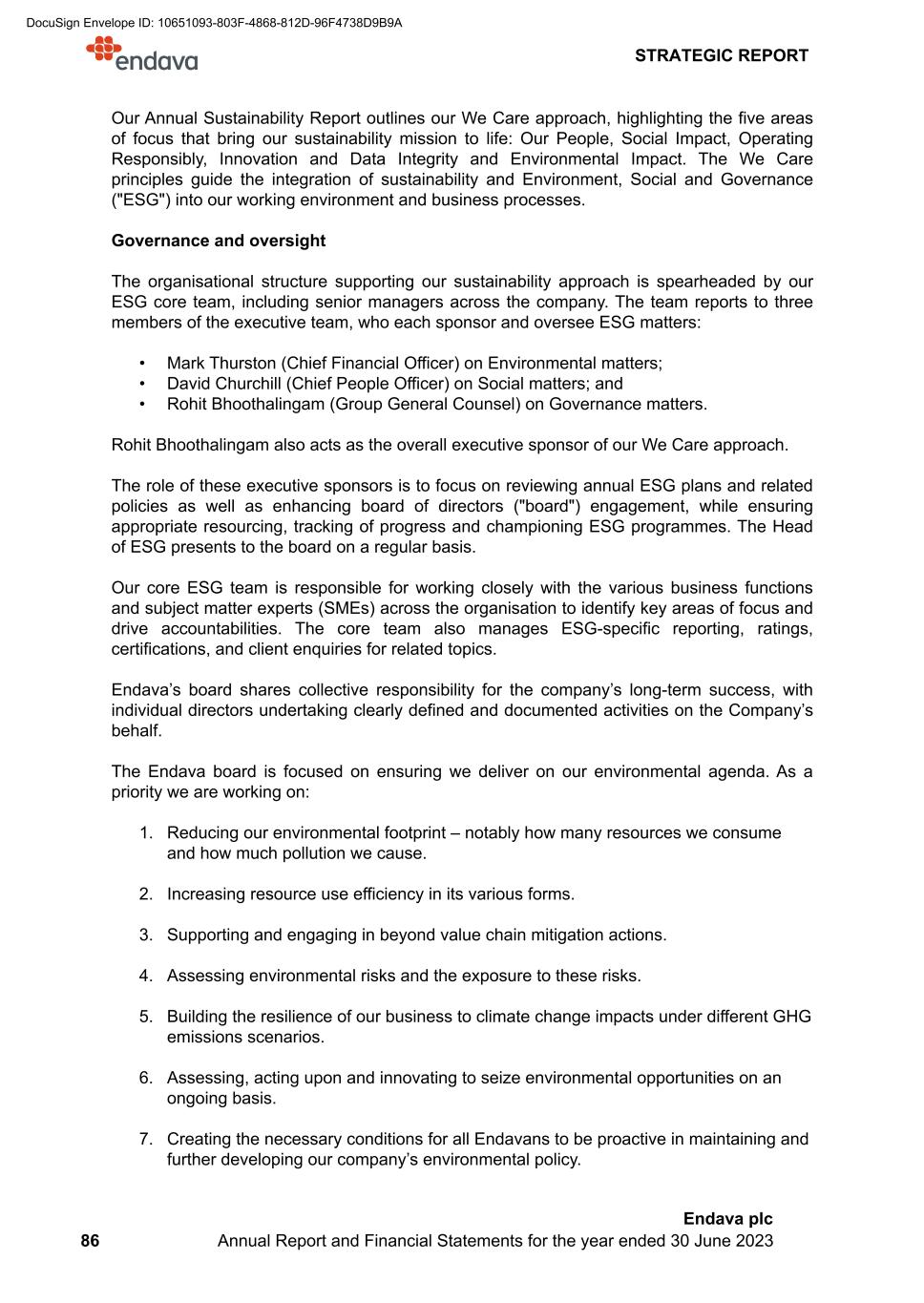
Our Annual Sustainability Report outlines our We Care approach, highlighting the five areas of focus that bring our sustainability mission to life: Our People, Social Impact, Operating Responsibly, Innovation and Data Integrity and Environmental Impact. The We Care principles guide the integration of sustainability and Environment, Social and Governance ("ESG") into our working environment and business processes. Governance and oversight The organisational structure supporting our sustainability approach is spearheaded by our ESG core team, including senior managers across the company. The team reports to three members of the executive team, who each sponsor and oversee ESG matters: • Mark Thurston (Chief Financial Officer) on Environmental matters; • David Churchill (Chief People Officer) on Social matters; and • Rohit Bhoothalingam (Group General Counsel) on Governance matters. Rohit Bhoothalingam also acts as the overall executive sponsor of our We Care approach. The role of these executive sponsors is to focus on reviewing annual ESG plans and related policies as well as enhancing board of directors ("board") engagement, while ensuring appropriate resourcing, tracking of progress and championing ESG programmes. The Head of ESG presents to the board on a regular basis. Our core ESG team is responsible for working closely with the various business functions and subject matter experts (SMEs) across the organisation to identify key areas of focus and drive accountabilities. The core team also manages ESG-specific reporting, ratings, certifications, and client enquiries for related topics. Endava’s board shares collective responsibility for the company’s long-term success, with individual directors undertaking clearly defined and documented activities on the Company’s behalf. The Endava board is focused on ensuring we deliver on our environmental agenda. As a priority we are working on: 1. Reducing our environmental footprint – notably how many resources we consume and how much pollution we cause. 2. Increasing resource use efficiency in its various forms. 3. Supporting and engaging in beyond value chain mitigation actions. 4. Assessing environmental risks and the exposure to these risks. 5. Building the resilience of our business to climate change impacts under different GHG emissions scenarios. 6. Assessing, acting upon and innovating to seize environmental opportunities on an ongoing basis. 7. Creating the necessary conditions for all Endavans to be proactive in maintaining and further developing our company’s environmental policy. STRATEGIC REPORT 86 Endava plc Annual Report and Financial Statements for the year ended 30 June 2023 DocuSign Envelope ID: 10651093-803F-4868-812D-96F4738D9B9A
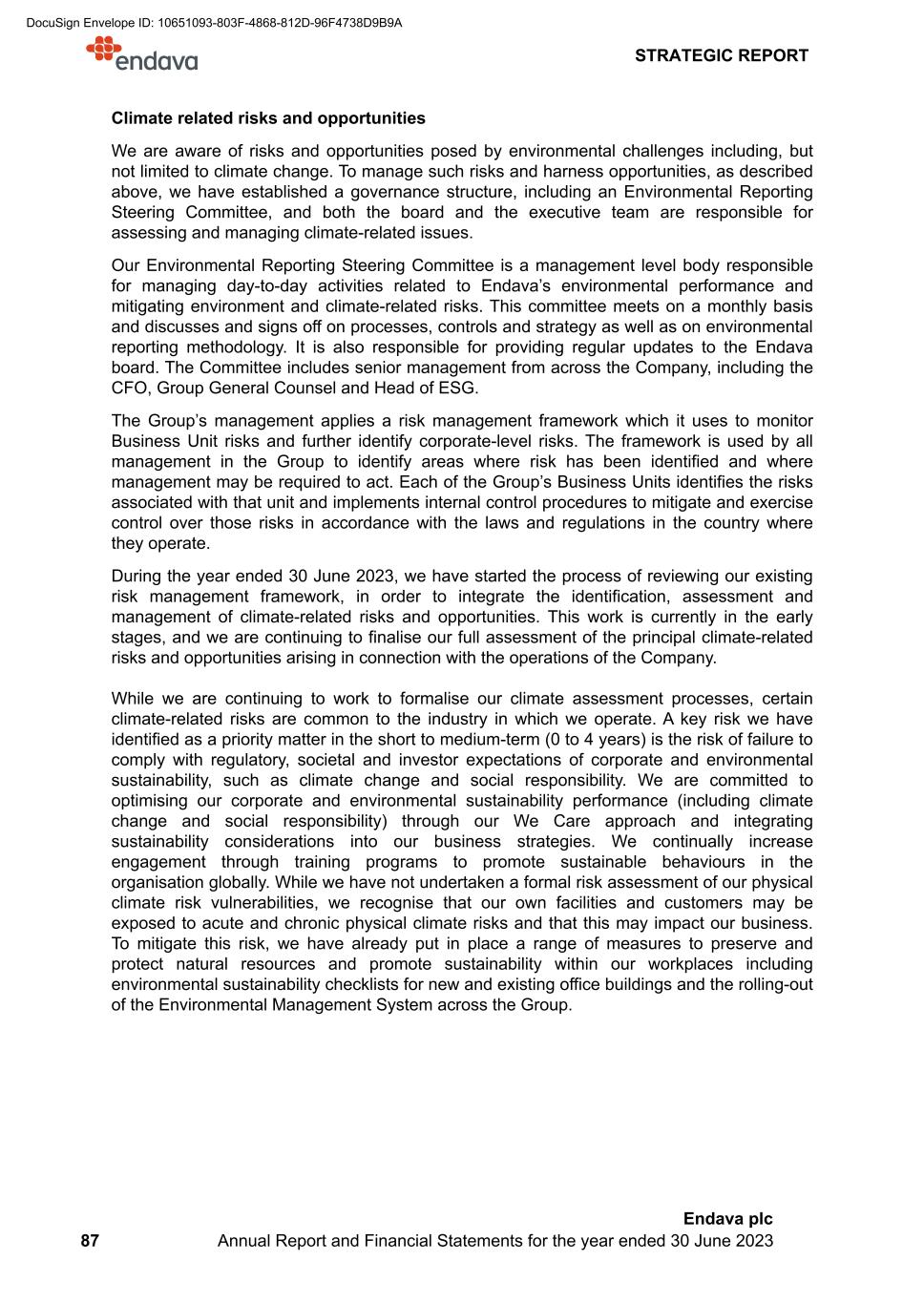
Climate related risks and opportunities We are aware of risks and opportunities posed by environmental challenges including, but not limited to climate change. To manage such risks and harness opportunities, as described above, we have established a governance structure, including an Environmental Reporting Steering Committee, and both the board and the executive team are responsible for assessing and managing climate-related issues. Our Environmental Reporting Steering Committee is a management level body responsible for managing day-to-day activities related to Endava’s environmental performance and mitigating environment and climate-related risks. This committee meets on a monthly basis and discusses and signs off on processes, controls and strategy as well as on environmental reporting methodology. It is also responsible for providing regular updates to the Endava board. The Committee includes senior management from across the Company, including the CFO, Group General Counsel and Head of ESG. The Group’s management applies a risk management framework which it uses to monitor Business Unit risks and further identify corporate-level risks. The framework is used by all management in the Group to identify areas where risk has been identified and where management may be required to act. Each of the Group’s Business Units identifies the risks associated with that unit and implements internal control procedures to mitigate and exercise control over those risks in accordance with the laws and regulations in the country where they operate. During the year ended 30 June 2023, we have started the process of reviewing our existing risk management framework, in order to integrate the identification, assessment and management of climate-related risks and opportunities. This work is currently in the early stages, and we are continuing to finalise our full assessment of the principal climate-related risks and opportunities arising in connection with the operations of the Company. While we are continuing to work to formalise our climate assessment processes, certain climate-related risks are common to the industry in which we operate. A key risk we have identified as a priority matter in the short to medium-term (0 to 4 years) is the risk of failure to comply with regulatory, societal and investor expectations of corporate and environmental sustainability, such as climate change and social responsibility. We are committed to optimising our corporate and environmental sustainability performance (including climate change and social responsibility) through our We Care approach and integrating sustainability considerations into our business strategies. We continually increase engagement through training programs to promote sustainable behaviours in the organisation globally. While we have not undertaken a formal risk assessment of our physical climate risk vulnerabilities, we recognise that our own facilities and customers may be exposed to acute and chronic physical climate risks and that this may impact our business. To mitigate this risk, we have already put in place a range of measures to preserve and protect natural resources and promote sustainability within our workplaces including environmental sustainability checklists for new and existing office buildings and the rolling-out of the Environmental Management System across the Group. STRATEGIC REPORT 87 Endava plc Annual Report and Financial Statements for the year ended 30 June 2023 DocuSign Envelope ID: 10651093-803F-4868-812D-96F4738D9B9A
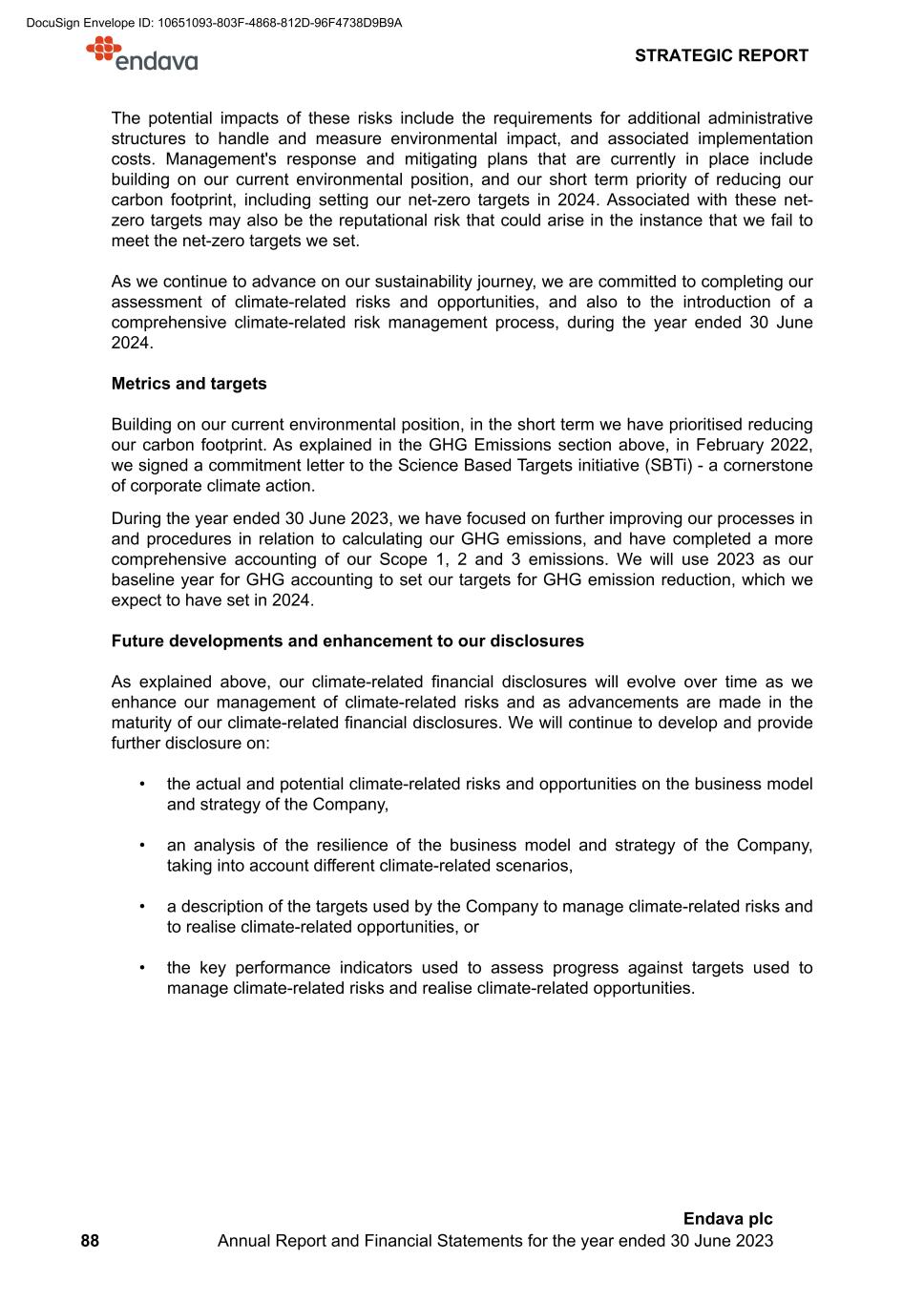
The potential impacts of these risks include the requirements for additional administrative structures to handle and measure environmental impact, and associated implementation costs. Management's response and mitigating plans that are currently in place include building on our current environmental position, and our short term priority of reducing our carbon footprint, including setting our net-zero targets in 2024. Associated with these net- zero targets may also be the reputational risk that could arise in the instance that we fail to meet the net-zero targets we set. As we continue to advance on our sustainability journey, we are committed to completing our assessment of climate-related risks and opportunities, and also to the introduction of a comprehensive climate-related risk management process, during the year ended 30 June 2024. Metrics and targets Building on our current environmental position, in the short term we have prioritised reducing our carbon footprint. As explained in the GHG Emissions section above, in February 2022, we signed a commitment letter to the Science Based Targets initiative (SBTi) - a cornerstone of corporate climate action. During the year ended 30 June 2023, we have focused on further improving our processes in and procedures in relation to calculating our GHG emissions, and have completed a more comprehensive accounting of our Scope 1, 2 and 3 emissions. We will use 2023 as our baseline year for GHG accounting to set our targets for GHG emission reduction, which we expect to have set in 2024. Future developments and enhancement to our disclosures As explained above, our climate-related financial disclosures will evolve over time as we enhance our management of climate-related risks and as advancements are made in the maturity of our climate-related financial disclosures. We will continue to develop and provide further disclosure on: • the actual and potential climate-related risks and opportunities on the business model and strategy of the Company, • an analysis of the resilience of the business model and strategy of the Company, taking into account different climate-related scenarios, • a description of the targets used by the Company to manage climate-related risks and to realise climate-related opportunities, or • the key performance indicators used to assess progress against targets used to manage climate-related risks and realise climate-related opportunities. STRATEGIC REPORT 88 Endava plc Annual Report and Financial Statements for the year ended 30 June 2023 DocuSign Envelope ID: 10651093-803F-4868-812D-96F4738D9B9A
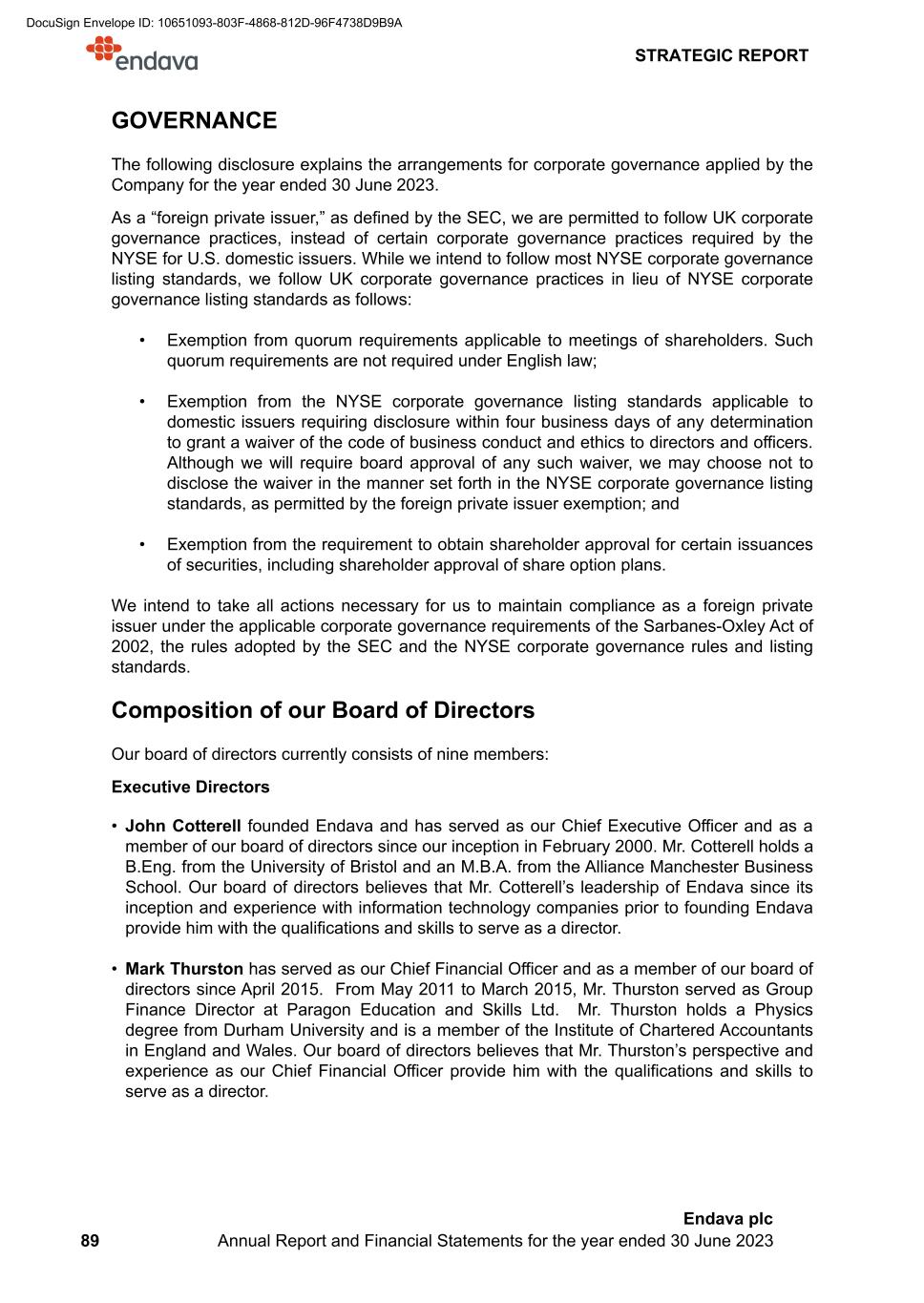
GOVERNANCE The following disclosure explains the arrangements for corporate governance applied by the Company for the year ended 30 June 2023. As a “foreign private issuer,” as defined by the SEC, we are permitted to follow UK corporate governance practices, instead of certain corporate governance practices required by the NYSE for U.S. domestic issuers. While we intend to follow most NYSE corporate governance listing standards, we follow UK corporate governance practices in lieu of NYSE corporate governance listing standards as follows: • Exemption from quorum requirements applicable to meetings of shareholders. Such quorum requirements are not required under English law; • Exemption from the NYSE corporate governance listing standards applicable to domestic issuers requiring disclosure within four business days of any determination to grant a waiver of the code of business conduct and ethics to directors and officers. Although we will require board approval of any such waiver, we may choose not to disclose the waiver in the manner set forth in the NYSE corporate governance listing standards, as permitted by the foreign private issuer exemption; and • Exemption from the requirement to obtain shareholder approval for certain issuances of securities, including shareholder approval of share option plans. We intend to take all actions necessary for us to maintain compliance as a foreign private issuer under the applicable corporate governance requirements of the Sarbanes-Oxley Act of 2002, the rules adopted by the SEC and the NYSE corporate governance rules and listing standards. Composition of our Board of Directors Our board of directors currently consists of nine members: Executive Directors • John Cotterell founded Endava and has served as our Chief Executive Officer and as a member of our board of directors since our inception in February 2000. Mr. Cotterell holds a B.Eng. from the University of Bristol and an M.B.A. from the Alliance Manchester Business School. Our board of directors believes that Mr. Cotterell’s leadership of Endava since its inception and experience with information technology companies prior to founding Endava provide him with the qualifications and skills to serve as a director. • Mark Thurston has served as our Chief Financial Officer and as a member of our board of directors since April 2015. From May 2011 to March 2015, Mr. Thurston served as Group Finance Director at Paragon Education and Skills Ltd. Mr. Thurston holds a Physics degree from Durham University and is a member of the Institute of Chartered Accountants in England and Wales. Our board of directors believes that Mr. Thurston’s perspective and experience as our Chief Financial Officer provide him with the qualifications and skills to serve as a director. STRATEGIC REPORT 89 Endava plc Annual Report and Financial Statements for the year ended 30 June 2023 DocuSign Envelope ID: 10651093-803F-4868-812D-96F4738D9B9A

Non-Executive Directors • Trevor Smith has served as a member of our board of directors since June 2013 and as our chairman since July 2016. Prior to his retirement, Mr. Smith held various roles at Goldman, Sachs & Co., an investment bank, including Chief Information Officer for the EMEA Region from January 2000 to September 2009 and in a part-time Business Resiliency & Crisis Management and Special Project role from March 2010 until June 2013. Mr. Smith holds a B.Sc. in Economics from UCW Aberystwyth. Our board of directors believes that Mr. Smith’s experience in information technology and delivery of large projects provide him with the qualifications and skills to serve as a director. • Andrew Allan has served as a member of our board of directors since April 2006, having previously served as a member of the board of Brains Direct Ltd, which we acquired in April 2006. Mr Allan will retire from the board of directors at the end of his current term, and will, therefore, not be seeking re-election at our 2023 Annual General Meeting. Mr. Allan currently serves as Managing Partner at Fairways Corporate Finance, a position he has held since May 2003. He is a qualified Chartered Accountant and a current member of the Institute of Chartered Accountants of Scotland. Mr. Allan holds a B.S. in Finance from the University of Strathclyde. • Patrick Butcher has served as a member of our board of directors since May 2023. Mr. Butcher most recently served as Group Chief Financial Officer of the Headlam Group plc from April 2022 until March 2023. From January 2019 to November 2020, he served as Group Chief Financial Officer at Capita plc. Prior to that, Mr. Butcher served as Chief Financial Officer at various companies including The Go-Ahead Group plc, Network Rail Limited, English, Welsh and Scottish Railway and Mapeley Limited. Mr. Butcher received his B. Compt. (Hons) in Accounting and Finance from the University of South Africa and is a qualified Chartered Accountant (South Africa). Our board of directors believes that Mr. Butcher’s financial expertise and his significant leadership experience provide him with the qualifications and skills to serve as a director. • Sulina Connal has served as a member of our board of directors since September 2019. Since April 2020, she has been working on partnerships at Google and is currently Managing Director of News and Books Partnerships for EMEA. Previously, Ms. Connal served as the Director of Mobile and Connectivity Partnerships at Facebook from October 2017 to April 2020. Prior to that, from April 2014 until September 2017, she served as the Senior Vice President of Strategic Partnerships at Orange. Ms. Connal holds an M.A. from the University of Oxford. Our board of directors believes that Ms. Connal's business experience provides her with the qualifications and skills to serve as a director. • Ben Druskin has served as a member of our board of directors since September 2017. Mr. Druskin retired from Citigroup in August 2017. From 2014 until his retirement, Mr. Druskin served as the Chairman of the Global Technology, Media and Telecom Investment Banking Group. Prior to becoming Chairman, Mr. Druskin was co-head of the Global Technology, Media and Telecom Investment Banking Group. Mr. Druskin has served as a member of the board of directors of Zensar Technologies since November 2017, and served as a member of the board of directors of Global Synergy Acquisition Corp. between October 2020 and August 2022. Mr. Druskin holds a B.A. in Economics from Rutgers College and an M.B.A. in Finance from The Stern School of Business at New York University. Our board of directors believes that Mr. Druskin’s expertise in capital raising and merger and acquisition transactions provide him with the qualifications and skills to serve as a director. STRATEGIC REPORT 90 Endava plc Annual Report and Financial Statements for the year ended 30 June 2023 DocuSign Envelope ID: 10651093-803F-4868-812D-96F4738D9B9A
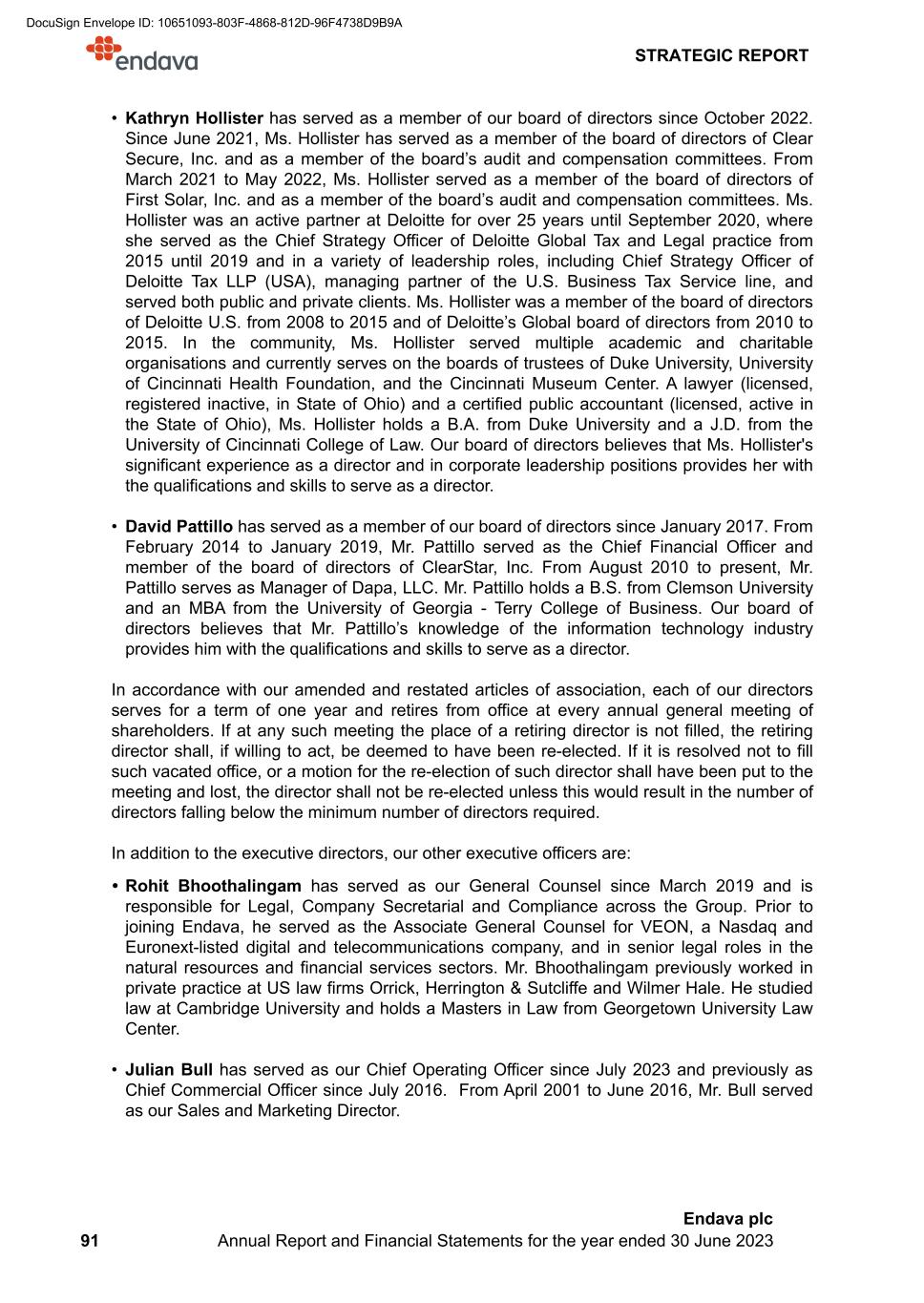
• Kathryn Hollister has served as a member of our board of directors since October 2022. Since June 2021, Ms. Hollister has served as a member of the board of directors of Clear Secure, Inc. and as a member of the board’s audit and compensation committees. From March 2021 to May 2022, Ms. Hollister served as a member of the board of directors of First Solar, Inc. and as a member of the board’s audit and compensation committees. Ms. Hollister was an active partner at Deloitte for over 25 years until September 2020, where she served as the Chief Strategy Officer of Deloitte Global Tax and Legal practice from 2015 until 2019 and in a variety of leadership roles, including Chief Strategy Officer of Deloitte Tax LLP (USA), managing partner of the U.S. Business Tax Service line, and served both public and private clients. Ms. Hollister was a member of the board of directors of Deloitte U.S. from 2008 to 2015 and of Deloitte’s Global board of directors from 2010 to 2015. In the community, Ms. Hollister served multiple academic and charitable organisations and currently serves on the boards of trustees of Duke University, University of Cincinnati Health Foundation, and the Cincinnati Museum Center. A lawyer (licensed, registered inactive, in State of Ohio) and a certified public accountant (licensed, active in the State of Ohio), Ms. Hollister holds a B.A. from Duke University and a J.D. from the University of Cincinnati College of Law. Our board of directors believes that Ms. Hollister's significant experience as a director and in corporate leadership positions provides her with the qualifications and skills to serve as a director. • David Pattillo has served as a member of our board of directors since January 2017. From February 2014 to January 2019, Mr. Pattillo served as the Chief Financial Officer and member of the board of directors of ClearStar, Inc. From August 2010 to present, Mr. Pattillo serves as Manager of Dapa, LLC. Mr. Pattillo holds a B.S. from Clemson University and an MBA from the University of Georgia - Terry College of Business. Our board of directors believes that Mr. Pattillo’s knowledge of the information technology industry provides him with the qualifications and skills to serve as a director. In accordance with our amended and restated articles of association, each of our directors serves for a term of one year and retires from office at every annual general meeting of shareholders. If at any such meeting the place of a retiring director is not filled, the retiring director shall, if willing to act, be deemed to have been re-elected. If it is resolved not to fill such vacated office, or a motion for the re-election of such director shall have been put to the meeting and lost, the director shall not be re-elected unless this would result in the number of directors falling below the minimum number of directors required. In addition to the executive directors, our other executive officers are: • Rohit Bhoothalingam has served as our General Counsel since March 2019 and is responsible for Legal, Company Secretarial and Compliance across the Group. Prior to joining Endava, he served as the Associate General Counsel for VEON, a Nasdaq and Euronext-listed digital and telecommunications company, and in senior legal roles in the natural resources and financial services sectors. Mr. Bhoothalingam previously worked in private practice at US law firms Orrick, Herrington & Sutcliffe and Wilmer Hale. He studied law at Cambridge University and holds a Masters in Law from Georgetown University Law Center. • Julian Bull has served as our Chief Operating Officer since July 2023 and previously as Chief Commercial Officer since July 2016. From April 2001 to June 2016, Mr. Bull served as our Sales and Marketing Director. STRATEGIC REPORT 91 Endava plc Annual Report and Financial Statements for the year ended 30 June 2023 DocuSign Envelope ID: 10651093-803F-4868-812D-96F4738D9B9A
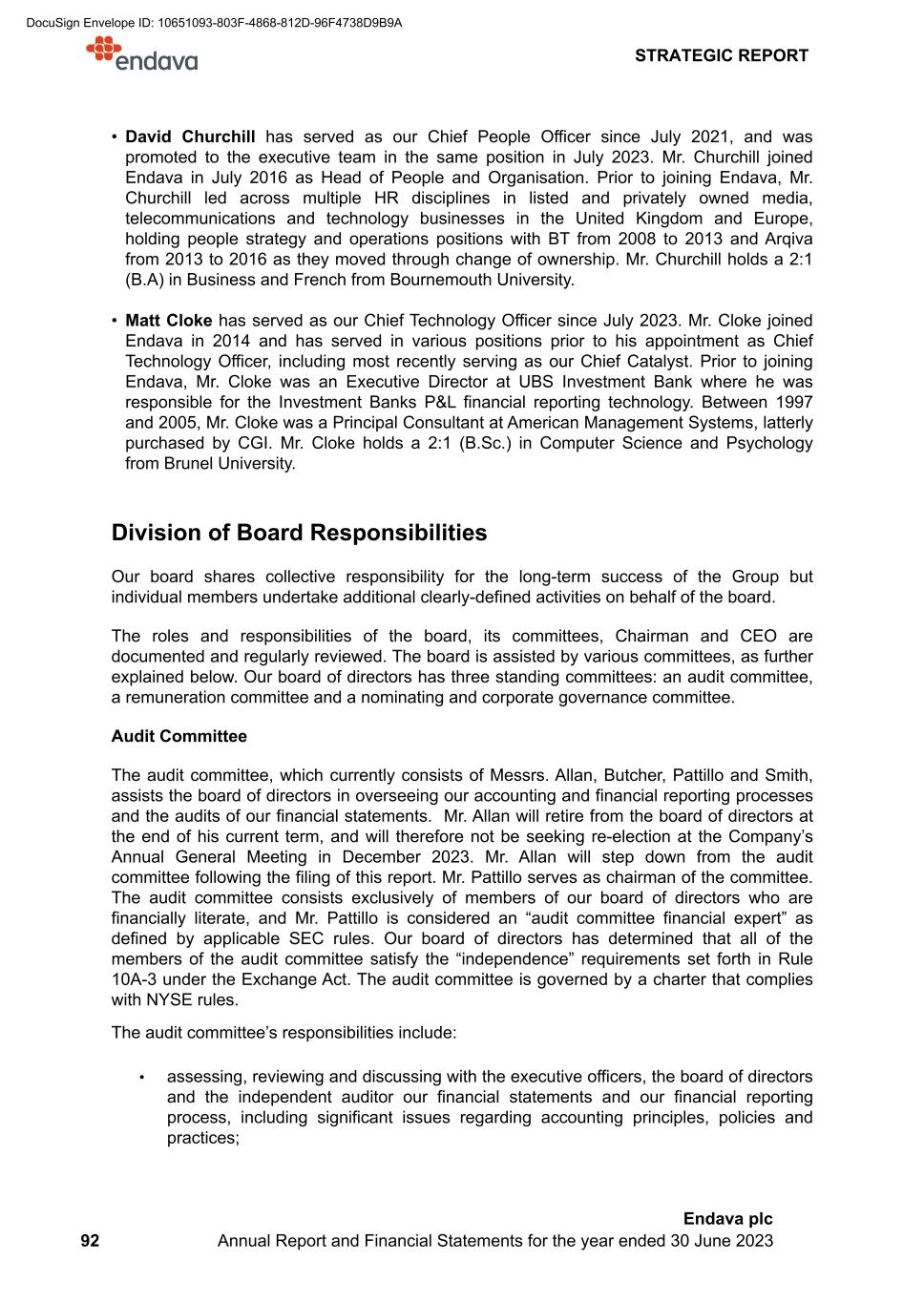
• David Churchill has served as our Chief People Officer since July 2021, and was promoted to the executive team in the same position in July 2023. Mr. Churchill joined Endava in July 2016 as Head of People and Organisation. Prior to joining Endava, Mr. Churchill led across multiple HR disciplines in listed and privately owned media, telecommunications and technology businesses in the United Kingdom and Europe, holding people strategy and operations positions with BT from 2008 to 2013 and Arqiva from 2013 to 2016 as they moved through change of ownership. Mr. Churchill holds a 2:1 (B.A) in Business and French from Bournemouth University. • Matt Cloke has served as our Chief Technology Officer since July 2023. Mr. Cloke joined Endava in 2014 and has served in various positions prior to his appointment as Chief Technology Officer, including most recently serving as our Chief Catalyst. Prior to joining Endava, Mr. Cloke was an Executive Director at UBS Investment Bank where he was responsible for the Investment Banks P&L financial reporting technology. Between 1997 and 2005, Mr. Cloke was a Principal Consultant at American Management Systems, latterly purchased by CGI. Mr. Cloke holds a 2:1 (B.Sc.) in Computer Science and Psychology from Brunel University. Division of Board Responsibilities Our board shares collective responsibility for the long-term success of the Group but individual members undertake additional clearly-defined activities on behalf of the board. The roles and responsibilities of the board, its committees, Chairman and CEO are documented and regularly reviewed. The board is assisted by various committees, as further explained below. Our board of directors has three standing committees: an audit committee, a remuneration committee and a nominating and corporate governance committee. Audit Committee The audit committee, which currently consists of Messrs. Allan, Butcher, Pattillo and Smith, assists the board of directors in overseeing our accounting and financial reporting processes and the audits of our financial statements. Mr. Allan will retire from the board of directors at the end of his current term, and will therefore not be seeking re-election at the Company’s Annual General Meeting in December 2023. Mr. Allan will step down from the audit committee following the filing of this report. Mr. Pattillo serves as chairman of the committee. The audit committee consists exclusively of members of our board of directors who are financially literate, and Mr. Pattillo is considered an “audit committee financial expert” as defined by applicable SEC rules. Our board of directors has determined that all of the members of the audit committee satisfy the “independence” requirements set forth in Rule 10A-3 under the Exchange Act. The audit committee is governed by a charter that complies with NYSE rules. The audit committee’s responsibilities include: • assessing, reviewing and discussing with the executive officers, the board of directors and the independent auditor our financial statements and our financial reporting process, including significant issues regarding accounting principles, policies and practices; STRATEGIC REPORT 92 Endava plc Annual Report and Financial Statements for the year ended 30 June 2023 DocuSign Envelope ID: 10651093-803F-4868-812D-96F4738D9B9A

• monitoring and reviewing with executive officers and the independent auditor the adequacy and effectiveness of internal control over financial reporting and disclosure controls and procedures; • evaluating and making recommendations to the board of directors regarding the appointment, compensation, retention and oversight of any accounting firm engaged for the purpose of preparing or issuing an audit report or performing other audit services; • approving the audit services and non-audit services to be provided by our independent auditor; • evaluating the independent auditor’s qualifications, performance and independence, and presenting its conclusions to the full board of directors on at least an annual basis; and • approving or ratifying any related person transaction (as defined by applicable rules and regulations) in accordance with our applicable policies as well as review management’s efforts to monitor compliance with company programs and policies adhering to applicable rules and regulations. The audit committee meets as often as one or more members of the audit committee deem necessary, but in any event meets at least four times per year. The audit committee meets at least once per year with our independent auditor, without senior management being present. Remuneration Committee The remuneration committee, which currently consists of Messrs. Allan, Druskin and Smith and Ms. Hollister, assists the board of directors in determining executive officer compensation. Mr. Allan serves as chairman of the committee. Mr. Allan will retire from the board of directors at the end of his current term, and will therefore not be seeking re-election at the Company's Annual General Meeting in December 2023. Mr. Allan will step down as chairman of the remuneration committee following the filing of this report, following which Ms. Hollister will chair the remuneration committee. Mr. Allan will remain a member of the remuneration committee until the end of his current term. Under SEC and NYSE rules, there are heightened independence standards for members of the remuneration committee, including a prohibition against the receipt of any compensation from us other than standard board member fees. Although foreign private issuers are not required to meet this heightened standard with respect to all members, we have determined that all members meet this heightened standard. The remuneration committee’s responsibilities include: • approving, modifying and overseeing our overall compensation strategy and policies; • reviewing and recommending to the board of directors for approval the type and amount of compensation to be paid or awarded to the members of our board of directors; • sole responsibility for the appointment, selection, retention, termination and oversight of any compensation consultants and other advisors retained by the remuneration committee; • reviewing, evaluating and approving all compensatory agreements and arrangements, elements of compensation, and performance goals and objectives related to compensation of our executive officers, including our Chief Executive Officer; STRATEGIC REPORT 93 Endava plc Annual Report and Financial Statements for the year ended 30 June 2023 DocuSign Envelope ID: 10651093-803F-4868-812D-96F4738D9B9A

• reviewing and approving the goals and objectives of our executive officers, including our Chief Executive Officer, and evaluating their performance in light of relevant performance goals and objectives; • having the full power and authority of our board of directors to adopt, amend, terminate and administer our equity awards, pension, and profit sharing plans, bonus plans, benefit plans and similar programs; and • reviewing and assessing risks arising from our compensation policies and practices. Nominating and Corporate Governance Committee The nominating and corporate governance committee, which currently consists of Messrs. Druskin and Smith and Mses. Connal and Hollister, assists our board of directors in identifying individuals qualified to become members of our board of directors consistent with criteria established by our board of directors and in developing our corporate governance principles. Mr. Smith serves as chairman of the nominating and corporate governance committee. The nominating and corporate governance committee’s responsibilities include: • identifying and evaluating candidates to serve on our board of directors, including nomination of incumbent directors for re-election; • reviewing and evaluating the size and composition of our board of directors; • recommending nominees for election to our board of directors and its corresponding committees; • overseeing the evaluation and periodically reviewing the performance of the board of directors and management, including committees of the board of directors, and reporting the results of such assessment to the board of directors; • assisting the board of directors in overseeing our corporate governance functions, including developing, updating and recommending to the board of directors corporate governance principles; and • periodically reviewing with our Chief Executive Officer the succession plans for our executive officers and making recommendations to our board of directors with respect to the selection of appropriate individuals to succeed to these positions. Board Diversity In September 2022, we implemented a new Board Diversity Policy, which sits alongside our Code of Conduct and our global Diversity, Inclusion and Belonging Policy. The purpose of the policy is to ensure an inclusive and diverse membership of the board of directors resulting in optimal decision-making and assisting in the development and execution of a strategy which promotes the success of Endava for the benefit of its shareholders as a whole, having regard to the interests of other stakeholders. Our board believes strongly in the value of an independent and diverse board of directors to provide effective oversight and that its membership should be composed of highly qualified directors who demonstrate a diversity of perspectives and backgrounds, with the integrity and suitability for overseeing our company and its global footprint. STRATEGIC REPORT 94 Endava plc Annual Report and Financial Statements for the year ended 30 June 2023 DocuSign Envelope ID: 10651093-803F-4868-812D-96F4738D9B9A
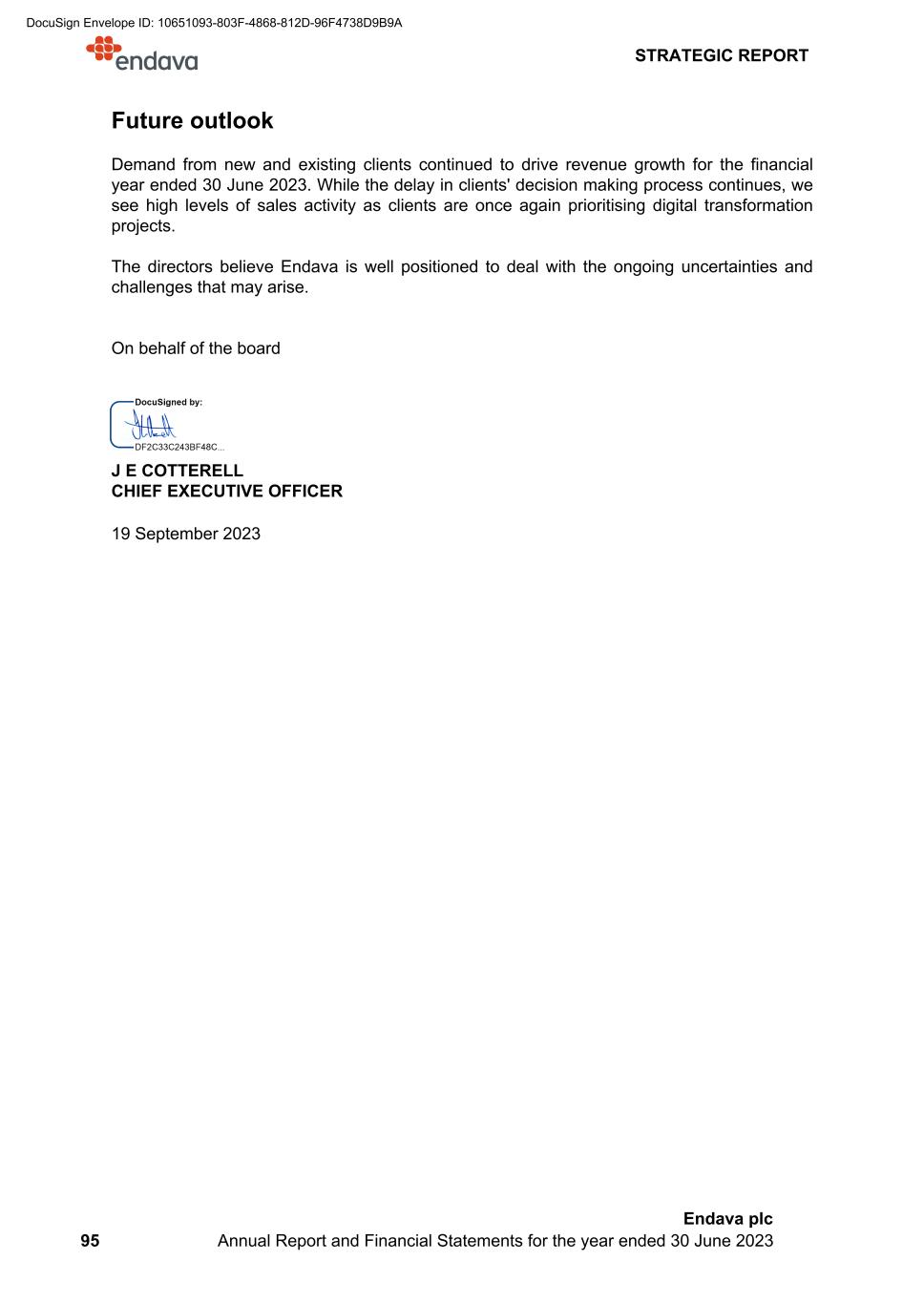
Future outlook Demand from new and existing clients continued to drive revenue growth for the financial year ended 30 June 2023. While the delay in clients' decision making process continues, we see high levels of sales activity as clients are once again prioritising digital transformation projects. The directors believe Endava is well positioned to deal with the ongoing uncertainties and challenges that may arise. On behalf of the board J E COTTERELL CHIEF EXECUTIVE OFFICER 19 September 2023 STRATEGIC REPORT 95 Endava plc Annual Report and Financial Statements for the year ended 30 June 2023 DocuSign Envelope ID: 10651093-803F-4868-812D-96F4738D9B9A

DIRECTORS’ REMUNERATION REPORT Dear Shareholder, On behalf of the Endava Remuneration Committee (the “Committee” or “we"), I am pleased to present our Directors’ Remuneration Report for the financial year ended 30 June 2023 (the “2023 financial year” or “FY2023”). In this letter I will address key areas of Committee focus in FY2023. Remuneration in context In determining executive directors’ remuneration outcomes, the Committee continues to focus on the alignment of pay to individual and company performance, and to building long- term value for our stakeholders. Our Directors' Remuneration Policy ("Remuneration Policy"), which received 91% support at our last Annual General Meeting ("AGM") and cascades across Endava, is designed to support our strategic priorities. People are our most important asset. It is critical that our remuneration arrangements attract, retain and motivate them to deliver strong performance and create value. We achieve this by positioning our total remuneration to emphasise performance, weighting it more heavily than our peers. Our philosophical approach to pay, reflected in our Remuneration Policy, is to provide market competitive total opportunities that intentionally position base salaries modestly compared to peers of comparable size and complexity, and emphasise variable, at-risk pay. While this is atypical and can raise questions about incentive multiples, we believe it effectively maximises alignment with our long-term performance and the interests of our shareholders, incentivises sustainable growth, and carefully manages cash expense. It also means that a substantial majority of the potential value will only be realised if performance targets are met. Company performance was strong in FY2023 Endava delivered strong results in 2023 despite the challenges impacting both us and our clients. These included inflation and stagflation economies, currency volatility, global banking scares, depressed capital markets, the war in Ukraine and the lagging effects of COVID-19. Our financial results demonstrate strong growth relative to our peers across multiple key performance indicators. • Revenue grew 21% from £654.8m to £794.7m, contributing to three-year compound revenue growth of 33%. • Adjusted profit before taxes ("PBT") grew 19% from £138.3m to £164.2m. • Adjusted diluted earnings per share ("EPS") grew 18% from £1.93 to £2.28. • Top quartile performance relative to our compensation peer group (see page 131) achieved across a range of key metrics including revenue growth (%), adjusted PBT margin (%), adjusted PBT growth (%) and EPS growth (%). In addition to the above financial performance, key strategic achievements during the year included: • Expanding our footprint across the Asia Pacific region. DIRECTORS' REMUNERATION REPORT 96 Endava plc Annual Report and Financial Statements for the year ended 30 June 2023 DocuSign Envelope ID: 10651093-803F-4868-812D-96F4738D9B9A
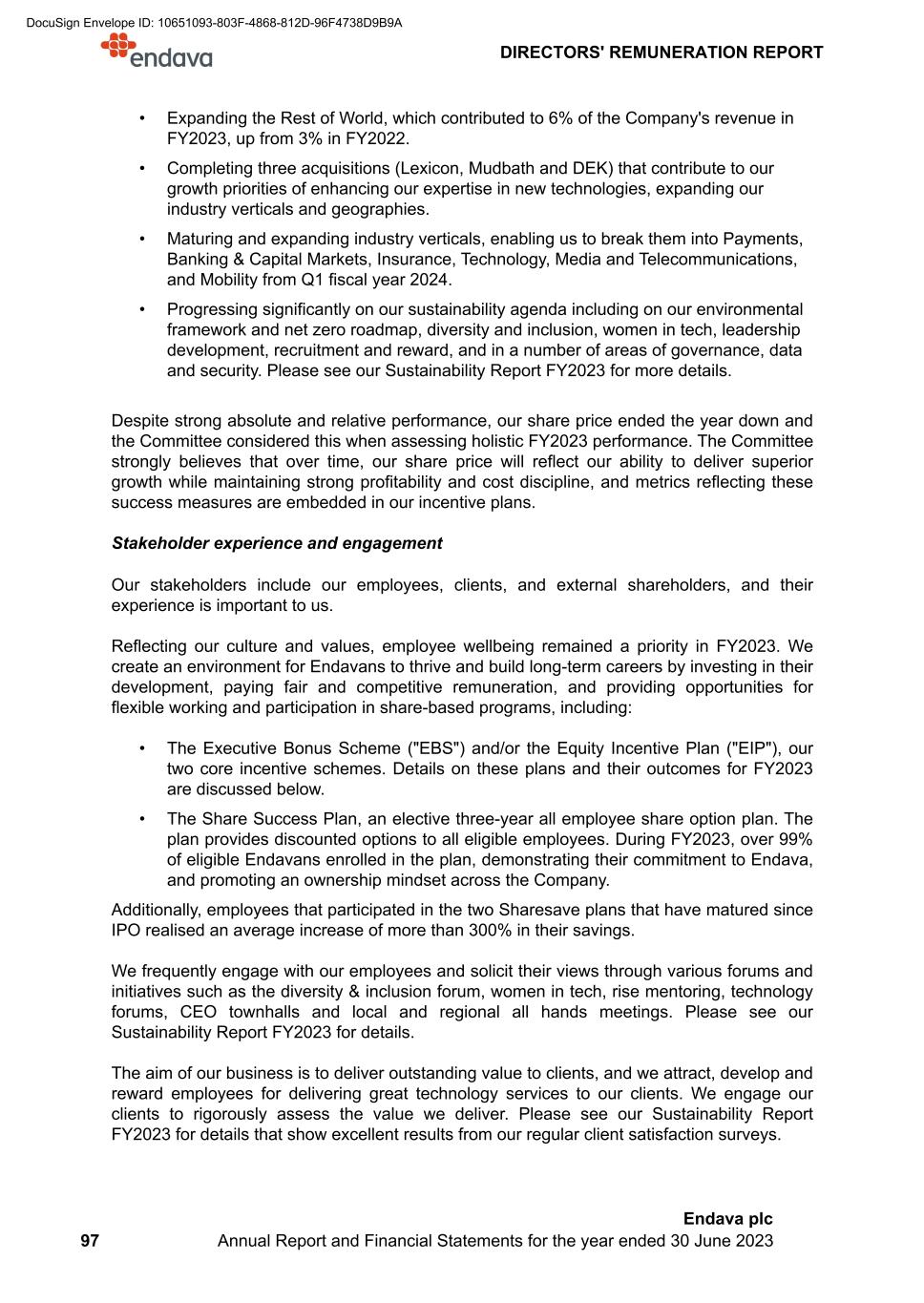
• Expanding the Rest of World, which contributed to 6% of the Company's revenue in FY2023, up from 3% in FY2022. • Completing three acquisitions (Lexicon, Mudbath and DEK) that contribute to our growth priorities of enhancing our expertise in new technologies, expanding our industry verticals and geographies. • Maturing and expanding industry verticals, enabling us to break them into Payments, Banking & Capital Markets, Insurance, Technology, Media and Telecommunications, and Mobility from Q1 fiscal year 2024. • Progressing significantly on our sustainability agenda including on our environmental framework and net zero roadmap, diversity and inclusion, women in tech, leadership development, recruitment and reward, and in a number of areas of governance, data and security. Please see our Sustainability Report FY2023 for more details. Despite strong absolute and relative performance, our share price ended the year down and the Committee considered this when assessing holistic FY2023 performance. The Committee strongly believes that over time, our share price will reflect our ability to deliver superior growth while maintaining strong profitability and cost discipline, and metrics reflecting these success measures are embedded in our incentive plans. Stakeholder experience and engagement Our stakeholders include our employees, clients, and external shareholders, and their experience is important to us. Reflecting our culture and values, employee wellbeing remained a priority in FY2023. We create an environment for Endavans to thrive and build long-term careers by investing in their development, paying fair and competitive remuneration, and providing opportunities for flexible working and participation in share-based programs, including: • The Executive Bonus Scheme ("EBS") and/or the Equity Incentive Plan ("EIP"), our two core incentive schemes. Details on these plans and their outcomes for FY2023 are discussed below. • The Share Success Plan, an elective three-year all employee share option plan. The plan provides discounted options to all eligible employees. During FY2023, over 99% of eligible Endavans enrolled in the plan, demonstrating their commitment to Endava, and promoting an ownership mindset across the Company. Additionally, employees that participated in the two Sharesave plans that have matured since IPO realised an average increase of more than 300% in their savings. We frequently engage with our employees and solicit their views through various forums and initiatives such as the diversity & inclusion forum, women in tech, rise mentoring, technology forums, CEO townhalls and local and regional all hands meetings. Please see our Sustainability Report FY2023 for details. The aim of our business is to deliver outstanding value to clients, and we attract, develop and reward employees for delivering great technology services to our clients. We engage our clients to rigorously assess the value we deliver. Please see our Sustainability Report FY2023 for details that show excellent results from our regular client satisfaction surveys. DIRECTORS' REMUNERATION REPORT 97 Endava plc Annual Report and Financial Statements for the year ended 30 June 2023 DocuSign Envelope ID: 10651093-803F-4868-812D-96F4738D9B9A

Similarly, we value external shareholder engagement. To inform decision-making during FY2023, the Committee played an active role in our shareholder engagement efforts. As detailed further below, these conversations provided valuable insight and influenced our actions for FY2024. FY2023 Incentive plan outcomes Endava’s Remuneration Policy emphasises performance-based pay, reflecting our performance focused culture across the Company, and has three incentive components. • The EBS is a cash-based annual incentive, which, for FY2023, was based on the achievement of adjusted PBT targets. • The EIP is a share-based long-term incentive plan under which awards are broken into two equally weighted tranches of Performance Share Units (“PSUs”). ◦ The first tranche is based on a one-year performance period - for FY2023 the award vesting was based on a combination of FY2023 revenue, adjusted PBT and order book goal achievement. Based on performance against these targets, the earned shares will vest in October 2023 (50%) and October 2024 (50%). ◦ The second tranche is based on a three-year performance period – awards granted in FY2023 will vest in October 2025, based on a combination of three- year revenue, adjusted PBT and relative total shareholder return goal achievement. Following vesting, any earned shares are subject to a two-year holding period through to October 2027. The formulaic outcomes for the EBS and one-year EIP awards were 15% and 12% of maximum respectively. The Committee considered the following factors to assess the alignment of the formulaic outcomes with our holistic views of performance, remuneration that attracts, retains and motivates, employee experience, profitability and cost discipline. • Performance goals were more challenging than originally intended. The FY2023 performance goals were established in June 2022, when the economic environment was significantly different. Accordingly, they were more challenging than originally intended, and the ranges from threshold to maximum were too narrow given the market uncertainty that followed. While we customarily set the maximum end of targets well in excess of budget numbers, meeting threshold performance was also a high bar given the narrowness of the band. • Absolute financial performance was strong. Despite challenging markets, Endava delivered strong results across multiple key performance indicators. Revenue grew by 21%, adjusted PBT by 19% and adjusted EPS by 18% relative to the prior year. • Relative financial performance was strong. Relative to our compensation peer group, Endava’s growth was positioned at or above the upper quartile for a range of key performance indicators, including revenue growth (%), adjusted PBT margin (%), adjusted PBT growth (%) and EPS growth (%). • Strategic achievements contribute meaningfully to our future growth prospects. The achievements summarised above were important to our holistic performance and warrant acknowledgement given efforts and contributions across the Company. • Small adjustments would represent low incremental cost and a high return on investment. Given the narrow range from threshold to maximum performance, DIRECTORS' REMUNERATION REPORT 98 Endava plc Annual Report and Financial Statements for the year ended 30 June 2023 DocuSign Envelope ID: 10651093-803F-4868-812D-96F4738D9B9A
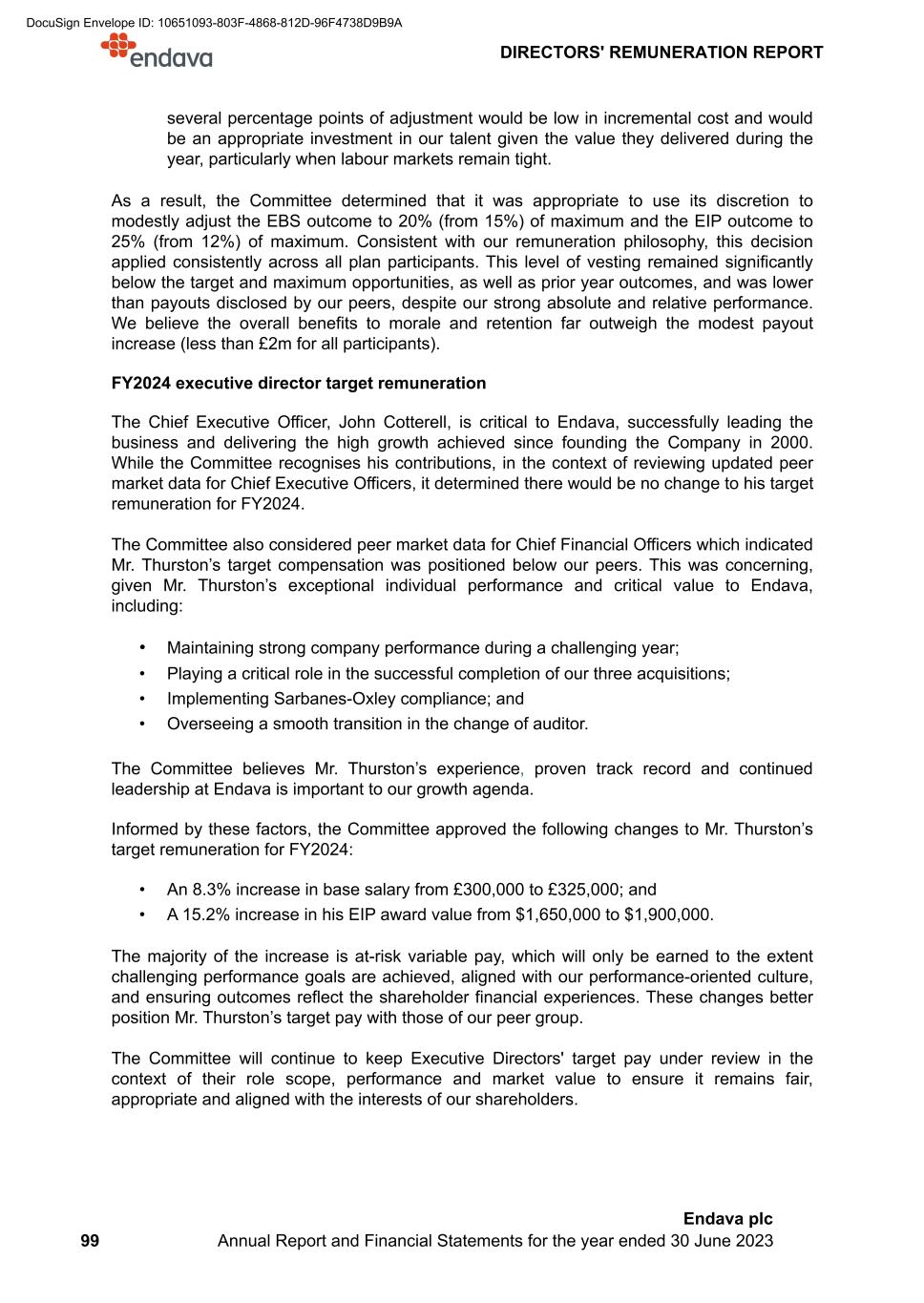
several percentage points of adjustment would be low in incremental cost and would be an appropriate investment in our talent given the value they delivered during the year, particularly when labour markets remain tight. As a result, the Committee determined that it was appropriate to use its discretion to modestly adjust the EBS outcome to 20% (from 15%) of maximum and the EIP outcome to 25% (from 12%) of maximum. Consistent with our remuneration philosophy, this decision applied consistently across all plan participants. This level of vesting remained significantly below the target and maximum opportunities, as well as prior year outcomes, and was lower than payouts disclosed by our peers, despite our strong absolute and relative performance. We believe the overall benefits to morale and retention far outweigh the modest payout increase (less than £2m for all participants). FY2024 executive director target remuneration The Chief Executive Officer, John Cotterell, is critical to Endava, successfully leading the business and delivering the high growth achieved since founding the Company in 2000. While the Committee recognises his contributions, in the context of reviewing updated peer market data for Chief Executive Officers, it determined there would be no change to his target remuneration for FY2024. The Committee also considered peer market data for Chief Financial Officers which indicated Mr. Thurston’s target compensation was positioned below our peers. This was concerning, given Mr. Thurston’s exceptional individual performance and critical value to Endava, including: • Maintaining strong company performance during a challenging year; • Playing a critical role in the successful completion of our three acquisitions; • Implementing Sarbanes-Oxley compliance; and • Overseeing a smooth transition in the change of auditor. The Committee believes Mr. Thurston’s experience, proven track record and continued leadership at Endava is important to our growth agenda. Informed by these factors, the Committee approved the following changes to Mr. Thurston’s target remuneration for FY2024: • An 8.3% increase in base salary from £300,000 to £325,000; and • A 15.2% increase in his EIP award value from $1,650,000 to $1,900,000. The majority of the increase is at-risk variable pay, which will only be earned to the extent challenging performance goals are achieved, aligned with our performance-oriented culture, and ensuring outcomes reflect the shareholder financial experiences. These changes better position Mr. Thurston’s target pay with those of our peer group. The Committee will continue to keep Executive Directors' target pay under review in the context of their role scope, performance and market value to ensure it remains fair, appropriate and aligned with the interests of our shareholders. DIRECTORS' REMUNERATION REPORT 99 Endava plc Annual Report and Financial Statements for the year ended 30 June 2023 DocuSign Envelope ID: 10651093-803F-4868-812D-96F4738D9B9A

FY2024 changes informed by shareholder engagement Endava remains committed to ongoing dialogue with our major shareholders. During FY2023, investors representing 49% of non-management total shares outstanding were invited to participate in a planned period of engagement. The Chair of the Board, and myself as Chair of the Remuneration Committee participated in all meetings with those that requested one. Discussions provided valuable insight and informed the following decisions: • Incentive performance goals will be disclosed on a retrospective basis. Shareholders have expressed a preference for Endava to disclose details of the specific performance goals used in our EBS and EIP. The Board has historically determined that this information is commercially sensitive given the nature of the ranges, how the ranges are established, the combination of measures, and limited visibility of our historic financial performance as a public company. We considered shareholders’ expressed views and approaches that would enable retrospective disclosure without risking commercial sensitivity concerns. Prospectively, we will make changes to measurements and goal ranges in order to disclose the threshold and maximum performance goals and outcomes for all FY2024 EBS and EIP measures in the Annual Report and Accounts published following the conclusion of their respective performance periods. Given our FY2023 goals were established prior to this change, the Board has determined that they remain commercially sensitive. • FY2024 incentive performance measures are modestly updated. While the EBS will remain based on adjusted PBT, more substantive changes have been made to the EIP incentive measures. ◦ Adjusted PBT margin (%) will replace absolute adjusted PBT in the EIP. Shareholders generally supported this change noting that margin percent is an important measure of success given our combination of organic and inorganic growth. They also noted that it complements revenue as it motivates margin accretive profitable growth. It was also welcomed that this change reduces measure duplication with the EBS. ◦ Constant currency revenue growth (%) will replace absolute revenue for the one-year performance period, with the weight increased to 40% from 35%. Shareholders generally supported this change agreeing that it: ▪ Aligns with our strategic priorities; ▪ Aligns with how they assess our performance in absolute terms and relative to peers; ▪ Better aligns with how our business is managed; and, ▪ Reduces the impact of FX volatility. To accommodate the increase in weighting, the order book goal weighting was reduced by 5% (from 25% to 20%). This was largely to put the revenue and adjusted PBT margin goals on an equal footing. • Our 100% use of performance-based equity for executives, combining one and three-year performance periods, remains fit for purpose and aligned with our business and talent priorities. This combination continues to balance differences in UK and US remuneration practices, enables an informed assessment of performance DIRECTORS' REMUNERATION REPORT 100 Endava plc Annual Report and Financial Statements for the year ended 30 June 2023 DocuSign Envelope ID: 10651093-803F-4868-812D-96F4738D9B9A
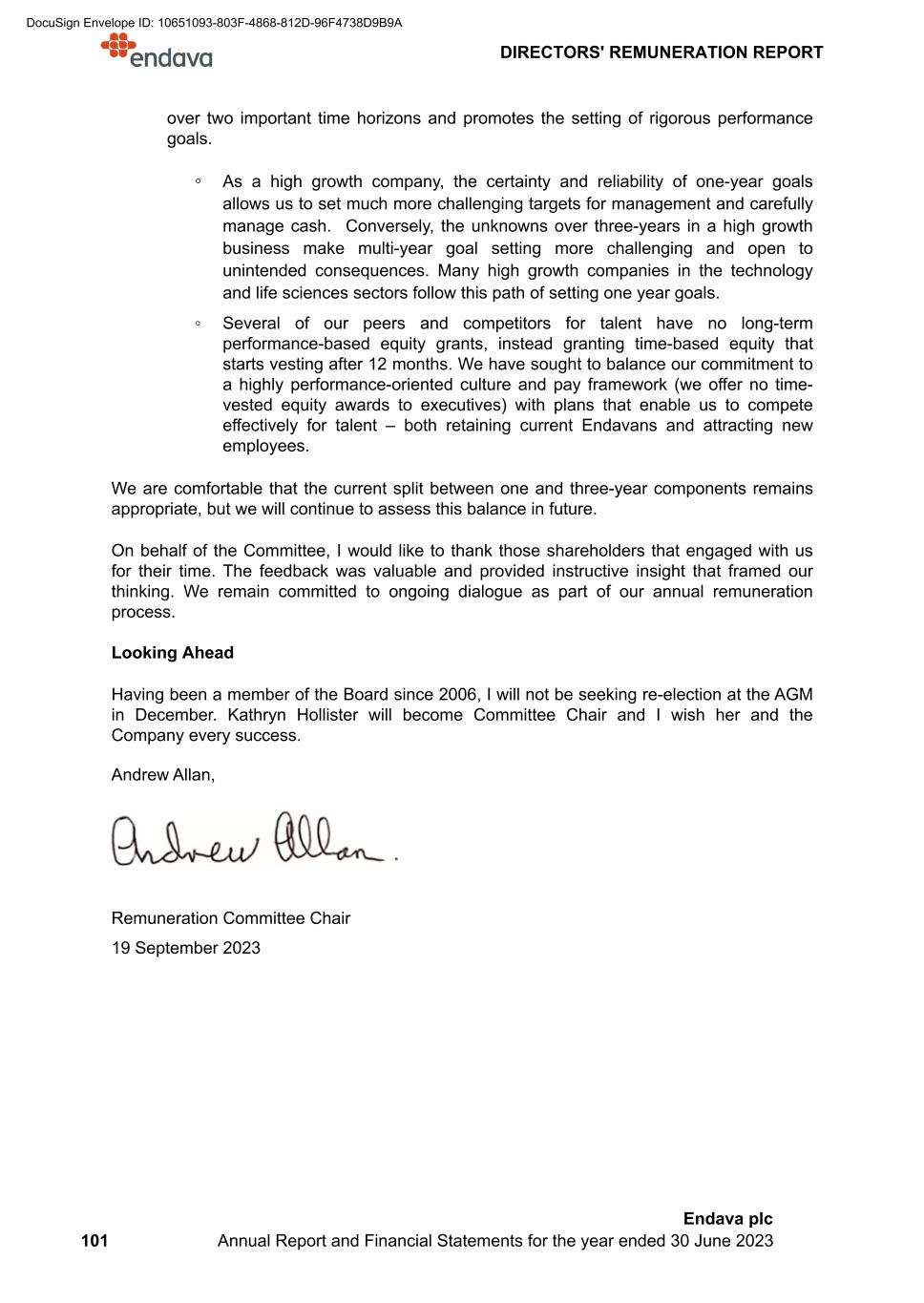
over two important time horizons and promotes the setting of rigorous performance goals. ◦ As a high growth company, the certainty and reliability of one-year goals allows us to set much more challenging targets for management and carefully manage cash. Conversely, the unknowns over three-years in a high growth business make multi-year goal setting more challenging and open to unintended consequences. Many high growth companies in the technology and life sciences sectors follow this path of setting one year goals. ◦ Several of our peers and competitors for talent have no long-term performance-based equity grants, instead granting time-based equity that starts vesting after 12 months. We have sought to balance our commitment to a highly performance-oriented culture and pay framework (we offer no time- vested equity awards to executives) with plans that enable us to compete effectively for talent – both retaining current Endavans and attracting new employees. We are comfortable that the current split between one and three-year components remains appropriate, but we will continue to assess this balance in future. On behalf of the Committee, I would like to thank those shareholders that engaged with us for their time. The feedback was valuable and provided instructive insight that framed our thinking. We remain committed to ongoing dialogue as part of our annual remuneration process. Looking Ahead Having been a member of the Board since 2006, I will not be seeking re-election at the AGM in December. Kathryn Hollister will become Committee Chair and I wish her and the Company every success. Andrew Allan, Remuneration Committee Chair 19 September 2023 DIRECTORS' REMUNERATION REPORT 101 Endava plc Annual Report and Financial Statements for the year ended 30 June 2023 DocuSign Envelope ID: 10651093-803F-4868-812D-96F4738D9B9A

This report complies with the provisions of the Companies Act 2006, the Large and Medium- sized Companies and Groups (Accounts and Reports) (Amendment) Regulations 2013, the Companies (Miscellaneous Reporting) Regulations 2018, and the Companies (Directors’ Remuneration Policy and Directors’ Remuneration Report) Regulations 2019. The following report is set out in two parts: • The Directors’ Remuneration Policy (pages 103 to 114) that secured 91% support at our AGM last year. • The Annual Report on Remuneration (pages 115 to 132). This section describes how the Remuneration Policy has been implemented during the 2023 financial year and how we intend to apply the revised Remuneration Policy for the coming year. The Directors' Remuneration Report (excluding the Policy section) is subject to an advisory vote at this year's AGM. DIRECTORS' REMUNERATION REPORT 102 Endava plc Annual Report and Financial Statements for the year ended 30 June 2023 DocuSign Envelope ID: 10651093-803F-4868-812D-96F4738D9B9A

Part 1 - Directors’ Remuneration Policy The following section of this report describes the formal remuneration policy applying to the Company’s executive and non-executive directors (the “Policy”). The Policy was put to a binding shareholder vote at the AGM held on 12 December 2022 and received 91% shareholder approval. It is intended that the Policy will remain in place for a period of three years from its effective date, unless the Committee determines that it is necessary to seek approval for an amended policy prior to this date. The scenario charts have been updated to reflect the intended application of the Policy for the year ending 30 June 2024 and references to prior financial years have been updated where appropriate to aid understanding. A copy of the as-approved Policy (including the scenario charts set out in that Policy) is in the Annual Report and Financial Statements for the Year Ended June 2022, which is available at https://investors.endava.com/financials-and- filings/UK-Group-Statutory-Accounts. The Remuneration Policy is unchanged this year, and as such is not subject to shareholder vote. Remuneration policy table - Executive directors Base salary Purpose and link to strategy Provides a core level of reward for the completion of executives’ duties. Set at a level such that the total value of remuneration allows us to attract and retain employees of a sufficient calibre to drive the Company’s success, taking into account the global nature of the business and the key talent markets (including the UK and US) in which we must compete. Maximum opportunity There is no maximum salary limit. When considering salary levels, the Committee will consider the specific nature and responsibilities of the role at Endava, the capabilities and experience of the individual, as well as pay levels in relevant talent markets. Operation Salaries are typically reviewed annually, with any increases normally taking effect from 1 July. When awarding salary increases, if any, the Committee will consider the level of increase proposed for the wider workforce, employee pay conditions more broadly, and inflation. The Committee will also consider the impact on the aggregate total remuneration opportunity and pay mix. Where there has been a change in the role or, if the individual is new to the role increases could be higher. Performance framework n/a Pension DIRECTORS' REMUNERATION REPORT 103 Endava plc Annual Report and Financial Statements for the year ended 30 June 2023 DocuSign Envelope ID: 10651093-803F-4868-812D-96F4738D9B9A
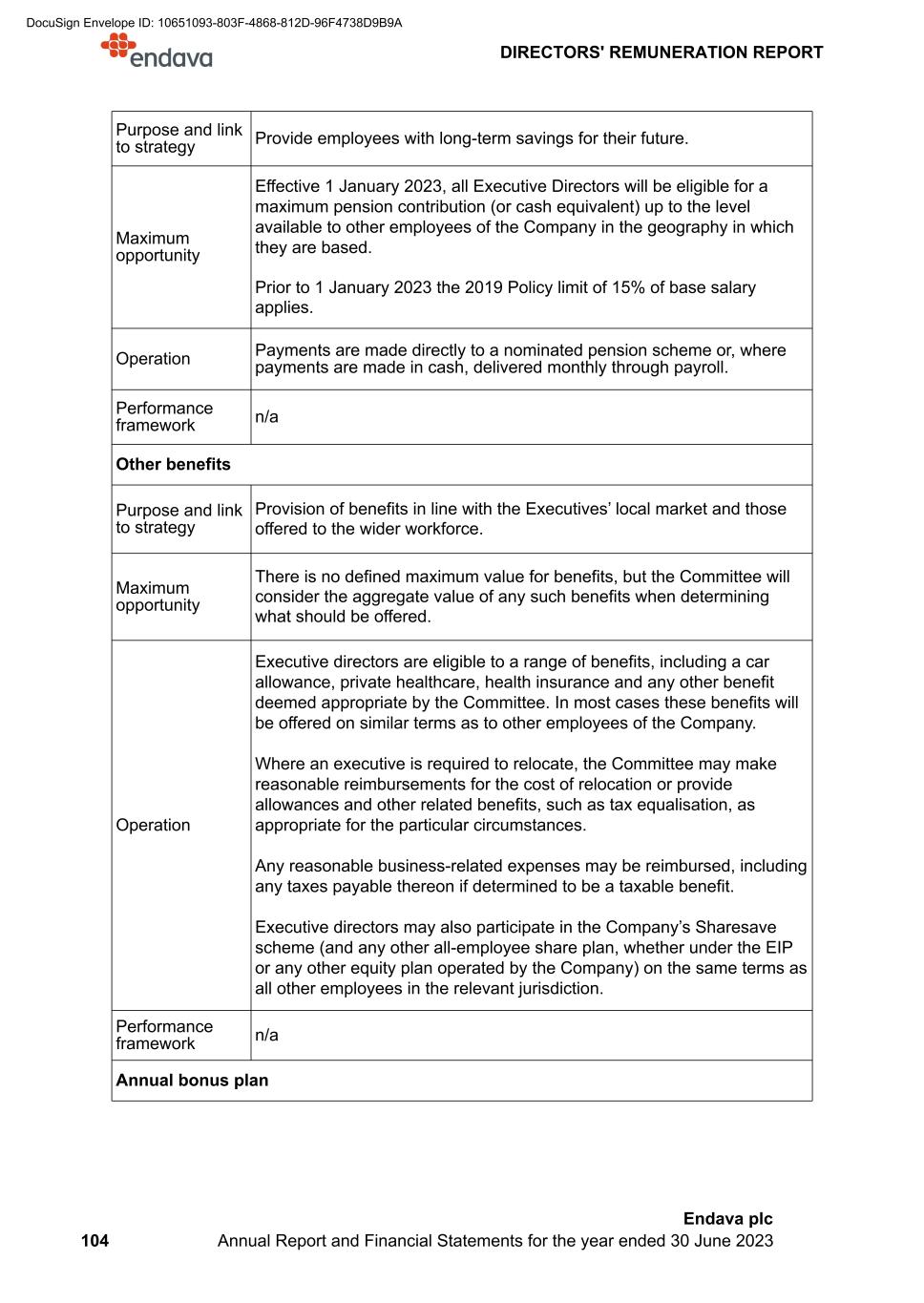
Purpose and link to strategy Provide employees with long-term savings for their future. Maximum opportunity Effective 1 January 2023, all Executive Directors will be eligible for a maximum pension contribution (or cash equivalent) up to the level available to other employees of the Company in the geography in which they are based. Prior to 1 January 2023 the 2019 Policy limit of 15% of base salary applies. Operation Payments are made directly to a nominated pension scheme or, where payments are made in cash, delivered monthly through payroll. Performance framework n/a Other benefits Purpose and link to strategy Provision of benefits in line with the Executives’ local market and those offered to the wider workforce. Maximum opportunity There is no defined maximum value for benefits, but the Committee will consider the aggregate value of any such benefits when determining what should be offered. Operation Executive directors are eligible to a range of benefits, including a car allowance, private healthcare, health insurance and any other benefit deemed appropriate by the Committee. In most cases these benefits will be offered on similar terms as to other employees of the Company. Where an executive is required to relocate, the Committee may make reasonable reimbursements for the cost of relocation or provide allowances and other related benefits, such as tax equalisation, as appropriate for the particular circumstances. Any reasonable business-related expenses may be reimbursed, including any taxes payable thereon if determined to be a taxable benefit. Executive directors may also participate in the Company’s Sharesave scheme (and any other all-employee share plan, whether under the EIP or any other equity plan operated by the Company) on the same terms as all other employees in the relevant jurisdiction. Performance framework n/a Annual bonus plan DIRECTORS' REMUNERATION REPORT 104 Endava plc Annual Report and Financial Statements for the year ended 30 June 2023 DocuSign Envelope ID: 10651093-803F-4868-812D-96F4738D9B9A
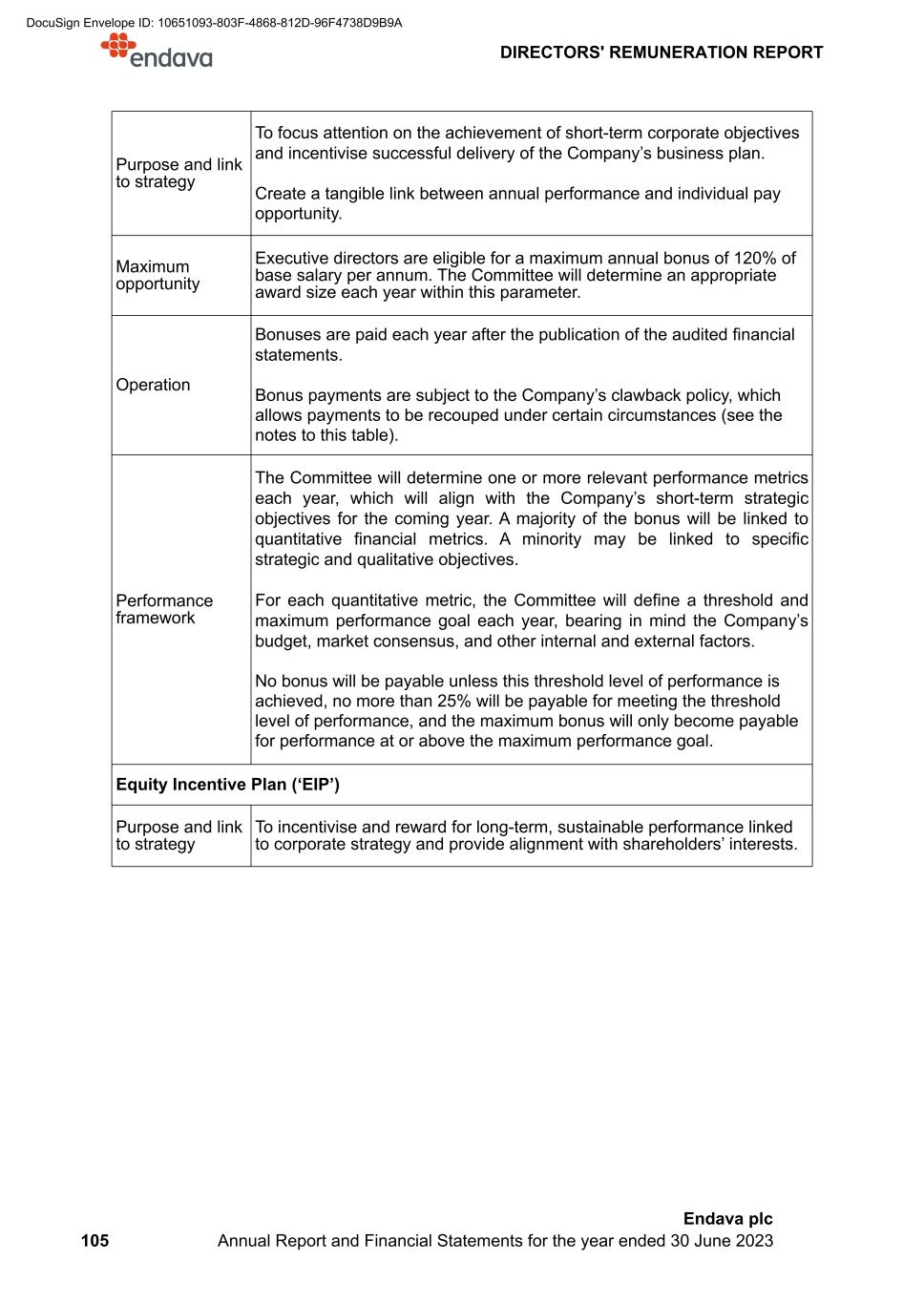
Purpose and link to strategy To focus attention on the achievement of short-term corporate objectives and incentivise successful delivery of the Company’s business plan. Create a tangible link between annual performance and individual pay opportunity. Maximum opportunity Executive directors are eligible for a maximum annual bonus of 120% of base salary per annum. The Committee will determine an appropriate award size each year within this parameter. Operation Bonuses are paid each year after the publication of the audited financial statements. Bonus payments are subject to the Company’s clawback policy, which allows payments to be recouped under certain circumstances (see the notes to this table). Performance framework The Committee will determine one or more relevant performance metrics each year, which will align with the Company’s short-term strategic objectives for the coming year. A majority of the bonus will be linked to quantitative financial metrics. A minority may be linked to specific strategic and qualitative objectives. For each quantitative metric, the Committee will define a threshold and maximum performance goal each year, bearing in mind the Company’s budget, market consensus, and other internal and external factors. No bonus will be payable unless this threshold level of performance is achieved, no more than 25% will be payable for meeting the threshold level of performance, and the maximum bonus will only become payable for performance at or above the maximum performance goal. Equity Incentive Plan (‘EIP’) Purpose and link to strategy To incentivise and reward for long-term, sustainable performance linked to corporate strategy and provide alignment with shareholders’ interests. DIRECTORS' REMUNERATION REPORT 105 Endava plc Annual Report and Financial Statements for the year ended 30 June 2023 DocuSign Envelope ID: 10651093-803F-4868-812D-96F4738D9B9A
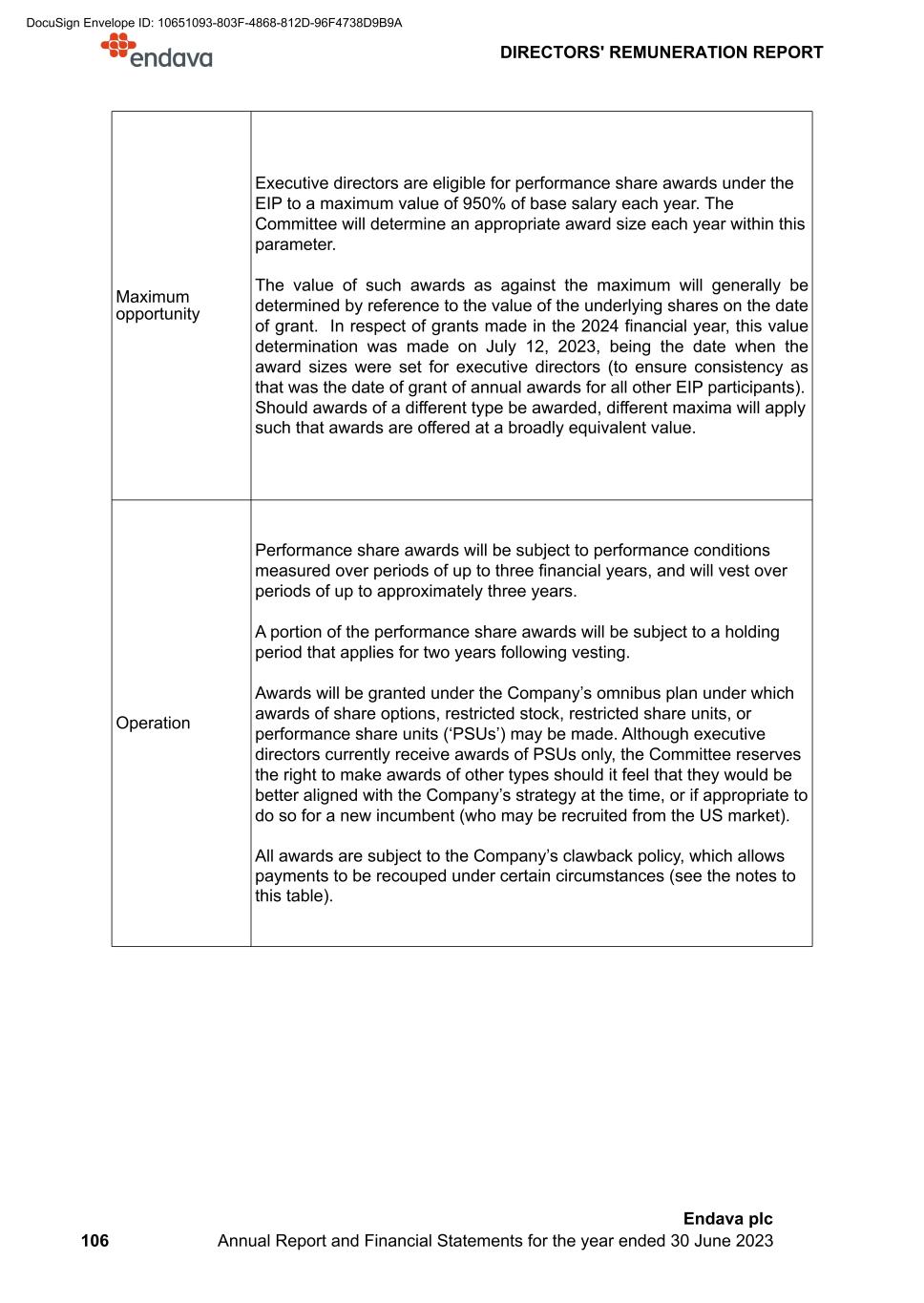
Maximum opportunity Executive directors are eligible for performance share awards under the EIP to a maximum value of 950% of base salary each year. The Committee will determine an appropriate award size each year within this parameter. The value of such awards as against the maximum will generally be determined by reference to the value of the underlying shares on the date of grant. In respect of grants made in the 2024 financial year, this value determination was made on July 12, 2023, being the date when the award sizes were set for executive directors (to ensure consistency as that was the date of grant of annual awards for all other EIP participants). Should awards of a different type be awarded, different maxima will apply such that awards are offered at a broadly equivalent value. Operation Performance share awards will be subject to performance conditions measured over periods of up to three financial years, and will vest over periods of up to approximately three years. A portion of the performance share awards will be subject to a holding period that applies for two years following vesting. Awards will be granted under the Company’s omnibus plan under which awards of share options, restricted stock, restricted share units, or performance share units (‘PSUs’) may be made. Although executive directors currently receive awards of PSUs only, the Committee reserves the right to make awards of other types should it feel that they would be better aligned with the Company’s strategy at the time, or if appropriate to do so for a new incumbent (who may be recruited from the US market). All awards are subject to the Company’s clawback policy, which allows payments to be recouped under certain circumstances (see the notes to this table). DIRECTORS' REMUNERATION REPORT 106 Endava plc Annual Report and Financial Statements for the year ended 30 June 2023 DocuSign Envelope ID: 10651093-803F-4868-812D-96F4738D9B9A
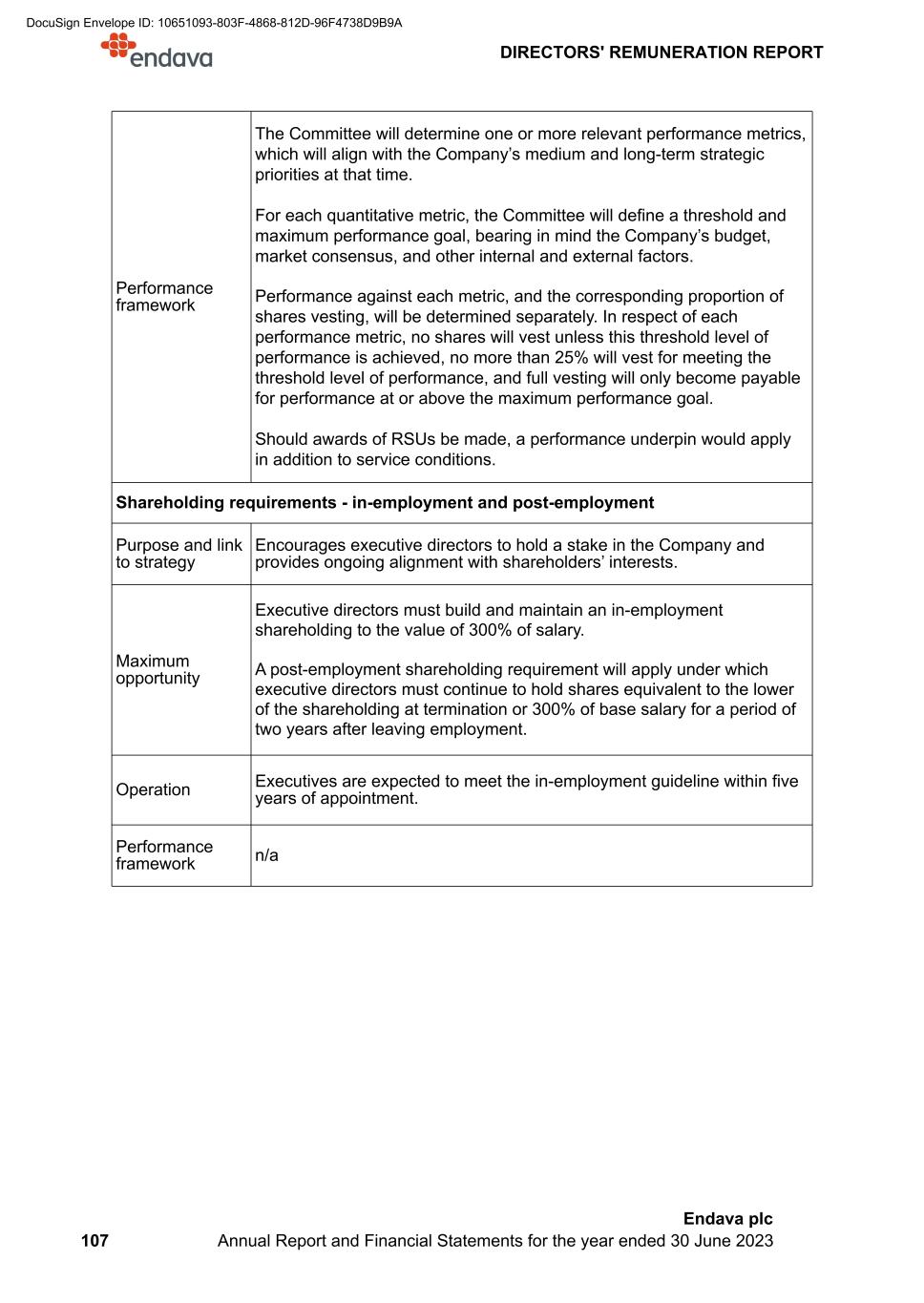
Performance framework The Committee will determine one or more relevant performance metrics, which will align with the Company’s medium and long-term strategic priorities at that time. For each quantitative metric, the Committee will define a threshold and maximum performance goal, bearing in mind the Company’s budget, market consensus, and other internal and external factors. Performance against each metric, and the corresponding proportion of shares vesting, will be determined separately. In respect of each performance metric, no shares will vest unless this threshold level of performance is achieved, no more than 25% will vest for meeting the threshold level of performance, and full vesting will only become payable for performance at or above the maximum performance goal. Should awards of RSUs be made, a performance underpin would apply in addition to service conditions. Shareholding requirements - in-employment and post-employment Purpose and link to strategy Encourages executive directors to hold a stake in the Company and provides ongoing alignment with shareholders’ interests. Maximum opportunity Executive directors must build and maintain an in-employment shareholding to the value of 300% of salary. A post-employment shareholding requirement will apply under which executive directors must continue to hold shares equivalent to the lower of the shareholding at termination or 300% of base salary for a period of two years after leaving employment. Operation Executives are expected to meet the in-employment guideline within five years of appointment. Performance framework n/a DIRECTORS' REMUNERATION REPORT 107 Endava plc Annual Report and Financial Statements for the year ended 30 June 2023 DocuSign Envelope ID: 10651093-803F-4868-812D-96F4738D9B9A

Remuneration policy table - Non-executive directors Fees Purpose and link to strategy Supports recruitment and retention of non-executive directors with the required skills and experience to lead the Company. Maximum opportunity Aggregate fees are subject to the limit set out in the Articles of Association. Operation Non-executive directors receive a base fee for performance of their duties. The Company may also pay additional fees in recognition of any additional responsibilities, such as being the chair of Board committees. In addition, to ensure that remuneration is competitive relative to the US market, where such practices are typical, non-executive directors may receive equity awards on an annual basis. Fees are reviewed on a regular basis with reference to pay levels in relevant talent markets, taking into account the specific roles and responsibilities, as well as expected time commitment. The Company reserves the right to pay additional fees in any given year to reflect a material, but temporary, increase in time commitment during the period. Any reasonable business-related expenses may be reimbursed, including any taxes payable thereon if determined to be a taxable benefit. For any director required to undertake significant travel to attend Board and Committee meetings, the Company may also pay a travel allowance to recognise the additional time commitment required. Performance framework n/a Shareholding requirements Purpose and link to strategy Encourages non-executive directors to hold a stake in the Company and provides ongoing alignment with shareholders’ interests. DIRECTORS' REMUNERATION REPORT 108 Endava plc Annual Report and Financial Statements for the year ended 30 June 2023 DocuSign Envelope ID: 10651093-803F-4868-812D-96F4738D9B9A

Maximum opportunity Non-executive directors must build and maintain shareholdings to the value of $300,000. Operation Non-executive directors are expected to meet the guideline within five years from the approval of the policy or, if later, their date of appointment. Performance framework n/a Notes to the policy table Choice of performance conditions and metrics The role of the remuneration committee includes the establishment of performance goals through short and long-term incentive plans which are challenging but achievable through superior performance within the Company’s risk appetite, thereby incentivising and rewarding success. The Committee will determine appropriate performance measures and targets for the annual bonus and EIP each year, selected such that they provide alignment with the Company’s business objectives for the coming period. Performance measures and targets may therefore vary year-on-year based on the Company’s objectives at that time. When setting targets, the Committee will take into account internal measures such as budget, as well as external factors including consensus forecasts and general market conditions. Details of all the outstanding share awards granted to executive directors, including the applicable performance criteria, are set out in the annual remuneration report. Clawback and malus provisions The Company has adopted a malus and clawback policy which covers all incentive payments (including the annual bonus plan and EIP). Under this policy, the Company may recoup amounts paid if: there is a breach of any post-termination restriction; or if there is a required restatement of accounts due to the material non-compliance with any financial reporting requirement as a result of an Executive’s misconduct. In the case of a required restatement, any incentive payments made during the three financial years preceding the restatement may be subject to clawback. Recoupments may be made either through repayment of prior incentive payments; cancellation of outstanding incentive payments; reduction of any future incentive payments; or direct repayment. The Committee retains the discretion to update or amend the malus and clawback policy from time to time in order to maintain compliance with applicable laws and regulatory requirements and best practice from time to time. Discretions retained by the Committee The Committee will operate the annual bonus plan and the EIP according to their respective rules and in accordance with any applicable legislation where relevant. DIRECTORS' REMUNERATION REPORT 109 Endava plc Annual Report and Financial Statements for the year ended 30 June 2023 DocuSign Envelope ID: 10651093-803F-4868-812D-96F4738D9B9A
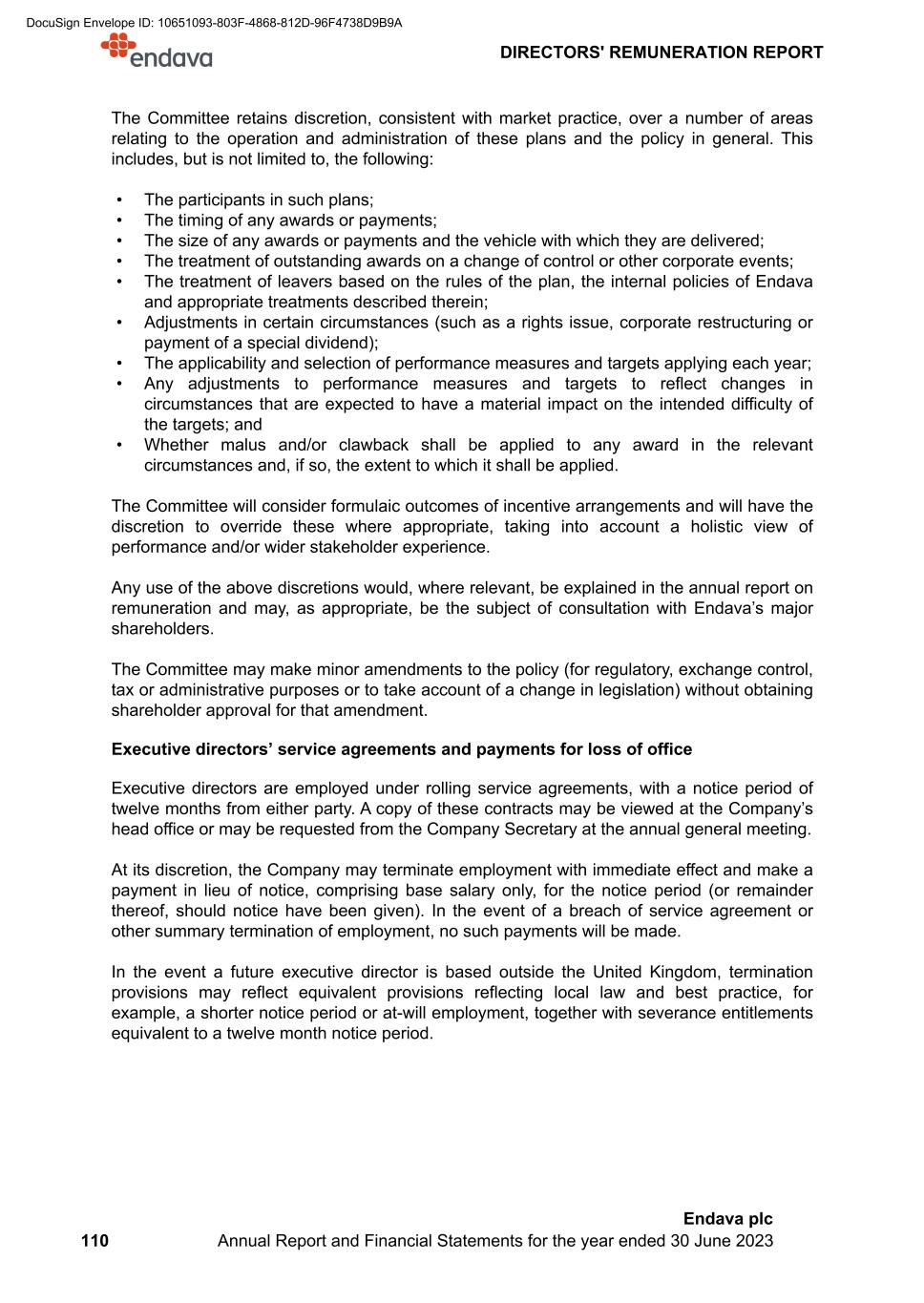
The Committee retains discretion, consistent with market practice, over a number of areas relating to the operation and administration of these plans and the policy in general. This includes, but is not limited to, the following: • The participants in such plans; • The timing of any awards or payments; • The size of any awards or payments and the vehicle with which they are delivered; • The treatment of outstanding awards on a change of control or other corporate events; • The treatment of leavers based on the rules of the plan, the internal policies of Endava and appropriate treatments described therein; • Adjustments in certain circumstances (such as a rights issue, corporate restructuring or payment of a special dividend); • The applicability and selection of performance measures and targets applying each year; • Any adjustments to performance measures and targets to reflect changes in circumstances that are expected to have a material impact on the intended difficulty of the targets; and • Whether malus and/or clawback shall be applied to any award in the relevant circumstances and, if so, the extent to which it shall be applied. The Committee will consider formulaic outcomes of incentive arrangements and will have the discretion to override these where appropriate, taking into account a holistic view of performance and/or wider stakeholder experience. Any use of the above discretions would, where relevant, be explained in the annual report on remuneration and may, as appropriate, be the subject of consultation with Endava’s major shareholders. The Committee may make minor amendments to the policy (for regulatory, exchange control, tax or administrative purposes or to take account of a change in legislation) without obtaining shareholder approval for that amendment. Executive directors’ service agreements and payments for loss of office Executive directors are employed under rolling service agreements, with a notice period of twelve months from either party. A copy of these contracts may be viewed at the Company’s head office or may be requested from the Company Secretary at the annual general meeting. At its discretion, the Company may terminate employment with immediate effect and make a payment in lieu of notice, comprising base salary only, for the notice period (or remainder thereof, should notice have been given). In the event of a breach of service agreement or other summary termination of employment, no such payments will be made. In the event a future executive director is based outside the United Kingdom, termination provisions may reflect equivalent provisions reflecting local law and best practice, for example, a shorter notice period or at-will employment, together with severance entitlements equivalent to a twelve month notice period. DIRECTORS' REMUNERATION REPORT 110 Endava plc Annual Report and Financial Statements for the year ended 30 June 2023 DocuSign Envelope ID: 10651093-803F-4868-812D-96F4738D9B9A
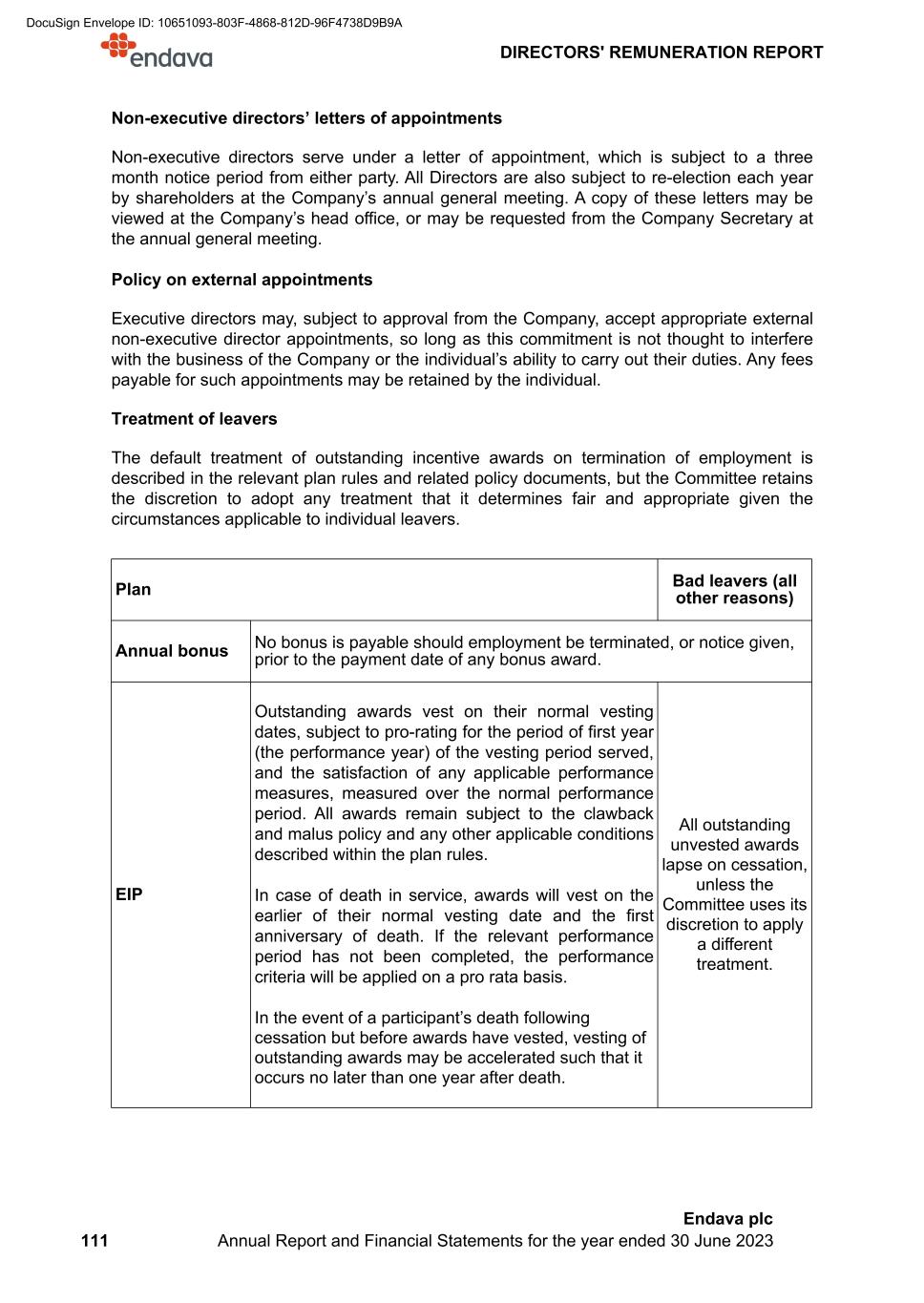
Non-executive directors’ letters of appointments Non-executive directors serve under a letter of appointment, which is subject to a three month notice period from either party. All Directors are also subject to re-election each year by shareholders at the Company’s annual general meeting. A copy of these letters may be viewed at the Company’s head office, or may be requested from the Company Secretary at the annual general meeting. Policy on external appointments Executive directors may, subject to approval from the Company, accept appropriate external non-executive director appointments, so long as this commitment is not thought to interfere with the business of the Company or the individual’s ability to carry out their duties. Any fees payable for such appointments may be retained by the individual. Treatment of leavers The default treatment of outstanding incentive awards on termination of employment is described in the relevant plan rules and related policy documents, but the Committee retains the discretion to adopt any treatment that it determines fair and appropriate given the circumstances applicable to individual leavers. Plan Bad leavers (all other reasons) Annual bonus No bonus is payable should employment be terminated, or notice given, prior to the payment date of any bonus award. EIP Outstanding awards vest on their normal vesting dates, subject to pro-rating for the period of first year (the performance year) of the vesting period served, and the satisfaction of any applicable performance measures, measured over the normal performance period. All awards remain subject to the clawback and malus policy and any other applicable conditions described within the plan rules. In case of death in service, awards will vest on the earlier of their normal vesting date and the first anniversary of death. If the relevant performance period has not been completed, the performance criteria will be applied on a pro rata basis. In the event of a participant’s death following cessation but before awards have vested, vesting of outstanding awards may be accelerated such that it occurs no later than one year after death. All outstanding unvested awards lapse on cessation, unless the Committee uses its discretion to apply a different treatment. DIRECTORS' REMUNERATION REPORT 111 Endava plc Annual Report and Financial Statements for the year ended 30 June 2023 DocuSign Envelope ID: 10651093-803F-4868-812D-96F4738D9B9A

The Company may pay reasonable outplacement and legal and professional fees and pay out untaken holiday where considered appropriate. The Company may pay any statutory entitlements or settle or compromise claims in connection with a termination of employment, where considered in the best interests of the Company. Payment or reimbursement of reasonable relocation and outplacement fees may also be provided. Recruitment remuneration policy Base salary levels will be set in accordance with the remuneration policy, taking into account the experience and calibre of the individual and the relevant market rates at the time. Where it is appropriate to offer a lower salary initially, progressive increases (possibly above those of the wider workforce as a percentage of salary) may be offered to achieve the desired salary positioning over the following few years subject to individual performance and continued development in the role. Benefits will be provided in line with those offered to other employees, with relocation expenses/arrangements and reasonable legal fees provided for if necessary. Should it be appropriate to recruit a director from overseas, flexibility is retained to provide benefits that take account of those typically provided in their country of residence (e.g. it may be appropriate to provide benefits that are tailored to the unique circumstances of such an appointment). Pension contributions or a cash supplement up to the level available to other employees of the Company in the geography in which they are based may be provided, although the Committee retains the discretion to structure any arrangements as necessary to comply with the relevant legislation and market practice if an overseas director is appointed. The aggregate ongoing (i.e. after the year of appointment) incentive opportunity offered to new recruits will be no higher than that offered under the annual bonus plan and the EIP policy to the existing executive directors. In the year of appointment, the annual bonus opportunity will be no higher than that offered to existing executive directors, prorated for the period of service. Different performance measures may be set initially for the annual bonus, taking into account the responsibilities of the individual, and the point in the financial year that they joined. The above policy applies to both an internal promotion to the board and an external hire. In the case of an external hire, if it is necessary to buy out any incentive arrangements (which would be forfeited on leaving the previous employer), this may be provided for, taking into account the form (cash or shares) and timing and expected value (i.e. likelihood of meeting any existing performance criteria) of the remuneration being forfeited. Replacement share awards, if used, will be granted using Endava’s existing share plans to the extent possible, although awards may also be granted outside of these plans if necessary and as permitted under relevant legislation. Any buyout awards made will not count towards the annual bonus and EIP maxima as described in the remuneration policy. DIRECTORS' REMUNERATION REPORT 112 Endava plc Annual Report and Financial Statements for the year ended 30 June 2023 DocuSign Envelope ID: 10651093-803F-4868-812D-96F4738D9B9A
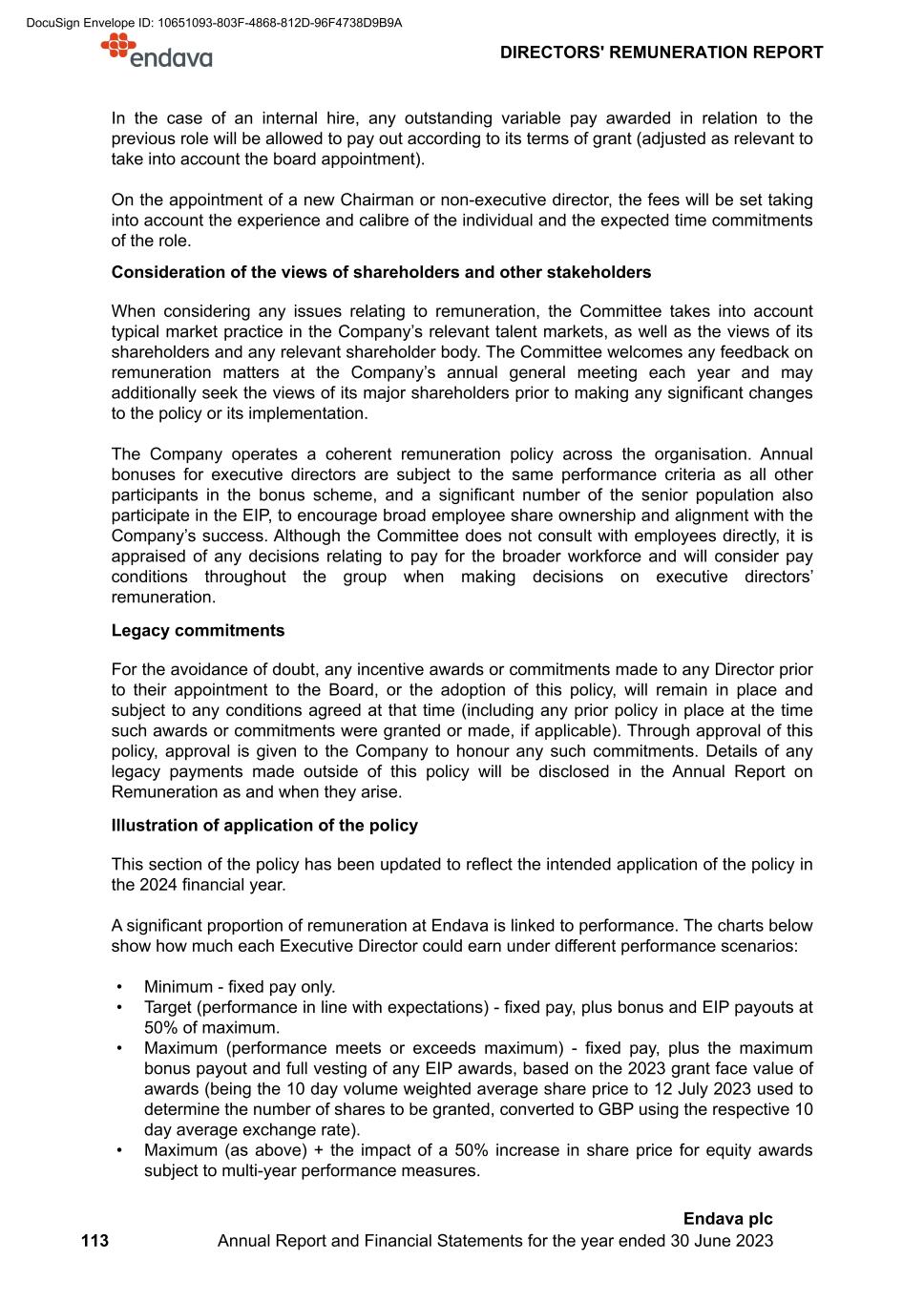
In the case of an internal hire, any outstanding variable pay awarded in relation to the previous role will be allowed to pay out according to its terms of grant (adjusted as relevant to take into account the board appointment). On the appointment of a new Chairman or non-executive director, the fees will be set taking into account the experience and calibre of the individual and the expected time commitments of the role. Consideration of the views of shareholders and other stakeholders When considering any issues relating to remuneration, the Committee takes into account typical market practice in the Company’s relevant talent markets, as well as the views of its shareholders and any relevant shareholder body. The Committee welcomes any feedback on remuneration matters at the Company’s annual general meeting each year and may additionally seek the views of its major shareholders prior to making any significant changes to the policy or its implementation. The Company operates a coherent remuneration policy across the organisation. Annual bonuses for executive directors are subject to the same performance criteria as all other participants in the bonus scheme, and a significant number of the senior population also participate in the EIP, to encourage broad employee share ownership and alignment with the Company’s success. Although the Committee does not consult with employees directly, it is appraised of any decisions relating to pay for the broader workforce and will consider pay conditions throughout the group when making decisions on executive directors’ remuneration. Legacy commitments For the avoidance of doubt, any incentive awards or commitments made to any Director prior to their appointment to the Board, or the adoption of this policy, will remain in place and subject to any conditions agreed at that time (including any prior policy in place at the time such awards or commitments were granted or made, if applicable). Through approval of this policy, approval is given to the Company to honour any such commitments. Details of any legacy payments made outside of this policy will be disclosed in the Annual Report on Remuneration as and when they arise. Illustration of application of the policy This section of the policy has been updated to reflect the intended application of the policy in the 2024 financial year. A significant proportion of remuneration at Endava is linked to performance. The charts below show how much each Executive Director could earn under different performance scenarios: • Minimum - fixed pay only. • Target (performance in line with expectations) - fixed pay, plus bonus and EIP payouts at 50% of maximum. • Maximum (performance meets or exceeds maximum) - fixed pay, plus the maximum bonus payout and full vesting of any EIP awards, based on the 2023 grant face value of awards (being the 10 day volume weighted average share price to 12 July 2023 used to determine the number of shares to be granted, converted to GBP using the respective 10 day average exchange rate). • Maximum (as above) + the impact of a 50% increase in share price for equity awards subject to multi-year performance measures. DIRECTORS' REMUNERATION REPORT 113 Endava plc Annual Report and Financial Statements for the year ended 30 June 2023 DocuSign Envelope ID: 10651093-803F-4868-812D-96F4738D9B9A
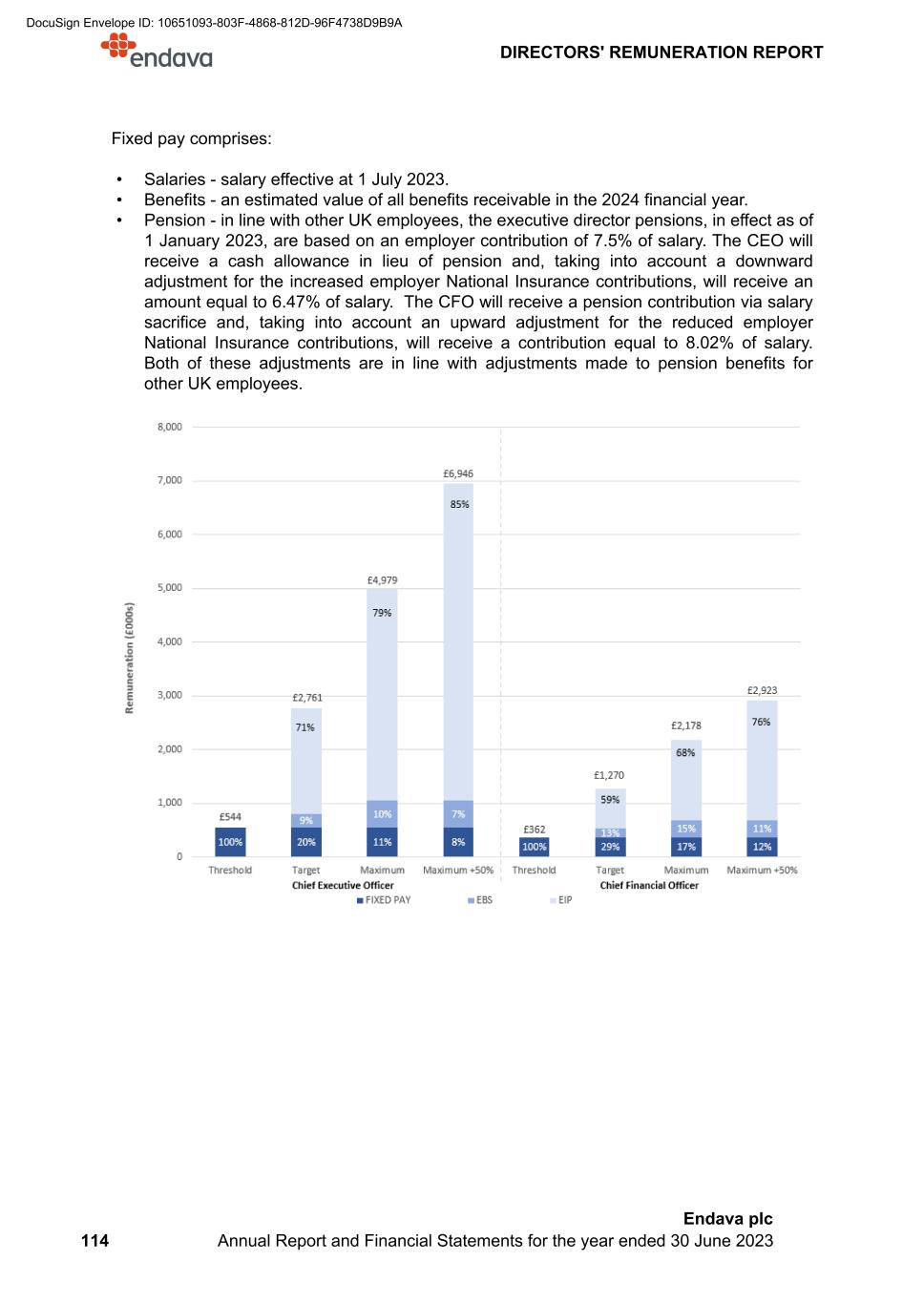
Fixed pay comprises: • Salaries - salary effective at 1 July 2023. • Benefits - an estimated value of all benefits receivable in the 2024 financial year. • Pension - in line with other UK employees, the executive director pensions, in effect as of 1 January 2023, are based on an employer contribution of 7.5% of salary. The CEO will receive a cash allowance in lieu of pension and, taking into account a downward adjustment for the increased employer National Insurance contributions, will receive an amount equal to 6.47% of salary. The CFO will receive a pension contribution via salary sacrifice and, taking into account an upward adjustment for the reduced employer National Insurance contributions, will receive a contribution equal to 8.02% of salary. Both of these adjustments are in line with adjustments made to pension benefits for other UK employees. DIRECTORS' REMUNERATION REPORT 114 Endava plc Annual Report and Financial Statements for the year ended 30 June 2023 DocuSign Envelope ID: 10651093-803F-4868-812D-96F4738D9B9A

Part 2 - Annual Report on Remuneration This part of the report describes how the remuneration policy (the "Policy") has been implemented in the financial year ended 30 June 2023, and how it will be implemented for the coming financial year. Those tables that are subject to audit have been labelled as such. Directors’ remuneration for the year ended 30 June 2023 (audited) The table below details remuneration paid or payable to the directors during the financial years ended 30 June 2023 and 30 June 2022. £000s Salary and fees Benefits 1 Pension 2 Bonus Multi- year service variable 9 Total Total fixed remuneration Total variable remuneration Executive directors3,4 John Cotterell 2023 500 12 48 100 288 949 560 388 2022 500 13 65 500 2,829 3,907 578 3,329 Mark Thurston 2023 300 11 24 60 95 489 335 155 2022 250 10 20 269 1,128 1,678 280 1,397 Non-executive directors5,6 Trevor Smith 2023 75 — — — 143 218 75 143 2022 75 — — — 128 203 75 128 Andrew Allan 2023 55 — — — 143 198 55 143 2022 55 — — — 128 183 55 128 Ben Druskin7, 8 2023 58 — — — 143 201 58 143 2022 53 — — — 128 181 53 128 David Pattillo7, 8 2023 64 — — — 143 207 64 143 2022 58 — — — 128 186 58 128 Sulina Connal 2023 55 — — — 143 198 55 143 2022 55 — — — 128 183 55 128 Kathryn Hollister8, 10 2023 39 — — — 143 182 39 143 2022 — — — — — — — — Patrick Butcher10 2023 9 — — — — 9 9 — 2022 — — — — — — — — 1. The CEO and CFO receive a car allowance of £10,000 and £7,500 respectively, and also receive medical insurance, life assurance and income protection. 2. In line with other UK employees, the executive director pensions are based on an employer contribution of 7.5% of salary. The CEO receives a cash allowance in lieu of pension and, taking into account a downward adjustment for the increased employer National Insurance contributions, receives an amount equal to 6.47% of salary (reduced from 13% prior to 1 January 2023 to reflect the new Policy). The CFO makes a pension contribution of 7.5% via salary sacrifice and, taking into account an upward adjustment for the reduced employer National Insurance contributions, receives a contribution equal to 8.02% of salary. Both of these adjustments are in line with adjustments made to pension benefits for other UK employees. 3. For the executive directors, the 2022 row represents the value of performance share units (PSUs) granted under the 2018 Equity Incentive Plan (EIP) on 9 August 2021, of which 100% vested based on Company performance measured over FY2022. Performance conditions were satisfied in full. These awards vest in four equal tranches from 31 October 2022 to 31 October 2025. For the purpose of this table, awards have been valued using a three-month average share price up to 30 June 2022 ($105.27) converted to GBP of £83.74. This figure has been updated in respect of the tranche vesting on 31 October 2022 (only) using the share price on date of vesting ($76.24) converted to GBP (£65.69). DIRECTORS' REMUNERATION REPORT 115 Endava plc Annual Report and Financial Statements for the year ended 30 June 2023 DocuSign Envelope ID: 10651093-803F-4868-812D-96F4738D9B9A
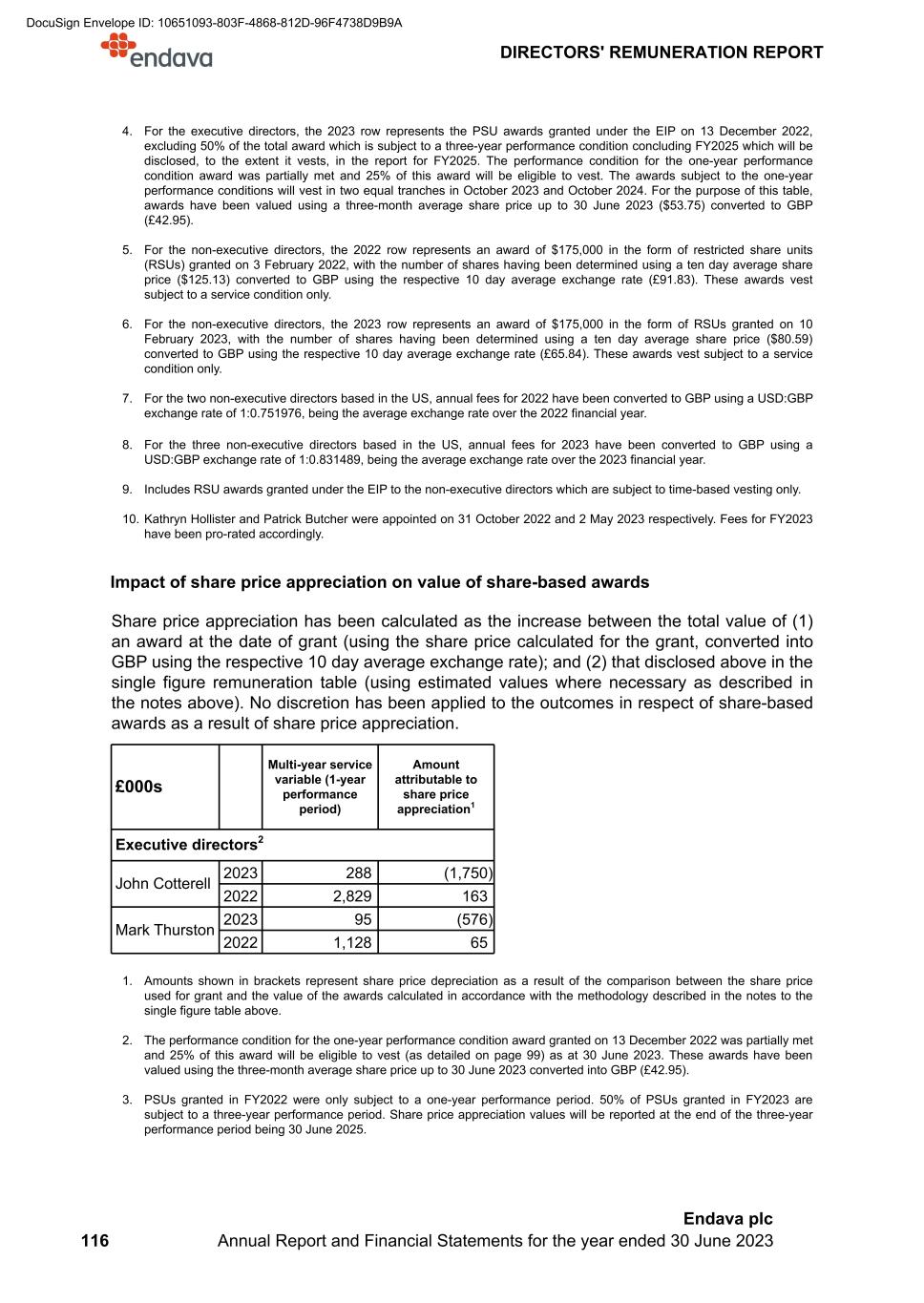
4. For the executive directors, the 2023 row represents the PSU awards granted under the EIP on 13 December 2022, excluding 50% of the total award which is subject to a three-year performance condition concluding FY2025 which will be disclosed, to the extent it vests, in the report for FY2025. The performance condition for the one-year performance condition award was partially met and 25% of this award will be eligible to vest. The awards subject to the one-year performance conditions will vest in two equal tranches in October 2023 and October 2024. For the purpose of this table, awards have been valued using a three-month average share price up to 30 June 2023 ($53.75) converted to GBP (£42.95). 5. For the non-executive directors, the 2022 row represents an award of $175,000 in the form of restricted share units (RSUs) granted on 3 February 2022, with the number of shares having been determined using a ten day average share price ($125.13) converted to GBP using the respective 10 day average exchange rate (£91.83). These awards vest subject to a service condition only. 6. For the non-executive directors, the 2023 row represents an award of $175,000 in the form of RSUs granted on 10 February 2023, with the number of shares having been determined using a ten day average share price ($80.59) converted to GBP using the respective 10 day average exchange rate (£65.84). These awards vest subject to a service condition only. 7. For the two non-executive directors based in the US, annual fees for 2022 have been converted to GBP using a USD:GBP exchange rate of 1:0.751976, being the average exchange rate over the 2022 financial year. 8. For the three non-executive directors based in the US, annual fees for 2023 have been converted to GBP using a USD:GBP exchange rate of 1:0.831489, being the average exchange rate over the 2023 financial year. 9. Includes RSU awards granted under the EIP to the non-executive directors which are subject to time-based vesting only. 10. Kathryn Hollister and Patrick Butcher were appointed on 31 October 2022 and 2 May 2023 respectively. Fees for FY2023 have been pro-rated accordingly. Impact of share price appreciation on value of share-based awards Share price appreciation has been calculated as the increase between the total value of (1) an award at the date of grant (using the share price calculated for the grant, converted into GBP using the respective 10 day average exchange rate); and (2) that disclosed above in the single figure remuneration table (using estimated values where necessary as described in the notes above). No discretion has been applied to the outcomes in respect of share-based awards as a result of share price appreciation. £000s Multi-year service variable (1-year performance period) Amount attributable to share price appreciation1 Executive directors2 John Cotterell 2023 288 (1,750) 2022 2,829 163 Mark Thurston 2023 95 (576) 2022 1,128 65 1. Amounts shown in brackets represent share price depreciation as a result of the comparison between the share price used for grant and the value of the awards calculated in accordance with the methodology described in the notes to the single figure table above. 2. The performance condition for the one-year performance condition award granted on 13 December 2022 was partially met and 25% of this award will be eligible to vest (as detailed on page 99) as at 30 June 2023. These awards have been valued using the three-month average share price up to 30 June 2023 converted into GBP (£42.95). 3. PSUs granted in FY2022 were only subject to a one-year performance period. 50% of PSUs granted in FY2023 are subject to a three-year performance period. Share price appreciation values will be reported at the end of the three-year performance period being 30 June 2025. DIRECTORS' REMUNERATION REPORT 116 Endava plc Annual Report and Financial Statements for the year ended 30 June 2023 DocuSign Envelope ID: 10651093-803F-4868-812D-96F4738D9B9A
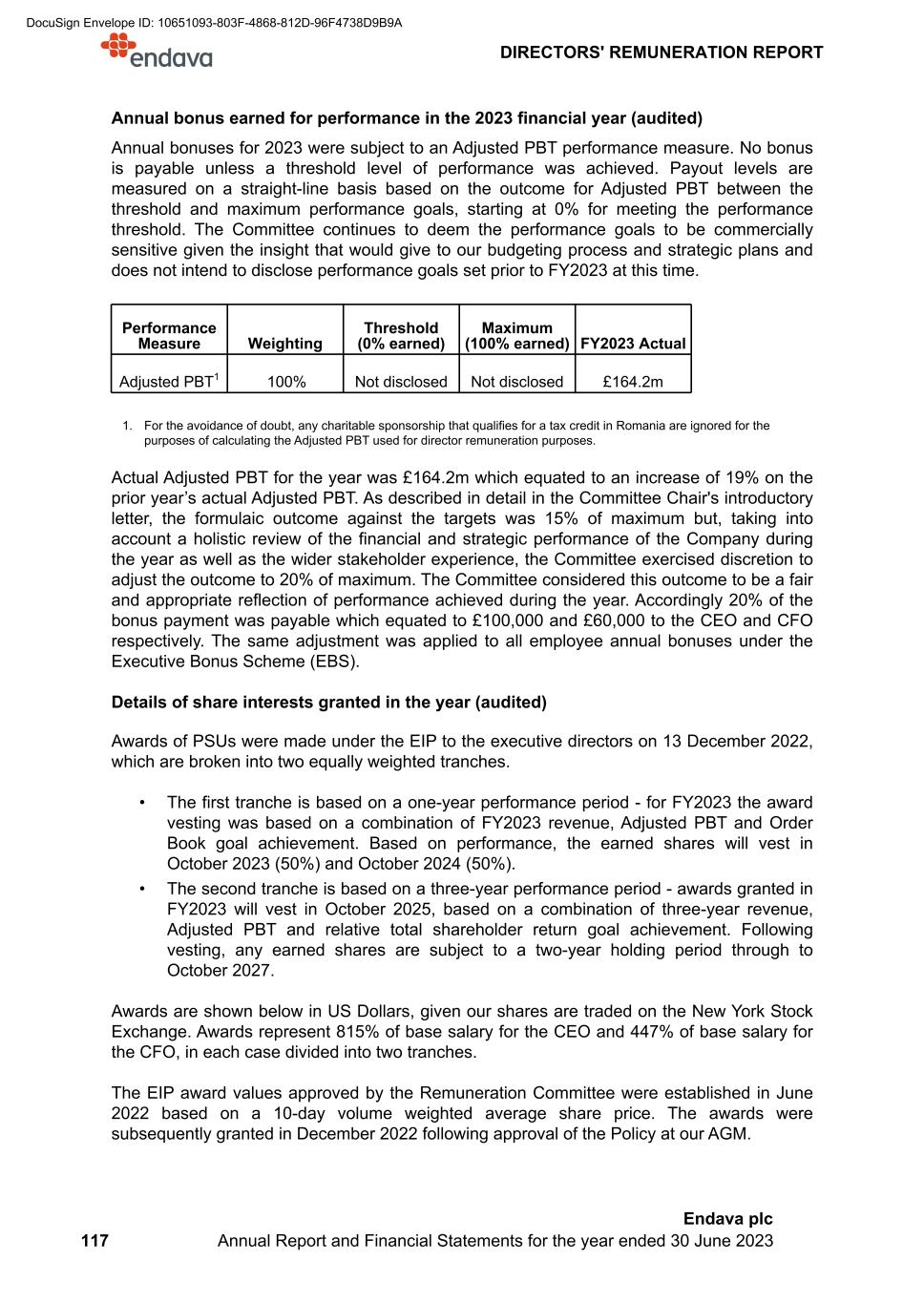
Annual bonus earned for performance in the 2023 financial year (audited) Annual bonuses for 2023 were subject to an Adjusted PBT performance measure. No bonus is payable unless a threshold level of performance was achieved. Payout levels are measured on a straight-line basis based on the outcome for Adjusted PBT between the threshold and maximum performance goals, starting at 0% for meeting the performance threshold. The Committee continues to deem the performance goals to be commercially sensitive given the insight that would give to our budgeting process and strategic plans and does not intend to disclose performance goals set prior to FY2023 at this time. Performance Measure Weighting Threshold (0% earned) Maximum (100% earned) FY2023 Actual Adjusted PBT1 100% Not disclosed Not disclosed £164.2m 1. For the avoidance of doubt, any charitable sponsorship that qualifies for a tax credit in Romania are ignored for the purposes of calculating the Adjusted PBT used for director remuneration purposes. Actual Adjusted PBT for the year was £164.2m which equated to an increase of 19% on the prior year’s actual Adjusted PBT. As described in detail in the Committee Chair's introductory letter, the formulaic outcome against the targets was 15% of maximum but, taking into account a holistic review of the financial and strategic performance of the Company during the year as well as the wider stakeholder experience, the Committee exercised discretion to adjust the outcome to 20% of maximum. The Committee considered this outcome to be a fair and appropriate reflection of performance achieved during the year. Accordingly 20% of the bonus payment was payable which equated to £100,000 and £60,000 to the CEO and CFO respectively. The same adjustment was applied to all employee annual bonuses under the Executive Bonus Scheme (EBS). Details of share interests granted in the year (audited) Awards of PSUs were made under the EIP to the executive directors on 13 December 2022, which are broken into two equally weighted tranches. • The first tranche is based on a one-year performance period - for FY2023 the award vesting was based on a combination of FY2023 revenue, Adjusted PBT and Order Book goal achievement. Based on performance, the earned shares will vest in October 2023 (50%) and October 2024 (50%). • The second tranche is based on a three-year performance period - awards granted in FY2023 will vest in October 2025, based on a combination of three-year revenue, Adjusted PBT and relative total shareholder return goal achievement. Following vesting, any earned shares are subject to a two-year holding period through to October 2027. Awards are shown below in US Dollars, given our shares are traded on the New York Stock Exchange. Awards represent 815% of base salary for the CEO and 447% of base salary for the CFO, in each case divided into two tranches. The EIP award values approved by the Remuneration Committee were established in June 2022 based on a 10-day volume weighted average share price. The awards were subsequently granted in December 2022 following approval of the Policy at our AGM. DIRECTORS' REMUNERATION REPORT 117 Endava plc Annual Report and Financial Statements for the year ended 30 June 2023 DocuSign Envelope ID: 10651093-803F-4868-812D-96F4738D9B9A
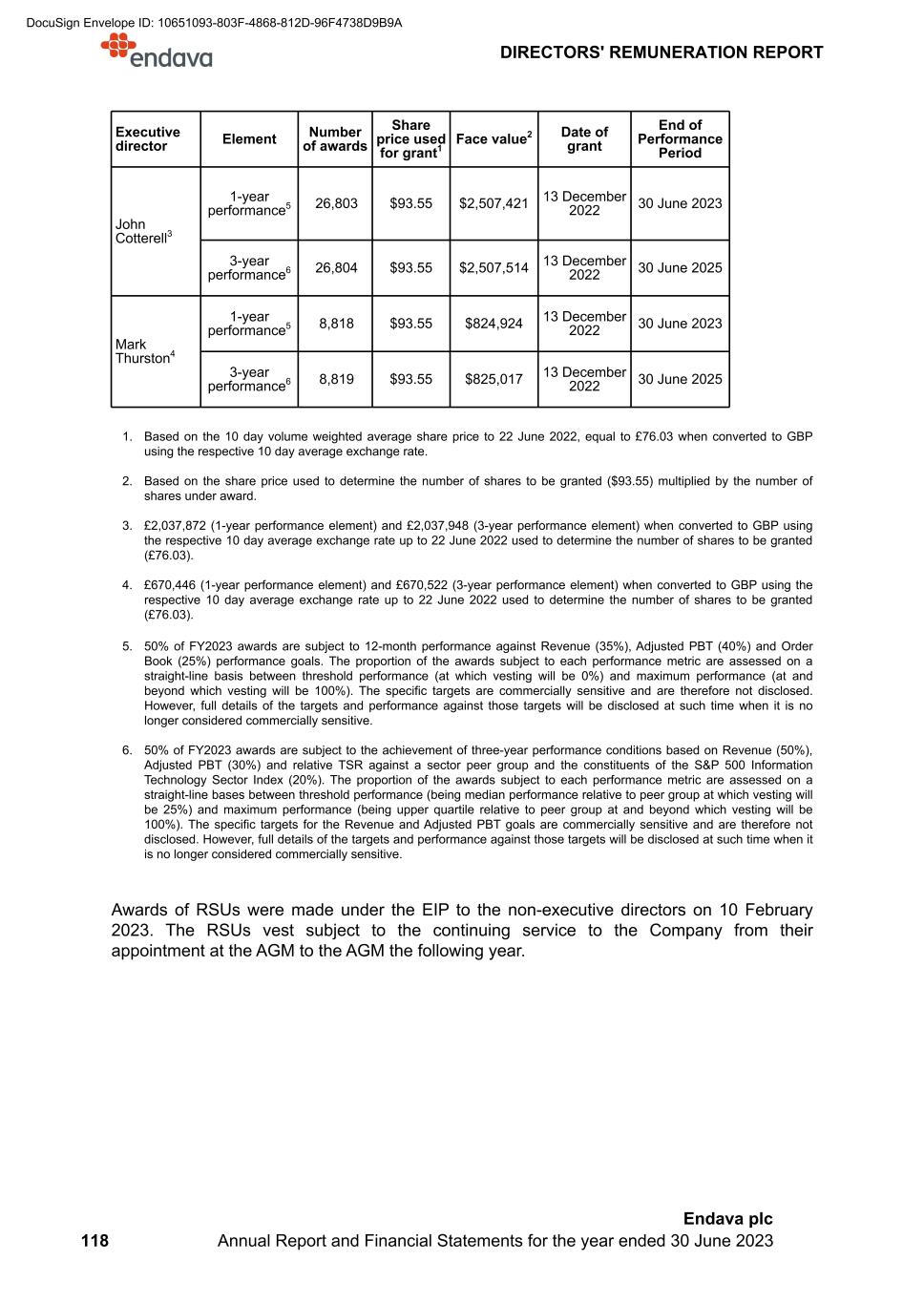
Executive director Element Number of awards Share price used for grant1 Face value2 Date of grant End of Performance Period John Cotterell3 1-year performance5 26,803 $93.55 $2,507,421 13 December 2022 30 June 2023 3-year performance6 26,804 $93.55 $2,507,514 13 December 2022 30 June 2025 Mark Thurston4 1-year performance5 8,818 $93.55 $824,924 13 December 2022 30 June 2023 3-year performance6 8,819 $93.55 $825,017 13 December 2022 30 June 2025 1. Based on the 10 day volume weighted average share price to 22 June 2022, equal to £76.03 when converted to GBP using the respective 10 day average exchange rate. 2. Based on the share price used to determine the number of shares to be granted ($93.55) multiplied by the number of shares under award. 3. £2,037,872 (1-year performance element) and £2,037,948 (3-year performance element) when converted to GBP using the respective 10 day average exchange rate up to 22 June 2022 used to determine the number of shares to be granted (£76.03). 4. £670,446 (1-year performance element) and £670,522 (3-year performance element) when converted to GBP using the respective 10 day average exchange rate up to 22 June 2022 used to determine the number of shares to be granted (£76.03). 5. 50% of FY2023 awards are subject to 12-month performance against Revenue (35%), Adjusted PBT (40%) and Order Book (25%) performance goals. The proportion of the awards subject to each performance metric are assessed on a straight-line basis between threshold performance (at which vesting will be 0%) and maximum performance (at and beyond which vesting will be 100%). The specific targets are commercially sensitive and are therefore not disclosed. However, full details of the targets and performance against those targets will be disclosed at such time when it is no longer considered commercially sensitive. 6. 50% of FY2023 awards are subject to the achievement of three-year performance conditions based on Revenue (50%), Adjusted PBT (30%) and relative TSR against a sector peer group and the constituents of the S&P 500 Information Technology Sector Index (20%). The proportion of the awards subject to each performance metric are assessed on a straight-line bases between threshold performance (being median performance relative to peer group at which vesting will be 25%) and maximum performance (being upper quartile relative to peer group at and beyond which vesting will be 100%). The specific targets for the Revenue and Adjusted PBT goals are commercially sensitive and are therefore not disclosed. However, full details of the targets and performance against those targets will be disclosed at such time when it is no longer considered commercially sensitive. Awards of RSUs were made under the EIP to the non-executive directors on 10 February 2023. The RSUs vest subject to the continuing service to the Company from their appointment at the AGM to the AGM the following year. DIRECTORS' REMUNERATION REPORT 118 Endava plc Annual Report and Financial Statements for the year ended 30 June 2023 DocuSign Envelope ID: 10651093-803F-4868-812D-96F4738D9B9A

Participant Number of awards Share price used for grant1 Face value2 Date of grant Date of vesting3 Trevor Smith 2,171 $80.59 $175,000 10 February 2023 December 2023 Andrew Allan 2,171 $80.59 $175,000 10 February 2023 December 2023 Ben Druskin 2,171 $80.59 $175,000 10 February 2023 December 2023 David Pattillo 2,171 $80.59 $175,000 10 February 2023 December 2023 Sulina Connal 2,171 $80.59 $175,000 10 February 2023 December 2023 Kathryn Hollister 2,171 $80.59 $175,000 10 February 2023 December 2023 1. Based on the 10 day average share price up to 23 January 2023 used to determine the number of shares to be granted (equal to £65.84 when converted to GBP using the respective 10 day average exchange rate). 2. Based on the share price used to determine the number of shares to be granted ($80.59) multiplied by the number of shares under award. 3. Awards vest on 31 October 2023 or, if later, the date of the 2023 AGM (actual date to be confirmed), and will therefore vest (provisionally) on 14 December 2023. EIP awards vesting based on performance to 30 June 2023 (audited) PSU awards made on 13 December 2022 under the EIP were subject to three independently assessed performance metrics: Revenue (35% weighting), Adjusted PBT (40% weighting) and Order Book (25% weighting). Performance goals were established at the outset for threshold and maximum, to be measured over FY2023. Vesting is calculated on a straight- line basis between these two points, with 0% of EIP awards vesting for threshold performance, increasing to 100% for achieving or exceeding the maximum performance goals (calibrated to represent a significant stretch beyond budgeted levels of performance). Performance Measure Weighting Threshold (0% earned) Maximum (100% earned) FY2023 Actual Revenue 35% Not disclosed Not disclosed £794.7m Adjusted PBT 40% Not disclosed Not disclosed £164.2m Order Book 25% Not disclosed Not disclosed Not disclosed As described in detail in the Committee Chair's introductory letter, the formulaic outcome against the targets was 12% of maximum but, taking into account a holistic review of the financial and strategic performance of the Company during the year as well as the wider stakeholder experience, the Committee exercised discretion to adjust the outcome to 25% of maximum. The Committee considered this outcome to be a fair and appropriate reflection of performance achieved during the year. Accordingly, 25% of these awards will vest. The same adjustment has been applied to all holders of these awards. The first tranche of the PSU awards, subject to the one-year performance conditions will vest in equal tranches on 31 October 2023 and 31 October 2024, with the remaining tranche, subject to achievement of three-year performance conditions, vesting on 31 October 2025. No three-year EIP awards of PSUs vested during the year. The awards made on 13 December 2022 subject to three-year performance conditions and a two-year holding period will vest, subject to the level of performance achievement, in October 2025. DIRECTORS' REMUNERATION REPORT 119 Endava plc Annual Report and Financial Statements for the year ended 30 June 2023 DocuSign Envelope ID: 10651093-803F-4868-812D-96F4738D9B9A
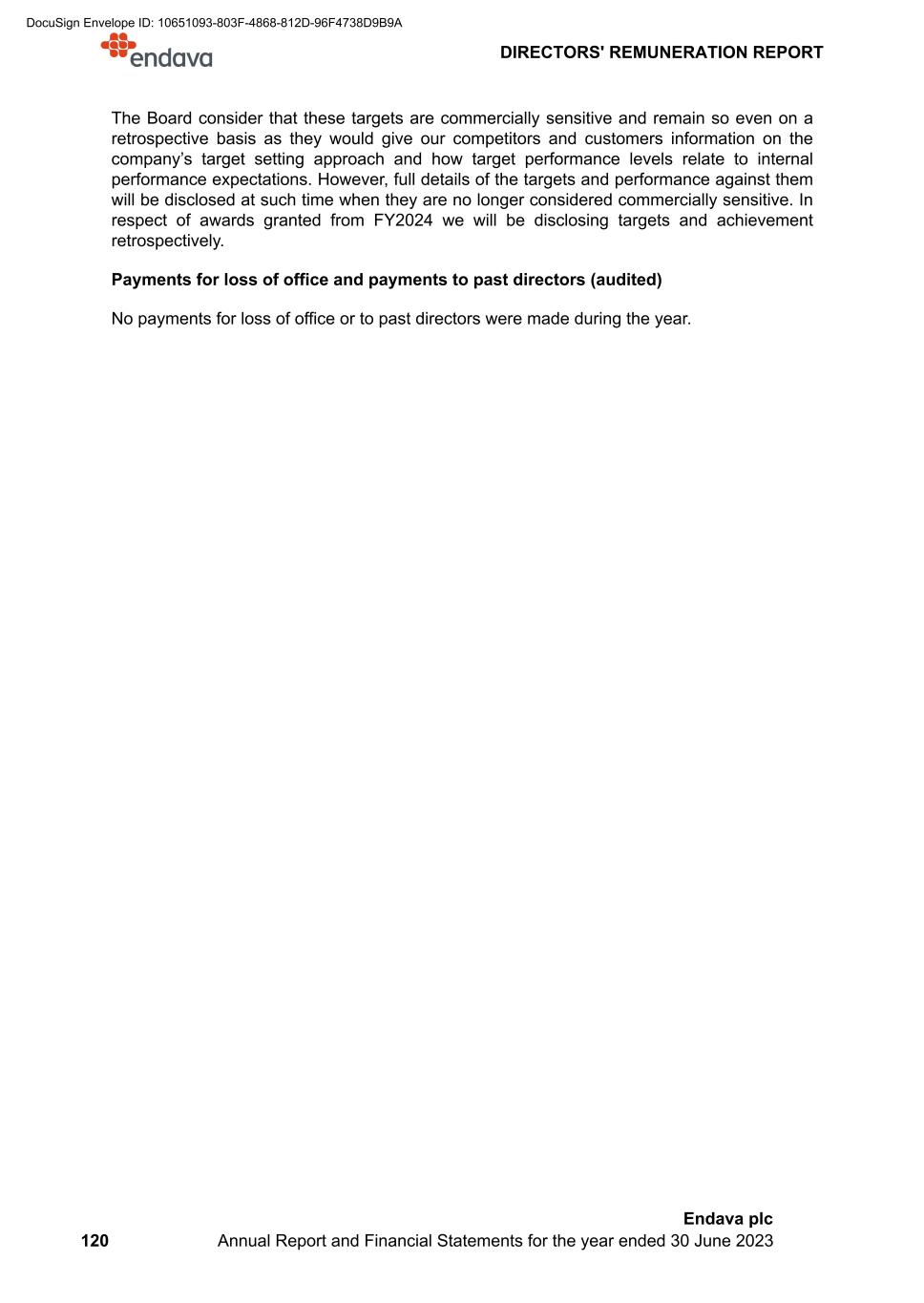
The Board consider that these targets are commercially sensitive and remain so even on a retrospective basis as they would give our competitors and customers information on the company’s target setting approach and how target performance levels relate to internal performance expectations. However, full details of the targets and performance against them will be disclosed at such time when they are no longer considered commercially sensitive. In respect of awards granted from FY2024 we will be disclosing targets and achievement retrospectively. Payments for loss of office and payments to past directors (audited) No payments for loss of office or to past directors were made during the year. DIRECTORS' REMUNERATION REPORT 120 Endava plc Annual Report and Financial Statements for the year ended 30 June 2023 DocuSign Envelope ID: 10651093-803F-4868-812D-96F4738D9B9A

Executive directors’ share awards outstanding at the 2023 financial year end (audited) Award type Held at 30 June 2022 Grante d in year Lapse d in year Vested in year Held at 30 June 2023 Date of grant Option price Market price on settlem ent date (1) Vest date Date of expiry John Cotterell FY2019 EIP PSU(2) 22,500 — — 22,500 — 26 July 2018 — £62.96 31 October 2019(3) N/A FY2020 EIP PSU(4) 27,894 — — 13,947 13,947 31 July 2019 — £62.96 31 October 2020(5) N/A FY2021 EIP PSU(6) 34,020 — — 11,340 22,680 16 September 2020 — £62.96 31 October 2021(7) N/A FY2022 EIP PSU(8) 35,713 — — 8,928 26,785 9 August 2021 — 62.96 31 October 2022(9) N/A FY2023 EIP PSU(10) — 53,607 20,103 — 33,504 13 December 2022 — n/a 31 October 2023(11) N/A FY2022 SSP(12) 82 — — — 82 5 November 2021 £92 n/a 1 December 2024 1 December 2031 FY2023 SSP(12) — 155 — — 155 24 November 2022 £57.4 n/a 1 December 2025 1 December 2032 Mark Thurston FY2019 EIP PSU(2) 11,250 — — 11,250 — 26 July 2018 — £57.38 31 October 2019(3) N/A FY2020 EIP PSU(4) 13,948 — — 6,974 6,974 31 July 2019 — £57.38 31 October 2020(5) N/A FY2021 EIP PSU(6) 17,010 — — 5,670 11,340 16 September 2020 — £57.38 31 October 2021(7) N/A FY2022 EIP PSU(8) 14,243 — — 3,560 10,683 9 August 2021 — 57.38 31 October 2022(9) N/A FY2023 EIP PSU(10) — 17,637 6,614 — 11,023 13 December 2022 — n/a 31 October 2023(11) N/A FY2022 SSP(12) 82 — — — 82 5 November 2021 £92 n/a 1 December 2024 1 December 2031 FY2023 SSP(12) — 155 — — 155 24 November 2022 £57.4 n/a 1 December 2025 1 December 2032 1. Converted to GBP using the prevailing exchange rate on the date of settlement. 2. These awards were subject to a PBT performance condition over the 2019 financial year as described in the 2019 remuneration report. The performance condition was met in full and as such 100% of this award vested. 3. Fully vested. 4. These awards were subject to a PBT performance condition over the 2020 financial year as described in the 2020 remuneration report. The performance condition was met in full and as such 100% of this award vested. 5. Awards vest in four equal tranches from 31 October 2020 to 31 October 2023. DIRECTORS' REMUNERATION REPORT 121 Endava plc Annual Report and Financial Statements for the year ended 30 June 2023 DocuSign Envelope ID: 10651093-803F-4868-812D-96F4738D9B9A

6. These awards were subject to multiple weighted performance metrics over the 2021 financial year. The performance conditions were met in full and as such 100% of this award vested. The specific targets are commercially sensitive and therefore are not disclosed prospectively. However, full details of the target and performance against that target will be disclosed at such time when it is no longer considered commercially sensitive. 7. Awards vest in four equal tranches from 31 October 2021 to 31 October 2024. 8. These awards were subject to multiple weighted performance metrics over the 2022 financial year. The performance conditions were met in full and as such 100% of this award vested. The specific targets are commercially sensitive and therefore are not disclosed prospectively. However, full details of the target and performance against that target will be disclosed at such time when it is no longer considered commercially sensitive. 9. Awards vest in four equal tranches from 31 October 2022 to 31 October 2025. 10. These awards were subject to multiple weighted performance metrics over the 2023 financial year. The one-year performance conditions were partially met and 25% of this award will be eligible to vest. The specific targets are commercially sensitive and therefore are not disclosed prospectively. However, full details of the target and performance against that target will be disclosed at such time when it is no longer considered commercially sensitive. 11. Awards subject to the one-year performance condition vest in equal tranches on 31 October 2023 and 31 October 2024. Awards subject to the three-year performance condition vest on 31 October 2025. 12. Discounted 'Share Success' options granted under the 2018 Equity Incentive Plan to all eligible employees, maturing on 1 December 2024 and subject to continued employment only. Non-discounted Share Success' options granted under the 2018 Equity Incentive Plan to all eligible employees, maturing on 1 December 2025 and subject to continued employment only. Directors’ current shareholdings and interests in shares (audited) The table below provides details on the directors' current shareholdings as well as their interests in outstanding share awards as at 30 June 2023. Unconditionally- owned shares1 Shareholding guideline (% base salary) Percentage of salary/fees applicable to share ownership requirement2 Share Award Share Options8 EIP (unvested; still subject to performance) EIP (unvested; subject only to service condition) SSP (unvested options; not subject to performance) Total Executive directors John Cotterell 8,991,2363 300% 74109% 26,8044 70,1125 237 97,153 Mark Thurston 32,355 300% 671% 8,8194 31,2015 237 40,257 Non-executive directors Shareholding guideline ($ value)6 % guideline met7 Trevor Smith 71,293 $ 300,000 1268% 2,171 — 2,171 Andrew Allan 220,000 $ 300,000 3835% 2,171 — 2,171 Ben Druskin 47,177 $ 300,000 852% 2,171 — 2,171 David Pattillo 31,677 $ 300,000 584% 2,171 — 2,171 Sulina Connal 3,007 $ 300,000 89% 2,171 — 2,171 Kathryn Hollister — $ 300,000 37% 2,171 — 2,171 Patrick Butcher — $ 300,000 0% — — — 1. Represents shares in which no connected persons hold any interests. 2. This value includes all unconditionally-owned shares, plus the value of outstanding tranches of prior EIP awards that are subject to service conditions only (on a net of tax basis), valued using the share price on 30 June 2023 ($51.79) converted DIRECTORS' REMUNERATION REPORT 122 Endava plc Annual Report and Financial Statements for the year ended 30 June 2023 DocuSign Envelope ID: 10651093-803F-4868-812D-96F4738D9B9A
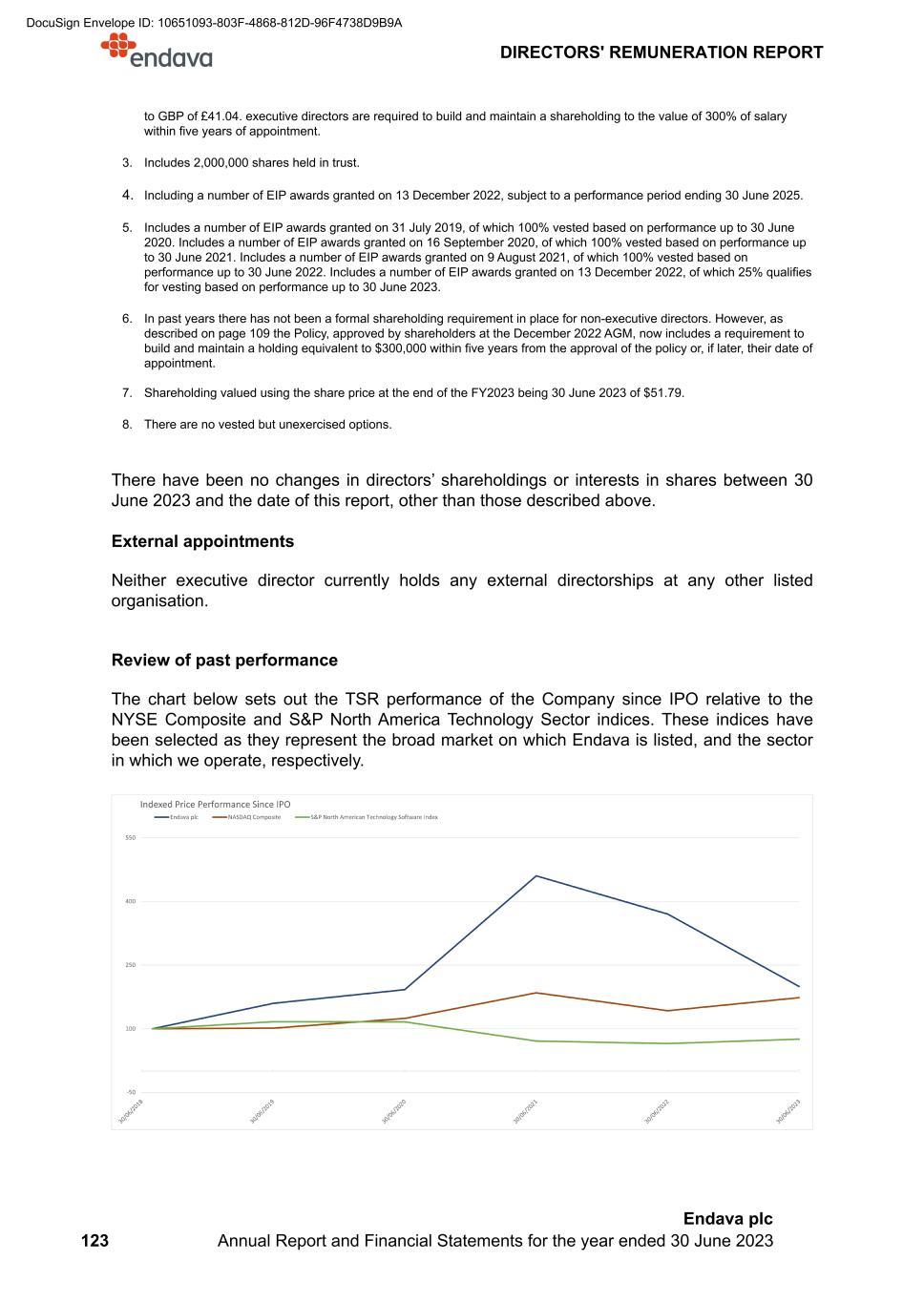
to GBP of £41.04. executive directors are required to build and maintain a shareholding to the value of 300% of salary within five years of appointment. 3. Includes 2,000,000 shares held in trust. 4. Including a number of EIP awards granted on 13 December 2022, subject to a performance period ending 30 June 2025. 5. Includes a number of EIP awards granted on 31 July 2019, of which 100% vested based on performance up to 30 June 2020. Includes a number of EIP awards granted on 16 September 2020, of which 100% vested based on performance up to 30 June 2021. Includes a number of EIP awards granted on 9 August 2021, of which 100% vested based on performance up to 30 June 2022. Includes a number of EIP awards granted on 13 December 2022, of which 25% qualifies for vesting based on performance up to 30 June 2023. 6. In past years there has not been a formal shareholding requirement in place for non-executive directors. However, as described on page 109 the Policy, approved by shareholders at the December 2022 AGM, now includes a requirement to build and maintain a holding equivalent to $300,000 within five years from the approval of the policy or, if later, their date of appointment. 7. Shareholding valued using the share price at the end of the FY2023 being 30 June 2023 of $51.79. 8. There are no vested but unexercised options. There have been no changes in directors’ shareholdings or interests in shares between 30 June 2023 and the date of this report, other than those described above. External appointments Neither executive director currently holds any external directorships at any other listed organisation. Review of past performance The chart below sets out the TSR performance of the Company since IPO relative to the NYSE Composite and S&P North America Technology Sector indices. These indices have been selected as they represent the broad market on which Endava is listed, and the sector in which we operate, respectively. DIRECTORS' REMUNERATION REPORT 123 Endava plc Annual Report and Financial Statements for the year ended 30 June 2023 DocuSign Envelope ID: 10651093-803F-4868-812D-96F4738D9B9A

The chart shows the value, by 30 June 2023, of $100 invested in Endava on IPO, compared with the value of $100 invested in the NYSE Composite and S&P North American Technology Sector Indices on the same date. The table below shows the total remuneration received by the Chief Executive Officer over the same period. FY20232 FY2022 FY2021 FY20201 FY2019 Single total figure of remuneration (£000s) £949 £3,677 £4,442 £2,744 £3,094 Annual bonus (% of maximum) 20% 100% 100% 100% 100% EIP payout (% of maximum) 25% 100% 100% 100% 100% JSOP payout (% of maximum) N/A N/A N/A N/A3 100% 1. The reduction in the single figure payable to John Cotterell between FY2019 and FY2020 is explained in part by the effect of share price appreciation on the value of his PSU awards. 2. The reduction in the single figure payable to John Cotterell between FY2022 and FY2023 is explained in part by the exclusion of 50% of the total EIP award which is subject to a three-year performance condition concluding FY2025. 3. The Joint Share Ownership Plan (JSOP) is a legacy plan from pre-IPO. No further interests in shares resulting from the JSOP plan were acquired in FY2020 and no further JSOP interests are held by John Cotterell. CEO pay ratio UK legislation requires the publishing of the ratio of total remuneration of the Chief Executive Officer to the 25th, 50th and 75th percentiles of UK full-time equivalent colleagues. This is the first year that this information has been reported as the UK population has exceeded the threshold of 250 employees for the second year in a row. The ratios are shown in the table below: Year Methodology 25th percentile pay ratio 50th percentile pay ratio 75th percentile pay ratio FY23 Option A 15.8:1 9.4:1 6.5:1 Of the three calculation approaches available under the regulations, the CEO pay ratio figures have been calculated using ‘option A’, which uses total full-time equivalent total remuneration for all UK employees for the relevant financial year to rank the data and identify UK employees whose remuneration places them at the 25th, 50th and 75th percentiles. This approach was chosen as the Committee believes it to be the most appropriate and robust way for the Company to calculate the ratio. Employee pay was calculated based on actual pay and benefits for the 12 monthly payrolls in respect of the full financial year to 30 June 2023 and is calculated with respect to 30 June 2023. The table below sets out the salary and total remuneration for the three identified quartile point employees: DIRECTORS' REMUNERATION REPORT 124 Endava plc Annual Report and Financial Statements for the year ended 30 June 2023 DocuSign Envelope ID: 10651093-803F-4868-812D-96F4738D9B9A

Year Remuneration CEO 25th percentile 50th percentile 75th Percentile 2023 Base Salary £500,000 £54,697 £91,696 £119,600 Total Remuneration £948,693 £59,881 £100,792 £145,331 The Remuneration Committee has reviewed the results of the calculations and is satisfied that the ratios are appropriate and consistent with the relative roles and responsibilities of the CEO and UK employees and with the pay, reward and progression policies for the Company’s employees taken as a whole. A significant portion of the CEO remuneration is delivered through variable incentives where pay outcomes are linked to business performance over a longer term. This means that ratios may fluctuate year to year. DIRECTORS' REMUNERATION REPORT 125 Endava plc Annual Report and Financial Statements for the year ended 30 June 2023 DocuSign Envelope ID: 10651093-803F-4868-812D-96F4738D9B9A

Percentage change in remuneration of the directors compared to all Company employees The table below illustrates the increase in salary, benefits and annual bonus for each director and that of the Company’s employees as a whole as between financial years 2019 to 2023. Percentage change FY2022-FY2023 Percentage change FY2021-FY2022 Percentage change FY2020-FY2021 Percentage change FY2019-FY2020 Director Salary/ fee Benefits Bonus Salary/ fee Benefits Bonus Salary/ fee Benefits Bonus Salary/ fee Benefits Bonus John Cotterell 0% (2)% (80)% 43% 0% 55% 0% 0% (3)% 0% 0% 28% Mark Thurston 20% 3% (78)% 11% 1% 80% 0% 0% 2% 0% (65)%1 23% Trevor Smith 0% n/a n/a 25% n/a n/a 0% n/a n/a 0% n/a n/a Andrew Allan 0% n/a n/a 0% n/a n/a 0% n/a n/a 0% n/a n/a Ben Druskin2 11% n/a n/a 1% n/a n/a (6)% n/a n/a 0% n/a n/a David Pattillo2 11% n/a n/a 1% n/a n/a (6)% n/a n/a 0% n/a n/a Sulina Connal 0% n/a n/a 0% n/a n/a 31%3 n/a n/a n/a n/a n/a Patrick Butcher4 n/a n/a n/a n/a n/a n/a n/a n/a n/a n/a n/a n/a Kathryn Hollister4 n/a n/a n/a n/a n/a n/a n/a n/a n/a n/a n/a n/a Employees as a whole5 1.8% 3% (80.4)% 4% 3.4% 7% 5% 4% 8% 2.8% 3.6% 2.1% 1. The reduction in the benefits payable to Mark Thurston between FY2019 and FY2020 is explained by the effect of a one- off payment made in FY2019 of £18,800 in lieu of accrued but untaken holiday in the year of the Company’s IPO. Excluding this one-off payment, the percentage change in benefits for Mark Thurston would be 0%. 2. The amount of fees payable to Ben Druskin and David Pattillo did not change between FY2020 and FY2021, FY2021 and FY2022 and FY2022 and FY2023. The percentage change disclosed above is attributable to the change in the USD to GBP average exchange rate from FY2020 to FY2021, FY2021 to FY2022 and FY2022 to FY2023 (which has been used to convert USD fees into GBP). 3. Sulina Connal joined the Endava Board in September 2019. Her fees for FY2020 were therefore reduced on a pro-rata basis to reflect the part of the year for which she was in service. This shows an artificial increase in fees when compared against a full year of service for FY2021, although the annualised fee amount did not change. 4. Kathryn Hollister and Patrick Butcher were appointed during FY2023 and therefore, there is no comparator data disclosable for fees, benefits and bonus. 5. Endava plc does not employ any employees and therefore no comparator data is available for that population. The above information is provided in relation to the employees of Endava (UK) Limited, the subsidiary employing all UK employees, including our executive directors. Relative importance of spend on pay The table below shows the total pay for all of the Company’s employees compared to other key financial metrics. As the Company has not paid any dividends and does not have other significant relevant costs for these purposes, revenue and Adjusted PBT are disclosed as these are key financial metrics which give an indication of the changing size of the business as compared to employee costs. These figures are taken from audited financial statements included within this annual report. DIRECTORS' REMUNERATION REPORT 126 Endava plc Annual Report and Financial Statements for the year ended 30 June 2023 DocuSign Envelope ID: 10651093-803F-4868-812D-96F4738D9B9A
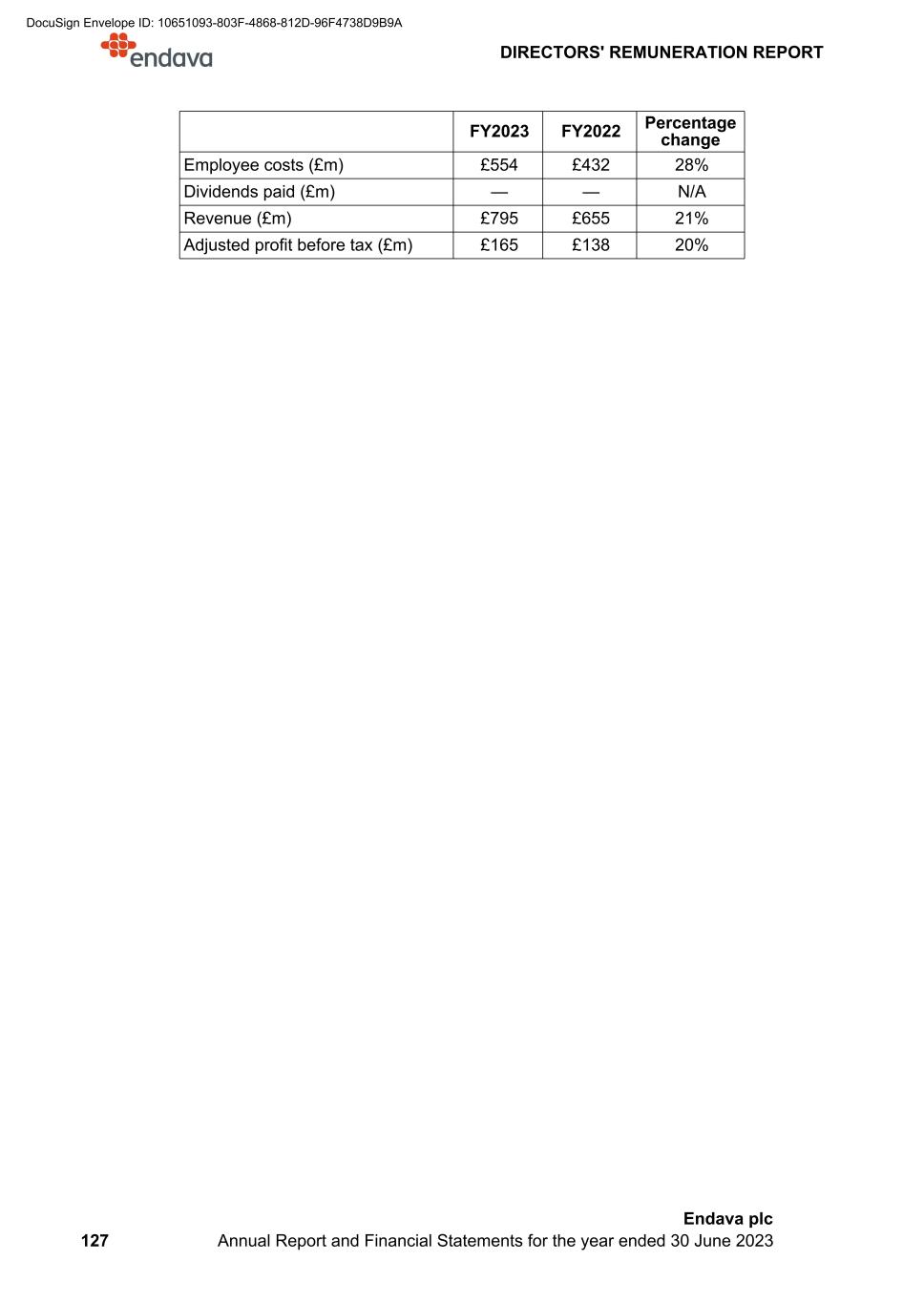
FY2023 FY2022 Percentage change Employee costs (£m) £554 £432 28% Dividends paid (£m) — — N/A Revenue (£m) £795 £655 21% Adjusted profit before tax (£m) £165 £138 20% DIRECTORS' REMUNERATION REPORT 127 Endava plc Annual Report and Financial Statements for the year ended 30 June 2023 DocuSign Envelope ID: 10651093-803F-4868-812D-96F4738D9B9A
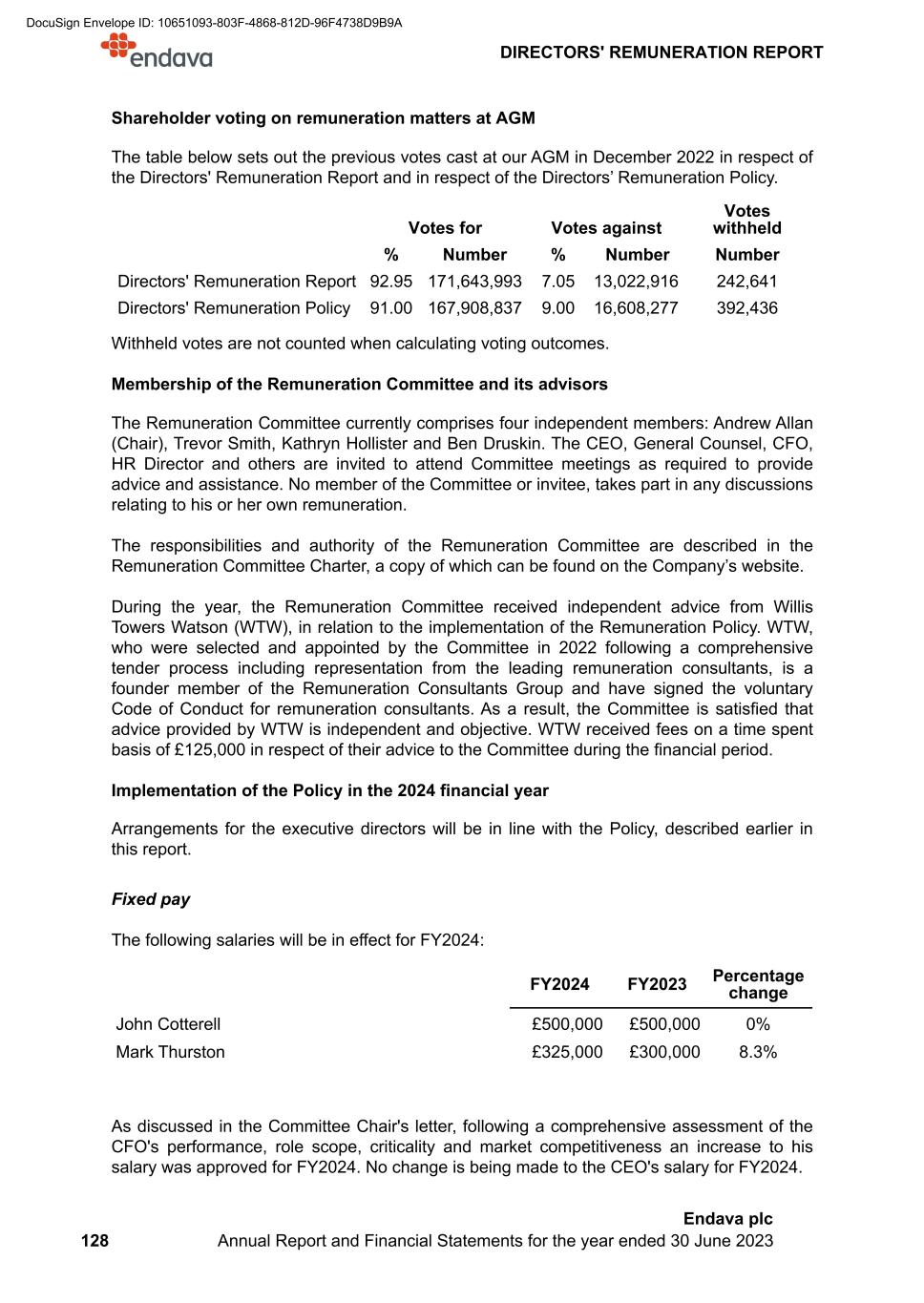
Shareholder voting on remuneration matters at AGM The table below sets out the previous votes cast at our AGM in December 2022 in respect of the Directors' Remuneration Report and in respect of the Directors’ Remuneration Policy. Votes for Votes against Votes withheld % Number % Number Number Directors' Remuneration Report 92.95 171,643,993 7.05 13,022,916 242,641 Directors' Remuneration Policy 91.00 167,908,837 9.00 16,608,277 392,436 Withheld votes are not counted when calculating voting outcomes. Membership of the Remuneration Committee and its advisors The Remuneration Committee currently comprises four independent members: Andrew Allan (Chair), Trevor Smith, Kathryn Hollister and Ben Druskin. The CEO, General Counsel, CFO, HR Director and others are invited to attend Committee meetings as required to provide advice and assistance. No member of the Committee or invitee, takes part in any discussions relating to his or her own remuneration. The responsibilities and authority of the Remuneration Committee are described in the Remuneration Committee Charter, a copy of which can be found on the Company’s website. During the year, the Remuneration Committee received independent advice from Willis Towers Watson (WTW), in relation to the implementation of the Remuneration Policy. WTW, who were selected and appointed by the Committee in 2022 following a comprehensive tender process including representation from the leading remuneration consultants, is a founder member of the Remuneration Consultants Group and have signed the voluntary Code of Conduct for remuneration consultants. As a result, the Committee is satisfied that advice provided by WTW is independent and objective. WTW received fees on a time spent basis of £125,000 in respect of their advice to the Committee during the financial period. Implementation of the Policy in the 2024 financial year Arrangements for the executive directors will be in line with the Policy, described earlier in this report. Fixed pay The following salaries will be in effect for FY2024: FY2024 FY2023 Percentage change John Cotterell £500,000 £500,000 0% Mark Thurston £325,000 £300,000 8.3% As discussed in the Committee Chair's letter, following a comprehensive assessment of the CFO's performance, role scope, criticality and market competitiveness an increase to his salary was approved for FY2024. No change is being made to the CEO's salary for FY2024. DIRECTORS' REMUNERATION REPORT 128 Endava plc Annual Report and Financial Statements for the year ended 30 June 2023 DocuSign Envelope ID: 10651093-803F-4868-812D-96F4738D9B9A

Under the current Policy, executive director pension levels are aligned with the level available to the broader employee population with effect from 1 January 2023 – currently 7.5% of base salary. The CEO receives a cash allowance in lieu of pension and, taking into account a downward adjustment for the increased employer National Insurance contributions, receives an amount equal to 6.47% of salary. The CFO receives a pension contribution via salary sacrifice and, taking into account an upward adjustment for the reduced employer National Insurance contributions, receives a contribution equal to 8.02% of salary. Both of these adjustments are in line with adjustments made to pension benefits for other UK employees. No changes will be made to the provision of other benefits. Annual bonus Opportunities under the EBS for 2024 will be unchanged at 100% of salary for both the CEO and CFO. Performance will continue to be assessed solely on the achievement of Adjusted PBT goals. For a threshold level of performance, 0% of the bonus opportunity will be earned. For a maximum level of performance and above, 100% of the bonus opportunity will be earned. For performance between these points, the payout level will be determined on a straight-line basis. Performance Measure Weighting Threshold (0% earned) Maximum (100% earned) Adjusted PBT 100% Not disclosed Not disclosed The Board has concluded that due to the nature of the performance measures used, the performance targets are deemed commercially sensitive at the start of the performance period. However, the specific targets and achievement against the targets in relation to FY2024 will be disclosed retrospectively in the 2024 Annual Report. Long-term incentives The executive directors were granted performance share unit awards under the EIP in July 2023 over 95,396 shares (787% of salary) for the CEO and 36,142 shares (459% of salary) for the CFO. The numbers of shares making up these awards has been determined based on the DAVA.NYSE volume weighted average share price in the ten days up to 12 July 2023 ($52.57) converted to GBP to ensure the CEO and CFO’s awards are determined based on terms that are consistent with other participants. FY2024 FY2023 Salary EIP Award EIP Award Value (£) % of base salary Salary EIP Award EIP Award Value (£) % of base salary John Cotterell (CEO) £ 500,000 95,396 £3,934,7111 787 % £ 500,000 53,6073 £4,075,8202 815 % Mark Thurston (CFO) £ 325,000 36,142 £1,490,7161 459 % £ 300,000 17,6373 £1,340,9672 447 % 1. Based on the 10-day volume weighted average share price to 12 July 2023 ($52.57) used to determine the number of shares to be granted (when converted to GBP using the respective 10-day average exchange rate, share price of £41.25). 2. Based on the 10-day volume weighted average share price to 22 June 2022 ($93.55) used to determine the number of shares to be granted (when converted to GBP using the respective 10-day average exchange rate, share price of £76.03). DIRECTORS' REMUNERATION REPORT 129 Endava plc Annual Report and Financial Statements for the year ended 30 June 2023 DocuSign Envelope ID: 10651093-803F-4868-812D-96F4738D9B9A

3. Figures for the FY2023 award have been updated due to the numbers disclosed in the FY2022 report being incorrect due to a typographical error. Awards are split equally into two tranches. One-year performance period with vesting over two years Awards will be subject to 12-month performance against constant currency revenue growth % (40%), Adjusted PBT margin % (40%) and Order Book (20%) performance goals. The proportion of the awards vesting will be independently assessed on a straight-line basis between threshold performance (at which vesting will be 0%) and maximum performance (at and beyond which vesting will be 100%). One-year Performance Measure Weighting Threshold (0% vests) Maximum (100% vests) Revenue Growth % (constant currency) 40% Not disclosed Not disclosed Adjusted PBT margin % 40% Not disclosed Not disclosed Order Book 20% Not disclosed Not disclosed The Board has concluded that due to the nature of the performance measures used, the performance targets are commercially sensitive at the start of the performance period. However, the specific targets and achievement against the targets in relation to FY2024 will be disclosed retrospectively in the 2024 Annual Report. Awards will vest, subject to the level of performance achievement, in two equal tranches in October 2024 and October 2025. Three-year performance period with a subsequent two-year holding period Awards will be subject to the achievement of three-year performance conditions based on revenue (50%), Adjusted PBT margin % (30%), relative TSR against a sector peer group (10%) and the constituents of the S&P 500 Information Technology Sector Index (10%). The selected performance measures reflect our key priorities to drive profitable growth across Endava. Relative TSR allows us to assess how the value we are creating over a multi-year period compares to our peers. Three-year Performance Measure Weighting Threshold (25% vests) Maximum (100% vests) Revenue 50% Not disclosed Not disclosed Adjusted PBT margin % 30% Not disclosed Not disclosed Relative TSR - sector group (see below) 10% Median Upper quartile Relative TSR - S&P 500 Information Technology Sector Index 10% Median Upper quartile The Board has concluded that due to the nature of the non-TSR performance measures used, the performance targets are commercially sensitive during the performance period. However, the specific targets and achievement against the targets will be disclosed retrospectively in the 2026 Annual Report. DIRECTORS' REMUNERATION REPORT 130 Endava plc Annual Report and Financial Statements for the year ended 30 June 2023 DocuSign Envelope ID: 10651093-803F-4868-812D-96F4738D9B9A

The Compensation Peer Group, as previously approved by the Remuneration Committee, is used to both understand the competitiveness of remuneration and compare our relative TSR performance. Following Aveva's acquisition by Schneider Electric they have been removed from the peer group for 2024. Accenture Exponent Kainos Group Booz Allen Hamilton FTI Consulting Mindtree Limited Capgemini Globant S.A. Perficient CGI Grid Dynamics Tata Consultancy Services Limited CI&T HCL Technologies Thoughtworks Holding Cognizant Technology Solutions Huron Consulting Group Wipro Limited EPAM Systems Infosys Limited Vested shares will be subject to a further two-year holding period in order to continue to align participants with the shareholder experience and promote a focus on sustainable performance. Shareholding requirements The executive directors are required to build and maintain a share ownership requirement of 300% of salary. In addition to the share ownership requirement, a post-employment shareholding requirement applies under which executive directors will be required to continue to hold shares equivalent to the lower of the shareholding at termination or 300% of base salary for a period of two years after leaving employment. Non-executive director fees No changes are proposed to non-executive directors’ fees for FY24, which will be as per the table below. Non-executive directors are required to hold shares worth $300,000. A five-year time horizon is permitted for compliance. Cash retainer Equity retainer Board Chair £75,000 $175,000 Board Member £55,000 $175,000 Audit Committee additional fee £6,000 0 Clawback The Committee shall make any required amendments to the malus and clawback policy or adopt a new Dodd-Frank compliant policy as required by the SEC and NYSE. DIRECTORS' REMUNERATION REPORT 131 Endava plc Annual Report and Financial Statements for the year ended 30 June 2023 DocuSign Envelope ID: 10651093-803F-4868-812D-96F4738D9B9A

On behalf of the Board Andrew Allan, Remuneration Committee Chair 19 September 2023 DIRECTORS' REMUNERATION REPORT 132 Endava plc Annual Report and Financial Statements for the year ended 30 June 2023 DocuSign Envelope ID: 10651093-803F-4868-812D-96F4738D9B9A
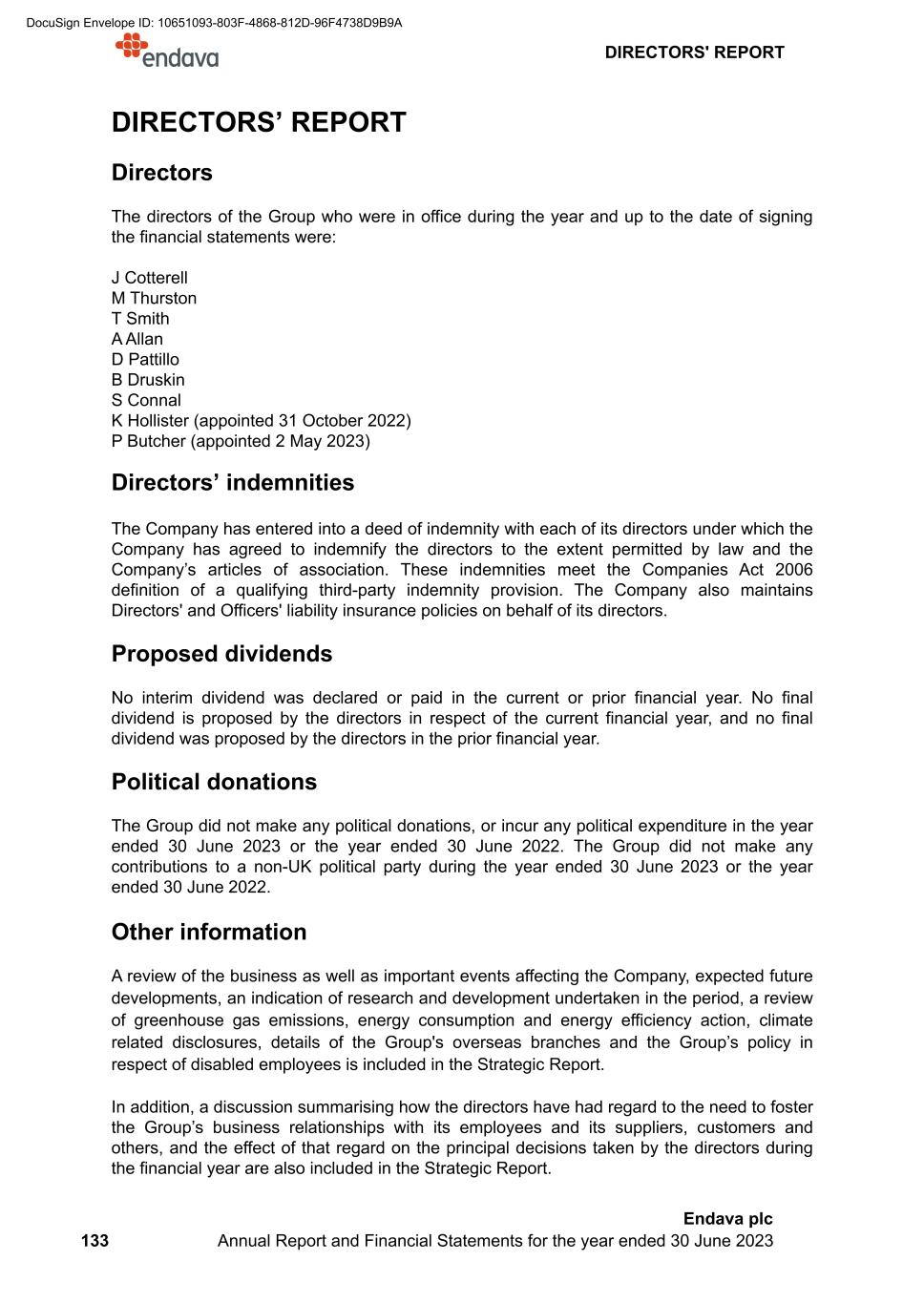
DIRECTORS’ REPORT Directors The directors of the Group who were in office during the year and up to the date of signing the financial statements were: J Cotterell M Thurston T Smith A Allan D Pattillo B Druskin S Connal K Hollister (appointed 31 October 2022) P Butcher (appointed 2 May 2023) Directors’ indemnities The Company has entered into a deed of indemnity with each of its directors under which the Company has agreed to indemnify the directors to the extent permitted by law and the Company’s articles of association. These indemnities meet the Companies Act 2006 definition of a qualifying third-party indemnity provision. The Company also maintains Directors' and Officers' liability insurance policies on behalf of its directors. Proposed dividends No interim dividend was declared or paid in the current or prior financial year. No final dividend is proposed by the directors in respect of the current financial year, and no final dividend was proposed by the directors in the prior financial year. Political donations The Group did not make any political donations, or incur any political expenditure in the year ended 30 June 2023 or the year ended 30 June 2022. The Group did not make any contributions to a non-UK political party during the year ended 30 June 2023 or the year ended 30 June 2022. Other information A review of the business as well as important events affecting the Company, expected future developments, an indication of research and development undertaken in the period, a review of greenhouse gas emissions, energy consumption and energy efficiency action, climate related disclosures, details of the Group's overseas branches and the Group’s policy in respect of disabled employees is included in the Strategic Report. In addition, a discussion summarising how the directors have had regard to the need to foster the Group’s business relationships with its employees and its suppliers, customers and others, and the effect of that regard on the principal decisions taken by the directors during the financial year are also included in the Strategic Report. DIRECTORS' REPORT 133 Endava plc Annual Report and Financial Statements for the year ended 30 June 2023 DocuSign Envelope ID: 10651093-803F-4868-812D-96F4738D9B9A
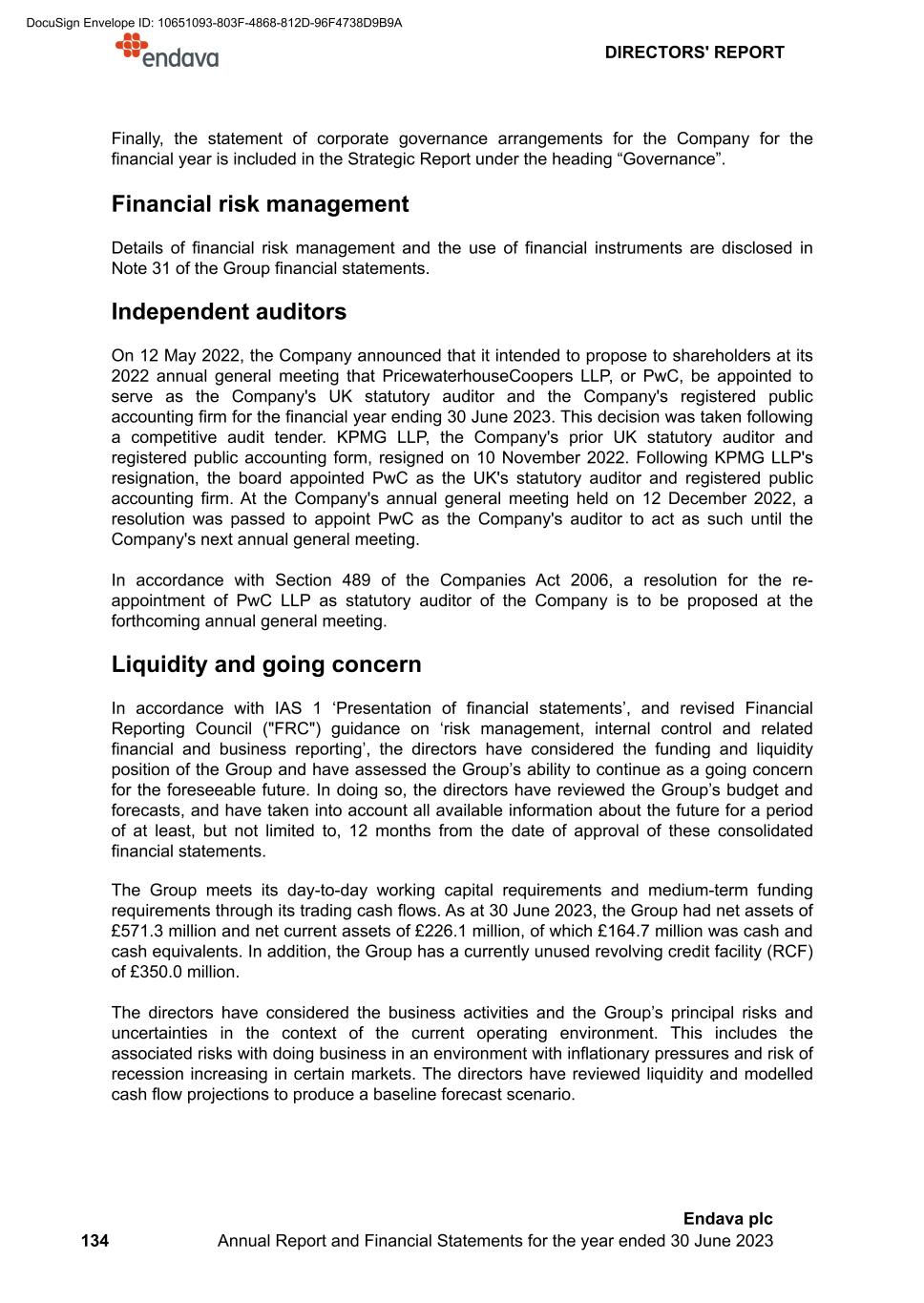
Finally, the statement of corporate governance arrangements for the Company for the financial year is included in the Strategic Report under the heading “Governance”. Financial risk management Details of financial risk management and the use of financial instruments are disclosed in Note 31 of the Group financial statements. Independent auditors On 12 May 2022, the Company announced that it intended to propose to shareholders at its 2022 annual general meeting that PricewaterhouseCoopers LLP, or PwC, be appointed to serve as the Company's UK statutory auditor and the Company's registered public accounting firm for the financial year ending 30 June 2023. This decision was taken following a competitive audit tender. KPMG LLP, the Company's prior UK statutory auditor and registered public accounting form, resigned on 10 November 2022. Following KPMG LLP's resignation, the board appointed PwC as the UK's statutory auditor and registered public accounting firm. At the Company's annual general meeting held on 12 December 2022, a resolution was passed to appoint PwC as the Company's auditor to act as such until the Company's next annual general meeting. In accordance with Section 489 of the Companies Act 2006, a resolution for the re- appointment of PwC LLP as statutory auditor of the Company is to be proposed at the forthcoming annual general meeting. Liquidity and going concern In accordance with IAS 1 ‘Presentation of financial statements’, and revised Financial Reporting Council ("FRC") guidance on ‘risk management, internal control and related financial and business reporting’, the directors have considered the funding and liquidity position of the Group and have assessed the Group’s ability to continue as a going concern for the foreseeable future. In doing so, the directors have reviewed the Group’s budget and forecasts, and have taken into account all available information about the future for a period of at least, but not limited to, 12 months from the date of approval of these consolidated financial statements. The Group meets its day-to-day working capital requirements and medium-term funding requirements through its trading cash flows. As at 30 June 2023, the Group had net assets of £571.3 million and net current assets of £226.1 million, of which £164.7 million was cash and cash equivalents. In addition, the Group has a currently unused revolving credit facility (RCF) of £350.0 million. The directors have considered the business activities and the Group’s principal risks and uncertainties in the context of the current operating environment. This includes the associated risks with doing business in an environment with inflationary pressures and risk of recession increasing in certain markets. The directors have reviewed liquidity and modelled cash flow projections to produce a baseline forecast scenario. DIRECTORS' REPORT 134 Endava plc Annual Report and Financial Statements for the year ended 30 June 2023 DocuSign Envelope ID: 10651093-803F-4868-812D-96F4738D9B9A

The directors have also considered sensitivities in respect of potential downside scenarios over and above the baseline scenario, and the mitigating actions available in concluding that the Group is able to continue in operation for a period of at least 12 months from the date of approval of these consolidated financial statements. The specific scenarios modelled include a downside scenario with a recession weakening the demand from July 2023 leading to a sequential revenue decline for three quarters, and a severe but plausible downside scenario with a more significant recession impact leading to a severe impact on sequential revenue growth for five quarters, followed by a gradual recovery. In the downside scenario, revenue over the forecast period is 23% lower than the baseline scenario and no mitigating actions over costs are taken by management. The closing cash balance at the end of the forecast period is £87.0 million lower than the baseline scenario, but remains positive throughout the forecast period, and no draw-down from the RCF would be required. In the severe but plausible downside scenario, revenue over the forecast period is 32% lower than the baseline scenario, and no cost mitigation measures are taken by management. The closing cash balance at the end of the forecast period is £146.0 million lower than the baseline scenario, but remains positive throughout the forecast period, and no draw-down from the RCF would be required. Throughout each of the scenarios considered, the Group’s cash position continues to remain strong throughout the forecast period. As noted above, the Group has an unused RCF of £350.0 million, funded by a group of banks. On the basis of the Group’s existing cash reserves and projections, the directors do not expect to draw down on the RCF in the foreseeable future, even in the most severe scenario considered. As a result, given the strength of the underlying business performance, the level of cash in the business, and ability to manage the cost base as required, the directors support the continued going concern assumption. The directors remain vigilant and ready to implement mitigation action in the event of a downturn in demand or an impact on operations. The directors are also not aware of any significant matters that are likely to occur outside the going concern period that could reasonably possibly impact the going concern conclusion. Having considered the outcome of these assessments, the directors consider that the Group has adequate resources to continue in operation for the foreseeable future, being at least 12 months from the date of approval of these consolidated financial statements, and accordingly continue to adopt the going concern basis in preparing the consolidated financial statements. Post balance sheet events The Group’s post balance sheet events are included in note 33 of the Group financial statements. DIRECTORS' REPORT 135 Endava plc Annual Report and Financial Statements for the year ended 30 June 2023 DocuSign Envelope ID: 10651093-803F-4868-812D-96F4738D9B9A

Statement of directors' responsibilities in respect of the financial statements The directors are responsible for preparing the Annual Report and the financial statements in accordance with applicable law and regulation. Company law requires the directors to prepare financial statements for each financial year. Under that law the directors have prepared the Group and the Company financial statements in accordance with UK-adopted international accounting standards. Under company law, directors must not approve the financial statements unless they are satisfied that they give a true and fair view of the state of affairs of the Group and Company and of the profit or loss of the Group for that period. In preparing the financial statements, the directors are required to: • select suitable accounting policies and then apply them consistently; • state whether applicable UK-adopted international accounting standards have been followed, subject to any material departures disclosed and explained in the financial statements; • make judgements and accounting estimates that are reasonable and prudent; and • prepare the financial statements on the going concern basis unless it is inappropriate to presume that the Group and Company will continue in business. The directors are responsible for safeguarding the assets of the Group and Company and hence for taking reasonable steps for the prevention and detection of fraud and other irregularities. The directors are also responsible for keeping adequate accounting records that are sufficient to show and explain the Group’s and Company’s transactions and disclose with reasonable accuracy at any time the financial position of the Group and Company and enable them to ensure that the financial statements and the Directors' Remuneration Report comply with the Companies Act 2006. The directors are responsible for the maintenance and integrity of the Company’s website. Legislation in the United Kingdom governing the preparation and dissemination of financial statements may differ from legislation in other jurisdictions. Directors' confirmations The directors consider that the Annual Report and accounts, taken as a whole, is fair, balanced and understandable and provides the information necessary for shareholders to assess the Group’s and Company’s position and performance, business model and strategy. DIRECTORS' REPORT 136 Endava plc Annual Report and Financial Statements for the year ended 30 June 2023 DocuSign Envelope ID: 10651093-803F-4868-812D-96F4738D9B9A

In the case of each director in office at the date the Directors’ Report is approved: • so far as the director is aware, there is no relevant audit information of which the Group’s and Company’s auditors are unaware; and • they have taken all the steps that they ought to have taken as a director in order to make themselves aware of any relevant audit information and to establish that the Group’s and Company’s auditors are aware of that information. On behalf of the board J E COTTERELL CHIEF EXECUTIVE OFFICER 125 Old Broad Street London EC2N 1AR 19 September 2023 DIRECTORS' REPORT 137 Endava plc Annual Report and Financial Statements for the year ended 30 June 2023 DocuSign Envelope ID: 10651093-803F-4868-812D-96F4738D9B9A

INDEPENDENT AUDITORS' REPORT TO THE MEMBERS OF ENDAVA PLC Report on the audit of the financial statements Opinion In our opinion, Endava plc’s group financial statements and company financial statements (the “financial statements”): • give a true and fair view of the state of the group’s and of the company’s affairs as at 30 June 2023 and of the group’s profit and the group’s and company’s cash flows for the year then ended; • have been properly prepared in accordance with UK-adopted international accounting standards as applied in accordance with the provisions of the Companies Act 2006; and • have been prepared in accordance with the requirements of the Companies Act 2006. We have audited the financial statements, included within the Annual Report and Financial Statements (the “Annual Report”), which comprise: the group balance sheet and company balance sheet as at 30 June 2023; the group statement of comprehensive income, the group statement of changes in equity, the group statement of cash flows, the company statement of changes in equity and the company statement of cash flows for the year then ended; and the notes to the financial statements, which include a description of the significant accounting policies. Basis for opinion We conducted our audit in accordance with International Standards on Auditing (UK) (“ISAs (UK)”) and applicable law. Our responsibilities under ISAs (UK) are further described in the Auditors’ responsibilities for the audit of the financial statements section of our report. We believe that the audit evidence we have obtained is sufficient and appropriate to provide a basis for our opinion. Independence We remained independent of the group in accordance with the ethical requirements that are relevant to our audit of the financial statements in the UK, which includes the FRC’s Ethical Standard, as applicable to listed entities, and we have fulfilled our other ethical responsibilities in accordance with these requirements. Our audit approach Context The audit engagement comprised the audit of the group and company financial statements of Endava plc. INDEPENDENT AUDITORS' REPORT 138 Endava plc Annual Report and Financial Statements for the year ended 30 June 2023 DocuSign Envelope ID: 10651093-803F-4868-812D-96F4738D9B9A

Overview Audit scope • We have reflected the group's centralised processes and controls in how we have scoped the group audit. For legacy Endava entities (defined as all of those which have not been acquired by the group in the financial year), we have scoped our audit on a consolidated basis, and therefore performed testing over consolidated group balances to ensure that sufficient coverage is gained over each financial statement line item on a consolidated basis. The majority of these financial statement line items are governed by the processes and controls in place in the group's shared service centre in Cluj, Romania (which we have visited as part of our audit), along with senior management oversight over selected financial statement line items and the preparation/review of the consolidation and financial statements in London, UK. For the payroll financial statement line item, our testing has been performed on a legal entity basis, given that each legal entity is subject to separate processes and controls, and we have obtained sufficient coverage across the group through this approach. For entities acquired in the year, being Lexicon, Mudbath and DEK, we have scoped these as non-significant components and tested material financial statement line items within these entities to ensure sufficient coverage across the group. We have also performed the audit of the Endava plc company only financial statements, which is scoped as a single entity. Key audit matters • Valuation of client relationships from the Lexicon, Mudbath and DEK acquisitions (group) • Risk of fraud in revenue recognition (group) • Valuation of investments in subsidiaries (parent) Materiality • Overall group materiality: £5,700,000 based on 5% of profit before tax. • Overall company materiality: £4,500,000 based on 1% of total assets. • Performance materiality: £4,275,000 (group) and £3,375,000 (company). The scope of our audit As part of designing our audit, we determined materiality and assessed the risks of material misstatement in the financial statements. Key audit matters Key audit matters are those matters that, in the auditors’ professional judgement, were of most significance in the audit of the financial statements of the current period and include the most significant assessed risks of material misstatement (whether or not due to fraud) identified by the auditors, including those which had the greatest effect on: the overall audit strategy; the allocation of resources in the audit; and directing the efforts of the engagement team. These matters, and any comments we make on the results of our procedures thereon, were addressed in the context of our audit of the financial statements as a whole, and in forming our opinion thereon, and we do not provide a separate opinion on these matters. This is not a complete list of all risks identified by our audit. INDEPENDENT AUDITORS' REPORT 139 Endava plc Annual Report and Financial Statements for the year ended 30 June 2023 DocuSign Envelope ID: 10651093-803F-4868-812D-96F4738D9B9A

Key audit matter How our audit addressed the key audit matter Valuation of client relationships from the Lexicon, Mudbath and DEK acquisitions (group) As described in Note 15 of the consolidated financial statements, during the year ended 30 June 2023, the Group completed acquisitions of Lexicon, Mudbath and DEK (together “the acquisitions”), and recognised client relationships as intangible assets of £24.0 million. The valuation of these newly acquired intangible assets was identified as a significant risk over the valuation assertion for our Group audit. Business combination accounting under IFRS 3, including but not limited to the valuation of acquired intangible assets; is complex, subjective and requires a high degree of management judgement. There is no complexity in identifying the different categories of intangible assets, as Endava acquire businesses with similar profiles to the Group and the identifiable intangible assets are related to client relationships, as once acquired, the acquired companies are integrated into the existing Group processes and controls. For Lexicon and Mudbath, management applied significant judgement in estimating the fair value of the identifiable intangible assets acquired, which involved the use of significant estimates and assumptions with respect to customer attrition rates and discount rates. As the acquisition accounting for DEK is provisional as at the balance sheet date, management estimated the fair value of the client relationships by applying an assumed client relationship fair value as a proportion of the total enterprise value based on comparable historical acquisitions. Management applied judgement in determining the appropriate valuation method and assessing the comparability of historical acquisitions. As part of our audit of the acquisition of Lexicon and Mudbath we have performed the following procedures: - Testing the effectiveness of controls relating to the valuation of client relationships acquired and recognised as intangible assets, including controls over the development of assumptions; - Reading the share purchase agreements; - Understood the reliance management has placed on their external experts, and we have performed procedures to assess the knowledge, skill and ability of the experts engaged by management for the purposes of this exercise; - Evaluating the appropriateness of the valuation methods adopted by management by (i) testing the mathematical accuracy of the models, (ii) testing the completeness and accuracy of data used in the models and (iii) evaluating the reasonableness of significant assumptions used by management in estimating the customer attrition rates and discount rates. Evaluating whether the customer attrition rates were reasonable involved considering recent and forecasted financial performance of the acquired business, the Group’s recent and forecast financial performance, along with assessing assumptions for consistency with external market and industry data. Professionals with specialised skill and knowledge were used to assist in evaluating the appropriateness of management’s discount rate. As part of our audit of the acquisition of DEK we have performed the following procedures: - Testing the effectiveness of controls relating to the valuation of client relationships acquired and recognised as intangible assets, including controls over the development of assumptions; - Reading the share purchase agreement; - Evaluating the appropriateness of the valuation methods adopted by management by (i) testing the mathematical accuracy of the calculation, (ii) testing the completeness and accuracy of data used in the calculation; - Evaluating whether the assumptions used were reasonable for DEK involved considering historical acquisitions made by the Group and their similarity to the DEK acquisition in nature, to determine whether they should be included in the analysis prepared by management in calculating the provisional fair value to apply to the client relationship intangible asset acquired. No exceptions have been identified from the testing performed. INDEPENDENT AUDITORS' REPORT 140 Endava plc Annual Report and Financial Statements for the year ended 30 June 2023 DocuSign Envelope ID: 10651093-803F-4868-812D-96F4738D9B9A
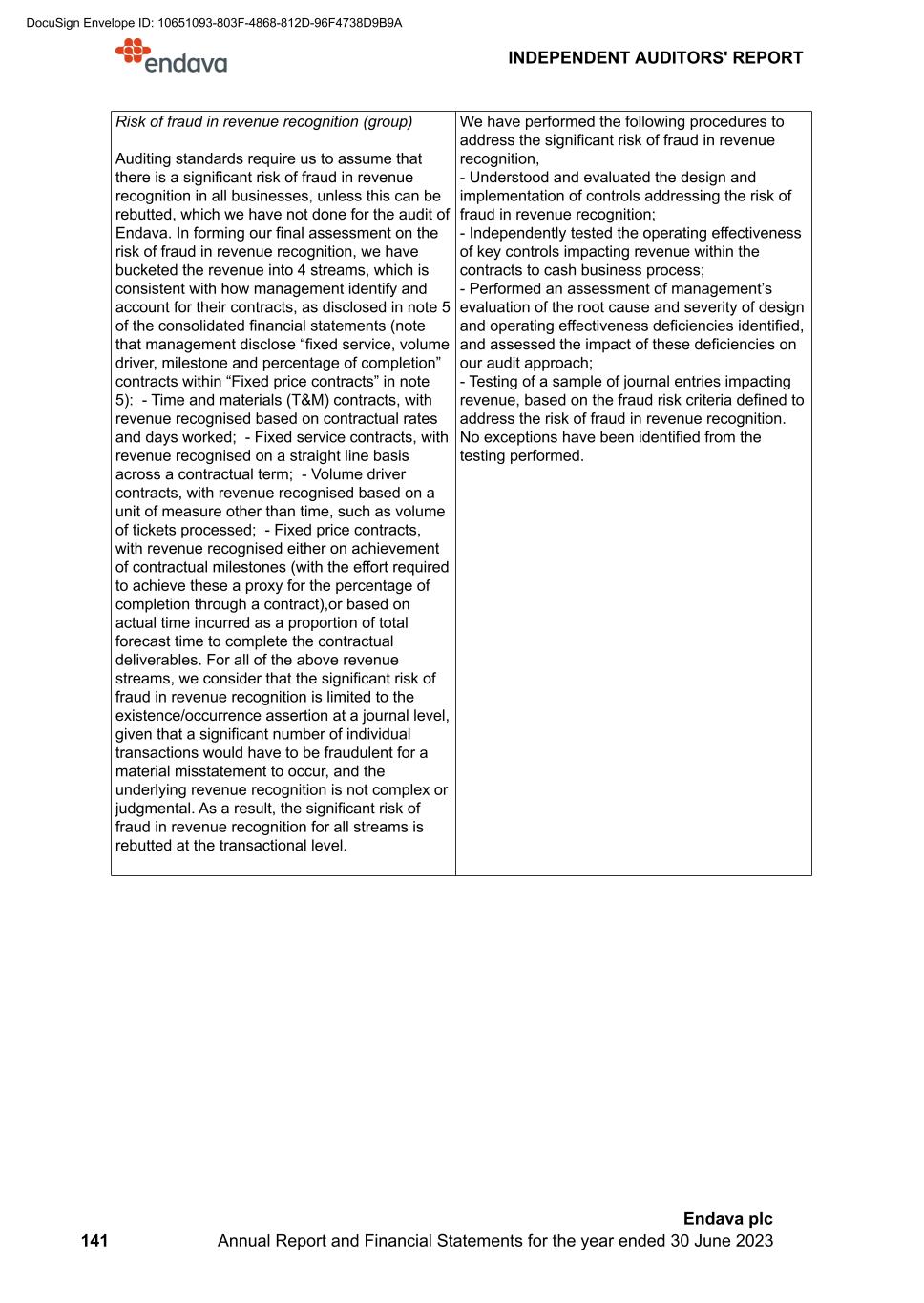
Risk of fraud in revenue recognition (group) Auditing standards require us to assume that there is a significant risk of fraud in revenue recognition in all businesses, unless this can be rebutted, which we have not done for the audit of Endava. In forming our final assessment on the risk of fraud in revenue recognition, we have bucketed the revenue into 4 streams, which is consistent with how management identify and account for their contracts, as disclosed in note 5 of the consolidated financial statements (note that management disclose “fixed service, volume driver, milestone and percentage of completion” contracts within “Fixed price contracts” in note 5): - Time and materials (T&M) contracts, with revenue recognised based on contractual rates and days worked; - Fixed service contracts, with revenue recognised on a straight line basis across a contractual term; - Volume driver contracts, with revenue recognised based on a unit of measure other than time, such as volume of tickets processed; - Fixed price contracts, with revenue recognised either on achievement of contractual milestones (with the effort required to achieve these a proxy for the percentage of completion through a contract),or based on actual time incurred as a proportion of total forecast time to complete the contractual deliverables. For all of the above revenue streams, we consider that the significant risk of fraud in revenue recognition is limited to the existence/occurrence assertion at a journal level, given that a significant number of individual transactions would have to be fraudulent for a material misstatement to occur, and the underlying revenue recognition is not complex or judgmental. As a result, the significant risk of fraud in revenue recognition for all streams is rebutted at the transactional level. We have performed the following procedures to address the significant risk of fraud in revenue recognition, - Understood and evaluated the design and implementation of controls addressing the risk of fraud in revenue recognition; - Independently tested the operating effectiveness of key controls impacting revenue within the contracts to cash business process; - Performed an assessment of management’s evaluation of the root cause and severity of design and operating effectiveness deficiencies identified, and assessed the impact of these deficiencies on our audit approach; - Testing of a sample of journal entries impacting revenue, based on the fraud risk criteria defined to address the risk of fraud in revenue recognition. No exceptions have been identified from the testing performed. INDEPENDENT AUDITORS' REPORT 141 Endava plc Annual Report and Financial Statements for the year ended 30 June 2023 DocuSign Envelope ID: 10651093-803F-4868-812D-96F4738D9B9A

Valuation of investments in subsidiaries (parent) The principal activity of Endava plc as the ultimate parent company of the Group is as an investment company for the Group, holding investments in subsidiaries financed by Group companies. It has recognised investments in Group companies totalling £233.1m as at 30 June 2023, as disclosed in note 3 of the company financial statements. The valuation of these investments in subsidiaries was identified as a significant risk in respect of the valuation assertion for our audit of Endava plc as a standalone company. Management are required to assess all of these investments for impairment on an annual basis to ensure that their carrying value is not in excess of their recoverable amount. Upon completing this assessment, management have recognised an impairment of £15.7m in respect of the Business Agility Consulting (BAC) acquisition at the year end, on the basis that it's carrying value was in excess of its recoverable amount. This results in BAC having a carrying value of nil once the impairment has been recognised. We have performed the following procedures to address the significant risk over the valuation of investments in subsidiaries: - Assessed management's impairment analysis to identify facts or circumstances that could indicate an individual investment is impaired, and reperformed this analysis using audited year end information; - Obtained management's impairment calculation for the impairment recognised in respect of BAC and verified its mathematical accuracy; - Critically assessed the key assumptions in the impairment calculation and management’s rationale for recognising an impairment loss equal to the value of the investment held in BAC; - Performed sensitivity analysis over the key assumptions for management’s impairment analysis; - Reviewed the disclosures in the company financial statements. We concur with management’s conclusions that the only investment requiring an impairment to be recognised was BAC, and we have identified no exceptions from the testing performed over the BAC impairment recognised. How we tailored the audit scope We tailored the scope of our audit to ensure that we performed enough work to be able to give an opinion on the financial statements as a whole, taking into account the structure of the group and the company, the accounting processes and controls, and the industry in which they operate. We have reflected the group's centralised processes and controls in how we have scoped the group audit. For legacy Endava entities (defined as all of those which have not been acquired by the group in the financial year), we have scoped our audit on a consolidated basis, and therefore performed testing over consolidated group balances to ensure that sufficient coverage is gained over each financial statement line item on a consolidated basis. The majority of these financial statement line items are governed by the processes and controls in place in the group's shared service centre in Cluj, Romania (which we have visited as part of our audit), along with senior management oversight over selected financial statement line items and the preparation/review of the consolidation and financial statements in London, UK. For the payroll financial statement line item, our testing has been performed on a legal entity basis, given that each legal entity is subject to separate processes and controls, and we have obtained sufficient coverage across the group through this approach. For entities acquired in the year, being Lexicon, Mudbath and DEK, we have scoped these as non- significant components and tested material financial statement line items within these entities to ensure sufficient coverage across the group. We have also performed the audit of the Endava plc company only financial statements, which is scoped as a single entity. There has been no use of component auditors in the audit of the group or company, and the audit has been performed primarily by PwC UK with limited assistance from PwC Romania in a staff augmentation capacity. All work performed by PwC Romania staff has been overseen and reviewed by the PwC UK audit engagement team. INDEPENDENT AUDITORS' REPORT 142 Endava plc Annual Report and Financial Statements for the year ended 30 June 2023 DocuSign Envelope ID: 10651093-803F-4868-812D-96F4738D9B9A
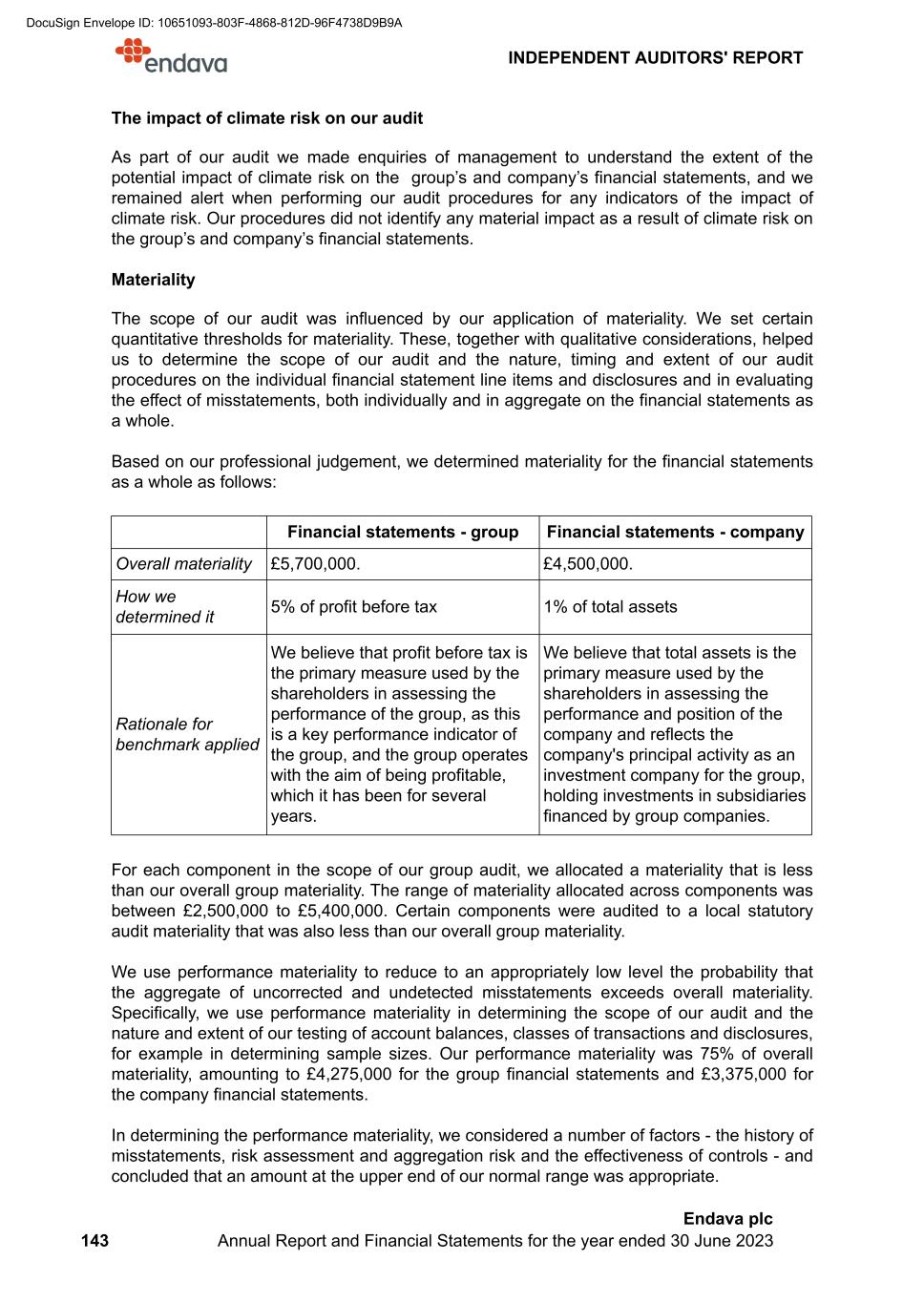
The impact of climate risk on our audit As part of our audit we made enquiries of management to understand the extent of the potential impact of climate risk on the group’s and company’s financial statements, and we remained alert when performing our audit procedures for any indicators of the impact of climate risk. Our procedures did not identify any material impact as a result of climate risk on the group’s and company’s financial statements. Materiality The scope of our audit was influenced by our application of materiality. We set certain quantitative thresholds for materiality. These, together with qualitative considerations, helped us to determine the scope of our audit and the nature, timing and extent of our audit procedures on the individual financial statement line items and disclosures and in evaluating the effect of misstatements, both individually and in aggregate on the financial statements as a whole. Based on our professional judgement, we determined materiality for the financial statements as a whole as follows: Financial statements - group Financial statements - company Overall materiality £5,700,000. £4,500,000. How we determined it 5% of profit before tax 1% of total assets Rationale for benchmark applied We believe that profit before tax is the primary measure used by the shareholders in assessing the performance of the group, as this is a key performance indicator of the group, and the group operates with the aim of being profitable, which it has been for several years. We believe that total assets is the primary measure used by the shareholders in assessing the performance and position of the company and reflects the company's principal activity as an investment company for the group, holding investments in subsidiaries financed by group companies. For each component in the scope of our group audit, we allocated a materiality that is less than our overall group materiality. The range of materiality allocated across components was between £2,500,000 to £5,400,000. Certain components were audited to a local statutory audit materiality that was also less than our overall group materiality. We use performance materiality to reduce to an appropriately low level the probability that the aggregate of uncorrected and undetected misstatements exceeds overall materiality. Specifically, we use performance materiality in determining the scope of our audit and the nature and extent of our testing of account balances, classes of transactions and disclosures, for example in determining sample sizes. Our performance materiality was 75% of overall materiality, amounting to £4,275,000 for the group financial statements and £3,375,000 for the company financial statements. In determining the performance materiality, we considered a number of factors - the history of misstatements, risk assessment and aggregation risk and the effectiveness of controls - and concluded that an amount at the upper end of our normal range was appropriate. INDEPENDENT AUDITORS' REPORT 143 Endava plc Annual Report and Financial Statements for the year ended 30 June 2023 DocuSign Envelope ID: 10651093-803F-4868-812D-96F4738D9B9A

We agreed with those charged with governance that we would report to them misstatements identified during our audit above £285,000 (group audit) and £225,000 (company audit) as well as misstatements below those amounts that, in our view, warranted reporting for qualitative reasons. Conclusions relating to going concern Our evaluation of the directors’ assessment of the group's and the company’s ability to continue to adopt the going concern basis of accounting included: • A review of management's latest cash flow forecasts, in which we have assessed the forecasts for reasonableness, understood the planned cash outflows/inflows and considered management’s previous ability to forecast accurately. • Assessed management's severe but plausible downside scenario in modelling their cash flow forecasts, and performing sensitivity analysis on the most significant inputs in the model. • Review of the disclosures in the group and company financial statements. • Obtained and evaluated management's going concern memo, which outlines the basis on which they believe both the group and company are able to continue as a going concern. Based on the work we have performed, we have not identified any material uncertainties relating to events or conditions that, individually or collectively, may cast significant doubt on the group's and the company’s ability to continue as a going concern for a period of at least twelve months from when the financial statements are authorised for issue. In auditing the financial statements, we have concluded that the directors’ use of the going concern basis of accounting in the preparation of the financial statements is appropriate. However, because not all future events or conditions can be predicted, this conclusion is not a guarantee as to the group's and the company's ability to continue as a going concern. Our responsibilities and the responsibilities of the directors with respect to going concern are described in the relevant sections of this report. Reporting on other information The other information comprises all of the information in the Annual Report other than the financial statements and our auditors’ report thereon. The directors are responsible for the other information. Our opinion on the financial statements does not cover the other information and, accordingly, we do not express an audit opinion or, except to the extent otherwise explicitly stated in this report, any form of assurance thereon. In connection with our audit of the financial statements, our responsibility is to read the other information and, in doing so, consider whether the other information is materially inconsistent with the financial statements or our knowledge obtained in the audit, or otherwise appears to be materially misstated. If we identify an apparent material inconsistency or material misstatement, we are required to perform procedures to conclude whether there is a material misstatement of the financial statements or a material misstatement of the other information. If, based on the work we have performed, we conclude that there is a material misstatement of this other information, we are required to report that fact. We have nothing to report based on these responsibilities. INDEPENDENT AUDITORS' REPORT 144 Endava plc Annual Report and Financial Statements for the year ended 30 June 2023 DocuSign Envelope ID: 10651093-803F-4868-812D-96F4738D9B9A

With respect to the Strategic report and Directors' Report, we also considered whether the disclosures required by the UK Companies Act 2006 have been included. Based on our work undertaken in the course of the audit, the Companies Act 2006 requires us also to report certain opinions and matters as described below. Strategic report and Directors' Report In our opinion, based on the work undertaken in the course of the audit, the information given in the Strategic report and Directors' Report for the year ended 30 June 2023 is consistent with the financial statements and has been prepared in accordance with applicable legal requirements. In light of the knowledge and understanding of the group and company and their environment obtained in the course of the audit, we did not identify any material misstatements in the Strategic report and Directors' Report. Directors' Remuneration In our opinion, the part of the Directors' Remuneration Report to be audited has been properly prepared in accordance with the Companies Act 2006. Responsibilities for the financial statements and the audit Responsibilities of the directors for the financial statements As explained more fully in the Statement of directors’ responsibilities in respect of the financial statements, the directors are responsible for the preparation of the financial statements in accordance with the applicable framework and for being satisfied that they give a true and fair view. The directors are also responsible for such internal control as they determine is necessary to enable the preparation of financial statements that are free from material misstatement, whether due to fraud or error. In preparing the financial statements, the directors are responsible for assessing the group’s and the company’s ability to continue as a going concern, disclosing, as applicable, matters related to going concern and using the going concern basis of accounting unless the directors either intend to liquidate the group or the company or to cease operations, or have no realistic alternative but to do so. Auditors’ responsibilities for the audit of the financial statements Our objectives are to obtain reasonable assurance about whether the financial statements as a whole are free from material misstatement, whether due to fraud or error, and to issue an auditors’ report that includes our opinion. Reasonable assurance is a high level of assurance, but is not a guarantee that an audit conducted in accordance with ISAs (UK) will always detect a material misstatement when it exists. Misstatements can arise from fraud or error and are considered material if, individually or in the aggregate, they could reasonably be expected to influence the economic decisions of users taken on the basis of these financial statements. INDEPENDENT AUDITORS' REPORT 145 Endava plc Annual Report and Financial Statements for the year ended 30 June 2023 DocuSign Envelope ID: 10651093-803F-4868-812D-96F4738D9B9A

Irregularities, including fraud, are instances of non-compliance with laws and regulations. We design procedures in line with our responsibilities, outlined above, to detect material misstatements in respect of irregularities, including fraud. The extent to which our procedures are capable of detecting irregularities, including fraud, is detailed below. Based on our understanding of the group and industry, we identified that the principal risks of non-compliance with laws and regulations related to the requirements of being a UK incorporated company listed on the New York Stock Exchange and being a SEC registrant as a Foreign Private Issuer, and we considered the extent to which non-compliance might have a material effect on the financial statements. We also considered those laws and regulations that have a direct impact on the financial statements such as the Companies Act 2006 and taxation legislation. We evaluated management’s incentives and opportunities for fraudulent manipulation of the financial statements (including the risk of override of controls), and determined that the principal risks were related to the audit risks detailed within the above key audit matters section and potential management bias in accounting estimates. Audit procedures performed by the engagement team included: • Discussions with management and internal legal counsel including consideration of known or suspected instances of non-compliance with laws and regulations and fraud, and obtaining legal confirmations from external legal counsel. • Reviewing minutes of meetings of the Board of Directors. • Considering assumptions made by management in their accounting estimates, particularly around the valuation of acquired client relationships in the group financial statements, and the valuation of investments in subsidiaries in the company financial statements. • Testing a sample of journal entries to address the fraud risks identified. There are inherent limitations in the audit procedures described above. We are less likely to become aware of instances of non-compliance with laws and regulations that are not closely related to events and transactions reflected in the financial statements. Also, the risk of not detecting a material misstatement due to fraud is higher than the risk of not detecting one resulting from error, as fraud may involve deliberate concealment by, for example, forgery or intentional misrepresentations, or through collusion. Our audit testing might include testing complete populations of certain transactions and balances, possibly using data auditing techniques. However, it typically involves selecting a limited number of items for testing, rather than testing complete populations. We will often seek to target particular items for testing based on their size or risk characteristics. In other cases, we will use audit sampling to enable us to draw a conclusion about the population from which the sample is selected. A further description of our responsibilities for the audit of the financial statements is located on the FRC’s website at: www.frc.org.uk/auditorsresponsibilities. This description forms part of our auditors’ report. Use of this report This report, including the opinions, has been prepared for and only for the company’s members as a body in accordance with Chapter 3 of Part 16 of the Companies Act 2006 and for no other purpose. We do not, in giving these opinions, accept or assume responsibility for any other purpose or to any other person to whom this report is shown or into whose hands it may come save where expressly agreed by our prior consent in writing. INDEPENDENT AUDITORS' REPORT 146 Endava plc Annual Report and Financial Statements for the year ended 30 June 2023 DocuSign Envelope ID: 10651093-803F-4868-812D-96F4738D9B9A
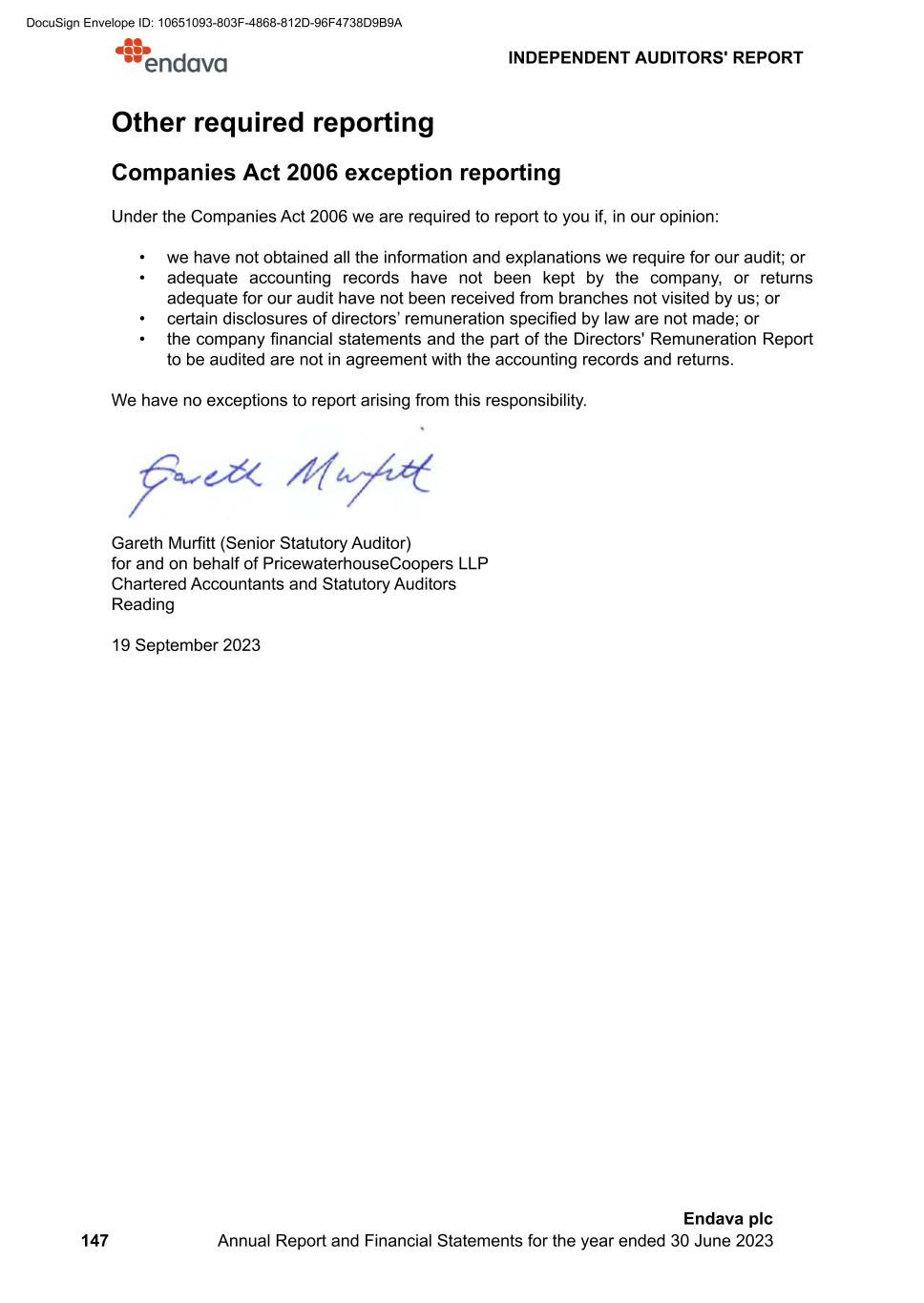
Other required reporting Companies Act 2006 exception reporting Under the Companies Act 2006 we are required to report to you if, in our opinion: • we have not obtained all the information and explanations we require for our audit; or • adequate accounting records have not been kept by the company, or returns adequate for our audit have not been received from branches not visited by us; or • certain disclosures of directors’ remuneration specified by law are not made; or • the company financial statements and the part of the Directors' Remuneration Report to be audited are not in agreement with the accounting records and returns. We have no exceptions to report arising from this responsibility. Gareth Murfitt (Senior Statutory Auditor) for and on behalf of PricewaterhouseCoopers LLP Chartered Accountants and Statutory Auditors Reading 19 September 2023 INDEPENDENT AUDITORS' REPORT 147 Endava plc Annual Report and Financial Statements for the year ended 30 June 2023 DocuSign Envelope ID: 10651093-803F-4868-812D-96F4738D9B9A

GROUP STATEMENT OF COMPREHENSIVE INCOME For the year ended 30 June Note 2023 2022 £’000 £’000 Revenue 5 794,733 654,757 Cost of sales Direct cost of sales (505,679) (414,411) Allocated cost of sales (24,977) (22,415) Total cost of sales (530,656) (436,826) Gross profit 264,077 217,931 Selling, general and administrative expenses (150,300) (121,808) Net impairment losses on financial assets 19 (932) (739) Operating profit 6 112,845 95,384 Finance expense 9 (14,826) (3,142) Finance income 10 16,144 10,137 Net finance income 1,318 6,995 Profit before tax 114,163 102,379 Tax on profit on ordinary activities 11 (20,000) (19,286) Profit for the year and profit attributable to the equity holders of the Company 94,163 83,093 Other comprehensive (expense)/income Items that may be reclassified subsequently to profit or loss: Exchange differences on translating foreign operations (9,999) 6,580 Total comprehensive income for the year attributable to the equity holders of the Company 84,164 89,673 Earnings per share (EPS): 13 Basic EPS £ 1.64 £ 1.48 Diluted EPS £ 1.62 £ 1.43 Weighted average number of shares outstanding - basic 57,314,839 56,272,036 Weighted average number of shares outstanding - diluted 58,082,388 58,018,200 There is no tax impact of the amounts recognised through other comprehensive income. The accompanying notes form an integral part of these financial statements. GROUP FINANCIAL STATEMENTS 148 Endava plc Annual Report and Financial Statements for the year ended 30 June 2023 DocuSign Envelope ID: 10651093-803F-4868-812D-96F4738D9B9A
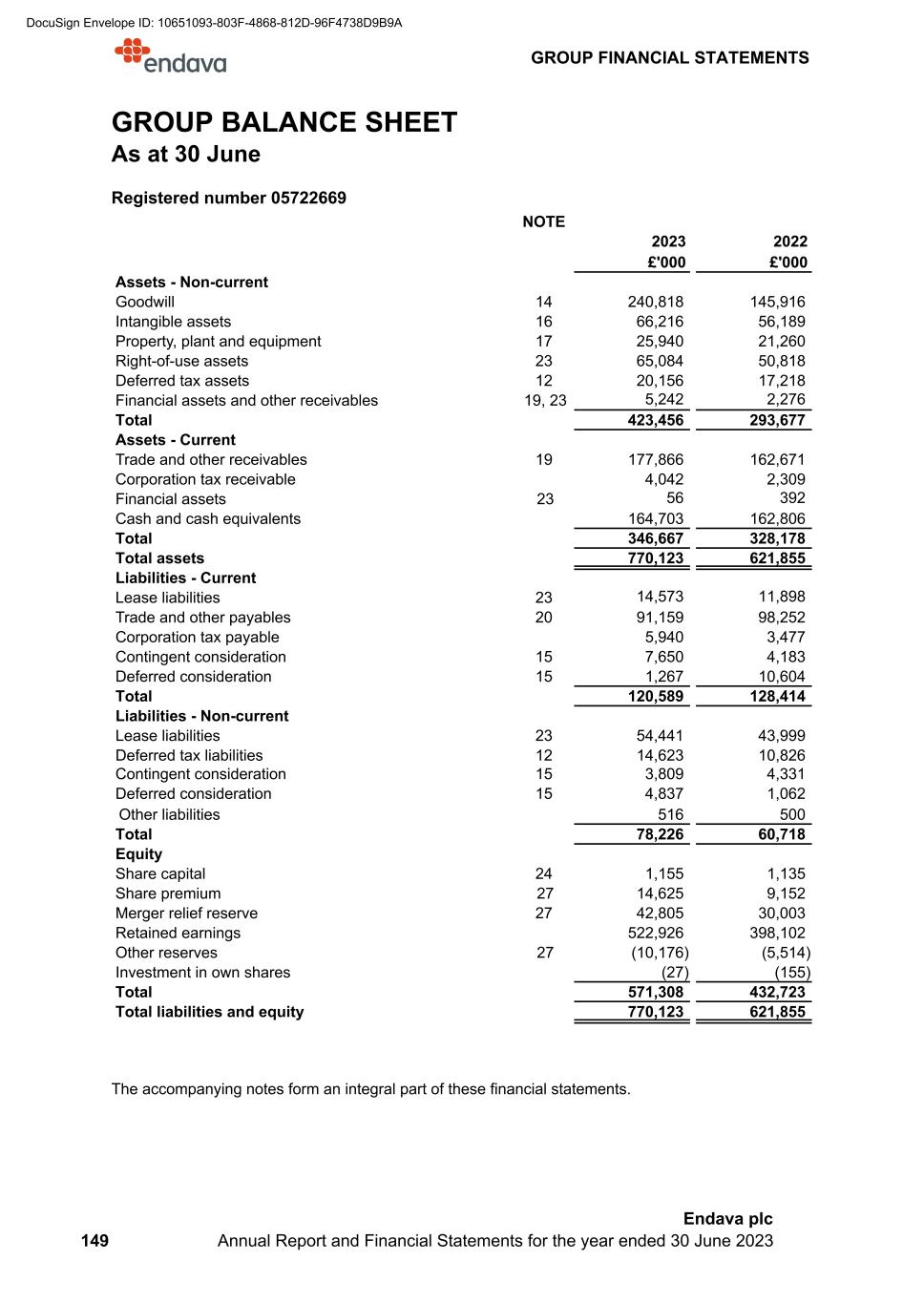
GROUP BALANCE SHEET As at 30 June Registered number 05722669 NOTE 2023 2022 £'000 £'000 Assets - Non-current Goodwill 14 240,818 145,916 Intangible assets 16 66,216 56,189 Property, plant and equipment 17 25,940 21,260 Right-of-use assets 23 65,084 50,818 Deferred tax assets 12 20,156 17,218 Financial assets and other receivables 19, 23 5,242 2,276 Total 423,456 293,677 Assets - Current Trade and other receivables 19 177,866 162,671 Corporation tax receivable 4,042 2,309 Financial assets 23 56 392 Cash and cash equivalents 164,703 162,806 Total 346,667 328,178 Total assets 770,123 621,855 Liabilities - Current Lease liabilities 23 14,573 11,898 Trade and other payables 20 91,159 98,252 Corporation tax payable 5,940 3,477 Contingent consideration 15 7,650 4,183 Deferred consideration 15 1,267 10,604 Total 120,589 128,414 Liabilities - Non-current Lease liabilities 23 54,441 43,999 Deferred tax liabilities 12 14,623 10,826 Contingent consideration 15 3,809 4,331 Deferred consideration 15 4,837 1,062 Other liabilities 516 500 Total 78,226 60,718 Equity Share capital 24 1,155 1,135 Share premium 27 14,625 9,152 Merger relief reserve 27 42,805 30,003 Retained earnings 522,926 398,102 Other reserves 27 (10,176) (5,514) Investment in own shares (27) (155) Total 571,308 432,723 Total liabilities and equity 770,123 621,855 The accompanying notes form an integral part of these financial statements. GROUP FINANCIAL STATEMENTS 149 Endava plc Annual Report and Financial Statements for the year ended 30 June 2023 DocuSign Envelope ID: 10651093-803F-4868-812D-96F4738D9B9A
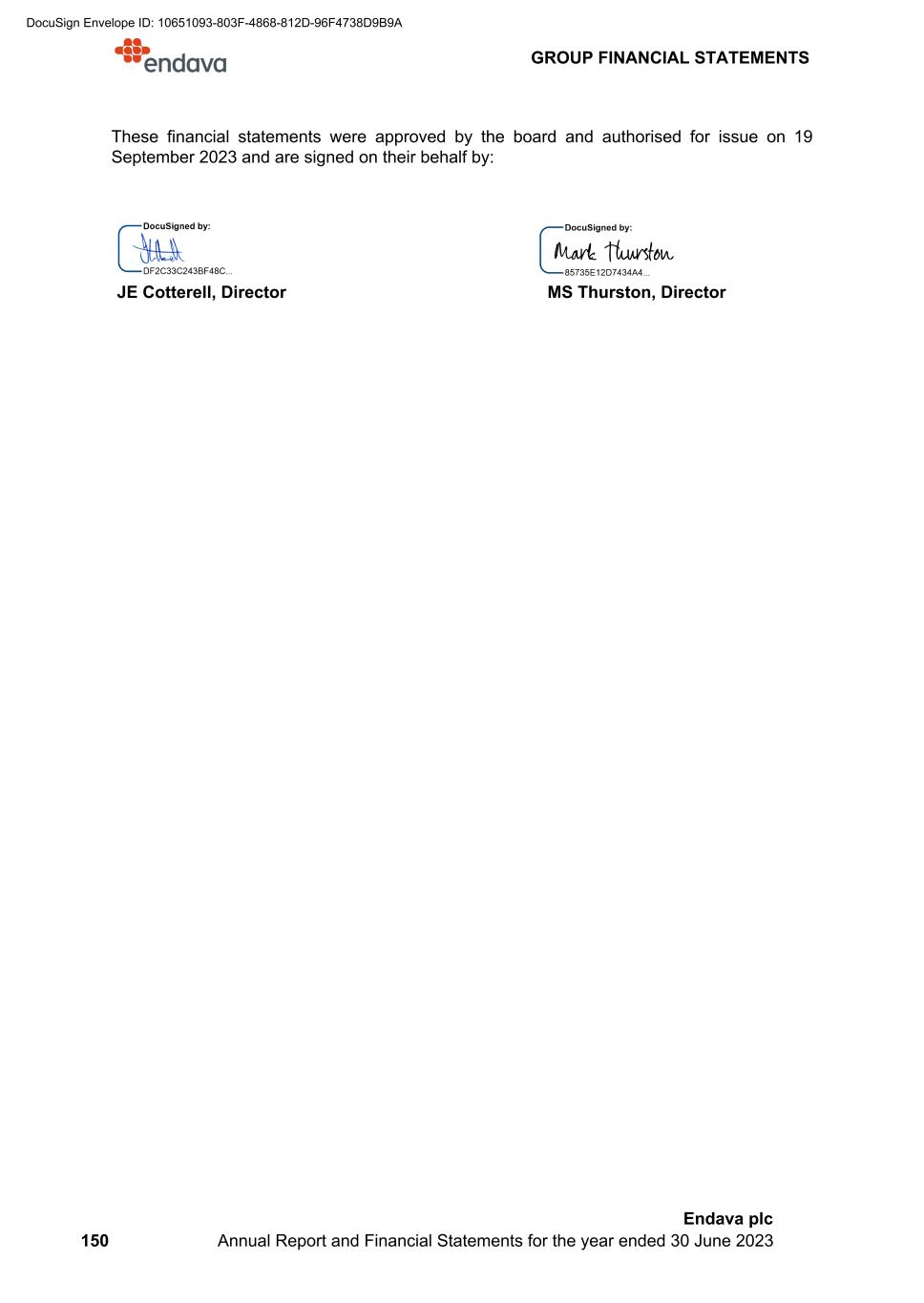
These financial statements were approved by the board and authorised for issue on 19 September 2023 and are signed on their behalf by: JE Cotterell, Director MS Thurston, Director GROUP FINANCIAL STATEMENTS 150 Endava plc Annual Report and Financial Statements for the year ended 30 June 2023 DocuSign Envelope ID: 10651093-803F-4868-812D-96F4738D9B9A

GROUP STATEMENT OF CHANGES IN EQUITY For the year ended 30 June Share capital £’000 Share premium £’000 Merger relief reserve £’000 Investment in own shares £’000 Retained earnings £’000 Capital redemption reserve £’000 Other reserves £'000 Foreign exchange translation reserve £’000 Total £’000 Balance at 30 June 2021 1,114 247 30,003 (155) 278,839 161 — (13,760) 296,449 Equity-settled share-based payment transactions - net of tax — — — — 35,737 — — — 35,737 Issuance of shares related to acquisitions — — — — — — 1,505 — 1,505 Exercise of options 21 8,905 — — — — — — 8,926 Hyperinflation adjustment — — — — 433 — — — 433 Transaction with owners 21 8,905 — — 36,170 — 1,505 — 46,601 Profit for the year — — — — 83,093 — — — 83,093 Other comprehensive income — — — — — — — 6,580 6,580 Total comprehensive income for the year — — — — 83,093 — — 6,580 89,673 Balance at 30 June 2022 1,135 9,152 30,003 (155) 398,102 161 1,505 (7,180) 432,723 Equity-settled share-based payment transactions net of tax — — — — 29,418 — — — 29,418 Issuance of shares related to acquisitions 4 — 12,802 — — — 5,337 — 18,143 Exercise of options 16 5,473 — 128 (39) — — — 5,578 Hyperinflation adjustment — — — — 1,282 — — — 1,282 Transaction with owners 20 5,473 12,802 128 30,661 — 5,337 — 54,421 Profit for the year — — — — 94,163 — — — 94,163 Other comprehensive expense — — — — — — — (9,999) (9,999) Total comprehensive income for the year — — — — 94,163 — — (9,999) 84,164 Balance at 30 June 2023 1,155 14,625 42,805 (27) 522,926 161 6,842 (17,179) 571,308 The accompanying notes form an integral part of these financial statements. GROUP FINANCIAL STATEMENTS 151 Endava plc Annual Report and Financial Statements for the year ended 30 June 2023 DocuSign Envelope ID: 10651093-803F-4868-812D-96F4738D9B9A

GROUP STATEMENT OF CASH FLOWS For the year ended 30 June 2023 2022 £’000 £’000 Operating activities Profit for the year 94,163 83,093 Income tax charge 20,000 19,286 Non-cash adjustments (note 28) 49,165 53,799 Tax paid (22,737) (14,033) UK research and development credit received — 344 Net changes in working capital (note 28) (16,073) (21,770) Net cash from operating activities 124,518 120,719 Investing activities Purchase of non-current assets (tangibles and intangibles) (13,674) (13,967) Proceeds from disposal of non-current assets 187 272 Payment for acquisition of subsidiary, net of cash acquired (79,691) (10,364) Other acquisition related settlements (note 28) (21,179) — Interest received 3,506 184 Net cash used in investing activities (110,851) (23,875) Financing activities Proceeds from sublease 439 560 Repayment of lease liabilities (13,488) (13,805) Grant received 494 139 Interest and debt financing costs paid (4,011) (885) Proceeds from exercise of options 5,568 8,913 Net cash used in financing activities (10,998) (5,078) Net change in cash and cash equivalents 2,669 91,766 Cash and cash equivalents at the beginning of the year 162,806 69,884 Net foreign exchange differences (772) 1,156 Cash and cash equivalents at the end of the year 164,703 162,806 The accompanying notes form an integral part of these financial statements. GROUP FINANCIAL STATEMENTS 152 Endava plc Annual Report and Financial Statements for the year ended 30 June 2023 DocuSign Envelope ID: 10651093-803F-4868-812D-96F4738D9B9A
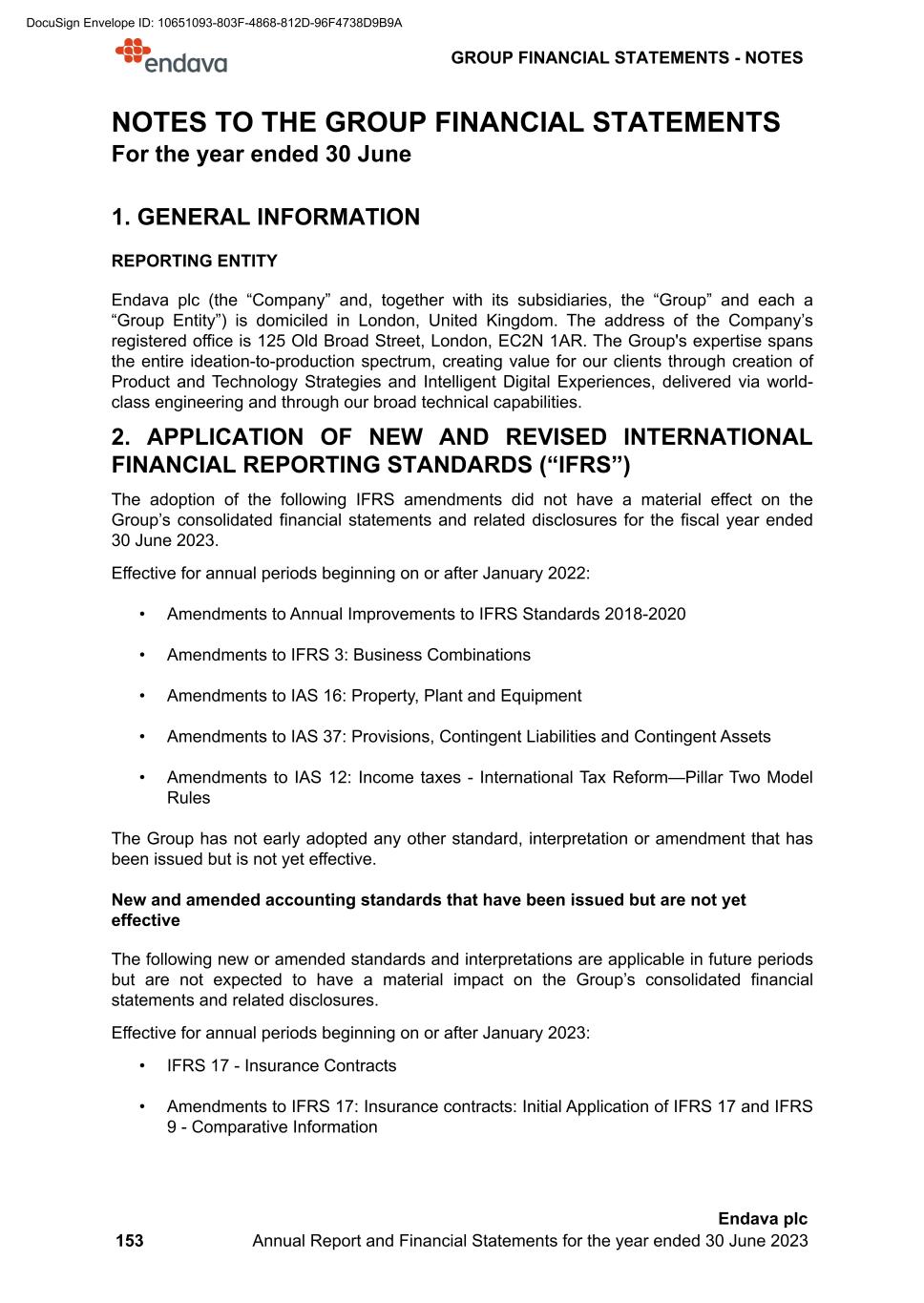
NOTES TO THE GROUP FINANCIAL STATEMENTS For the year ended 30 June 1. GENERAL INFORMATION REPORTING ENTITY Endava plc (the “Company” and, together with its subsidiaries, the “Group” and each a “Group Entity”) is domiciled in London, United Kingdom. The address of the Company’s registered office is 125 Old Broad Street, London, EC2N 1AR. The Group's expertise spans the entire ideation-to-production spectrum, creating value for our clients through creation of Product and Technology Strategies and Intelligent Digital Experiences, delivered via world- class engineering and through our broad technical capabilities. 2. APPLICATION OF NEW AND REVISED INTERNATIONAL FINANCIAL REPORTING STANDARDS (“IFRS”) The adoption of the following IFRS amendments did not have a material effect on the Group’s consolidated financial statements and related disclosures for the fiscal year ended 30 June 2023. Effective for annual periods beginning on or after January 2022: • Amendments to Annual Improvements to IFRS Standards 2018-2020 • Amendments to IFRS 3: Business Combinations • Amendments to IAS 16: Property, Plant and Equipment • Amendments to IAS 37: Provisions, Contingent Liabilities and Contingent Assets • Amendments to IAS 12: Income taxes - International Tax Reform—Pillar Two Model Rules The Group has not early adopted any other standard, interpretation or amendment that has been issued but is not yet effective. New and amended accounting standards that have been issued but are not yet effective The following new or amended standards and interpretations are applicable in future periods but are not expected to have a material impact on the Group’s consolidated financial statements and related disclosures. Effective for annual periods beginning on or after January 2023: • IFRS 17 - Insurance Contracts • Amendments to IFRS 17: Insurance contracts: Initial Application of IFRS 17 and IFRS 9 - Comparative Information GROUP FINANCIAL STATEMENTS - NOTES 153 Endava plc Annual Report and Financial Statements for the year ended 30 June 2023 DocuSign Envelope ID: 10651093-803F-4868-812D-96F4738D9B9A
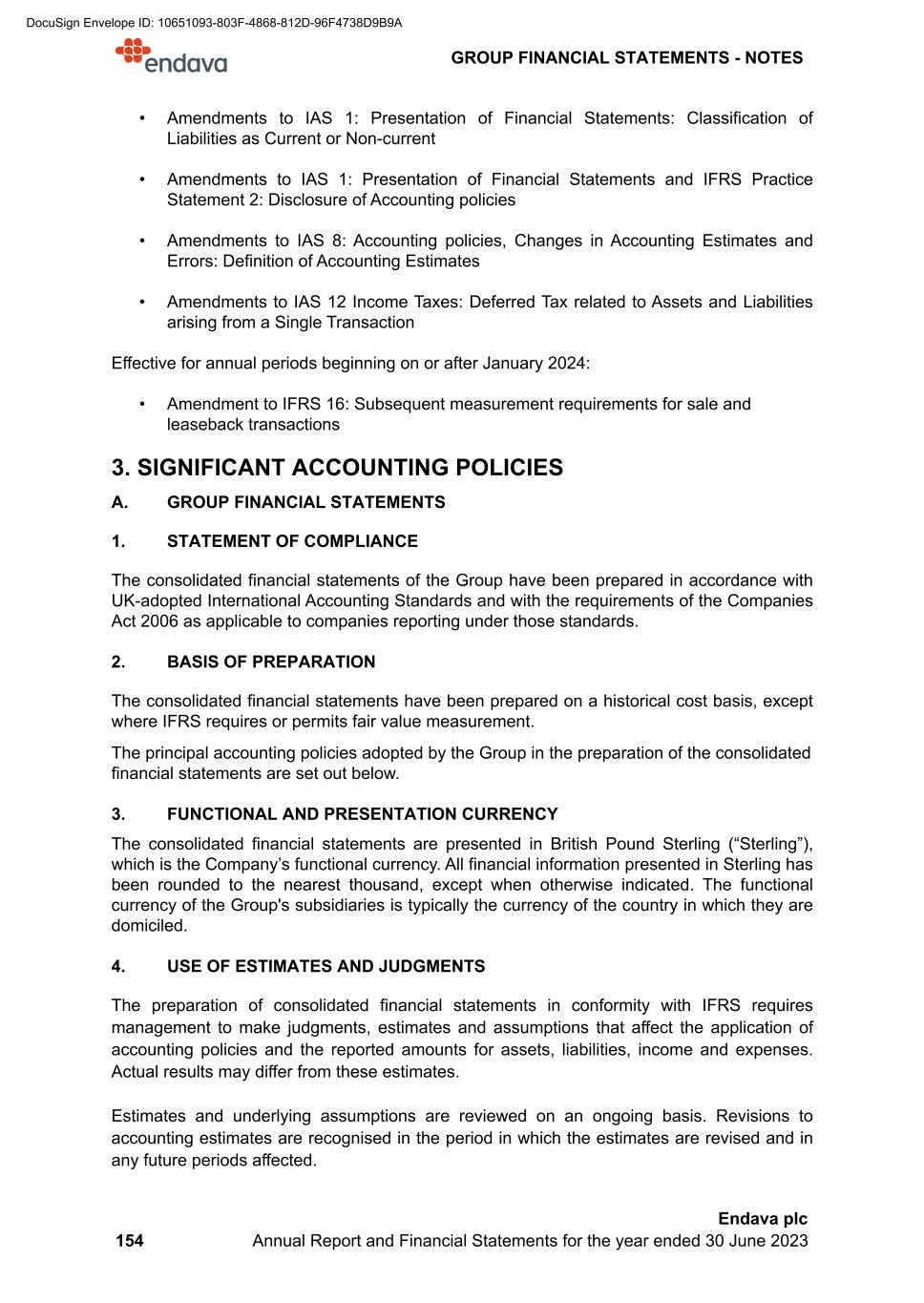
• Amendments to IAS 1: Presentation of Financial Statements: Classification of Liabilities as Current or Non-current • Amendments to IAS 1: Presentation of Financial Statements and IFRS Practice Statement 2: Disclosure of Accounting policies • Amendments to IAS 8: Accounting policies, Changes in Accounting Estimates and Errors: Definition of Accounting Estimates • Amendments to IAS 12 Income Taxes: Deferred Tax related to Assets and Liabilities arising from a Single Transaction Effective for annual periods beginning on or after January 2024: • Amendment to IFRS 16: Subsequent measurement requirements for sale and leaseback transactions 3. SIGNIFICANT ACCOUNTING POLICIES A. GROUP FINANCIAL STATEMENTS 1. STATEMENT OF COMPLIANCE The consolidated financial statements of the Group have been prepared in accordance with UK-adopted International Accounting Standards and with the requirements of the Companies Act 2006 as applicable to companies reporting under those standards. 2. BASIS OF PREPARATION The consolidated financial statements have been prepared on a historical cost basis, except where IFRS requires or permits fair value measurement. The principal accounting policies adopted by the Group in the preparation of the consolidated financial statements are set out below. 3. FUNCTIONAL AND PRESENTATION CURRENCY The consolidated financial statements are presented in British Pound Sterling (“Sterling”), which is the Company’s functional currency. All financial information presented in Sterling has been rounded to the nearest thousand, except when otherwise indicated. The functional currency of the Group's subsidiaries is typically the currency of the country in which they are domiciled. 4. USE OF ESTIMATES AND JUDGMENTS The preparation of consolidated financial statements in conformity with IFRS requires management to make judgments, estimates and assumptions that affect the application of accounting policies and the reported amounts for assets, liabilities, income and expenses. Actual results may differ from these estimates. Estimates and underlying assumptions are reviewed on an ongoing basis. Revisions to accounting estimates are recognised in the period in which the estimates are revised and in any future periods affected. GROUP FINANCIAL STATEMENTS - NOTES 154 Endava plc Annual Report and Financial Statements for the year ended 30 June 2023 DocuSign Envelope ID: 10651093-803F-4868-812D-96F4738D9B9A

The key areas involving estimates and judgments that have the most significant effect on the amounts recognised in the consolidated financial statements, are as follows: Business Combinations Business combinations are accounted for using the acquisition method. The results of businesses acquired in a business combination are included in our consolidated financial statements from the date of the acquisition. The acquisition method requires the assets and the liabilities to be recorded at their fair value on the acquisition date. Any excess consideration over the fair value of assets acquired and liabilities assumed is recognised as goodwill. If the initial accounting for the business combination has not been completed by the end of the reporting period in which the business combination occurs, provisional amounts are reported to present information about facts and circumstances that existed as of the acquisition date. Once the measurement period ends, which in no case extends beyond one year from the acquisition date, revisions to the accounting for the business combination shall be accounted for in accordance with IAS 8 - 'Accounting Policies, Changes in Accounting Estimates and Errors'. There is no complexity in identifying the different categories of intangible assets. We acquire businesses with similar profiles to the Group and the identifiable intangible assets are related to client relationships. Management applied significant judgement in estimating the fair value of the Lexicon and Mudbath client relationship intangible assets acquired, which required developing assumptions with respect to the timing and amounts of customer attrition rates and discount rates. For Lexicon, varying the customer attrition assumption by plus or minus 5% produces a spread of client relationship values that range by £0.4 million, and varying the discount factor by plus or minus 2.5% produces a spread of client relationship values that range by £1.9 million. For Mudbath, varying the client attrition assumption by plus or minus 5% produces a spread of client relationship values that range by £0.2 million, and varying the discount factor by plus or minus 2.5% produces a spread of client relationship values that range by £0.9 million. We note the ranges quoted above are not material, and management believes that reasonably possible changes to the inputs would not vary to the extent quoted above. As the acquisition accounting for DEK is provisional as at the balance sheet date, management estimated the fair value of the client relationships by applying an assumed client relationship fair value as a proportion of the total consideration transferred based on comparable historical acquisitions. Management applied judgement in determining the appropriate valuation method and assessing the comparability of historical acquisitions. Varying the historic benchmark of client relationship value as a proportion of consideration transferred by plus or minus 5% produces a spread of client relationship values that range by £5.7 million. Management expects to update the DEK client relationship fair value using a more detailed assessment as part of our normal process of finalising the acquisition accounting within the measurement period Further detailed information in relation to business combinations is included in note 15 to the financial statements. GROUP FINANCIAL STATEMENTS - NOTES 155 Endava plc Annual Report and Financial Statements for the year ended 30 June 2023 DocuSign Envelope ID: 10651093-803F-4868-812D-96F4738D9B9A
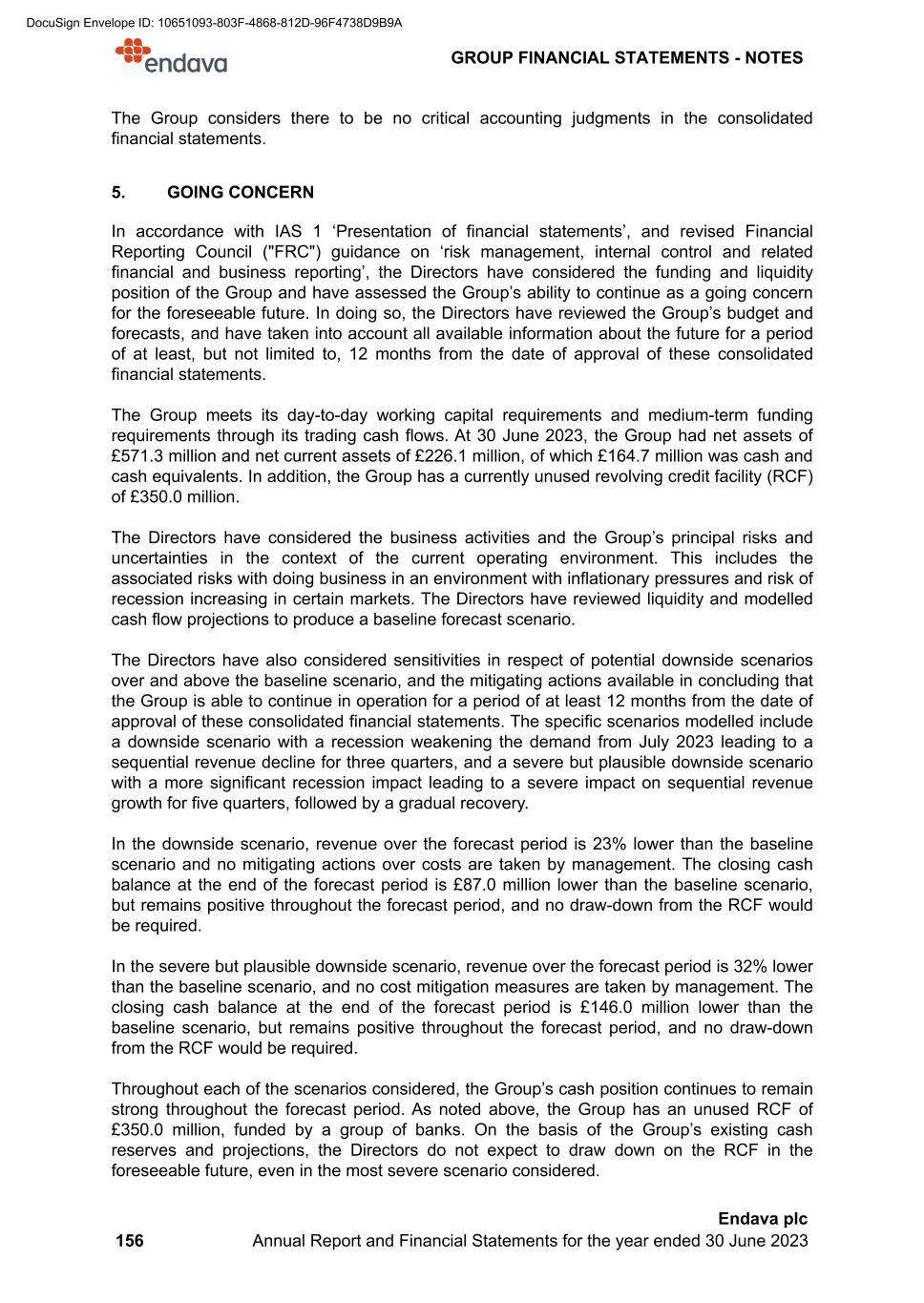
The Group considers there to be no critical accounting judgments in the consolidated financial statements. 5. GOING CONCERN In accordance with IAS 1 ‘Presentation of financial statements’, and revised Financial Reporting Council ("FRC") guidance on ‘risk management, internal control and related financial and business reporting’, the Directors have considered the funding and liquidity position of the Group and have assessed the Group’s ability to continue as a going concern for the foreseeable future. In doing so, the Directors have reviewed the Group’s budget and forecasts, and have taken into account all available information about the future for a period of at least, but not limited to, 12 months from the date of approval of these consolidated financial statements. The Group meets its day-to-day working capital requirements and medium-term funding requirements through its trading cash flows. At 30 June 2023, the Group had net assets of £571.3 million and net current assets of £226.1 million, of which £164.7 million was cash and cash equivalents. In addition, the Group has a currently unused revolving credit facility (RCF) of £350.0 million. The Directors have considered the business activities and the Group’s principal risks and uncertainties in the context of the current operating environment. This includes the associated risks with doing business in an environment with inflationary pressures and risk of recession increasing in certain markets. The Directors have reviewed liquidity and modelled cash flow projections to produce a baseline forecast scenario. The Directors have also considered sensitivities in respect of potential downside scenarios over and above the baseline scenario, and the mitigating actions available in concluding that the Group is able to continue in operation for a period of at least 12 months from the date of approval of these consolidated financial statements. The specific scenarios modelled include a downside scenario with a recession weakening the demand from July 2023 leading to a sequential revenue decline for three quarters, and a severe but plausible downside scenario with a more significant recession impact leading to a severe impact on sequential revenue growth for five quarters, followed by a gradual recovery. In the downside scenario, revenue over the forecast period is 23% lower than the baseline scenario and no mitigating actions over costs are taken by management. The closing cash balance at the end of the forecast period is £87.0 million lower than the baseline scenario, but remains positive throughout the forecast period, and no draw-down from the RCF would be required. In the severe but plausible downside scenario, revenue over the forecast period is 32% lower than the baseline scenario, and no cost mitigation measures are taken by management. The closing cash balance at the end of the forecast period is £146.0 million lower than the baseline scenario, but remains positive throughout the forecast period, and no draw-down from the RCF would be required. Throughout each of the scenarios considered, the Group’s cash position continues to remain strong throughout the forecast period. As noted above, the Group has an unused RCF of £350.0 million, funded by a group of banks. On the basis of the Group’s existing cash reserves and projections, the Directors do not expect to draw down on the RCF in the foreseeable future, even in the most severe scenario considered. GROUP FINANCIAL STATEMENTS - NOTES 156 Endava plc Annual Report and Financial Statements for the year ended 30 June 2023 DocuSign Envelope ID: 10651093-803F-4868-812D-96F4738D9B9A
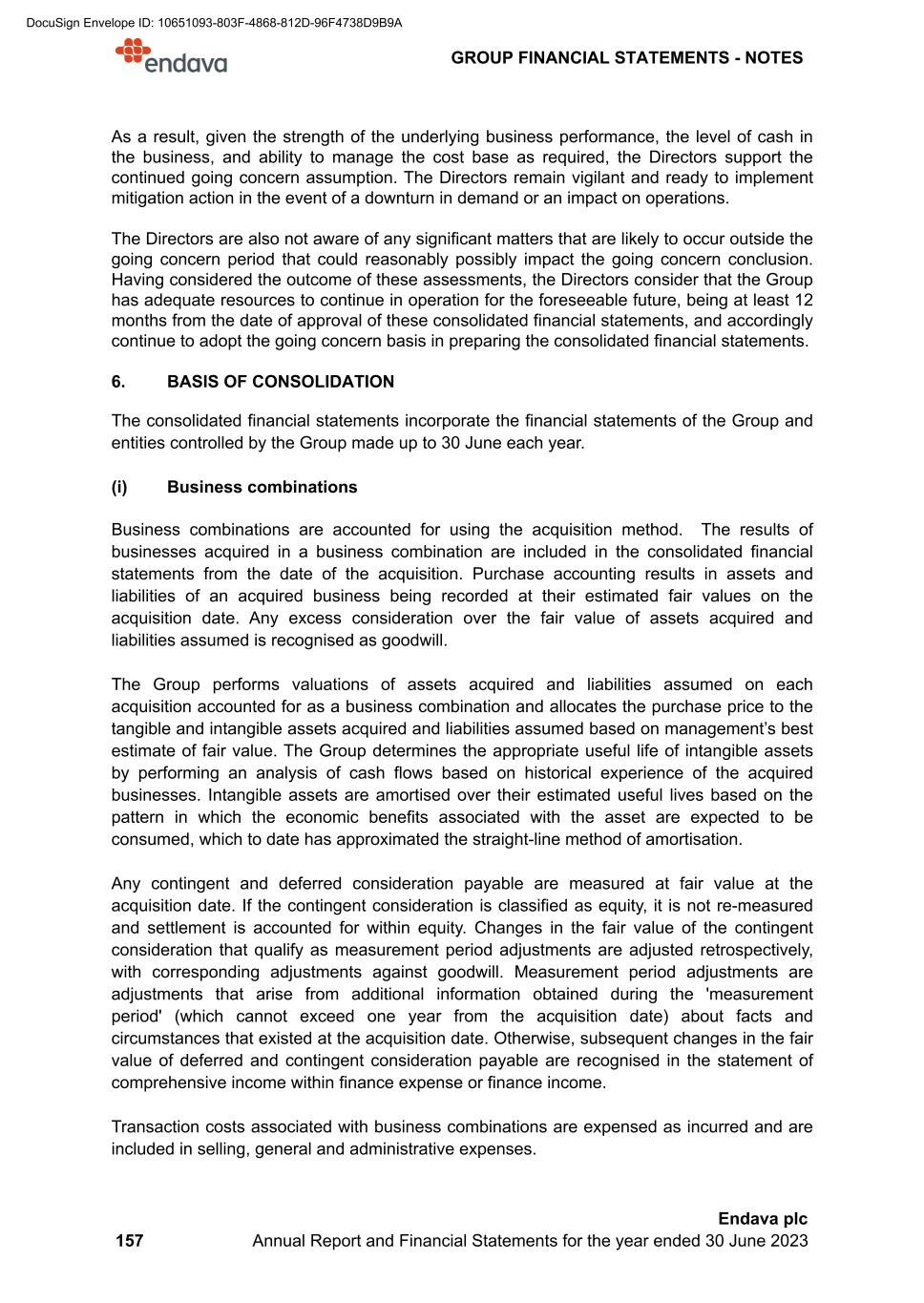
As a result, given the strength of the underlying business performance, the level of cash in the business, and ability to manage the cost base as required, the Directors support the continued going concern assumption. The Directors remain vigilant and ready to implement mitigation action in the event of a downturn in demand or an impact on operations. The Directors are also not aware of any significant matters that are likely to occur outside the going concern period that could reasonably possibly impact the going concern conclusion. Having considered the outcome of these assessments, the Directors consider that the Group has adequate resources to continue in operation for the foreseeable future, being at least 12 months from the date of approval of these consolidated financial statements, and accordingly continue to adopt the going concern basis in preparing the consolidated financial statements. 6. BASIS OF CONSOLIDATION The consolidated financial statements incorporate the financial statements of the Group and entities controlled by the Group made up to 30 June each year. (i) Business combinations Business combinations are accounted for using the acquisition method. The results of businesses acquired in a business combination are included in the consolidated financial statements from the date of the acquisition. Purchase accounting results in assets and liabilities of an acquired business being recorded at their estimated fair values on the acquisition date. Any excess consideration over the fair value of assets acquired and liabilities assumed is recognised as goodwill. The Group performs valuations of assets acquired and liabilities assumed on each acquisition accounted for as a business combination and allocates the purchase price to the tangible and intangible assets acquired and liabilities assumed based on management’s best estimate of fair value. The Group determines the appropriate useful life of intangible assets by performing an analysis of cash flows based on historical experience of the acquired businesses. Intangible assets are amortised over their estimated useful lives based on the pattern in which the economic benefits associated with the asset are expected to be consumed, which to date has approximated the straight-line method of amortisation. Any contingent and deferred consideration payable are measured at fair value at the acquisition date. If the contingent consideration is classified as equity, it is not re-measured and settlement is accounted for within equity. Changes in the fair value of the contingent consideration that qualify as measurement period adjustments are adjusted retrospectively, with corresponding adjustments against goodwill. Measurement period adjustments are adjustments that arise from additional information obtained during the 'measurement period' (which cannot exceed one year from the acquisition date) about facts and circumstances that existed at the acquisition date. Otherwise, subsequent changes in the fair value of deferred and contingent consideration payable are recognised in the statement of comprehensive income within finance expense or finance income. Transaction costs associated with business combinations are expensed as incurred and are included in selling, general and administrative expenses. GROUP FINANCIAL STATEMENTS - NOTES 157 Endava plc Annual Report and Financial Statements for the year ended 30 June 2023 DocuSign Envelope ID: 10651093-803F-4868-812D-96F4738D9B9A
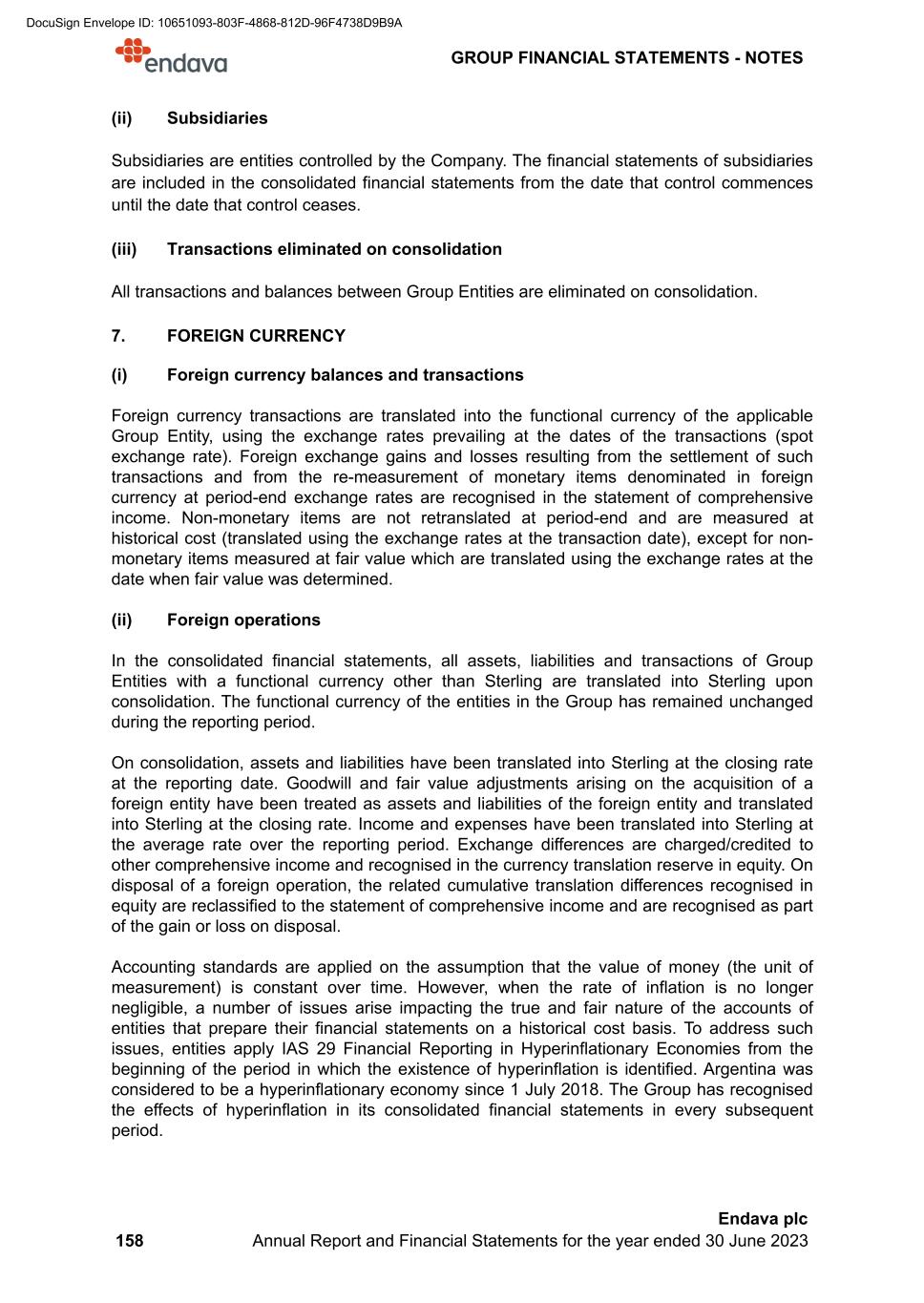
(ii) Subsidiaries Subsidiaries are entities controlled by the Company. The financial statements of subsidiaries are included in the consolidated financial statements from the date that control commences until the date that control ceases. (iii) Transactions eliminated on consolidation All transactions and balances between Group Entities are eliminated on consolidation. 7. FOREIGN CURRENCY (i) Foreign currency balances and transactions Foreign currency transactions are translated into the functional currency of the applicable Group Entity, using the exchange rates prevailing at the dates of the transactions (spot exchange rate). Foreign exchange gains and losses resulting from the settlement of such transactions and from the re-measurement of monetary items denominated in foreign currency at period-end exchange rates are recognised in the statement of comprehensive income. Non-monetary items are not retranslated at period-end and are measured at historical cost (translated using the exchange rates at the transaction date), except for non- monetary items measured at fair value which are translated using the exchange rates at the date when fair value was determined. (ii) Foreign operations In the consolidated financial statements, all assets, liabilities and transactions of Group Entities with a functional currency other than Sterling are translated into Sterling upon consolidation. The functional currency of the entities in the Group has remained unchanged during the reporting period. On consolidation, assets and liabilities have been translated into Sterling at the closing rate at the reporting date. Goodwill and fair value adjustments arising on the acquisition of a foreign entity have been treated as assets and liabilities of the foreign entity and translated into Sterling at the closing rate. Income and expenses have been translated into Sterling at the average rate over the reporting period. Exchange differences are charged/credited to other comprehensive income and recognised in the currency translation reserve in equity. On disposal of a foreign operation, the related cumulative translation differences recognised in equity are reclassified to the statement of comprehensive income and are recognised as part of the gain or loss on disposal. Accounting standards are applied on the assumption that the value of money (the unit of measurement) is constant over time. However, when the rate of inflation is no longer negligible, a number of issues arise impacting the true and fair nature of the accounts of entities that prepare their financial statements on a historical cost basis. To address such issues, entities apply IAS 29 Financial Reporting in Hyperinflationary Economies from the beginning of the period in which the existence of hyperinflation is identified. Argentina was considered to be a hyperinflationary economy since 1 July 2018. The Group has recognised the effects of hyperinflation in its consolidated financial statements in every subsequent period. GROUP FINANCIAL STATEMENTS - NOTES 158 Endava plc Annual Report and Financial Statements for the year ended 30 June 2023 DocuSign Envelope ID: 10651093-803F-4868-812D-96F4738D9B9A
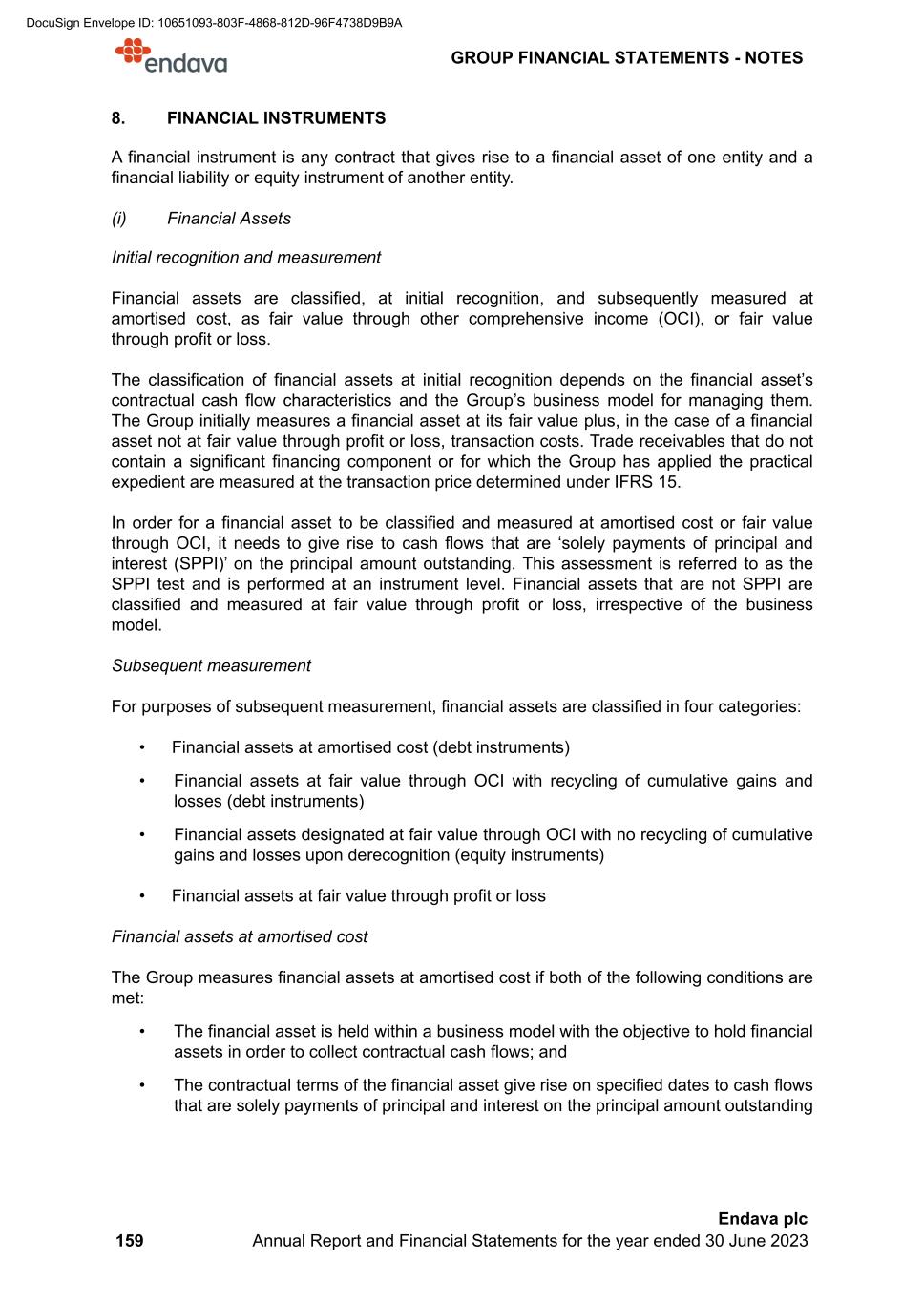
8. FINANCIAL INSTRUMENTS A financial instrument is any contract that gives rise to a financial asset of one entity and a financial liability or equity instrument of another entity. (i) Financial Assets Initial recognition and measurement Financial assets are classified, at initial recognition, and subsequently measured at amortised cost, as fair value through other comprehensive income (OCI), or fair value through profit or loss. The classification of financial assets at initial recognition depends on the financial asset’s contractual cash flow characteristics and the Group’s business model for managing them. The Group initially measures a financial asset at its fair value plus, in the case of a financial asset not at fair value through profit or loss, transaction costs. Trade receivables that do not contain a significant financing component or for which the Group has applied the practical expedient are measured at the transaction price determined under IFRS 15. In order for a financial asset to be classified and measured at amortised cost or fair value through OCI, it needs to give rise to cash flows that are ‘solely payments of principal and interest (SPPI)’ on the principal amount outstanding. This assessment is referred to as the SPPI test and is performed at an instrument level. Financial assets that are not SPPI are classified and measured at fair value through profit or loss, irrespective of the business model. Subsequent measurement For purposes of subsequent measurement, financial assets are classified in four categories: • Financial assets at amortised cost (debt instruments) • Financial assets at fair value through OCI with recycling of cumulative gains and losses (debt instruments) • Financial assets designated at fair value through OCI with no recycling of cumulative gains and losses upon derecognition (equity instruments) • Financial assets at fair value through profit or loss Financial assets at amortised cost The Group measures financial assets at amortised cost if both of the following conditions are met: • The financial asset is held within a business model with the objective to hold financial assets in order to collect contractual cash flows; and • The contractual terms of the financial asset give rise on specified dates to cash flows that are solely payments of principal and interest on the principal amount outstanding GROUP FINANCIAL STATEMENTS - NOTES 159 Endava plc Annual Report and Financial Statements for the year ended 30 June 2023 DocuSign Envelope ID: 10651093-803F-4868-812D-96F4738D9B9A

Financial assets at amortised cost are subsequently measured using the effective interest rate (EIR) method and are subject to impairment. Gains and losses are recognised in profit or loss when the asset is derecognised, modified or impaired. The Group’s financial assets at amortised cost includes cash and cash equivalents, trade and other receivables, and finance lease receivables. Financial assets at fair value through profit or loss Financial assets at fair value through profit or loss are carried in the balance sheet at fair value with net changes in fair value recognised in the statement of comprehensive income. Derecognition A financial asset is primarily derecognised when: • The rights to receive cash flows from the asset have expired; or • The Group has transferred its rights to receive cash flows from the asset and either (a) the Group has transferred substantially all the risks and rewards of the asset, or (b) the Group has neither transferred nor retained substantially all the risks and rewards of the asset, but has transferred control of the asset. The Group does not have financial assets at fair value through profit or loss or fair value through other comprehensive income. (ii) Financial Liabilities Initial recognition and measurement Financial liabilities are classified, at initial recognition, as financial liabilities at fair value through profit or loss, loans and borrowings, payables, or as derivatives designated as hedging instruments in an effective hedge, as appropriate. All financial liabilities are recognised initially at fair value and, in the case of loans and borrowings and payables, net of directly attributable transaction costs. The Group’s financial liabilities include trade and other payables and loans and borrowings. Subsequent measurement The measurement of financial liabilities depends on their classification, as described below: Financial liabilities at fair value through profit or loss Financial liabilities designated upon initial recognition at fair value through profit or loss are designated at the initial date of recognition, and only if the criteria in IFRS 9 are satisfied. Changes in the fair value of financial liabilities at fair value through profit or loss are recognised within finance income/finance expense in the consolidated statement of comprehensive income. GROUP FINANCIAL STATEMENTS - NOTES 160 Endava plc Annual Report and Financial Statements for the year ended 30 June 2023 DocuSign Envelope ID: 10651093-803F-4868-812D-96F4738D9B9A
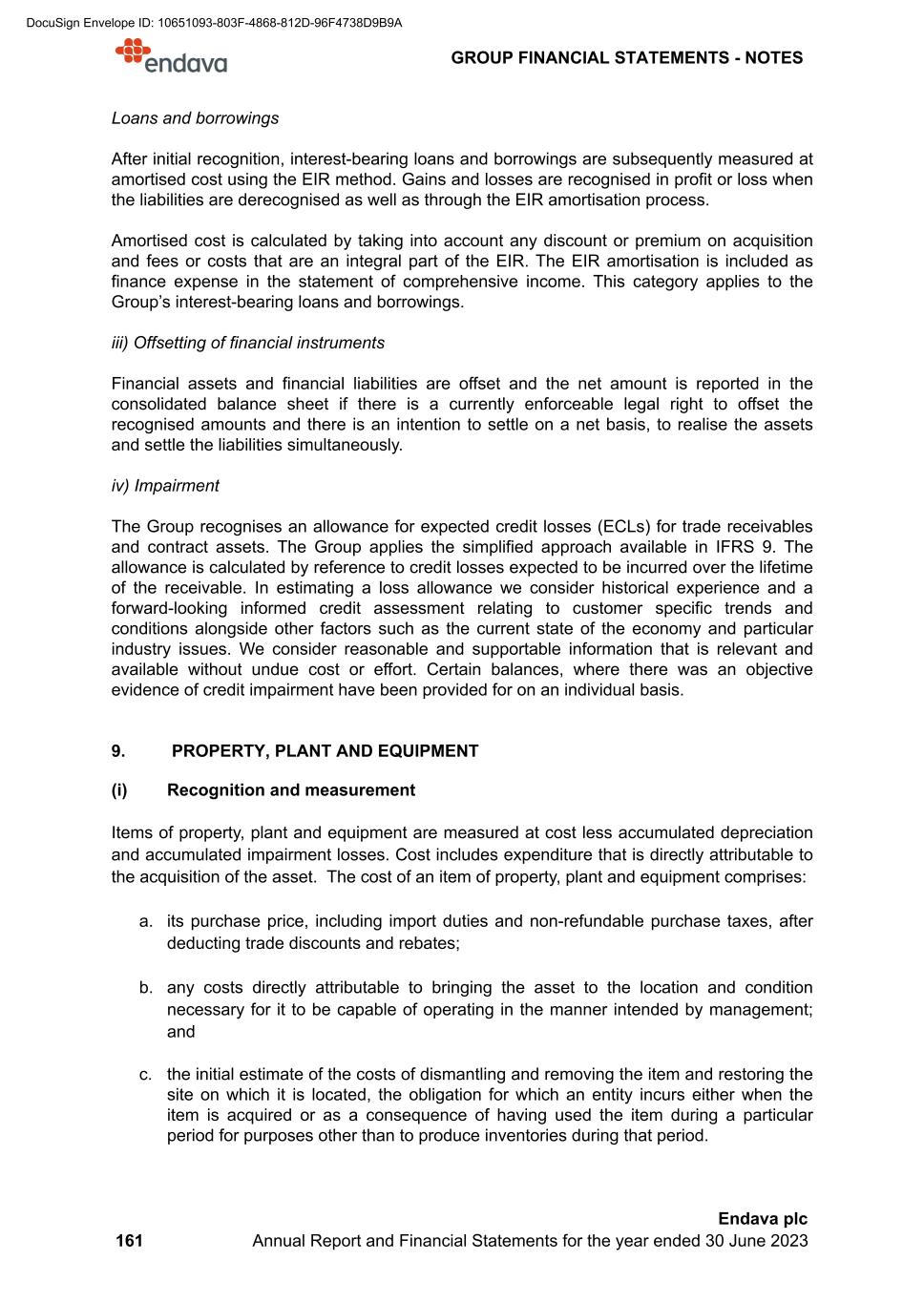
Loans and borrowings After initial recognition, interest-bearing loans and borrowings are subsequently measured at amortised cost using the EIR method. Gains and losses are recognised in profit or loss when the liabilities are derecognised as well as through the EIR amortisation process. Amortised cost is calculated by taking into account any discount or premium on acquisition and fees or costs that are an integral part of the EIR. The EIR amortisation is included as finance expense in the statement of comprehensive income. This category applies to the Group’s interest-bearing loans and borrowings. iii) Offsetting of financial instruments Financial assets and financial liabilities are offset and the net amount is reported in the consolidated balance sheet if there is a currently enforceable legal right to offset the recognised amounts and there is an intention to settle on a net basis, to realise the assets and settle the liabilities simultaneously. iv) Impairment The Group recognises an allowance for expected credit losses (ECLs) for trade receivables and contract assets. The Group applies the simplified approach available in IFRS 9. The allowance is calculated by reference to credit losses expected to be incurred over the lifetime of the receivable. In estimating a loss allowance we consider historical experience and a forward-looking informed credit assessment relating to customer specific trends and conditions alongside other factors such as the current state of the economy and particular industry issues. We consider reasonable and supportable information that is relevant and available without undue cost or effort. Certain balances, where there was an objective evidence of credit impairment have been provided for on an individual basis. 9. PROPERTY, PLANT AND EQUIPMENT (i) Recognition and measurement Items of property, plant and equipment are measured at cost less accumulated depreciation and accumulated impairment losses. Cost includes expenditure that is directly attributable to the acquisition of the asset. The cost of an item of property, plant and equipment comprises: a. its purchase price, including import duties and non-refundable purchase taxes, after deducting trade discounts and rebates; b. any costs directly attributable to bringing the asset to the location and condition necessary for it to be capable of operating in the manner intended by management; and c. the initial estimate of the costs of dismantling and removing the item and restoring the site on which it is located, the obligation for which an entity incurs either when the item is acquired or as a consequence of having used the item during a particular period for purposes other than to produce inventories during that period. GROUP FINANCIAL STATEMENTS - NOTES 161 Endava plc Annual Report and Financial Statements for the year ended 30 June 2023 DocuSign Envelope ID: 10651093-803F-4868-812D-96F4738D9B9A

When parts of an item of property, plant and equipment have different useful lives, they are accounted for as separate items. Any gain or loss on disposal of an item of property, plant and equipment (calculated as the difference between net proceeds from disposal and the carrying amount of the item) is recognised in the statement of comprehensive income. (ii) Subsequent costs Subsequent expenditure is capitalised only when it is probable that future economic benefits associated with the expenditure will flow to the Group. Ongoing repairs and maintenance are expensed as incurred. (iii) Depreciation Items of property, plant and equipment are depreciated on a straight-line basis in profit or loss over the estimated useful lives of each component. Leased assets are depreciated over the shorter of the leased term and their useful lives unless it is reasonably certain that the Group will obtain ownership by the end of the leased term. Land is not depreciated. Items of property, plant and equipment are depreciated from the date they are installed and are ready for use, or in respect of internally constructed assets, from the date that the asset is completed and ready for use. Depreciation is calculated so as to write off the cost of an asset, less its estimated residual value, over the useful economic life of that asset as follows: Computers and equipment 3 - 5 years Fixtures and fittings 5 years Leasehold improvement fittings Over the lease term Depreciation methods, useful lives and residual values are reviewed at each reporting date and adjusted if appropriate. Leasehold improvement fittings are included in the fixtures and fittings category in Note 17. 10. INTANGIBLE ASSETS AND GOODWILL (i) Goodwill Goodwill represents the excess of the aggregate purchase price paid over the fair value of the net assets acquired in our business combinations. Goodwill is not amortised and is tested for impairment at least annually or whenever events or changes in circumstances indicate that the carrying value may not be recoverable. GROUP FINANCIAL STATEMENTS - NOTES 162 Endava plc Annual Report and Financial Statements for the year ended 30 June 2023 DocuSign Envelope ID: 10651093-803F-4868-812D-96F4738D9B9A
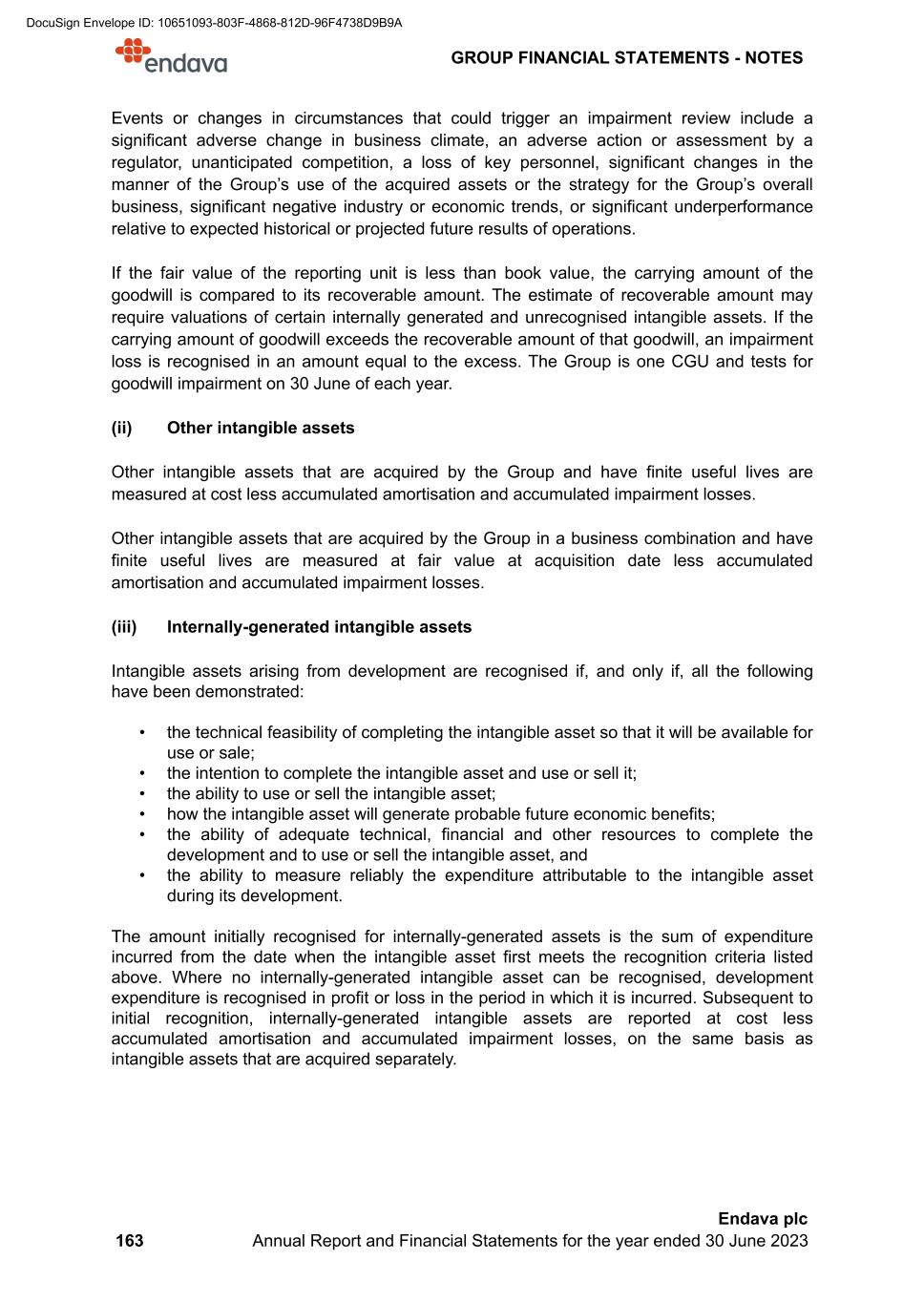
Events or changes in circumstances that could trigger an impairment review include a significant adverse change in business climate, an adverse action or assessment by a regulator, unanticipated competition, a loss of key personnel, significant changes in the manner of the Group’s use of the acquired assets or the strategy for the Group’s overall business, significant negative industry or economic trends, or significant underperformance relative to expected historical or projected future results of operations. If the fair value of the reporting unit is less than book value, the carrying amount of the goodwill is compared to its recoverable amount. The estimate of recoverable amount may require valuations of certain internally generated and unrecognised intangible assets. If the carrying amount of goodwill exceeds the recoverable amount of that goodwill, an impairment loss is recognised in an amount equal to the excess. The Group is one CGU and tests for goodwill impairment on 30 June of each year. (ii) Other intangible assets Other intangible assets that are acquired by the Group and have finite useful lives are measured at cost less accumulated amortisation and accumulated impairment losses. Other intangible assets that are acquired by the Group in a business combination and have finite useful lives are measured at fair value at acquisition date less accumulated amortisation and accumulated impairment losses. (iii) Internally-generated intangible assets Intangible assets arising from development are recognised if, and only if, all the following have been demonstrated: • the technical feasibility of completing the intangible asset so that it will be available for use or sale; • the intention to complete the intangible asset and use or sell it; • the ability to use or sell the intangible asset; • how the intangible asset will generate probable future economic benefits; • the ability of adequate technical, financial and other resources to complete the development and to use or sell the intangible asset, and • the ability to measure reliably the expenditure attributable to the intangible asset during its development. The amount initially recognised for internally-generated assets is the sum of expenditure incurred from the date when the intangible asset first meets the recognition criteria listed above. Where no internally-generated intangible asset can be recognised, development expenditure is recognised in profit or loss in the period in which it is incurred. Subsequent to initial recognition, internally-generated intangible assets are reported at cost less accumulated amortisation and accumulated impairment losses, on the same basis as intangible assets that are acquired separately. GROUP FINANCIAL STATEMENTS - NOTES 163 Endava plc Annual Report and Financial Statements for the year ended 30 June 2023 DocuSign Envelope ID: 10651093-803F-4868-812D-96F4738D9B9A

(iv) Subsequent expenditure Subsequent expenditure is only capitalised when it increases the future economic benefits embodied in the specific asset to which it relates. All other expenditure, is recognised in the statement of comprehensive income as incurred. (v) Amortisation Except for goodwill, intangible assets are amortised on a straight-line basis in the statement of comprehensive income over their estimated useful lives, from the date they are available for use. Client relationship 1 - 10 years Supplier relationships 5 years Non-compete agreement 3 years Computer software 3 – 5 years Licences Shorter of licence period and up to 3 years Software - own work capitalised 3 - 5 years 11. LEASE AGREEMENTS The Group assesses whether a contract is, or contains, a lease at the inception of a contract. A contract is, or contains, a lease if the contract conveys the right to control the use of an identified asset for a period of time in exchange for consideration. To assess whether a contract conveys the right to control the use of an identified asset, the Group uses the definition of a lease in IFRS 16. The Group as a lessee The Group recognises a right-of-use asset and a lease liability at the lease commencement date with respect to all lease arrangements except for short-term leases (leases with a lease term of 12 months or less) and leases of low value assets. For these leases, the lease payments are recognised within selling, general and administrative expenses on a straight- line basis over the term of the lease. As the majority of the Group’s lease portfolio relates to property leases of offices and delivery centres, the Group has elected not to separate non-lease components and therefore accounts for the lease and non-lease component as a single lease component. Right-of-use assets are initially measured at cost, comprising the initial amount of the corresponding lease liability, adjusted for any lease payments made at or before the commencement date, plus any initial direct costs incurred, and an estimate of costs to dismantle and remove the underlying asset or to restore the underlying asset or the site on which it is located, less any lease incentives received. Right-of-use assets are subsequently depreciated using the straight-line method from the commencement date to the end of the lease term, unless the lease transfers ownership of the underlying asset to the Group by the end of the lease term or the cost of the right-of-use asset reflects that the Group will exercise a purchase option. In that case, the right-of-use asset will be depreciated over the useful life of the underlying asset, which is determined on the same basis as those of property, plant and equipment. In addition, right-of-use assets are adjusted for any remeasurement of lease liabilities. GROUP FINANCIAL STATEMENTS - NOTES 164 Endava plc Annual Report and Financial Statements for the year ended 30 June 2023 DocuSign Envelope ID: 10651093-803F-4868-812D-96F4738D9B9A
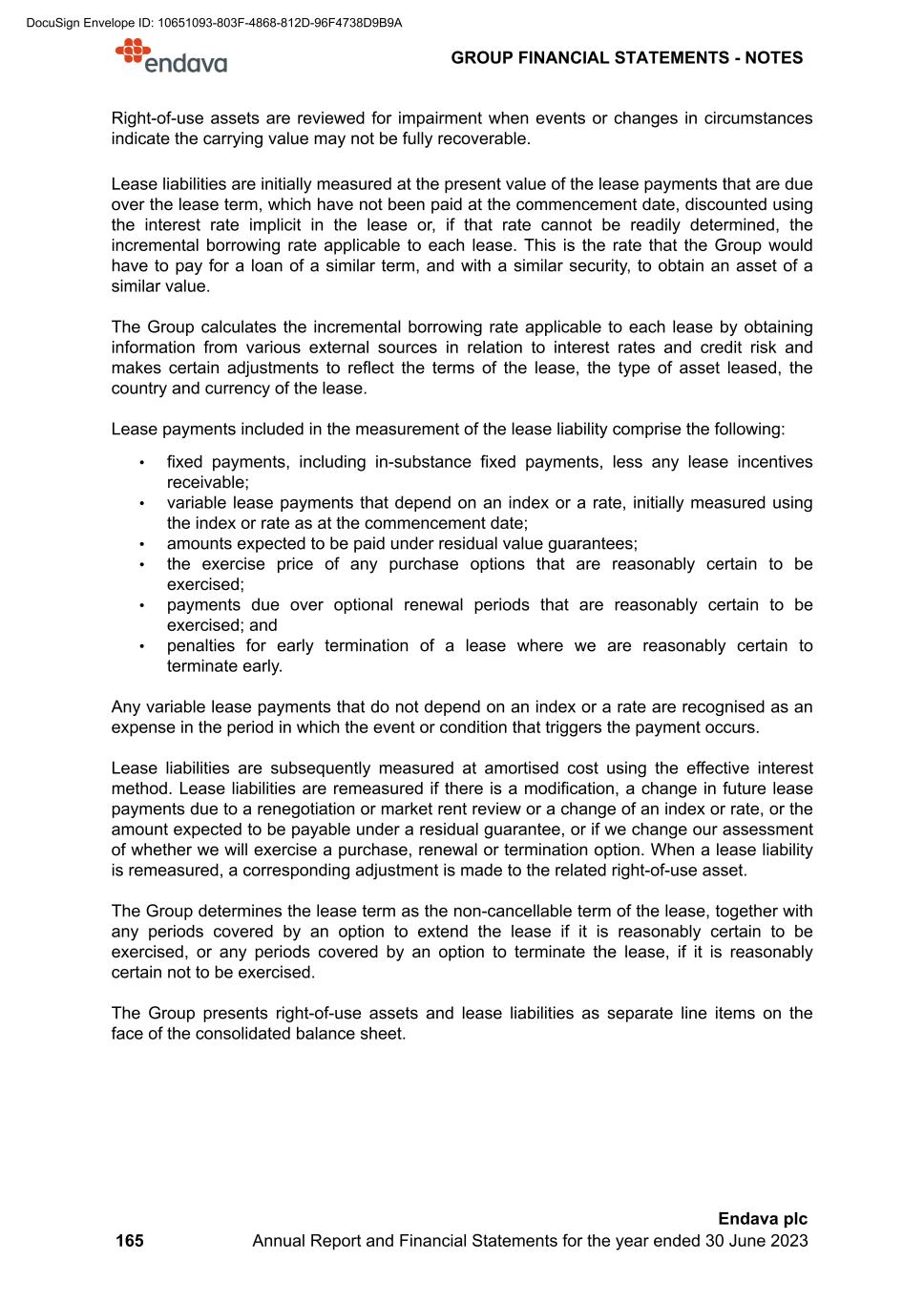
Right-of-use assets are reviewed for impairment when events or changes in circumstances indicate the carrying value may not be fully recoverable. Lease liabilities are initially measured at the present value of the lease payments that are due over the lease term, which have not been paid at the commencement date, discounted using the interest rate implicit in the lease or, if that rate cannot be readily determined, the incremental borrowing rate applicable to each lease. This is the rate that the Group would have to pay for a loan of a similar term, and with a similar security, to obtain an asset of a similar value. The Group calculates the incremental borrowing rate applicable to each lease by obtaining information from various external sources in relation to interest rates and credit risk and makes certain adjustments to reflect the terms of the lease, the type of asset leased, the country and currency of the lease. Lease payments included in the measurement of the lease liability comprise the following: • fixed payments, including in-substance fixed payments, less any lease incentives receivable; • variable lease payments that depend on an index or a rate, initially measured using the index or rate as at the commencement date; • amounts expected to be paid under residual value guarantees; • the exercise price of any purchase options that are reasonably certain to be exercised; • payments due over optional renewal periods that are reasonably certain to be exercised; and • penalties for early termination of a lease where we are reasonably certain to terminate early. Any variable lease payments that do not depend on an index or a rate are recognised as an expense in the period in which the event or condition that triggers the payment occurs. Lease liabilities are subsequently measured at amortised cost using the effective interest method. Lease liabilities are remeasured if there is a modification, a change in future lease payments due to a renegotiation or market rent review or a change of an index or rate, or the amount expected to be payable under a residual guarantee, or if we change our assessment of whether we will exercise a purchase, renewal or termination option. When a lease liability is remeasured, a corresponding adjustment is made to the related right-of-use asset. The Group determines the lease term as the non-cancellable term of the lease, together with any periods covered by an option to extend the lease if it is reasonably certain to be exercised, or any periods covered by an option to terminate the lease, if it is reasonably certain not to be exercised. The Group presents right-of-use assets and lease liabilities as separate line items on the face of the consolidated balance sheet. GROUP FINANCIAL STATEMENTS - NOTES 165 Endava plc Annual Report and Financial Statements for the year ended 30 June 2023 DocuSign Envelope ID: 10651093-803F-4868-812D-96F4738D9B9A

The Group as a lessor When the Group acts as a lessor, it determines at lease inception whether each lease is a finance lease or an operating lease. To classify each lease, the Group makes an overall assessment of whether the lease transfers substantially all of the risks and rewards incidental to ownership of the underlying asset. If this is the case, then the lease is a finance lease; if not then it is an operating lease. As part of this assessment, the Group considers certain indicators such as whether the lease is for the major part of the economic life of the asset. When the Group is an intermediate lessor, the head-lease and sub-lease are accounted for as two separate contracts. The head lease is accounted for as per the lessee policy above. The sub-lease is classified as a finance lease or operating lease by reference to the right-of- use asset arising from the head lease. Where the lease transfers substantially all the risks and rewards of ownership to the lessee the contract is classified as a finance lease; all other leases are classified as operating leases. If an arrangement contains lease and non-lease components, the Group applies IFRS 15 to allocate the consideration in the contract. Rental income from operating leases is recognised on a straight-line basis over the term of the relevant lease. Amounts due from lessees under finance sub-leases are recognised as receivables at the amount of the Group’s net investment in the leases, discounted using the interest rate implicit in the lease or, if that rate cannot be readily determined, the discount rate used in the head lease. 12. IMPAIRMENT Non-financial assets The carrying amounts of the Group’s non-financial assets, other than deferred tax assets, are reviewed at each reporting period to determine whether there is any indication of impairment. Goodwill and indefinite-lived intangible assets are tested at least annually for impairment. For impairment assessment purposes, non-financial assets are grouped at the lowest levels for which there are largely independent cash inflows (cash generating units). The cash-generating unit to which goodwill has been allocated (determined by the Group’s management as equivalent to its operating segments) is tested for impairment at least annually. All other individual assets or the cash-generating unit are tested for impairment whenever events or changes in circumstances indicate that the carrying amount may not be recoverable. An impairment loss is recognised for the amount by which the asset or cash- generating unit’s carrying amount exceeds its recoverable amount, which is the higher of fair value less costs to sell and value-in use. The group has one class of business (the provision of IT services) and is managed on a single consolidated P&L, and therefore, CGU basis. To determine the value-in-use, management estimates expected future cash flows from each cash generating unit and determines a suitable discount rate in order to calculate the present value of those cash flows. The data used for impairment testing procedures are directly linked to the Group’s latest approved budget, adjusted as necessary to exclude the effects of future reorganisations and asset enhancements. Discount factors are determined individually for each cash-generating unit and reflect management’s assessment of respective risk profiles, such as market and asset-specific risks factors. Impairment losses for cash- generating units reduce first the carrying amount of any goodwill allocated to that cash- generating unit. Any remaining impairment loss is charged pro rata to the other assets in the cash-generating unit. GROUP FINANCIAL STATEMENTS - NOTES 166 Endava plc Annual Report and Financial Statements for the year ended 30 June 2023 DocuSign Envelope ID: 10651093-803F-4868-812D-96F4738D9B9A

With the exception of goodwill, all assets are subsequently reassessed for indications that an impairment loss previously recognised may no longer exist. An impairment charge is reversed if the cash-generating unit’s recoverable amount exceeds its carrying amount. 13. EMPLOYEE BENEFITS (i) Termination benefits Termination benefits are recognised as an expense when the Group is demonstrably committed, without realistic probability of withdrawal, to a formal detailed plan to either terminate employment before retirement date, or to provide termination benefits as a result of an offer made to encourage voluntary redundancy. Termination benefits of voluntary redundancies are recognised as an expense if the Group has made an offer to voluntary redundancy, it is probable that the offer will be accepted, and the number of acceptances can be estimated reliably. If the benefits are payable more than 12 months after the reporting date, then they are discounted to their present value. (ii) Short-term employee benefits Short-term employee benefit obligations are measured at an undiscounted basis and are expensed as the related service is provided. A liability is recognised for the amount expected to be paid under short-term cash bonus or profit-sharing plans if the Group has a present legal or constructive obligation to pay this amount as a result of past service provided by the employee, and the obligation can be estimated reliably. The Group operates a defined contribution pension scheme for employees. The assets of the scheme are held separately from those of the Group. The annual contributions payable are charged to the statement of comprehensive income. (iii) Employee benefit trust All assets and liabilities of the Endava Limited Guernsey Employee Benefit Trust (the "EBT”) have been consolidated in the consolidated financial statements as the Group has de facto control over the EBT’s net assets. Any assets held by the EBT cease to be recognised on the Group balance sheet when the assets vest unconditionally in identified beneficiaries. The costs of purchasing own shares held by the EBT are shown as a deduction against equity of the Group. The proceeds from the sale of own shares held by the EBT increases shareholders’ funds. Neither the purchase nor sale of own shares leads to a gain or loss being recognised in the Group’s statement of comprehensive income. (iv) Employee share schemes and share based payments The Group issues equity settled share options to its employees. The payments are measured at fair value at date of grant. The fair value of the share options issued is expensed to the statement of comprehensive income on a straight line basis over the vesting period, based on the Group's estimate of the number of options that will eventually vest, updated at each balance sheet date. For more details on the Group’s share based payments refer to Note 26. GROUP FINANCIAL STATEMENTS - NOTES 167 Endava plc Annual Report and Financial Statements for the year ended 30 June 2023 DocuSign Envelope ID: 10651093-803F-4868-812D-96F4738D9B9A

14. REVENUE The Group generates revenue primarily from its single class of business being the provision of IT services. It recognises revenue in accordance with IFRS 15 – “Revenue from Contracts with Customers”: a. The Group accounts for a contract when it has approval and commitment from both parties, the rights of the parties are identified, payment terms are identified, the contract has commercial substance and collectability of consideration is probable. b. The Group identifies its distinct performance obligations under each contract. A performance obligation is a promise in a contract to transfer a distinct product or service to the customer. c. The transaction price is the amount of consideration to which the Group expects to be entitled in exchange for transferring products or services to a customer. With respect to all types of contracts, revenue is only recognised when the performance obligations are satisfied and the control of the services is transferred to the customer, either over time or at a point in time, at an amount that reflects the consideration to which the Group expects to be entitled in exchange for those services. d. The Group considers the majority of its contracts to have a single performance obligation. In cases in which there are multiple performance obligations in the contract, a separate price allocation is performed based on relative standalone selling prices. e. Revenue is measured at the fair value of the consideration received, excluding discounts, rebates and taxes. The Group’s services are generally performed under time-and-material based contracts (where materials consist of travel and out-of-pocket expenses) and fixed-price contracts. The vast majority of our contracts are relatively short-term in nature and have a single performance obligation. Under time-and-materials based contracts, the Group charges for services based on daily or hourly rates and generally bills and collects monthly in arrears. The Group applies the practical expedient. Under the practical expedient, if the vendor’s right to consideration from a customer corresponds directly with the value to the customer of the vendor’s performance completed to date, the vendor can recognise revenue at the amount to which the vendor has the right to invoice. Consequently the revenue from time-and-materials contracts is recognised based on the right to invoice for services performed, with the corresponding cost of providing those services reflected as cost of sales when incurred. Fixed price contracts are predominantly flat rate recurring service arrangements provided evenly over time, where revenue is recognised on a straight-line basis over the period of the service and do not require any judgment. A small proportion of fixed price contracts contain percentage of completion and milestone contracts recognised over time. Percentage of completion and milestone contract revenue is recognised over time applying the input or output methods depending on the nature of the project and the agreement with the customer. GROUP FINANCIAL STATEMENTS - NOTES 168 Endava plc Annual Report and Financial Statements for the year ended 30 June 2023 DocuSign Envelope ID: 10651093-803F-4868-812D-96F4738D9B9A

The input method is applied by recognising revenue on the basis of the Group’s efforts to date to the satisfaction of the performance obligation relative to the total expected inputs to the satisfaction of the performance obligation. The output method is applied by recognising revenue on the basis of direct measurements of the value to the customer of the services transferred to date relative to the remaining services promised under the contract, respectively. Each method is applied according to the characteristics of each contract and client. The inputs and outputs are selected based on how faithfully they depict the Group's performance towards complete satisfaction of the performance obligation. These methods are followed where reasonably dependable estimates of revenues and costs can be made. Percentage of completion and milestone contracts generally correspond to short-term contracts that generally do not span more than one accounting period. The Group also enters into a small number of volume-based arrangements where revenue is recognised based upon performance of certain activities (e.g. processing of IT service tickets). Volume-based revenue is recognised over time based on the volume of IT related services provided in the period at the fixed rate per activity. Variable consideration usually takes the form of volume-based discounts, price concessions or incentives. Determining the estimated amount of such variable consideration involves assumptions and estimation uncertainty that can have an impact on the amount of revenues reported. From time to time, the Group may enter into arrangements with third-party suppliers to sell services. In such cases, the Group evaluates whether it is the principal (i.e., reports revenues on a gross basis) or the agent (i.e., reports revenues on a net basis). In doing so, the Group first evaluates whether it has control of the service before it is transferred to the customer. If the Group controls the service before it is transferred to the customer, the Group is the principal; if not, the Group is the agent. Determining whether the Group controls the service before it is transferred to the customer may require judgment. A contract asset is a right to consideration that is conditional upon factors other than the passage of time. Contract assets primarily relate to unbilled amounts on fixed-price contracts. Services performed on or prior to the balance sheet date, but invoiced thereafter, are reflected in accrued income. Contract liabilities, or deferred income, consist of advance payments from clients and billings in excess of revenues recognised. The Group classifies deferred income as current on the consolidated balance sheet and it is recognised as revenue when the services are provided under a contract. These balances are generally short-term in nature and are generally recognised as revenue within one year. 15. COST OF SALES The Group divides cost of sales into two categories: direct cost of sales and allocated cost of sales. Direct cost of sales consists primarily of personnel costs, including salary, bonuses, share-based compensation, benefits and travel expenses for the Group’s employees directly involved in delivery of the Group’s services, as well as software licenses and other costs that relate directly to the delivery of services. Allocated cost of sales consists of the portion of depreciation and amortisation expense and property costs related to delivery of the Group’s services. The allocation is done based on headcount. GROUP FINANCIAL STATEMENTS - NOTES 169 Endava plc Annual Report and Financial Statements for the year ended 30 June 2023 DocuSign Envelope ID: 10651093-803F-4868-812D-96F4738D9B9A
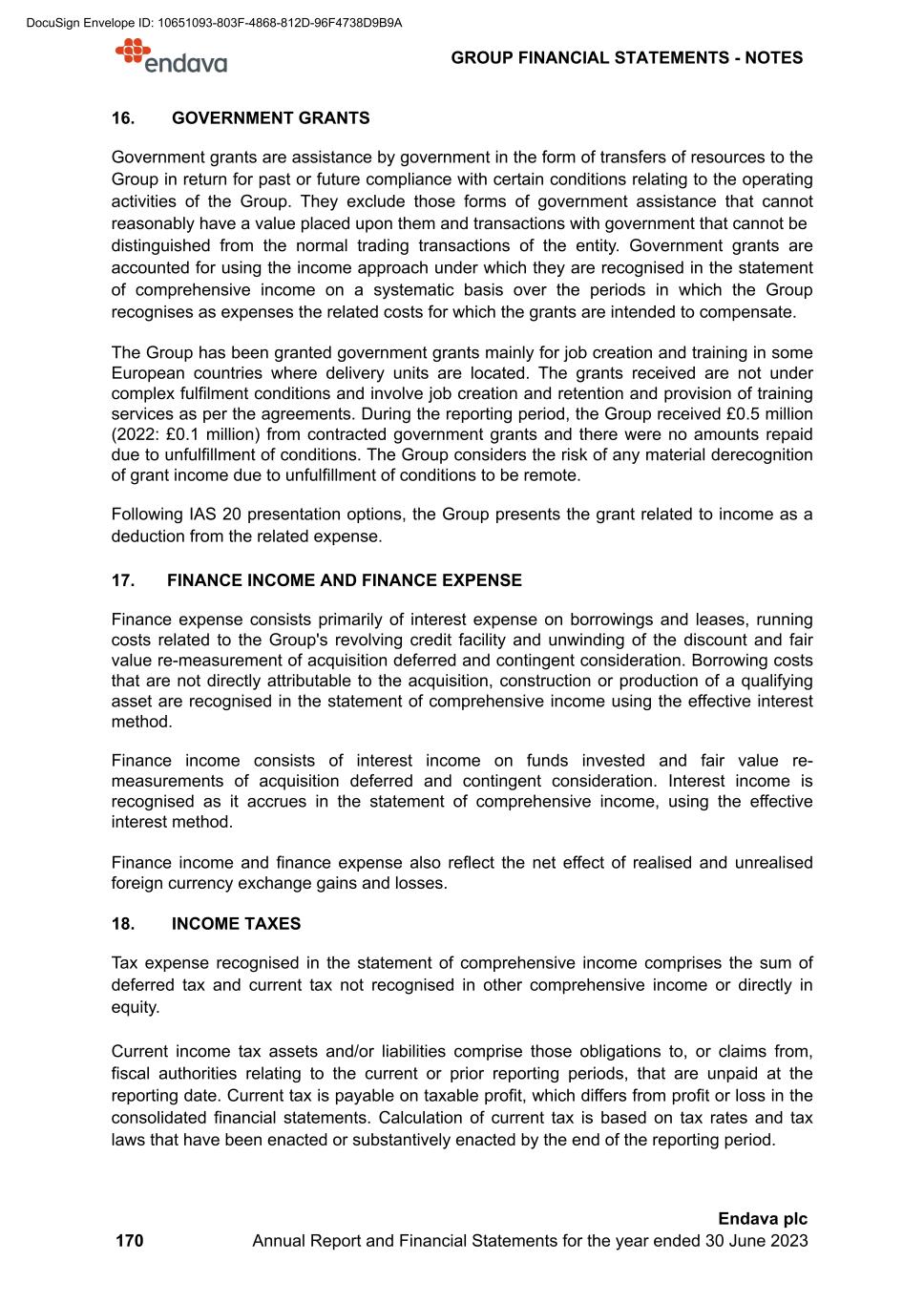
16. GOVERNMENT GRANTS Government grants are assistance by government in the form of transfers of resources to the Group in return for past or future compliance with certain conditions relating to the operating activities of the Group. They exclude those forms of government assistance that cannot reasonably have a value placed upon them and transactions with government that cannot be distinguished from the normal trading transactions of the entity. Government grants are accounted for using the income approach under which they are recognised in the statement of comprehensive income on a systematic basis over the periods in which the Group recognises as expenses the related costs for which the grants are intended to compensate. The Group has been granted government grants mainly for job creation and training in some European countries where delivery units are located. The grants received are not under complex fulfilment conditions and involve job creation and retention and provision of training services as per the agreements. During the reporting period, the Group received £0.5 million (2022: £0.1 million) from contracted government grants and there were no amounts repaid due to unfulfillment of conditions. The Group considers the risk of any material derecognition of grant income due to unfulfillment of conditions to be remote. Following IAS 20 presentation options, the Group presents the grant related to income as a deduction from the related expense. 17. FINANCE INCOME AND FINANCE EXPENSE Finance expense consists primarily of interest expense on borrowings and leases, running costs related to the Group's revolving credit facility and unwinding of the discount and fair value re-measurement of acquisition deferred and contingent consideration. Borrowing costs that are not directly attributable to the acquisition, construction or production of a qualifying asset are recognised in the statement of comprehensive income using the effective interest method. Finance income consists of interest income on funds invested and fair value re- measurements of acquisition deferred and contingent consideration. Interest income is recognised as it accrues in the statement of comprehensive income, using the effective interest method. Finance income and finance expense also reflect the net effect of realised and unrealised foreign currency exchange gains and losses. 18. INCOME TAXES Tax expense recognised in the statement of comprehensive income comprises the sum of deferred tax and current tax not recognised in other comprehensive income or directly in equity. Current income tax assets and/or liabilities comprise those obligations to, or claims from, fiscal authorities relating to the current or prior reporting periods, that are unpaid at the reporting date. Current tax is payable on taxable profit, which differs from profit or loss in the consolidated financial statements. Calculation of current tax is based on tax rates and tax laws that have been enacted or substantively enacted by the end of the reporting period. GROUP FINANCIAL STATEMENTS - NOTES 170 Endava plc Annual Report and Financial Statements for the year ended 30 June 2023 DocuSign Envelope ID: 10651093-803F-4868-812D-96F4738D9B9A
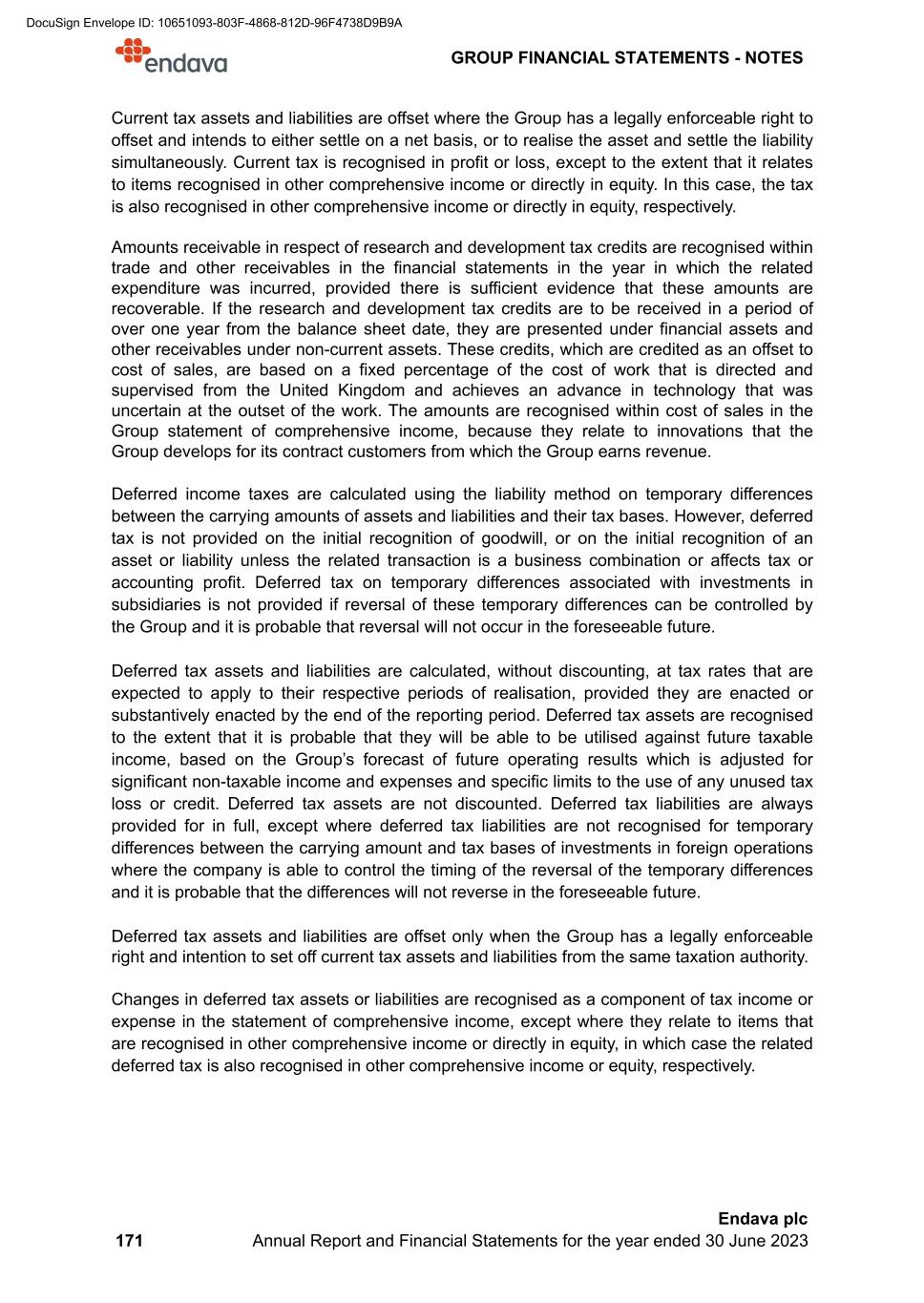
Current tax assets and liabilities are offset where the Group has a legally enforceable right to offset and intends to either settle on a net basis, or to realise the asset and settle the liability simultaneously. Current tax is recognised in profit or loss, except to the extent that it relates to items recognised in other comprehensive income or directly in equity. In this case, the tax is also recognised in other comprehensive income or directly in equity, respectively. Amounts receivable in respect of research and development tax credits are recognised within trade and other receivables in the financial statements in the year in which the related expenditure was incurred, provided there is sufficient evidence that these amounts are recoverable. If the research and development tax credits are to be received in a period of over one year from the balance sheet date, they are presented under financial assets and other receivables under non-current assets. These credits, which are credited as an offset to cost of sales, are based on a fixed percentage of the cost of work that is directed and supervised from the United Kingdom and achieves an advance in technology that was uncertain at the outset of the work. The amounts are recognised within cost of sales in the Group statement of comprehensive income, because they relate to innovations that the Group develops for its contract customers from which the Group earns revenue. Deferred income taxes are calculated using the liability method on temporary differences between the carrying amounts of assets and liabilities and their tax bases. However, deferred tax is not provided on the initial recognition of goodwill, or on the initial recognition of an asset or liability unless the related transaction is a business combination or affects tax or accounting profit. Deferred tax on temporary differences associated with investments in subsidiaries is not provided if reversal of these temporary differences can be controlled by the Group and it is probable that reversal will not occur in the foreseeable future. Deferred tax assets and liabilities are calculated, without discounting, at tax rates that are expected to apply to their respective periods of realisation, provided they are enacted or substantively enacted by the end of the reporting period. Deferred tax assets are recognised to the extent that it is probable that they will be able to be utilised against future taxable income, based on the Group’s forecast of future operating results which is adjusted for significant non-taxable income and expenses and specific limits to the use of any unused tax loss or credit. Deferred tax assets are not discounted. Deferred tax liabilities are always provided for in full, except where deferred tax liabilities are not recognised for temporary differences between the carrying amount and tax bases of investments in foreign operations where the company is able to control the timing of the reversal of the temporary differences and it is probable that the differences will not reverse in the foreseeable future. Deferred tax assets and liabilities are offset only when the Group has a legally enforceable right and intention to set off current tax assets and liabilities from the same taxation authority. Changes in deferred tax assets or liabilities are recognised as a component of tax income or expense in the statement of comprehensive income, except where they relate to items that are recognised in other comprehensive income or directly in equity, in which case the related deferred tax is also recognised in other comprehensive income or equity, respectively. GROUP FINANCIAL STATEMENTS - NOTES 171 Endava plc Annual Report and Financial Statements for the year ended 30 June 2023 DocuSign Envelope ID: 10651093-803F-4868-812D-96F4738D9B9A
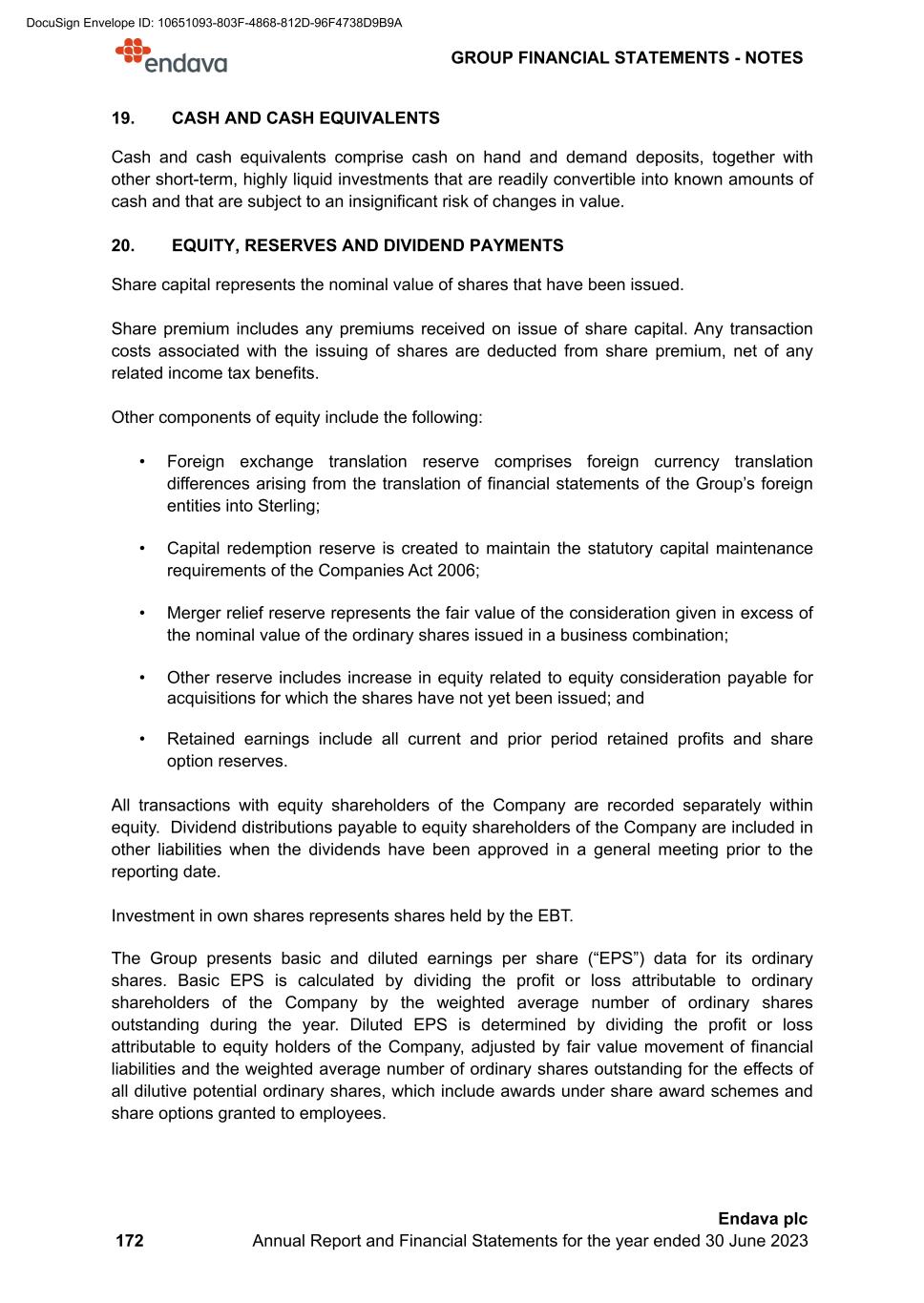
19. CASH AND CASH EQUIVALENTS Cash and cash equivalents comprise cash on hand and demand deposits, together with other short-term, highly liquid investments that are readily convertible into known amounts of cash and that are subject to an insignificant risk of changes in value. 20. EQUITY, RESERVES AND DIVIDEND PAYMENTS Share capital represents the nominal value of shares that have been issued. Share premium includes any premiums received on issue of share capital. Any transaction costs associated with the issuing of shares are deducted from share premium, net of any related income tax benefits. Other components of equity include the following: • Foreign exchange translation reserve comprises foreign currency translation differences arising from the translation of financial statements of the Group’s foreign entities into Sterling; • Capital redemption reserve is created to maintain the statutory capital maintenance requirements of the Companies Act 2006; • Merger relief reserve represents the fair value of the consideration given in excess of the nominal value of the ordinary shares issued in a business combination; • Other reserve includes increase in equity related to equity consideration payable for acquisitions for which the shares have not yet been issued; and • Retained earnings include all current and prior period retained profits and share option reserves. All transactions with equity shareholders of the Company are recorded separately within equity. Dividend distributions payable to equity shareholders of the Company are included in other liabilities when the dividends have been approved in a general meeting prior to the reporting date. Investment in own shares represents shares held by the EBT. The Group presents basic and diluted earnings per share (“EPS”) data for its ordinary shares. Basic EPS is calculated by dividing the profit or loss attributable to ordinary shareholders of the Company by the weighted average number of ordinary shares outstanding during the year. Diluted EPS is determined by dividing the profit or loss attributable to equity holders of the Company, adjusted by fair value movement of financial liabilities and the weighted average number of ordinary shares outstanding for the effects of all dilutive potential ordinary shares, which include awards under share award schemes and share options granted to employees. GROUP FINANCIAL STATEMENTS - NOTES 172 Endava plc Annual Report and Financial Statements for the year ended 30 June 2023 DocuSign Envelope ID: 10651093-803F-4868-812D-96F4738D9B9A

4. OPERATING SEGMENT ANALYSIS Operating segments are components of an enterprise about which separate financial information is available that is evaluated regularly by the chief operating decision-maker (“CODM”) in deciding on how to allocate resources and in assessing performance. The Company’s CODM is considered to be the Company’s Chief Executive Officer (“CEO”). The CEO reviews financial information presented on a Group level basis for the purposes of making operating decisions and assessing financial performance. Therefore, the Group has determined that it operates in a single operating and reportable segment. Geographical Information of Group’s Non-Current Assets Geographical information about the Group's non-current assets (excluding deferred tax asset) is based on locations where the assets are accumulated: 2023 2022 £’000 £’000 United Kingdom 33,412 33,771 North America 66,621 74,508 Europe 169,271 151,213 RoW1 133,996 16,967 Total 403,300 276,459 1. Rest of World (RoW) 5. REVENUE Set out below is the disaggregation of the Group’s revenue from contracts with customers by geographical market, based on where the services are delivered to customers: 2023 2022 £’000 £’000 United Kingdom 309,365 270,844 North America 258,112 228,112 Europe 182,551 138,005 RoW 44,705 17,796 Total 794,733 654,757 As at 30 June 2023 revenues generated from customers in the United States of America were £257.3 million (30 June 2022: £225.2 million) and they are included in the North American market. This disclosure has been added in the financial statements for the year ended 30 June 2023, including disaggregated figures for the comparative information presented in respect of the year ended 30 June 2022. GROUP FINANCIAL STATEMENTS - NOTES 173 Endava plc Annual Report and Financial Statements for the year ended 30 June 2023 DocuSign Envelope ID: 10651093-803F-4868-812D-96F4738D9B9A

The Group's revenue by industry sector is as follows: 2023 2022 £’000 £’000 Payments and Financial Services 416,007 331,842 TMT 173,927 163,534 Other 204,799 159,381 Total 794,733 654,757 The Group's revenue by contract type is as follows: 2023 2022 £’000 £’000 Time and materials contracts 646,237 522,857 Fixed price contracts 148,496 131,900 Total 794,733 654,757 As at 30 June 2023, the undiscounted aggregate transaction value of revenue that has not been recognised relating to unsatisfied performance obligations was £104.1 million (2022: £177.0 million). This relates to fixed price contracts with forward contractual commitments. This revenue is expected to be recognised over the following time periods: 2023 2022 £’000 £’000 Less than 1 year 64,838 121,735 1 to 2 years 17,758 22,656 2 to 3 years 11,823 13,631 More than 3 years 9,682 18,975 Total 104,101 176,997 The Company applies a practical expedient and does not disclose the value of unsatisfied performance obligations for contracts for which it recognises revenues at the amount to which it has the right to invoice for services provided. Revenue recognised in the year ended 30 June 2023 relating to performance obligations that were satisfied, or partially satisfied, in previous years was not material. GROUP FINANCIAL STATEMENTS - NOTES 174 Endava plc Annual Report and Financial Statements for the year ended 30 June 2023 DocuSign Envelope ID: 10651093-803F-4868-812D-96F4738D9B9A
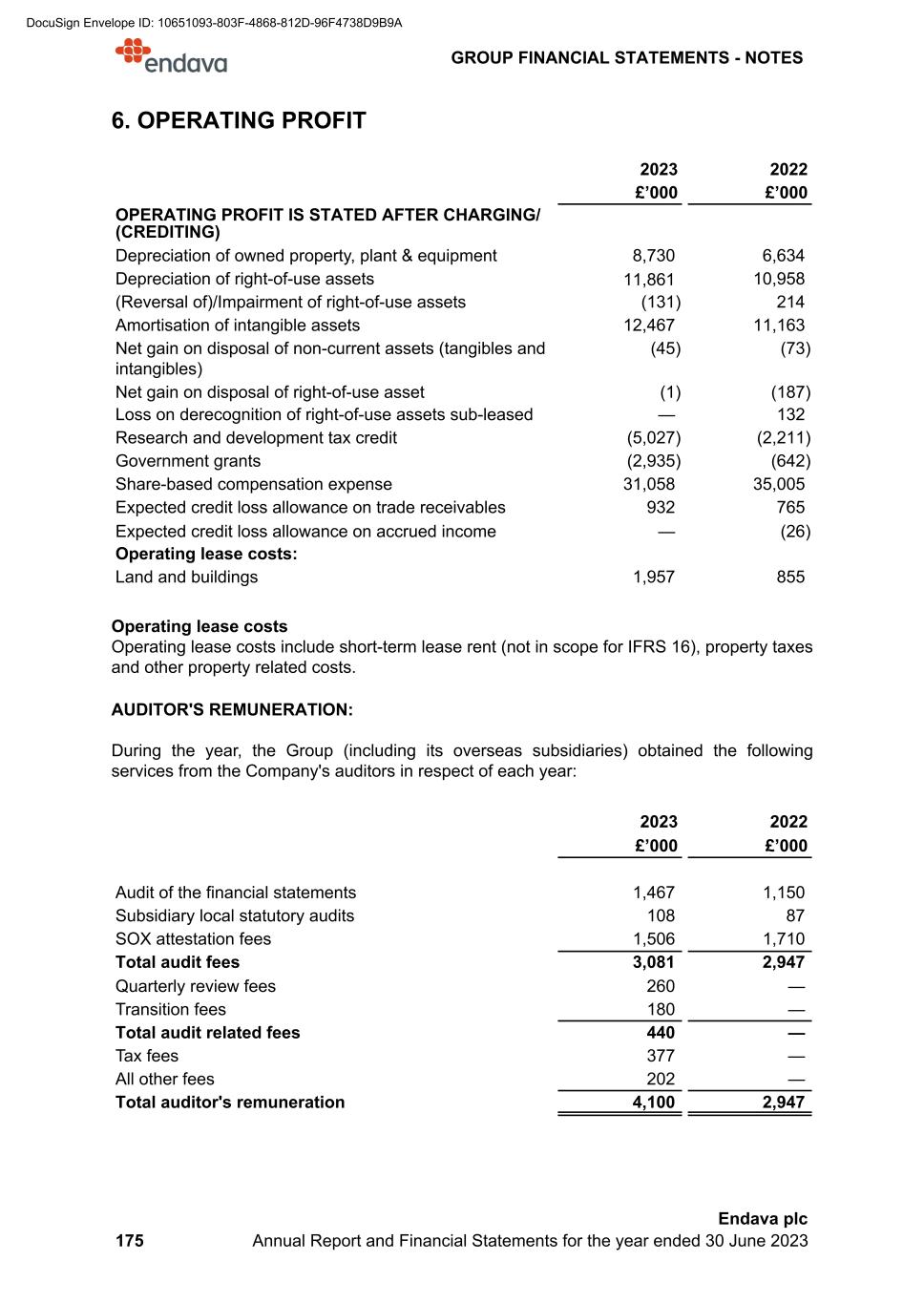
6. OPERATING PROFIT 2023 2022 £’000 £’000 OPERATING PROFIT IS STATED AFTER CHARGING/ (CREDITING) Depreciation of owned property, plant & equipment 8,730 6,634 Depreciation of right-of-use assets 11,861 10,958 (Reversal of)/Impairment of right-of-use assets (131) 214 Amortisation of intangible assets 12,467 11,163 Net gain on disposal of non-current assets (tangibles and intangibles) (45) (73) Net gain on disposal of right-of-use asset (1) (187) Loss on derecognition of right-of-use assets sub-leased — 132 Research and development tax credit (5,027) (2,211) Government grants (2,935) (642) Share-based compensation expense 31,058 35,005 Expected credit loss allowance on trade receivables 932 765 Expected credit loss allowance on accrued income — (26) Operating lease costs: Land and buildings 1,957 855 Operating lease costs Operating lease costs include short-term lease rent (not in scope for IFRS 16), property taxes and other property related costs. AUDITOR'S REMUNERATION: During the year, the Group (including its overseas subsidiaries) obtained the following services from the Company's auditors in respect of each year: 2023 2022 £’000 £’000 Audit of the financial statements 1,467 1,150 Subsidiary local statutory audits 108 87 SOX attestation fees 1,506 1,710 Total audit fees 3,081 2,947 Quarterly review fees 260 — Transition fees 180 — Total audit related fees 440 — Tax fees 377 — All other fees 202 — Total auditor's remuneration 4,100 2,947 GROUP FINANCIAL STATEMENTS - NOTES 175 Endava plc Annual Report and Financial Statements for the year ended 30 June 2023 DocuSign Envelope ID: 10651093-803F-4868-812D-96F4738D9B9A
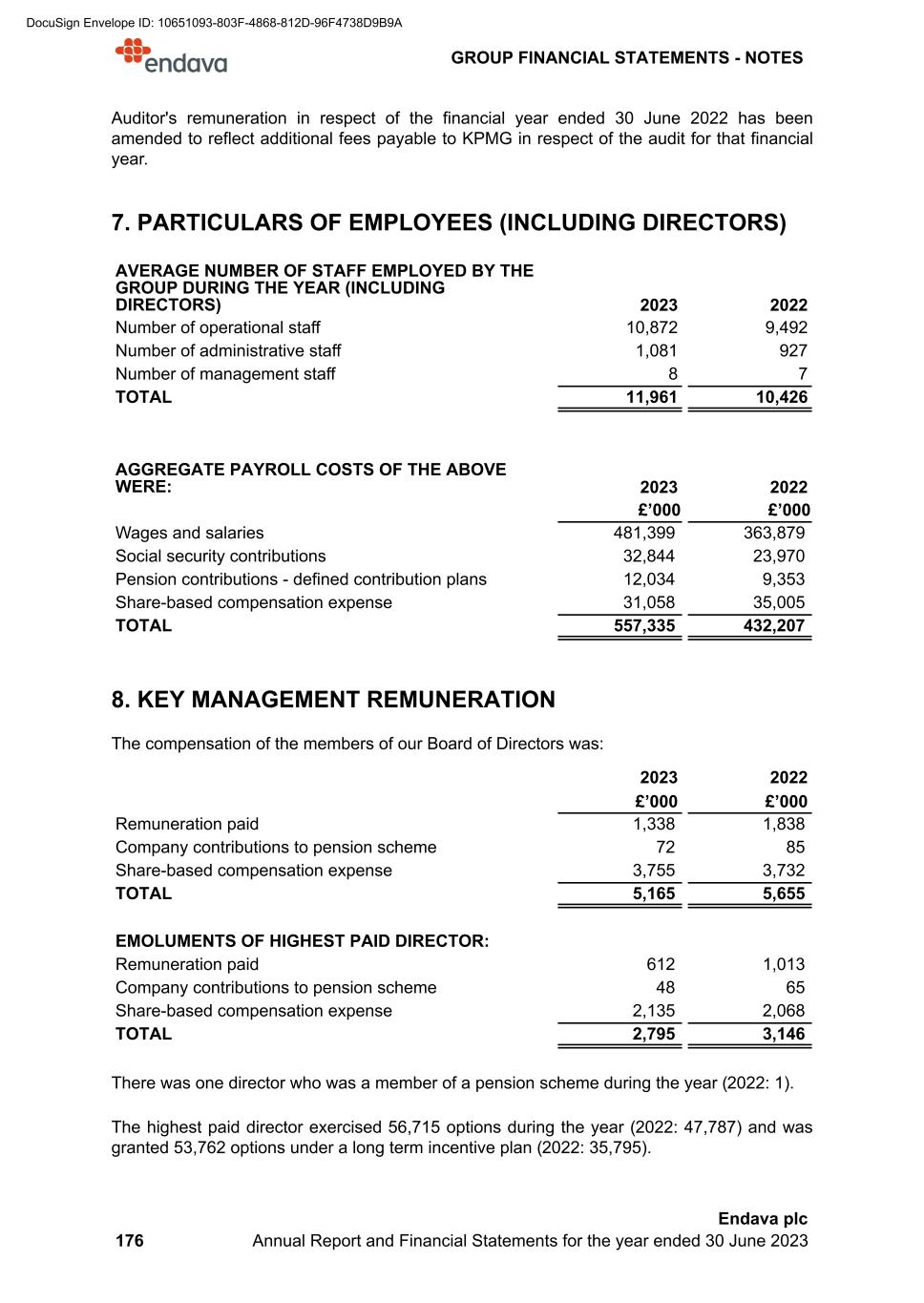
Auditor's remuneration in respect of the financial year ended 30 June 2022 has been amended to reflect additional fees payable to KPMG in respect of the audit for that financial year. 7. PARTICULARS OF EMPLOYEES (INCLUDING DIRECTORS) AVERAGE NUMBER OF STAFF EMPLOYED BY THE GROUP DURING THE YEAR (INCLUDING DIRECTORS) 2023 2022 Number of operational staff 10,872 9,492 Number of administrative staff 1,081 927 Number of management staff 8 7 TOTAL 11,961 10,426 AGGREGATE PAYROLL COSTS OF THE ABOVE WERE: 2023 2022 £’000 £’000 Wages and salaries 481,399 363,879 Social security contributions 32,844 23,970 Pension contributions - defined contribution plans 12,034 9,353 Share-based compensation expense 31,058 35,005 TOTAL 557,335 432,207 8. KEY MANAGEMENT REMUNERATION The compensation of the members of our Board of Directors was: 2023 2022 £’000 £’000 Remuneration paid 1,338 1,838 Company contributions to pension scheme 72 85 Share-based compensation expense 3,755 3,732 TOTAL 5,165 5,655 EMOLUMENTS OF HIGHEST PAID DIRECTOR: Remuneration paid 612 1,013 Company contributions to pension scheme 48 65 Share-based compensation expense 2,135 2,068 TOTAL 2,795 3,146 There was one director who was a member of a pension scheme during the year (2022: 1). The highest paid director exercised 56,715 options during the year (2022: 47,787) and was granted 53,762 options under a long term incentive plan (2022: 35,795). GROUP FINANCIAL STATEMENTS - NOTES 176 Endava plc Annual Report and Financial Statements for the year ended 30 June 2023 DocuSign Envelope ID: 10651093-803F-4868-812D-96F4738D9B9A
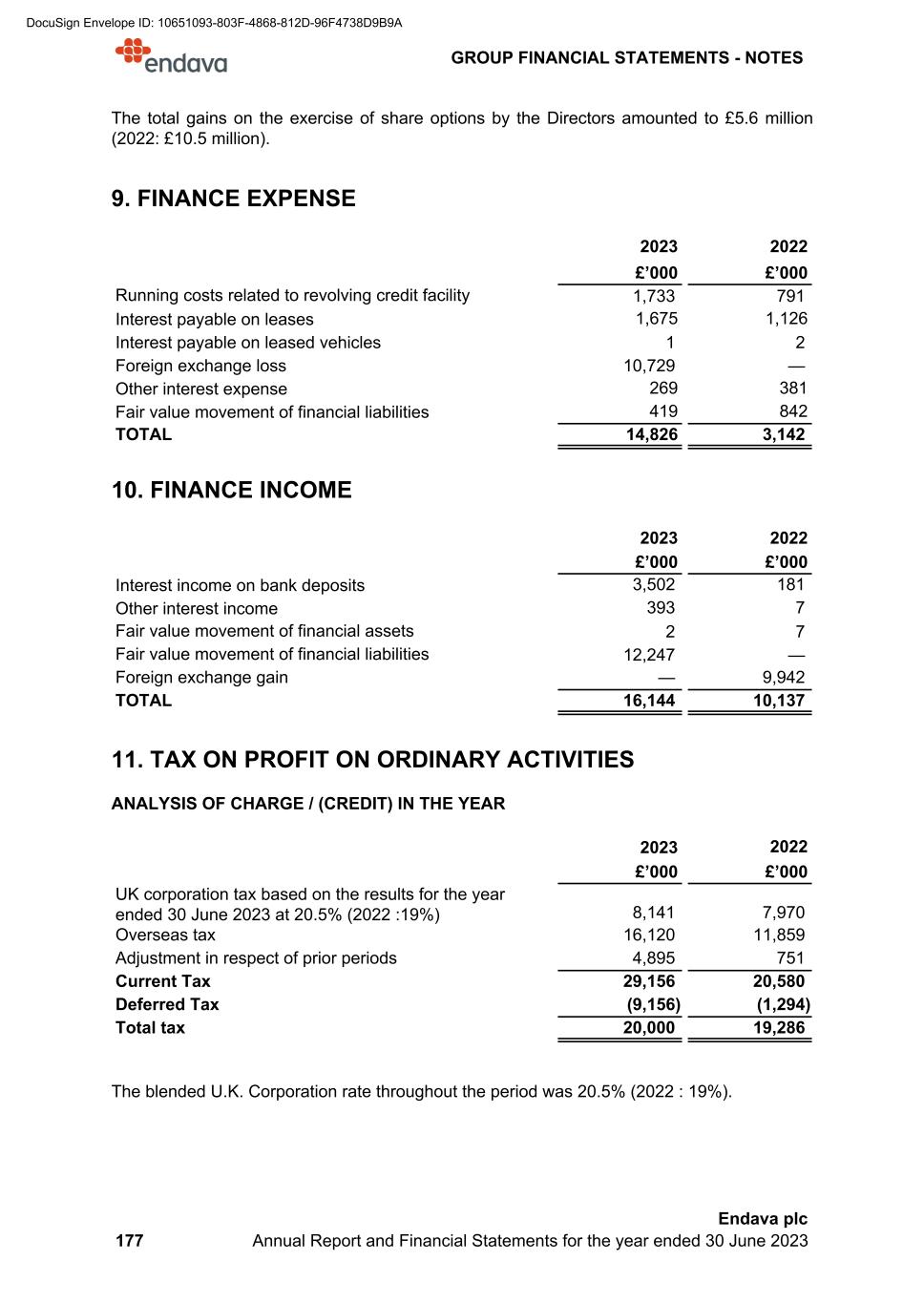
The total gains on the exercise of share options by the Directors amounted to £5.6 million (2022: £10.5 million). 9. FINANCE EXPENSE 2023 2022 £’000 £’000 Running costs related to revolving credit facility 1,733 791 Interest payable on leases 1,675 1,126 Interest payable on leased vehicles 1 2 Foreign exchange loss 10,729 — Other interest expense 269 381 Fair value movement of financial liabilities 419 842 TOTAL 14,826 3,142 10. FINANCE INCOME 2023 2022 £’000 £’000 Interest income on bank deposits 3,502 181 Other interest income 393 7 Fair value movement of financial assets 2 7 Fair value movement of financial liabilities 12,247 — Foreign exchange gain — 9,942 TOTAL 16,144 10,137 11. TAX ON PROFIT ON ORDINARY ACTIVITIES ANALYSIS OF CHARGE / (CREDIT) IN THE YEAR 2023 2022 £’000 £’000 UK corporation tax based on the results for the year ended 30 June 2023 at 20.5% (2022 :19%) 8,141 7,970 Overseas tax 16,120 11,859 Adjustment in respect of prior periods 4,895 751 Current Tax 29,156 20,580 Deferred Tax (9,156) (1,294) Total tax 20,000 19,286 The blended U.K. Corporation rate throughout the period was 20.5% (2022 : 19%). GROUP FINANCIAL STATEMENTS - NOTES 177 Endava plc Annual Report and Financial Statements for the year ended 30 June 2023 DocuSign Envelope ID: 10651093-803F-4868-812D-96F4738D9B9A

An increase in the U.K. corporation rate from 19% to 25% (effective 1 April 2023) was substantively enacted on 24 May 2021. This will increase the Group’s future tax charge accordingly. The deferred tax balance as of 30 June 2023 (and 30 June 2022) has been calculated based on the substantively enacted rates at that date, reflecting the expected timing of reversal of the related temporary differences. On 20 June 2023, Finance (No.2) Act 2023 was substantively enacted in the United Kingdom, introducing a global minimum effective tax rate of 15%. The legislation implements a domestic top-up tax and a multinational top-up tax, effective for accounting periods starting on or after 31 December 2023. The Group has applied the exception under an amendment to IAS 12 to recognising and disclosing information about deferred tax assets and liabilities related to top-up income taxes. RECONCILIATION OF THE TAX RATE ON GROUP PROFITS 2023 2022 £’000 % £’000 % Profit on ordinary activities before taxation 114,163 102,379 Profit on ordinary activities at UK statutory rate 23,403 20.5 % 19,452 19.0 % Differences in overseas tax rates (267) (0.2) % (2,467) (2.4) % Impact of share-based compensation 1,390 1.2 % 1,223 1.1 % Non taxable fair value movement on financial (2,430) (2.1) % 0 0.0 % Tax incentives and non deductible items (867) (0.8) % (1,359) (1.3) % Adjustments related to prior periods (354) (0.3) % (502) (0.5) % Tax on unremitted earnings/Withholding tax on dividends 1,209 1.1 % 2,876 2.8 % Impact of rate change on deferred tax (2,084) (1.8) % 63 0.1 % Total 20,000 17.5 % 19,286 18.8 % The tax incentives and non deductible items of £0.9 million as at 30 June 2023 (30 June 2022: £1.4 million) are mainly related to tax credits and incentives net of certain expenses that are not expected to be tax deductible in any jurisdiction. TAX ON ITEMS CHARGED TO EQUITY 2023 2022 £’000 £’000 Deferred tax - share-based compensation 3,919 5,101 Current tax - share-based compensation (2,318) (8,290) Total charge/(credit) to equity 1,601 (3,189) GROUP FINANCIAL STATEMENTS - NOTES 178 Endava plc Annual Report and Financial Statements for the year ended 30 June 2023 DocuSign Envelope ID: 10651093-803F-4868-812D-96F4738D9B9A

UNREMITTED EARNINGS The aggregate amount of unremitted profits at 30 June 2023 was approximately £158.0 million (2022 - £108.0 million). The movement during the year reflects profits made in various territories outside of the United Kingdom and repatriation of such profits through various dividend payments to Endava plc. UK legislation relating to company distributions provides for exemption from tax for most repatriated profits. Deferred taxation of £4.0 million has been provided on these profits as at 30 June 2023 (2022 - £4.4 million). No deferred tax liability has been provided on £10.1 million of these profits at 30 June 2023 (2022 - £nil) as the group is able to control the timing of distributions from these subsidiaries and is not expected to distribute these profits in the foreseeable future. 12. DEFERRED TAX ASSETS AND (LIABILITIES) Deferred taxes arising from temporary differences and unused tax losses are summarised as follows: Deferred Tax 2023: At 1 July 2022 Exchange Adjustments Credit/ (Charge) to Profit and Loss Acquisition Charge to Equity At 30 June 2023 £'000 £'000 £'000 £'000 £'000 £'000 Accelerated capital allowances 434 — (465) — — (31) Tax losses 3,627 (111) 8,995 — — 12,511 Share-based compensation 9,844 (35) (1,927) — (3,919) 3,963 Intangible assets (6,008) 191 1,901 (6,455) — (10,371) Other temporary differences (1,505) 45 652 269 — (539) Total 6,392 90 9,156 (6,186) (3,919) 5,533 Deferred Tax 2022: At 1 July 2021 Exchange Adjustments Credit/ (Charge) to Profit and Loss Acquisition Charge to Equity At 30 June 2022 £'000 £'000 £'000 £'000 £'000 £'000 Accelerated capital allowances 595 — (161) — — 434 Tax losses 2,987 355 285 — — 3,627 Share-based compensation 13,143 — 1,802 0 (5,101) 9,844 Intangible assets (6,824) (30) 1,136 (290) — (6,008) Other temporary differences 55 208 (1,768) — — (1,505) Total 9,956 533 1,294 (290) (5,101) 6,392 GROUP FINANCIAL STATEMENTS - NOTES 179 Endava plc Annual Report and Financial Statements for the year ended 30 June 2023 DocuSign Envelope ID: 10651093-803F-4868-812D-96F4738D9B9A

Deferred tax assets are recognised to the extent it is probable that taxable profits will be generated against which those assets can be utilised. After offsetting deferred tax assets and liabilities where appropriate within territories, the net deferred tax comprises: 2023 2022 £’000 £’000 Deferred tax assets 20,156 17,218 Deferred tax liabilities (14,623) (10,826) Net deferred tax 5,533 6,392 13. EARNINGS PER SHARE BASIC EARNINGS PER SHARE Basic earnings per share (“EPS”) is calculated by dividing the profit for the year attributable to equity holders of the Company by the weighted average number of ordinary shares outstanding during the year. 2023 2022 £’000 £’000 Profit for the year attributable to equity holders of the Company 94,163 83,093 2023 2022 Weighted average number of shares outstanding 57,314,839 56,272,036 2023 2022 Earnings per share - basic (£) £ 1.64 £ 1.48 DILUTED EARNINGS PER SHARE Diluted EPS is calculated by dividing the profit for the year attributable to equity holders of the Company by the weighted average number of ordinary shares outstanding during the year plus the weighted average number of shares that would be issued if all dilutive potential ordinary shares were converted into ordinary shares. In accordance with IAS 33, the dilutive earnings per share are without reference to adjustments in respect of outstanding shares when the impact would be anti-dilutive. GROUP FINANCIAL STATEMENTS - NOTES 180 Endava plc Annual Report and Financial Statements for the year ended 30 June 2023 DocuSign Envelope ID: 10651093-803F-4868-812D-96F4738D9B9A
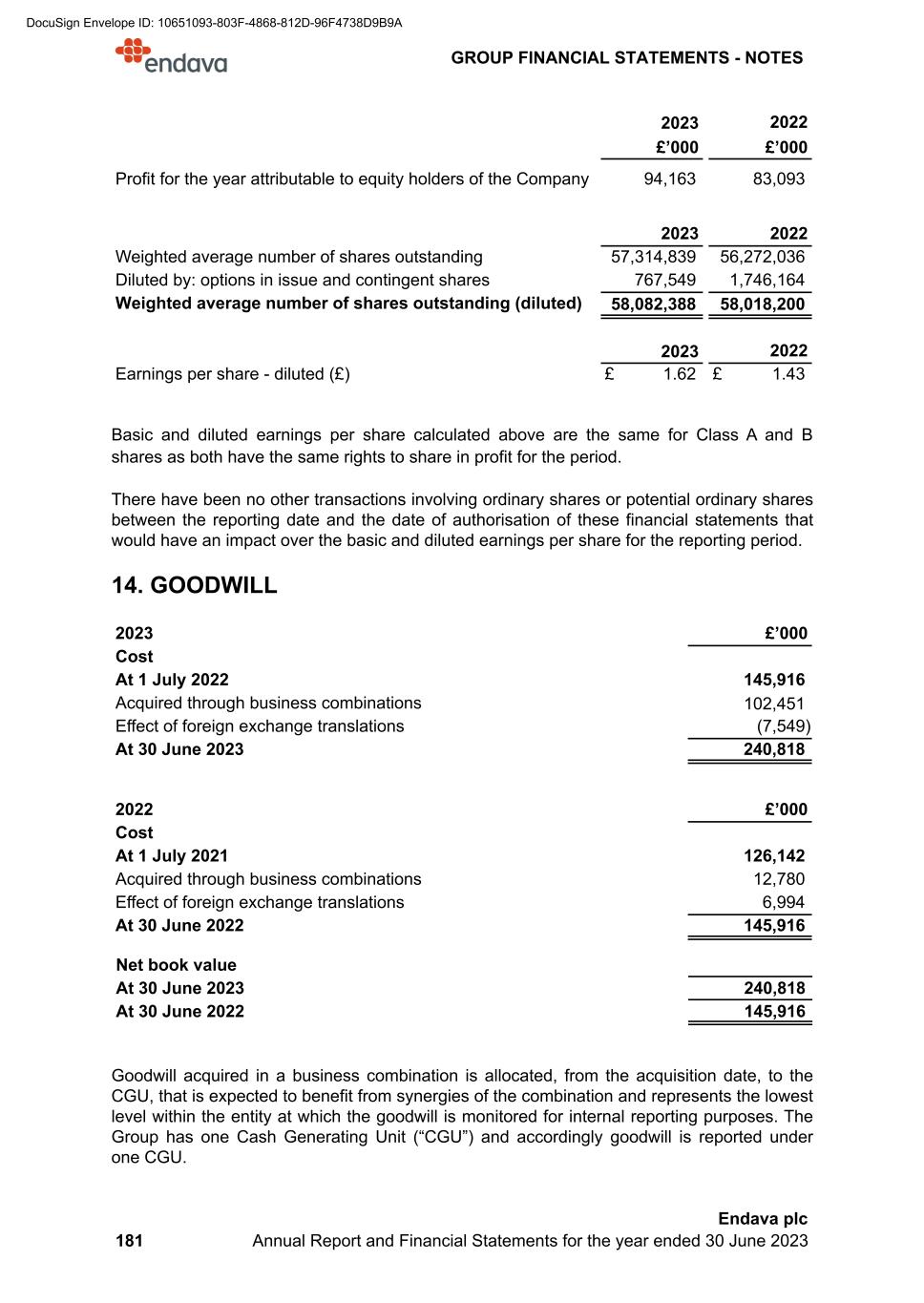
2023 2022 £’000 £’000 Profit for the year attributable to equity holders of the Company 94,163 83,093 2023 2022 Weighted average number of shares outstanding 57,314,839 56,272,036 Diluted by: options in issue and contingent shares 767,549 1,746,164 Weighted average number of shares outstanding (diluted) 58,082,388 58,018,200 2023 2022 Earnings per share - diluted (£) £ 1.62 £ 1.43 Basic and diluted earnings per share calculated above are the same for Class A and B shares as both have the same rights to share in profit for the period. There have been no other transactions involving ordinary shares or potential ordinary shares between the reporting date and the date of authorisation of these financial statements that would have an impact over the basic and diluted earnings per share for the reporting period. 14. GOODWILL 2023 £’000 Cost At 1 July 2022 145,916 Acquired through business combinations 102,451 Effect of foreign exchange translations (7,549) At 30 June 2023 240,818 2022 £’000 Cost At 1 July 2021 126,142 Acquired through business combinations 12,780 Effect of foreign exchange translations 6,994 At 30 June 2022 145,916 Net book value At 30 June 2023 240,818 At 30 June 2022 145,916 Goodwill acquired in a business combination is allocated, from the acquisition date, to the CGU, that is expected to benefit from synergies of the combination and represents the lowest level within the entity at which the goodwill is monitored for internal reporting purposes. The Group has one Cash Generating Unit (“CGU”) and accordingly goodwill is reported under one CGU. GROUP FINANCIAL STATEMENTS - NOTES 181 Endava plc Annual Report and Financial Statements for the year ended 30 June 2023 DocuSign Envelope ID: 10651093-803F-4868-812D-96F4738D9B9A

During the financial year ended 30 June 2023, the Group acquired 100% of Lexicon Digital Pty Ltd and Lexicon Consolidated Holdings Pty Ltd (“Lexicon”) voting rights and obtained control of Lexicon, which resulted in an increase in goodwill of £44.1 million. All goodwill is recorded in Australian Dollars, being the local currency of the acquired company. The Group also completed the acquisition of Mudbath & Co. Pty Ltd (“Mudbath”), acquiring 100% of the voting rights and obtaining control. The transaction resulted in an increase in provisional goodwill of £12.8 million, all recorded in Australian Dollars, being the local currency of the acquired company. During the reporting period, the Group also acquired 100% of the voting rights of DEK Corporation Pty Ltd, DEK Technologies Sweden AB and DEK Vietnam Company Ltd (collectively, “DEK”), obtaining control. The transaction resulted in an increase in provisional goodwill of £45.6 million. The goodwill amount recognised in DEK is recorded in the local currency of the acquired companies, split between Australian Dollars, Swedish Krona and Vietnamese Dong. All goodwill recognised during the reporting period for the three completed acquisitions has been allocated to the Group CGU. During the financial year ended 30 June 2022, the Group acquired 100% of Business Agility Consulting Ltd. (“BAC”) voting rights and obtained control of BAC, which resulted in an increase in goodwill of £12.8 million. All goodwill is recorded in Sterling, being the local currency of the acquired company. Goodwill Impairment Testing Goodwill is not amortised and is tested for impairment at least annually or whenever events or changes in circumstances indicate that the carrying value may not be recoverable. Events or changes in circumstances that could trigger an impairment review include a significant adverse change in business climate, an adverse action or assessment by a regulator, unanticipated competition, a loss of key personnel, significant changes in the manner of our use of the acquired assets or the strategy for our overall business, significant negative industry or economic trends, or significant underperformance relative to expected historical or projected future results of operations. For the year ended 30 June 2023, the Board reviewed the value of goodwill based on internal value in use calculations. The key assumptions for these calculations are discount rates and revenue growth rate. The growth rates for the analysed period are based on management’s expectations of the medium-term performance of the business, planned growth in market shares, industry forecasts and growth in the market. These calculations used five-year cash flow projections based on financial budgets approved by management and assumed a 1.5% terminal growth rate thereafter. The discount rate used of 14.9% for the 2023 impairment test (2022: 13.5%) represents the weighted average cost of capital ("WACC") of the Group and is a pre-tax rate. The market risk is reflected in the discount rate - used through its components, cost of equity and cost of debt. The cost of equity is calculated using the Capital Asset Pricing Model ("CAPM") and its formula includes the market return and the sensitivity of the Company to that market return. The WACC also includes the risk-free rate both in the calculation of the cost of equity and the cost of debt. If the market uncertainty increases, the risk-free rate would also increase to reflect this. Moreover, the market risk is also reflected through the determination of the cost of debt as the current market prices are included in the considered credit risk. GROUP FINANCIAL STATEMENTS - NOTES 182 Endava plc Annual Report and Financial Statements for the year ended 30 June 2023 DocuSign Envelope ID: 10651093-803F-4868-812D-96F4738D9B9A
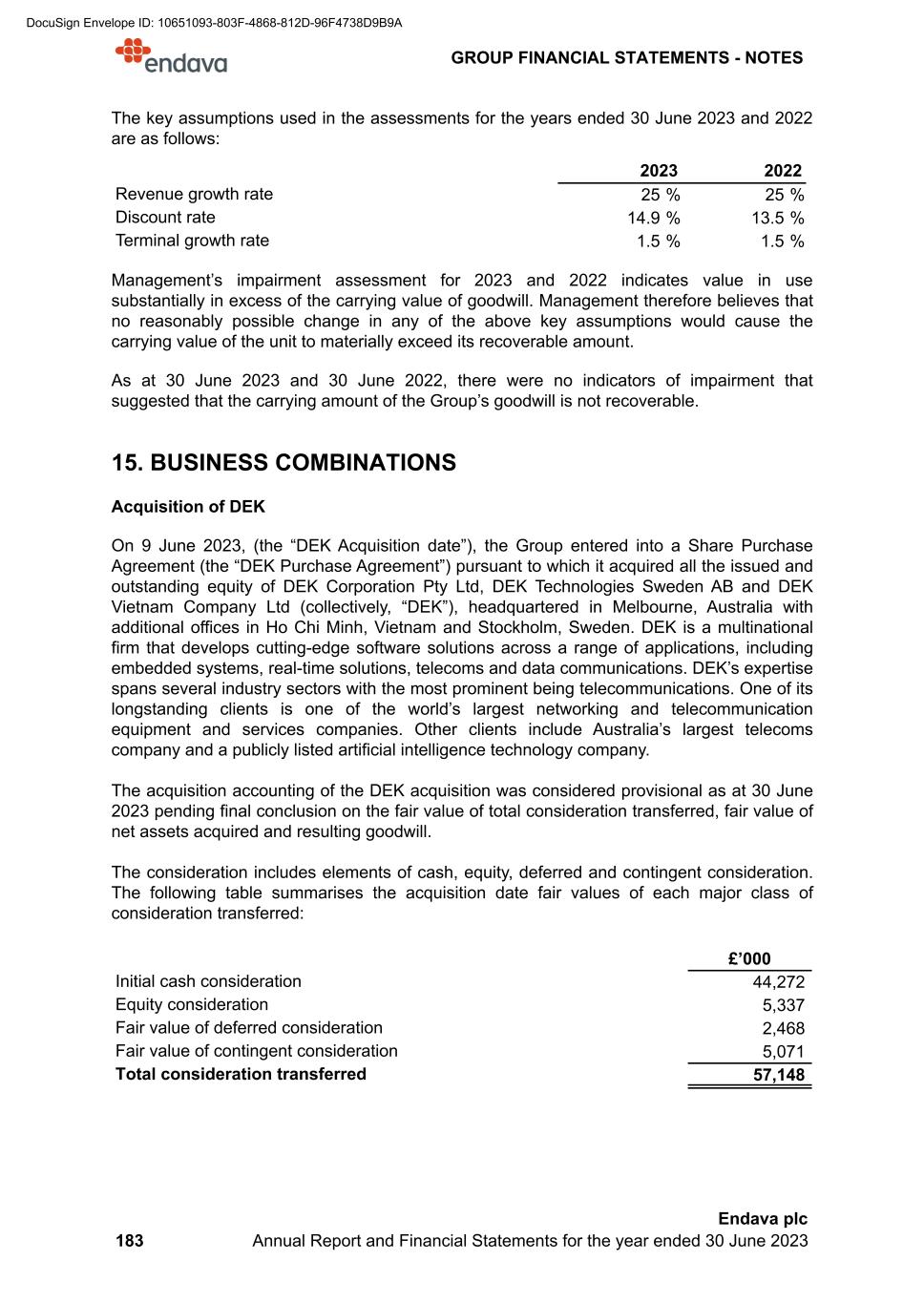
The key assumptions used in the assessments for the years ended 30 June 2023 and 2022 are as follows: 2023 2022 Revenue growth rate 25 % 25 % Discount rate 14.9 % 13.5 % Terminal growth rate 1.5 % 1.5 % Management’s impairment assessment for 2023 and 2022 indicates value in use substantially in excess of the carrying value of goodwill. Management therefore believes that no reasonably possible change in any of the above key assumptions would cause the carrying value of the unit to materially exceed its recoverable amount. As at 30 June 2023 and 30 June 2022, there were no indicators of impairment that suggested that the carrying amount of the Group’s goodwill is not recoverable. 15. BUSINESS COMBINATIONS Acquisition of DEK On 9 June 2023, (the “DEK Acquisition date”), the Group entered into a Share Purchase Agreement (the “DEK Purchase Agreement”) pursuant to which it acquired all the issued and outstanding equity of DEK Corporation Pty Ltd, DEK Technologies Sweden AB and DEK Vietnam Company Ltd (collectively, “DEK”), headquartered in Melbourne, Australia with additional offices in Ho Chi Minh, Vietnam and Stockholm, Sweden. DEK is a multinational firm that develops cutting-edge software solutions across a range of applications, including embedded systems, real-time solutions, telecoms and data communications. DEK’s expertise spans several industry sectors with the most prominent being telecommunications. One of its longstanding clients is one of the world’s largest networking and telecommunication equipment and services companies. Other clients include Australia’s largest telecoms company and a publicly listed artificial intelligence technology company. The acquisition accounting of the DEK acquisition was considered provisional as at 30 June 2023 pending final conclusion on the fair value of total consideration transferred, fair value of net assets acquired and resulting goodwill. The consideration includes elements of cash, equity, deferred and contingent consideration. The following table summarises the acquisition date fair values of each major class of consideration transferred: £’000 Initial cash consideration 44,272 Equity consideration 5,337 Fair value of deferred consideration 2,468 Fair value of contingent consideration 5,071 Total consideration transferred 57,148 GROUP FINANCIAL STATEMENTS - NOTES 183 Endava plc Annual Report and Financial Statements for the year ended 30 June 2023 DocuSign Envelope ID: 10651093-803F-4868-812D-96F4738D9B9A
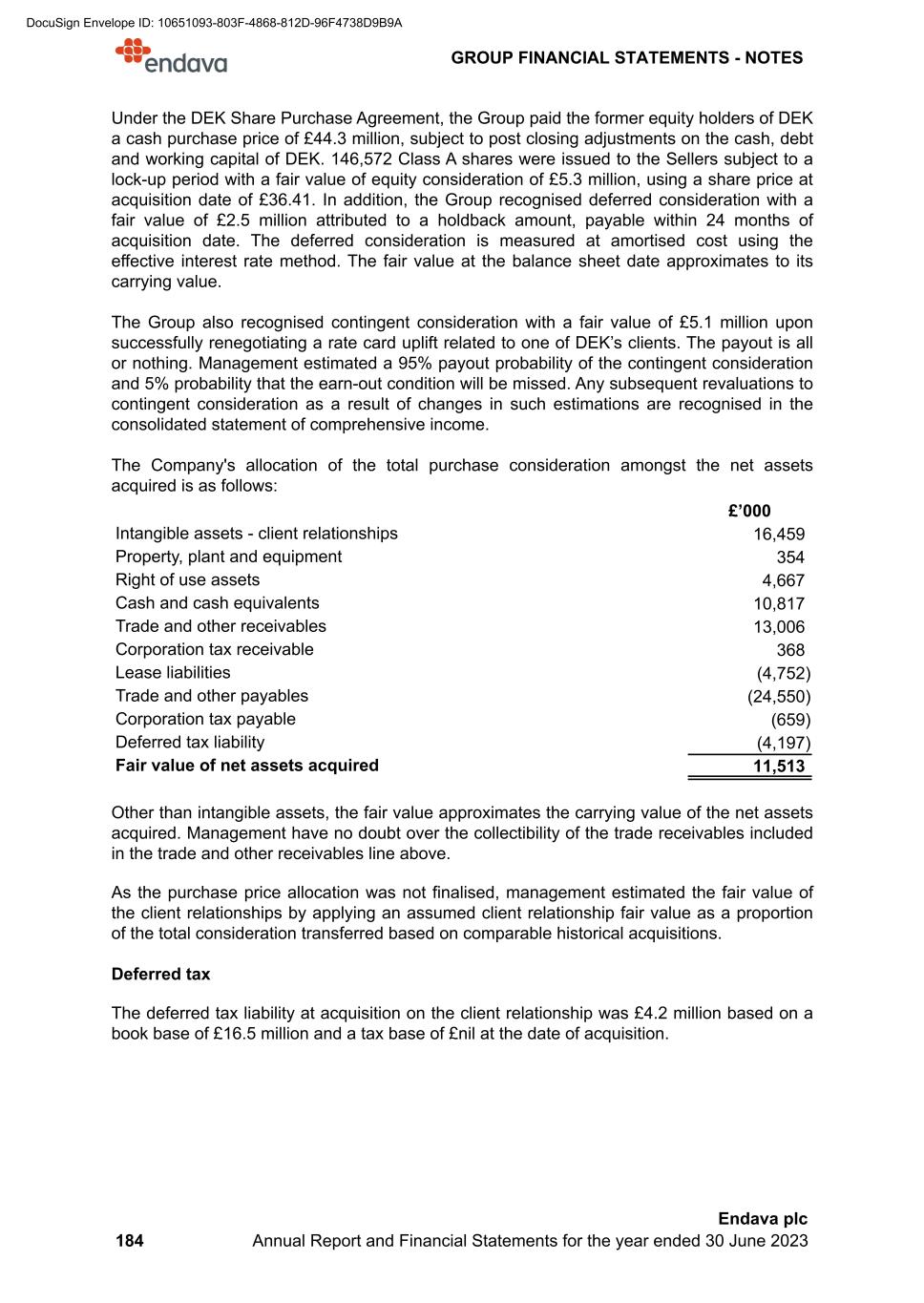
Under the DEK Share Purchase Agreement, the Group paid the former equity holders of DEK a cash purchase price of £44.3 million, subject to post closing adjustments on the cash, debt and working capital of DEK. 146,572 Class A shares were issued to the Sellers subject to a lock-up period with a fair value of equity consideration of £5.3 million, using a share price at acquisition date of £36.41. In addition, the Group recognised deferred consideration with a fair value of £2.5 million attributed to a holdback amount, payable within 24 months of acquisition date. The deferred consideration is measured at amortised cost using the effective interest rate method. The fair value at the balance sheet date approximates to its carrying value. The Group also recognised contingent consideration with a fair value of £5.1 million upon successfully renegotiating a rate card uplift related to one of DEK’s clients. The payout is all or nothing. Management estimated a 95% payout probability of the contingent consideration and 5% probability that the earn-out condition will be missed. Any subsequent revaluations to contingent consideration as a result of changes in such estimations are recognised in the consolidated statement of comprehensive income. The Company's allocation of the total purchase consideration amongst the net assets acquired is as follows: £’000 Intangible assets - client relationships 16,459 Property, plant and equipment 354 Right of use assets 4,667 Cash and cash equivalents 10,817 Trade and other receivables 13,006 Corporation tax receivable 368 Lease liabilities (4,752) Trade and other payables (24,550) Corporation tax payable (659) Deferred tax liability (4,197) Fair value of net assets acquired 11,513 Other than intangible assets, the fair value approximates the carrying value of the net assets acquired. Management have no doubt over the collectibility of the trade receivables included in the trade and other receivables line above. As the purchase price allocation was not finalised, management estimated the fair value of the client relationships by applying an assumed client relationship fair value as a proportion of the total consideration transferred based on comparable historical acquisitions. Deferred tax The deferred tax liability at acquisition on the client relationship was £4.2 million based on a book base of £16.5 million and a tax base of £nil at the date of acquisition. GROUP FINANCIAL STATEMENTS - NOTES 184 Endava plc Annual Report and Financial Statements for the year ended 30 June 2023 DocuSign Envelope ID: 10651093-803F-4868-812D-96F4738D9B9A

Goodwill Goodwill arising from the acquisition has been recognised as follows: £’000 Consideration transferred 57,148 Fair value of net assets acquired (11,513) Goodwill 45,635 The goodwill arising from the acquisition represents the knowledge and experience of the workforce, who are instrumental to securing future revenue growth, the new client relationships anticipated to arise post-acquisition and a proportion of goodwill that is, by its nature, unidentifiable and represents modus operandi of all the assets combined, which generates profits. Revenue and Profit of DEK from the DEK Acquisition Date to 30 June 2023: £’000 Revenue 1,703 Profit 371 Management’s estimate of Revenue and Profit of DEK for the reporting period ended 30 June 2023 (had the acquisition occurred at the beginning of the reporting period): £’000 Revenue 29,030 Profit 3,273 Acquisition related costs: £’000 Legal and professional fees 895 Total 895 Acquisition related costs are expensed as incurred and presented under selling, general and administrative expenses. Acquisition of Mudbath On 10 May 2023 (the “Mudbath Acquisition date”), the Group entered into a Share Purchase Agreement (the “Mudbath Purchase Agreement”) pursuant to which it acquired all of the issued and outstanding equity of Mudbath & Co. Pty Ltd (“Mudbath”), headquartered in Newcastle, Australia. Mudbath is an Australian-based technology firm specialising in strategy, design and engineering services. Mudbath partners with businesses to build new digital solutions, enhance user experiences and accelerate digital transformation programs across enterprise systems, web and mobile products using their proven agile delivery methodology. Mudbath’s clients span broad industry verticals, including retail, mining (and adjacent activities including rail and tools), health, insurance, banking and travel. Mudbath’s employees are based primarily in Newcastle, Sydney and Melbourne, Australia. GROUP FINANCIAL STATEMENTS - NOTES 185 Endava plc Annual Report and Financial Statements for the year ended 30 June 2023 DocuSign Envelope ID: 10651093-803F-4868-812D-96F4738D9B9A
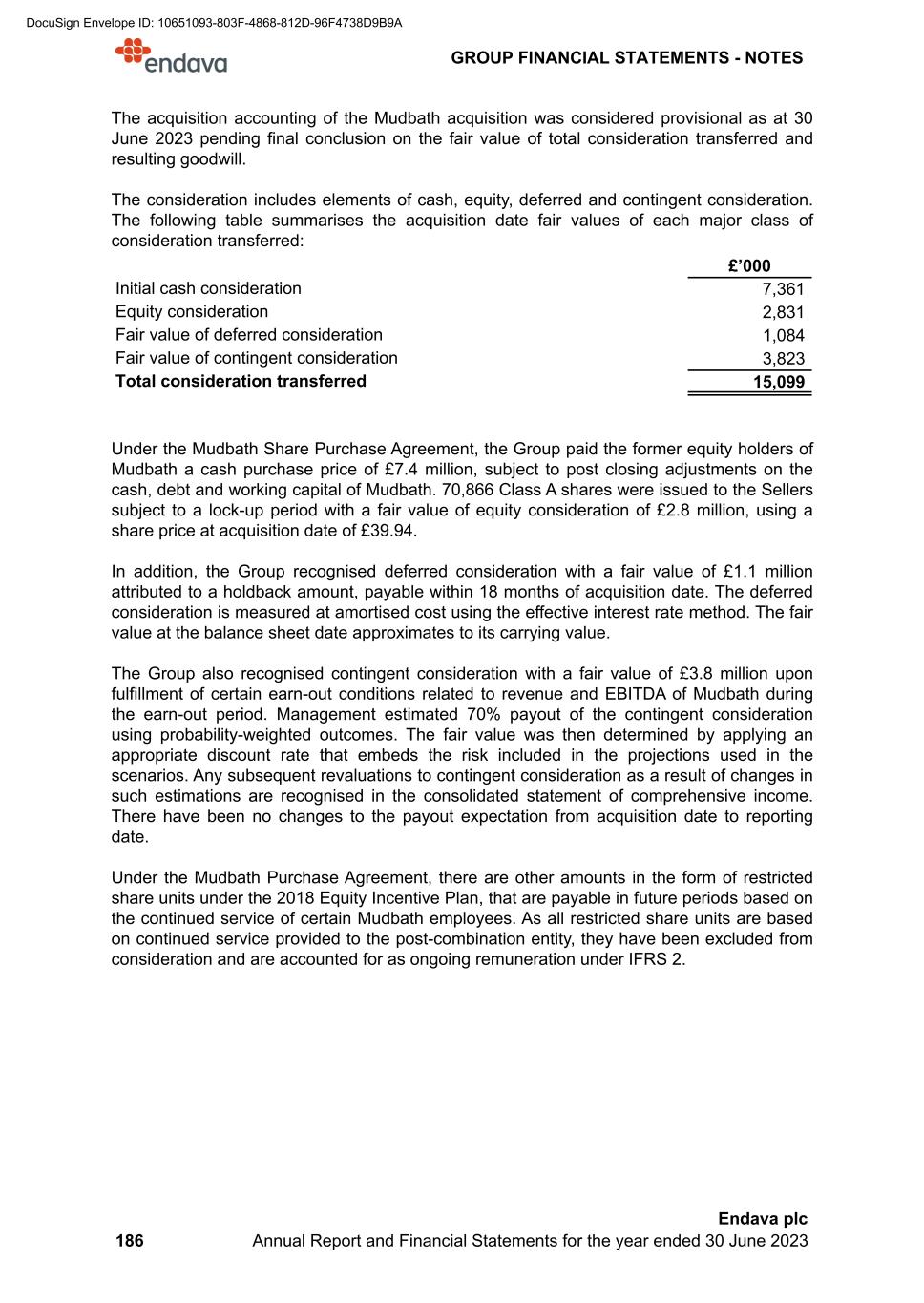
The acquisition accounting of the Mudbath acquisition was considered provisional as at 30 June 2023 pending final conclusion on the fair value of total consideration transferred and resulting goodwill. The consideration includes elements of cash, equity, deferred and contingent consideration. The following table summarises the acquisition date fair values of each major class of consideration transferred: £’000 Initial cash consideration 7,361 Equity consideration 2,831 Fair value of deferred consideration 1,084 Fair value of contingent consideration 3,823 Total consideration transferred 15,099 Under the Mudbath Share Purchase Agreement, the Group paid the former equity holders of Mudbath a cash purchase price of £7.4 million, subject to post closing adjustments on the cash, debt and working capital of Mudbath. 70,866 Class A shares were issued to the Sellers subject to a lock-up period with a fair value of equity consideration of £2.8 million, using a share price at acquisition date of £39.94. In addition, the Group recognised deferred consideration with a fair value of £1.1 million attributed to a holdback amount, payable within 18 months of acquisition date. The deferred consideration is measured at amortised cost using the effective interest rate method. The fair value at the balance sheet date approximates to its carrying value. The Group also recognised contingent consideration with a fair value of £3.8 million upon fulfillment of certain earn-out conditions related to revenue and EBITDA of Mudbath during the earn-out period. Management estimated 70% payout of the contingent consideration using probability-weighted outcomes. The fair value was then determined by applying an appropriate discount rate that embeds the risk included in the projections used in the scenarios. Any subsequent revaluations to contingent consideration as a result of changes in such estimations are recognised in the consolidated statement of comprehensive income. There have been no changes to the payout expectation from acquisition date to reporting date. Under the Mudbath Purchase Agreement, there are other amounts in the form of restricted share units under the 2018 Equity Incentive Plan, that are payable in future periods based on the continued service of certain Mudbath employees. As all restricted share units are based on continued service provided to the post-combination entity, they have been excluded from consideration and are accounted for as ongoing remuneration under IFRS 2. GROUP FINANCIAL STATEMENTS - NOTES 186 Endava plc Annual Report and Financial Statements for the year ended 30 June 2023 DocuSign Envelope ID: 10651093-803F-4868-812D-96F4738D9B9A

The Company's allocation of the total purchase consideration amongst the net assets acquired is as follows: £’000 Intangible assets - client relationships 2,997 Property, plant and equipment 29 Deferred tax asset 133 Cash and cash equivalents 546 Trade and other receivables 818 Trade and other payables (1,236) Corporation tax payable (55) Deferred tax liability (899) Fair value of net assets acquired 2,333 Other than intangible assets, the fair value approximates the carrying value of the net assets acquired. Management have no doubt over the collectibility of the trade receivables included in the trade and other receivables line above. Intangible assets subject to valuation include client relationships. The multi period excess earnings method (“MEEM”) was applied to determine the fair value of the client relationship intangible asset. The fair value determined under this approach used customer attrition and discount rates as critical assumptions. The contribution of other tangible and intangible assets to the cash flows were also used as inputs in the fair value determination exercise, but they are not considered to be critical assumptions. The after-tax residual cash flows attributable to existing customers were discounted to a present value. Deferred tax The deferred tax liability at acquisition on the client relationship was £0.9 million based on a book base of £3.0 million and a tax base of £nil at the date of acquisition. Goodwill Goodwill arising from the acquisition has been recognised as follows: £’000 Consideration transferred 15,099 Fair value of net assets acquired (2,333) Goodwill 12,766 The goodwill arising from the acquisition includes elements such as: new client relationships anticipated to arise post-acquisition, an experienced workforce and proportion of it that is, by its very nature, unidentifiable, and represents a modus operandi of all the assets combined, which generate profits. GROUP FINANCIAL STATEMENTS - NOTES 187 Endava plc Annual Report and Financial Statements for the year ended 30 June 2023 DocuSign Envelope ID: 10651093-803F-4868-812D-96F4738D9B9A
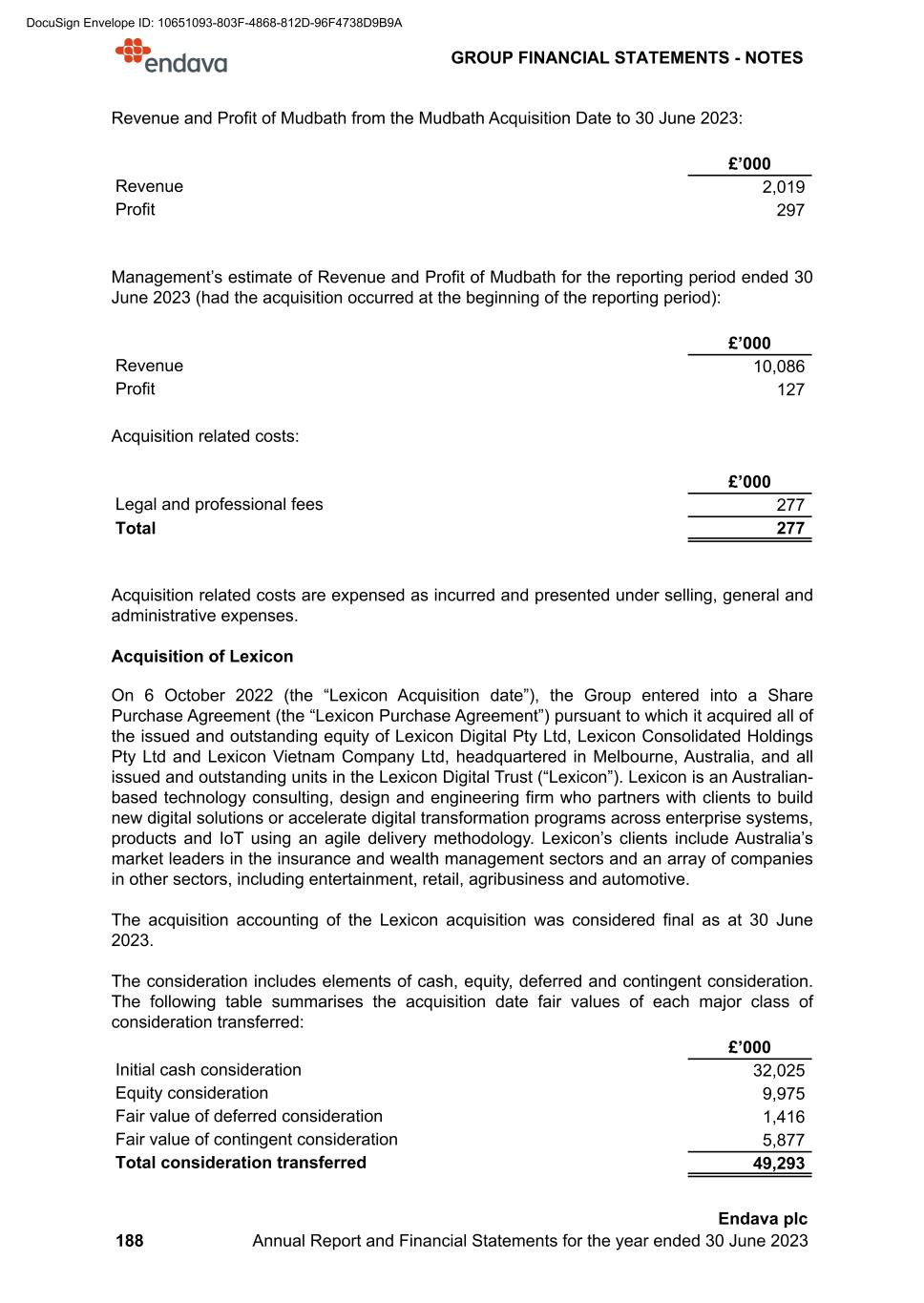
Revenue and Profit of Mudbath from the Mudbath Acquisition Date to 30 June 2023: £’000 Revenue 2,019 Profit 297 Management’s estimate of Revenue and Profit of Mudbath for the reporting period ended 30 June 2023 (had the acquisition occurred at the beginning of the reporting period): £’000 Revenue 10,086 Profit 127 Acquisition related costs: £’000 Legal and professional fees 277 Total 277 Acquisition related costs are expensed as incurred and presented under selling, general and administrative expenses. Acquisition of Lexicon On 6 October 2022 (the “Lexicon Acquisition date”), the Group entered into a Share Purchase Agreement (the “Lexicon Purchase Agreement”) pursuant to which it acquired all of the issued and outstanding equity of Lexicon Digital Pty Ltd, Lexicon Consolidated Holdings Pty Ltd and Lexicon Vietnam Company Ltd, headquartered in Melbourne, Australia, and all issued and outstanding units in the Lexicon Digital Trust (“Lexicon”). Lexicon is an Australian- based technology consulting, design and engineering firm who partners with clients to build new digital solutions or accelerate digital transformation programs across enterprise systems, products and IoT using an agile delivery methodology. Lexicon’s clients include Australia’s market leaders in the insurance and wealth management sectors and an array of companies in other sectors, including entertainment, retail, agribusiness and automotive. The acquisition accounting of the Lexicon acquisition was considered final as at 30 June 2023. The consideration includes elements of cash, equity, deferred and contingent consideration. The following table summarises the acquisition date fair values of each major class of consideration transferred: £’000 Initial cash consideration 32,025 Equity consideration 9,975 Fair value of deferred consideration 1,416 Fair value of contingent consideration 5,877 Total consideration transferred 49,293 GROUP FINANCIAL STATEMENTS - NOTES 188 Endava plc Annual Report and Financial Statements for the year ended 30 June 2023 DocuSign Envelope ID: 10651093-803F-4868-812D-96F4738D9B9A
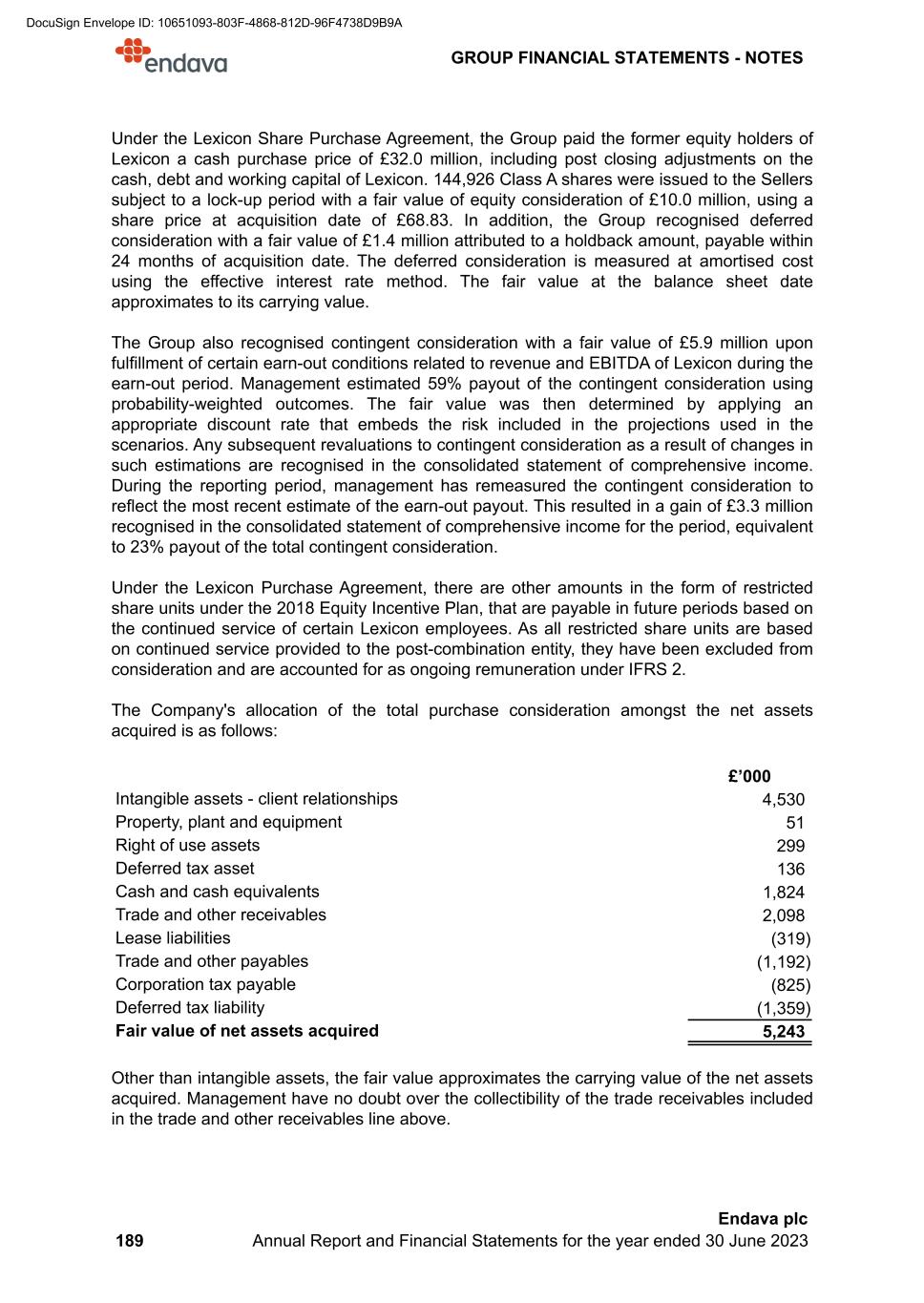
Under the Lexicon Share Purchase Agreement, the Group paid the former equity holders of Lexicon a cash purchase price of £32.0 million, including post closing adjustments on the cash, debt and working capital of Lexicon. 144,926 Class A shares were issued to the Sellers subject to a lock-up period with a fair value of equity consideration of £10.0 million, using a share price at acquisition date of £68.83. In addition, the Group recognised deferred consideration with a fair value of £1.4 million attributed to a holdback amount, payable within 24 months of acquisition date. The deferred consideration is measured at amortised cost using the effective interest rate method. The fair value at the balance sheet date approximates to its carrying value. The Group also recognised contingent consideration with a fair value of £5.9 million upon fulfillment of certain earn-out conditions related to revenue and EBITDA of Lexicon during the earn-out period. Management estimated 59% payout of the contingent consideration using probability-weighted outcomes. The fair value was then determined by applying an appropriate discount rate that embeds the risk included in the projections used in the scenarios. Any subsequent revaluations to contingent consideration as a result of changes in such estimations are recognised in the consolidated statement of comprehensive income. During the reporting period, management has remeasured the contingent consideration to reflect the most recent estimate of the earn-out payout. This resulted in a gain of £3.3 million recognised in the consolidated statement of comprehensive income for the period, equivalent to 23% payout of the total contingent consideration. Under the Lexicon Purchase Agreement, there are other amounts in the form of restricted share units under the 2018 Equity Incentive Plan, that are payable in future periods based on the continued service of certain Lexicon employees. As all restricted share units are based on continued service provided to the post-combination entity, they have been excluded from consideration and are accounted for as ongoing remuneration under IFRS 2. The Company's allocation of the total purchase consideration amongst the net assets acquired is as follows: £’000 Intangible assets - client relationships 4,530 Property, plant and equipment 51 Right of use assets 299 Deferred tax asset 136 Cash and cash equivalents 1,824 Trade and other receivables 2,098 Lease liabilities (319) Trade and other payables (1,192) Corporation tax payable (825) Deferred tax liability (1,359) Fair value of net assets acquired 5,243 Other than intangible assets, the fair value approximates the carrying value of the net assets acquired. Management have no doubt over the collectibility of the trade receivables included in the trade and other receivables line above. GROUP FINANCIAL STATEMENTS - NOTES 189 Endava plc Annual Report and Financial Statements for the year ended 30 June 2023 DocuSign Envelope ID: 10651093-803F-4868-812D-96F4738D9B9A
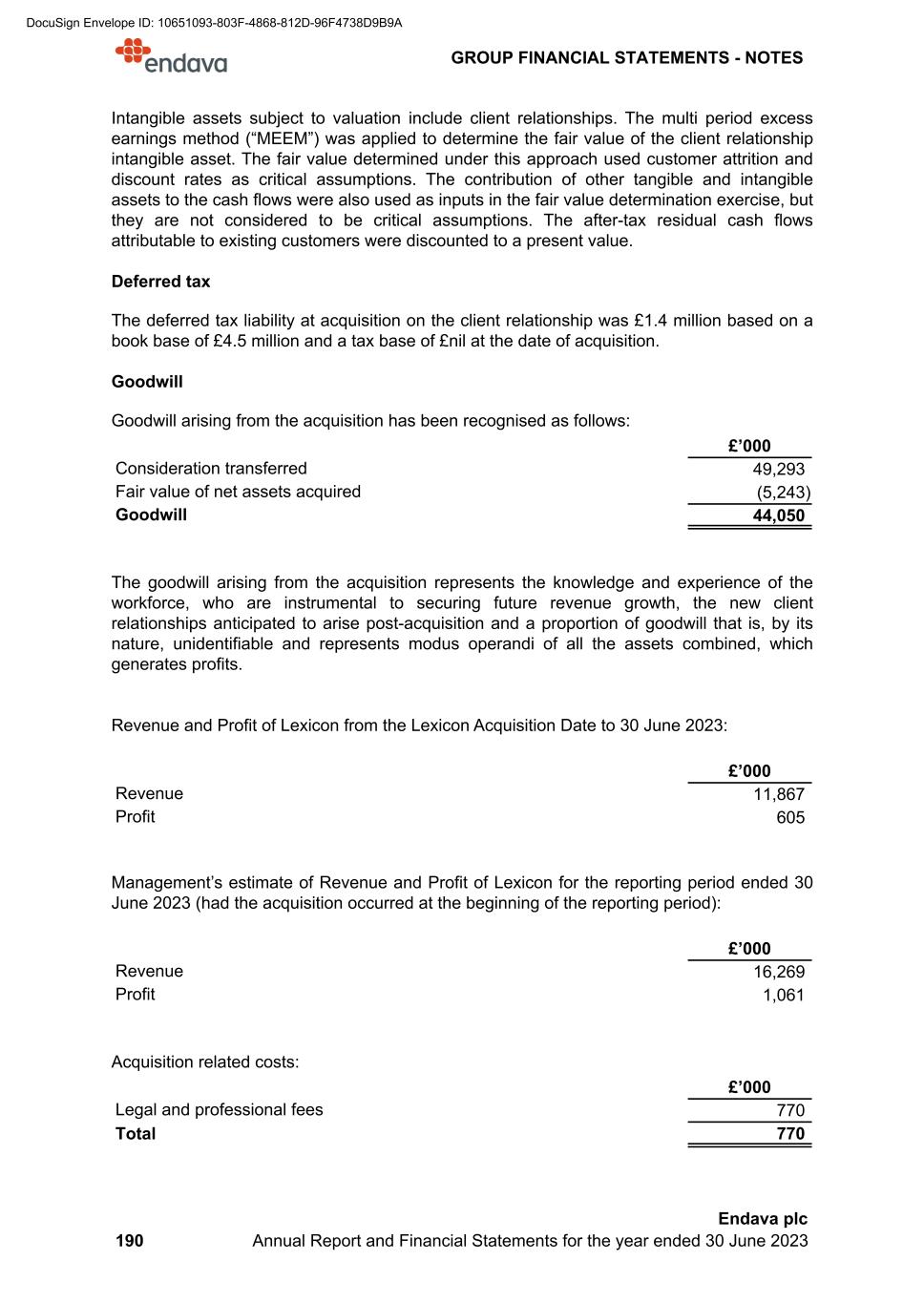
Intangible assets subject to valuation include client relationships. The multi period excess earnings method (“MEEM”) was applied to determine the fair value of the client relationship intangible asset. The fair value determined under this approach used customer attrition and discount rates as critical assumptions. The contribution of other tangible and intangible assets to the cash flows were also used as inputs in the fair value determination exercise, but they are not considered to be critical assumptions. The after-tax residual cash flows attributable to existing customers were discounted to a present value. Deferred tax The deferred tax liability at acquisition on the client relationship was £1.4 million based on a book base of £4.5 million and a tax base of £nil at the date of acquisition. Goodwill Goodwill arising from the acquisition has been recognised as follows: £’000 Consideration transferred 49,293 Fair value of net assets acquired (5,243) Goodwill 44,050 The goodwill arising from the acquisition represents the knowledge and experience of the workforce, who are instrumental to securing future revenue growth, the new client relationships anticipated to arise post-acquisition and a proportion of goodwill that is, by its nature, unidentifiable and represents modus operandi of all the assets combined, which generates profits. Revenue and Profit of Lexicon from the Lexicon Acquisition Date to 30 June 2023: £’000 Revenue 11,867 Profit 605 Management’s estimate of Revenue and Profit of Lexicon for the reporting period ended 30 June 2023 (had the acquisition occurred at the beginning of the reporting period): £’000 Revenue 16,269 Profit 1,061 Acquisition related costs: £’000 Legal and professional fees 770 Total 770 GROUP FINANCIAL STATEMENTS - NOTES 190 Endava plc Annual Report and Financial Statements for the year ended 30 June 2023 DocuSign Envelope ID: 10651093-803F-4868-812D-96F4738D9B9A
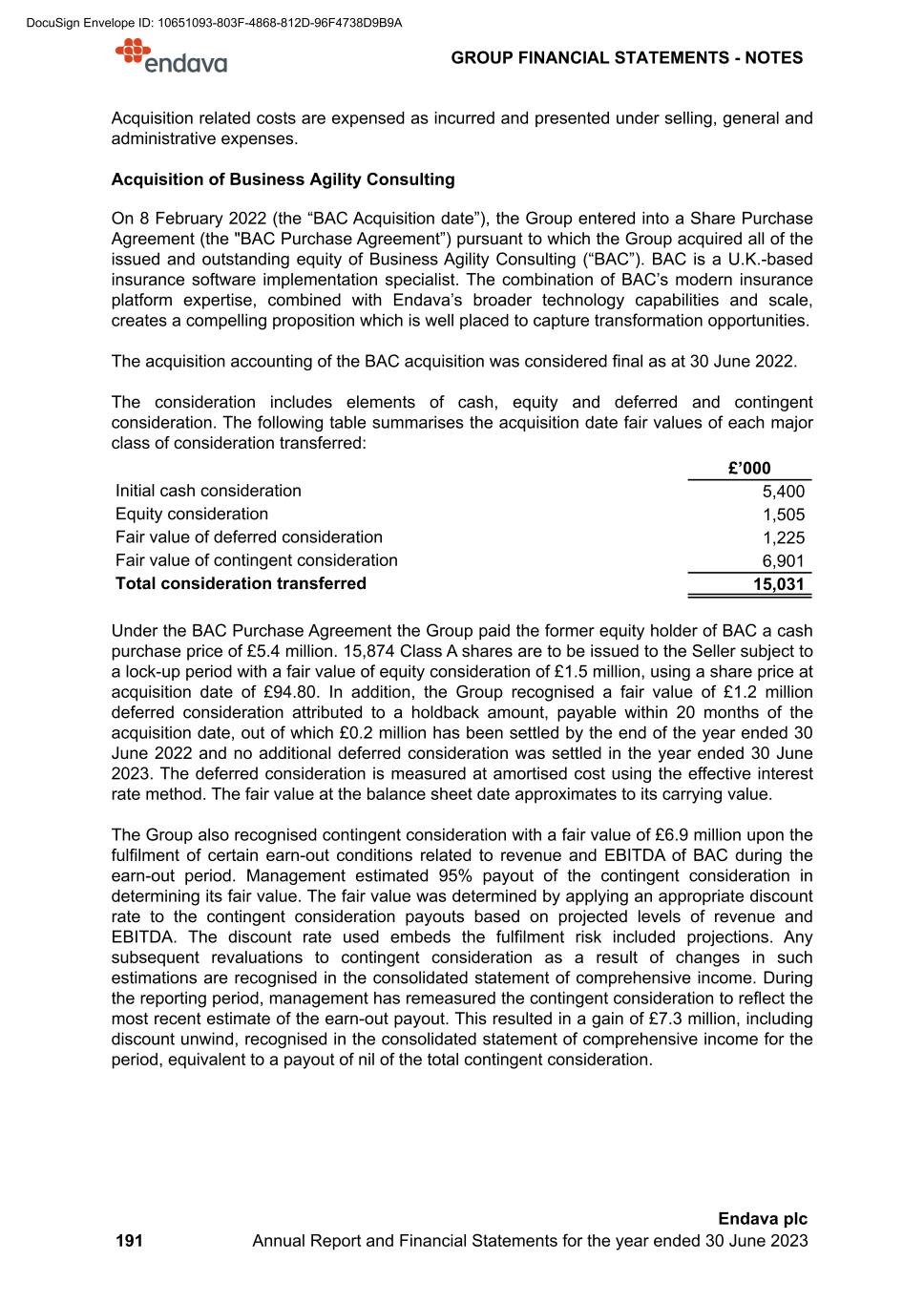
Acquisition related costs are expensed as incurred and presented under selling, general and administrative expenses. Acquisition of Business Agility Consulting On 8 February 2022 (the “BAC Acquisition date”), the Group entered into a Share Purchase Agreement (the "BAC Purchase Agreement”) pursuant to which the Group acquired all of the issued and outstanding equity of Business Agility Consulting (“BAC”). BAC is a U.K.-based insurance software implementation specialist. The combination of BAC’s modern insurance platform expertise, combined with Endava’s broader technology capabilities and scale, creates a compelling proposition which is well placed to capture transformation opportunities. The acquisition accounting of the BAC acquisition was considered final as at 30 June 2022. The consideration includes elements of cash, equity and deferred and contingent consideration. The following table summarises the acquisition date fair values of each major class of consideration transferred: £’000 Initial cash consideration 5,400 Equity consideration 1,505 Fair value of deferred consideration 1,225 Fair value of contingent consideration 6,901 Total consideration transferred 15,031 Under the BAC Purchase Agreement the Group paid the former equity holder of BAC a cash purchase price of £5.4 million. 15,874 Class A shares are to be issued to the Seller subject to a lock-up period with a fair value of equity consideration of £1.5 million, using a share price at acquisition date of £94.80. In addition, the Group recognised a fair value of £1.2 million deferred consideration attributed to a holdback amount, payable within 20 months of the acquisition date, out of which £0.2 million has been settled by the end of the year ended 30 June 2022 and no additional deferred consideration was settled in the year ended 30 June 2023. The deferred consideration is measured at amortised cost using the effective interest rate method. The fair value at the balance sheet date approximates to its carrying value. The Group also recognised contingent consideration with a fair value of £6.9 million upon the fulfilment of certain earn-out conditions related to revenue and EBITDA of BAC during the earn-out period. Management estimated 95% payout of the contingent consideration in determining its fair value. The fair value was determined by applying an appropriate discount rate to the contingent consideration payouts based on projected levels of revenue and EBITDA. The discount rate used embeds the fulfilment risk included projections. Any subsequent revaluations to contingent consideration as a result of changes in such estimations are recognised in the consolidated statement of comprehensive income. During the reporting period, management has remeasured the contingent consideration to reflect the most recent estimate of the earn-out payout. This resulted in a gain of £7.3 million, including discount unwind, recognised in the consolidated statement of comprehensive income for the period, equivalent to a payout of nil of the total contingent consideration. GROUP FINANCIAL STATEMENTS - NOTES 191 Endava plc Annual Report and Financial Statements for the year ended 30 June 2023 DocuSign Envelope ID: 10651093-803F-4868-812D-96F4738D9B9A
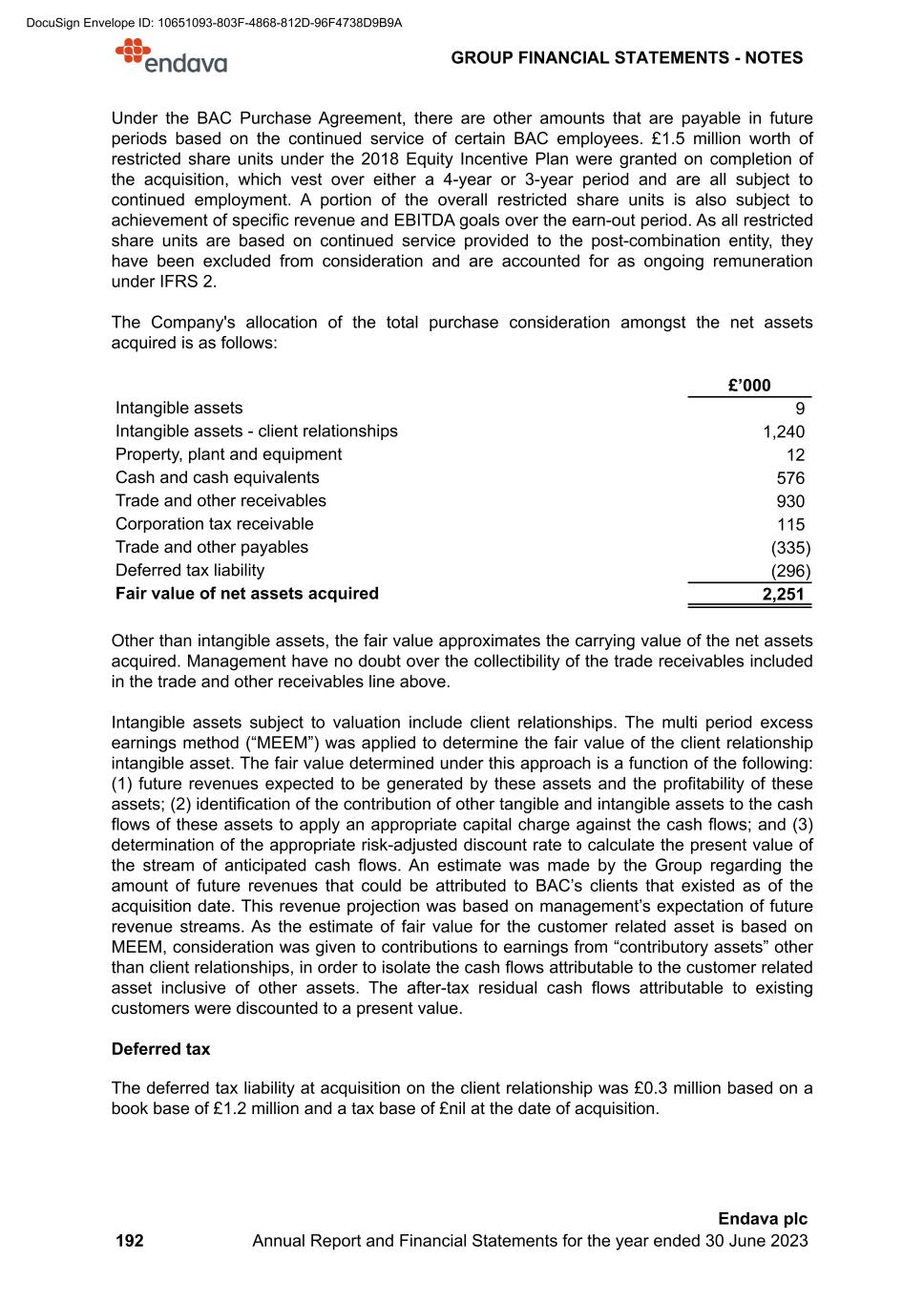
Under the BAC Purchase Agreement, there are other amounts that are payable in future periods based on the continued service of certain BAC employees. £1.5 million worth of restricted share units under the 2018 Equity Incentive Plan were granted on completion of the acquisition, which vest over either a 4-year or 3-year period and are all subject to continued employment. A portion of the overall restricted share units is also subject to achievement of specific revenue and EBITDA goals over the earn-out period. As all restricted share units are based on continued service provided to the post-combination entity, they have been excluded from consideration and are accounted for as ongoing remuneration under IFRS 2. The Company's allocation of the total purchase consideration amongst the net assets acquired is as follows: £’000 Intangible assets 9 Intangible assets - client relationships 1,240 Property, plant and equipment 12 Cash and cash equivalents 576 Trade and other receivables 930 Corporation tax receivable 115 Trade and other payables (335) Deferred tax liability (296) Fair value of net assets acquired 2,251 Other than intangible assets, the fair value approximates the carrying value of the net assets acquired. Management have no doubt over the collectibility of the trade receivables included in the trade and other receivables line above. Intangible assets subject to valuation include client relationships. The multi period excess earnings method (“MEEM”) was applied to determine the fair value of the client relationship intangible asset. The fair value determined under this approach is a function of the following: (1) future revenues expected to be generated by these assets and the profitability of these assets; (2) identification of the contribution of other tangible and intangible assets to the cash flows of these assets to apply an appropriate capital charge against the cash flows; and (3) determination of the appropriate risk-adjusted discount rate to calculate the present value of the stream of anticipated cash flows. An estimate was made by the Group regarding the amount of future revenues that could be attributed to BAC’s clients that existed as of the acquisition date. This revenue projection was based on management’s expectation of future revenue streams. As the estimate of fair value for the customer related asset is based on MEEM, consideration was given to contributions to earnings from “contributory assets” other than client relationships, in order to isolate the cash flows attributable to the customer related asset inclusive of other assets. The after-tax residual cash flows attributable to existing customers were discounted to a present value. Deferred tax The deferred tax liability at acquisition on the client relationship was £0.3 million based on a book base of £1.2 million and a tax base of £nil at the date of acquisition. GROUP FINANCIAL STATEMENTS - NOTES 192 Endava plc Annual Report and Financial Statements for the year ended 30 June 2023 DocuSign Envelope ID: 10651093-803F-4868-812D-96F4738D9B9A

Goodwill Goodwill arising from the acquisition has been recognised as follows: £’000 Consideration transferred 15,031 Fair value of net assets acquired (2,251) Goodwill 12,780 The goodwill arising from the acquisition represents the knowledge and experience of the workforce, who are instrumental to securing future revenue growth, the new client relationships anticipated to arise post-acquisition and synergies achievable by combining BAC’s expertise in the insurance field with Endava’s broader software engineering experience and market presence. There is no goodwill amount that is expected to be deductible for tax purposes. Revenue and Loss of BAC from the BAC Acquisition Date to 30 June 2022: £’000 Revenue 1,790 Loss 112 Management’s estimate of Revenue and Profit of BAC for the reporting period ended 30 June 2022 (had the acquisition occurred at the beginning of the reporting period): £’000 Revenue 4,391 Profit 227 Acquisition Related Costs: £’000 Legal and professional fees 292 Stamp duty 87 Total 379 Acquisition related costs are expensed as incurred and presented under selling, general and administrative expenses. GROUP FINANCIAL STATEMENTS - NOTES 193 Endava plc Annual Report and Financial Statements for the year ended 30 June 2023 DocuSign Envelope ID: 10651093-803F-4868-812D-96F4738D9B9A

16. INTANGIBLE ASSETS 2023 Client relationship £’000 Software and licences £’000 Non- Compete Agreement £’000 Trade name £'000 Supplier relationships £'000 Software - own work capitalised Total £’000 Cost At 1 July 2022 87,273 798 146 — 120 1,162 89,499 Additions — 5 — — — — 5 On acquisition of subsidiary 23,985 — — — — — 23,985 Disposals — (142) (140) — — — (282) Effect of foreign exchange translations (2,342) (4) (6) — — (1) (2,353) At 30 June 2023 108,916 657 — — 120 1,161 110,854 Amortisation At 1 July 2022 31,430 740 146 — 64 930 33,310 Charge for the year 12,246 37 — — 24 160 12,467 Disposals — (142) (140) — — — (282) Effect of foreign exchange translations (845) (4) (6) — — (2) (857) At 30 June 2023 42,831 631 — — 88 1,088 44,638 Net book value At 30 June 2023 66,085 26 — — 32 73 66,216 GROUP FINANCIAL STATEMENTS - NOTES 194 Endava plc Annual Report and Financial Statements for the year ended 30 June 2023 DocuSign Envelope ID: 10651093-803F-4868-812D-96F4738D9B9A

2022 Client relationship £’000 Software and licences £’000 Non- Compete Agreement £’000 Trade name £'000 Supplier relationships £'000 Software - own work capitalised Total £’000 Cost At 1 July 2021 80,623 777 128 272 120 1,159 83,079 Additions — 4 — — — — 4 On acquisition of subsidiary 1,240 9 — — — — 1,249 Disposals — — — (272) — — (272) Effect of foreign exchange translations 5,410 8 18 — — 3 5,439 At 30 June 2022 87,273 798 146 — 120 1,162 89,499 Amortisation At 1 July 2021 19,251 684 128 90 40 630 20,823 Charge for the year 10,617 47 — 182 24 293 11,163 Disposals — — — (272) — — (272) Effect of foreign exchange translations 1,562 9 18 — — 7 1,596 At 30 June 2022 31,430 740 146 — 64 930 33,310 Net book value At 30 June 2022 55,843 58 — — 56 232 56,189 GROUP FINANCIAL STATEMENTS - NOTES 195 Endava plc Annual Report and Financial Statements for the year ended 30 June 2023 DocuSign Envelope ID: 10651093-803F-4868-812D-96F4738D9B9A
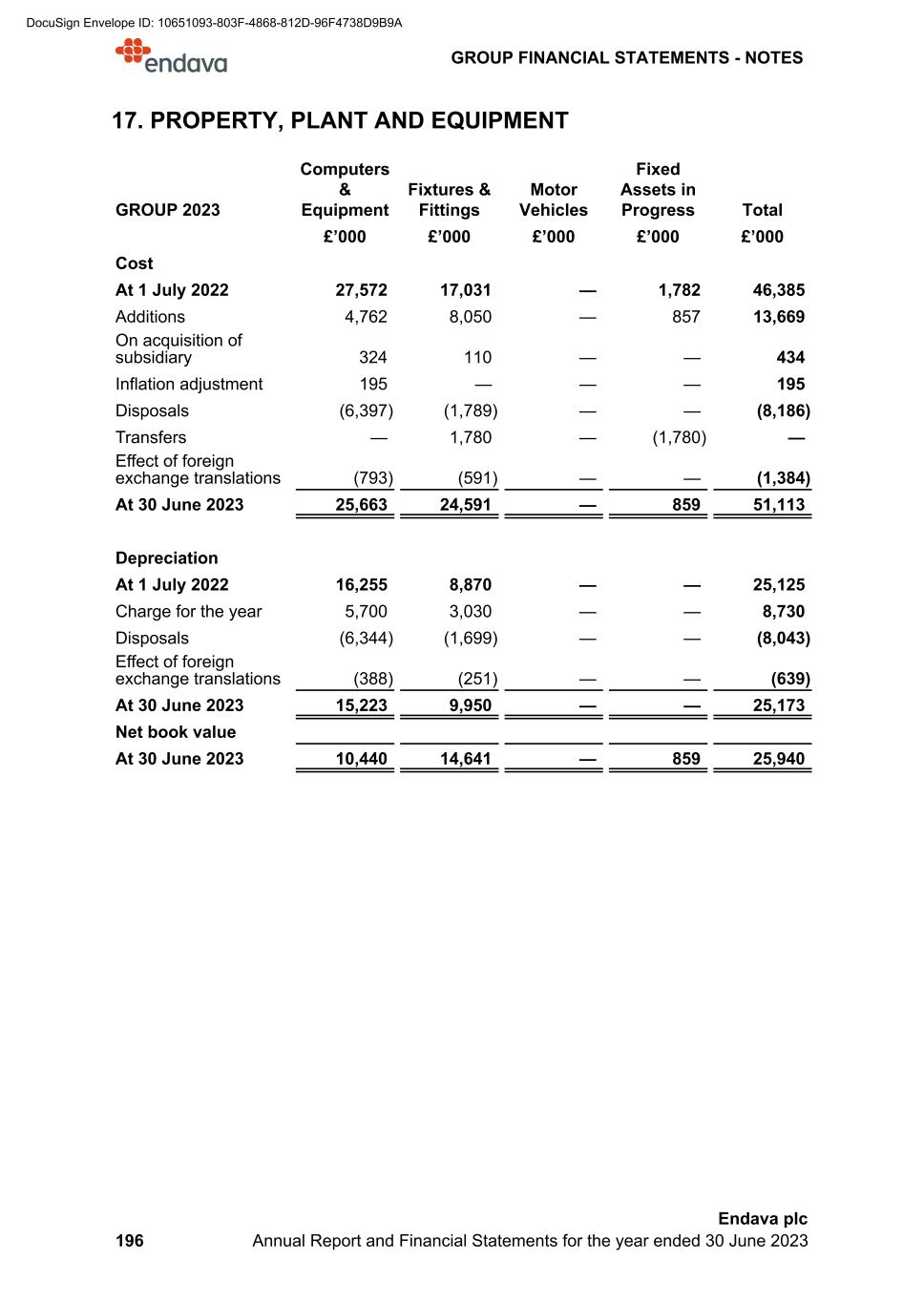
17. PROPERTY, PLANT AND EQUIPMENT GROUP 2023 Computers & Equipment Fixtures & Fittings Motor Vehicles Fixed Assets in Progress Total £’000 £’000 £’000 £’000 £’000 Cost At 1 July 2022 27,572 17,031 — 1,782 46,385 Additions 4,762 8,050 — 857 13,669 On acquisition of subsidiary 324 110 — — 434 Inflation adjustment 195 — — — 195 Disposals (6,397) (1,789) — — (8,186) Transfers — 1,780 — (1,780) — Effect of foreign exchange translations (793) (591) — — (1,384) At 30 June 2023 25,663 24,591 — 859 51,113 Depreciation At 1 July 2022 16,255 8,870 — — 25,125 Charge for the year 5,700 3,030 — — 8,730 Disposals (6,344) (1,699) — — (8,043) Effect of foreign exchange translations (388) (251) — — (639) At 30 June 2023 15,223 9,950 — — 25,173 Net book value At 30 June 2023 10,440 14,641 — 859 25,940 GROUP FINANCIAL STATEMENTS - NOTES 196 Endava plc Annual Report and Financial Statements for the year ended 30 June 2023 DocuSign Envelope ID: 10651093-803F-4868-812D-96F4738D9B9A
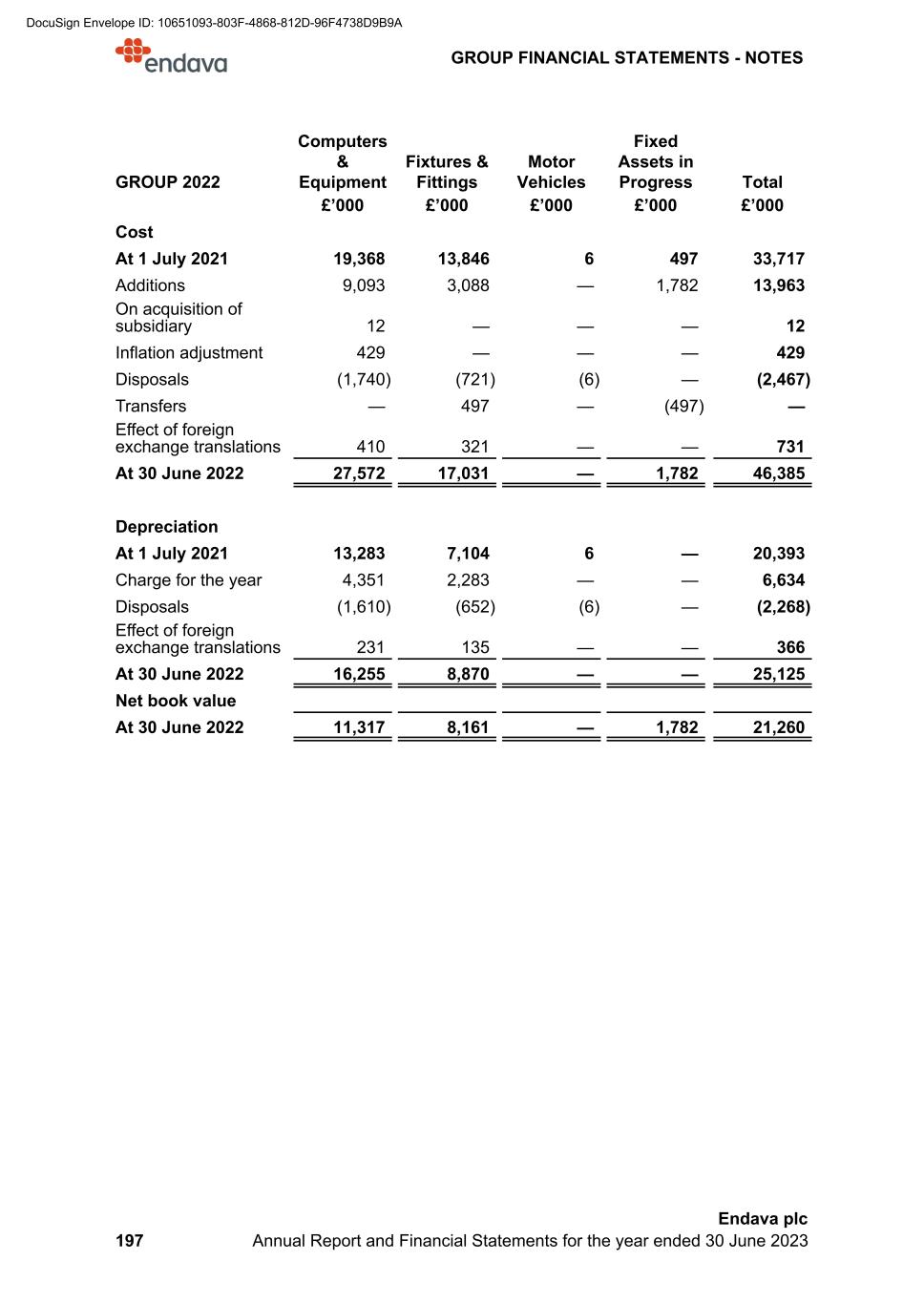
GROUP 2022 Computers & Equipment Fixtures & Fittings Motor Vehicles Fixed Assets in Progress Total £’000 £’000 £’000 £’000 £’000 Cost At 1 July 2021 19,368 13,846 6 497 33,717 Additions 9,093 3,088 — 1,782 13,963 On acquisition of subsidiary 12 — — — 12 Inflation adjustment 429 — — — 429 Disposals (1,740) (721) (6) — (2,467) Transfers — 497 — (497) — Effect of foreign exchange translations 410 321 — — 731 At 30 June 2022 27,572 17,031 — 1,782 46,385 Depreciation At 1 July 2021 13,283 7,104 6 — 20,393 Charge for the year 4,351 2,283 — — 6,634 Disposals (1,610) (652) (6) — (2,268) Effect of foreign exchange translations 231 135 — — 366 At 30 June 2022 16,255 8,870 — — 25,125 Net book value At 30 June 2022 11,317 8,161 — 1,782 21,260 GROUP FINANCIAL STATEMENTS - NOTES 197 Endava plc Annual Report and Financial Statements for the year ended 30 June 2023 DocuSign Envelope ID: 10651093-803F-4868-812D-96F4738D9B9A

18. SIGNIFICANT SHAREHOLDINGS AND RELATED PARTY TRANSACTIONS Significant shareholdings At 30 June 2023, the Group held 100% of the share capital of the following entities: Subsidiary Country of incorporation Key Class of shares held Percentage of shares held Principal activity Endava Argentina SRL Argentina AR1 Ordinary 100% Provision of IT Services Endava Australia Pty Ltd Australia AU1 Ordinary 100% Provision of IT Services DEK Corporation Pty Ltd Australia AU2 Ordinary 100% Provision of IT Services Lexicon Consolidated Holdings Pty Ltd Australia AU3 Ordinary 100% Provision of IT Services Lexicon Digital Trust Australia AU3 Ordinary 100% Provision of IT Services Lexicon Digital Pty Ltd Australia AU3 Ordinary 100% Provision of IT Services Mudbath & Co Pty Ltd Australia AU4 Ordinary 100% Provision of IT Services Endava Austria GmbH Austria AU5 Ordinary 100% Provision of IT Services Endava d.o.o. Banja Luka Bosnia and Herzegovina BO1 Ordinary 100% Provision of IT Services Endava d.o.o. Sarajevo Bosnia and Herzegovina BO2 Ordinary 100% Provision of IT Services Endava EOOD Bulgaria BU1 Ordinary 100% Provision of IT Services Endava Canada Inc. Canada CA1 Ordinary 100% Provision of IT Services Endava Colombia S.A.S. Colombia CO1 Ordinary 100% Provision of IT Services Endava S.A.S. Colombia CO2 Ordinary 100% Provision of IT Services Endava d.o.o. Croatia CR1 Ordinary 100% Provision of IT Services Endava ApS Denmark DE1 Ordinary 100% Provision of IT Services Endava GmbH Germany GE1 Ordinary 100% Provision of IT Services Endava Munchen GmbH Germany GE2 Ordinary 100% Provision of IT Services Endava (Ireland) Limited Ireland IR1 Ordinary 100% Provision of IT Services Endava Digital Services Limited Ireland IR2 Ordinary 100% Provision of IT Services Endava Malaysia SDN. BHD. Malaysia MA1 Ordinary 100% Provision of IT Services GROUP FINANCIAL STATEMENTS - NOTES 198 Endava plc Annual Report and Financial Statements for the year ended 30 June 2023 DocuSign Envelope ID: 10651093-803F-4868-812D-96F4738D9B9A
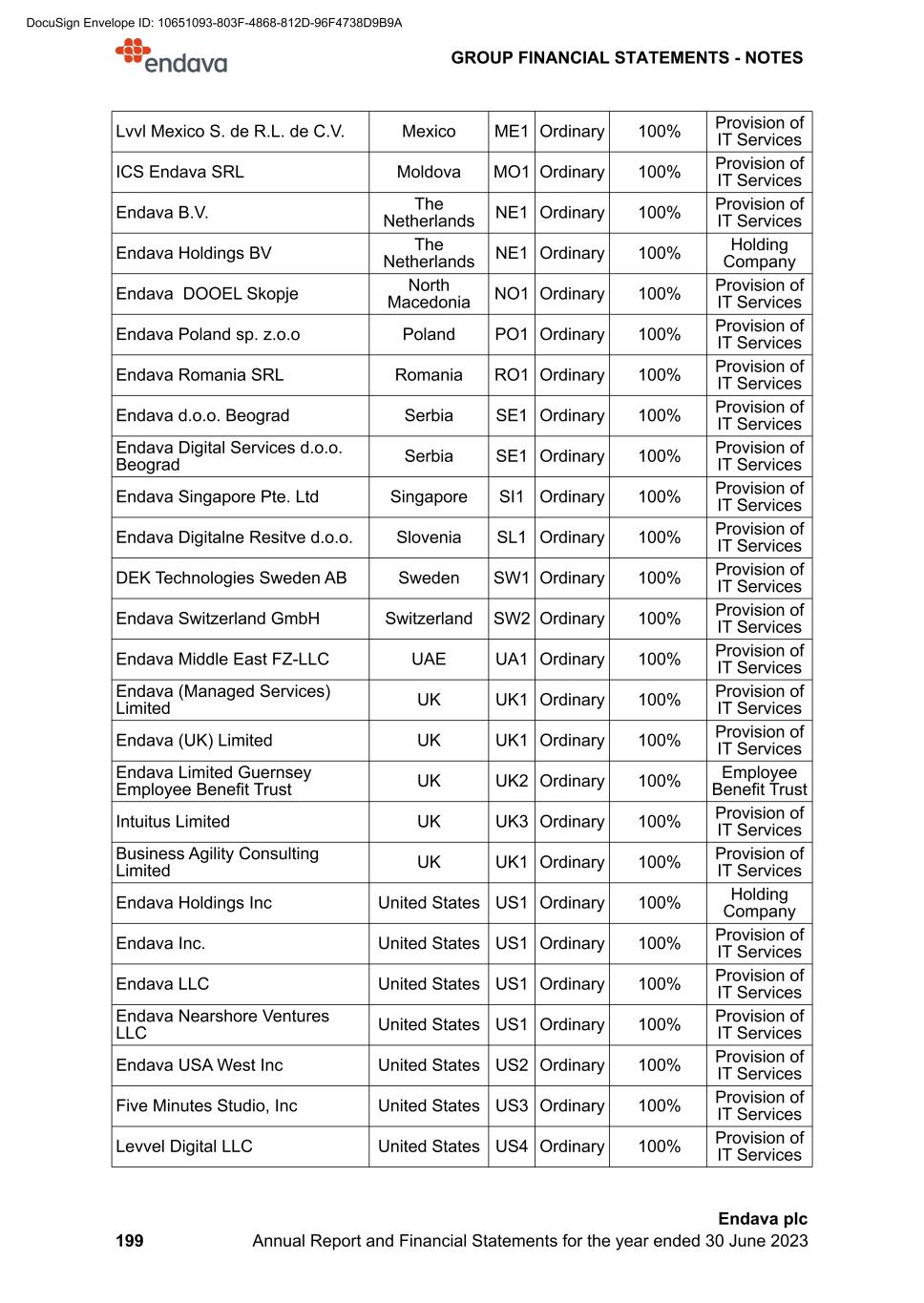
Lvvl Mexico S. de R.L. de C.V. Mexico ME1 Ordinary 100% Provision of IT Services ICS Endava SRL Moldova MO1 Ordinary 100% Provision of IT Services Endava B.V. The Netherlands NE1 Ordinary 100% Provision of IT Services Endava Holdings BV The Netherlands NE1 Ordinary 100% Holding Company Endava DOOEL Skopje North Macedonia NO1 Ordinary 100% Provision of IT Services Endava Poland sp. z.o.o Poland PO1 Ordinary 100% Provision of IT Services Endava Romania SRL Romania RO1 Ordinary 100% Provision of IT Services Endava d.o.o. Beograd Serbia SE1 Ordinary 100% Provision of IT Services Endava Digital Services d.o.o. Beograd Serbia SE1 Ordinary 100% Provision of IT Services Endava Singapore Pte. Ltd Singapore SI1 Ordinary 100% Provision of IT Services Endava Digitalne Resitve d.o.o. Slovenia SL1 Ordinary 100% Provision of IT Services DEK Technologies Sweden AB Sweden SW1 Ordinary 100% Provision of IT Services Endava Switzerland GmbH Switzerland SW2 Ordinary 100% Provision of IT Services Endava Middle East FZ-LLC UAE UA1 Ordinary 100% Provision of IT Services Endava (Managed Services) Limited UK UK1 Ordinary 100% Provision of IT Services Endava (UK) Limited UK UK1 Ordinary 100% Provision of IT Services Endava Limited Guernsey Employee Benefit Trust UK UK2 Ordinary 100% Employee Benefit Trust Intuitus Limited UK UK3 Ordinary 100% Provision of IT Services Business Agility Consulting Limited UK UK1 Ordinary 100% Provision of IT Services Endava Holdings Inc United States US1 Ordinary 100% Holding Company Endava Inc. United States US1 Ordinary 100% Provision of IT Services Endava LLC United States US1 Ordinary 100% Provision of IT Services Endava Nearshore Ventures LLC United States US1 Ordinary 100% Provision of IT Services Endava USA West Inc United States US2 Ordinary 100% Provision of IT Services Five Minutes Studio, Inc United States US3 Ordinary 100% Provision of IT Services Levvel Digital LLC United States US4 Ordinary 100% Provision of IT Services GROUP FINANCIAL STATEMENTS - NOTES 199 Endava plc Annual Report and Financial Statements for the year ended 30 June 2023 DocuSign Envelope ID: 10651093-803F-4868-812D-96F4738D9B9A
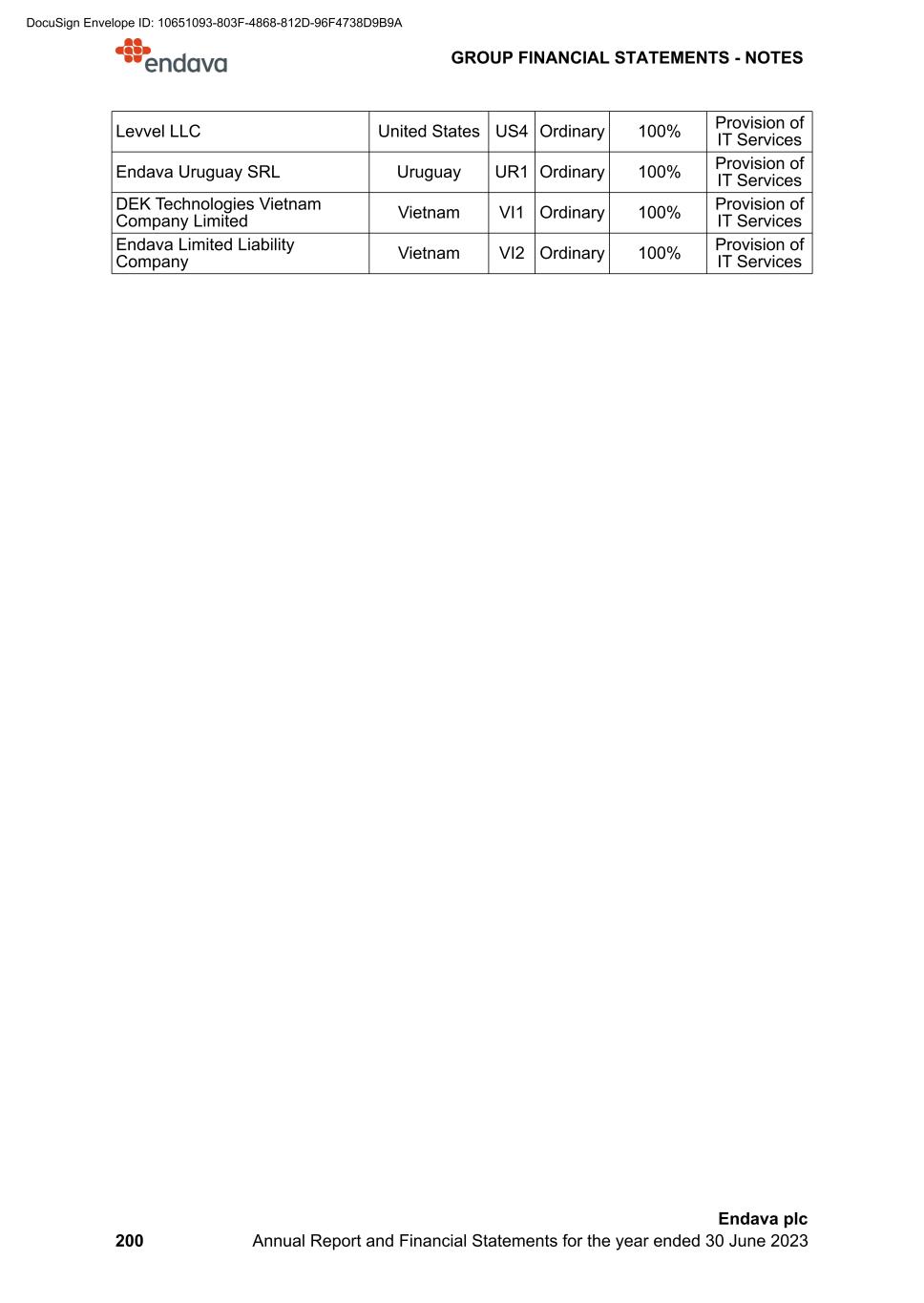
Levvel LLC United States US4 Ordinary 100% Provision of IT Services Endava Uruguay SRL Uruguay UR1 Ordinary 100% Provision of IT Services DEK Technologies Vietnam Company Limited Vietnam VI1 Ordinary 100% Provision of IT Services Endava Limited Liability Company Vietnam VI2 Ordinary 100% Provision of IT Services GROUP FINANCIAL STATEMENTS - NOTES 200 Endava plc Annual Report and Financial Statements for the year ended 30 June 2023 DocuSign Envelope ID: 10651093-803F-4868-812D-96F4738D9B9A
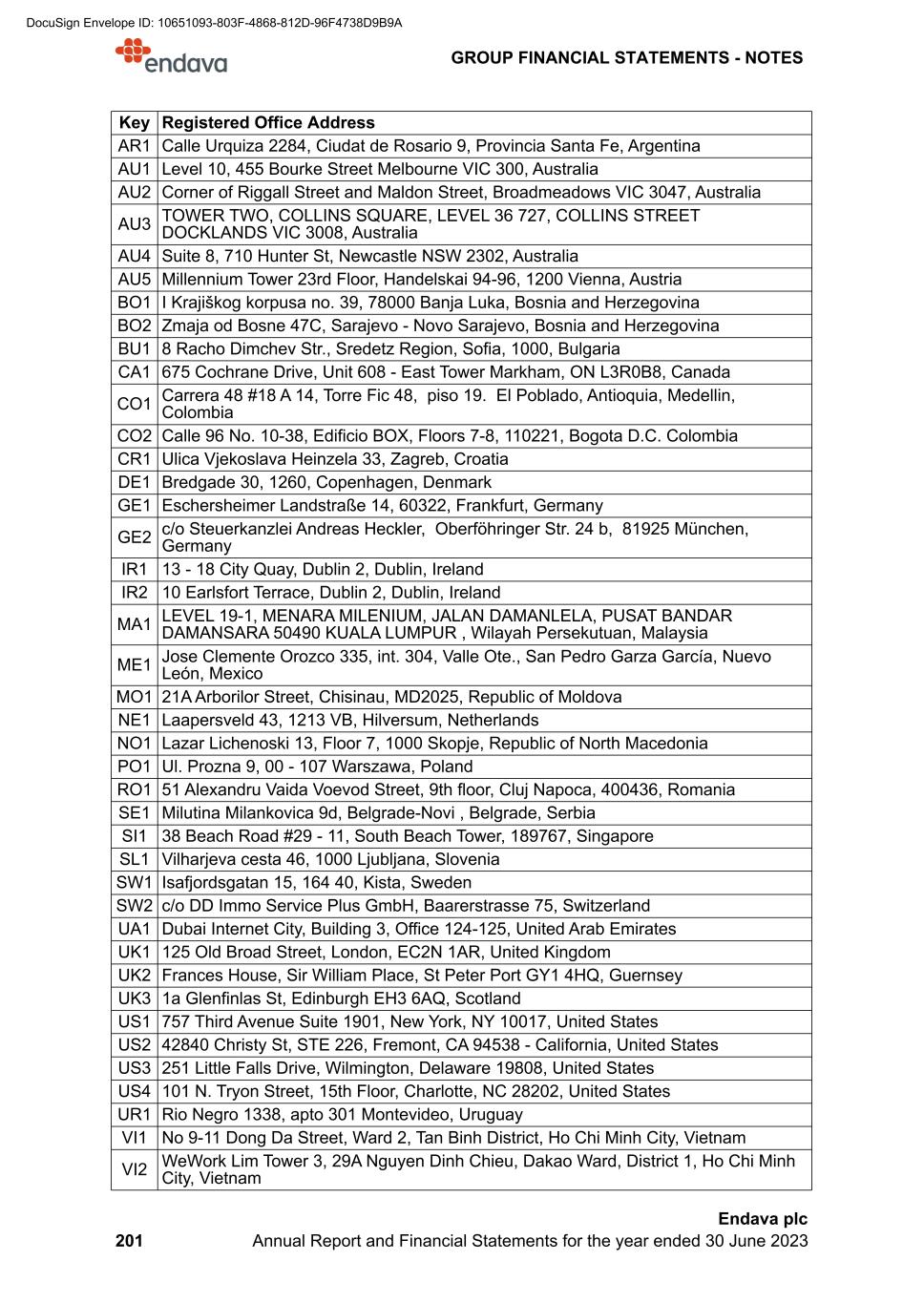
Key Registered Office Address AR1 Calle Urquiza 2284, Ciudat de Rosario 9, Provincia Santa Fe, Argentina AU1 Level 10, 455 Bourke Street Melbourne VIC 300, Australia AU2 Corner of Riggall Street and Maldon Street, Broadmeadows VIC 3047, Australia AU3 TOWER TWO, COLLINS SQUARE, LEVEL 36 727, COLLINS STREET DOCKLANDS VIC 3008, Australia AU4 Suite 8, 710 Hunter St, Newcastle NSW 2302, Australia AU5 Millennium Tower 23rd Floor, Handelskai 94-96, 1200 Vienna, Austria BO1 I Krajiškog korpusa no. 39, 78000 Banja Luka, Bosnia and Herzegovina BO2 Zmaja od Bosne 47C, Sarajevo - Novo Sarajevo, Bosnia and Herzegovina BU1 8 Racho Dimchеv Str., Sredetz Region, Sofia, 1000, Bulgaria CA1 675 Cochrane Drive, Unit 608 - East Tower Markham, ON L3R0B8, Canada CO1 Carrera 48 #18 A 14, Torre Fic 48, piso 19. El Poblado, Antioquia, Medellin, Colombia CO2 Calle 96 No. 10-38, Edificio BOX, Floors 7-8, 110221, Bogota D.C. Colombia CR1 Ulica Vjekoslava Heinzela 33, Zagreb, Croatia DE1 Bredgade 30, 1260, Copenhagen, Denmark GE1 Eschersheimer Landstraße 14, 60322, Frankfurt, Germany GE2 c/o Steuerkanzlei Andreas Heckler, Oberföhringer Str. 24 b, 81925 München, Germany IR1 13 - 18 City Quay, Dublin 2, Dublin, Ireland IR2 10 Earlsfort Terrace, Dublin 2, Dublin, Ireland MA1 LEVEL 19-1, MENARA MILENIUM, JALAN DAMANLELA, PUSAT BANDAR DAMANSARA 50490 KUALA LUMPUR , Wilayah Persekutuan, Malaysia ME1 Jose Clemente Orozco 335, int. 304, Valle Ote., San Pedro Garza García, Nuevo León, Mexico MO1 21A Arborilor Street, Chisinau, MD2025, Republic of Moldova NE1 Laapersveld 43, 1213 VB, Hilversum, Netherlands NO1 Lazar Lichenoski 13, Floor 7, 1000 Skopje, Republic of North Macedonia PO1 Ul. Prozna 9, 00 - 107 Warszawa, Poland RO1 51 Alexandru Vaida Voevod Street, 9th floor, Cluj Napoca, 400436, Romania SE1 Milutina Milankovica 9d, Belgrade-Novi , Belgrade, Serbia SI1 38 Beach Road #29 - 11, South Beach Tower, 189767, Singapore SL1 Vilharjeva cesta 46, 1000 Ljubljana, Slovenia SW1 Isafjordsgatan 15, 164 40, Kista, Sweden SW2 c/o DD Immo Service Plus GmbH, Baarerstrasse 75, Switzerland UA1 Dubai Internet City, Building 3, Office 124-125, United Arab Emirates UK1 125 Old Broad Street, London, EC2N 1AR, United Kingdom UK2 Frances House, Sir William Place, St Peter Port GY1 4HQ, Guernsey UK3 1a Glenfinlas St, Edinburgh EH3 6AQ, Scotland US1 757 Third Avenue Suite 1901, New York, NY 10017, United States US2 42840 Christy St, STE 226, Fremont, CA 94538 - California, United States US3 251 Little Falls Drive, Wilmington, Delaware 19808, United States US4 101 N. Tryon Street, 15th Floor, Charlotte, NC 28202, United States UR1 Rio Negro 1338, apto 301 Montevideo, Uruguay VI1 No 9-11 Dong Da Street, Ward 2, Tan Binh District, Ho Chi Minh City, Vietnam VI2 WeWork Lim Tower 3, 29A Nguyen Dinh Chieu, Dakao Ward, District 1, Ho Chi Minh City, Vietnam GROUP FINANCIAL STATEMENTS - NOTES 201 Endava plc Annual Report and Financial Statements for the year ended 30 June 2023 DocuSign Envelope ID: 10651093-803F-4868-812D-96F4738D9B9A

DORMANT ENTITIES Subsidiary Country of incorporation Class of Shares Held Percentage of Shares Held Endava (Romania) Limited United Kingdom Ordinary 100% Testing 4 Finance Ltd United Kingdom Ordinary 100% Related Party Transactions At 30 June 2023, the executive officers and directors owned 10,092,540 ordinary shares, nominal value £0.02 per share (2022: 10,130,237 ordinary shares, nominal value £0.02) and held awards over a further 240,155 ordinary shares, nominal value £0.02 (2022: 298,383 ordinary shares, nominal value £0.02). Since April 2020, one of our directors, Sulina Connal, has been employed by Google as Director of Product Partnerships for News, Web and Publishing for EMEA. In the ordinary course of its business, from time to time Endava enters into agreements for cloud service or other solutions provided by Google in connection with services provided by Endava to its clients. All transactions with Google were entered into on an arms-length basis. For the year ended 30 June 2023, the aggregate cost incurred by Endava to Google for such services was £0.6 million (year ended 30 June 2022: £0.5 million). Other than the transactions with executive officers and directors disclosed above, no other related party transactions have been identified. Ultimate Parent Endava plc is the ultimate parent entity of the Group and it is considered that there is no ultimate controlling party. GROUP FINANCIAL STATEMENTS - NOTES 202 Endava plc Annual Report and Financial Statements for the year ended 30 June 2023 DocuSign Envelope ID: 10651093-803F-4868-812D-96F4738D9B9A
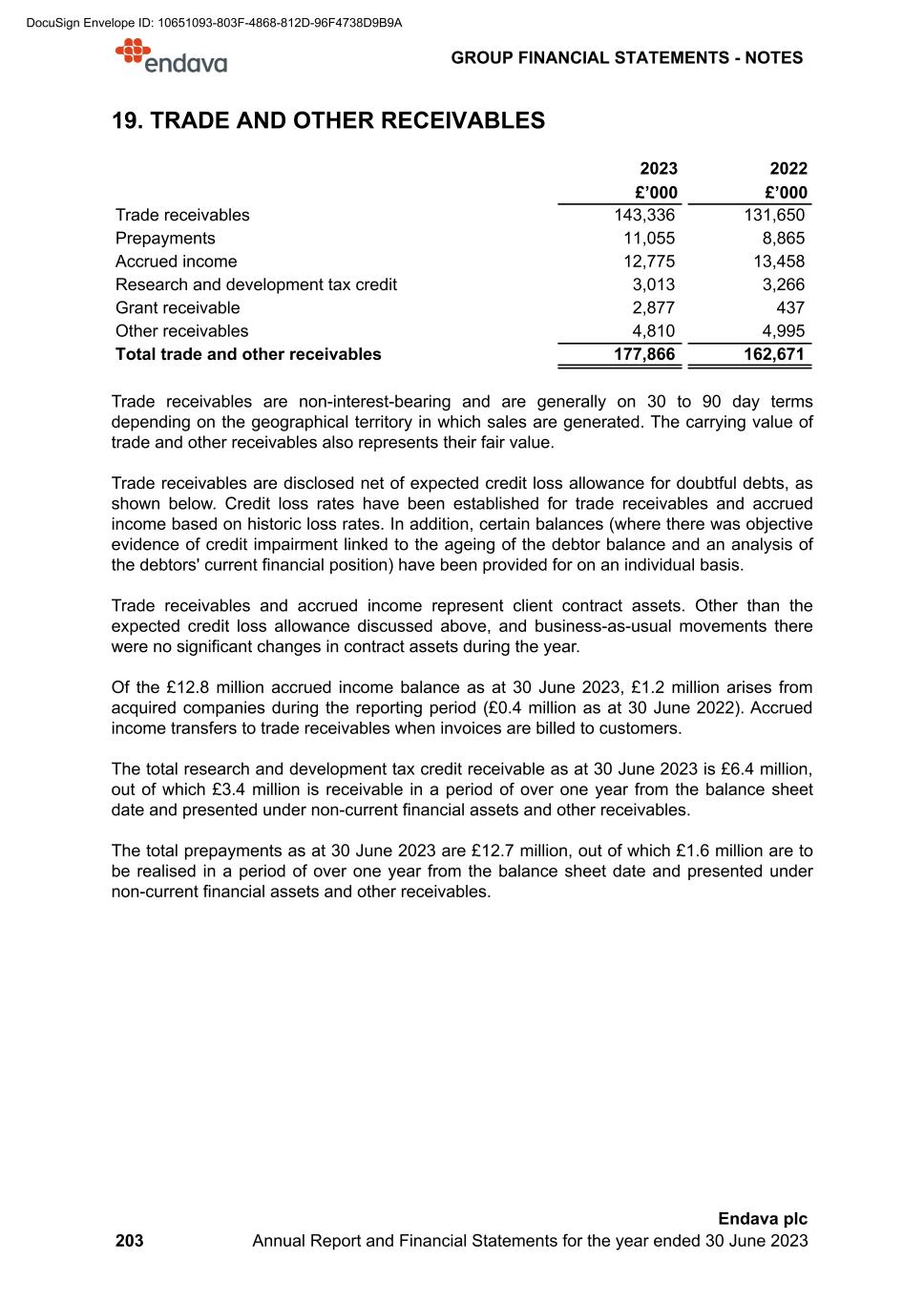
19. TRADE AND OTHER RECEIVABLES 2023 2022 £’000 £’000 Trade receivables 143,336 131,650 Prepayments 11,055 8,865 Accrued income 12,775 13,458 Research and development tax credit 3,013 3,266 Grant receivable 2,877 437 Other receivables 4,810 4,995 Total trade and other receivables 177,866 162,671 Trade receivables are non-interest-bearing and are generally on 30 to 90 day terms depending on the geographical territory in which sales are generated. The carrying value of trade and other receivables also represents their fair value. Trade receivables are disclosed net of expected credit loss allowance for doubtful debts, as shown below. Credit loss rates have been established for trade receivables and accrued income based on historic loss rates. In addition, certain balances (where there was objective evidence of credit impairment linked to the ageing of the debtor balance and an analysis of the debtors' current financial position) have been provided for on an individual basis. Trade receivables and accrued income represent client contract assets. Other than the expected credit loss allowance discussed above, and business-as-usual movements there were no significant changes in contract assets during the year. Of the £12.8 million accrued income balance as at 30 June 2023, £1.2 million arises from acquired companies during the reporting period (£0.4 million as at 30 June 2022). Accrued income transfers to trade receivables when invoices are billed to customers. The total research and development tax credit receivable as at 30 June 2023 is £6.4 million, out of which £3.4 million is receivable in a period of over one year from the balance sheet date and presented under non-current financial assets and other receivables. The total prepayments as at 30 June 2023 are £12.7 million, out of which £1.6 million are to be realised in a period of over one year from the balance sheet date and presented under non-current financial assets and other receivables. GROUP FINANCIAL STATEMENTS - NOTES 203 Endava plc Annual Report and Financial Statements for the year ended 30 June 2023 DocuSign Envelope ID: 10651093-803F-4868-812D-96F4738D9B9A

The following table presents the trade receivables and accrued income ageing intervals and the allocation of the expected credit loss allowance as at 30 June 2023 and 30 June 2022. 2023 £’000 2022 £’000 Trade receivables and accrued income - gross Expected credit loss allowance Trade receivables and accrued income - gross Expected credit loss allowance Current 135,844 (248) 122,914 (854) 1 - 30 days overdue 8,032 (147) 7,411 (94) 31 - 60 days overdue 6,532 (104) 9,520 (338) 61 - 90 days overdue 2,447 (71) 3,465 (141) Over 90 days overdue 7,750 (3,924) 5,821 (2,596) Total 160,605 (4,494) 149,131 (4,023) The gross and net amounts of trade receivables and accrued income were as follows: 2023 2022 £’000 £’000 Trade receivables - gross 147,830 135,665 Expected credit loss allowance (4,494) (4,015) Trade receivables - net 143,336 131,650 2023 2022 £’000 £’000 Accrued income - gross 12,775 13,466 Expected credit loss allowance — (8) Accrued income - net 12,775 13,458 Movements in the expected credit loss allowance were as follows: 2023 2022 £’000 £’000 As at 1 July 4,023 3,537 Provided in the year 6,181 4,628 Released in the year (5,249) (3,889) Utilised in the year (301) (492) Effect of foreign exchange translations (160) 239 As at 30 June 4,494 4,023 GROUP FINANCIAL STATEMENTS - NOTES 204 Endava plc Annual Report and Financial Statements for the year ended 30 June 2023 DocuSign Envelope ID: 10651093-803F-4868-812D-96F4738D9B9A
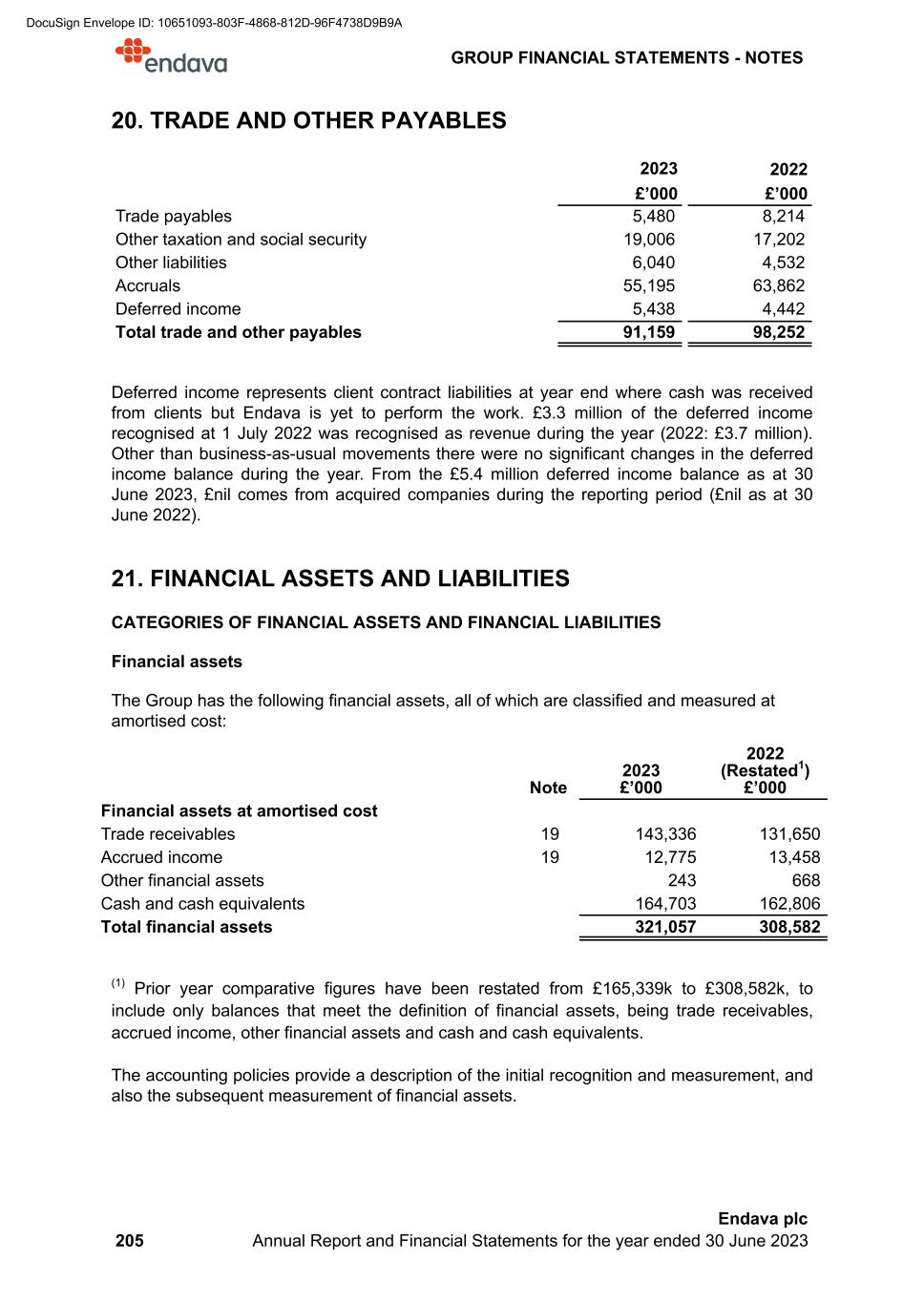
20. TRADE AND OTHER PAYABLES 2023 2022 £’000 £’000 Trade payables 5,480 8,214 Other taxation and social security 19,006 17,202 Other liabilities 6,040 4,532 Accruals 55,195 63,862 Deferred income 5,438 4,442 Total trade and other payables 91,159 98,252 Deferred income represents client contract liabilities at year end where cash was received from clients but Endava is yet to perform the work. £3.3 million of the deferred income recognised at 1 July 2022 was recognised as revenue during the year (2022: £3.7 million). Other than business-as-usual movements there were no significant changes in the deferred income balance during the year. From the £5.4 million deferred income balance as at 30 June 2023, £nil comes from acquired companies during the reporting period (£nil as at 30 June 2022). 21. FINANCIAL ASSETS AND LIABILITIES CATEGORIES OF FINANCIAL ASSETS AND FINANCIAL LIABILITIES Financial assets The Group has the following financial assets, all of which are classified and measured at amortised cost: Note 2023 £’000 2022 (Restated1) £’000 Financial assets at amortised cost Trade receivables 19 143,336 131,650 Accrued income 19 12,775 13,458 Other financial assets 243 668 Cash and cash equivalents 164,703 162,806 Total financial assets 321,057 308,582 (1) Prior year comparative figures have been restated from £165,339k to £308,582k, to include only balances that meet the definition of financial assets, being trade receivables, accrued income, other financial assets and cash and cash equivalents. The accounting policies provide a description of the initial recognition and measurement, and also the subsequent measurement of financial assets. GROUP FINANCIAL STATEMENTS - NOTES 205 Endava plc Annual Report and Financial Statements for the year ended 30 June 2023 DocuSign Envelope ID: 10651093-803F-4868-812D-96F4738D9B9A
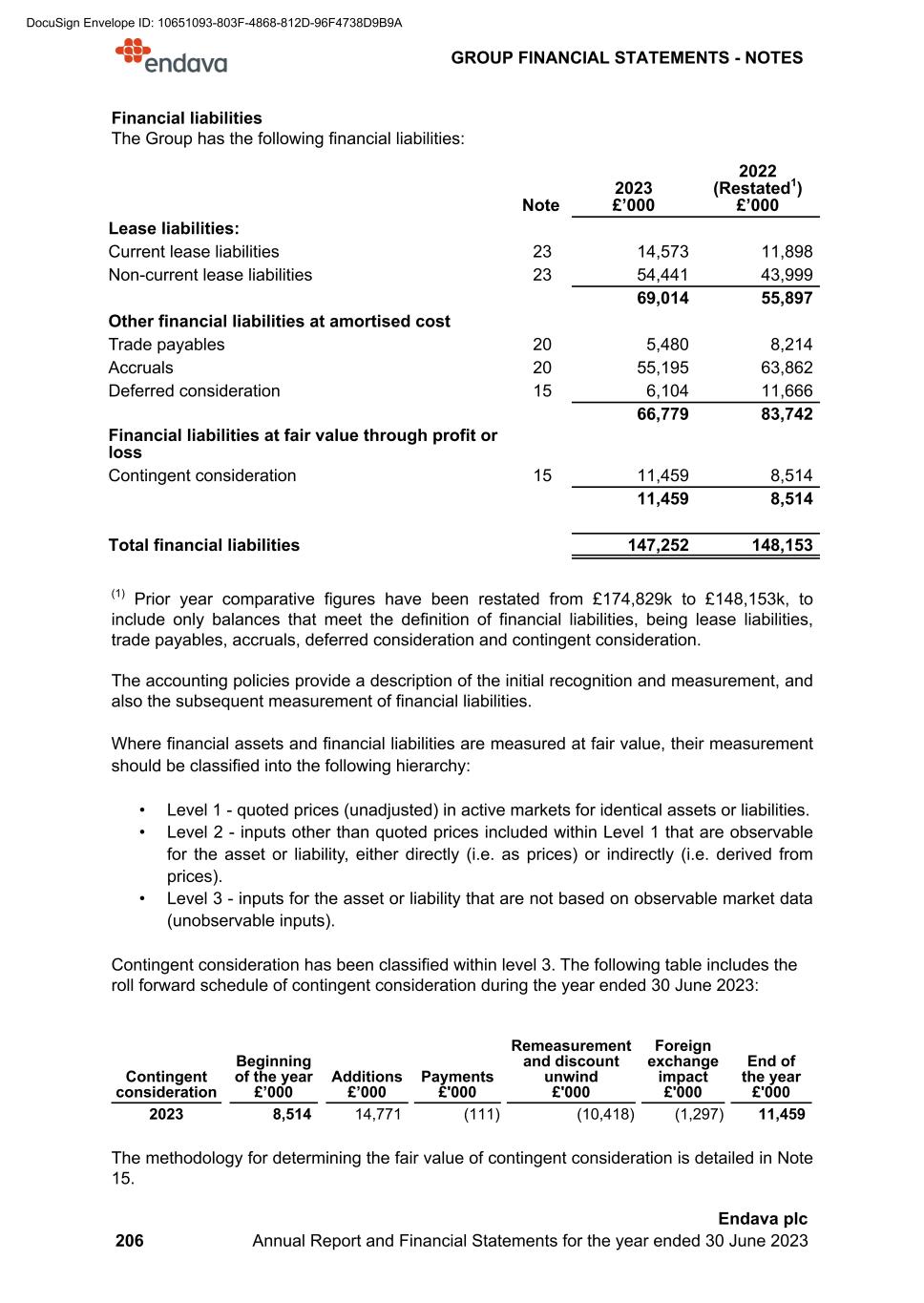
Financial liabilities The Group has the following financial liabilities: Note 2023 £’000 2022 (Restated1) £’000 Lease liabilities: Current lease liabilities 23 14,573 11,898 Non-current lease liabilities 23 54,441 43,999 69,014 55,897 Other financial liabilities at amortised cost Trade payables 20 5,480 8,214 Accruals 20 55,195 63,862 Deferred consideration 15 6,104 11,666 66,779 83,742 Financial liabilities at fair value through profit or loss Contingent consideration 15 11,459 8,514 11,459 8,514 Total financial liabilities 147,252 148,153 (1) Prior year comparative figures have been restated from £174,829k to £148,153k, to include only balances that meet the definition of financial liabilities, being lease liabilities, trade payables, accruals, deferred consideration and contingent consideration. The accounting policies provide a description of the initial recognition and measurement, and also the subsequent measurement of financial liabilities. Where financial assets and financial liabilities are measured at fair value, their measurement should be classified into the following hierarchy: • Level 1 - quoted prices (unadjusted) in active markets for identical assets or liabilities. • Level 2 - inputs other than quoted prices included within Level 1 that are observable for the asset or liability, either directly (i.e. as prices) or indirectly (i.e. derived from prices). • Level 3 - inputs for the asset or liability that are not based on observable market data (unobservable inputs). Contingent consideration has been classified within level 3. The following table includes the roll forward schedule of contingent consideration during the year ended 30 June 2023: Contingent consideration Beginning of the year £’000 Additions £’000 Payments £'000 Remeasurement and discount unwind £'000 Foreign exchange impact £'000 End of the year £'000 2023 8,514 14,771 (111) (10,418) (1,297) 11,459 The methodology for determining the fair value of contingent consideration is detailed in Note 15. GROUP FINANCIAL STATEMENTS - NOTES 206 Endava plc Annual Report and Financial Statements for the year ended 30 June 2023 DocuSign Envelope ID: 10651093-803F-4868-812D-96F4738D9B9A
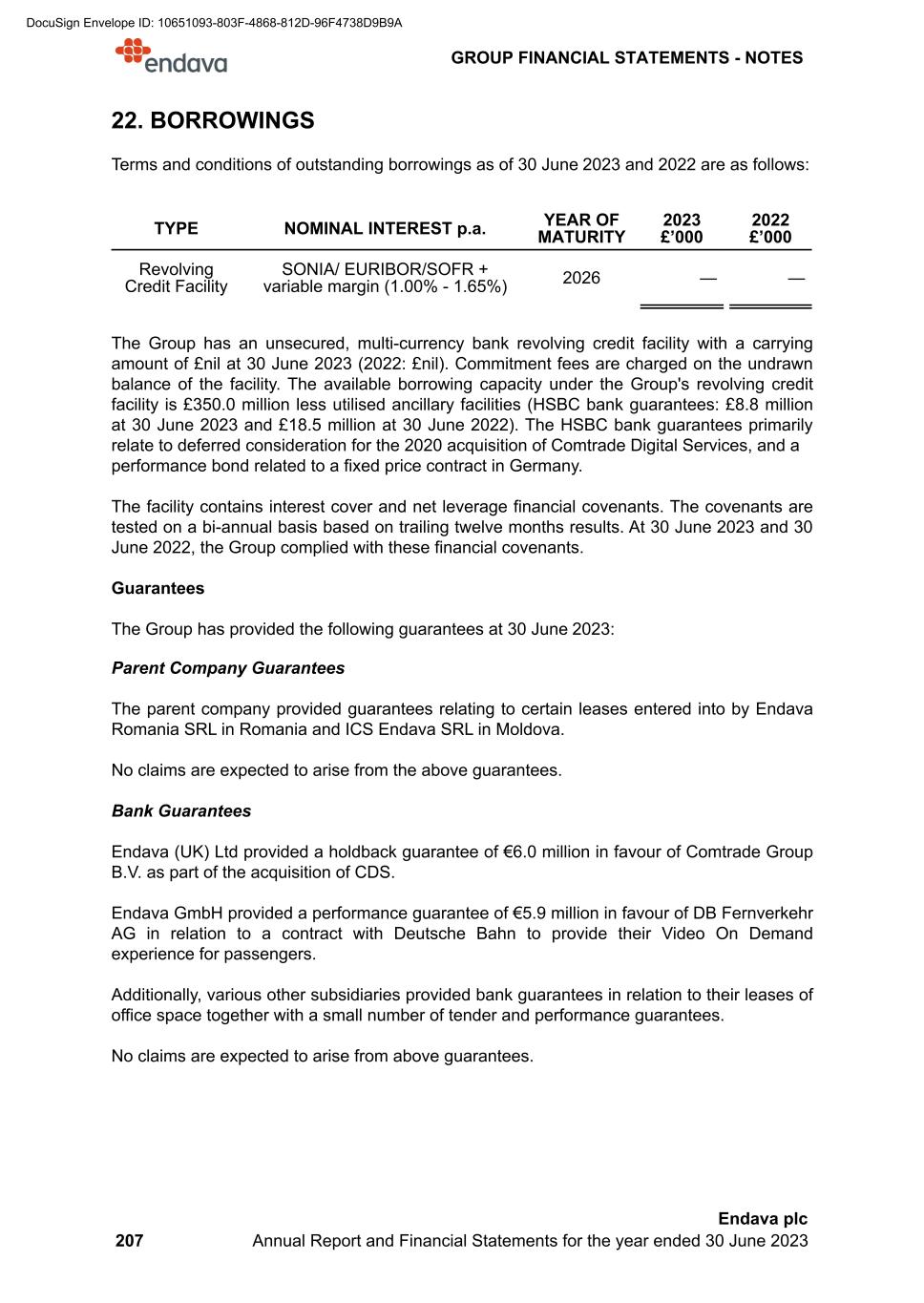
22. BORROWINGS Terms and conditions of outstanding borrowings as of 30 June 2023 and 2022 are as follows: TYPE NOMINAL INTEREST p.a. YEAR OF MATURITY 2023 £’000 2022 £’000 Revolving Credit Facility SONIA/ EURIBOR/SOFR + variable margin (1.00% - 1.65%) 2026 — — The Group has an unsecured, multi-currency bank revolving credit facility with a carrying amount of £nil at 30 June 2023 (2022: £nil). Commitment fees are charged on the undrawn balance of the facility. The available borrowing capacity under the Group's revolving credit facility is £350.0 million less utilised ancillary facilities (HSBC bank guarantees: £8.8 million at 30 June 2023 and £18.5 million at 30 June 2022). The HSBC bank guarantees primarily relate to deferred consideration for the 2020 acquisition of Comtrade Digital Services, and a performance bond related to a fixed price contract in Germany. The facility contains interest cover and net leverage financial covenants. The covenants are tested on a bi-annual basis based on trailing twelve months results. At 30 June 2023 and 30 June 2022, the Group complied with these financial covenants. Guarantees The Group has provided the following guarantees at 30 June 2023: Parent Company Guarantees The parent company provided guarantees relating to certain leases entered into by Endava Romania SRL in Romania and ICS Endava SRL in Moldova. No claims are expected to arise from the above guarantees. Bank Guarantees Endava (UK) Ltd provided a holdback guarantee of €6.0 million in favour of Comtrade Group B.V. as part of the acquisition of CDS. Endava GmbH provided a performance guarantee of €5.9 million in favour of DB Fernverkehr AG in relation to a contract with Deutsche Bahn to provide their Video On Demand experience for passengers. Additionally, various other subsidiaries provided bank guarantees in relation to their leases of office space together with a small number of tender and performance guarantees. No claims are expected to arise from above guarantees. GROUP FINANCIAL STATEMENTS - NOTES 207 Endava plc Annual Report and Financial Statements for the year ended 30 June 2023 DocuSign Envelope ID: 10651093-803F-4868-812D-96F4738D9B9A
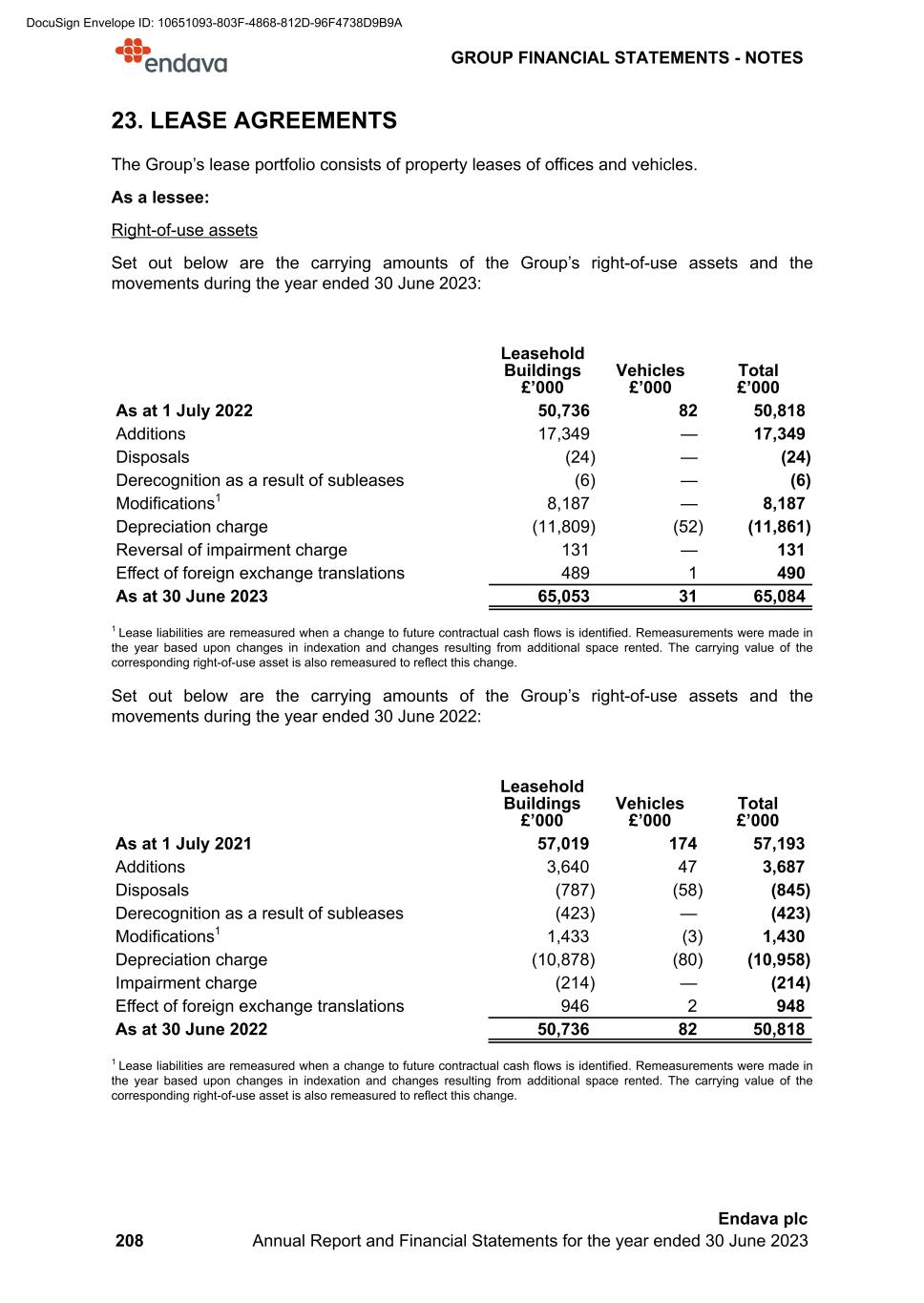
23. LEASE AGREEMENTS The Group’s lease portfolio consists of property leases of offices and vehicles. As a lessee: Right-of-use assets Set out below are the carrying amounts of the Group’s right-of-use assets and the movements during the year ended 30 June 2023: Leasehold Buildings £’000 Vehicles £’000 Total £’000 As at 1 July 2022 50,736 82 50,818 Additions 17,349 — 17,349 Disposals (24) — (24) Derecognition as a result of subleases (6) — (6) Modifications1 8,187 — 8,187 Depreciation charge (11,809) (52) (11,861) Reversal of impairment charge 131 — 131 Effect of foreign exchange translations 489 1 490 As at 30 June 2023 65,053 31 65,084 1 Lease liabilities are remeasured when a change to future contractual cash flows is identified. Remeasurements were made in the year based upon changes in indexation and changes resulting from additional space rented. The carrying value of the corresponding right-of-use asset is also remeasured to reflect this change. Set out below are the carrying amounts of the Group’s right-of-use assets and the movements during the year ended 30 June 2022: Leasehold Buildings £’000 Vehicles £’000 Total £’000 As at 1 July 2021 57,019 174 57,193 Additions 3,640 47 3,687 Disposals (787) (58) (845) Derecognition as a result of subleases (423) — (423) Modifications1 1,433 (3) 1,430 Depreciation charge (10,878) (80) (10,958) Impairment charge (214) — (214) Effect of foreign exchange translations 946 2 948 As at 30 June 2022 50,736 82 50,818 1 Lease liabilities are remeasured when a change to future contractual cash flows is identified. Remeasurements were made in the year based upon changes in indexation and changes resulting from additional space rented. The carrying value of the corresponding right-of-use asset is also remeasured to reflect this change. GROUP FINANCIAL STATEMENTS - NOTES 208 Endava plc Annual Report and Financial Statements for the year ended 30 June 2023 DocuSign Envelope ID: 10651093-803F-4868-812D-96F4738D9B9A

Lease liabilities Set out below are the carrying amounts of the Group’s lease liabilities and the movements during the year ended 30 June 2023: Leasehold Buildings £’000 Vehicles £’000 Total £’000 As at 1 July 2022 55,816 81 55,897 Additions 17,375 — 17,375 Disposals (24) — (24) Modifications1 8,188 — 8,188 Interest 1,675 1 1,676 Payments (13,435) (53) (13,488) Effect of foreign exchange translations (611) 1 (610) As at 30 June 2023 68,984 30 69,014 1 Lease liabilities are remeasured when a change to future contractual cash flows is identified. Remeasurements were made in the year based upon changes in indexation and changes resulting from additional space rented. Set out below are the carrying amounts of the Group’s lease liabilities and the movements during the year ended 30 June 2022: Leasehold Buildings £’000 Vehicles £’000 Total £’000 As at 1 July 2021 63,510 175 63,685 Additions 3,640 44 3,684 Disposals (1,021) (58) (1,079) Modifications1 1,428 (3) 1,425 Interest 1,126 2 1,128 Payments (13,722) (83) (13,805) Effect of foreign exchange translations 855 4 859 As at 30 June 2022 55,816 81 55,897 1 Lease liabilities are remeasured when a change to future contractual cash flows is identified. Remeasurements were made in the year based upon changes in indexation and changes resulting from additional space rented. The potential impact of lease covenants is considered to be immaterial. GROUP FINANCIAL STATEMENTS - NOTES 209 Endava plc Annual Report and Financial Statements for the year ended 30 June 2023 DocuSign Envelope ID: 10651093-803F-4868-812D-96F4738D9B9A
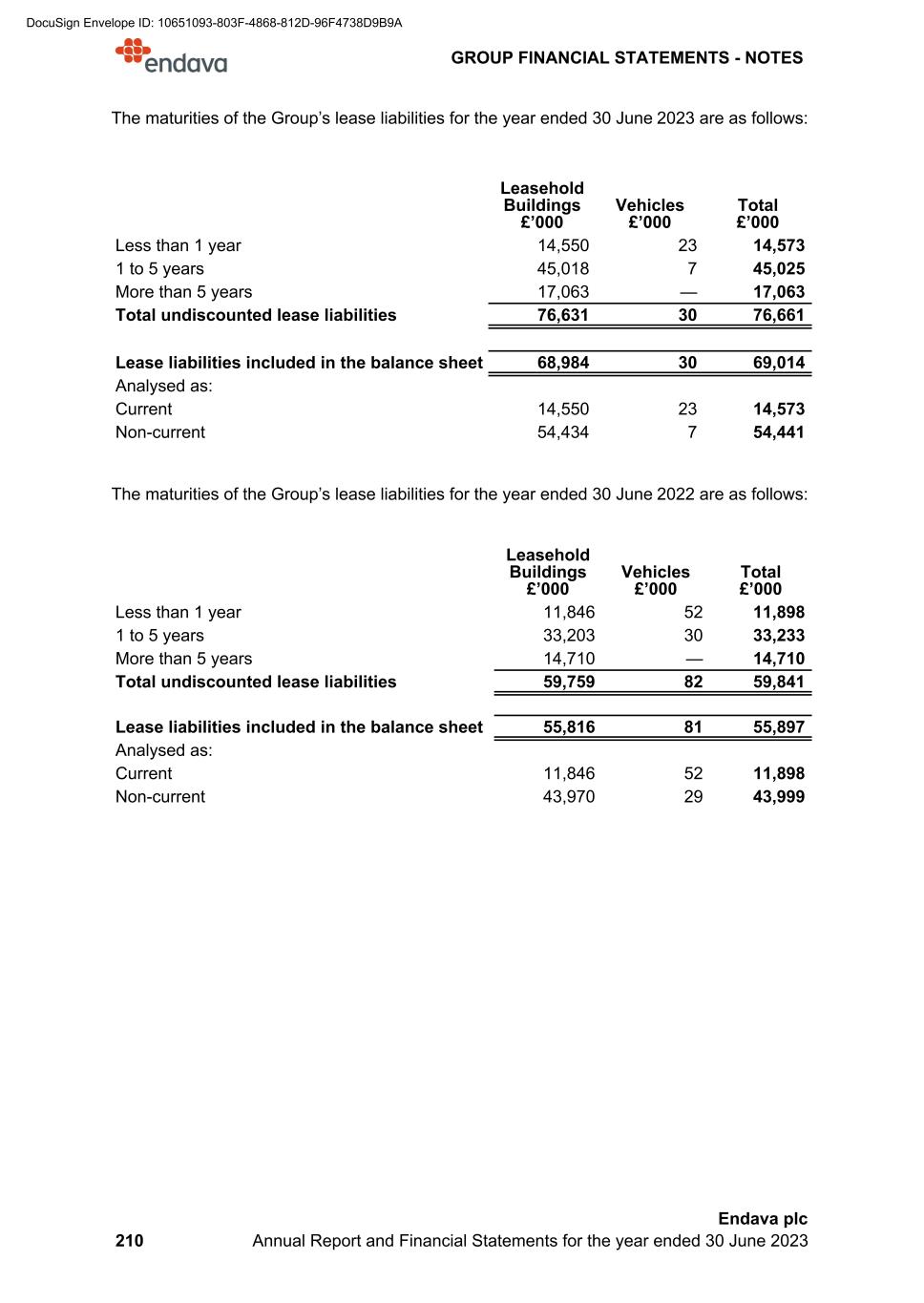
The maturities of the Group’s lease liabilities for the year ended 30 June 2023 are as follows: Leasehold Buildings £’000 Vehicles £’000 Total £’000 Less than 1 year 14,550 23 14,573 1 to 5 years 45,018 7 45,025 More than 5 years 17,063 — 17,063 Total undiscounted lease liabilities 76,631 30 76,661 Lease liabilities included in the balance sheet 68,984 30 69,014 Analysed as: Current 14,550 23 14,573 Non-current 54,434 7 54,441 The maturities of the Group’s lease liabilities for the year ended 30 June 2022 are as follows: Leasehold Buildings £’000 Vehicles £’000 Total £’000 Less than 1 year 11,846 52 11,898 1 to 5 years 33,203 30 33,233 More than 5 years 14,710 — 14,710 Total undiscounted lease liabilities 59,759 82 59,841 Lease liabilities included in the balance sheet 55,816 81 55,897 Analysed as: Current 11,846 52 11,898 Non-current 43,970 29 43,999 GROUP FINANCIAL STATEMENTS - NOTES 210 Endava plc Annual Report and Financial Statements for the year ended 30 June 2023 DocuSign Envelope ID: 10651093-803F-4868-812D-96F4738D9B9A
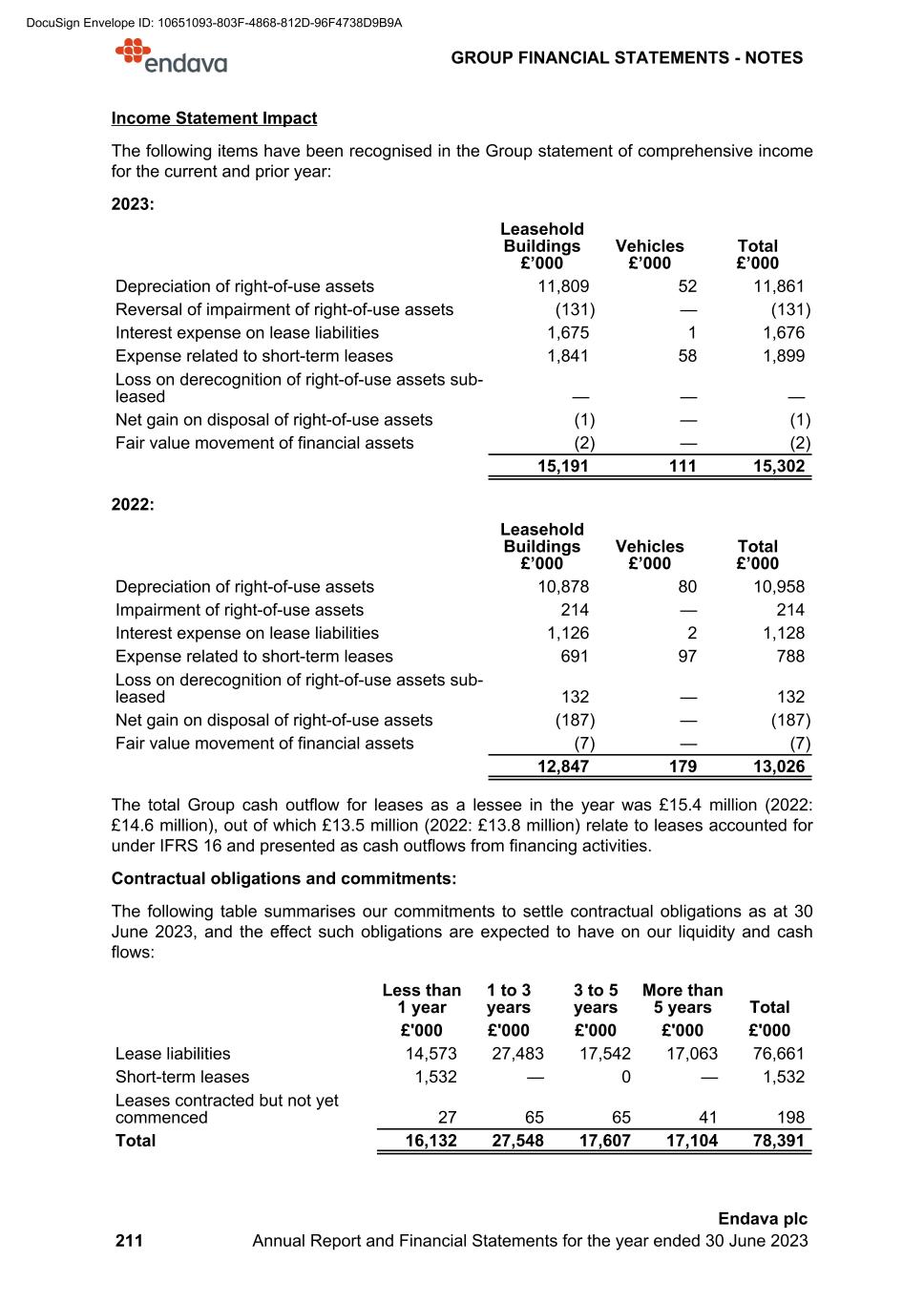
Income Statement Impact The following items have been recognised in the Group statement of comprehensive income for the current and prior year: 2023: Leasehold Buildings £’000 Vehicles £’000 Total £’000 Depreciation of right-of-use assets 11,809 52 11,861 Reversal of impairment of right-of-use assets (131) — (131) Interest expense on lease liabilities 1,675 1 1,676 Expense related to short-term leases 1,841 58 1,899 Loss on derecognition of right-of-use assets sub- leased — — — Net gain on disposal of right-of-use assets (1) — (1) Fair value movement of financial assets (2) — (2) 15,191 111 15,302 2022: Leasehold Buildings £’000 Vehicles £’000 Total £’000 Depreciation of right-of-use assets 10,878 80 10,958 Impairment of right-of-use assets 214 — 214 Interest expense on lease liabilities 1,126 2 1,128 Expense related to short-term leases 691 97 788 Loss on derecognition of right-of-use assets sub- leased 132 — 132 Net gain on disposal of right-of-use assets (187) — (187) Fair value movement of financial assets (7) — (7) 12,847 179 13,026 The total Group cash outflow for leases as a lessee in the year was £15.4 million (2022: £14.6 million), out of which £13.5 million (2022: £13.8 million) relate to leases accounted for under IFRS 16 and presented as cash outflows from financing activities. Contractual obligations and commitments: The following table summarises our commitments to settle contractual obligations as at 30 June 2023, and the effect such obligations are expected to have on our liquidity and cash flows: Less than 1 year 1 to 3 years 3 to 5 years More than 5 years Total £'000 £'000 £'000 £'000 £'000 Lease liabilities 14,573 27,483 17,542 17,063 76,661 Short-term leases 1,532 — 0 — 1,532 Leases contracted but not yet commenced 27 65 65 41 198 Total 16,132 27,548 17,607 17,104 78,391 GROUP FINANCIAL STATEMENTS - NOTES 211 Endava plc Annual Report and Financial Statements for the year ended 30 June 2023 DocuSign Envelope ID: 10651093-803F-4868-812D-96F4738D9B9A
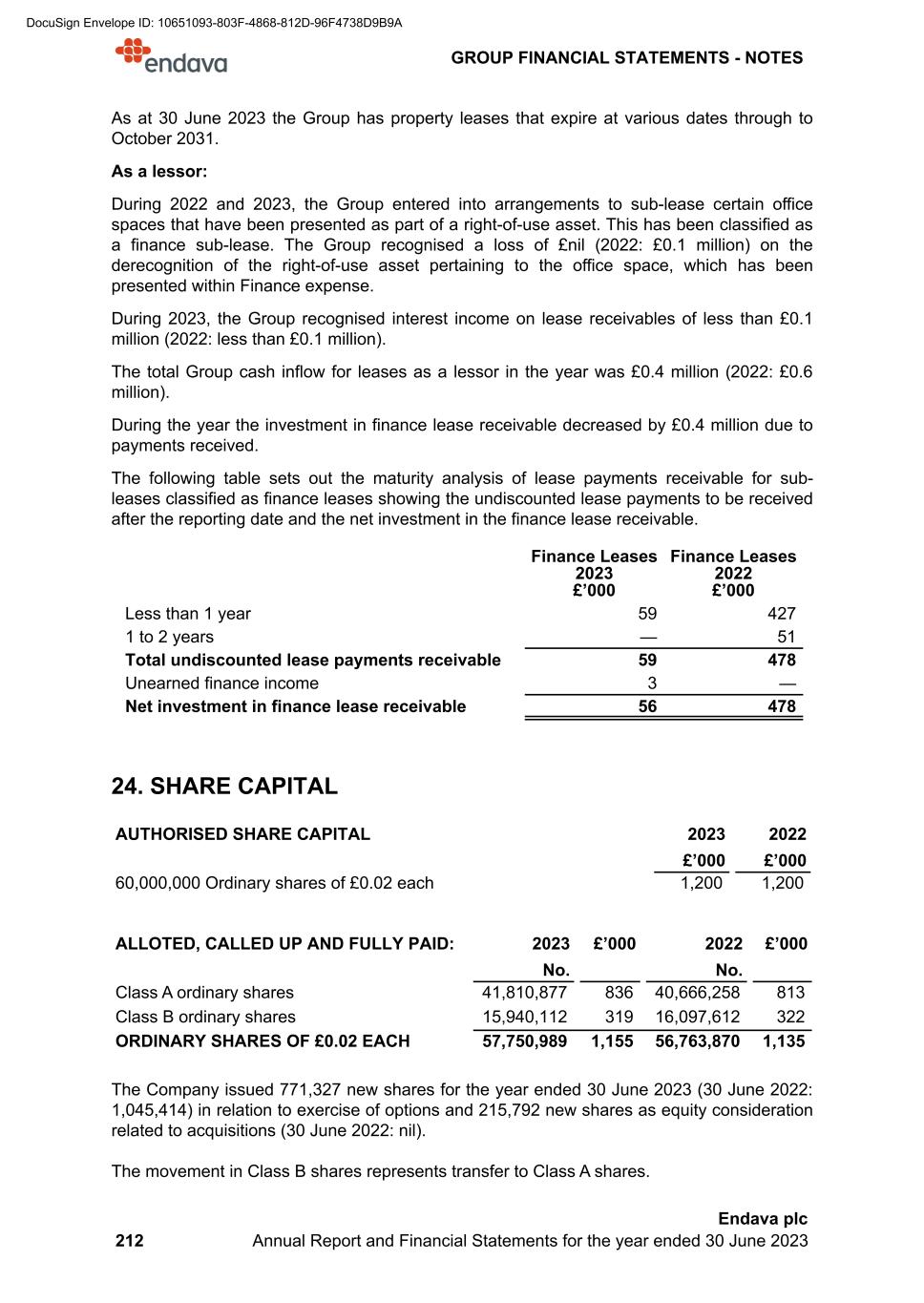
As at 30 June 2023 the Group has property leases that expire at various dates through to October 2031. As a lessor: During 2022 and 2023, the Group entered into arrangements to sub-lease certain office spaces that have been presented as part of a right-of-use asset. This has been classified as a finance sub-lease. The Group recognised a loss of £nil (2022: £0.1 million) on the derecognition of the right-of-use asset pertaining to the office space, which has been presented within Finance expense. During 2023, the Group recognised interest income on lease receivables of less than £0.1 million (2022: less than £0.1 million). The total Group cash inflow for leases as a lessor in the year was £0.4 million (2022: £0.6 million). During the year the investment in finance lease receivable decreased by £0.4 million due to payments received. The following table sets out the maturity analysis of lease payments receivable for sub- leases classified as finance leases showing the undiscounted lease payments to be received after the reporting date and the net investment in the finance lease receivable. Finance Leases 2023 £’000 Finance Leases 2022 £’000 Less than 1 year 59 427 1 to 2 years — 51 Total undiscounted lease payments receivable 59 478 Unearned finance income 3 — Net investment in finance lease receivable 56 478 24. SHARE CAPITAL AUTHORISED SHARE CAPITAL 2023 2022 £’000 £’000 60,000,000 Ordinary shares of £0.02 each 1,200 1,200 ALLOTED, CALLED UP AND FULLY PAID: 2023 £’000 2022 £’000 No. No. Class A ordinary shares 41,810,877 836 40,666,258 813 Class B ordinary shares 15,940,112 319 16,097,612 322 ORDINARY SHARES OF £0.02 EACH 57,750,989 1,155 56,763,870 1,135 The Company issued 771,327 new shares for the year ended 30 June 2023 (30 June 2022: 1,045,414) in relation to exercise of options and 215,792 new shares as equity consideration related to acquisitions (30 June 2022: nil). The movement in Class B shares represents transfer to Class A shares. GROUP FINANCIAL STATEMENTS - NOTES 212 Endava plc Annual Report and Financial Statements for the year ended 30 June 2023 DocuSign Envelope ID: 10651093-803F-4868-812D-96F4738D9B9A

Voting rights, dividends and return of capital Our Class B ordinary shares have ten votes per share, and our Class A ordinary shares, which are the shares underlying the ADSs, each have one vote per share. Any dividend declared by the Company shall be paid on Class A ordinary shares and the Class B ordinary shares pari passu as if they were all shares of the same class. In the event of the liquidation, dissolution or winding up of the Company, the assets of the Company available for distribution to members shall be distributed amongst all holders of Class A ordinary shares and Class B ordinary shares in proportion to the number of shares held irrespective of the amount paid or credited as paid on any share. Restrictions Class B ordinary shares During the period of one hundred and eighty (180) days commencing on the IPO, no transfers of Class B ordinary shares were permitted other than to a person who is a permitted Class B ordinary transferee or pursuant to the IPO (which for the avoidance of doubt includes sales pursuant to any secondary offering or exercise of any over-allotment option in connection with the IPO). No transfers of Class B ordinary shares shall be permitted (other than to a person who is a permitted Class B ordinary transferee): (a) in excess of 25% of the Class B ordinary shareholders holding of Class B ordinary shares (determined as at the IPO) in the period commencing 180 days after the IPO and ending on the date falling 18 months after the IPO; (b) in excess of 40% of the Class B ordinary shareholders holding of Class B ordinary shares (determined as at the IPO) in the period commencing 180 days after the IPO and ending on the date falling on the third anniversary of the IPO; and (c) in excess of 60% of the Class B ordinary shareholders holding of Class B ordinary shares (determined as at the IPO) in the period commencing 180 days after the IPO and ending on the fifth anniversary of the IPO. Following the fifth anniversary of the IPO, a Class B ordinary shareholder may elect, at any time, to convert any of its Class B ordinary shares into Class A ordinary shares on a one-for- one basis by notice in writing to the Directors. 25. DISTRIBUTIONS MADE During the year ended 30 June 2023, the Company did not declare and pay any dividends (2022: £nil). GROUP FINANCIAL STATEMENTS - NOTES 213 Endava plc Annual Report and Financial Statements for the year ended 30 June 2023 DocuSign Envelope ID: 10651093-803F-4868-812D-96F4738D9B9A

26. SHARE-BASED PAYMENTS Description of share-based payment arrangements The Group had the following share-based payment arrangements. Company Share Option Plan A Company Share Option Plan (“CSOP”) was adopted on 7 May 2014 and share options over ordinary shares have been issued under the CSOP plan to certain employees of the Group. Options can be exercised on the fifth anniversary of the date of grant, upon an acquisition of the Company, and upon certain conditions of ceasing employment. In addition, our Board has discretion to permit the exercise of options upon the admission of shares to a recognised stock exchange or at an earlier time and under such conditions as determined by the Board. The options expire on the tenth anniversary of the date of grant. Joint Share Ownership Plan Certain of the Group’s employees have entered into a Joint Share Ownership Plan (“JSOP”) with the EBT, through which the participants have a right to receive any increase in the value of shares above a threshold amount (i) upon a sale of the Company, (ii) following a listing on a recognised stock exchange, when the participant gives a specific notice to the EBT trustee and the Company in respect of the JSOP Shares; (iii) upon the expiry of 25 years from the date of the applicable trust deed; or (iv) upon the participant leaving employment with the Group when the market value of the JSOP Shares is less than the threshold amount. The events referenced in clauses (i)-(iv) above are collectively referred as “Trigger Events.” On the date of a Trigger Event, the EBT trustee has an option to acquire the beneficial interest belonging to the participant. If the EBT trustee exercises this option, the EBT trustee will then either transfer shares of a value equal to, or pay cash to the participant in an amount equal to, the value of the option, calculated according to the terms of the JSOP. If the applicable employee leaves employment with the Group prior to the occurrence of a Trigger Event, the value of the shares is capped at such shares’ fair market value on the employee’s last day of employment and no payment is made until a Trigger Event occurs. The Group does not have a present obligation to settle in cash and has no history of cash settling options. Therefore, the settlement of the transactions will be accounted for in accordance with the requirements applying to equity-settled share-based compensation transactions, as set forth in IFRS 2. On and from the date of any Trigger Event, and if and for so long as the EBT trustee has not exercised the option referred to above, the EBT trustee will use reasonable endeavours to sell the JSOP Shares and distribute the net proceeds of sale between the EBT trustee and the participant in the proportions calculated according to the terms of the JSOP. The Trigger event - the listing on the New York Stock Exchange - happened on 27 July 2018. At 30 June 2023, the EBT held 13,226 shares (30 June 2022: 74,610), out of which 6,965 (30 June 2022: 34,075) are allocated to employee JSOPs. For the year ended 30 June 2023, (27,110) awards under the JSOP were exercised (2022: nil) and settled by shares of the EBT, no JSOPs were cancelled (2022: nil) and 9,000 options under LTIP were exercised (2022: nil) and settled by shares of the EBT and 25,274 options under SAYE were exercised (2022: nil) and settled by shares of the EBT. GROUP FINANCIAL STATEMENTS - NOTES 214 Endava plc Annual Report and Financial Statements for the year ended 30 June 2023 DocuSign Envelope ID: 10651093-803F-4868-812D-96F4738D9B9A

The JSOPs expire 25 years following the applicable date of issue. Long term Incentive Plan A Company Long Term Incentive Plan (“LTIP”) was adopted on 30 June 2015 under which options or conditional shares are intended to be awarded to certain employees of the Group. Under the LTIP, options or conditional shares can generally be banked over a five-year period subject to the achievement of annual Group performance targets. Once banked, the options become eligible to vest, with vesting occurring over a three-year period following a triggering event, which includes listing on a recognised stock exchange, a sale of the outstanding share capital of the Company or a sale of the assets of the business. The options and conditional shares expire on the earliest of the tenth anniversary of award or five years from the date of vesting. 2018 Equity Incentive Plan On 16 April 2018, the Board adopted the 2018 Equity Incentive Plan (“EIP”) and approved by the Company shareholders on 3 May 2018. The EIP allows for the grant of equity-based incentive awards to our employees and directors, who are also our employees. The EIP provides for the grant of options, share appreciation rights, or SARs, restricted shares, restricted share units, or RSUs, performance restricted share units, or PSUs, and other share-based awards. All awards under the EIP are set forth in award agreements, which detail the terms and conditions of awards, including any applicable vesting and payment terms, change of control provisions and post-termination exercise limitations. The EIP is administered by the board, which may delegate its duties and responsibilities to one or more committees of our directors and/or officers (referred to as the plan administrator below), subject to certain limitations imposed under the EIP, and other applicable laws and stock exchange rules. The plan administrator has the authority to take all actions and make all determinations under the EIP, to interpret the EIP and award agreements and to adopt, amend and repeal rules for the administration of the EIP as it deems advisable. The plan administrator also has the authority to determine which eligible service providers receive awards, grant awards, set the terms and conditions of all awards under the EIP, including any vesting and vesting acceleration provisions, subject to the conditions and limitations in the EIP. The plan administrator may select performance criteria for an award to establish performance goals for a performance period. In connection with certain corporate transactions and events affecting our ordinary shares, including a change of control, another similar corporate transaction or event, another unusual or nonrecurring transaction or event affecting us or our financial statements or a change in any applicable laws or accounting principles, the plan administrator has broad discretion to take action under the EIP to prevent the dilution or enlargement of intended benefits, facilitate the transaction or event or give effect to the change in applicable laws or accounting principles. In the event of a change of control where the successor or acquirer entity does not agree to assume, continue or rollover the awards, the awards will vest in full effective immediately prior to the change of control. GROUP FINANCIAL STATEMENTS - NOTES 215 Endava plc Annual Report and Financial Statements for the year ended 30 June 2023 DocuSign Envelope ID: 10651093-803F-4868-812D-96F4738D9B9A
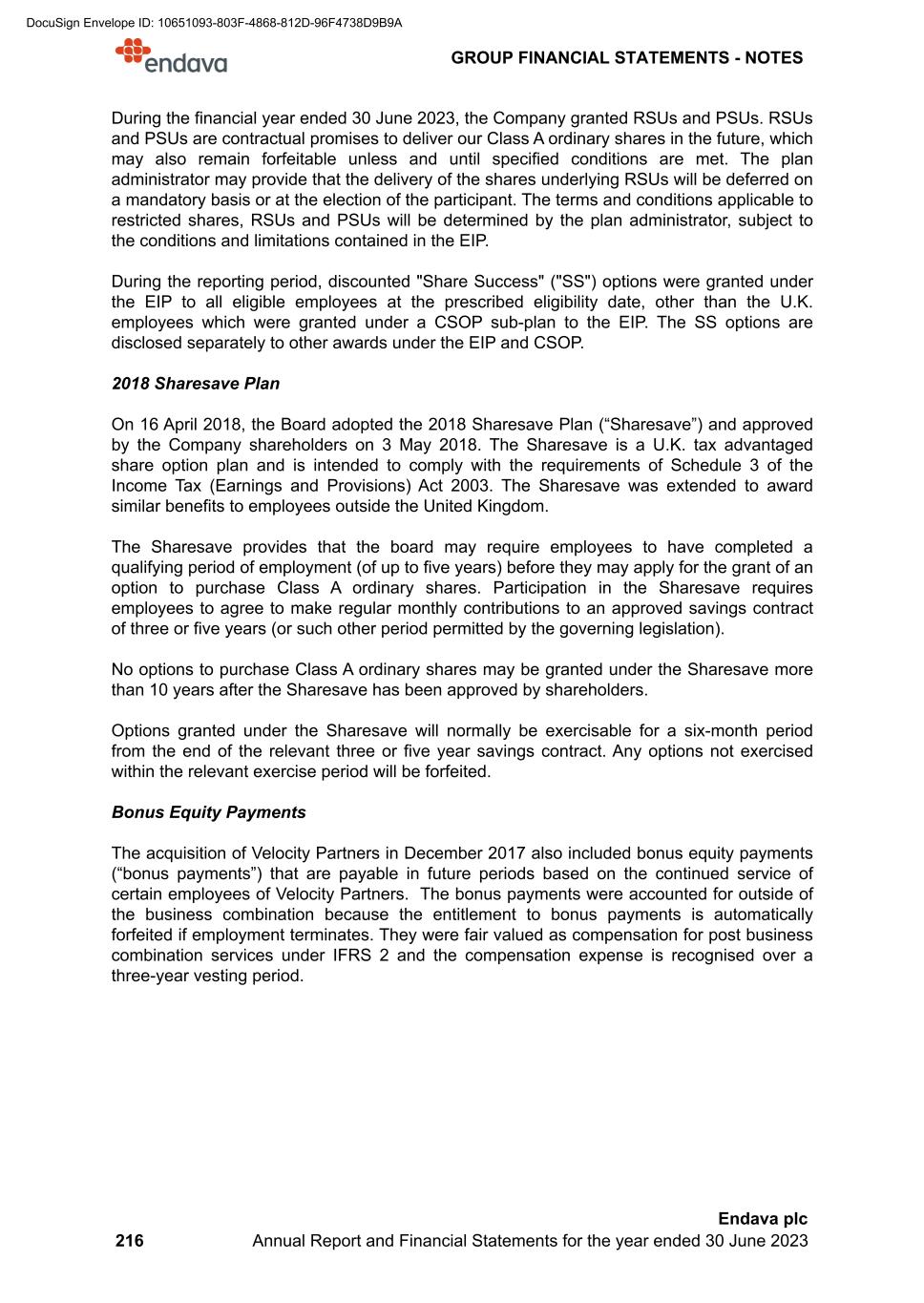
During the financial year ended 30 June 2023, the Company granted RSUs and PSUs. RSUs and PSUs are contractual promises to deliver our Class A ordinary shares in the future, which may also remain forfeitable unless and until specified conditions are met. The plan administrator may provide that the delivery of the shares underlying RSUs will be deferred on a mandatory basis or at the election of the participant. The terms and conditions applicable to restricted shares, RSUs and PSUs will be determined by the plan administrator, subject to the conditions and limitations contained in the EIP. During the reporting period, discounted "Share Success" ("SS") options were granted under the EIP to all eligible employees at the prescribed eligibility date, other than the U.K. employees which were granted under a CSOP sub-plan to the EIP. The SS options are disclosed separately to other awards under the EIP and CSOP. 2018 Sharesave Plan On 16 April 2018, the Board adopted the 2018 Sharesave Plan (“Sharesave”) and approved by the Company shareholders on 3 May 2018. The Sharesave is a U.K. tax advantaged share option plan and is intended to comply with the requirements of Schedule 3 of the Income Tax (Earnings and Provisions) Act 2003. The Sharesave was extended to award similar benefits to employees outside the United Kingdom. The Sharesave provides that the board may require employees to have completed a qualifying period of employment (of up to five years) before they may apply for the grant of an option to purchase Class A ordinary shares. Participation in the Sharesave requires employees to agree to make regular monthly contributions to an approved savings contract of three or five years (or such other period permitted by the governing legislation). No options to purchase Class A ordinary shares may be granted under the Sharesave more than 10 years after the Sharesave has been approved by shareholders. Options granted under the Sharesave will normally be exercisable for a six-month period from the end of the relevant three or five year savings contract. Any options not exercised within the relevant exercise period will be forfeited. Bonus Equity Payments The acquisition of Velocity Partners in December 2017 also included bonus equity payments (“bonus payments”) that are payable in future periods based on the continued service of certain employees of Velocity Partners. The bonus payments were accounted for outside of the business combination because the entitlement to bonus payments is automatically forfeited if employment terminates. They were fair valued as compensation for post business combination services under IFRS 2 and the compensation expense is recognised over a three-year vesting period. GROUP FINANCIAL STATEMENTS - NOTES 216 Endava plc Annual Report and Financial Statements for the year ended 30 June 2023 DocuSign Envelope ID: 10651093-803F-4868-812D-96F4738D9B9A

Movements during the year The number and the weighted-average exercise prices of the share options under the above arrangements were as follows: CSOP JSOP LTIP EIP SAYE SS Bonus Payments Options outstanding at 1 July 2022 5,845 34,075 96,324 1,158,575 598,614 445,491 — Options granted during the year — — — 536,814 — 1,212,215 — Options exercised during the year — (27,110) (64,312) (522,661) (217,684) — — Options forfeited during the year — — (3,000) (267,903) (35,085) (191,735) — Options outstanding at 30 June 2023 5,845 6,965 29,012 904,825 345,845 1,465,971 — Options outstanding at 1 July 2021 5,845 34,075 203,326 1,406,877 1,119,953 — — Options granted during the year — — — 300,940 — 504,443 — Options exercised during the year — — (107,002) (467,888) (470,757) — — Options forfeited during the year — — — (81,354) (50,582) (58,952) — Options outstanding at 30 June 2022 5,845 34,075 96,324 1,158,575 598,614 445,491 — Weighted average exercise price 30 June 2023 - £ 0.90 — — — 39.78 64.55 — Weighted average exercise price 30 June 2022 - £ 0.90 — — — 35.70 102.41 — Weighted average share price at exercise date 2023 - £ — 61.90 57.41 57.55 58.25 — — Weighted average share price at exercise date 2022 - £ — — 117.25 130.10 111.89 — — Weighted average contractual life 2023 - years 1 13 2 2 1 6 — Weighted average contractual life 2022 - years 2 14 3 2 1 6 — GROUP FINANCIAL STATEMENTS - NOTES 217 Endava plc Annual Report and Financial Statements for the year ended 30 June 2023 DocuSign Envelope ID: 10651093-803F-4868-812D-96F4738D9B9A
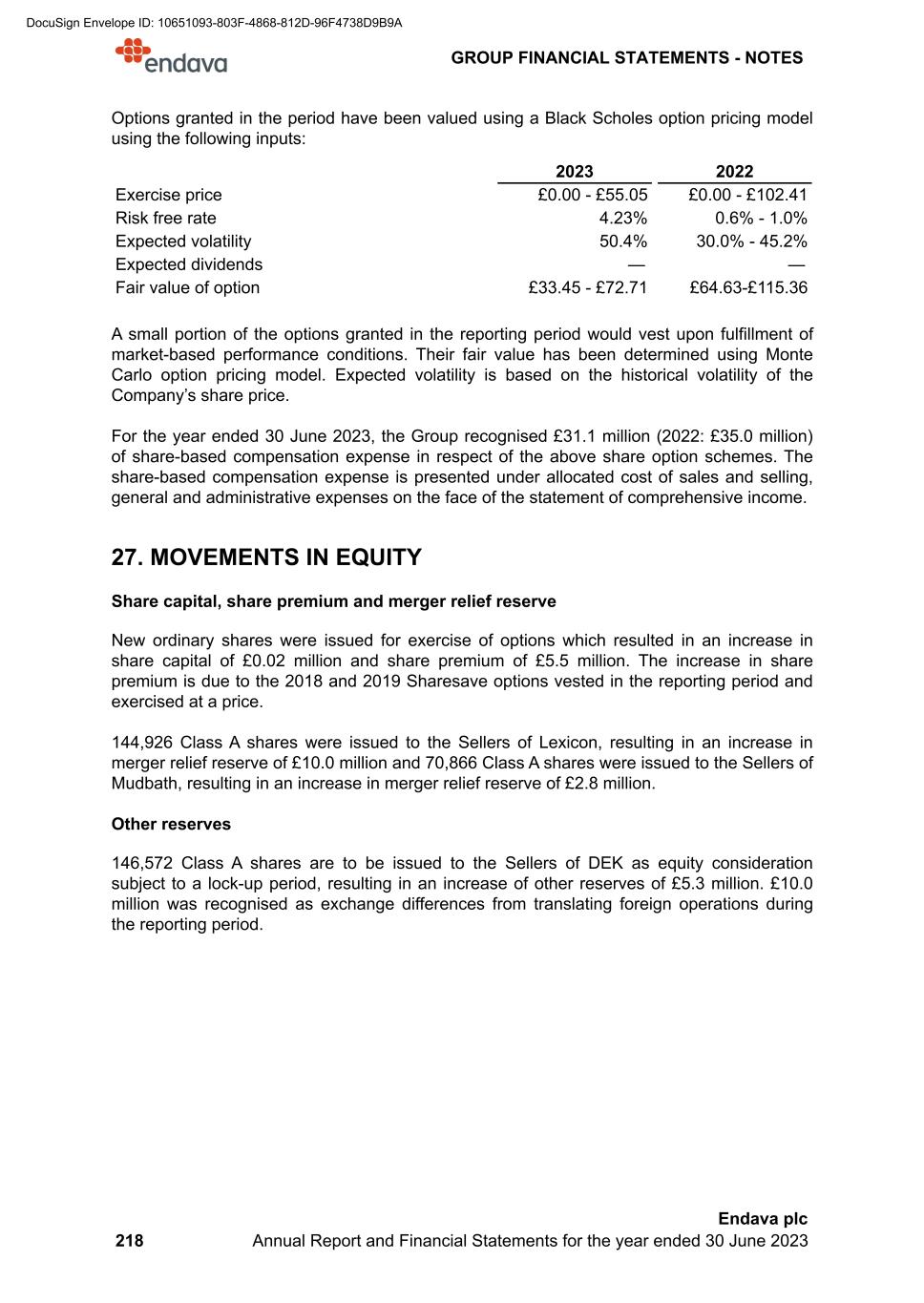
Options granted in the period have been valued using a Black Scholes option pricing model using the following inputs: 2023 2022 Exercise price £0.00 - £55.05 £0.00 - £102.41 Risk free rate 4.23% 0.6% - 1.0% Expected volatility 50.4% 30.0% - 45.2% Expected dividends — — Fair value of option £33.45 - £72.71 £64.63-£115.36 A small portion of the options granted in the reporting period would vest upon fulfillment of market-based performance conditions. Their fair value has been determined using Monte Carlo option pricing model. Expected volatility is based on the historical volatility of the Company’s share price. For the year ended 30 June 2023, the Group recognised £31.1 million (2022: £35.0 million) of share-based compensation expense in respect of the above share option schemes. The share-based compensation expense is presented under allocated cost of sales and selling, general and administrative expenses on the face of the statement of comprehensive income. 27. MOVEMENTS IN EQUITY Share capital, share premium and merger relief reserve New ordinary shares were issued for exercise of options which resulted in an increase in share capital of £0.02 million and share premium of £5.5 million. The increase in share premium is due to the 2018 and 2019 Sharesave options vested in the reporting period and exercised at a price. 144,926 Class A shares were issued to the Sellers of Lexicon, resulting in an increase in merger relief reserve of £10.0 million and 70,866 Class A shares were issued to the Sellers of Mudbath, resulting in an increase in merger relief reserve of £2.8 million. Other reserves 146,572 Class A shares are to be issued to the Sellers of DEK as equity consideration subject to a lock-up period, resulting in an increase of other reserves of £5.3 million. £10.0 million was recognised as exchange differences from translating foreign operations during the reporting period. GROUP FINANCIAL STATEMENTS - NOTES 218 Endava plc Annual Report and Financial Statements for the year ended 30 June 2023 DocuSign Envelope ID: 10651093-803F-4868-812D-96F4738D9B9A
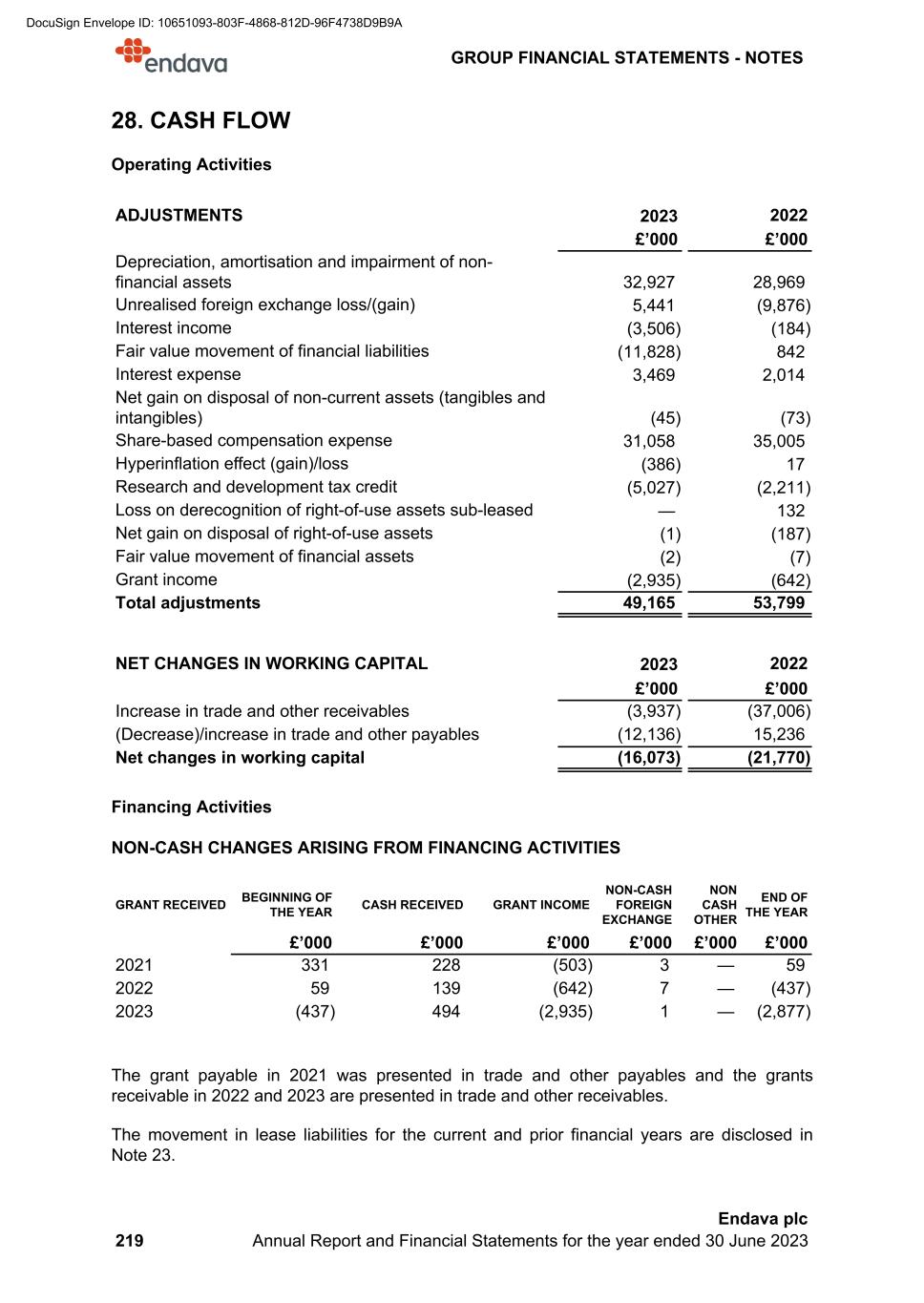
28. CASH FLOW Operating Activities ADJUSTMENTS 2023 2022 £’000 £’000 Depreciation, amortisation and impairment of non- financial assets 32,927 28,969 Unrealised foreign exchange loss/(gain) 5,441 (9,876) Interest income (3,506) (184) Fair value movement of financial liabilities (11,828) 842 Interest expense 3,469 2,014 Net gain on disposal of non-current assets (tangibles and intangibles) (45) (73) Share-based compensation expense 31,058 35,005 Hyperinflation effect (gain)/loss (386) 17 Research and development tax credit (5,027) (2,211) Loss on derecognition of right-of-use assets sub-leased — 132 Net gain on disposal of right-of-use assets (1) (187) Fair value movement of financial assets (2) (7) Grant income (2,935) (642) Total adjustments 49,165 53,799 NET CHANGES IN WORKING CAPITAL 2023 2022 £’000 £’000 Increase in trade and other receivables (3,937) (37,006) (Decrease)/increase in trade and other payables (12,136) 15,236 Net changes in working capital (16,073) (21,770) Financing Activities NON-CASH CHANGES ARISING FROM FINANCING ACTIVITIES GRANT RECEIVED BEGINNING OF THE YEAR CASH RECEIVED GRANT INCOME NON-CASH FOREIGN EXCHANGE NON CASH OTHER END OF THE YEAR £’000 £’000 £’000 £’000 £’000 £’000 2021 331 228 (503) 3 — 59 2022 59 139 (642) 7 — (437) 2023 (437) 494 (2,935) 1 — (2,877) The grant payable in 2021 was presented in trade and other payables and the grants receivable in 2022 and 2023 are presented in trade and other receivables. The movement in lease liabilities for the current and prior financial years are disclosed in Note 23. GROUP FINANCIAL STATEMENTS - NOTES 219 Endava plc Annual Report and Financial Statements for the year ended 30 June 2023 DocuSign Envelope ID: 10651093-803F-4868-812D-96F4738D9B9A
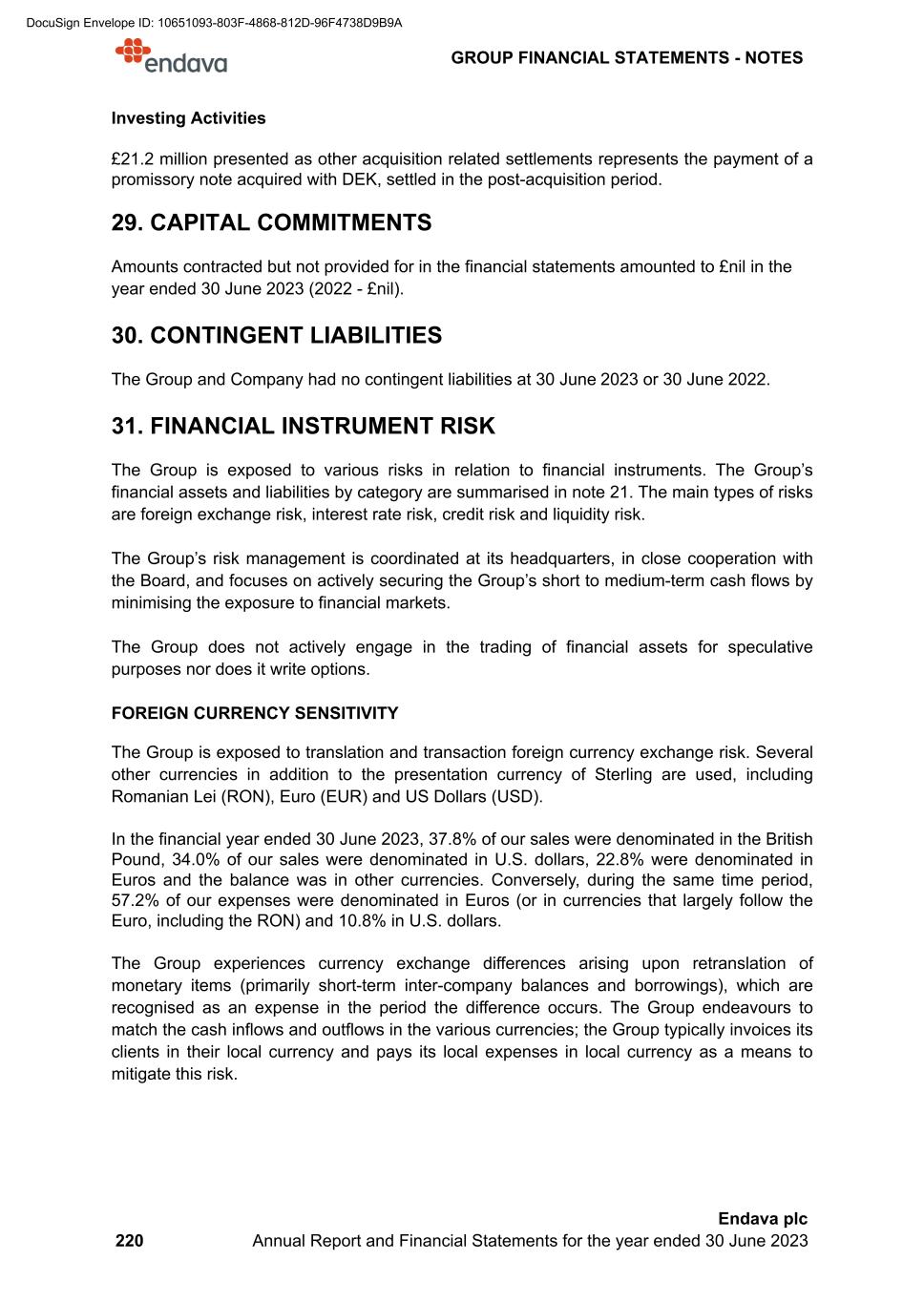
Investing Activities £21.2 million presented as other acquisition related settlements represents the payment of a promissory note acquired with DEK, settled in the post-acquisition period. 29. CAPITAL COMMITMENTS Amounts contracted but not provided for in the financial statements amounted to £nil in the year ended 30 June 2023 (2022 - £nil). 30. CONTINGENT LIABILITIES The Group and Company had no contingent liabilities at 30 June 2023 or 30 June 2022. 31. FINANCIAL INSTRUMENT RISK The Group is exposed to various risks in relation to financial instruments. The Group’s financial assets and liabilities by category are summarised in note 21. The main types of risks are foreign exchange risk, interest rate risk, credit risk and liquidity risk. The Group’s risk management is coordinated at its headquarters, in close cooperation with the Board, and focuses on actively securing the Group’s short to medium-term cash flows by minimising the exposure to financial markets. The Group does not actively engage in the trading of financial assets for speculative purposes nor does it write options. FOREIGN CURRENCY SENSITIVITY The Group is exposed to translation and transaction foreign currency exchange risk. Several other currencies in addition to the presentation currency of Sterling are used, including Romanian Lei (RON), Euro (EUR) and US Dollars (USD). In the financial year ended 30 June 2023, 37.8% of our sales were denominated in the British Pound, 34.0% of our sales were denominated in U.S. dollars, 22.8% were denominated in Euros and the balance was in other currencies. Conversely, during the same time period, 57.2% of our expenses were denominated in Euros (or in currencies that largely follow the Euro, including the RON) and 10.8% in U.S. dollars. The Group experiences currency exchange differences arising upon retranslation of monetary items (primarily short-term inter-company balances and borrowings), which are recognised as an expense in the period the difference occurs. The Group endeavours to match the cash inflows and outflows in the various currencies; the Group typically invoices its clients in their local currency and pays its local expenses in local currency as a means to mitigate this risk. GROUP FINANCIAL STATEMENTS - NOTES 220 Endava plc Annual Report and Financial Statements for the year ended 30 June 2023 DocuSign Envelope ID: 10651093-803F-4868-812D-96F4738D9B9A
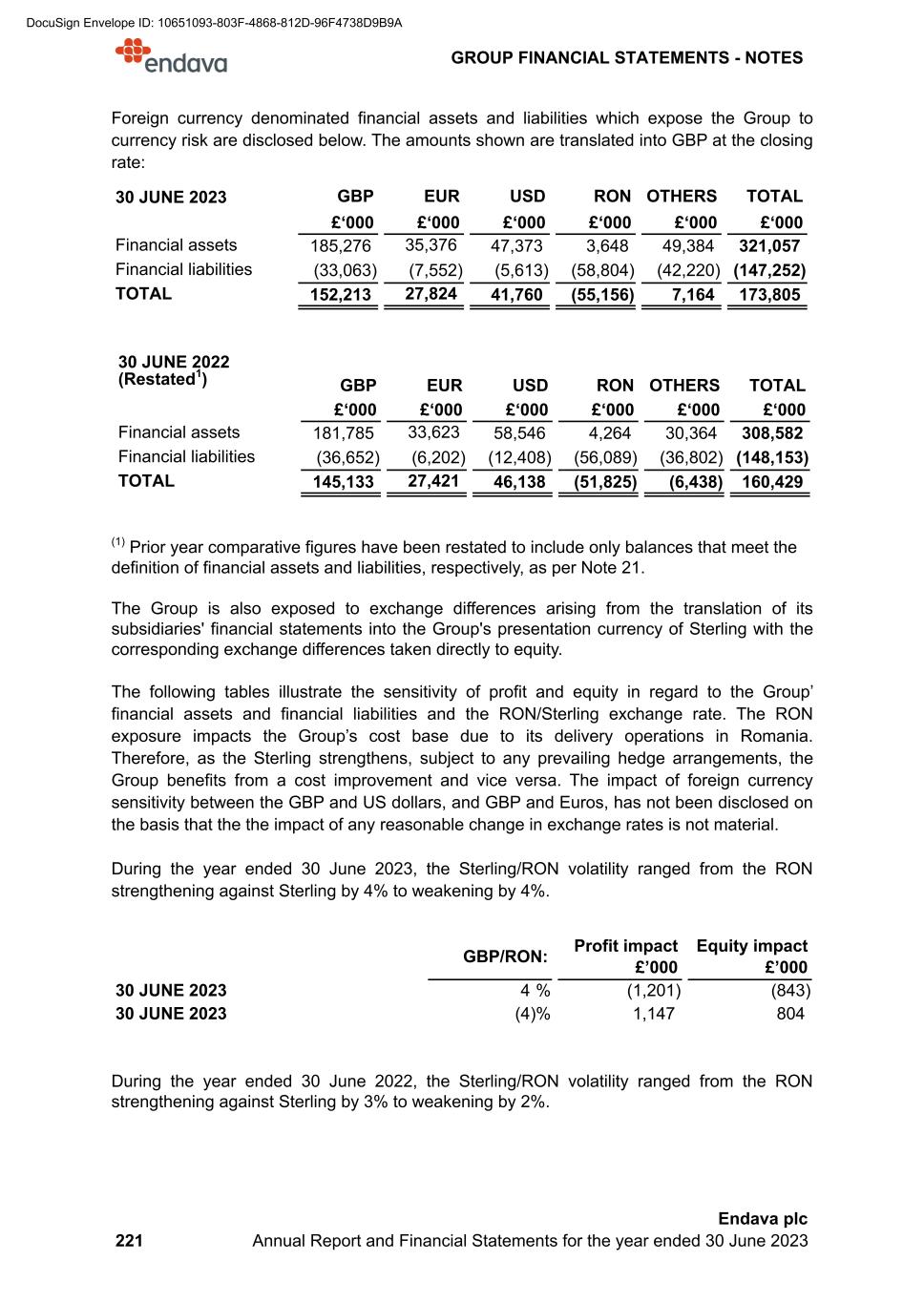
Foreign currency denominated financial assets and liabilities which expose the Group to currency risk are disclosed below. The amounts shown are translated into GBP at the closing rate: 30 JUNE 2023 GBP EUR USD RON OTHERS TOTAL £‘000 £‘000 £‘000 £‘000 £‘000 £‘000 Financial assets 185,276 35,376 47,373 3,648 49,384 321,057 Financial liabilities (33,063) (7,552) (5,613) (58,804) (42,220) (147,252) TOTAL 152,213 27,824 41,760 (55,156) 7,164 173,805 30 JUNE 2022 (Restated1) GBP EUR USD RON OTHERS TOTAL £‘000 £‘000 £‘000 £‘000 £‘000 £‘000 Financial assets 181,785 33,623 58,546 4,264 30,364 308,582 Financial liabilities (36,652) (6,202) (12,408) (56,089) (36,802) (148,153) TOTAL 145,133 27,421 46,138 (51,825) (6,438) 160,429 (1) Prior year comparative figures have been restated to include only balances that meet the definition of financial assets and liabilities, respectively, as per Note 21. The Group is also exposed to exchange differences arising from the translation of its subsidiaries' financial statements into the Group's presentation currency of Sterling with the corresponding exchange differences taken directly to equity. The following tables illustrate the sensitivity of profit and equity in regard to the Group’ financial assets and financial liabilities and the RON/Sterling exchange rate. The RON exposure impacts the Group’s cost base due to its delivery operations in Romania. Therefore, as the Sterling strengthens, subject to any prevailing hedge arrangements, the Group benefits from a cost improvement and vice versa. The impact of foreign currency sensitivity between the GBP and US dollars, and GBP and Euros, has not been disclosed on the basis that the the impact of any reasonable change in exchange rates is not material. During the year ended 30 June 2023, the Sterling/RON volatility ranged from the RON strengthening against Sterling by 4% to weakening by 4%. GBP/RON: Profit impact £’000 Equity impact £’000 30 JUNE 2023 4 % (1,201) (843) 30 JUNE 2023 (4) % 1,147 804 During the year ended 30 June 2022, the Sterling/RON volatility ranged from the RON strengthening against Sterling by 3% to weakening by 2%. GROUP FINANCIAL STATEMENTS - NOTES 221 Endava plc Annual Report and Financial Statements for the year ended 30 June 2023 DocuSign Envelope ID: 10651093-803F-4868-812D-96F4738D9B9A

GBP/RON: Profit impact £’000 Equity impact £’000 30 JUNE 2022 3 % (693) (672) 30 JUNE 2022 (2) % 536 519 INTEREST RATE SENSITIVITY At 30 June 2023, the Group is not exposed to changes in market interest rates through bank borrowings on its revolving credit facility at variable interest rates, as the facility is not drawn. CREDIT RISK ANALYSIS Credit risk is the risk that a counterparty fails to discharge an obligation to the Group. The Group is exposed to this risk for various financial instruments, including trade receivables. The Group’s maximum exposure to credit risk is limited to the carrying amount of financial assets recognised at 30 June, as summarised below: 2023 2022 (Restated1) £’000 £’000 Trade receivables 143,336 131,650 Accrued income 12,775 13,458 Other financial assets 243 668 Cash and cash equivalents 164,703 162,806 TOTAL 321,057 308,582 (1) Prior year comparative figures have been restated from £165,339k to £308,582k, to include only balances that meet the definition of financial assets, being trade receivables, accrued income, other financial assets and cash and cash equivalents. The Group monitors defaults of clients and other counterparties, identified either individually, or by group, and incorporates this information into its credit risk controls. Where available at reasonable cost, external credit ratings and/or reports on clients and other counterparties are obtained and used. In respect of trade and other receivables, the Group is not exposed to any significant credit risk exposure to any single counterparty or any group of counterparties having similar characteristics. The Group’s trade receivables are from a large number of clients in various industries and geographical areas. Based on historical information about client default rates, management consider the credit quality of trade receivables that are not past due or impaired to be good. The credit risk for cash and cash equivalents is considered negligible, since the counterparties are reputable banks with high quality external credit ratings. GROUP FINANCIAL STATEMENTS - NOTES 222 Endava plc Annual Report and Financial Statements for the year ended 30 June 2023 DocuSign Envelope ID: 10651093-803F-4868-812D-96F4738D9B9A
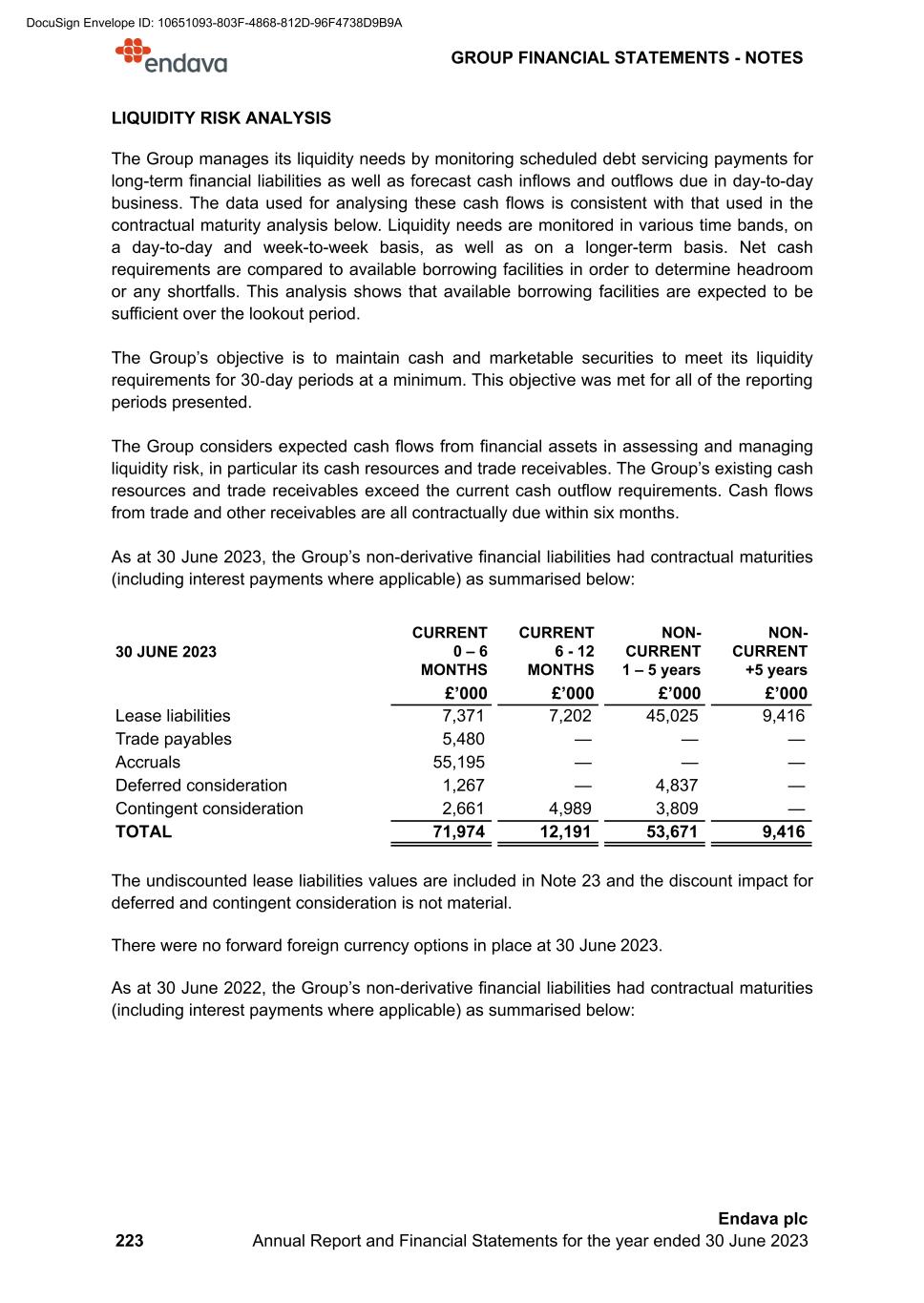
LIQUIDITY RISK ANALYSIS The Group manages its liquidity needs by monitoring scheduled debt servicing payments for long-term financial liabilities as well as forecast cash inflows and outflows due in day-to-day business. The data used for analysing these cash flows is consistent with that used in the contractual maturity analysis below. Liquidity needs are monitored in various time bands, on a day-to-day and week-to-week basis, as well as on a longer-term basis. Net cash requirements are compared to available borrowing facilities in order to determine headroom or any shortfalls. This analysis shows that available borrowing facilities are expected to be sufficient over the lookout period. The Group’s objective is to maintain cash and marketable securities to meet its liquidity requirements for 30-day periods at a minimum. This objective was met for all of the reporting periods presented. The Group considers expected cash flows from financial assets in assessing and managing liquidity risk, in particular its cash resources and trade receivables. The Group’s existing cash resources and trade receivables exceed the current cash outflow requirements. Cash flows from trade and other receivables are all contractually due within six months. As at 30 June 2023, the Group’s non-derivative financial liabilities had contractual maturities (including interest payments where applicable) as summarised below: 30 JUNE 2023 CURRENT 0 – 6 MONTHS CURRENT 6 - 12 MONTHS NON- CURRENT 1 – 5 years NON- CURRENT +5 years £’000 £’000 £’000 £’000 Lease liabilities 7,371 7,202 45,025 9,416 Trade payables 5,480 — — — Accruals 55,195 — — — Deferred consideration 1,267 — 4,837 — Contingent consideration 2,661 4,989 3,809 — TOTAL 71,974 12,191 53,671 9,416 The undiscounted lease liabilities values are included in Note 23 and the discount impact for deferred and contingent consideration is not material. There were no forward foreign currency options in place at 30 June 2023. As at 30 June 2022, the Group’s non-derivative financial liabilities had contractual maturities (including interest payments where applicable) as summarised below: GROUP FINANCIAL STATEMENTS - NOTES 223 Endava plc Annual Report and Financial Statements for the year ended 30 June 2023 DocuSign Envelope ID: 10651093-803F-4868-812D-96F4738D9B9A

30 JUNE 2022 (Restated1) CURRENT 0 – 6 MONTHS CURRENT 6 - 12 MONTHS NON- CURRENT 1 – 5 years NON- CURRENT +5 years £’000 £’000 £’000 £’000 Lease liabilities 6,200 5,698 33,233 10,766 Trade payables 8,214 — — — Accruals 63,862 — — — Deferred consideration 7,216 3,388 1,062 — Contingent consideration 2,958 1,225 4,331 — TOTAL 88,450 10,311 38,626 10,766 (1) Prior year comparative figures have been restated from £174,829k to £148,153k, to include only balances that meet the definition of financial liabilities, being lease liabilities, trade payables, accruals, deferred consideration and contingent consideration. The undiscounted lease liabilities values are included in Note 23 and the discount impact for deferred and contingent consideration is not material. There were no forward foreign currency options in place at 30 June 2022. 32. CAPITAL MANAGEMENT POLICIES AND PROCEDURES The Group’s capital management objectives are: ▪ to ensure the Group's ability to continue as a going concern; and ▪ to provide an adequate return to shareholders by pricing products and services commensurately with the level of risk. The Group monitors capital on the basis of the carrying amount of equity plus loan, less cash and cash equivalents as presented on the consolidated balance sheet. The Group manages its capital structure and makes adjustments in the light of changes in economic conditions and the risk characteristics of the underlying assets. 2023 2022 £’000 £’000 Equity 571,308 432,723 Loans and borrowings — — Less: Cash and cash equivalents (164,703) (162,806) TOTAL CAPITAL 406,605 269,917 GROUP FINANCIAL STATEMENTS - NOTES 224 Endava plc Annual Report and Financial Statements for the year ended 30 June 2023 DocuSign Envelope ID: 10651093-803F-4868-812D-96F4738D9B9A

33. SUBSEQUENT EVENTS In August 2023, we acquired TLM Partners Inc, together with its subsidiaries (“TLM”), a company that provides outsourced development services across design, engineering and art/ animation for PC and console video games and other digital entertainment. TLM has particular expertise in highly complex areas of cross-play, middleware, physics, engine-level tools and technical art. TLM brings a leadership team with decades of video game industry experience and deep relationships with a wide array of platform partners and with clients in the United States and around the world including prominent games publishers and developers. TLM, a Delaware company, has subsidiaries in Canada and Ireland and a branch in Romania. The acquisition was made pursuant to the terms of a share purchase agreement between Endava, Inc. and TLM Partners, Inc., dated 3 August 2023. The total consideration was £16.5 million and includes elements of cash, deferred and contingent consideration. Of the total consideration, £3.9 million was paid in cash at completion, which remains subject to post- closing adjustments on the cash, debt and working capital of TLM. In addition, £0.8 million of the purchase price will be held back for 24 months and be available to satisfy any warranty and indemnity claims and a mix of £11.8 million worth of cash and equity consideration is payable upon the fulfillment of certain earn-out conditions related to revenue and EBITDA of TLM during the earn-out period. The above values do not represent the fair values of the consideration elements transferred. Under the purchase agreement, there are other amounts of up to £14.9 million that are payable in future periods based on the continued service of certain employees. As these are based on continued service provided to the post- combination entity, they have been excluded from consideration and will instead be accounted for as ongoing remuneration under IFRS 2. Given the timing of the acquisition, the Company has not yet completed the purchase price allocation. GROUP FINANCIAL STATEMENTS - NOTES 225 Endava plc Annual Report and Financial Statements for the year ended 30 June 2023 DocuSign Envelope ID: 10651093-803F-4868-812D-96F4738D9B9A

COMPANY BALANCE SHEET Registered number 05722669 As at 30 June NOTE 2023 2022 £’000 £’000 ASSETS – NON CURRENT Investments 3 233,114 162,585 Deferred tax asset 4 9,258 61 Financial assets and other receivables 13 86,457 85,186 TOTAL 328,829 247,832 ASSETS - CURRENT Trade and other receivables 5 128,715 56,566 Corporation tax receivable 12 — 2,860 Cash and cash equivalents 2,086 5,584 TOTAL 130,801 65,010 TOTAL ASSETS 459,630 312,842 LIABILITIES – CURRENT Trade and other payables 6 84,246 24,112 Contingent consideration 7 7,268 2,959 Deferred consideration 7 1,267 175 TOTAL 92,781 27,246 LIABILITIES – NON-CURRENT Contingent consideration 7 3,809 4,331 Deferred consideration 7 4,837 1,062 TOTAL 8,646 5,393 EQUITY Share capital 9 1,155 1,135 Share premium 14,625 9,152 Merger relief reserve 42,805 30,003 Retained earnings1 292,615 238,247 Other reserves 6,842 1,505 Capital redemption reserve 161 161 TOTAL EQUITY 358,203 280,203 TOTAL LIABILITIES AND EQUITY 459,630 312,842 1. Under Section 408 of the Companies Act 2006 the Company is exempt from the requirement to present its own statement of comprehensive income. Endava plc reported a profit for the year ended 30 June 2023 of £22.2 million (2022: £3.7 million). The accompanying notes form an integral part of these financial statements. COMPANY FINANCIAL STATEMENTS 226 Endava plc Annual Report and Financial Statements for the year ended 30 June 2023 DocuSign Envelope ID: 10651093-803F-4868-812D-96F4738D9B9A

These financial statements were approved by the board and authorised for issue on 19 September 2023 and are signed on their behalf by: JE Cotterell, Director MS Thurston, Director COMPANY FINANCIAL STATEMENTS 227 Endava plc Annual Report and Financial Statements for the year ended 30 June 2023 DocuSign Envelope ID: 10651093-803F-4868-812D-96F4738D9B9A
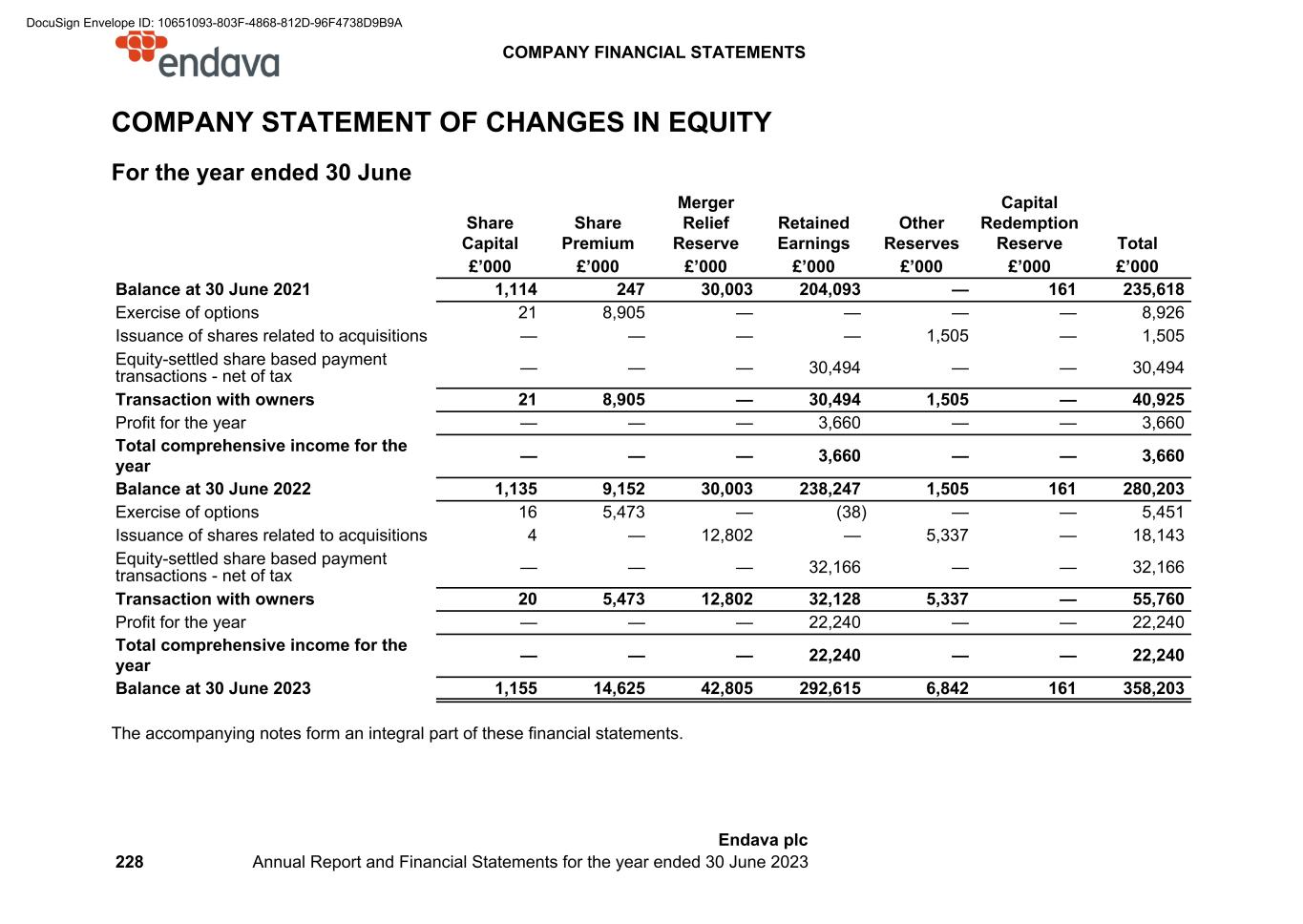
COMPANY STATEMENT OF CHANGES IN EQUITY For the year ended 30 June Share Capital Share Premium Merger Relief Reserve Retained Earnings Other Reserves Capital Redemption Reserve Total £’000 £’000 £’000 £’000 £’000 £’000 £’000 Balance at 30 June 2021 1,114 247 30,003 204,093 — 161 235,618 Exercise of options 21 8,905 — — — — 8,926 Issuance of shares related to acquisitions — — — — 1,505 — 1,505 Equity-settled share based payment transactions - net of tax — — — 30,494 — — 30,494 Transaction with owners 21 8,905 — 30,494 1,505 — 40,925 Profit for the year — — — 3,660 — — 3,660 Total comprehensive income for the year — — — 3,660 — — 3,660 Balance at 30 June 2022 1,135 9,152 30,003 238,247 1,505 161 280,203 Exercise of options 16 5,473 — (38) — — 5,451 Issuance of shares related to acquisitions 4 — 12,802 — 5,337 — 18,143 Equity-settled share based payment transactions - net of tax — — — 32,166 — — 32,166 Transaction with owners 20 5,473 12,802 32,128 5,337 — 55,760 Profit for the year — — — 22,240 — — 22,240 Total comprehensive income for the year — — — 22,240 — — 22,240 Balance at 30 June 2023 1,155 14,625 42,805 292,615 6,842 161 358,203 The accompanying notes form an integral part of these financial statements. COMPANY FINANCIAL STATEMENTS 228 Endava plc Annual Report and Financial Statements for the year ended 30 June 2023 DocuSign Envelope ID: 10651093-803F-4868-812D-96F4738D9B9A
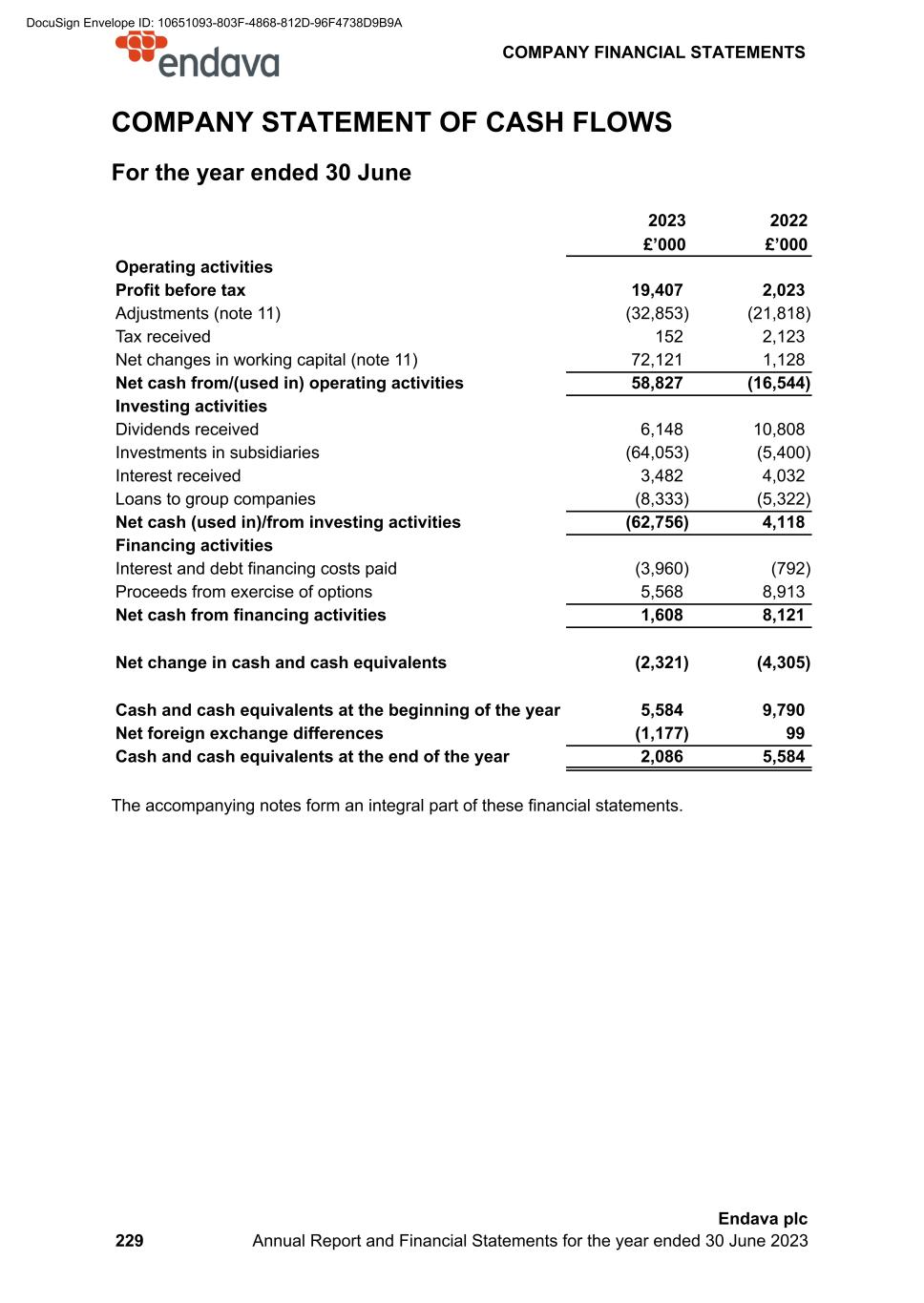
COMPANY STATEMENT OF CASH FLOWS For the year ended 30 June 2023 2022 £’000 £’000 Operating activities Profit before tax 19,407 2,023 Adjustments (note 11) (32,853) (21,818) Tax received 152 2,123 Net changes in working capital (note 11) 72,121 1,128 Net cash from/(used in) operating activities 58,827 (16,544) Investing activities Dividends received 6,148 10,808 Investments in subsidiaries (64,053) (5,400) Interest received 3,482 4,032 Loans to group companies (8,333) (5,322) Net cash (used in)/from investing activities (62,756) 4,118 Financing activities Interest and debt financing costs paid (3,960) (792) Proceeds from exercise of options 5,568 8,913 Net cash from financing activities 1,608 8,121 Net change in cash and cash equivalents (2,321) (4,305) Cash and cash equivalents at the beginning of the year 5,584 9,790 Net foreign exchange differences (1,177) 99 Cash and cash equivalents at the end of the year 2,086 5,584 The accompanying notes form an integral part of these financial statements. COMPANY FINANCIAL STATEMENTS 229 Endava plc Annual Report and Financial Statements for the year ended 30 June 2023 DocuSign Envelope ID: 10651093-803F-4868-812D-96F4738D9B9A
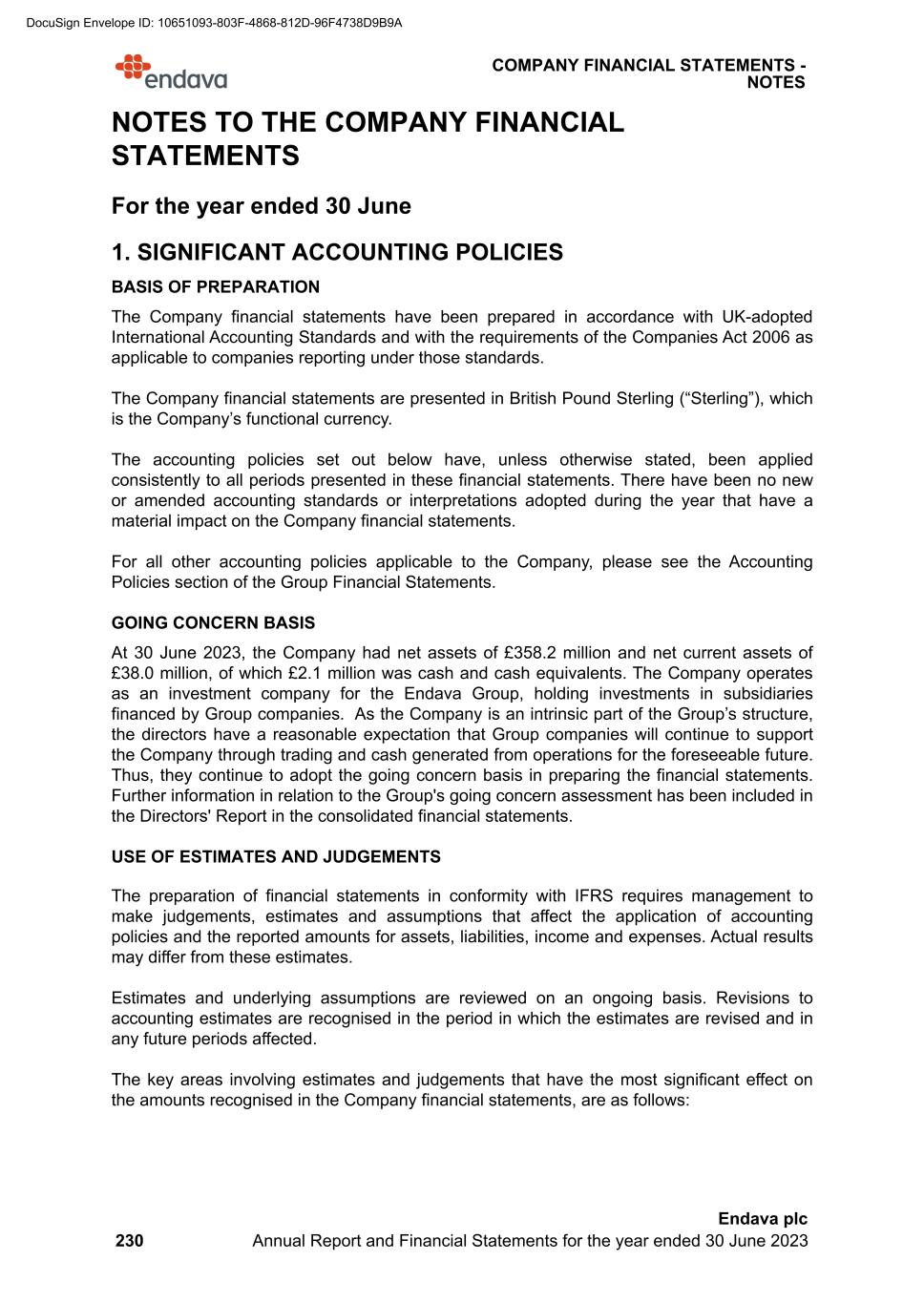
NOTES TO THE COMPANY FINANCIAL STATEMENTS For the year ended 30 June 1. SIGNIFICANT ACCOUNTING POLICIES BASIS OF PREPARATION The Company financial statements have been prepared in accordance with UK-adopted International Accounting Standards and with the requirements of the Companies Act 2006 as applicable to companies reporting under those standards. The Company financial statements are presented in British Pound Sterling (“Sterling”), which is the Company’s functional currency. The accounting policies set out below have, unless otherwise stated, been applied consistently to all periods presented in these financial statements. There have been no new or amended accounting standards or interpretations adopted during the year that have a material impact on the Company financial statements. For all other accounting policies applicable to the Company, please see the Accounting Policies section of the Group Financial Statements. GOING CONCERN BASIS At 30 June 2023, the Company had net assets of £358.2 million and net current assets of £38.0 million, of which £2.1 million was cash and cash equivalents. The Company operates as an investment company for the Endava Group, holding investments in subsidiaries financed by Group companies. As the Company is an intrinsic part of the Group’s structure, the directors have a reasonable expectation that Group companies will continue to support the Company through trading and cash generated from operations for the foreseeable future. Thus, they continue to adopt the going concern basis in preparing the financial statements. Further information in relation to the Group's going concern assessment has been included in the Directors' Report in the consolidated financial statements. USE OF ESTIMATES AND JUDGEMENTS The preparation of financial statements in conformity with IFRS requires management to make judgements, estimates and assumptions that affect the application of accounting policies and the reported amounts for assets, liabilities, income and expenses. Actual results may differ from these estimates. Estimates and underlying assumptions are reviewed on an ongoing basis. Revisions to accounting estimates are recognised in the period in which the estimates are revised and in any future periods affected. The key areas involving estimates and judgements that have the most significant effect on the amounts recognised in the Company financial statements, are as follows: COMPANY FINANCIAL STATEMENTS - NOTES 230 Endava plc Annual Report and Financial Statements for the year ended 30 June 2023 DocuSign Envelope ID: 10651093-803F-4868-812D-96F4738D9B9A
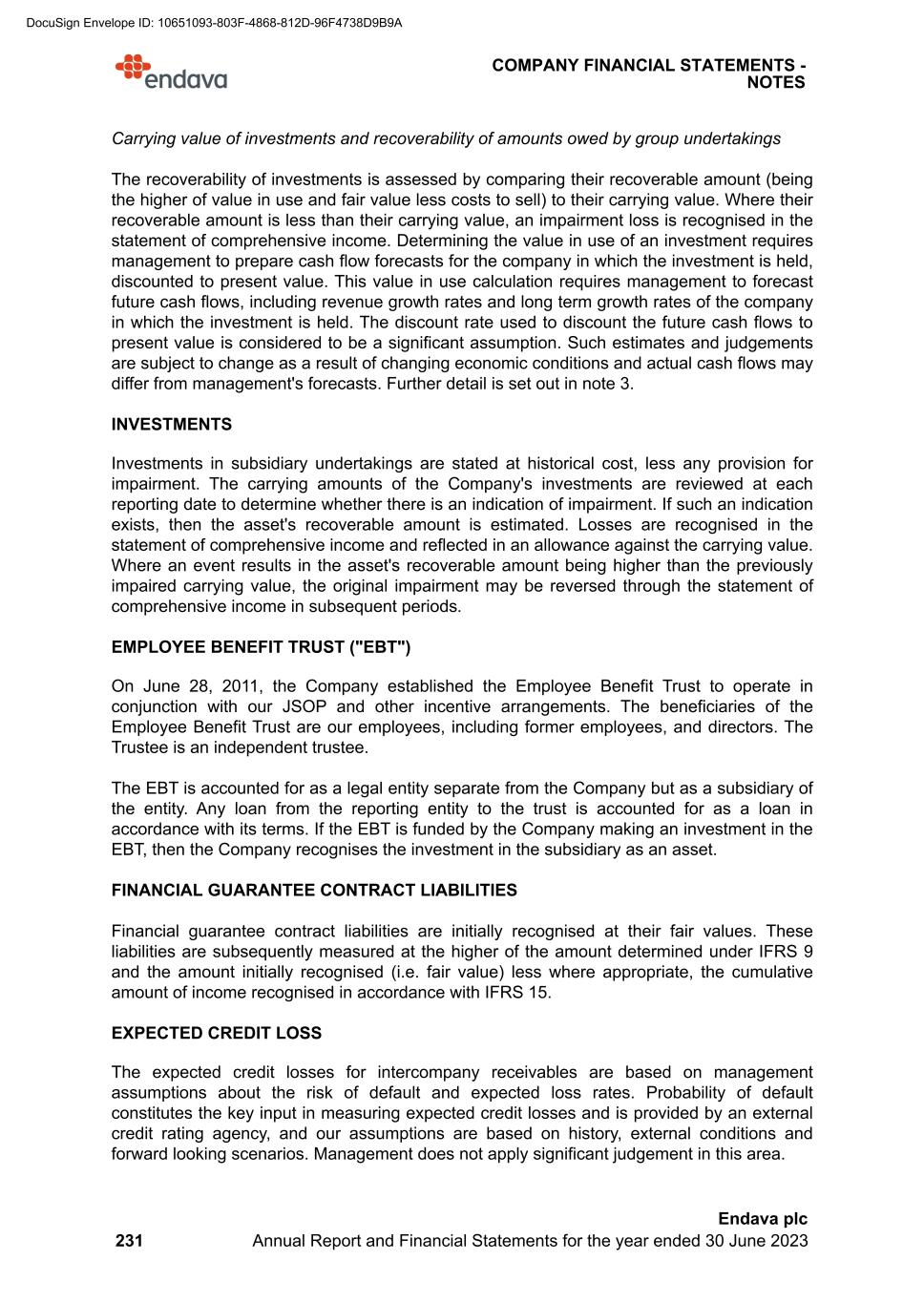
Carrying value of investments and recoverability of amounts owed by group undertakings The recoverability of investments is assessed by comparing their recoverable amount (being the higher of value in use and fair value less costs to sell) to their carrying value. Where their recoverable amount is less than their carrying value, an impairment loss is recognised in the statement of comprehensive income. Determining the value in use of an investment requires management to prepare cash flow forecasts for the company in which the investment is held, discounted to present value. This value in use calculation requires management to forecast future cash flows, including revenue growth rates and long term growth rates of the company in which the investment is held. The discount rate used to discount the future cash flows to present value is considered to be a significant assumption. Such estimates and judgements are subject to change as a result of changing economic conditions and actual cash flows may differ from management's forecasts. Further detail is set out in note 3. INVESTMENTS Investments in subsidiary undertakings are stated at historical cost, less any provision for impairment. The carrying amounts of the Company's investments are reviewed at each reporting date to determine whether there is an indication of impairment. If such an indication exists, then the asset's recoverable amount is estimated. Losses are recognised in the statement of comprehensive income and reflected in an allowance against the carrying value. Where an event results in the asset's recoverable amount being higher than the previously impaired carrying value, the original impairment may be reversed through the statement of comprehensive income in subsequent periods. EMPLOYEE BENEFIT TRUST ("EBT") On June 28, 2011, the Company established the Employee Benefit Trust to operate in conjunction with our JSOP and other incentive arrangements. The beneficiaries of the Employee Benefit Trust are our employees, including former employees, and directors. The Trustee is an independent trustee. The EBT is accounted for as a legal entity separate from the Company but as a subsidiary of the entity. Any loan from the reporting entity to the trust is accounted for as a loan in accordance with its terms. If the EBT is funded by the Company making an investment in the EBT, then the Company recognises the investment in the subsidiary as an asset. FINANCIAL GUARANTEE CONTRACT LIABILITIES Financial guarantee contract liabilities are initially recognised at their fair values. These liabilities are subsequently measured at the higher of the amount determined under IFRS 9 and the amount initially recognised (i.e. fair value) less where appropriate, the cumulative amount of income recognised in accordance with IFRS 15. EXPECTED CREDIT LOSS The expected credit losses for intercompany receivables are based on management assumptions about the risk of default and expected loss rates. Probability of default constitutes the key input in measuring expected credit losses and is provided by an external credit rating agency, and our assumptions are based on history, external conditions and forward looking scenarios. Management does not apply significant judgement in this area. COMPANY FINANCIAL STATEMENTS - NOTES 231 Endava plc Annual Report and Financial Statements for the year ended 30 June 2023 DocuSign Envelope ID: 10651093-803F-4868-812D-96F4738D9B9A

The expected credit losses for non-current intercompany loans is based on the assumption that they represent low credit risk loans based on external ratings agency data that is available for the Endava Group. The company therefore uses a 12-month expected credit loss approach. Our assumptions are based on history, external conditions and forward looking scenarios. Management does not apply significant judgement in this area. 2. STATEMENT OF COMPREHENSIVE INCOME Under Section 408 of the Companies Act 2006 the Company is exempt from the requirement to present its own statement of comprehensive income. Endava plc reported a profit for the year ended 30 June 2023 of £22.2 million (2022: £3.7 million). 3. INVESTMENTS COST AND NET BOOK VALUE £’000 At 1 July 2022 162,585 Additions 135,310 Transfers (49,294) Impairment (net of reversals) (15,487) At 30 June 2023 233,114 Additions during the year of £86.0 million comprises mainly of £37.5 million in relation to the acquisition of DEK, £15.1 million in relation to the acquisition of Mudbath, £1.5 million in relation to a capital increase in Endava Romania SRL, and £32.2 million in relation to share- based compensation for equity awards granted to participants employed by its subsidiaries. Additions also include £49.3 million in relation to the acquisition of Lexicon. The investment was transferred during the reporting period to another subsidiary within the Group at book value. The carrying amounts of the Company's investments in subsidiaries are reviewed at each reporting date to determine whether there is an indication of impairment. For the Company’s investments in subsidiaries, the main indicator of impairment is considered to be when the carrying amount of the investment is higher than the carrying amount of the subsidiary’s net assets. For the year ended 30 June 2023, where indications of impairment were identified, the relevant investments' recoverable amount was calculated, by calculating the value in use of the relevant subsidiary, in accordance with IAS 36 Impairment of Assets. The key assumptions for these calculations are revenue growth rate and discount rates. The growth rates used in the calculations are based on management’s expectations of the medium-term performance of the relevant businesses, planned growth market shares, industry forecasts and growth in the market. These calculations used five-year cash flow projections based on financial budgets approved by management and assumed a 1.5% terminal growth rate thereafter. COMPANY FINANCIAL STATEMENTS - NOTES 232 Endava plc Annual Report and Financial Statements for the year ended 30 June 2023 DocuSign Envelope ID: 10651093-803F-4868-812D-96F4738D9B9A
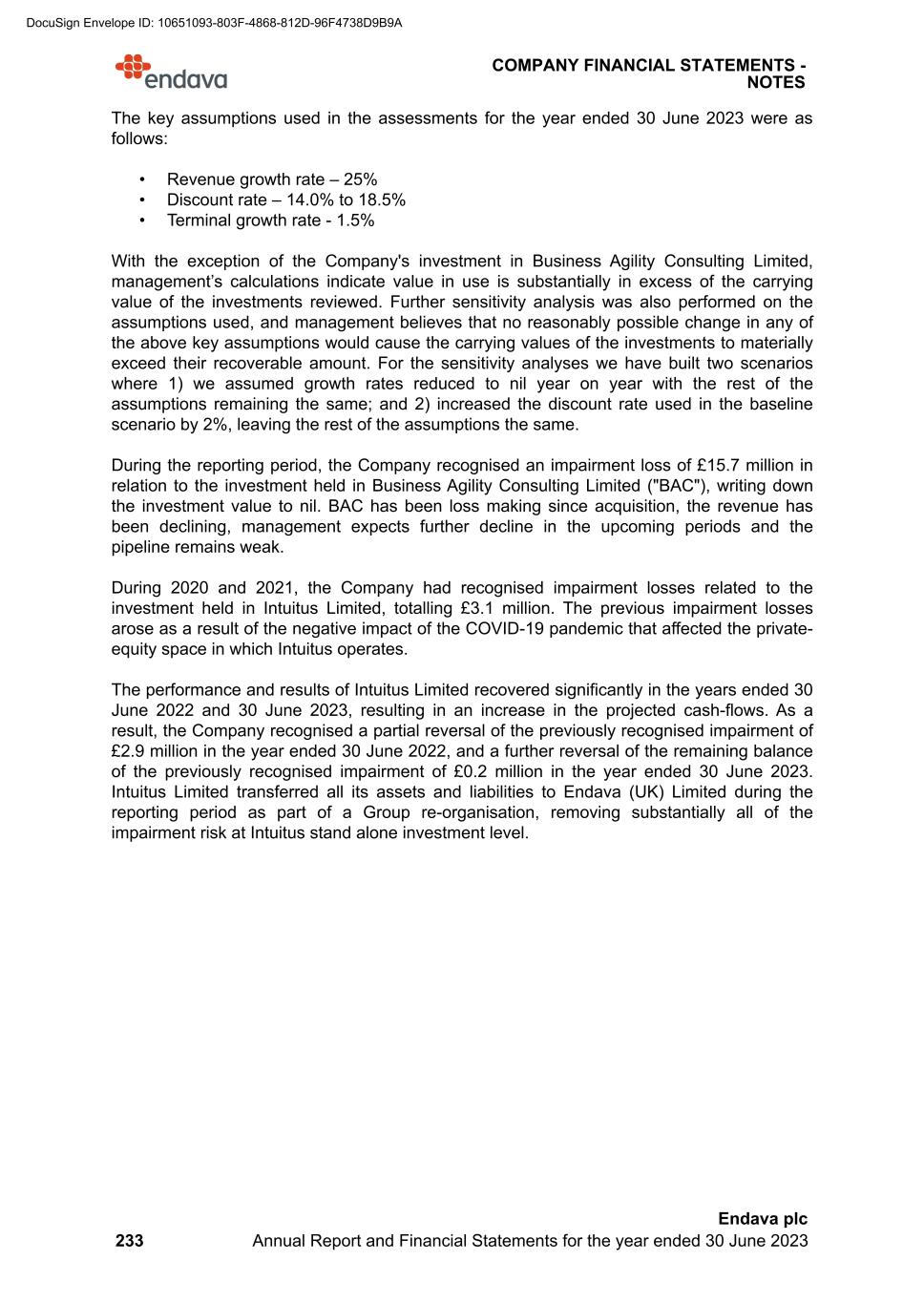
The key assumptions used in the assessments for the year ended 30 June 2023 were as follows: • Revenue growth rate – 25% • Discount rate – 14.0% to 18.5% • Terminal growth rate - 1.5% With the exception of the Company's investment in Business Agility Consulting Limited, management’s calculations indicate value in use is substantially in excess of the carrying value of the investments reviewed. Further sensitivity analysis was also performed on the assumptions used, and management believes that no reasonably possible change in any of the above key assumptions would cause the carrying values of the investments to materially exceed their recoverable amount. For the sensitivity analyses we have built two scenarios where 1) we assumed growth rates reduced to nil year on year with the rest of the assumptions remaining the same; and 2) increased the discount rate used in the baseline scenario by 2%, leaving the rest of the assumptions the same. During the reporting period, the Company recognised an impairment loss of £15.7 million in relation to the investment held in Business Agility Consulting Limited ("BAC"), writing down the investment value to nil. BAC has been loss making since acquisition, the revenue has been declining, management expects further decline in the upcoming periods and the pipeline remains weak. During 2020 and 2021, the Company had recognised impairment losses related to the investment held in Intuitus Limited, totalling £3.1 million. The previous impairment losses arose as a result of the negative impact of the COVID-19 pandemic that affected the private- equity space in which Intuitus operates. The performance and results of Intuitus Limited recovered significantly in the years ended 30 June 2022 and 30 June 2023, resulting in an increase in the projected cash-flows. As a result, the Company recognised a partial reversal of the previously recognised impairment of £2.9 million in the year ended 30 June 2022, and a further reversal of the remaining balance of the previously recognised impairment of £0.2 million in the year ended 30 June 2023. Intuitus Limited transferred all its assets and liabilities to Endava (UK) Limited during the reporting period as part of a Group re-organisation, removing substantially all of the impairment risk at Intuitus stand alone investment level. COMPANY FINANCIAL STATEMENTS - NOTES 233 Endava plc Annual Report and Financial Statements for the year ended 30 June 2023 DocuSign Envelope ID: 10651093-803F-4868-812D-96F4738D9B9A
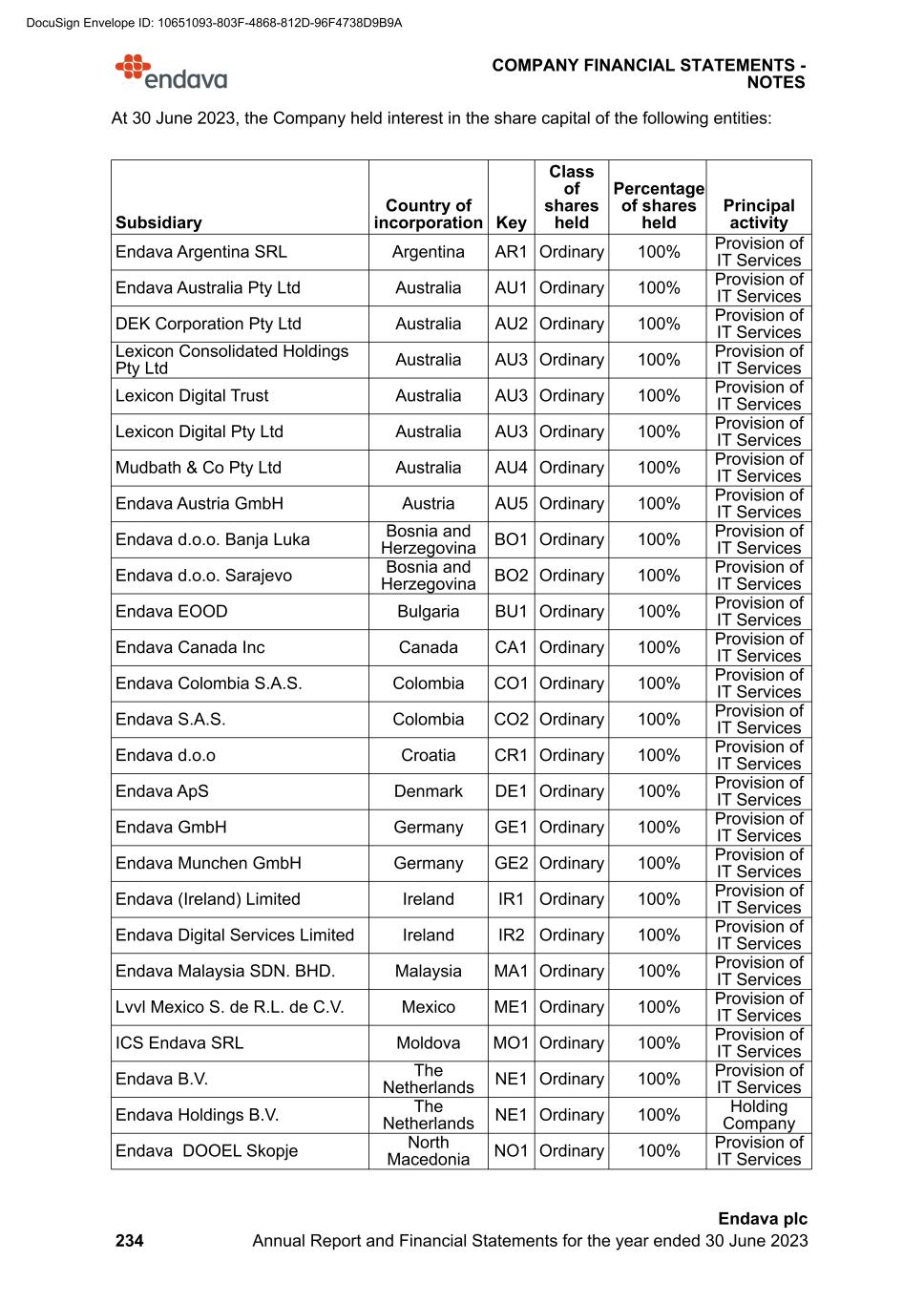
At 30 June 2023, the Company held interest in the share capital of the following entities: Subsidiary Country of incorporation Key Class of shares held Percentage of shares held Principal activity Endava Argentina SRL Argentina AR1 Ordinary 100% Provision of IT Services Endava Australia Pty Ltd Australia AU1 Ordinary 100% Provision of IT Services DEK Corporation Pty Ltd Australia AU2 Ordinary 100% Provision of IT Services Lexicon Consolidated Holdings Pty Ltd Australia AU3 Ordinary 100% Provision of IT Services Lexicon Digital Trust Australia AU3 Ordinary 100% Provision of IT Services Lexicon Digital Pty Ltd Australia AU3 Ordinary 100% Provision of IT Services Mudbath & Co Pty Ltd Australia AU4 Ordinary 100% Provision of IT Services Endava Austria GmbH Austria AU5 Ordinary 100% Provision of IT Services Endava d.o.o. Banja Luka Bosnia and Herzegovina BO1 Ordinary 100% Provision of IT Services Endava d.o.o. Sarajevo Bosnia and Herzegovina BO2 Ordinary 100% Provision of IT Services Endava EOOD Bulgaria BU1 Ordinary 100% Provision of IT Services Endava Canada Inc Canada CA1 Ordinary 100% Provision of IT Services Endava Colombia S.A.S. Colombia CO1 Ordinary 100% Provision of IT Services Endava S.A.S. Colombia CO2 Ordinary 100% Provision of IT Services Endava d.o.o Croatia CR1 Ordinary 100% Provision of IT Services Endava ApS Denmark DE1 Ordinary 100% Provision of IT Services Endava GmbH Germany GE1 Ordinary 100% Provision of IT Services Endava Munchen GmbH Germany GE2 Ordinary 100% Provision of IT Services Endava (Ireland) Limited Ireland IR1 Ordinary 100% Provision of IT Services Endava Digital Services Limited Ireland IR2 Ordinary 100% Provision of IT Services Endava Malaysia SDN. BHD. Malaysia MA1 Ordinary 100% Provision of IT Services Lvvl Mexico S. de R.L. de C.V. Mexico ME1 Ordinary 100% Provision of IT Services ICS Endava SRL Moldova MO1 Ordinary 100% Provision of IT Services Endava B.V. The Netherlands NE1 Ordinary 100% Provision of IT Services Endava Holdings B.V. The Netherlands NE1 Ordinary 100% Holding Company Endava DOOEL Skopje North Macedonia NO1 Ordinary 100% Provision of IT Services COMPANY FINANCIAL STATEMENTS - NOTES 234 Endava plc Annual Report and Financial Statements for the year ended 30 June 2023 DocuSign Envelope ID: 10651093-803F-4868-812D-96F4738D9B9A
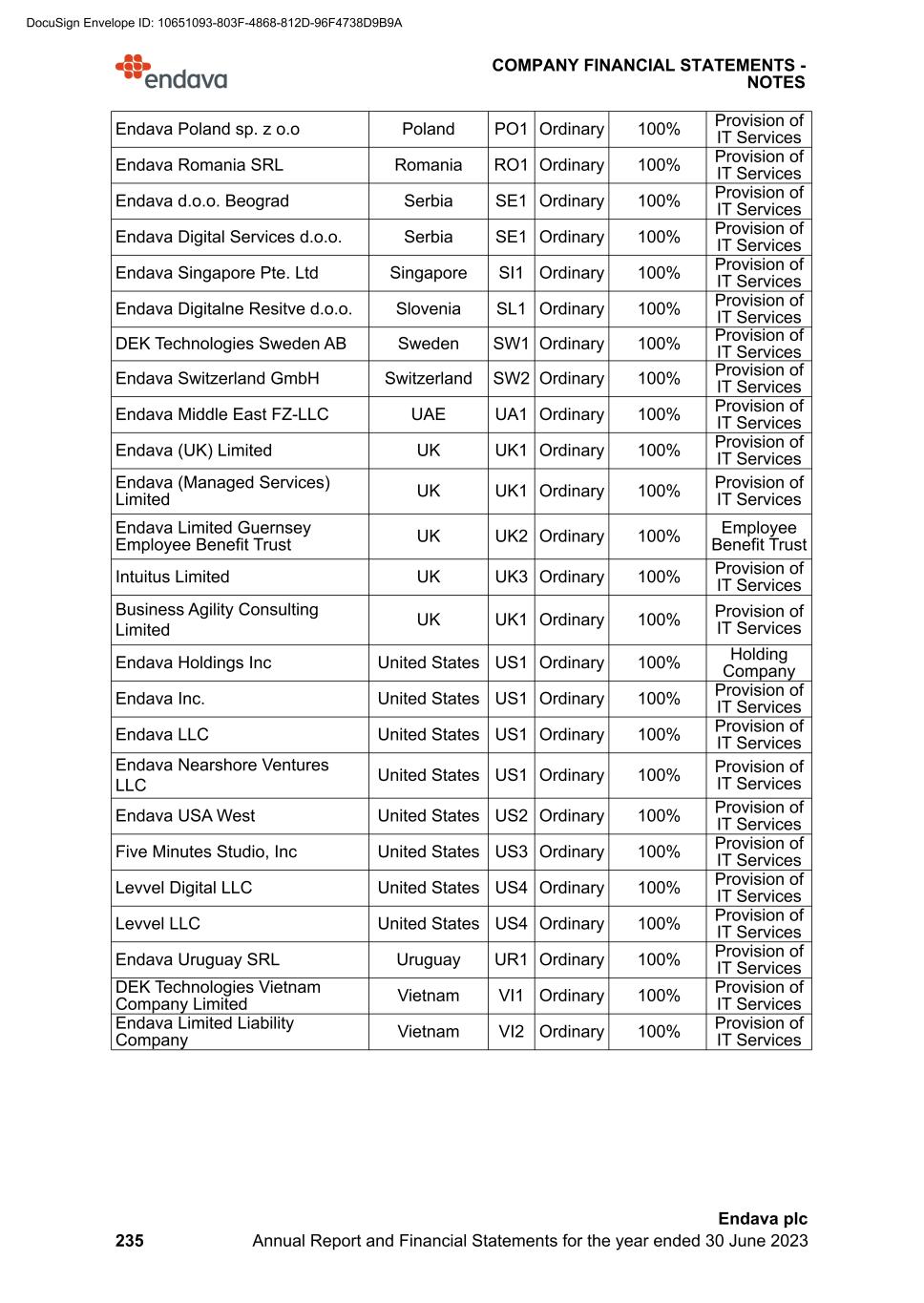
Endava Poland sp. z o.o Poland PO1 Ordinary 100% Provision of IT Services Endava Romania SRL Romania RO1 Ordinary 100% Provision of IT Services Endava d.o.o. Beograd Serbia SE1 Ordinary 100% Provision of IT Services Endava Digital Services d.o.o. Serbia SE1 Ordinary 100% Provision of IT Services Endava Singapore Pte. Ltd Singapore SI1 Ordinary 100% Provision of IT Services Endava Digitalne Resitve d.o.o. Slovenia SL1 Ordinary 100% Provision of IT Services DEK Technologies Sweden AB Sweden SW1 Ordinary 100% Provision of IT Services Endava Switzerland GmbH Switzerland SW2 Ordinary 100% Provision of IT Services Endava Middle East FZ-LLC UAE UA1 Ordinary 100% Provision of IT Services Endava (UK) Limited UK UK1 Ordinary 100% Provision of IT Services Endava (Managed Services) Limited UK UK1 Ordinary 100% Provision of IT Services Endava Limited Guernsey Employee Benefit Trust UK UK2 Ordinary 100% Employee Benefit Trust Intuitus Limited UK UK3 Ordinary 100% Provision of IT Services Business Agility Consulting Limited UK UK1 Ordinary 100% Provision of IT Services Endava Holdings Inc United States US1 Ordinary 100% Holding Company Endava Inc. United States US1 Ordinary 100% Provision of IT Services Endava LLC United States US1 Ordinary 100% Provision of IT Services Endava Nearshore Ventures LLC United States US1 Ordinary 100% Provision of IT Services Endava USA West United States US2 Ordinary 100% Provision of IT Services Five Minutes Studio, Inc United States US3 Ordinary 100% Provision of IT Services Levvel Digital LLC United States US4 Ordinary 100% Provision of IT Services Levvel LLC United States US4 Ordinary 100% Provision of IT Services Endava Uruguay SRL Uruguay UR1 Ordinary 100% Provision of IT Services DEK Technologies Vietnam Company Limited Vietnam VI1 Ordinary 100% Provision of IT Services Endava Limited Liability Company Vietnam VI2 Ordinary 100% Provision of IT Services COMPANY FINANCIAL STATEMENTS - NOTES 235 Endava plc Annual Report and Financial Statements for the year ended 30 June 2023 DocuSign Envelope ID: 10651093-803F-4868-812D-96F4738D9B9A

Key Registered Office Address AR1 Calle Urquiza 2284, Ciudat de Rosario 9, Provincia Santa Fe, Argentina AU1 Level 10, 455 Bourke Street Melbourne VIC 300, Australia AU2 Corner of Riggall Street and Maldon Street, Broadmeadows VIC 3047, Australia AU3 TOWER TWO, COLLINS SQUARE, LEVEL 36 727, COLLINS STREET DOCKLANDS VIC 3008, Australia AU4 Suite 8, 710 Hunter St, Newcastle NSW 2302, Australia AU5 Millennium Tower 23rd Floor, Handelskai 94-96, 1200 Vienna, Austria BO1 I Krajiškog korpusa no. 39, 78000 Banja Luka, Bosnia and Herzegovina BO2 Zmaja od Bosne 47C, Sarajevo - Novo Sarajevo, Bosnia and Herzegovina BU1 8 Racho Dimchеv Str., Sredetz Region, Sofia, 1000, Bulgaria CA1 675 Cochrane Drive, Unit 608 - East Tower Markham, ON L3R0B8, Canada CO1 Carrera 48 #18 A 14, Torre Fic 48, piso 19. El Poblado, Antioquia, Medellin, Colombia CO2 Calle 96 No. 10-38, Edificio BOX, Floors 7-8, 110221, Bogota D.C. Colombia CR1 Ulica Vjekoslava Heinzela 33, Zagreb, Croatia DE1 Bredgade 30, 1260, Copenhagen, Denmark GE1 Eschersheimer Landstraße 14, 60322, Frankfurt, Germany GE2 c/o Steuerkanzlei Andreas Heckler, Oberföhringer Str. 24 b, 81925 München, Germany IR1 13 - 18 City Quay, Dublin 2, Dublin, Ireland IR2 10 Earlsfort Terrace, Dublin 2, Dublin, Ireland MA1 LEVEL 19-1, MENARA MILENIUM, JALAN DAMANLELA, PUSAT BANDAR DAMANSARA 50490 KUALA LUMPUR , Wilayah Persekutuan, Malaysia ME1 Jose Clemente Orozco 335, int. 304, Valle Ote., San Pedro Garza García, Nuevo León, Mexico MO1 21A Arborilor Street, Chisinau, MD2025, Republic of Moldova NE1 Laapersveld 43, 1213 VB, Hilversum, Netherlands NO1 Lazar Lichenoski 13, Floor 7, 1000 Skopje, Republic of North Macedonia PO1 Ul. Prozna 9, 00 - 107 Warszawa, Poland RO1 51 Alexandru Vaida Voevod Street, 9th floor, Cluj Napoca, 400436, Romania SE1 Milutina Milankovica 9d, Belgrade-Novi , Belgrade, Serbia SI1 38 Beach Road #29 - 11, South Beach Tower, 189767, Singapore SL1 Vilharjeva cesta 46, 1000 Ljubljana, Slovenia SW1 Isafjordsgatan 15, 164 40, Kista, Sweden SW2 c/o DD Immo Service Plus GmbH, Baarerstrasse 75, Switzerland UA1 Dubai Internet City, Building 3, Office 124-125, United Arab Emirates UK1 125 Old Broad Street, London, EC2N 1AR, United Kingdom UK2 Frances House, Sir William Place, St Peter Port GY1 4HQ, Guernsey UK3 1a Glenfinlas St, Edinburgh EH3 6AQ, Scotland US1 757 Third Avenue Suite 1901, New York, NY 10017, United States US2 42840 Christy St, STE 226, Fremont, CA 94538 - California, United States US3 251 Little Falls Drive, Wilmington, Delaware 19808, United States US4 101 N. Tryon Street, 15th Floor, Charlotte, NC 28202, United States UR1 Rio Negro 1338, apto 301 Montevideo, Uruguay VI1 No 9-11 Dong Da Street, Ward 2, Tan Binh District, Ho Chi Minh City, Vietnam VI2 WeWork Lim Tower 3, 29A Nguyen Dinh Chieu, Dakao Ward, District 1, Ho Chi Minh City, Vietnam COMPANY FINANCIAL STATEMENTS - NOTES 236 Endava plc Annual Report and Financial Statements for the year ended 30 June 2023 DocuSign Envelope ID: 10651093-803F-4868-812D-96F4738D9B9A
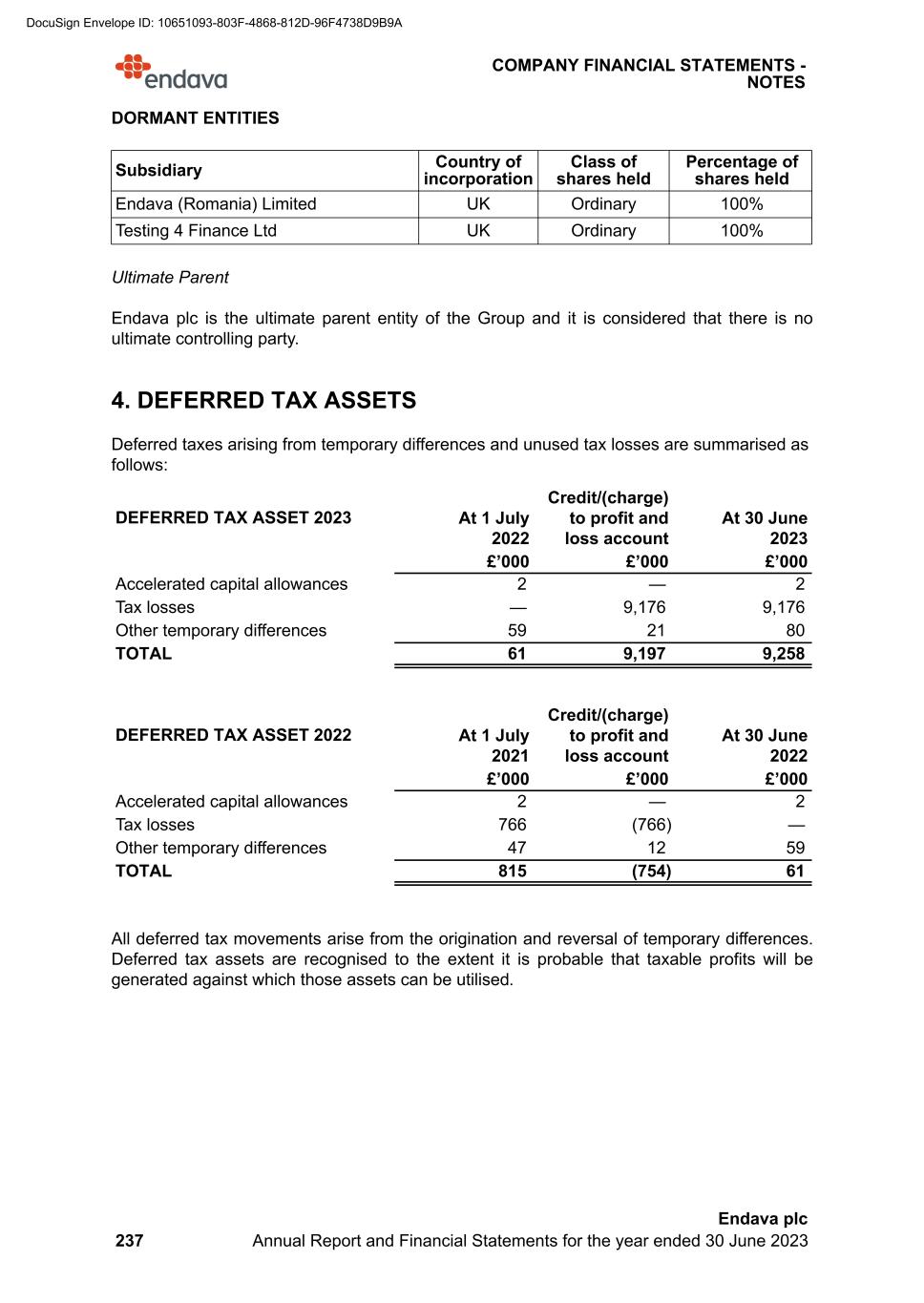
DORMANT ENTITIES Subsidiary Country of incorporation Class of shares held Percentage of shares held Endava (Romania) Limited UK Ordinary 100% Testing 4 Finance Ltd UK Ordinary 100% Ultimate Parent Endava plc is the ultimate parent entity of the Group and it is considered that there is no ultimate controlling party. 4. DEFERRED TAX ASSETS Deferred taxes arising from temporary differences and unused tax losses are summarised as follows: DEFERRED TAX ASSET 2023 At 1 July 2022 Credit/(charge) to profit and loss account At 30 June 2023 £’000 £’000 £’000 Accelerated capital allowances 2 — 2 Tax losses — 9,176 9,176 Other temporary differences 59 21 80 TOTAL 61 9,197 9,258 DEFERRED TAX ASSET 2022 At 1 July 2021 Credit/(charge) to profit and loss account At 30 June 2022 £’000 £’000 £’000 Accelerated capital allowances 2 — 2 Tax losses 766 (766) — Other temporary differences 47 12 59 TOTAL 815 (754) 61 All deferred tax movements arise from the origination and reversal of temporary differences. Deferred tax assets are recognised to the extent it is probable that taxable profits will be generated against which those assets can be utilised. COMPANY FINANCIAL STATEMENTS - NOTES 237 Endava plc Annual Report and Financial Statements for the year ended 30 June 2023 DocuSign Envelope ID: 10651093-803F-4868-812D-96F4738D9B9A
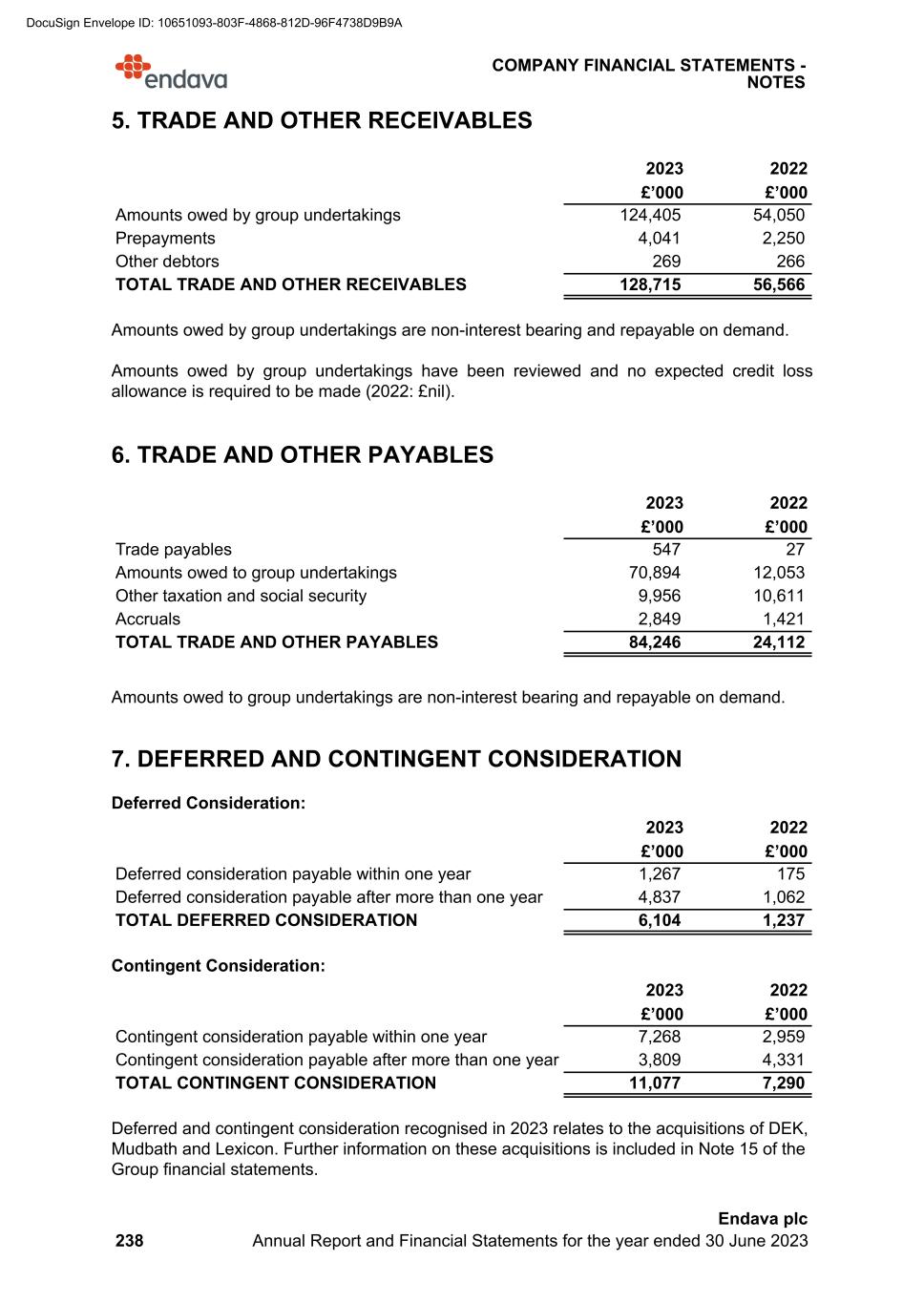
5. TRADE AND OTHER RECEIVABLES 2023 2022 £’000 £’000 Amounts owed by group undertakings 124,405 54,050 Prepayments 4,041 2,250 Other debtors 269 266 TOTAL TRADE AND OTHER RECEIVABLES 128,715 56,566 Amounts owed by group undertakings are non-interest bearing and repayable on demand. Amounts owed by group undertakings have been reviewed and no expected credit loss allowance is required to be made (2022: £nil). 6. TRADE AND OTHER PAYABLES 2023 2022 £’000 £’000 Trade payables 547 27 Amounts owed to group undertakings 70,894 12,053 Other taxation and social security 9,956 10,611 Accruals 2,849 1,421 TOTAL TRADE AND OTHER PAYABLES 84,246 24,112 Amounts owed to group undertakings are non-interest bearing and repayable on demand. 7. DEFERRED AND CONTINGENT CONSIDERATION Deferred Consideration: 2023 2022 £’000 £’000 Deferred consideration payable within one year 1,267 175 Deferred consideration payable after more than one year 4,837 1,062 TOTAL DEFERRED CONSIDERATION 6,104 1,237 Contingent Consideration: 2023 2022 £’000 £’000 Contingent consideration payable within one year 7,268 2,959 Contingent consideration payable after more than one year 3,809 4,331 TOTAL CONTINGENT CONSIDERATION 11,077 7,290 Deferred and contingent consideration recognised in 2023 relates to the acquisitions of DEK, Mudbath and Lexicon. Further information on these acquisitions is included in Note 15 of the Group financial statements. COMPANY FINANCIAL STATEMENTS - NOTES 238 Endava plc Annual Report and Financial Statements for the year ended 30 June 2023 DocuSign Envelope ID: 10651093-803F-4868-812D-96F4738D9B9A
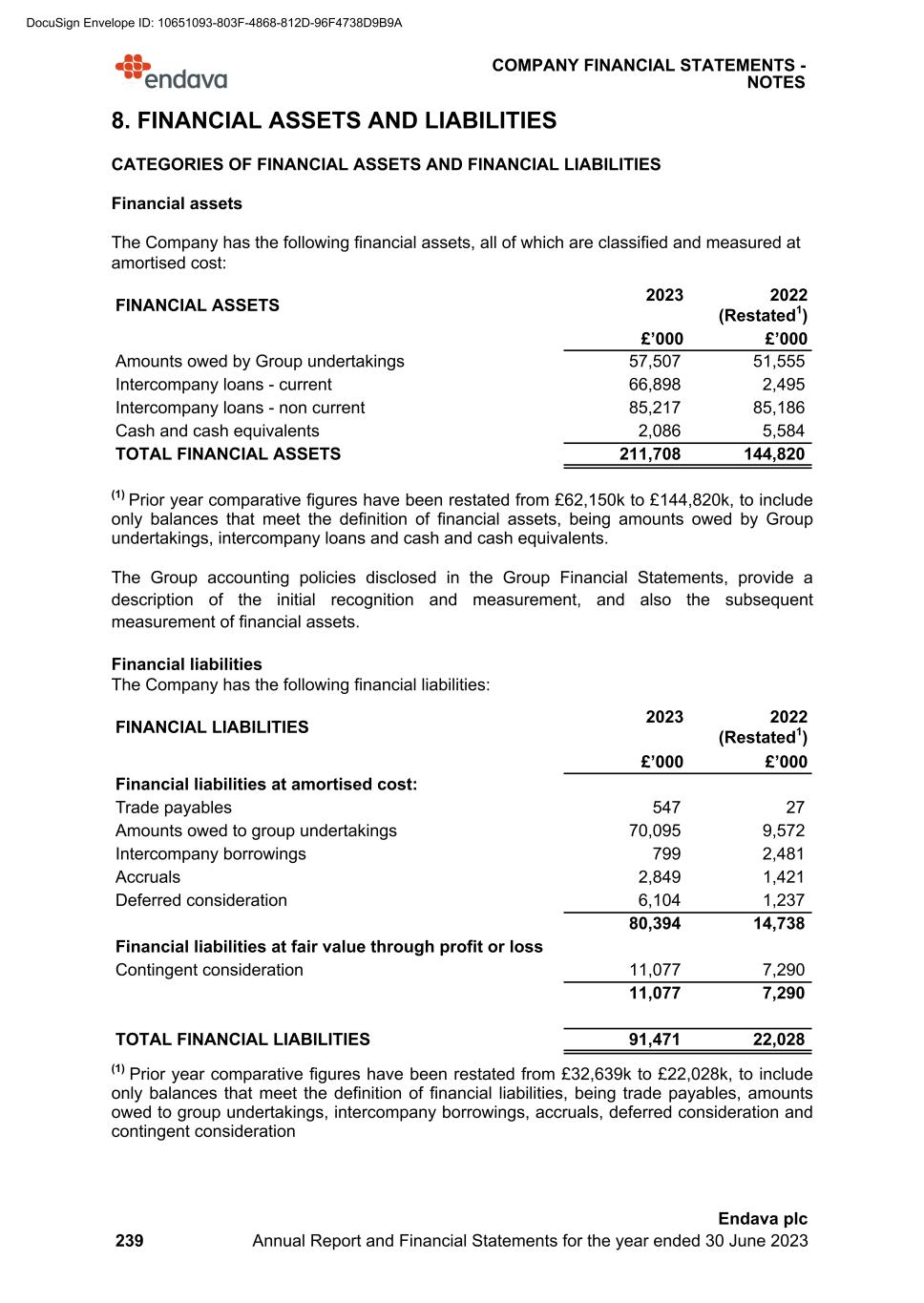
8. FINANCIAL ASSETS AND LIABILITIES CATEGORIES OF FINANCIAL ASSETS AND FINANCIAL LIABILITIES Financial assets The Company has the following financial assets, all of which are classified and measured at amortised cost: FINANCIAL ASSETS 2023 2022 (Restated1) £’000 £’000 Amounts owed by Group undertakings 57,507 51,555 Intercompany loans - current 66,898 2,495 Intercompany loans - non current 85,217 85,186 Cash and cash equivalents 2,086 5,584 TOTAL FINANCIAL ASSETS 211,708 144,820 (1) Prior year comparative figures have been restated from £62,150k to £144,820k, to include only balances that meet the definition of financial assets, being amounts owed by Group undertakings, intercompany loans and cash and cash equivalents. The Group accounting policies disclosed in the Group Financial Statements, provide a description of the initial recognition and measurement, and also the subsequent measurement of financial assets. Financial liabilities The Company has the following financial liabilities: FINANCIAL LIABILITIES 2023 2022 (Restated1) £’000 £’000 Financial liabilities at amortised cost: Trade payables 547 27 Amounts owed to group undertakings 70,095 9,572 Intercompany borrowings 799 2,481 Accruals 2,849 1,421 Deferred consideration 6,104 1,237 80,394 14,738 Financial liabilities at fair value through profit or loss Contingent consideration 11,077 7,290 11,077 7,290 TOTAL FINANCIAL LIABILITIES 91,471 22,028 (1) Prior year comparative figures have been restated from £32,639k to £22,028k, to include only balances that meet the definition of financial liabilities, being trade payables, amounts owed to group undertakings, intercompany borrowings, accruals, deferred consideration and contingent consideration COMPANY FINANCIAL STATEMENTS - NOTES 239 Endava plc Annual Report and Financial Statements for the year ended 30 June 2023 DocuSign Envelope ID: 10651093-803F-4868-812D-96F4738D9B9A
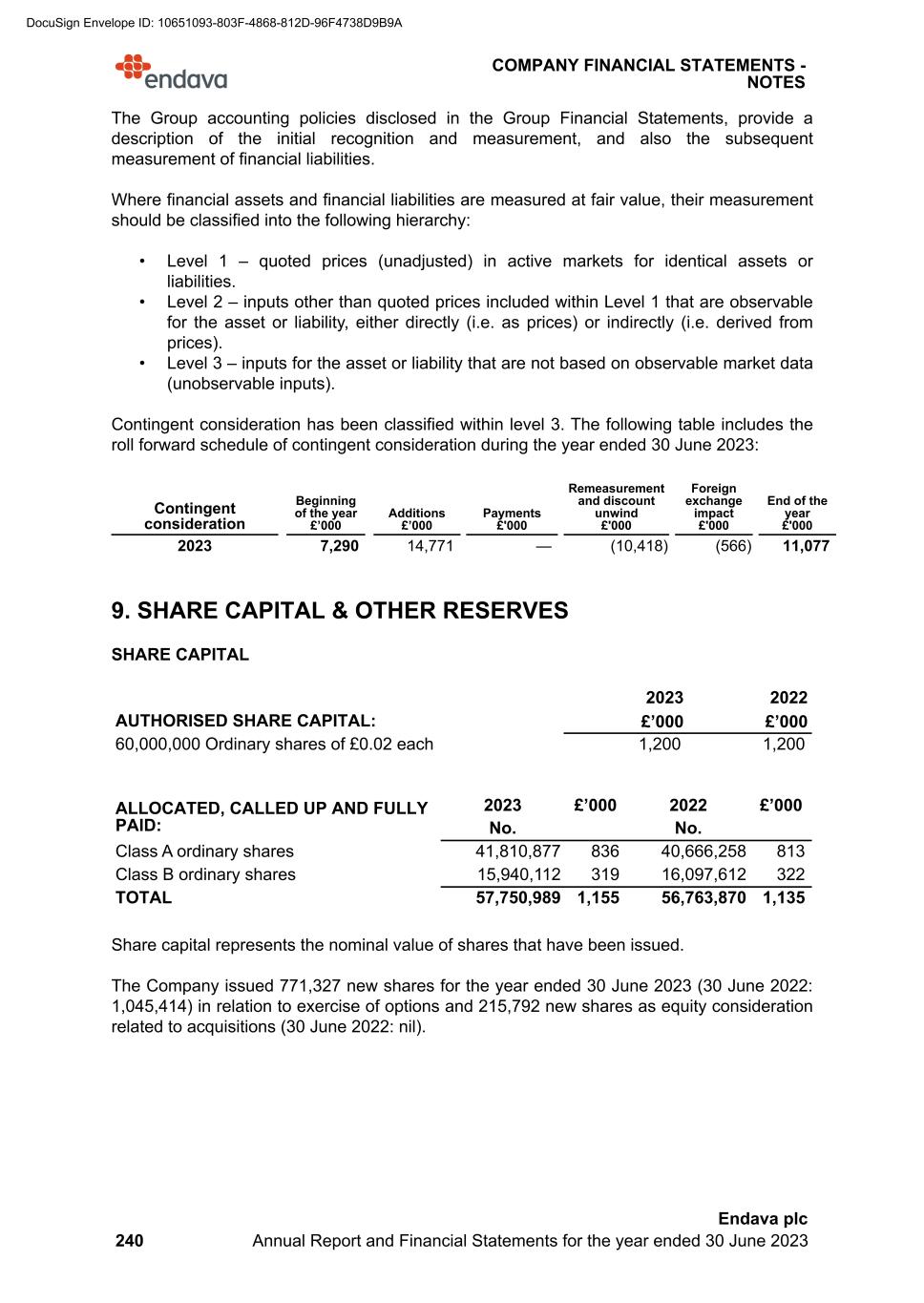
The Group accounting policies disclosed in the Group Financial Statements, provide a description of the initial recognition and measurement, and also the subsequent measurement of financial liabilities. Where financial assets and financial liabilities are measured at fair value, their measurement should be classified into the following hierarchy: • Level 1 – quoted prices (unadjusted) in active markets for identical assets or liabilities. • Level 2 – inputs other than quoted prices included within Level 1 that are observable for the asset or liability, either directly (i.e. as prices) or indirectly (i.e. derived from prices). • Level 3 – inputs for the asset or liability that are not based on observable market data (unobservable inputs). Contingent consideration has been classified within level 3. The following table includes the roll forward schedule of contingent consideration during the year ended 30 June 2023: Contingent consideration Beginning of the year £’000 Additions £’000 Payments £'000 Remeasurement and discount unwind £'000 Foreign exchange impact £'000 End of the year £'000 2023 7,290 14,771 — (10,418) (566) 11,077 9. SHARE CAPITAL & OTHER RESERVES SHARE CAPITAL 2023 2022 AUTHORISED SHARE CAPITAL: £’000 £’000 60,000,000 Ordinary shares of £0.02 each 1,200 1,200 ALLOCATED, CALLED UP AND FULLY PAID: 2023 £’000 2022 £’000 No. No. Class A ordinary shares 41,810,877 836 40,666,258 813 Class B ordinary shares 15,940,112 319 16,097,612 322 TOTAL 57,750,989 1,155 56,763,870 1,135 Share capital represents the nominal value of shares that have been issued. The Company issued 771,327 new shares for the year ended 30 June 2023 (30 June 2022: 1,045,414) in relation to exercise of options and 215,792 new shares as equity consideration related to acquisitions (30 June 2022: nil). COMPANY FINANCIAL STATEMENTS - NOTES 240 Endava plc Annual Report and Financial Statements for the year ended 30 June 2023 DocuSign Envelope ID: 10651093-803F-4868-812D-96F4738D9B9A

Voting rights, dividends and return of capital Our Class B ordinary shares have ten votes per share, and our Class A ordinary shares, which are the shares underlying the American Depositary Shares (ADSs), each have, and Class C ordinary shares, prior to their automatic conversion into Class A ordinary shares, each had, one vote per share. Any dividend declared by the Company shall be paid on Class A ordinary shares and the Class B ordinary shares (and, prior to the automatic conversion of the Class C ordinary shares, the Class C ordinary shares) pari passu as if they were all shares of the same class. In the event of the liquidation, dissolution or winding up of the Company, the assets of the Company available for distribution to members shall be distributed amongst all holders of Class A ordinary shares and Class B ordinary shares (and, prior to the automatic conversion of the Class C ordinary shares, any Class C ordinary shares) in proportion to the number of shares held irrespective of the amount paid or credited as paid on any share. Restrictions Class B ordinary shares During the period of one hundred and eighty days commencing on the IPO, no transfers of Class B ordinary shares were permitted other than to a person who is a permitted Class B ordinary transferee or pursuant to the IPO (which for the avoidance of doubt includes sales pursuant to any secondary offering or exercise of any over-allotment option in connection with the IPO). No transfers of Class B ordinary shares shall be permitted (other than to a person who is a permitted Class B ordinary transferee): a. in excess of 25% of the Class B ordinary shareholders holding of Class B ordinary shares (determined as at the IPO) in the period commencing 180 days after the IPO and ending on the date falling 18 months after the IPO; b. in excess of 40% of the Class B ordinary shareholders holding of Class B ordinary shares (determined as at the IPO) in the period commencing 180 days after the IPO and ending on the date falling on the third anniversary of the IPO; and c. in excess of 60% of the Class B ordinary shareholders holding of Class B ordinary shares (determined as at the IPO) in the period commencing 180 days after the IPO and ending on the fifth anniversary of the IPO. Following the fifth anniversary of the IPO, a Class B ordinary shareholder may elect, at any time, to convert any of its Class B ordinary shares into Class A ordinary shares on a one-for- one basis by notice in writing to the Directors. SHARE PREMIUM Share premium includes any premiums received on issue of share capital. Any transaction costs associated with the issuing of shares are deducted from share premium, net of any related income tax benefits. COMPANY FINANCIAL STATEMENTS - NOTES 241 Endava plc Annual Report and Financial Statements for the year ended 30 June 2023 DocuSign Envelope ID: 10651093-803F-4868-812D-96F4738D9B9A
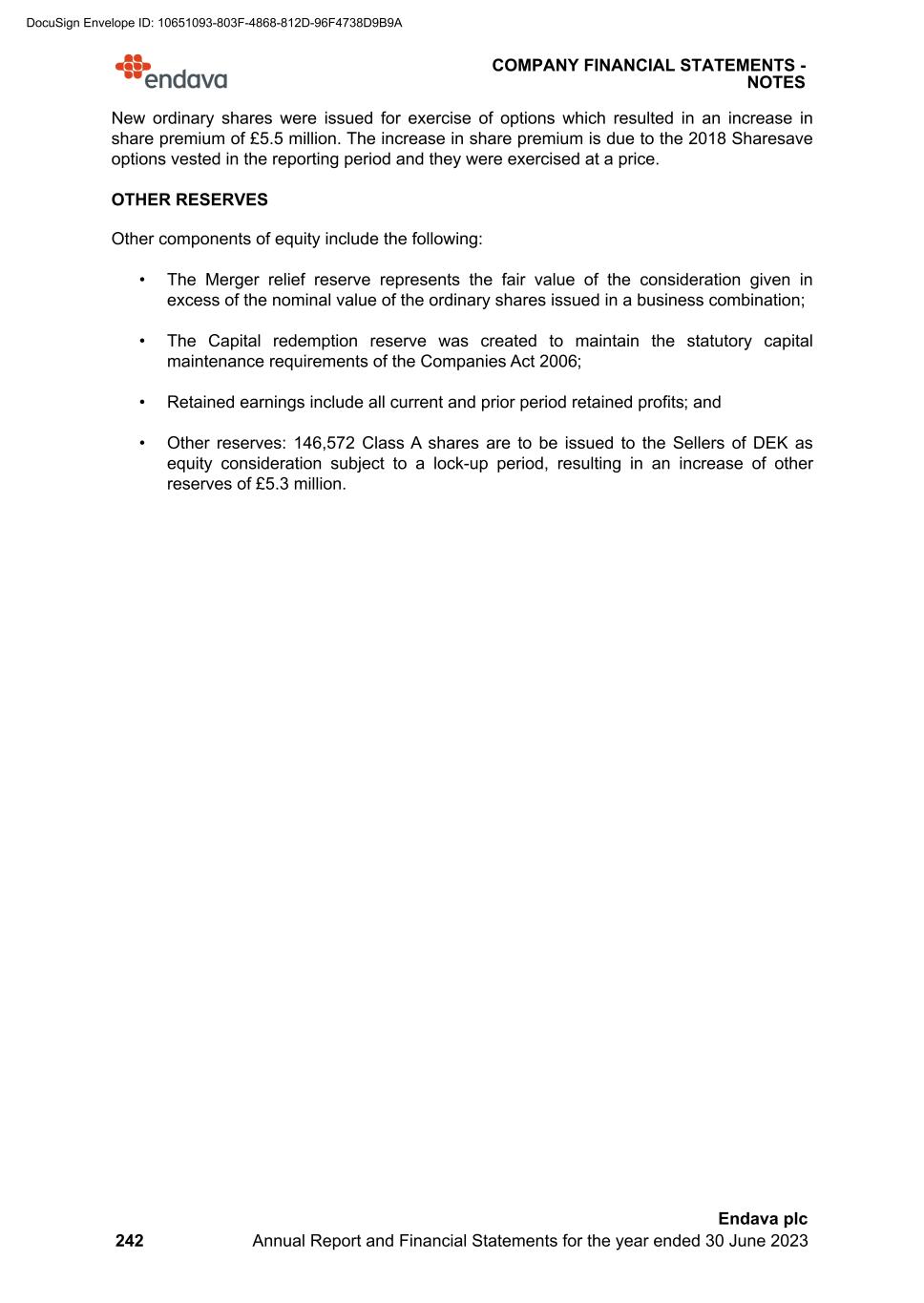
New ordinary shares were issued for exercise of options which resulted in an increase in share premium of £5.5 million. The increase in share premium is due to the 2018 Sharesave options vested in the reporting period and they were exercised at a price. OTHER RESERVES Other components of equity include the following: • The Merger relief reserve represents the fair value of the consideration given in excess of the nominal value of the ordinary shares issued in a business combination; • The Capital redemption reserve was created to maintain the statutory capital maintenance requirements of the Companies Act 2006; • Retained earnings include all current and prior period retained profits; and • Other reserves: 146,572 Class A shares are to be issued to the Sellers of DEK as equity consideration subject to a lock-up period, resulting in an increase of other reserves of £5.3 million. COMPANY FINANCIAL STATEMENTS - NOTES 242 Endava plc Annual Report and Financial Statements for the year ended 30 June 2023 DocuSign Envelope ID: 10651093-803F-4868-812D-96F4738D9B9A

10. RELATED PARTY TRANSACTIONS The following tables show the transactions between the parent company and other entities within the Group. 2023 ENDAVA PLC Sales to Group Companies Purchases from Group Companies £’000 £’000 Endava (UK) Limited 50,867 17,903 Endava (Managed Services) Limited — 421 Endava Romania SRL 634 22,803 ICS Endava SRL — 2,449 Endava INC — 829 Endava DOOEL Skopje — 284 Endava D.O.O. Beograd 1,405 814 Endava (Ireland) Limited — 9 Endava S.A.S. — 2,116 Endava B.V. — 235 Endava EOOD — 125 Levvel, LLC 425 — Endava Argentina — 1,824 Endava Colombia Med — 83 Endava Uruguay — 41 Endava Berlin GmbH — 50 Endava digitalne resitve d.o.o. 1,887 120 Endava d.o.o. Sarajevo — 59 Endava Poland sp z.o.o. — 77 Endava Australia PTY LTD — 15 Endava d.o.o. - HRK — 14 Endava d.o.o. 406 19 TOTAL 55,624 50,290 COMPANY FINANCIAL STATEMENTS - NOTES 243 Endava plc Annual Report and Financial Statements for the year ended 30 June 2023 DocuSign Envelope ID: 10651093-803F-4868-812D-96F4738D9B9A

2022 ENDAVA PLC Sales to Group Companies Purchases from Group Companies £’000 £’000 Endava (UK) Limited 22,941 15,378 Endava (Managed Services) Limited — 489 Endava Romania SRL 470 11,442 ICS Endava SRL — 2,927 Endava INC — 244 Endava DOOEL Skopje — 286 Endava D.O.O. Beograd 1,198 737 Endava (Ireland) Limited — 12 Endava S.A.S. — 1,432 Endava B.V. — 156 Endava EOOD — 135 Endava LLC 202 — Endava Argentina — 1,426 Endava Colombia Med — 49 Endava Uruguay — 27 Endava Berlin GmbH — 248 Pet Minuta d.o.o — 8 TOTAL 24,811 34,996 The following table shows the interest charged by/to the parent company to/by other entities within the Group. 2023 Endava PLC Interest charged to Group Companies Interest charged by Group Companies £’000 £’000 Endava (UK) Limited 373 — Endava Romania SRL 472 — Endava Inc 2,605 — Endava GmbH 867 — Endava LLC — 67 TOTAL 4,317 67 COMPANY FINANCIAL STATEMENTS - NOTES 244 Endava plc Annual Report and Financial Statements for the year ended 30 June 2023 DocuSign Envelope ID: 10651093-803F-4868-812D-96F4738D9B9A
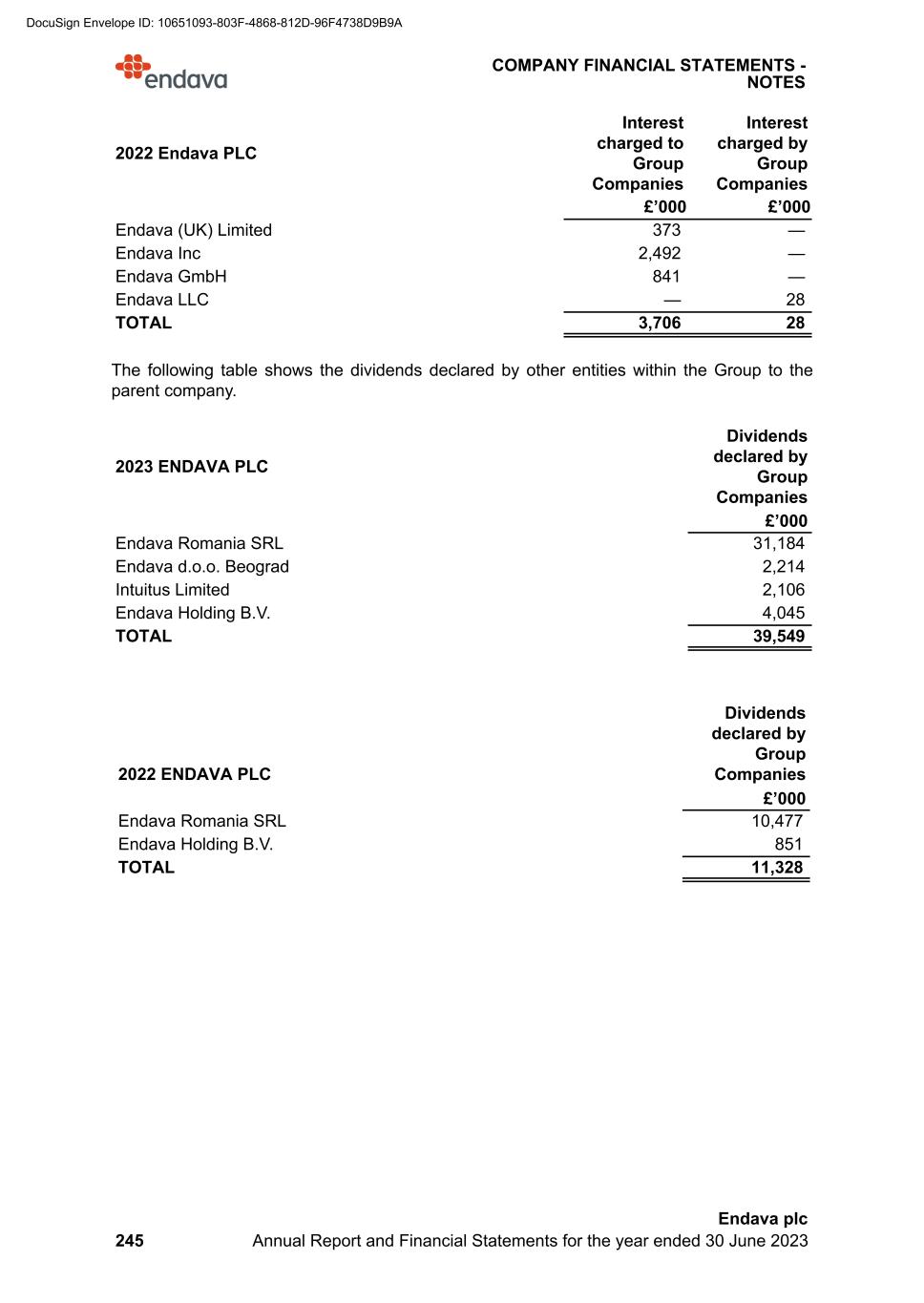
2022 Endava PLC Interest charged to Group Companies Interest charged by Group Companies £’000 £’000 Endava (UK) Limited 373 — Endava Inc 2,492 — Endava GmbH 841 — Endava LLC — 28 TOTAL 3,706 28 The following table shows the dividends declared by other entities within the Group to the parent company. 2023 ENDAVA PLC Dividends declared by Group Companies £’000 Endava Romania SRL 31,184 Endava d.o.o. Beograd 2,214 Intuitus Limited 2,106 Endava Holding B.V. 4,045 TOTAL 39,549 2022 ENDAVA PLC Dividends declared by Group Companies £’000 Endava Romania SRL 10,477 Endava Holding B.V. 851 TOTAL 11,328 COMPANY FINANCIAL STATEMENTS - NOTES 245 Endava plc Annual Report and Financial Statements for the year ended 30 June 2023 DocuSign Envelope ID: 10651093-803F-4868-812D-96F4738D9B9A
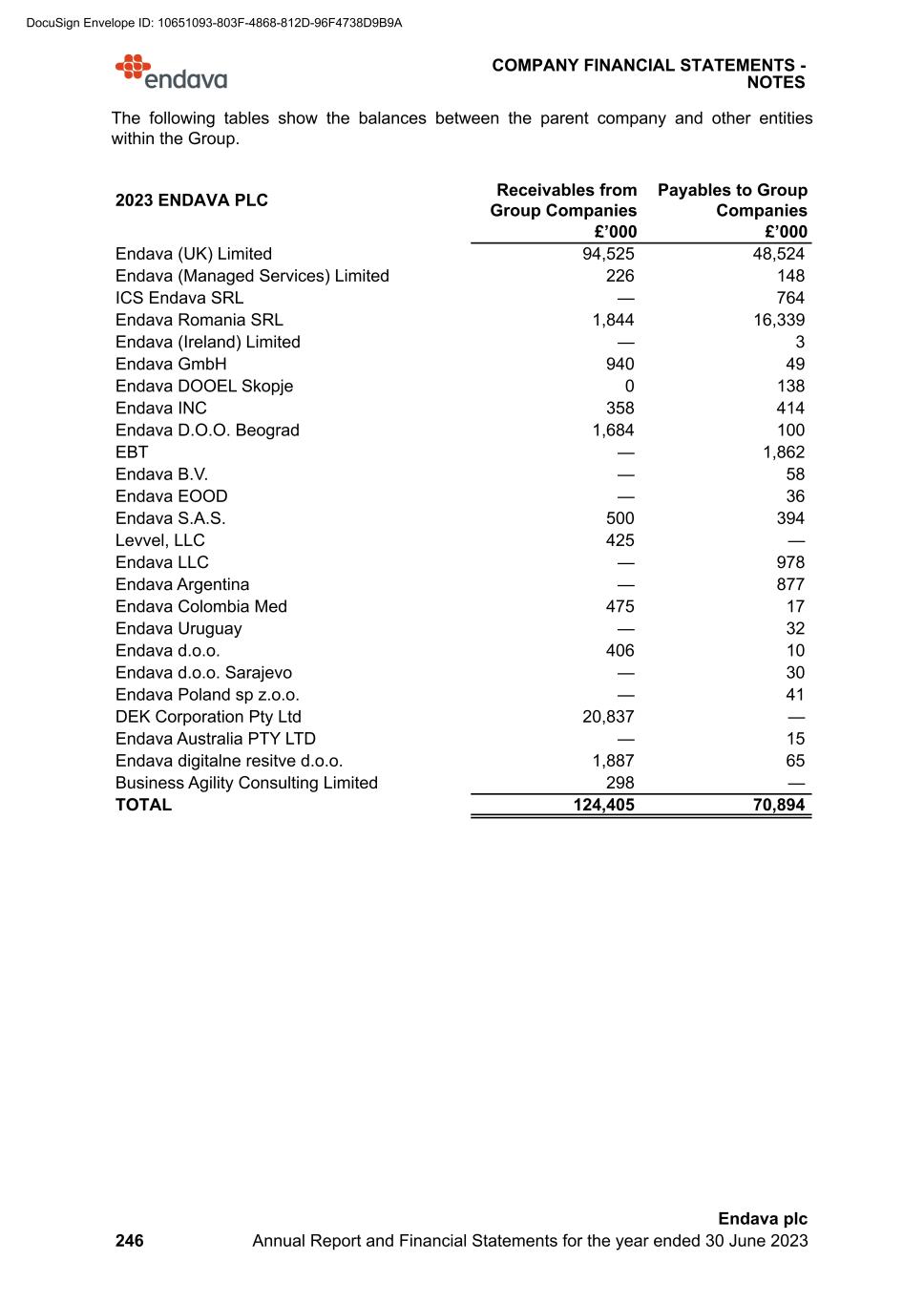
The following tables show the balances between the parent company and other entities within the Group. 2023 ENDAVA PLC Receivables from Group Companies Payables to Group Companies £’000 £’000 Endava (UK) Limited 94,525 48,524 Endava (Managed Services) Limited 226 148 ICS Endava SRL — 764 Endava Romania SRL 1,844 16,339 Endava (Ireland) Limited — 3 Endava GmbH 940 49 Endava DOOEL Skopje 0 138 Endava INC 358 414 Endava D.O.O. Beograd 1,684 100 EBT — 1,862 Endava B.V. — 58 Endava EOOD — 36 Endava S.A.S. 500 394 Levvel, LLC 425 — Endava LLC — 978 Endava Argentina — 877 Endava Colombia Med 475 17 Endava Uruguay — 32 Endava d.o.o. 406 10 Endava d.o.o. Sarajevo — 30 Endava Poland sp z.o.o. — 41 DEK Corporation Pty Ltd 20,837 — Endava Australia PTY LTD — 15 Endava digitalne resitve d.o.o. 1,887 65 Business Agility Consulting Limited 298 — TOTAL 124,405 70,894 COMPANY FINANCIAL STATEMENTS - NOTES 246 Endava plc Annual Report and Financial Statements for the year ended 30 June 2023 DocuSign Envelope ID: 10651093-803F-4868-812D-96F4738D9B9A
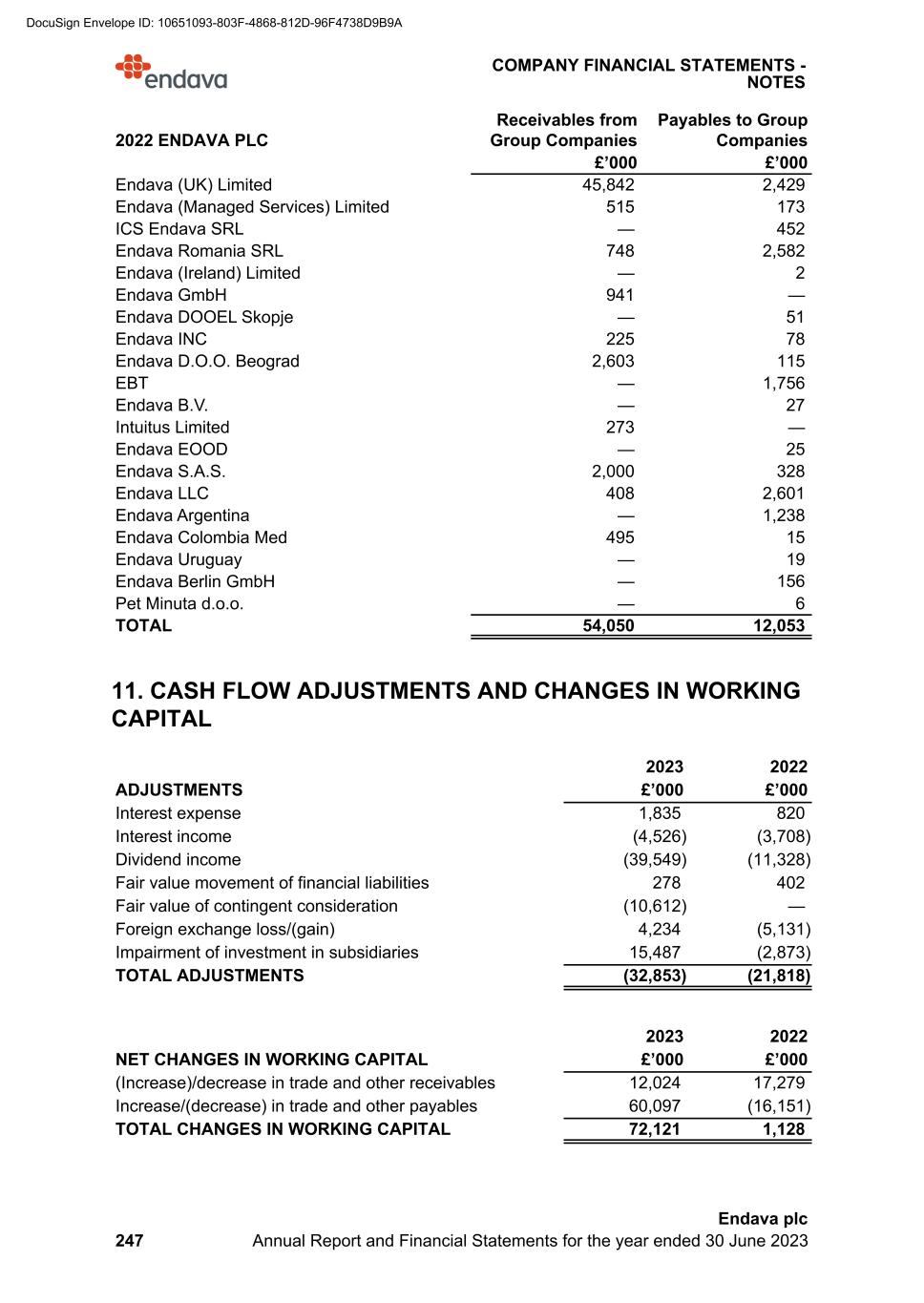
2022 ENDAVA PLC Receivables from Group Companies Payables to Group Companies £’000 £’000 Endava (UK) Limited 45,842 2,429 Endava (Managed Services) Limited 515 173 ICS Endava SRL — 452 Endava Romania SRL 748 2,582 Endava (Ireland) Limited — 2 Endava GmbH 941 — Endava DOOEL Skopje — 51 Endava INC 225 78 Endava D.O.O. Beograd 2,603 115 EBT — 1,756 Endava B.V. — 27 Intuitus Limited 273 — Endava EOOD — 25 Endava S.A.S. 2,000 328 Endava LLC 408 2,601 Endava Argentina — 1,238 Endava Colombia Med 495 15 Endava Uruguay — 19 Endava Berlin GmbH — 156 Pet Minuta d.o.o. — 6 TOTAL 54,050 12,053 11. CASH FLOW ADJUSTMENTS AND CHANGES IN WORKING CAPITAL 2023 2022 ADJUSTMENTS £’000 £’000 Interest expense 1,835 820 Interest income (4,526) (3,708) Dividend income (39,549) (11,328) Fair value movement of financial liabilities 278 402 Fair value of contingent consideration (10,612) — Foreign exchange loss/(gain) 4,234 (5,131) Impairment of investment in subsidiaries 15,487 (2,873) TOTAL ADJUSTMENTS (32,853) (21,818) 2023 2022 NET CHANGES IN WORKING CAPITAL £’000 £’000 (Increase)/decrease in trade and other receivables 12,024 17,279 Increase/(decrease) in trade and other payables 60,097 (16,151) TOTAL CHANGES IN WORKING CAPITAL 72,121 1,128 COMPANY FINANCIAL STATEMENTS - NOTES 247 Endava plc Annual Report and Financial Statements for the year ended 30 June 2023 DocuSign Envelope ID: 10651093-803F-4868-812D-96F4738D9B9A

NON-CASH CHANGES ARISING FROM FINANCING ACTIVITIES The Company did not have any borrowings in the current or prior financial year. 12. CORPORATION TAX RECEIVABLE The corporation tax receivable of £nil (2022: £2.9 million) related predominantly to payments due from other UK companies in the group for losses surrendered for group relief. 13. FINANCIAL ASSETS AND OTHER RECEIVABLES Financial assets and other receivables relate to non-current prepayments of £1.2 million (2022: nil) and intercompany loans to various subsidiaries, as detailed below: 2023 2022 £’000 £’000 Endava Inc 44,378 58,544 Endava GmbH 18,178 18,184 Endava (UK) Limited 9,934 8,458 Endava Romania SRL 12,727 — TOTAL 85,217 85,186 Amounts owed by Endava Inc relate to interest-bearing intercompany loans of £44.4 million (2022: £58.5 million). These are a 7-year loan of £24.6 million (2022: £33.0 million) which matures in March 2028 and bears interest at a fixed rate of 4.8%, and a 5-year loan of £19.8 million (2022: £25.6 million) which matures in March 2026 and bears interest at a fixed rate of 4.50%. Amounts owed by Endava GmbH relate to an interest-bearing intercompany loan of £18.2 million (2022: £18.2 million). This is a 5-year loan which matures in December 2024 and bears interest at a fixed rate of 4.64%. Amounts owed by Endava (UK) Limited relate to an interest-bearing intercompany loan of £9.9 million (2022: £8.5 million). This is a 5-year loan which matures in July 2025 and bears interest at a fixed rate of 3.75% per annum. Amounts owed by Endava Romania SRL relate to an interest-bearing intercompany loan of £12.7 million (2022: £nil). This is a 2-year loan which matures in December 2024 and bears interest at a fixed rate of 6%. Amounts owed by group undertakings have been reviewed and no expected credit loss allowance is required to be made (2022: £nil). COMPANY FINANCIAL STATEMENTS - NOTES 248 Endava plc Annual Report and Financial Statements for the year ended 30 June 2023 DocuSign Envelope ID: 10651093-803F-4868-812D-96F4738D9B9A
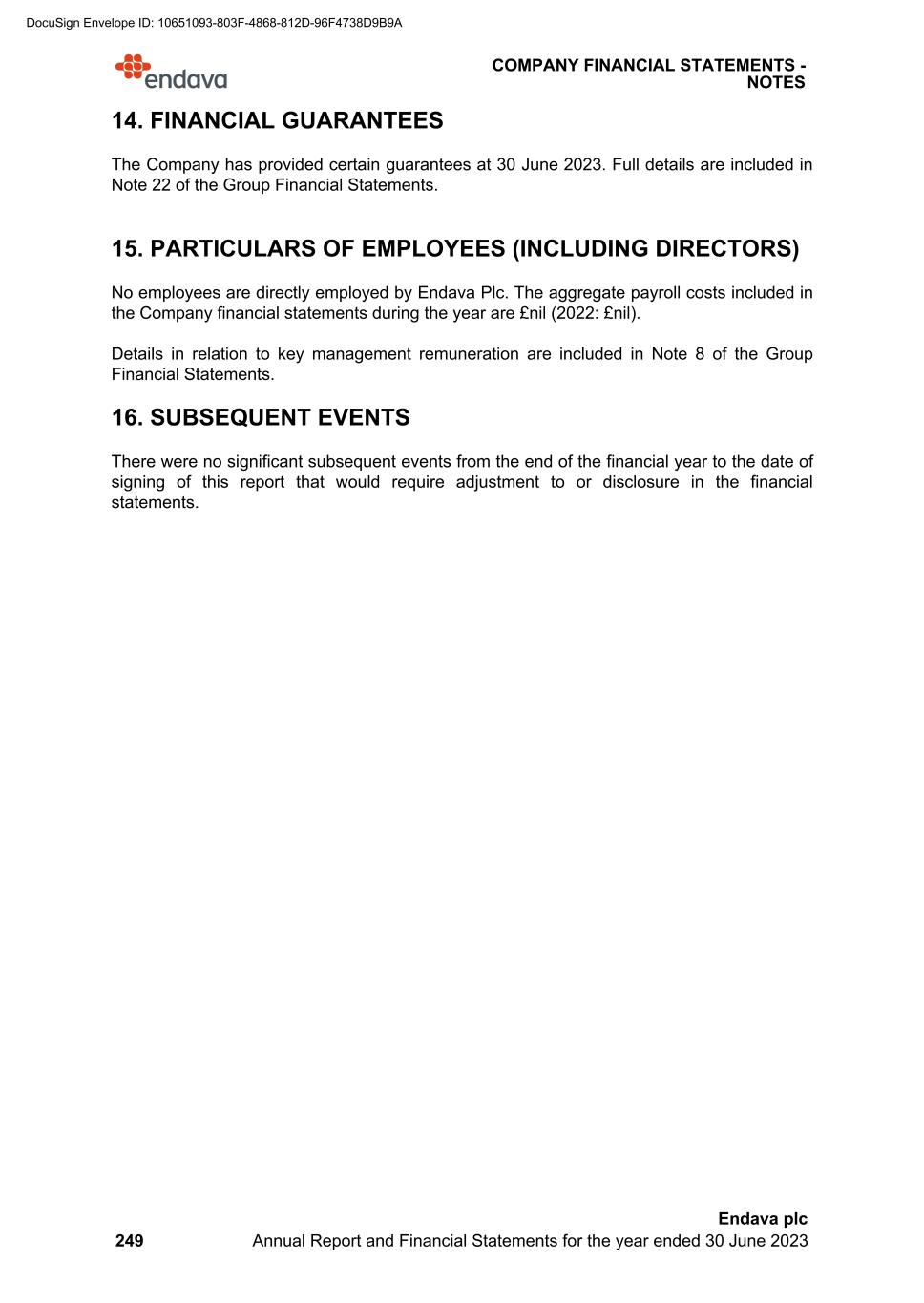
14. FINANCIAL GUARANTEES The Company has provided certain guarantees at 30 June 2023. Full details are included in Note 22 of the Group Financial Statements. 15. PARTICULARS OF EMPLOYEES (INCLUDING DIRECTORS) No employees are directly employed by Endava Plc. The aggregate payroll costs included in the Company financial statements during the year are £nil (2022: £nil). Details in relation to key management remuneration are included in Note 8 of the Group Financial Statements. 16. SUBSEQUENT EVENTS There were no significant subsequent events from the end of the financial year to the date of signing of this report that would require adjustment to or disclosure in the financial statements. COMPANY FINANCIAL STATEMENTS - NOTES 249 Endava plc Annual Report and Financial Statements for the year ended 30 June 2023 DocuSign Envelope ID: 10651093-803F-4868-812D-96F4738D9B9A